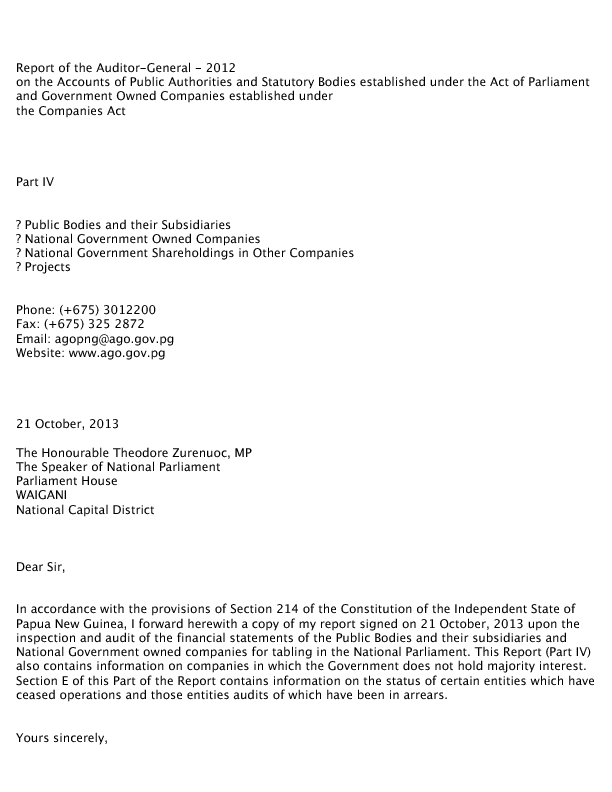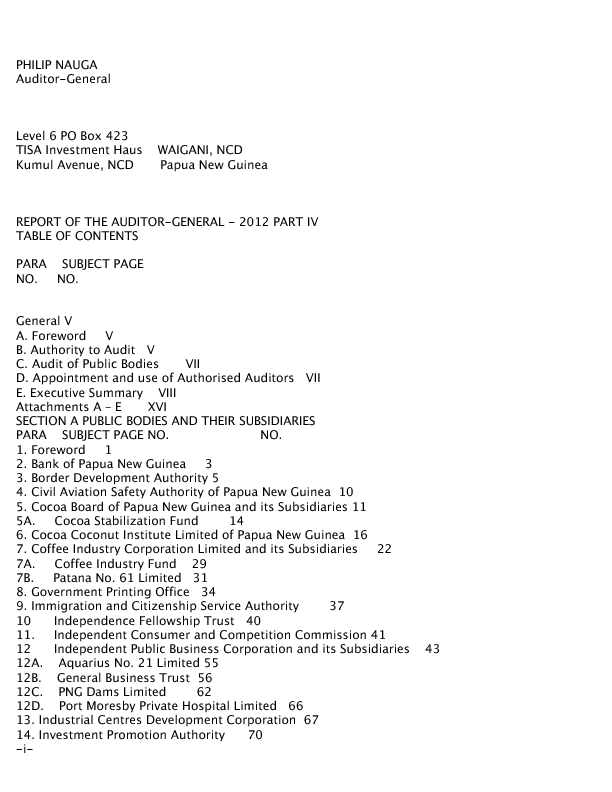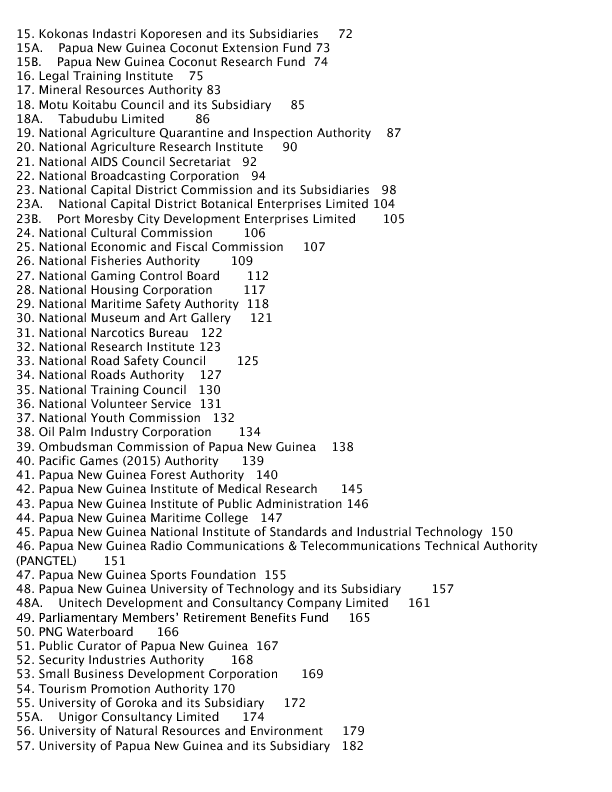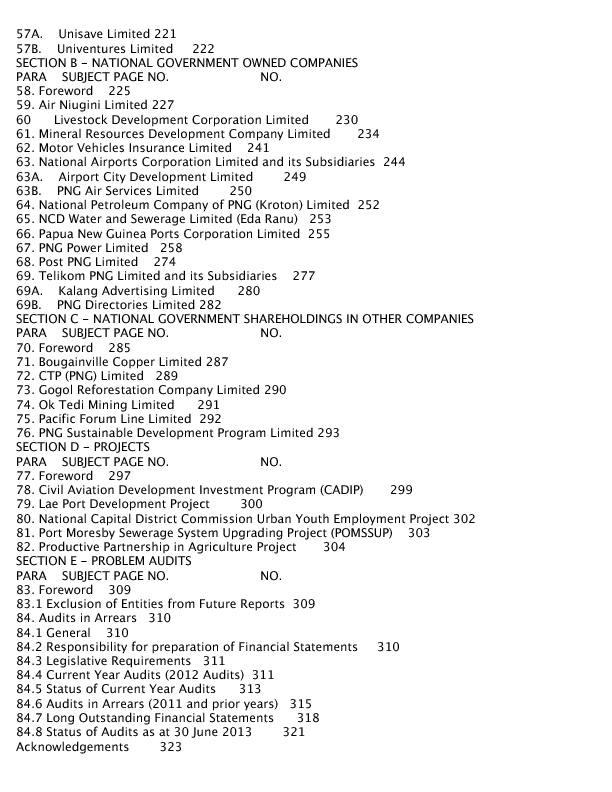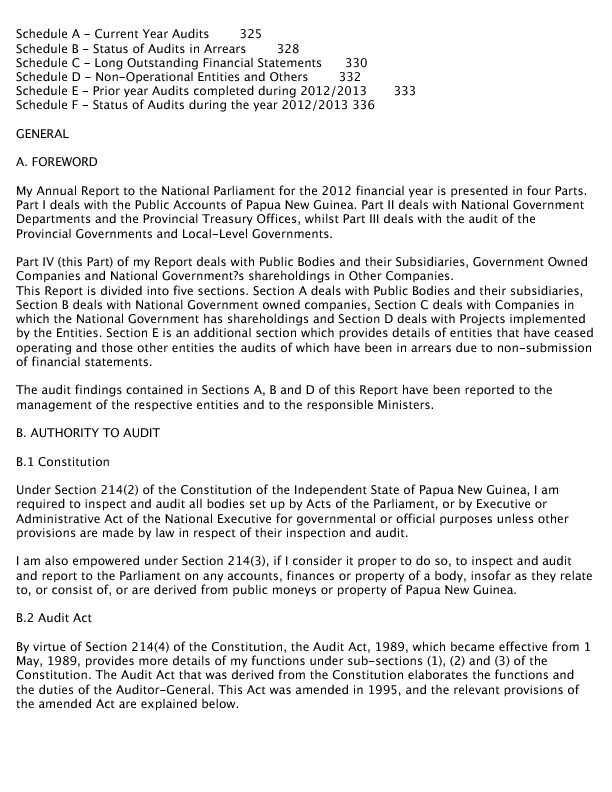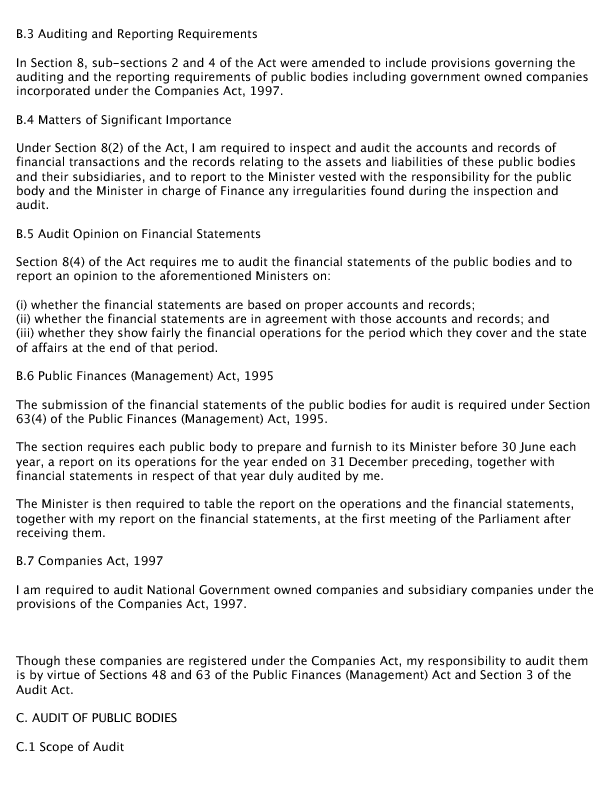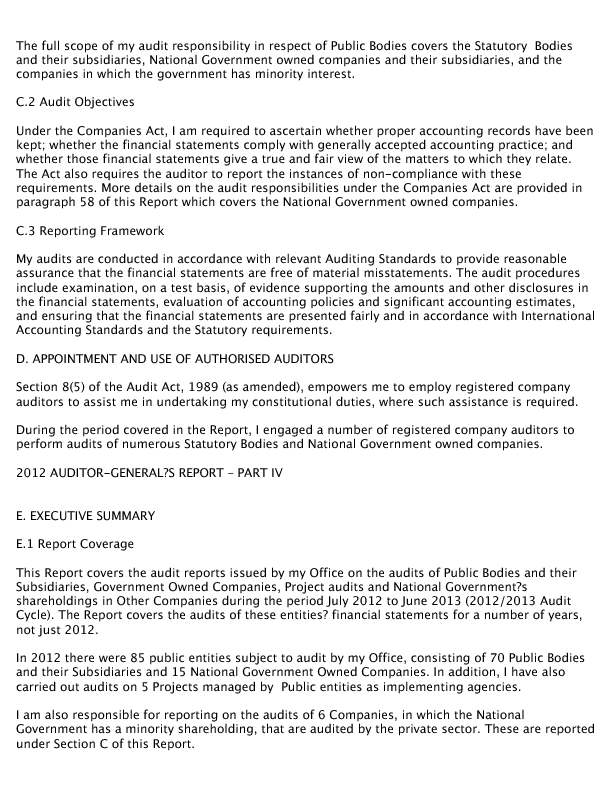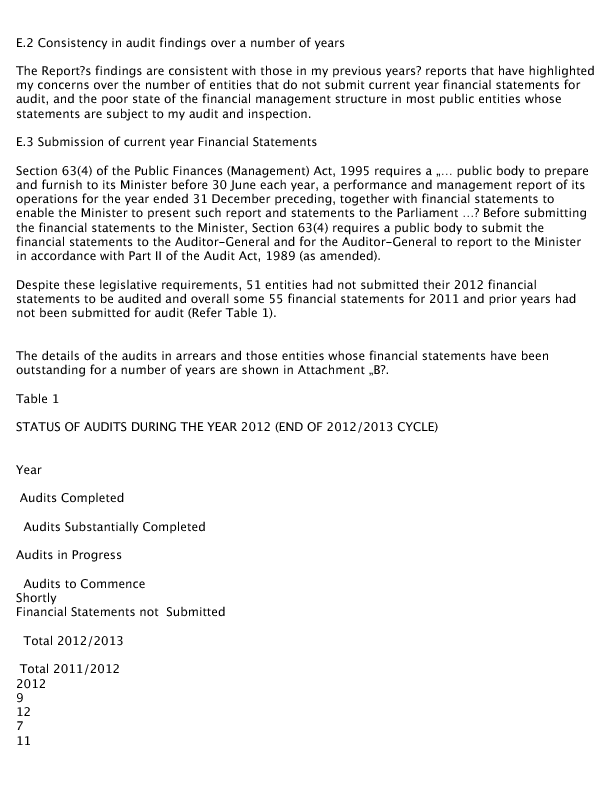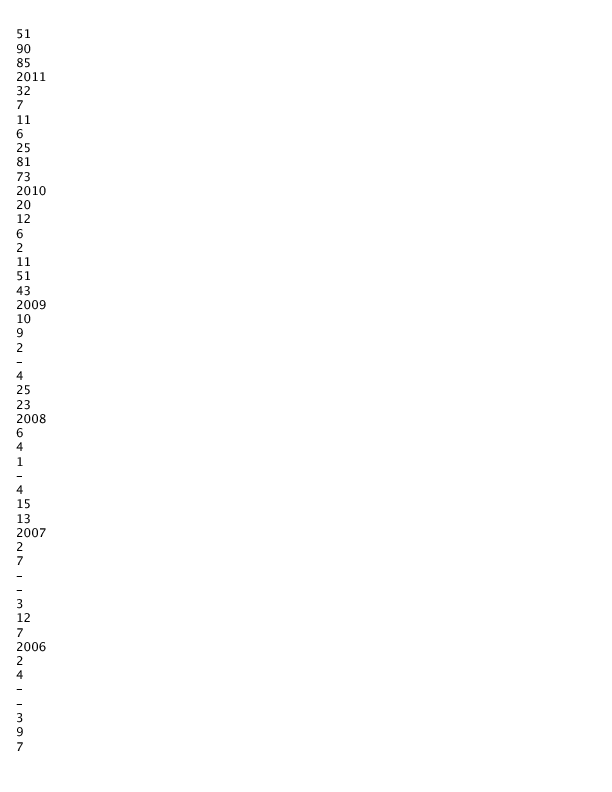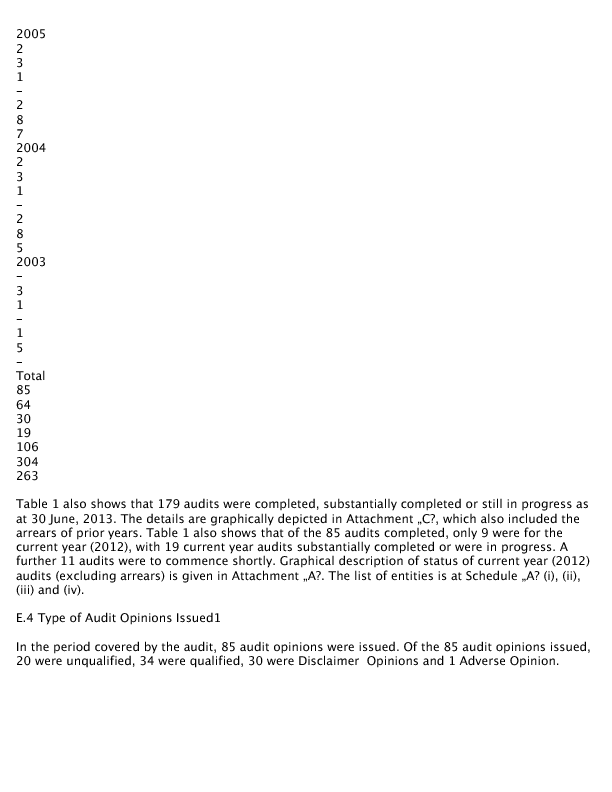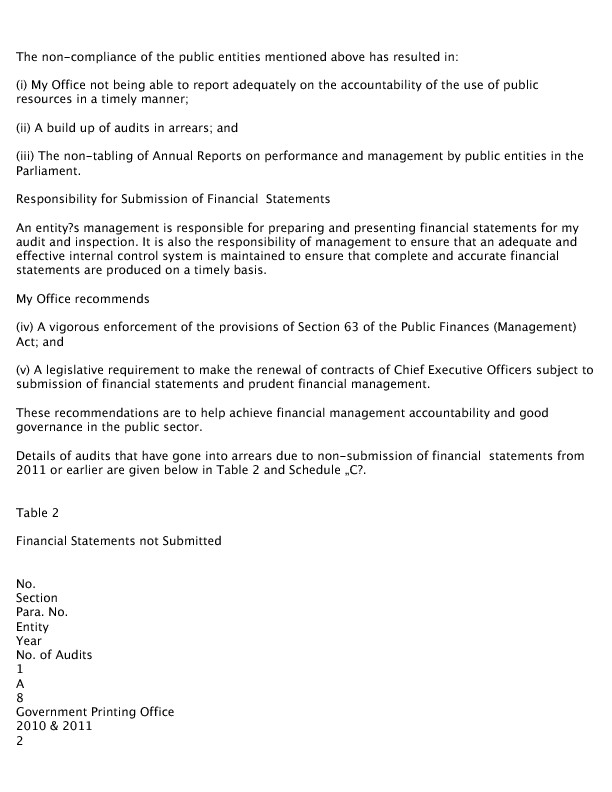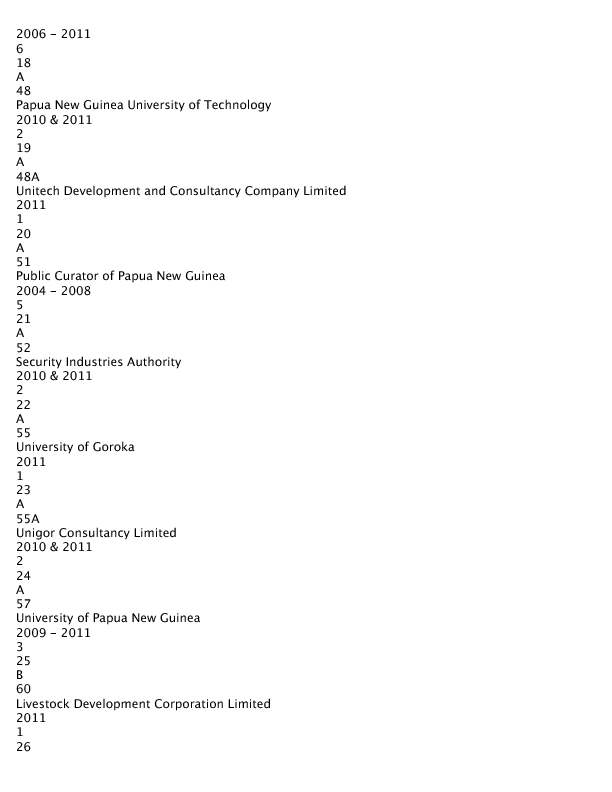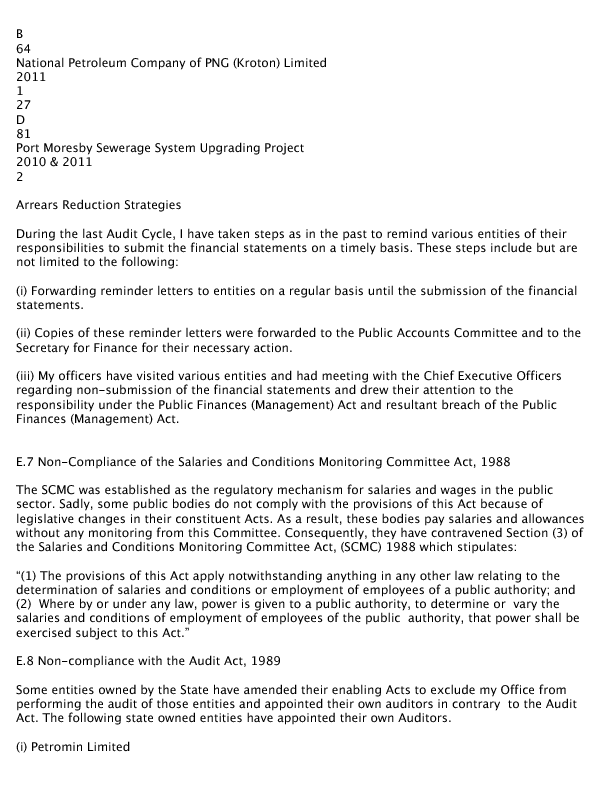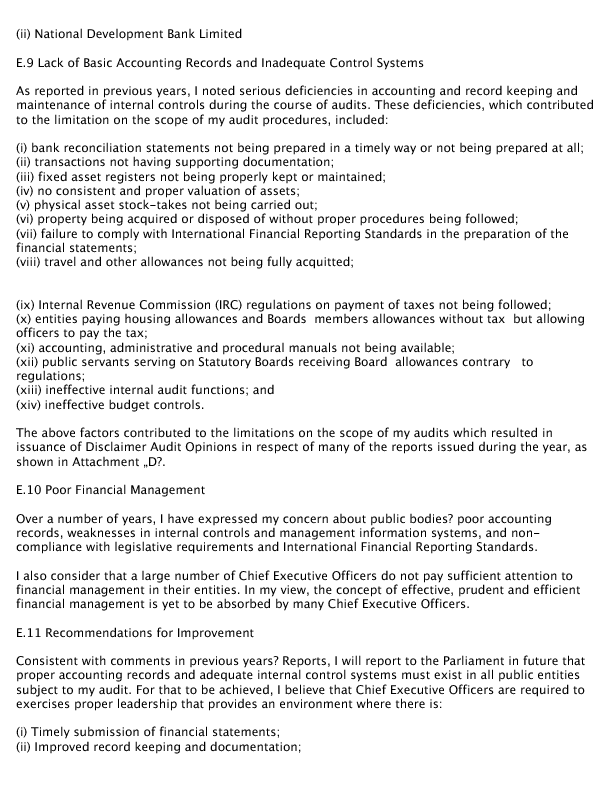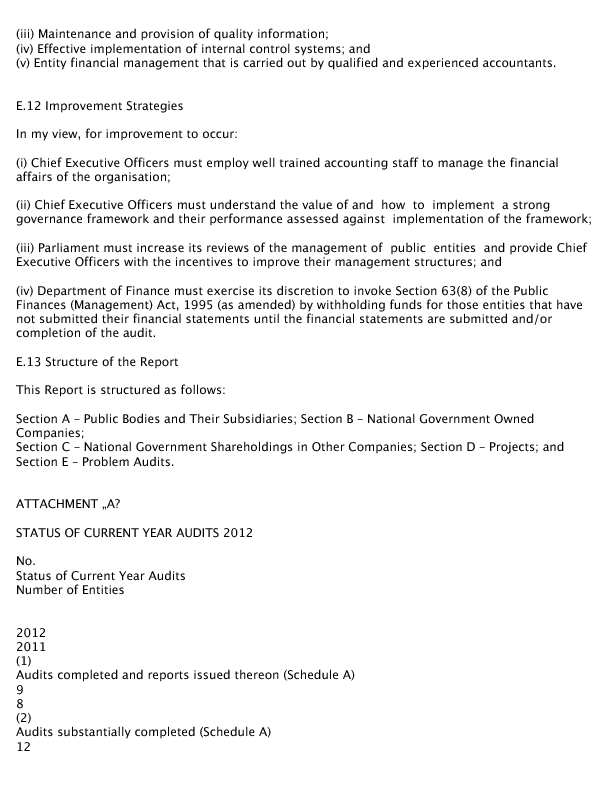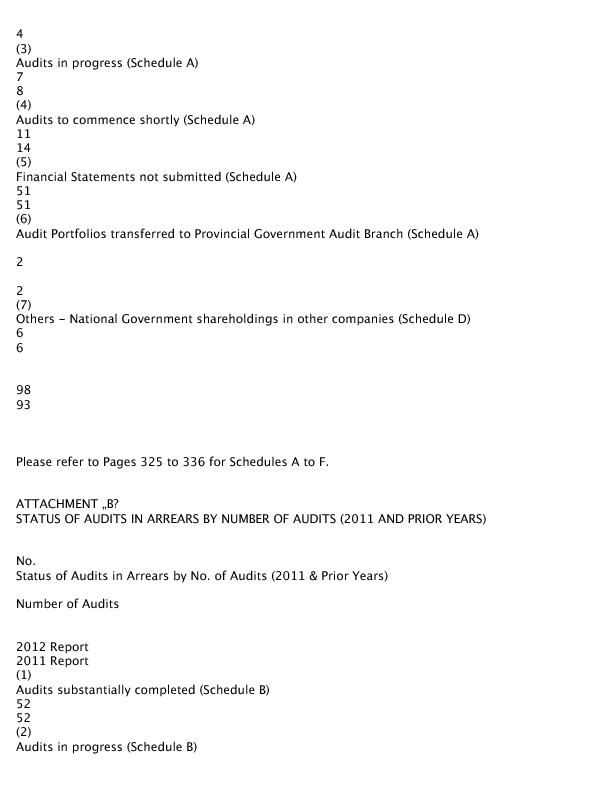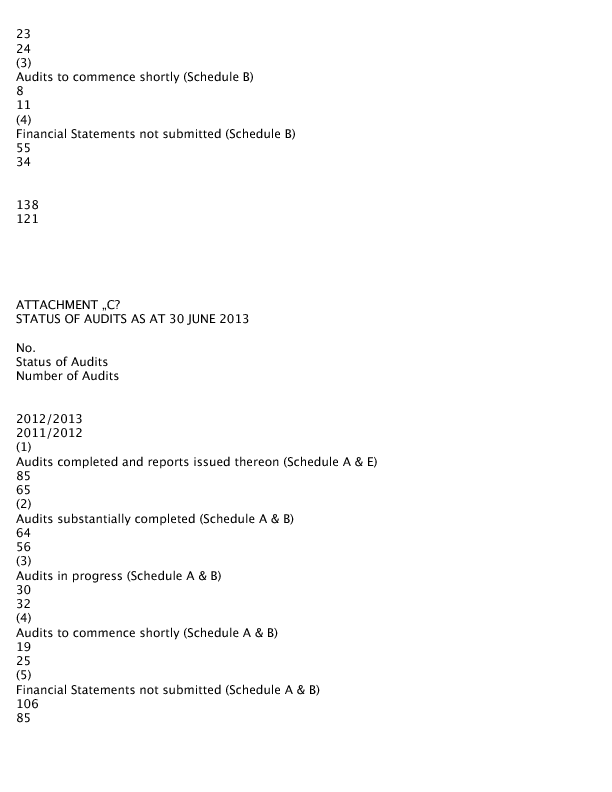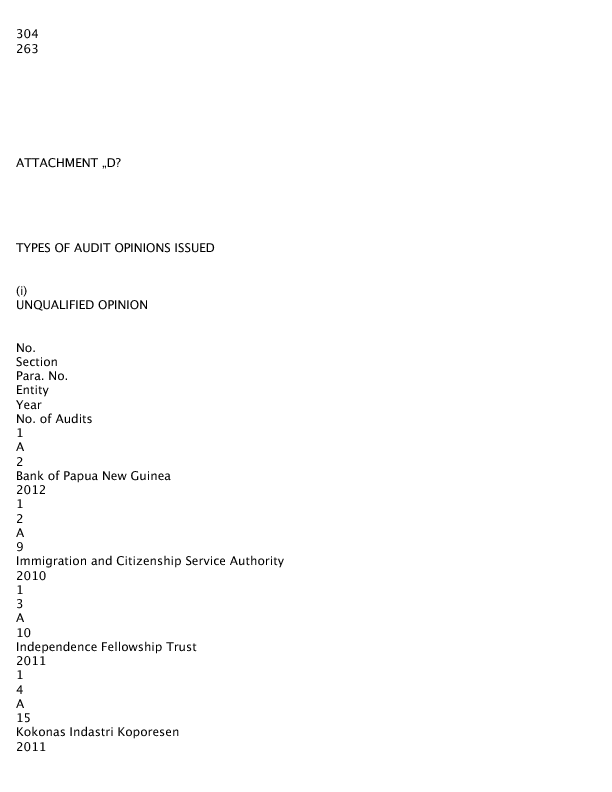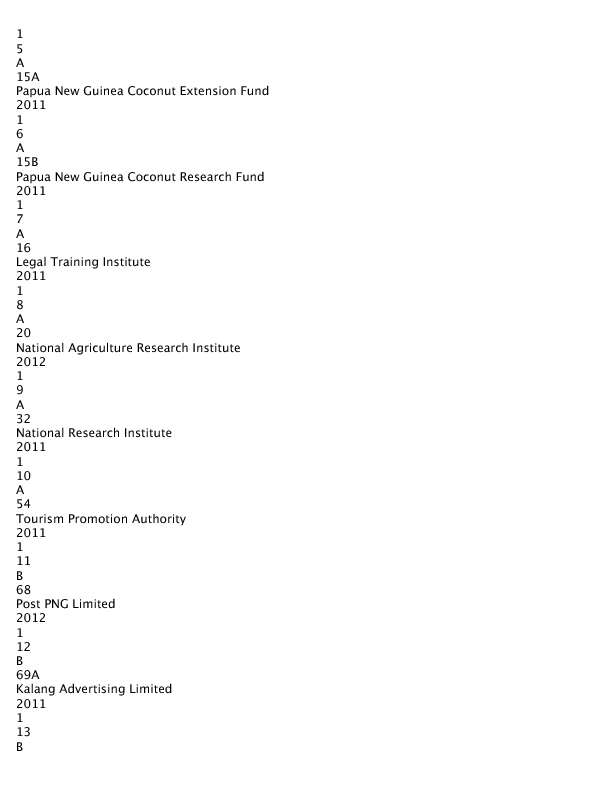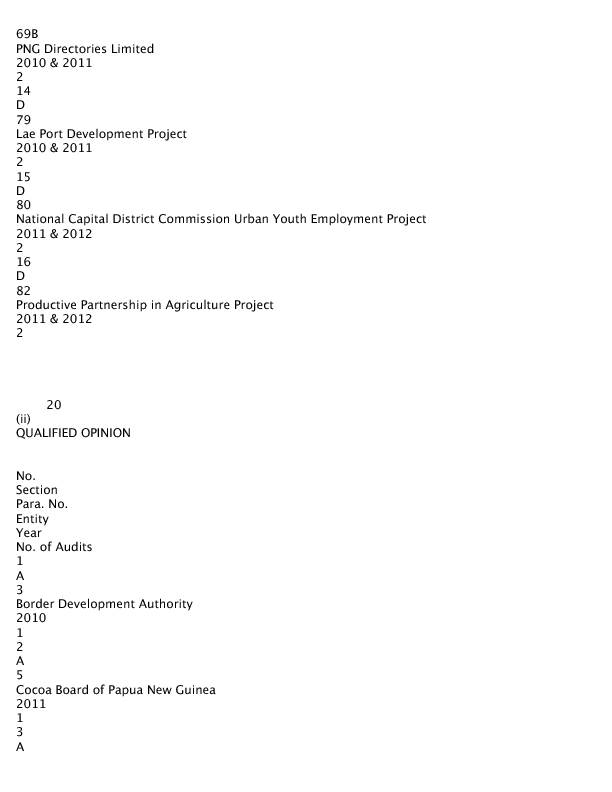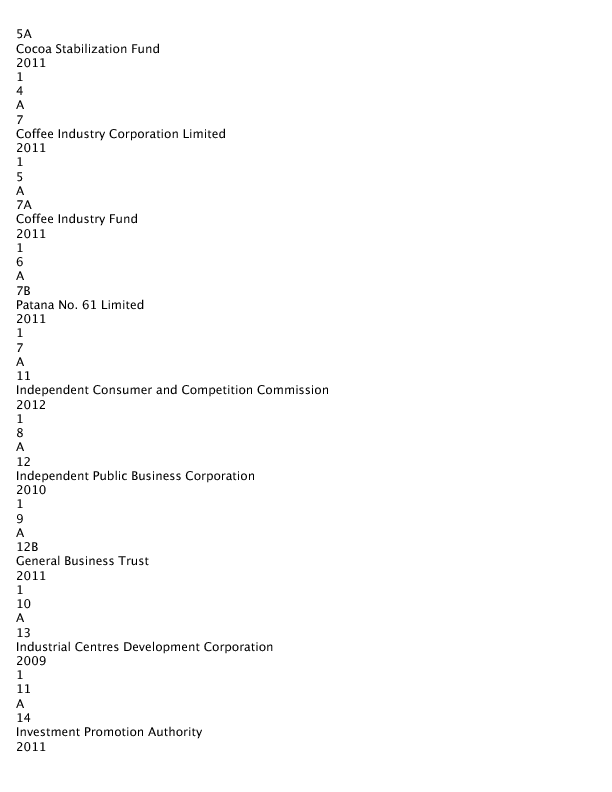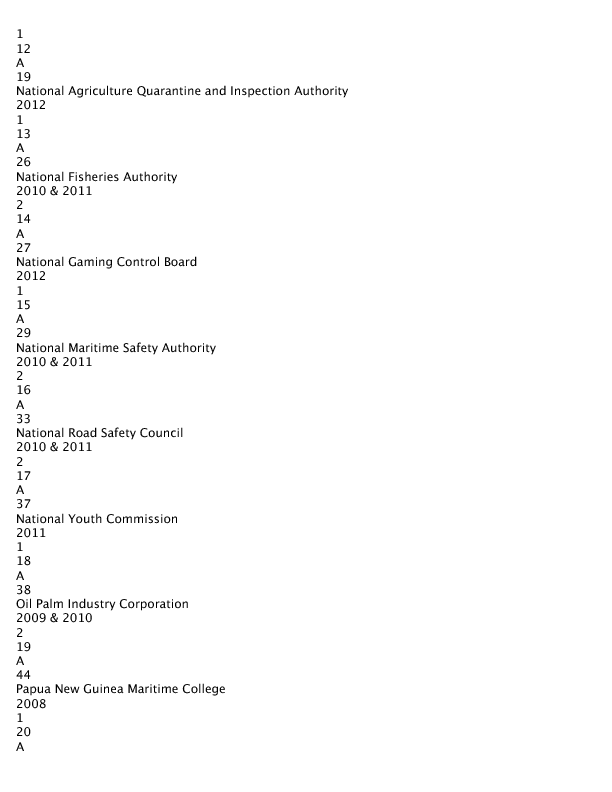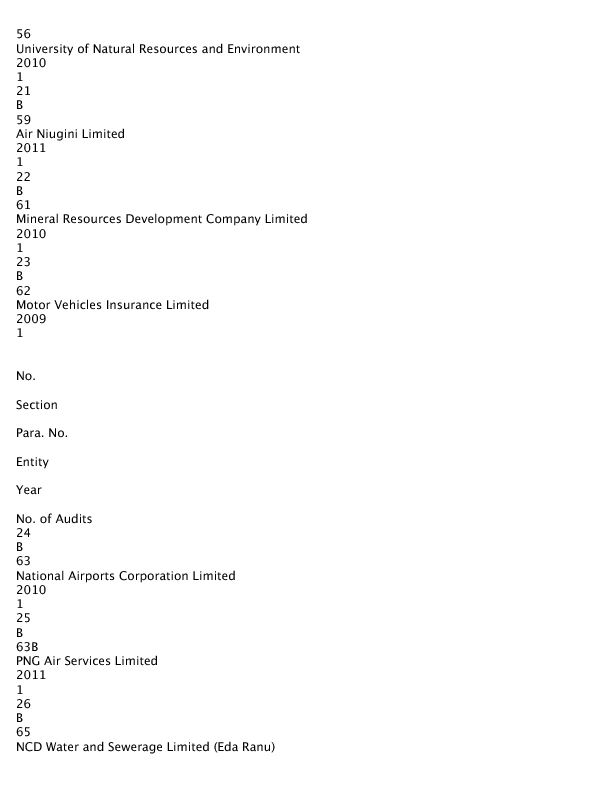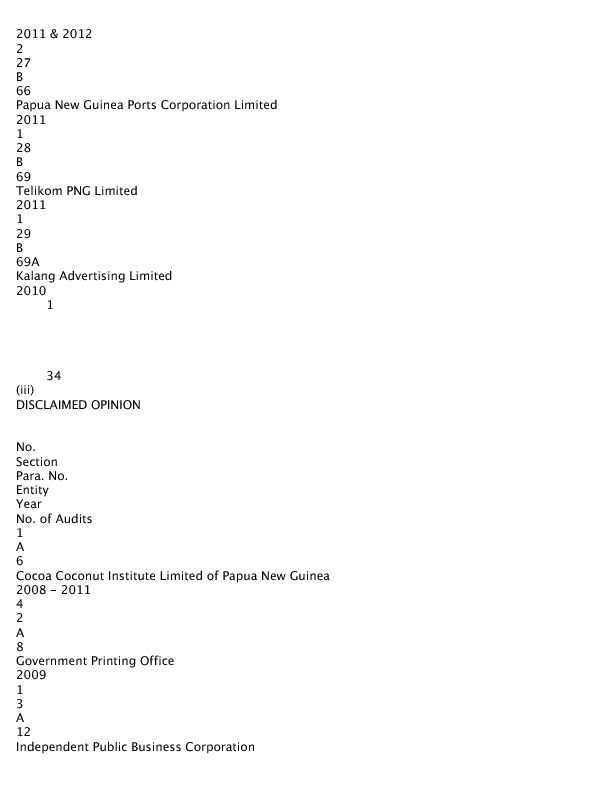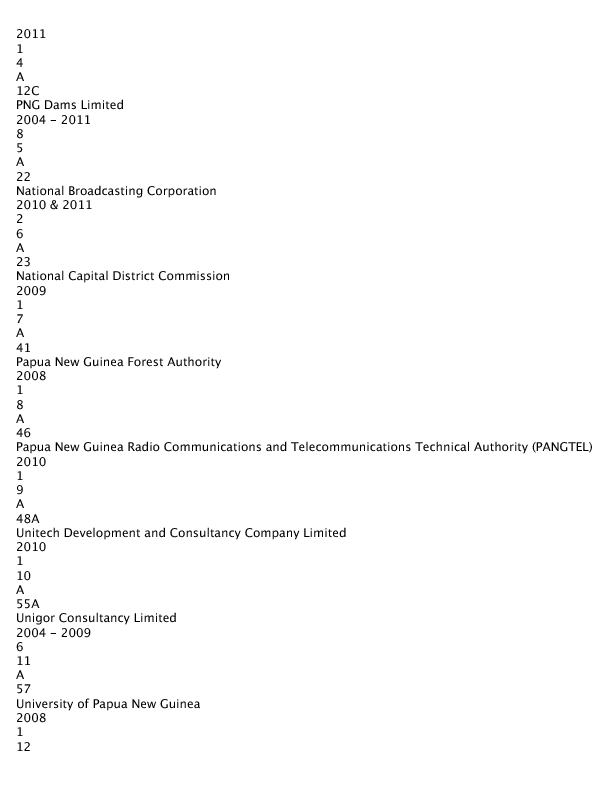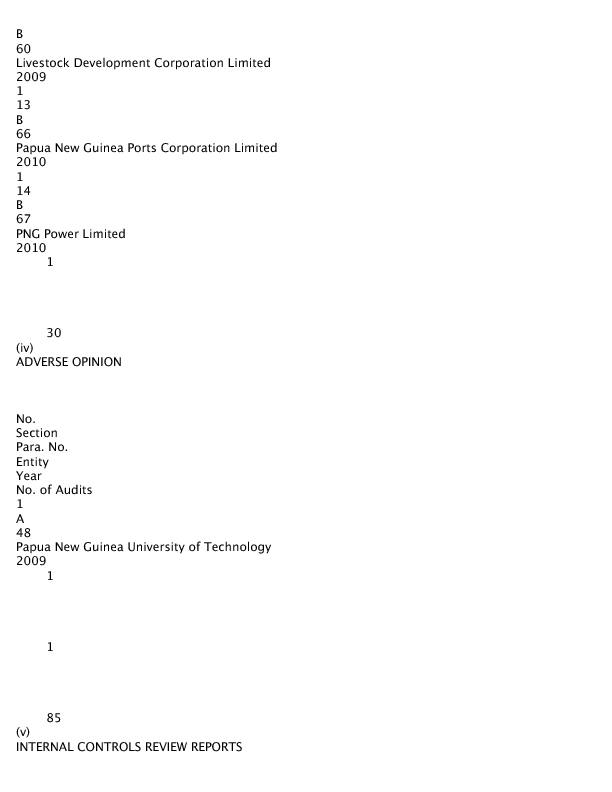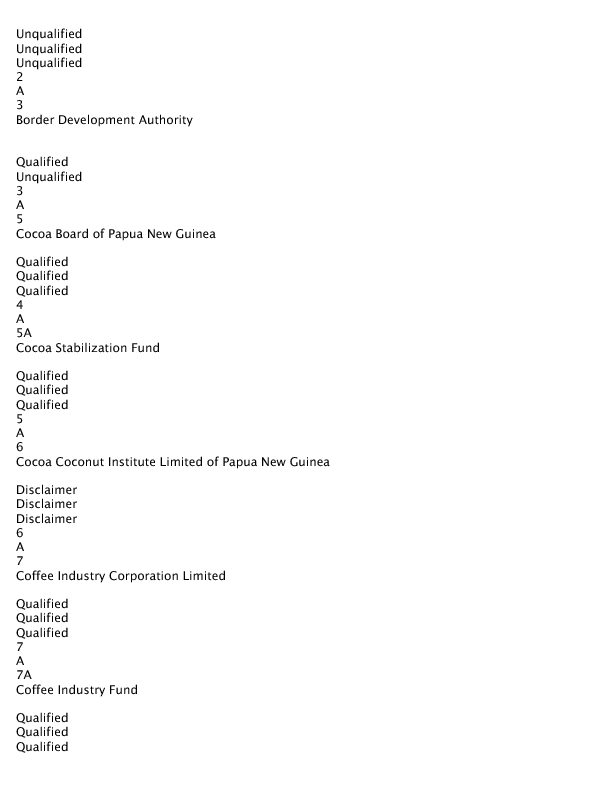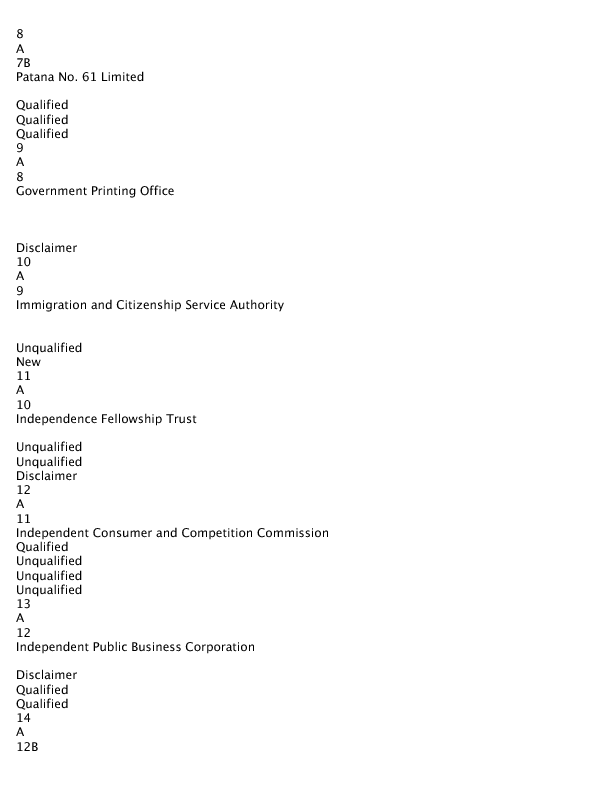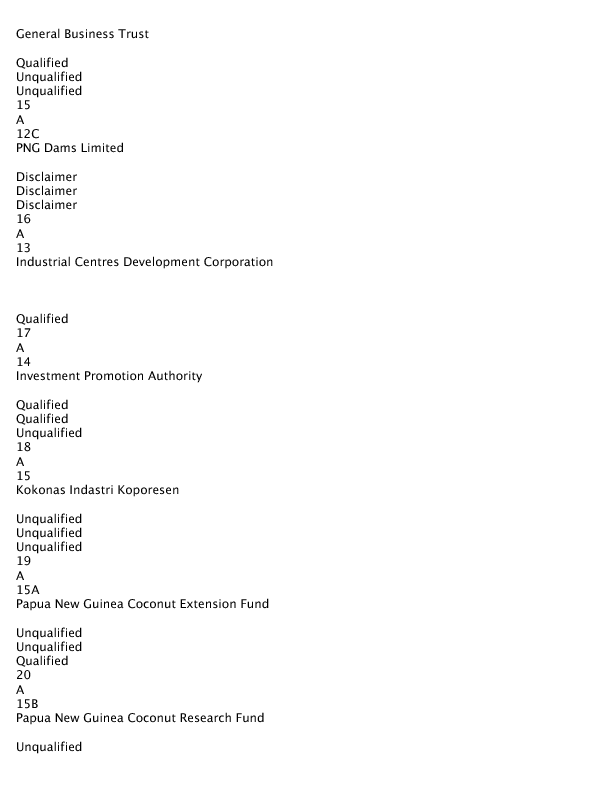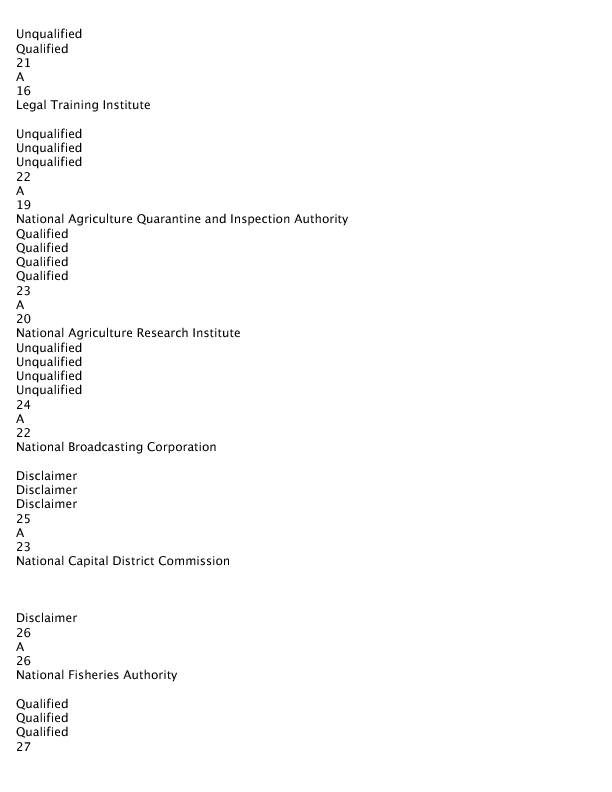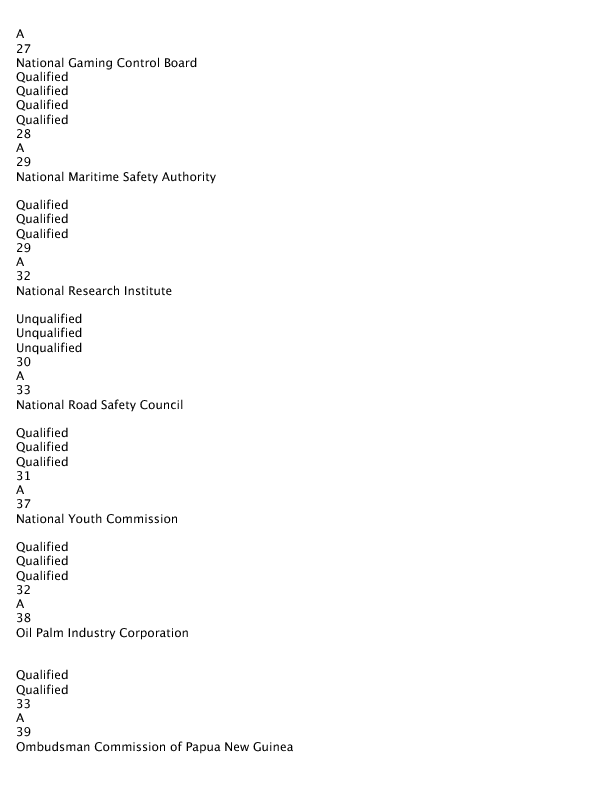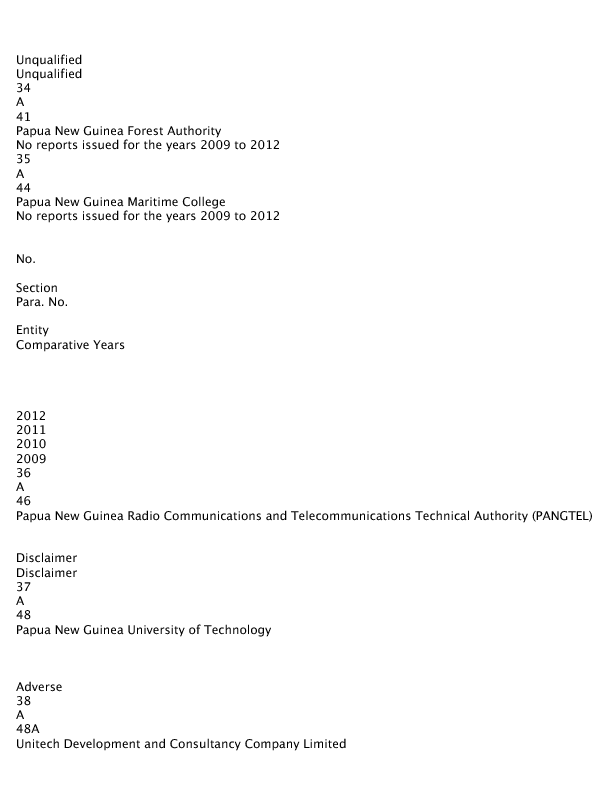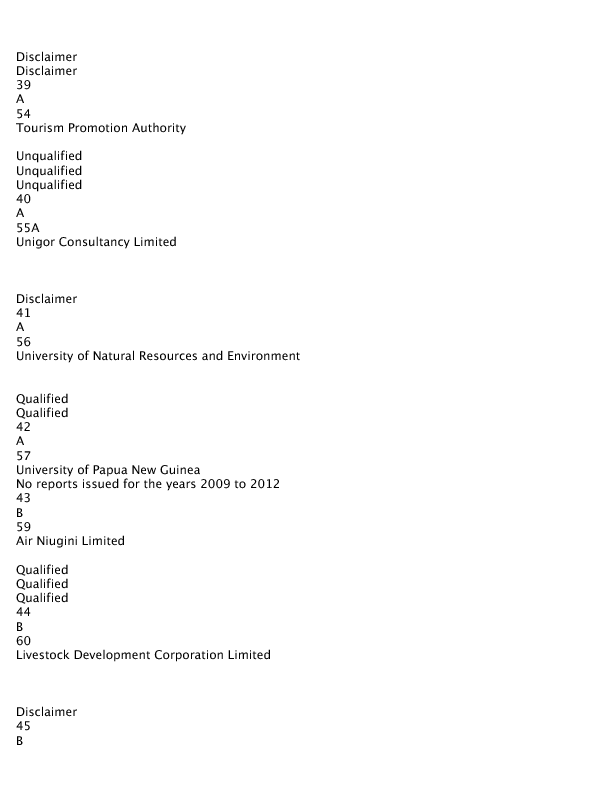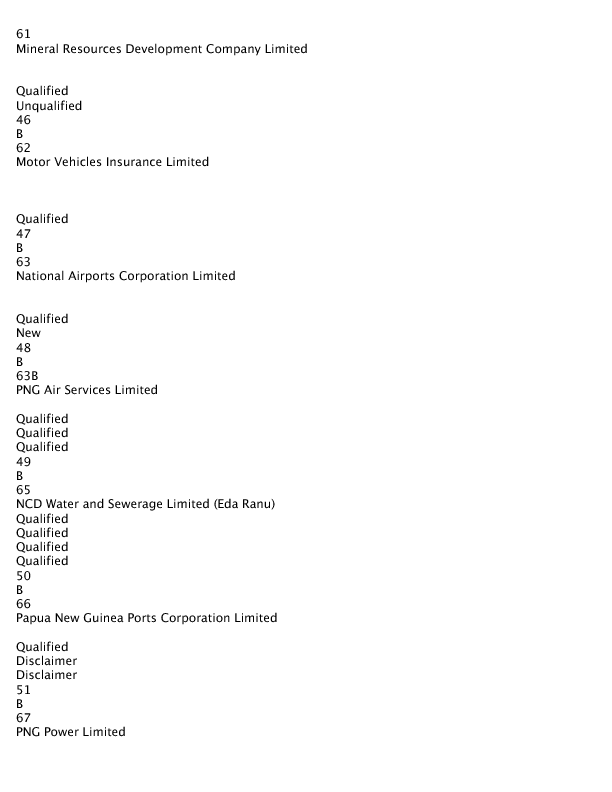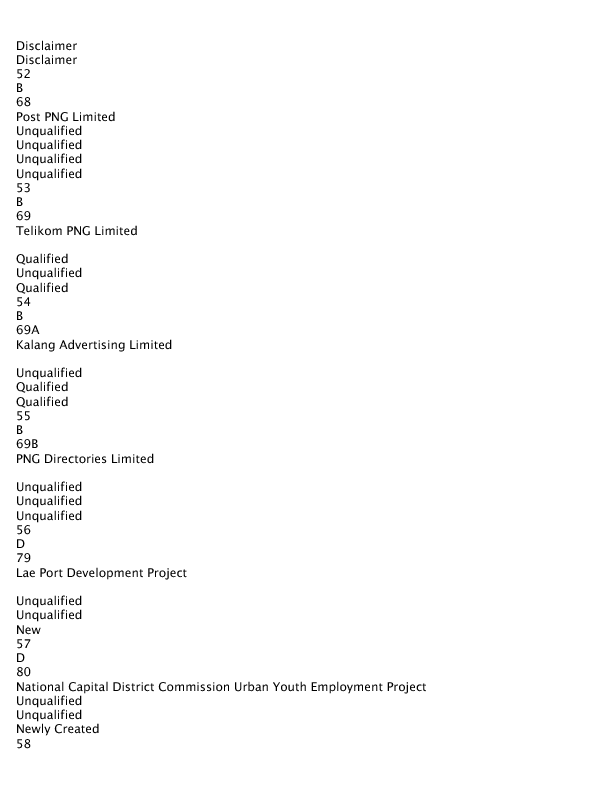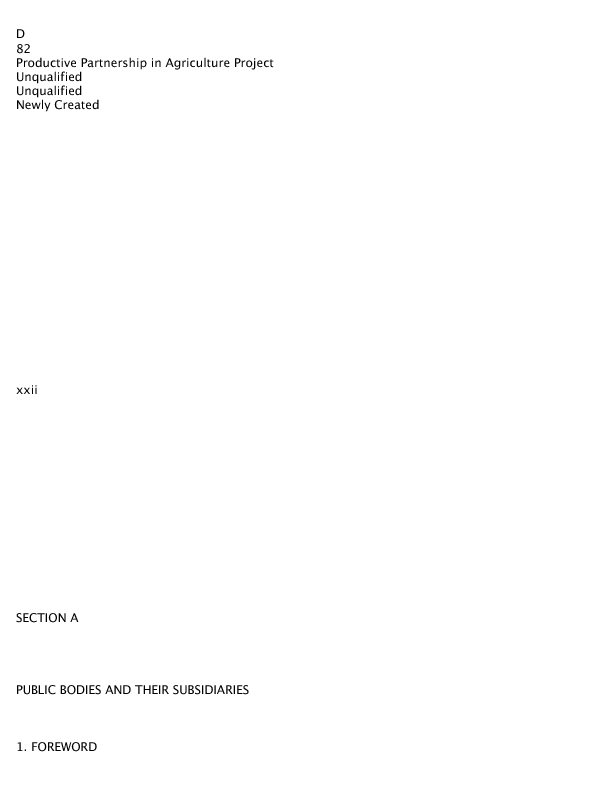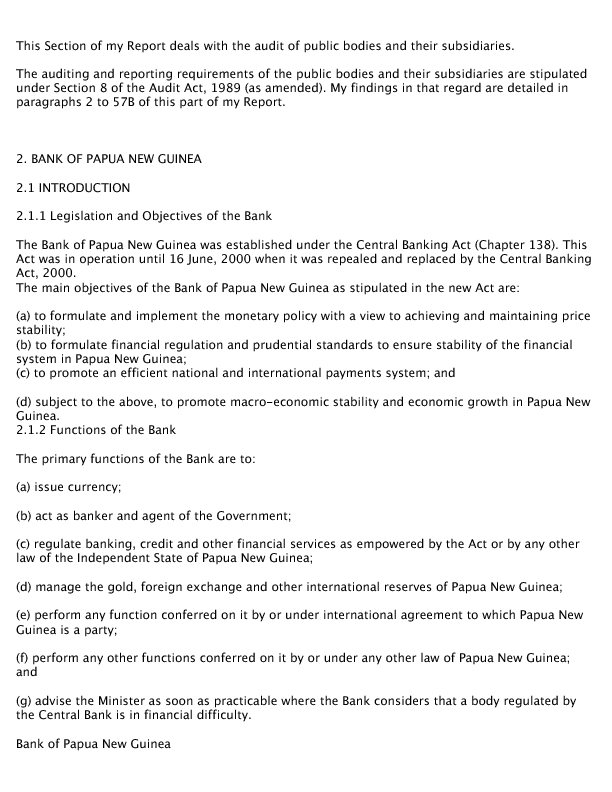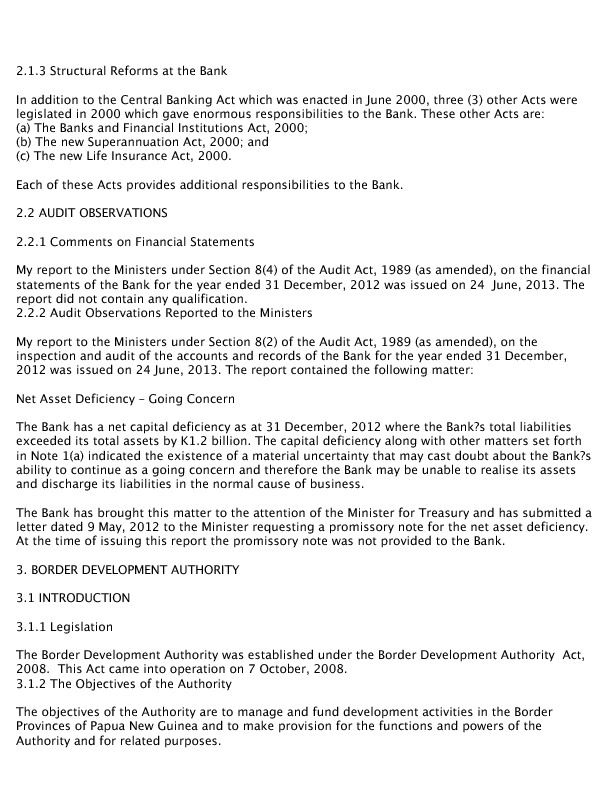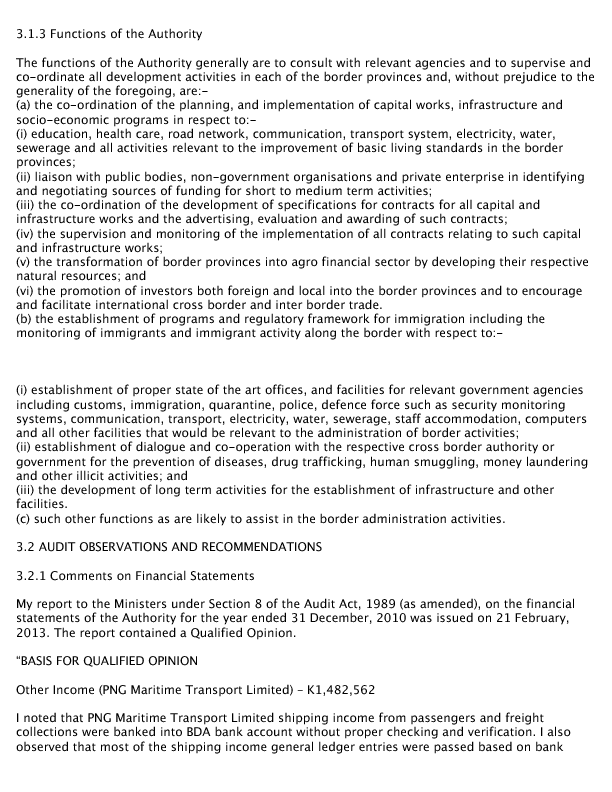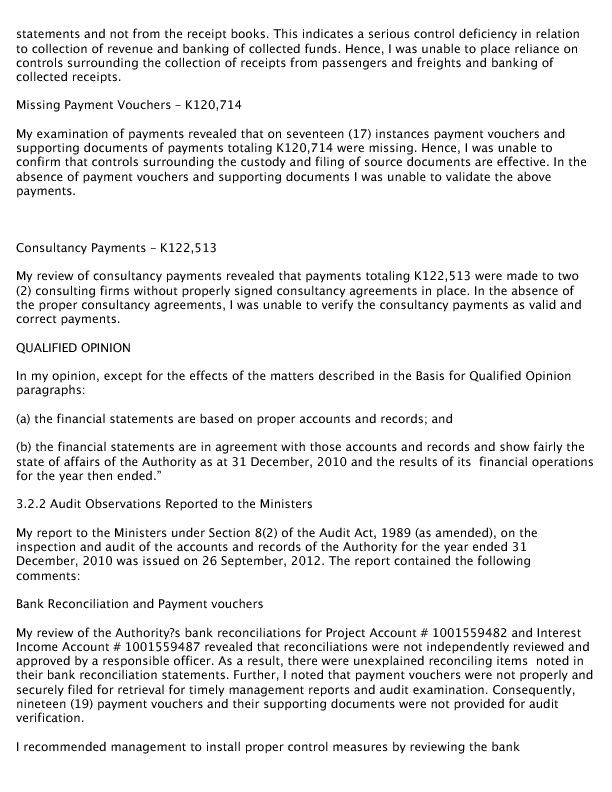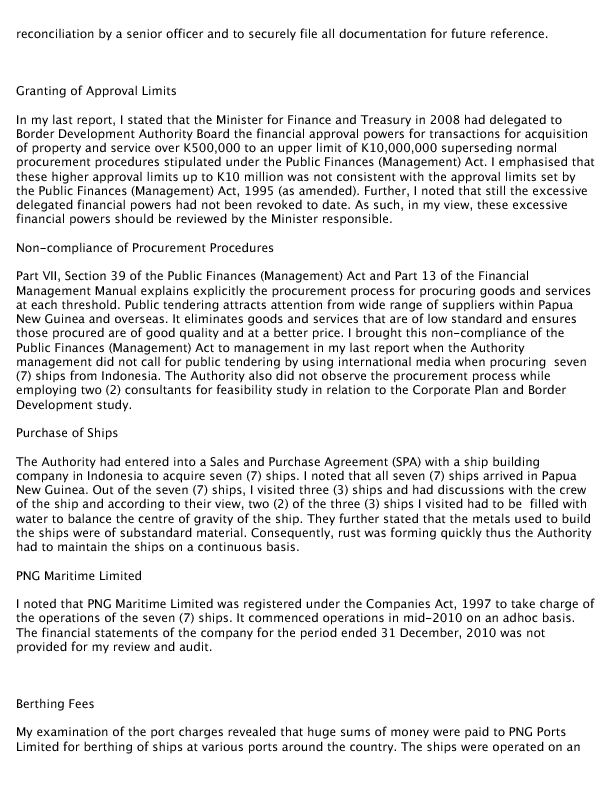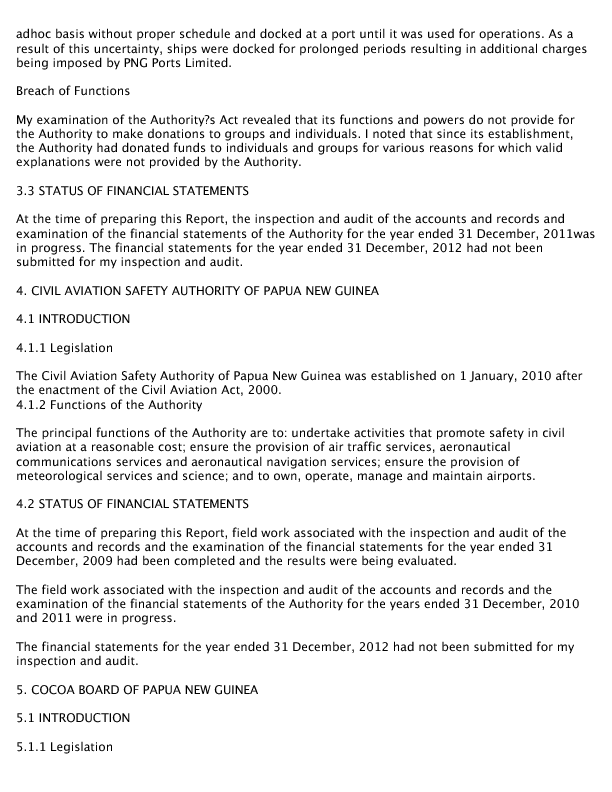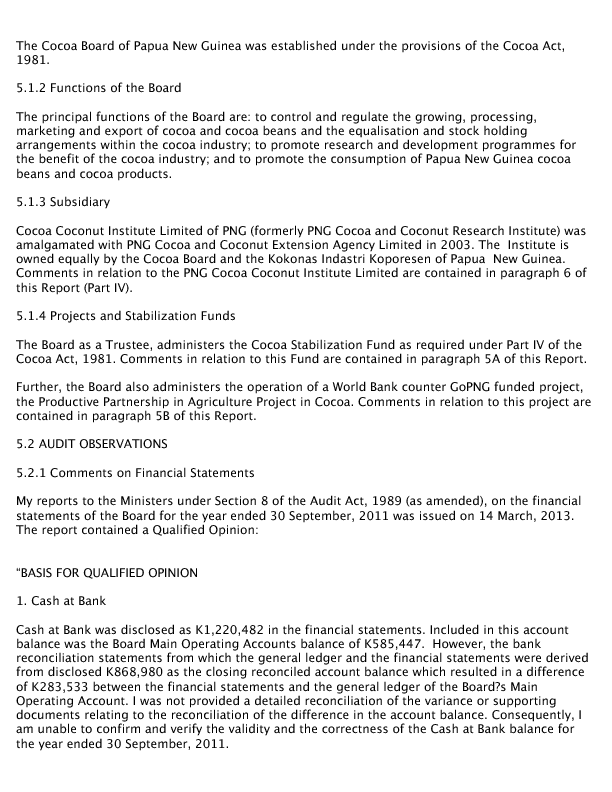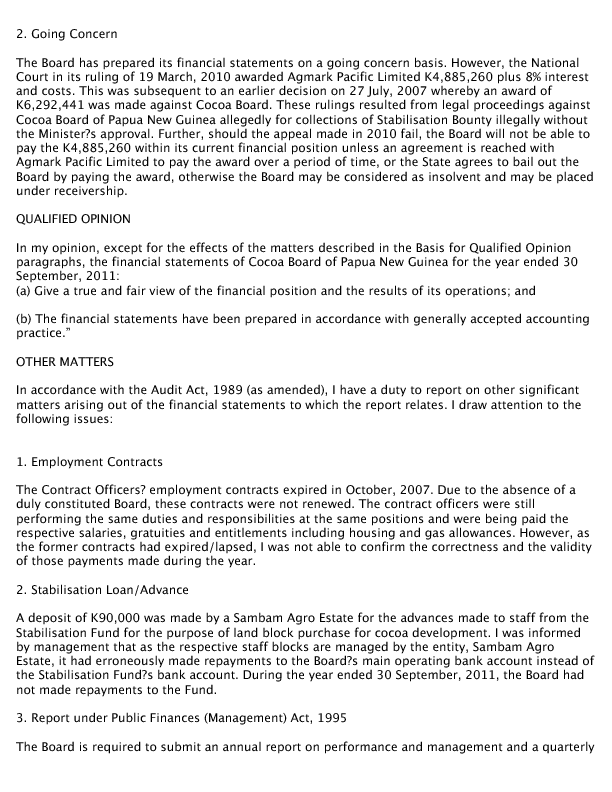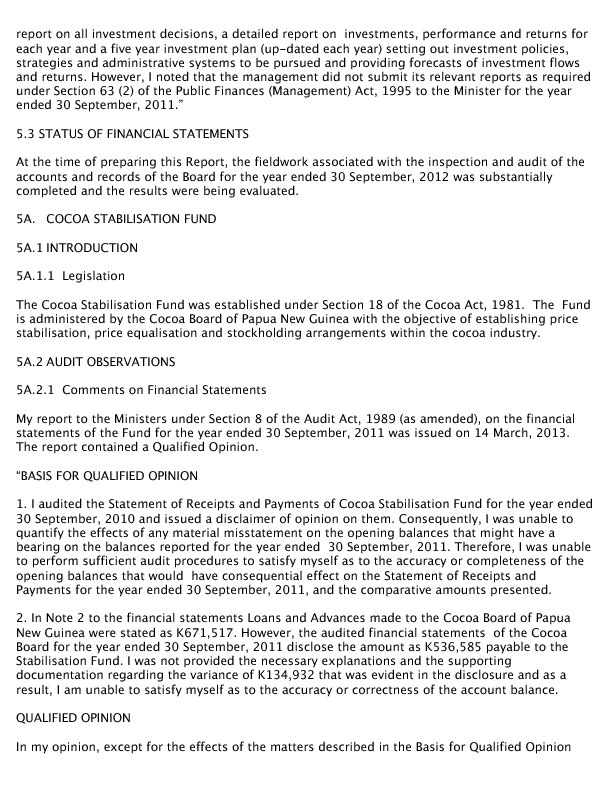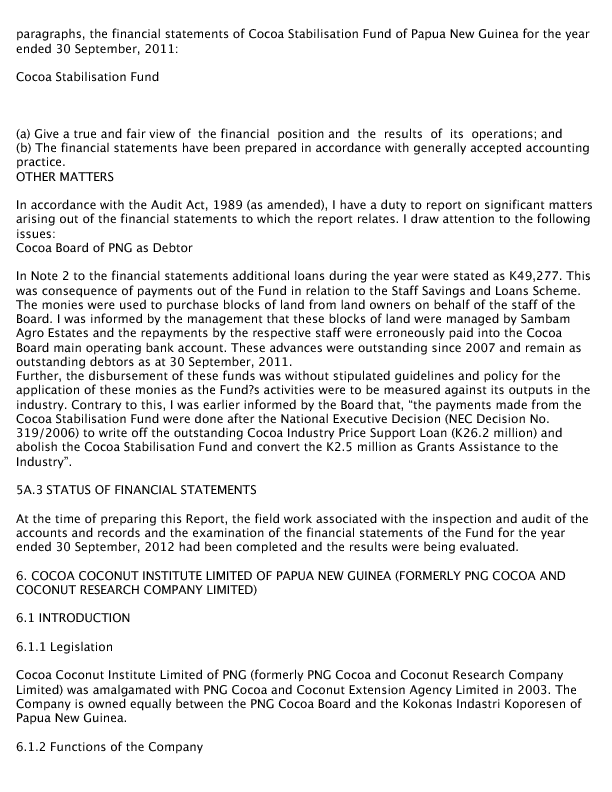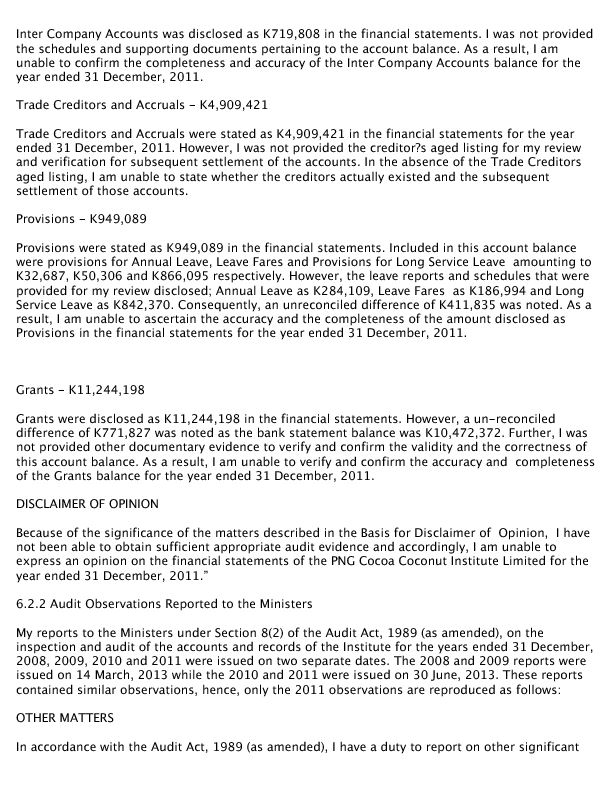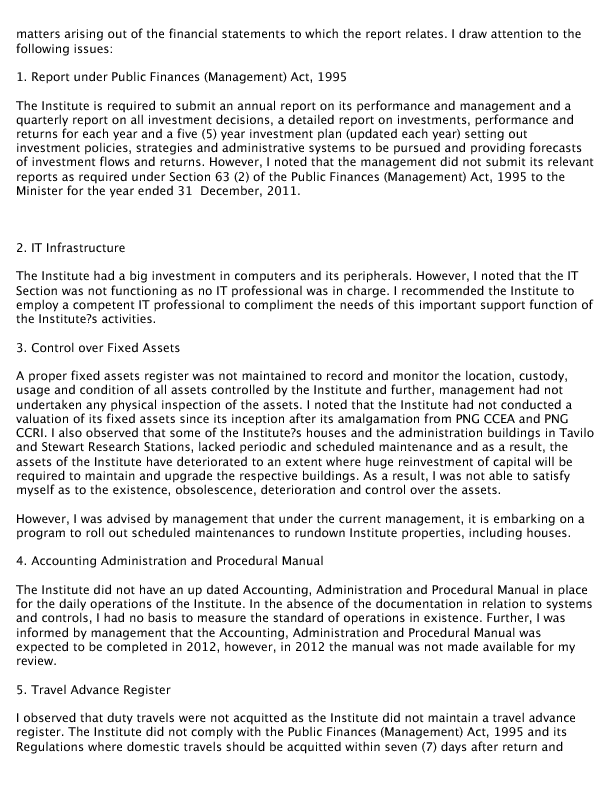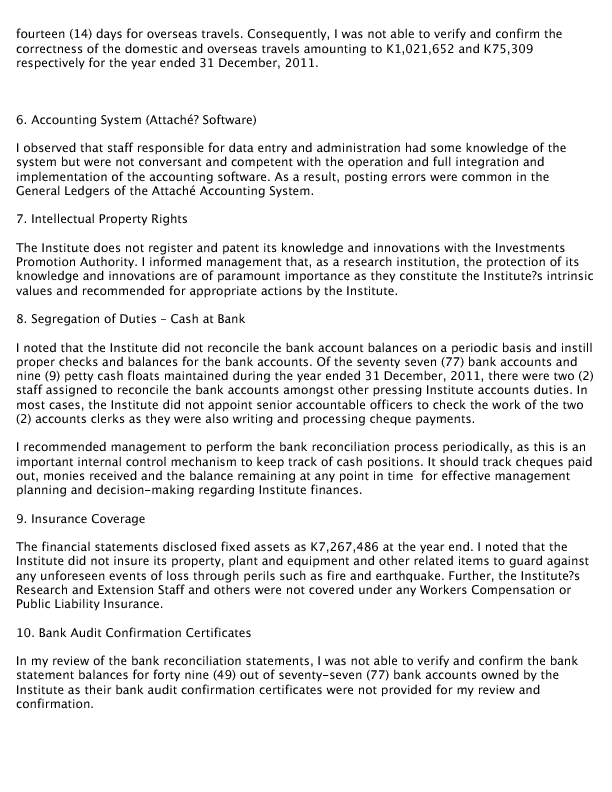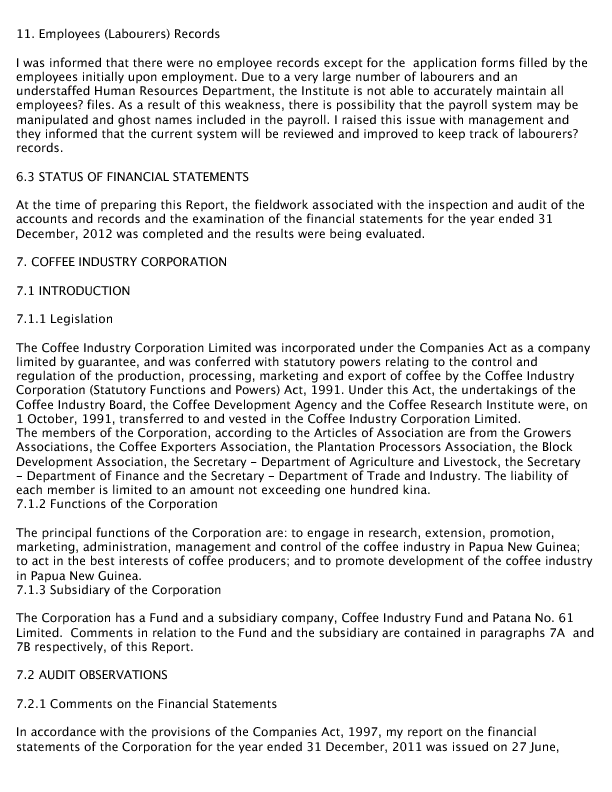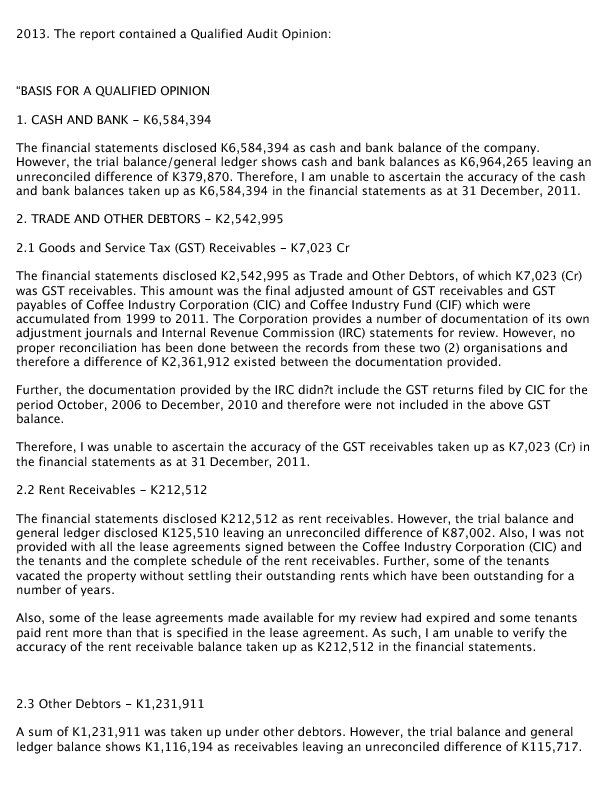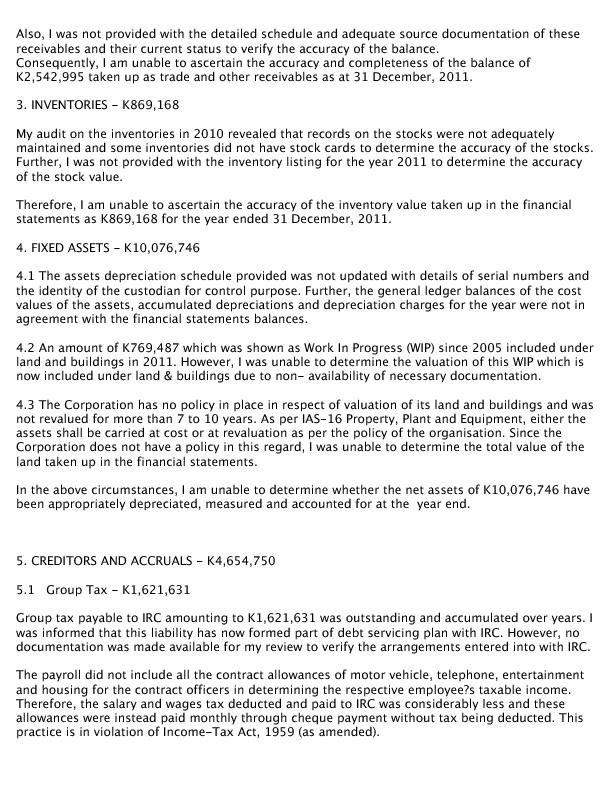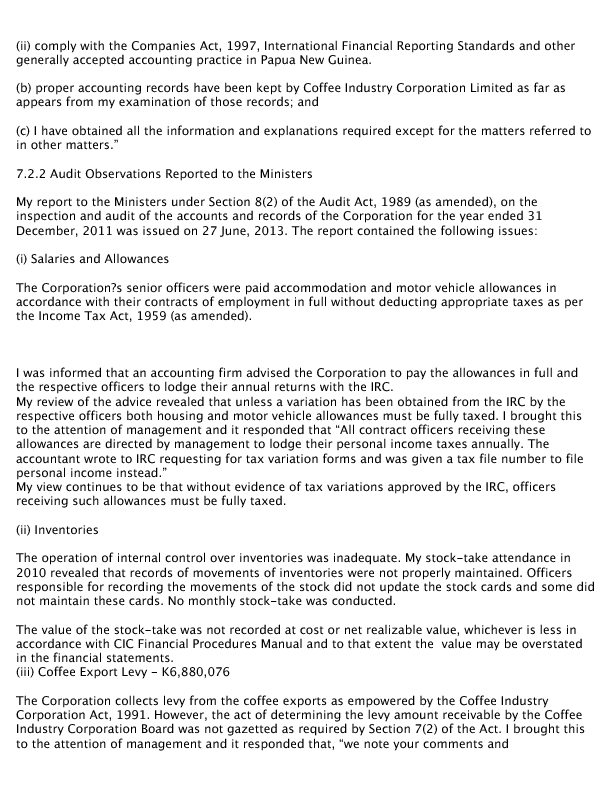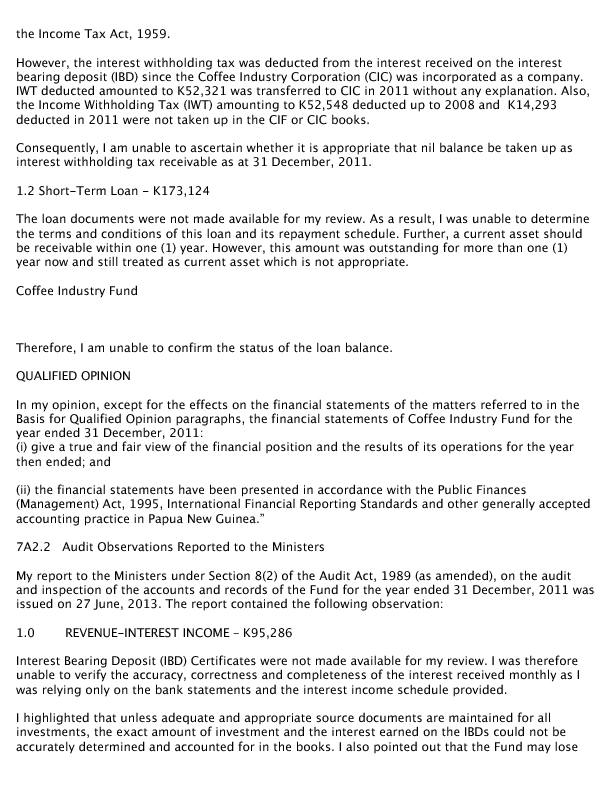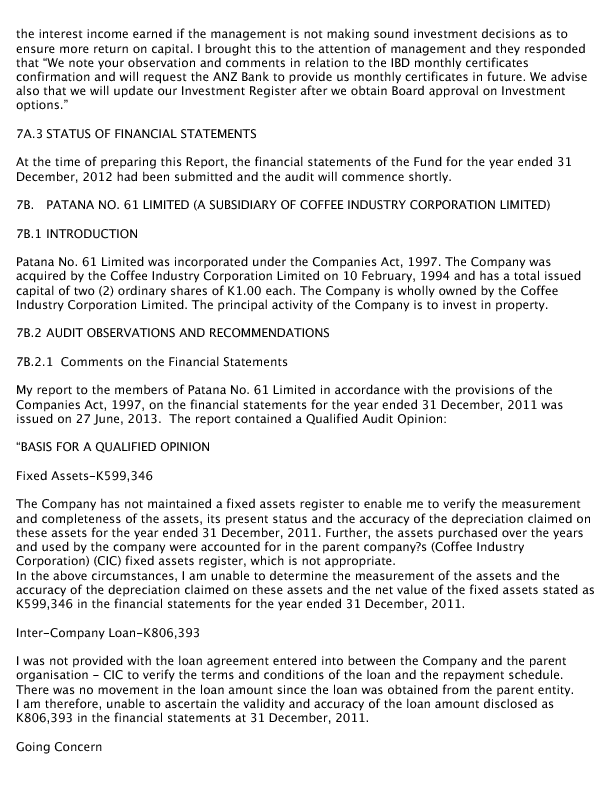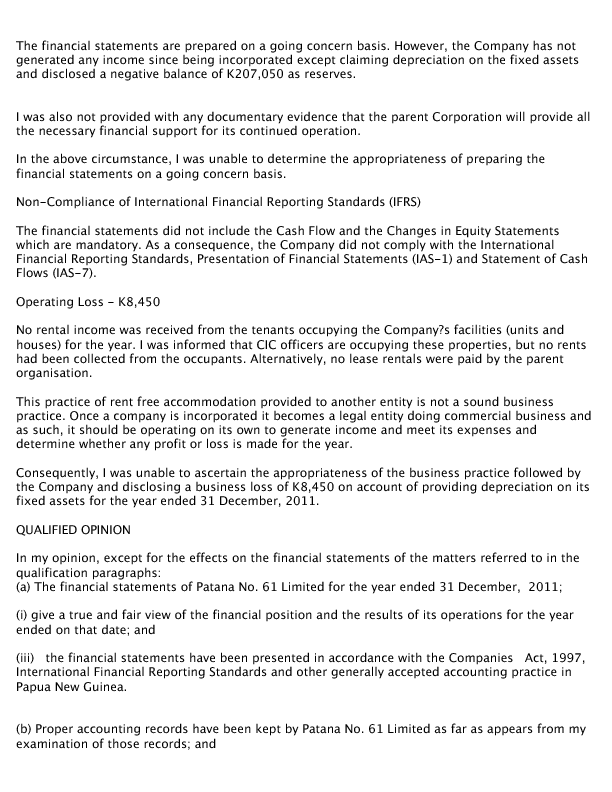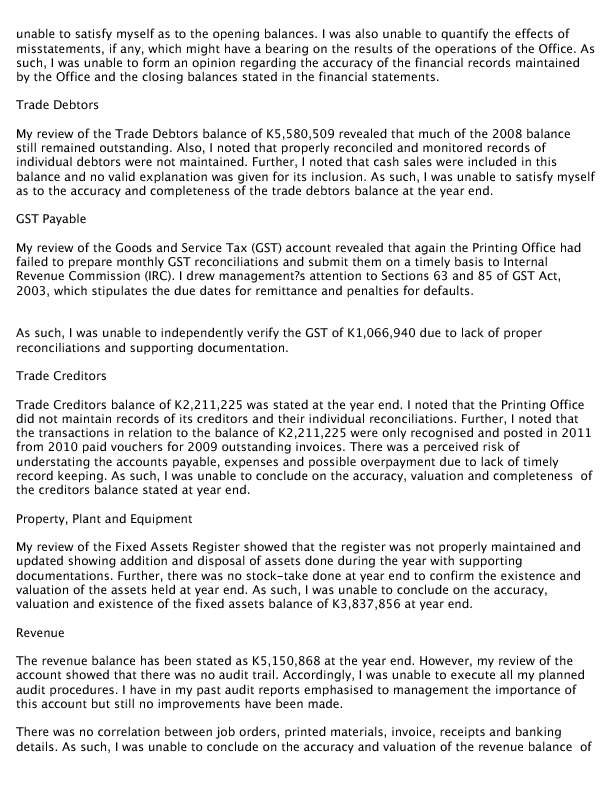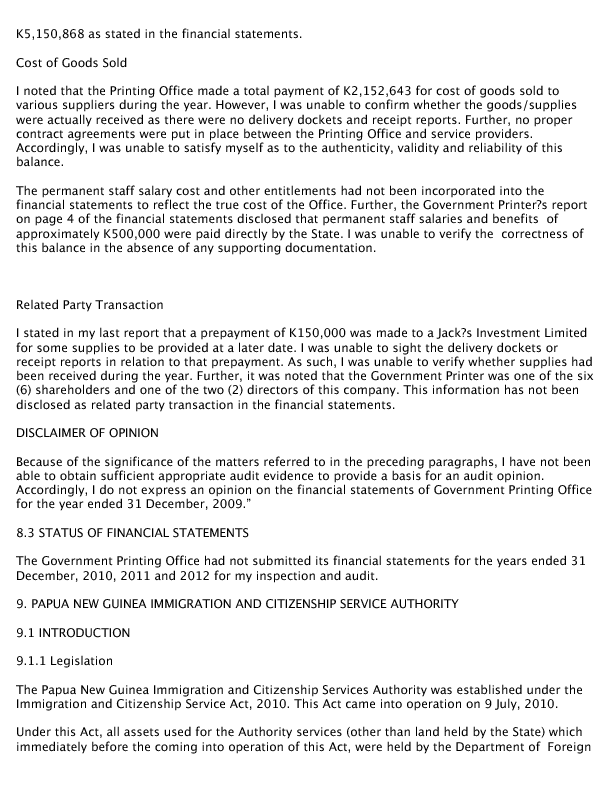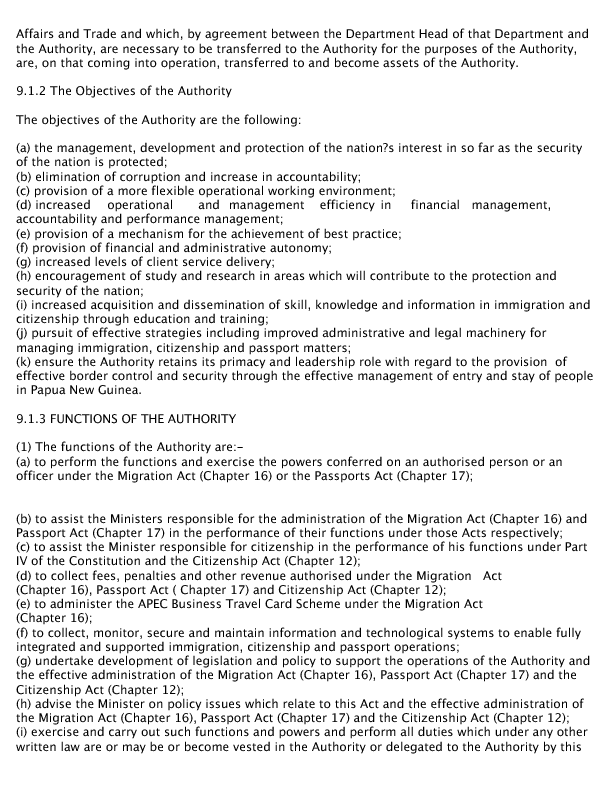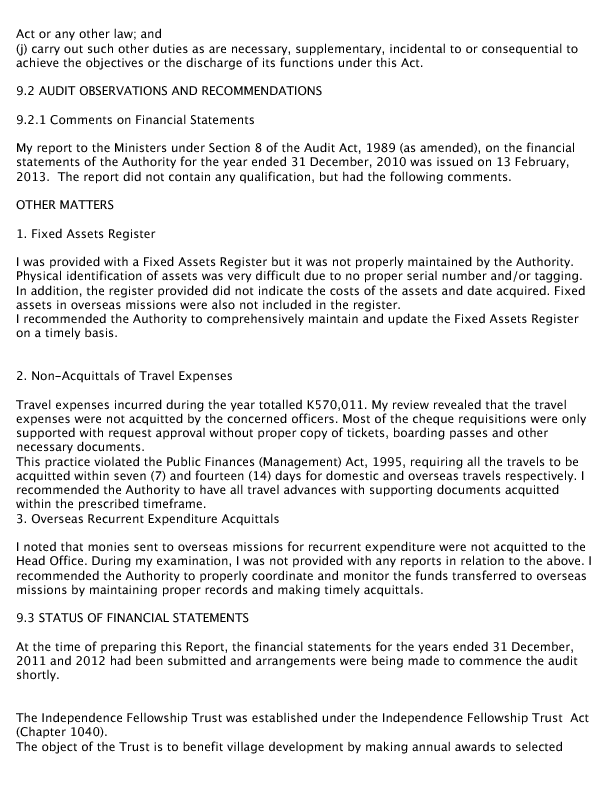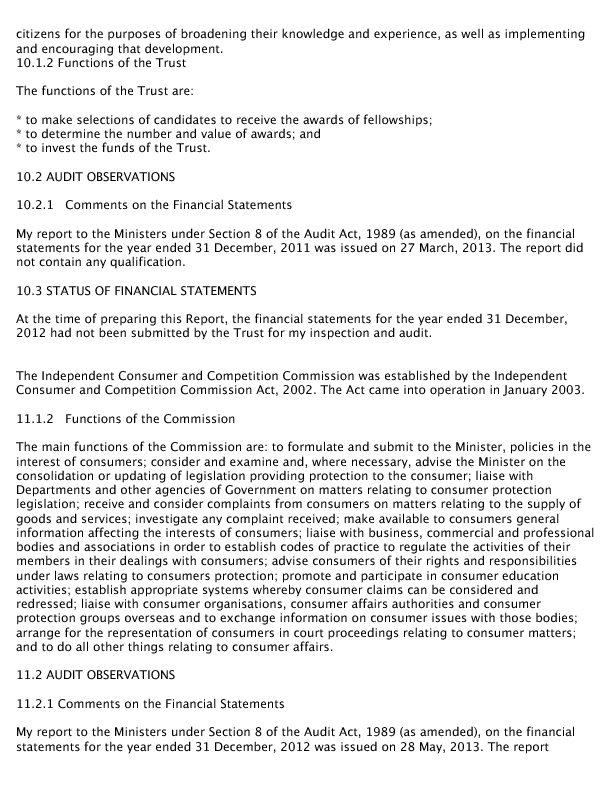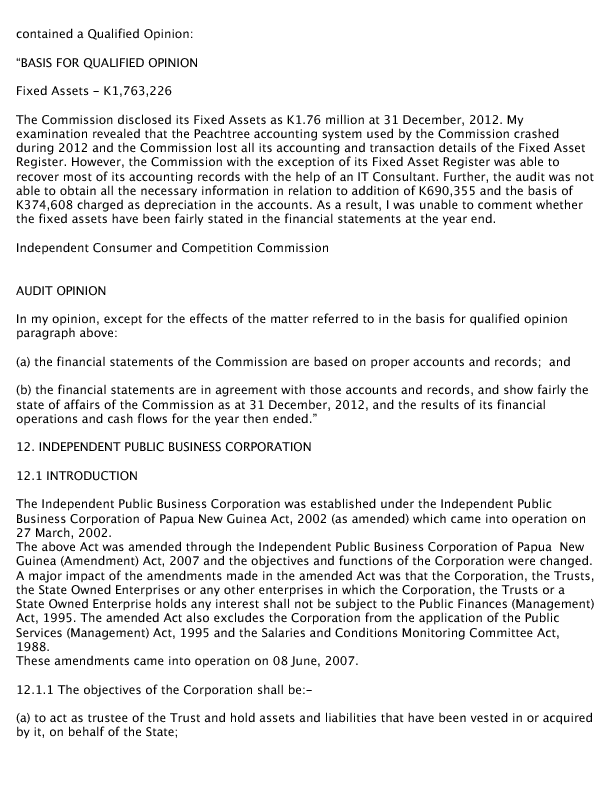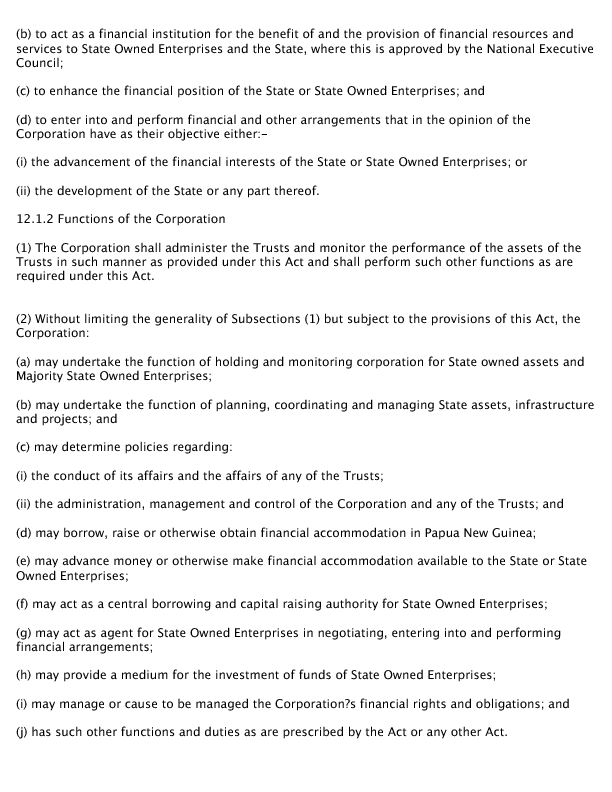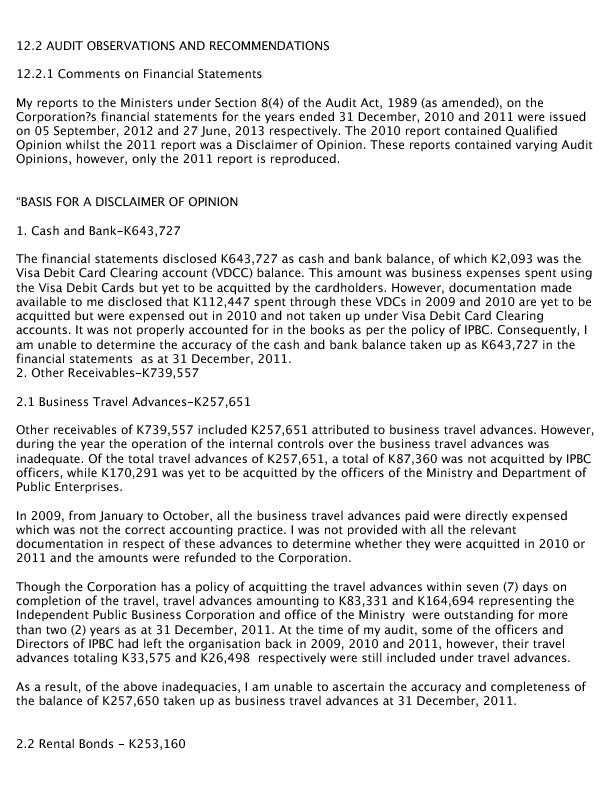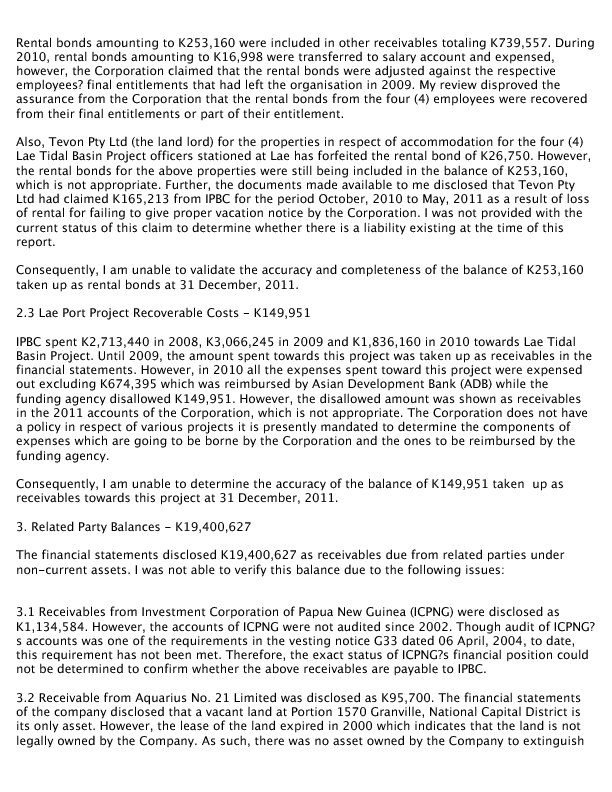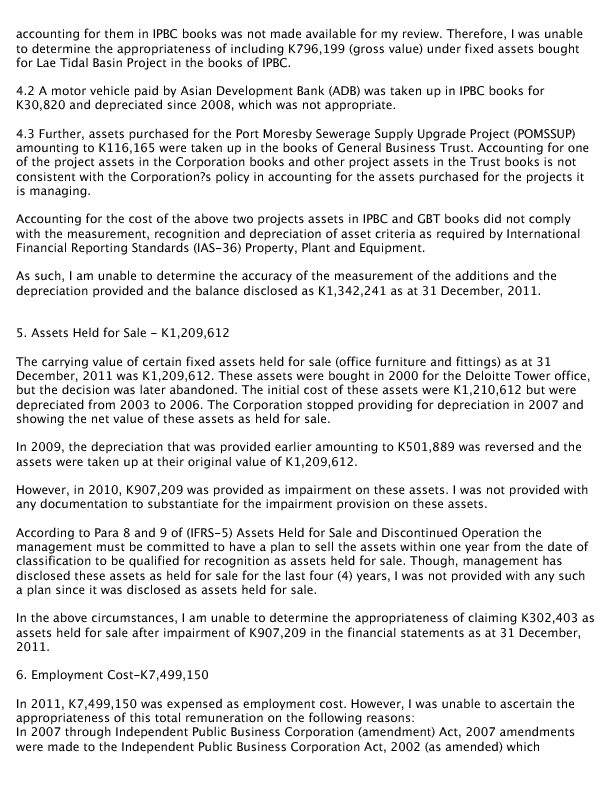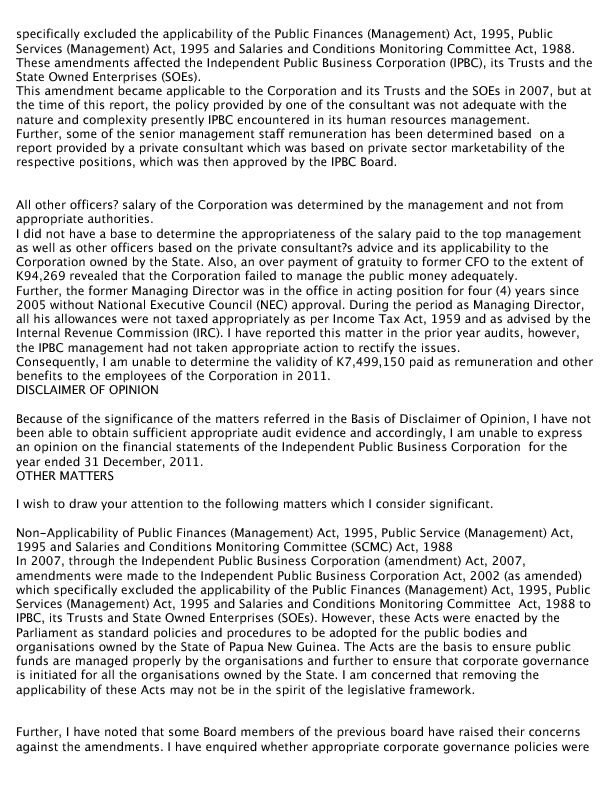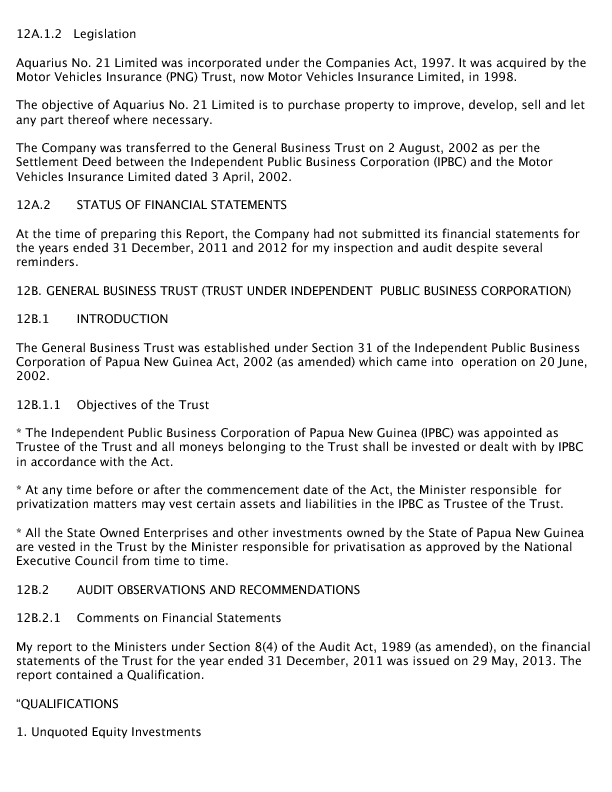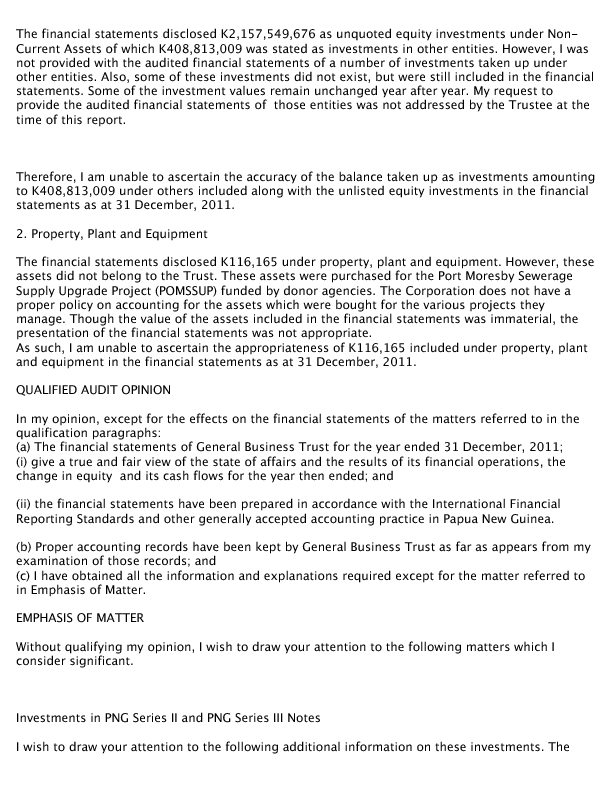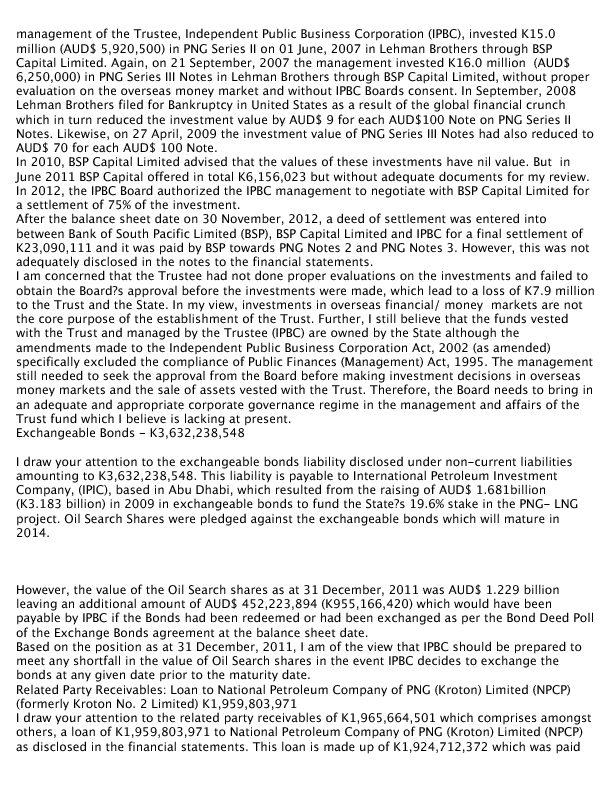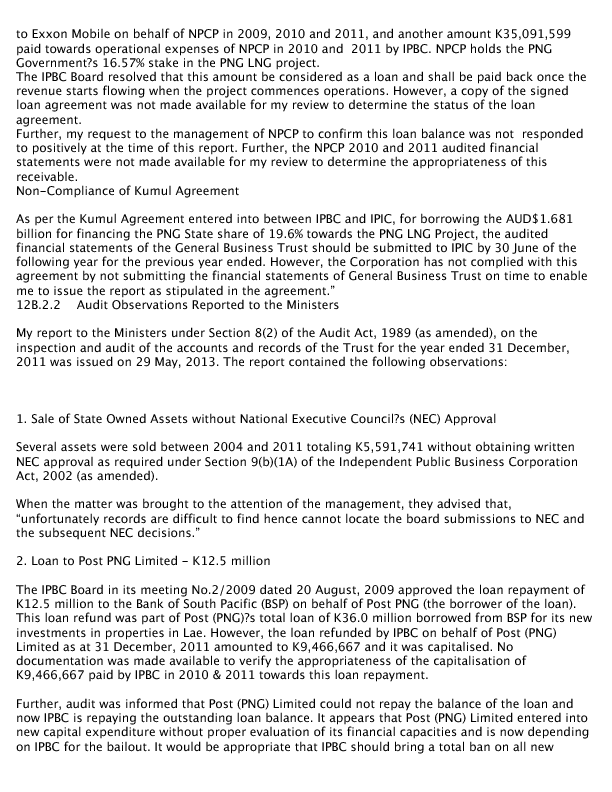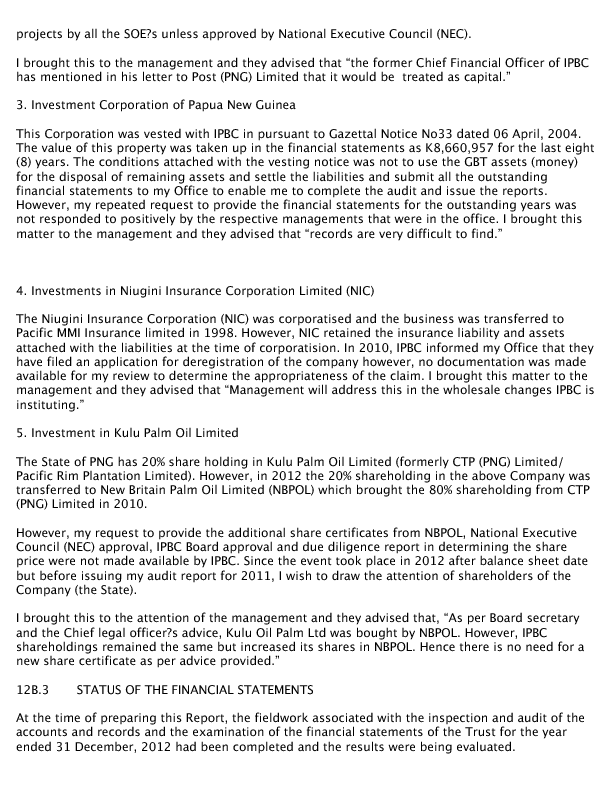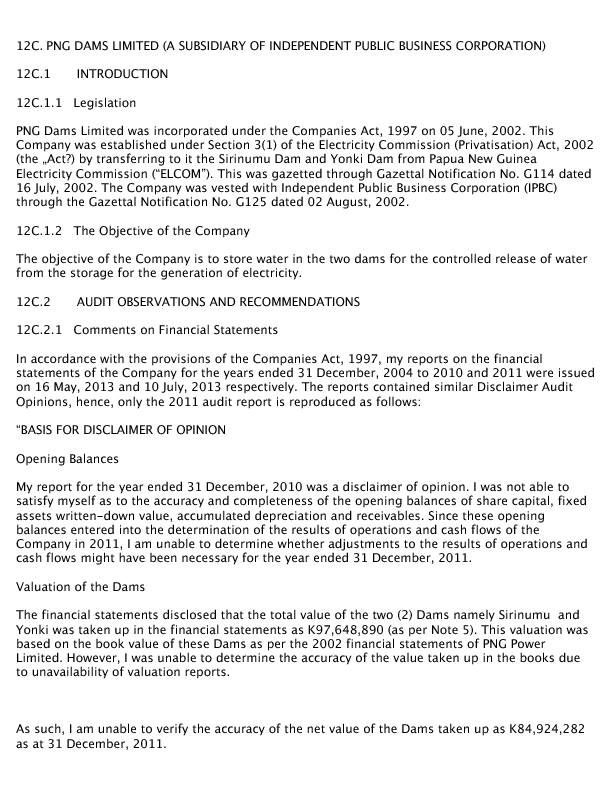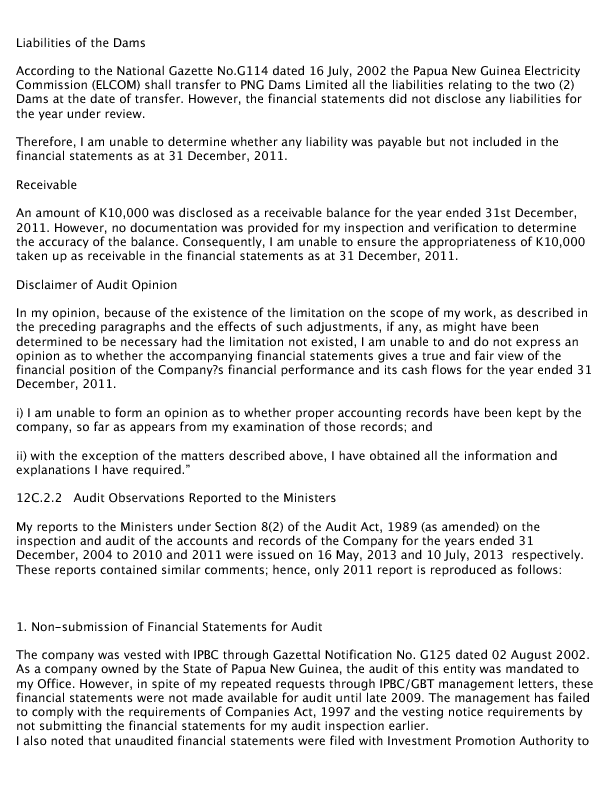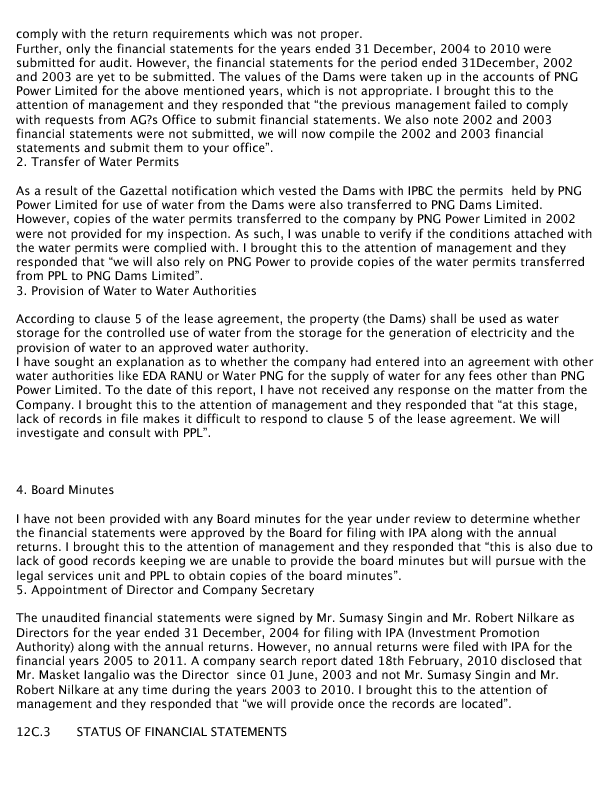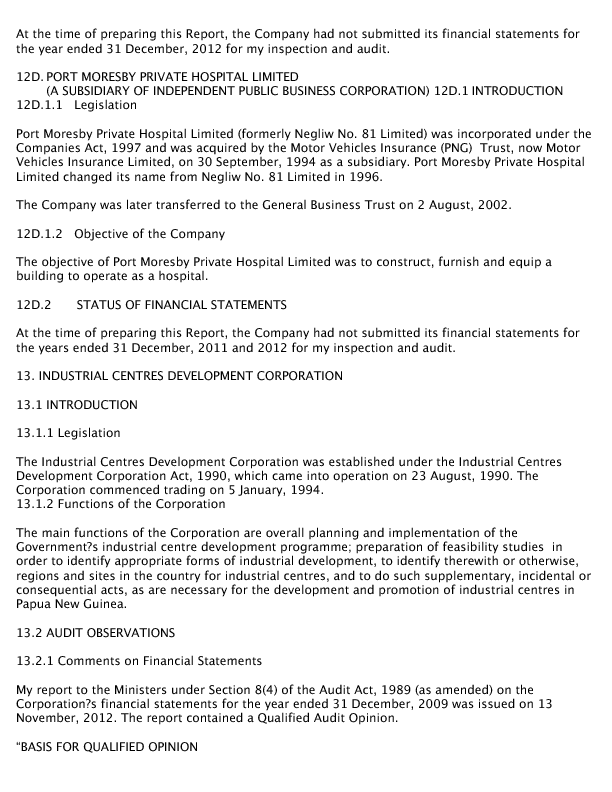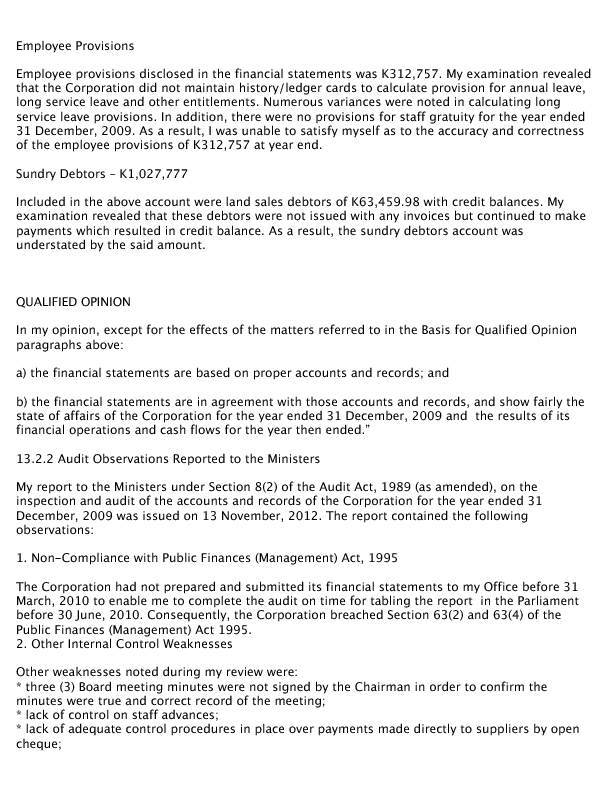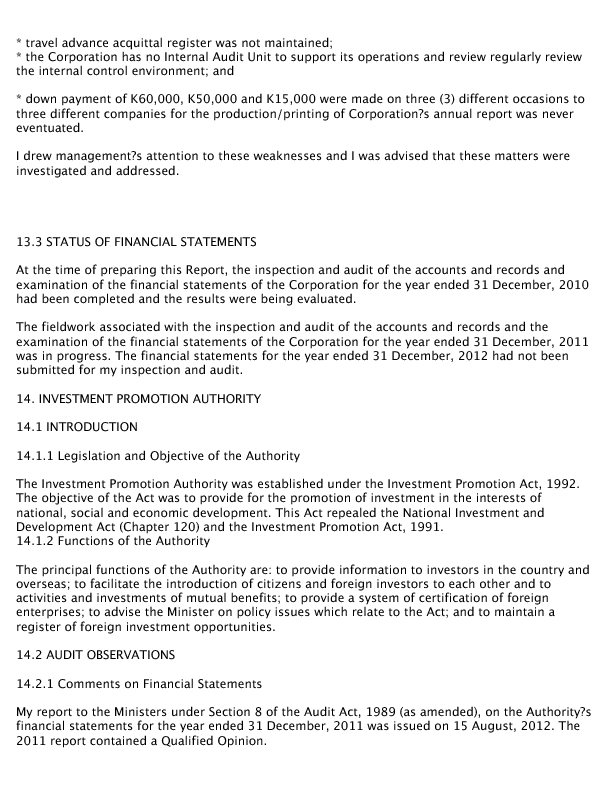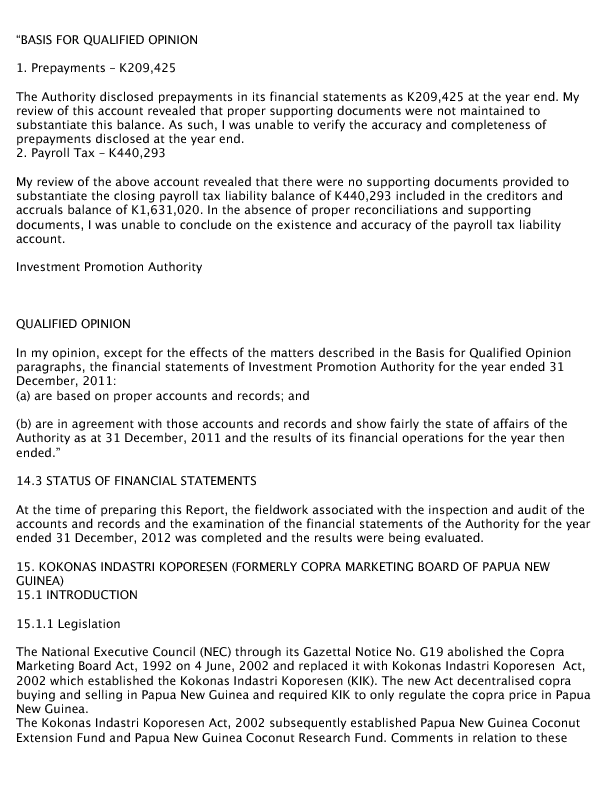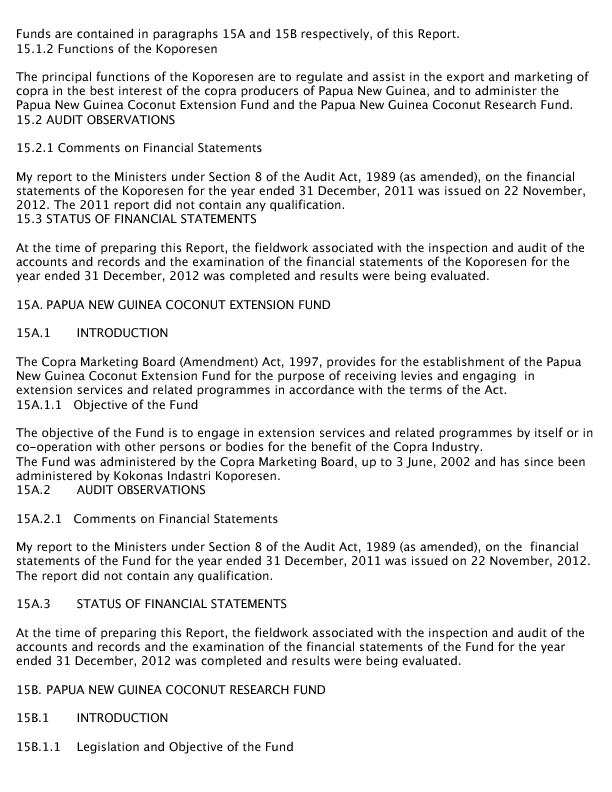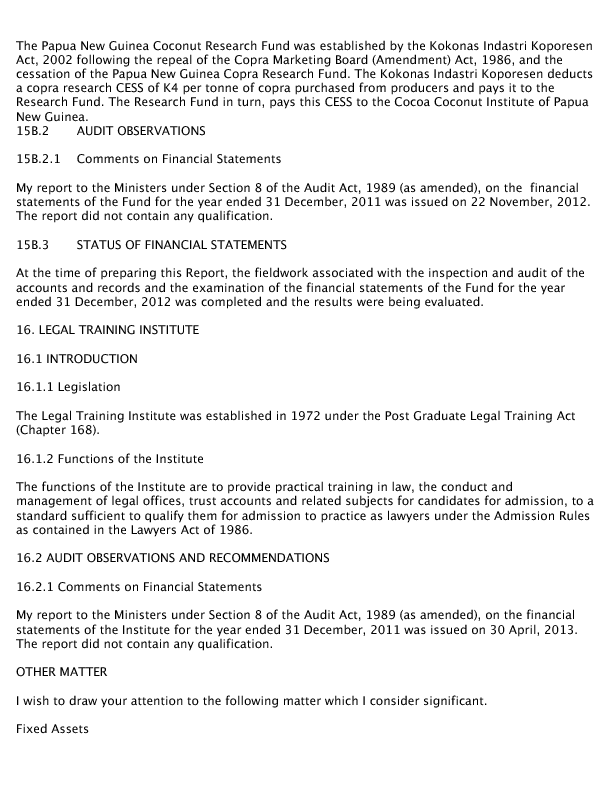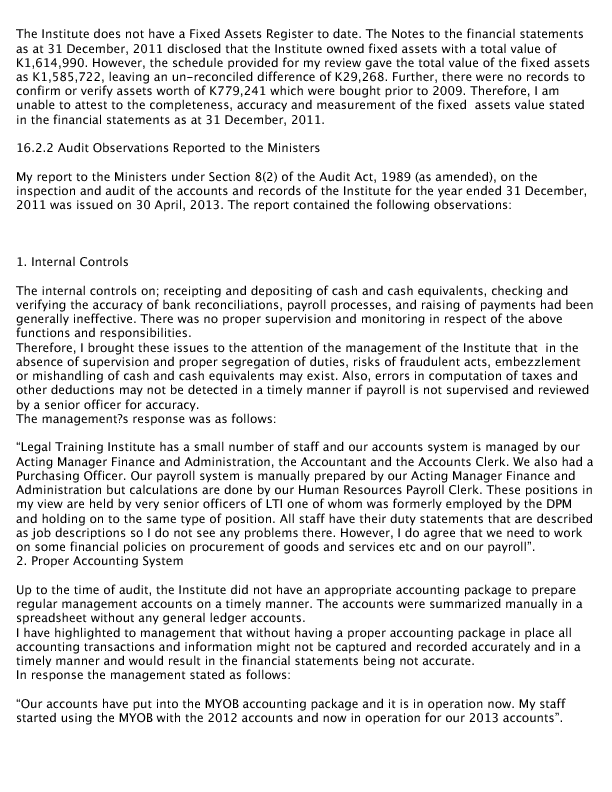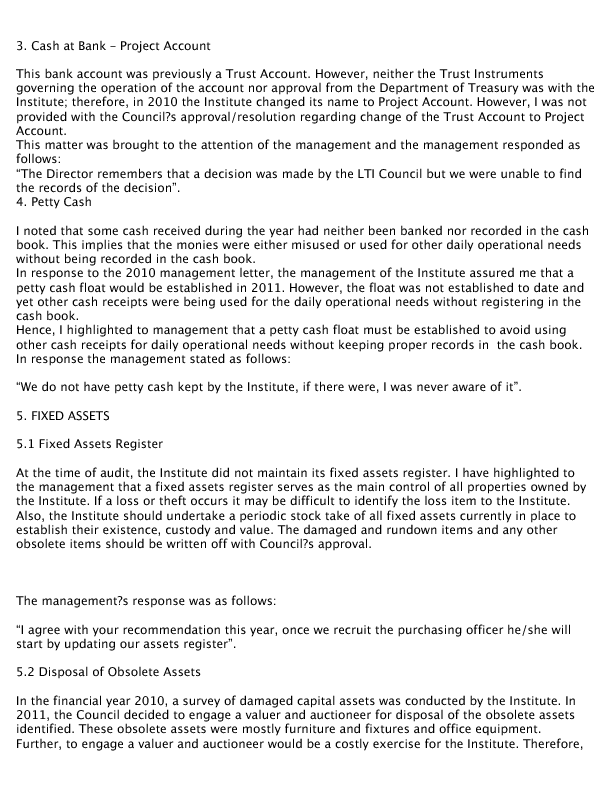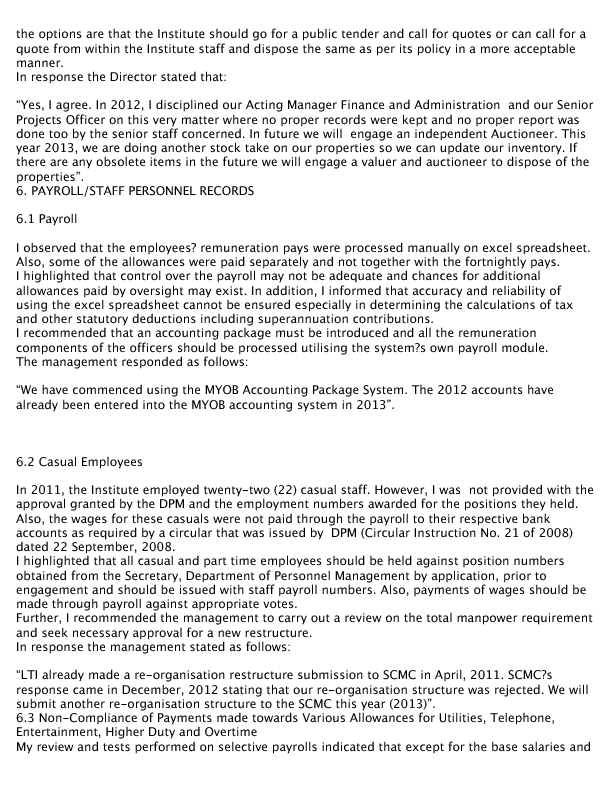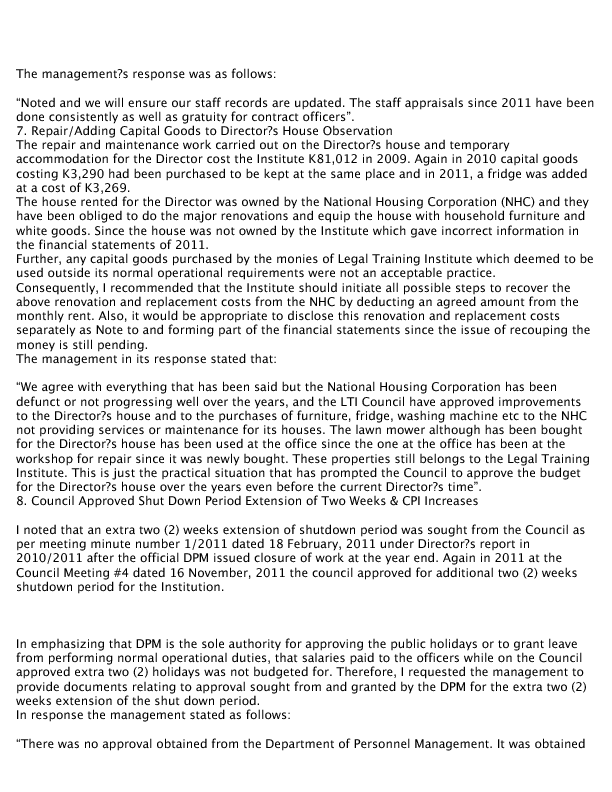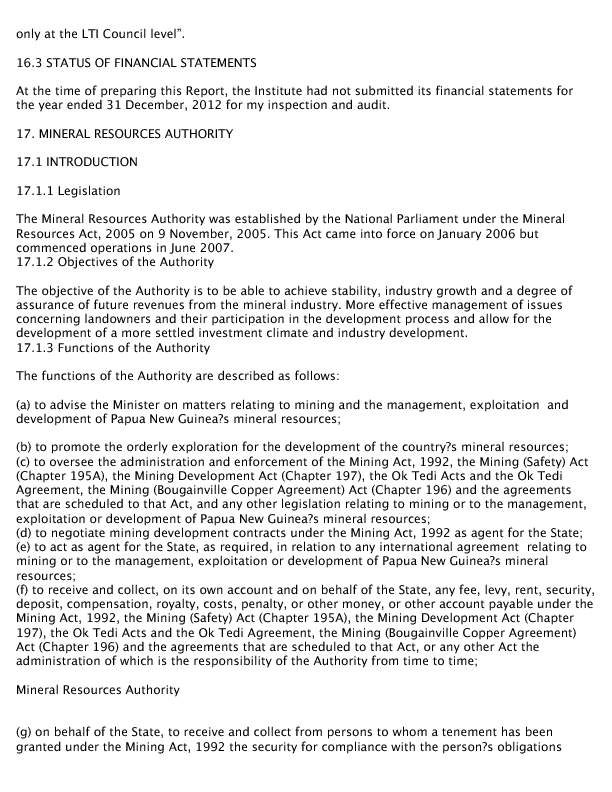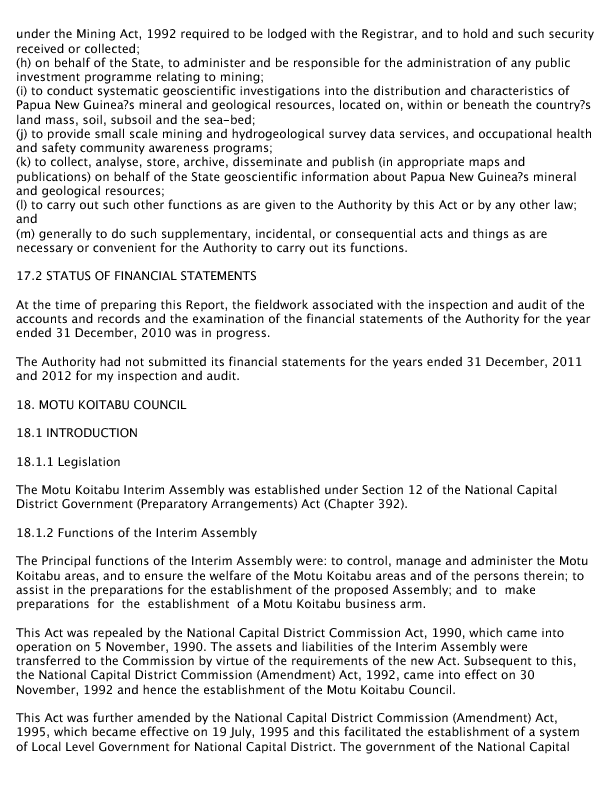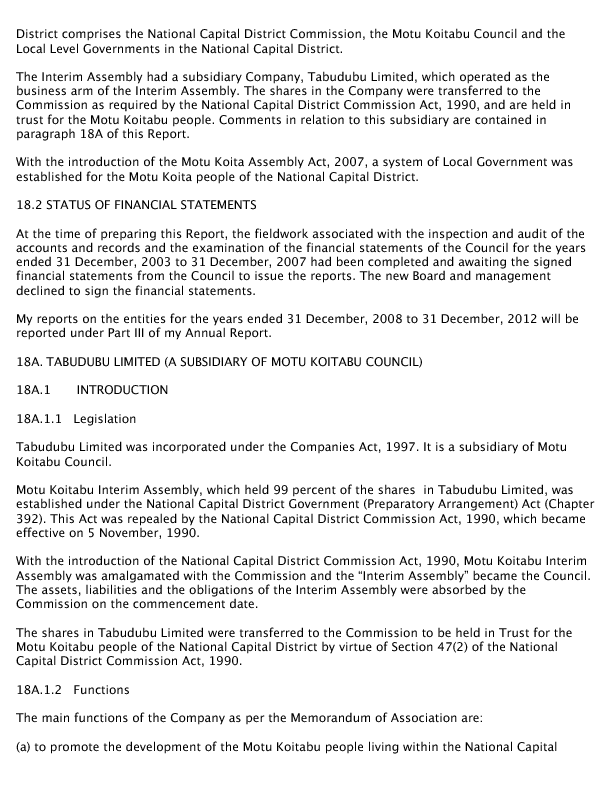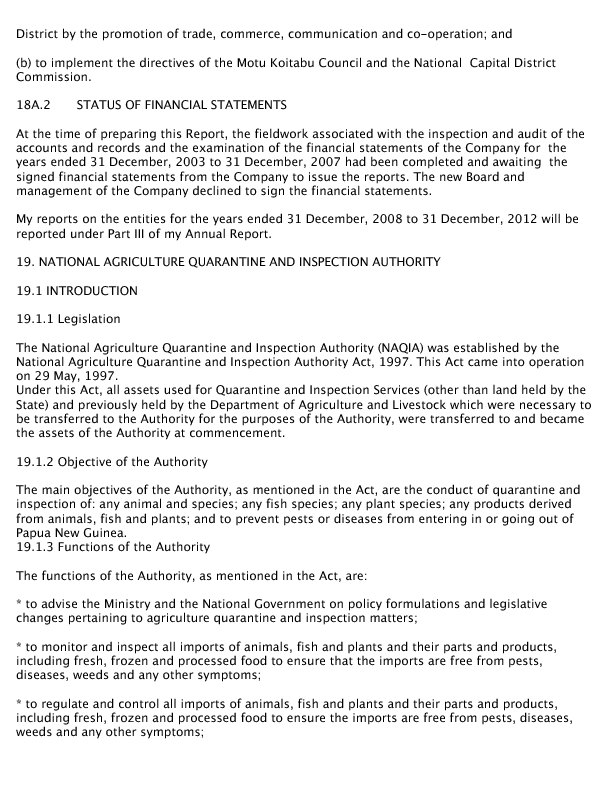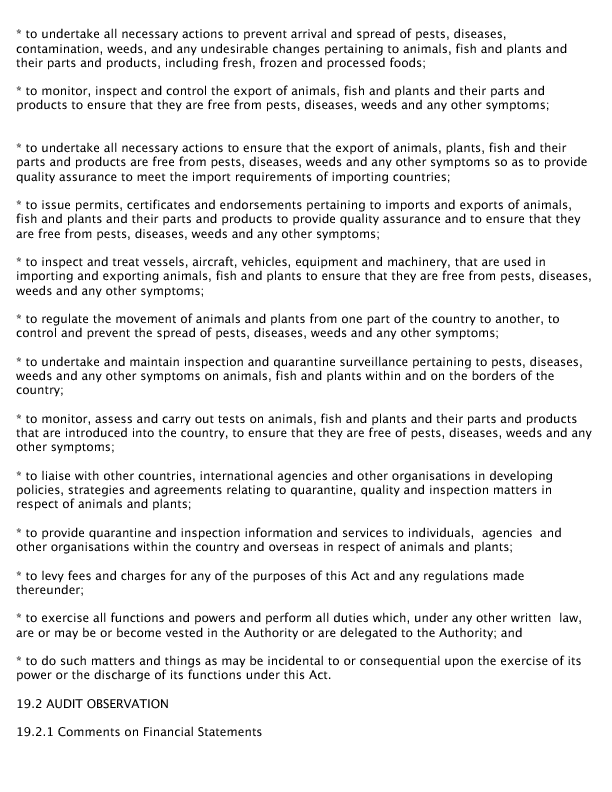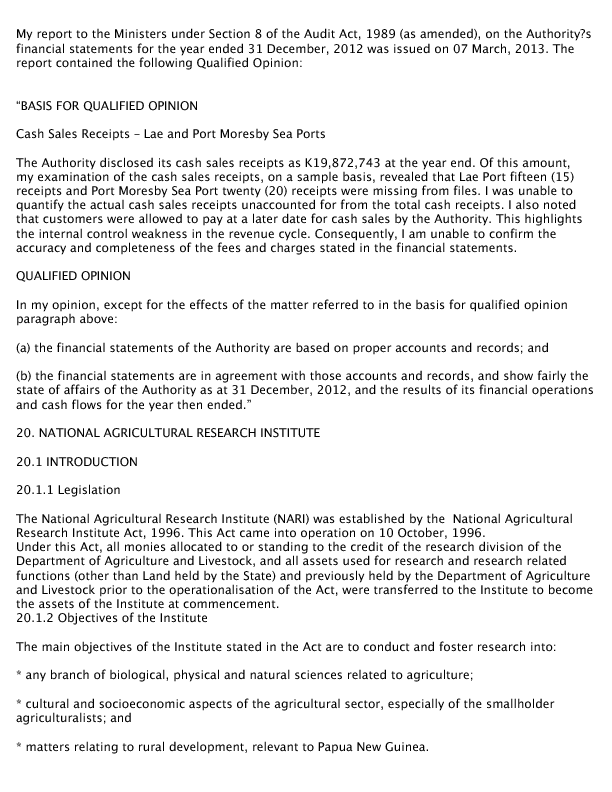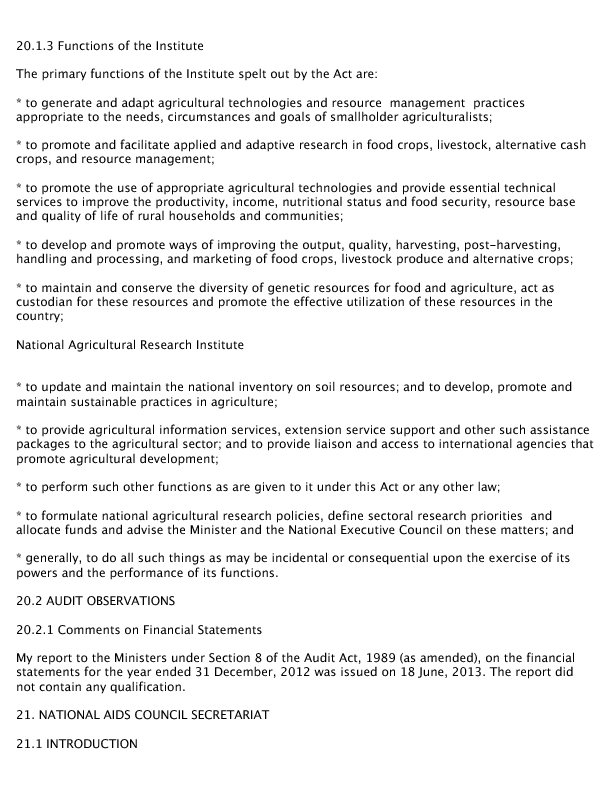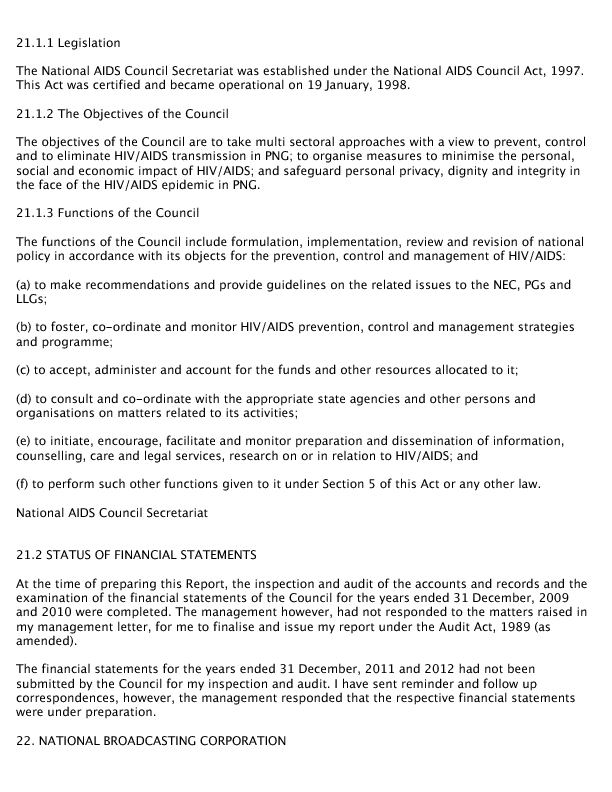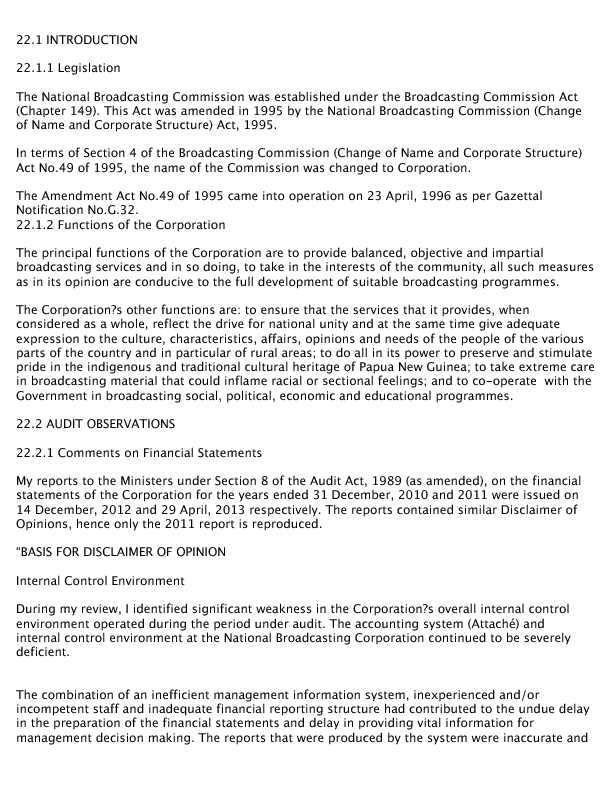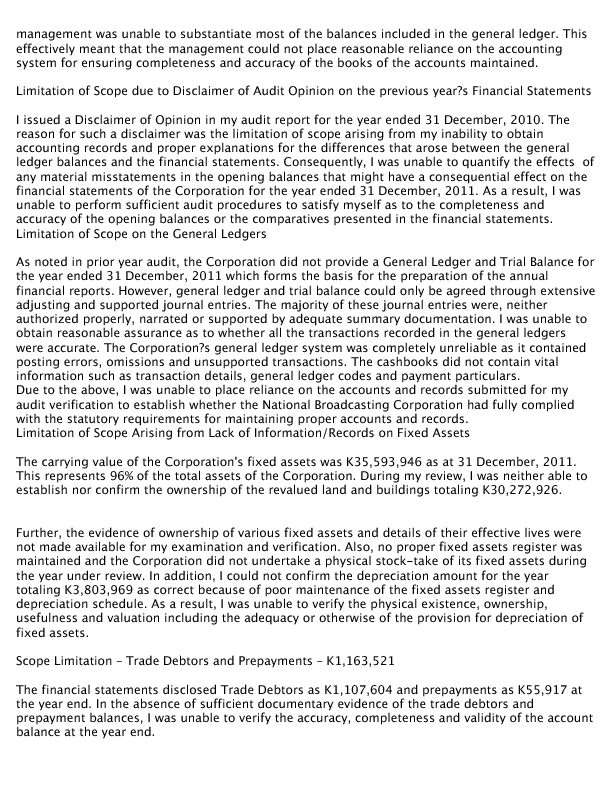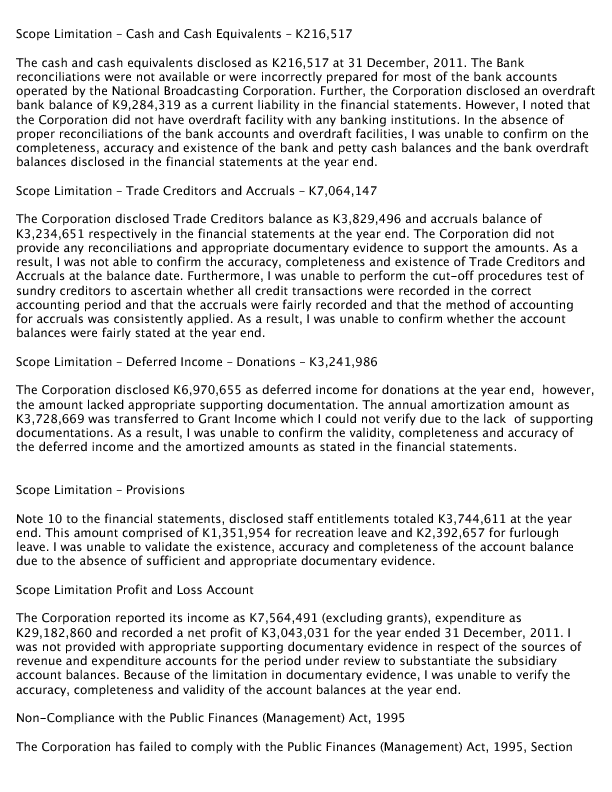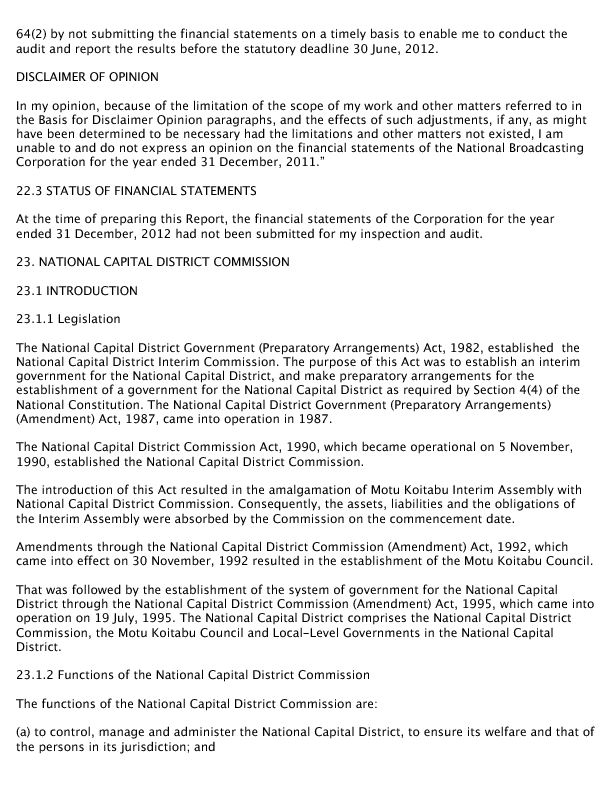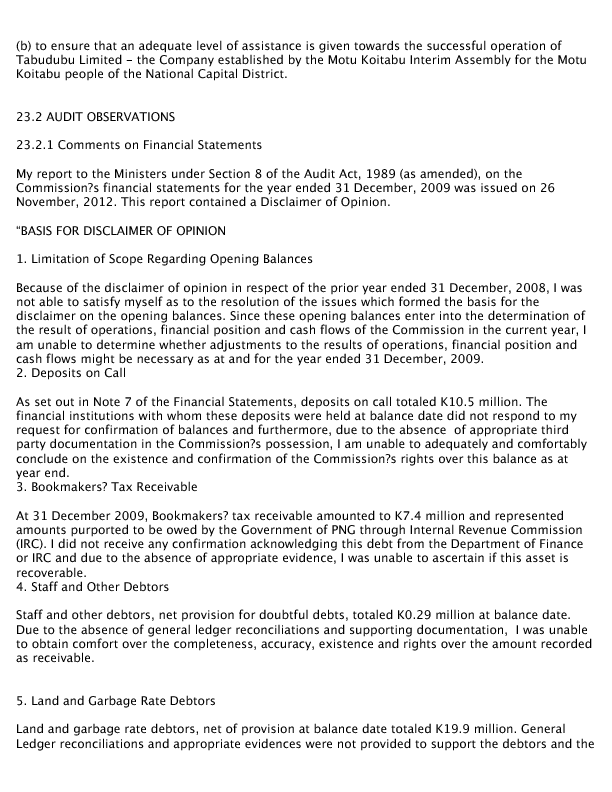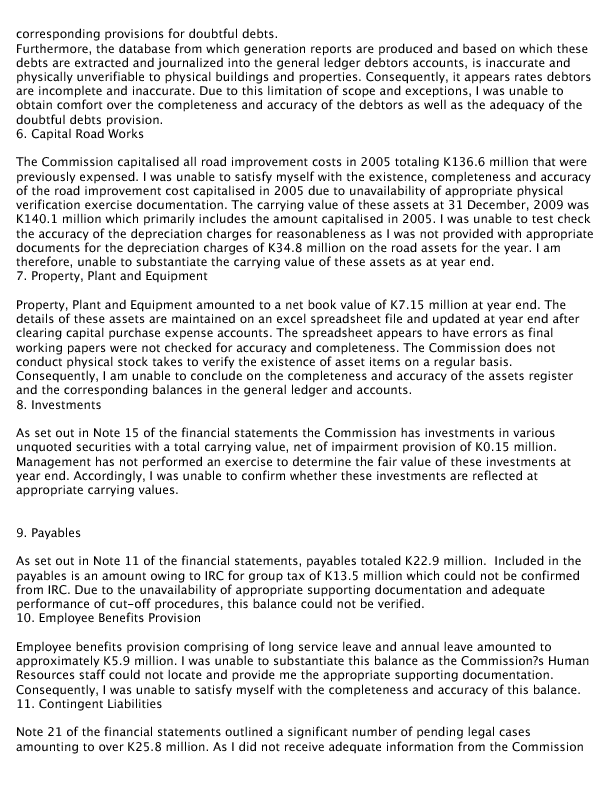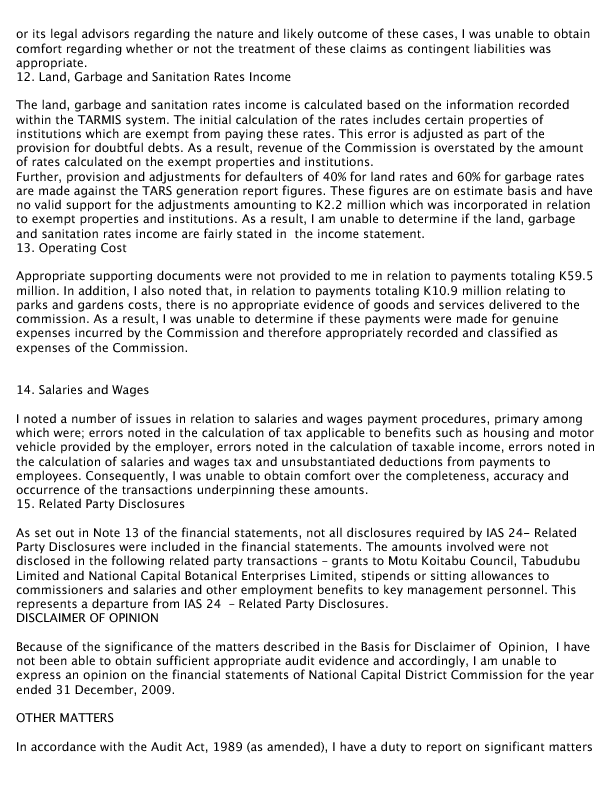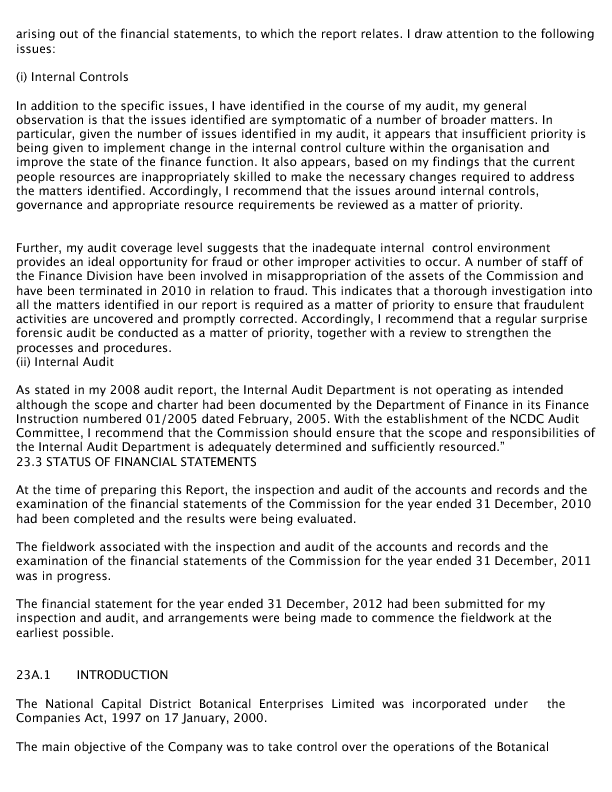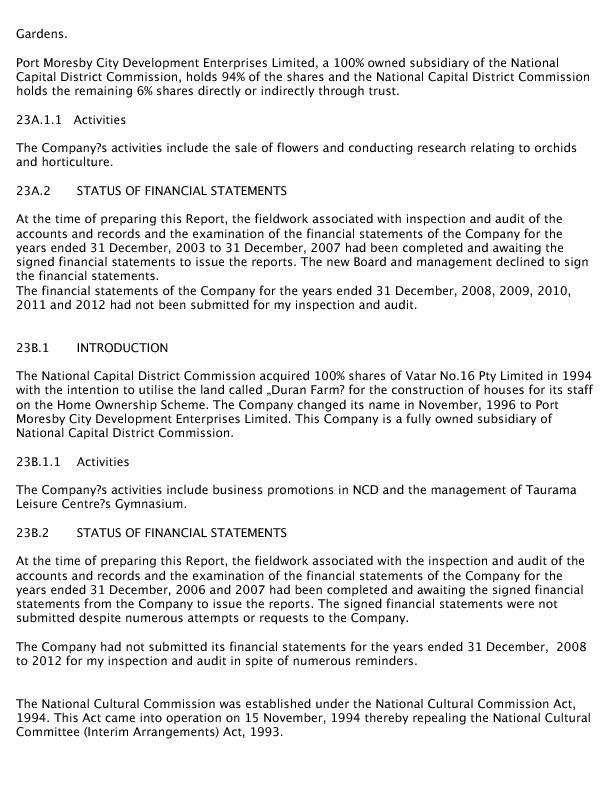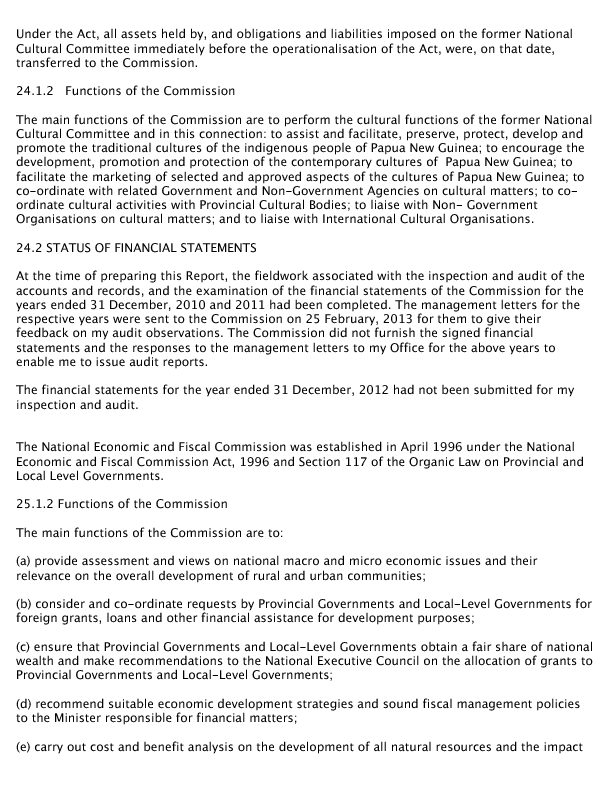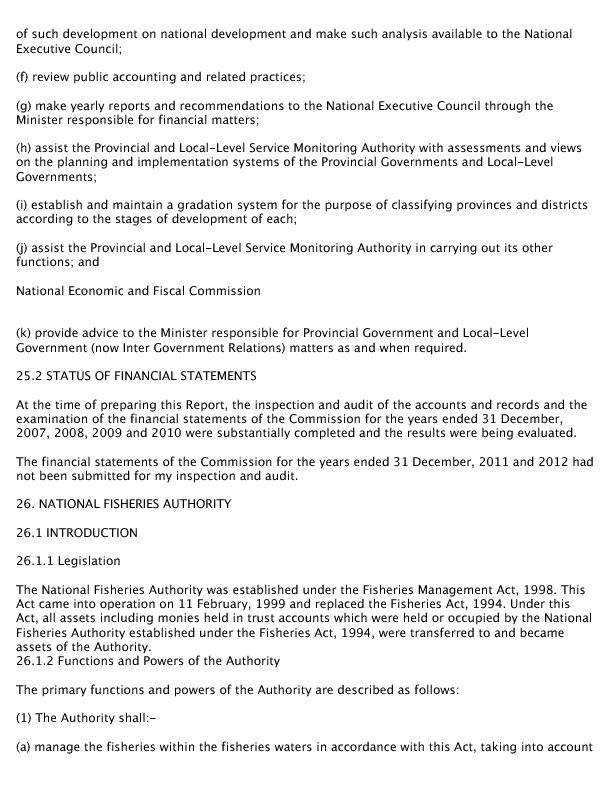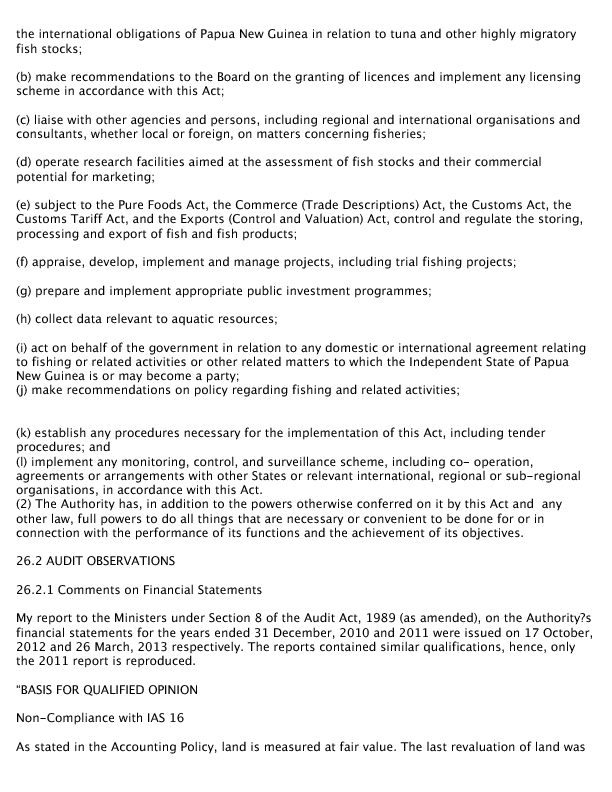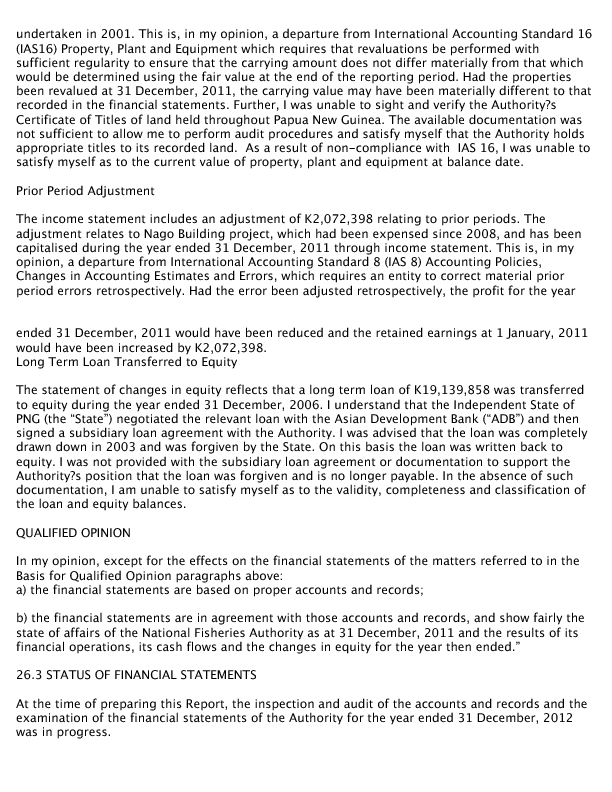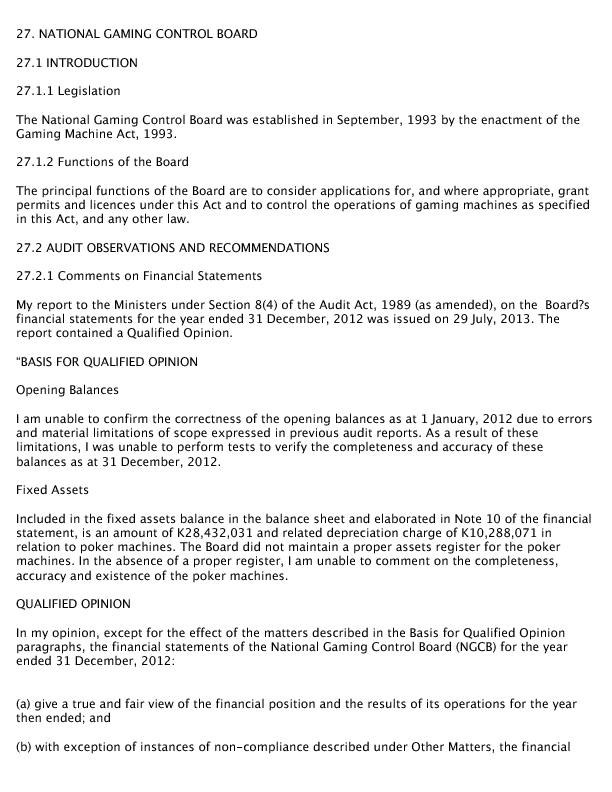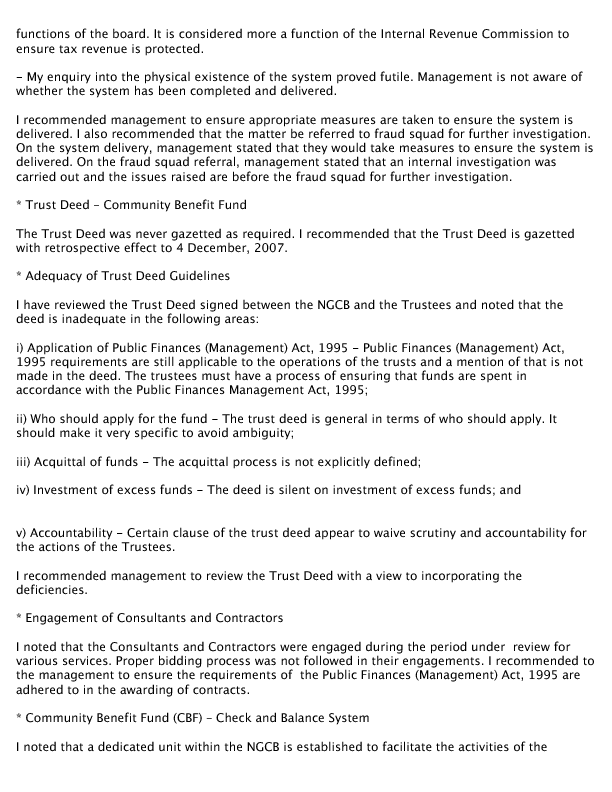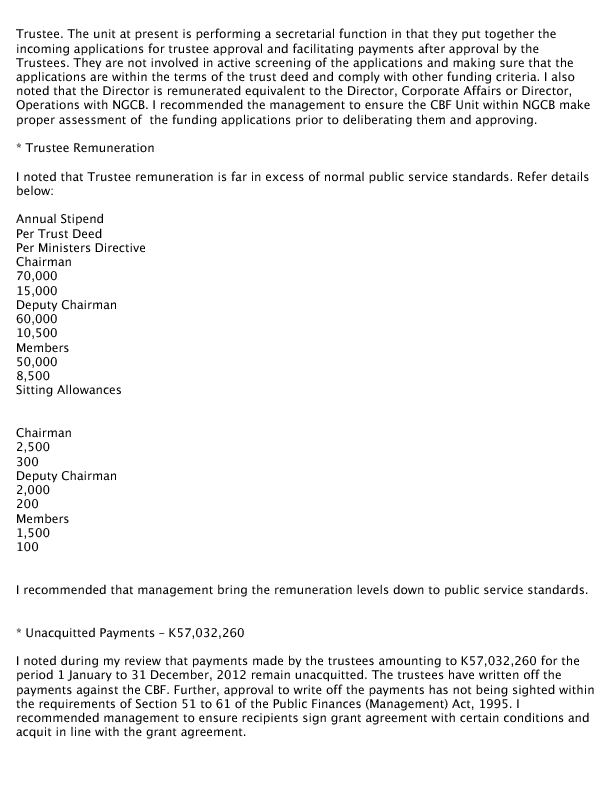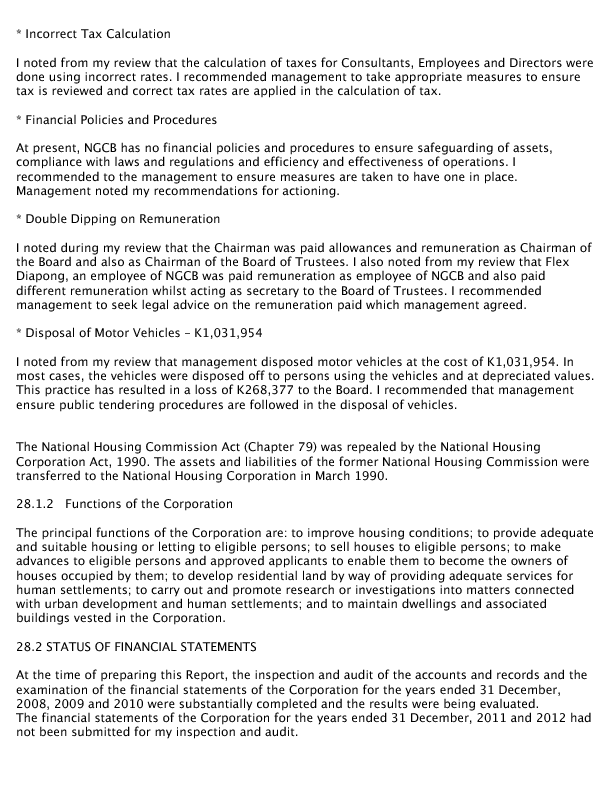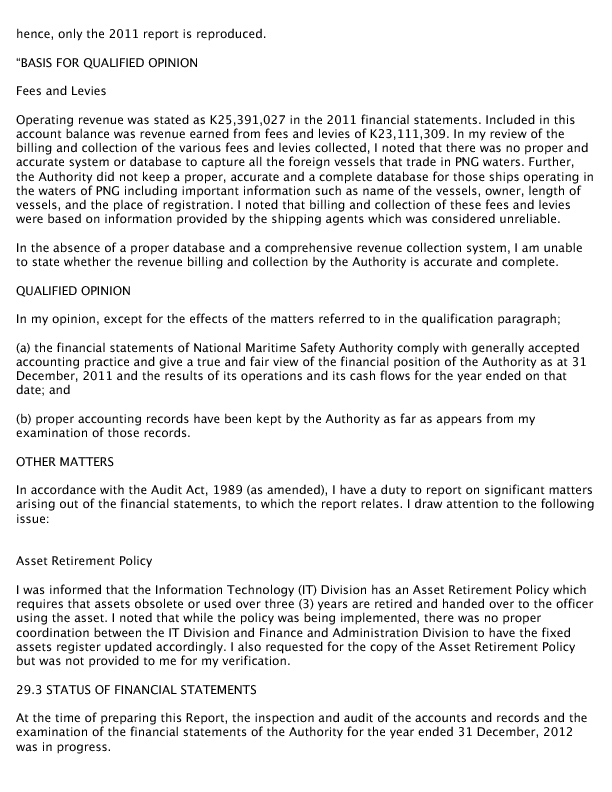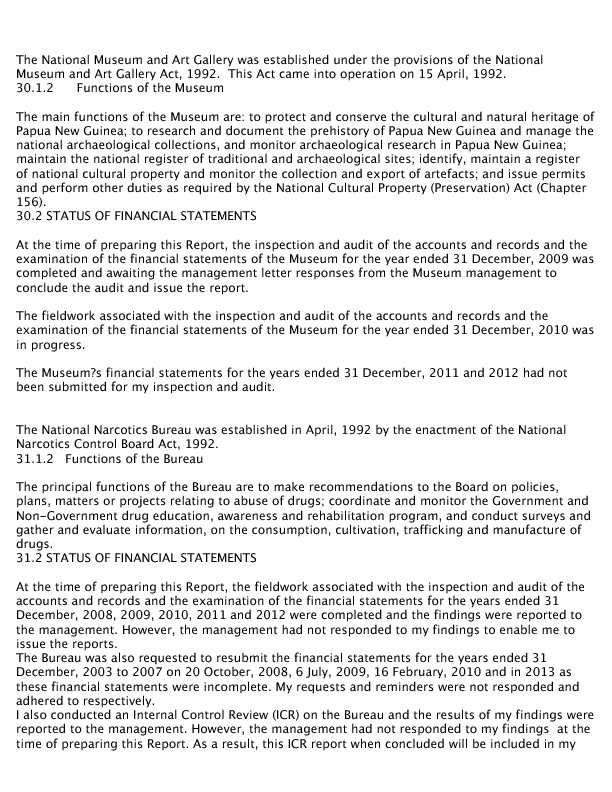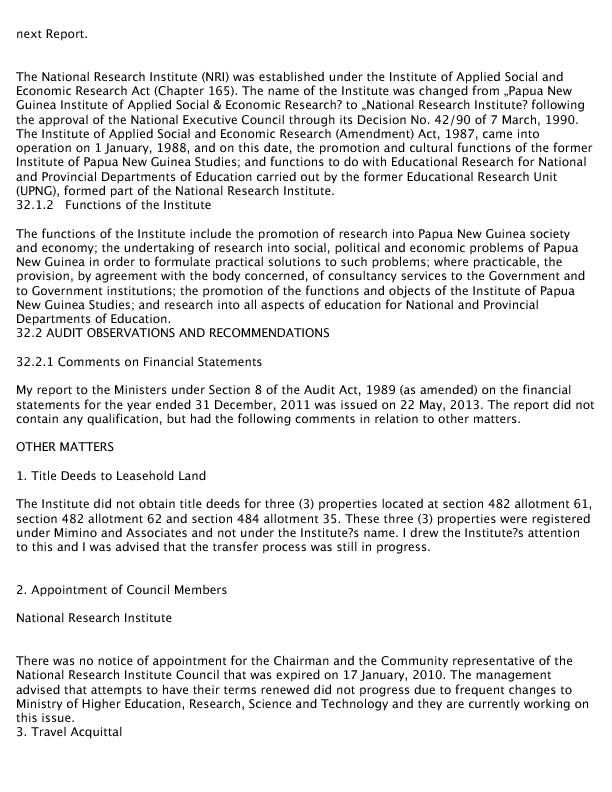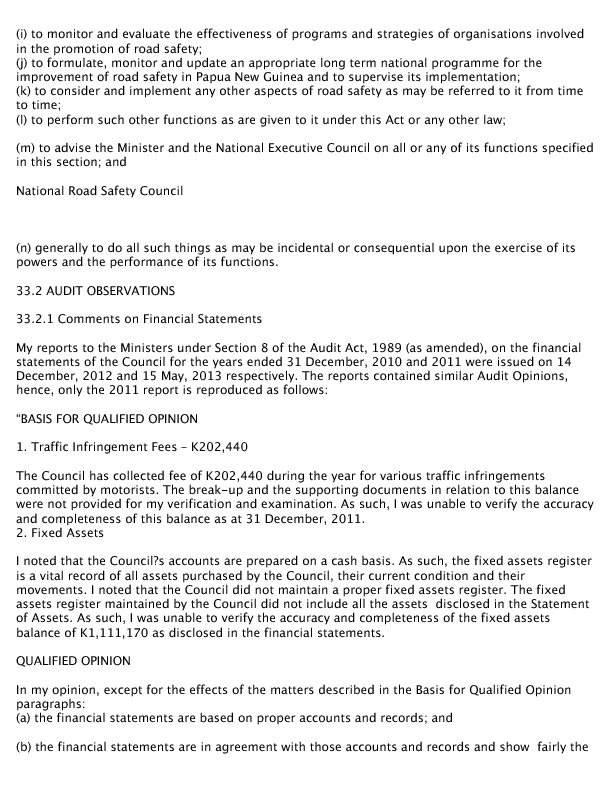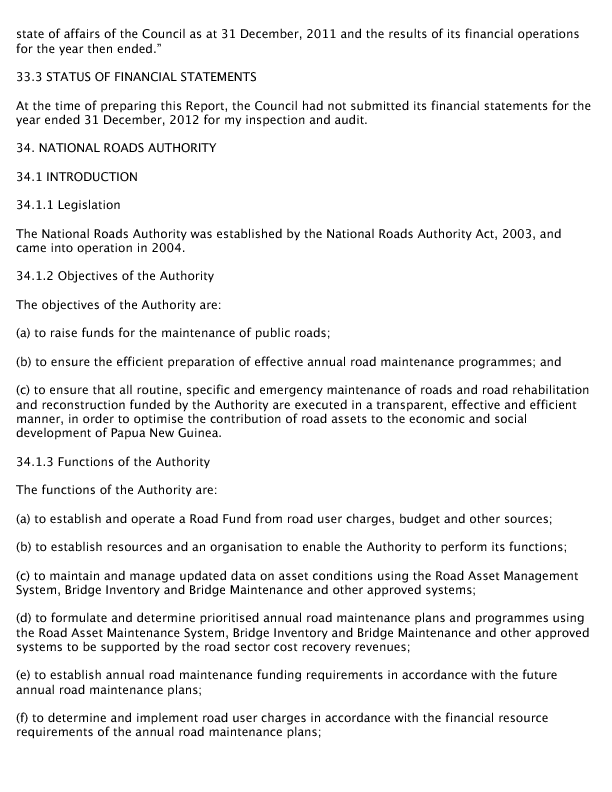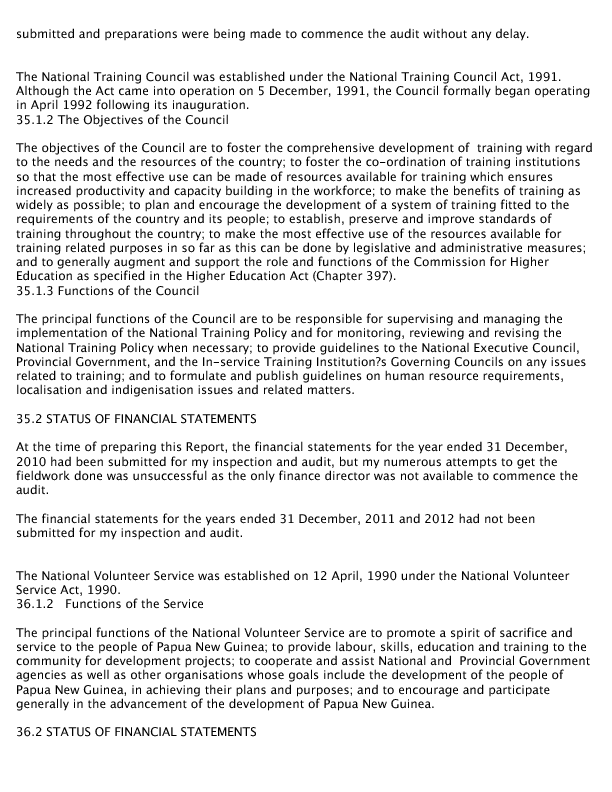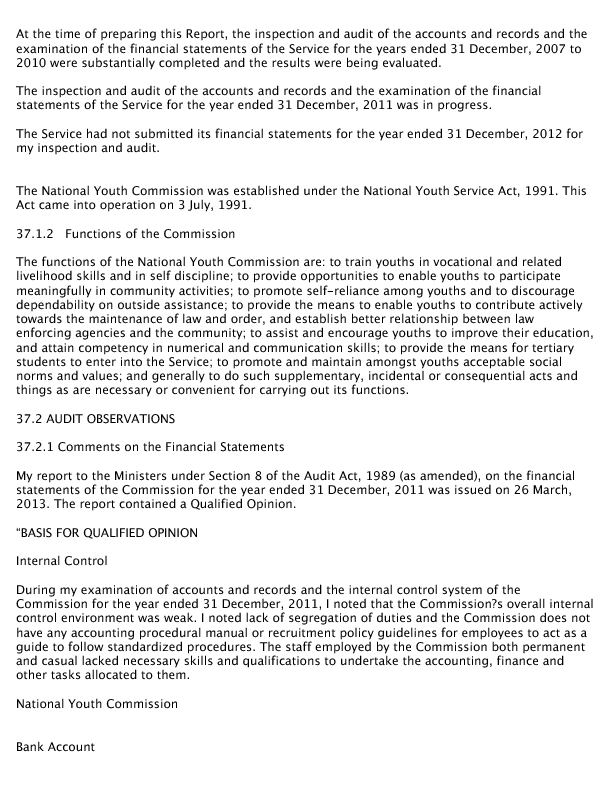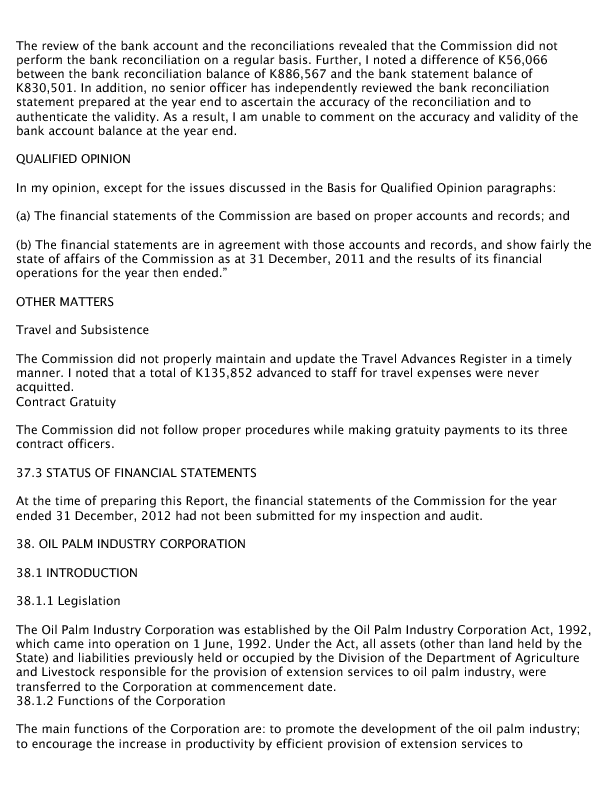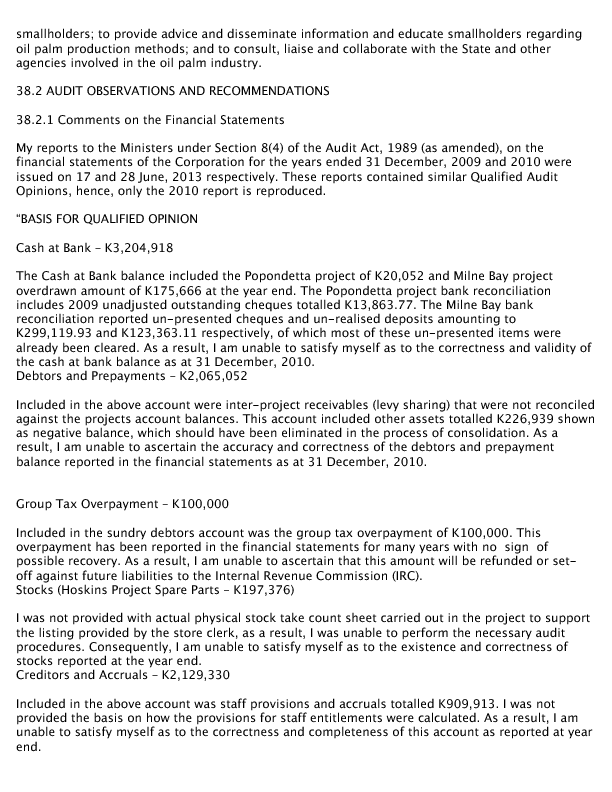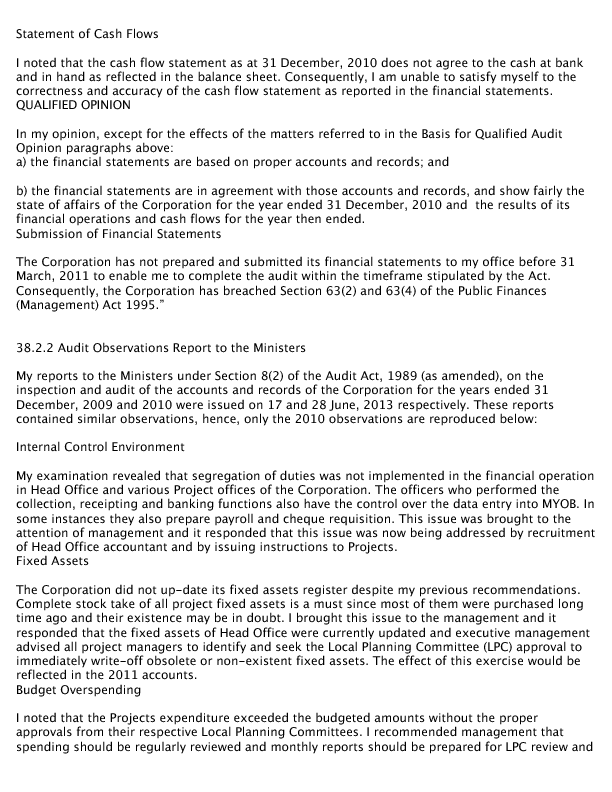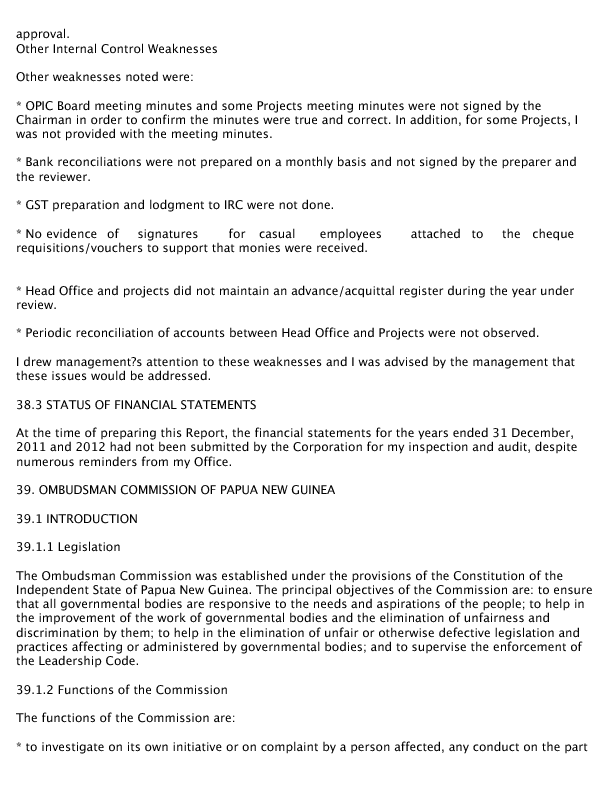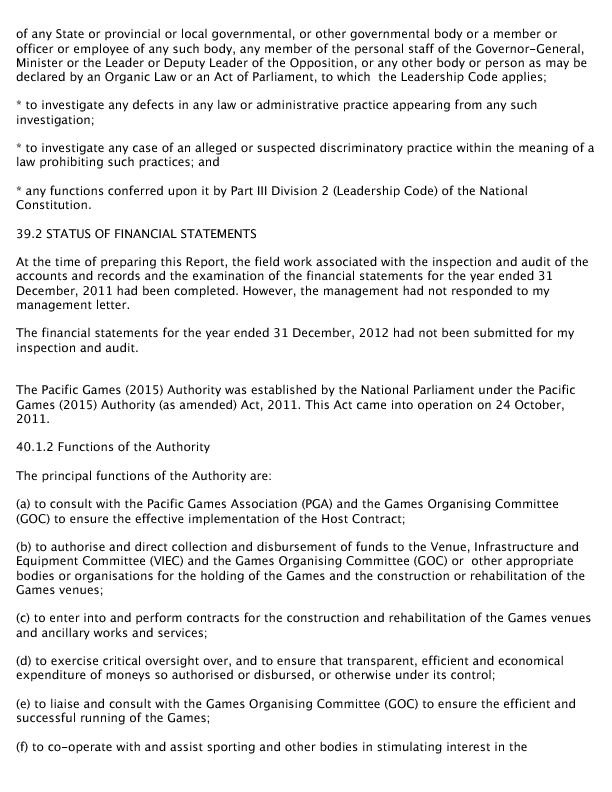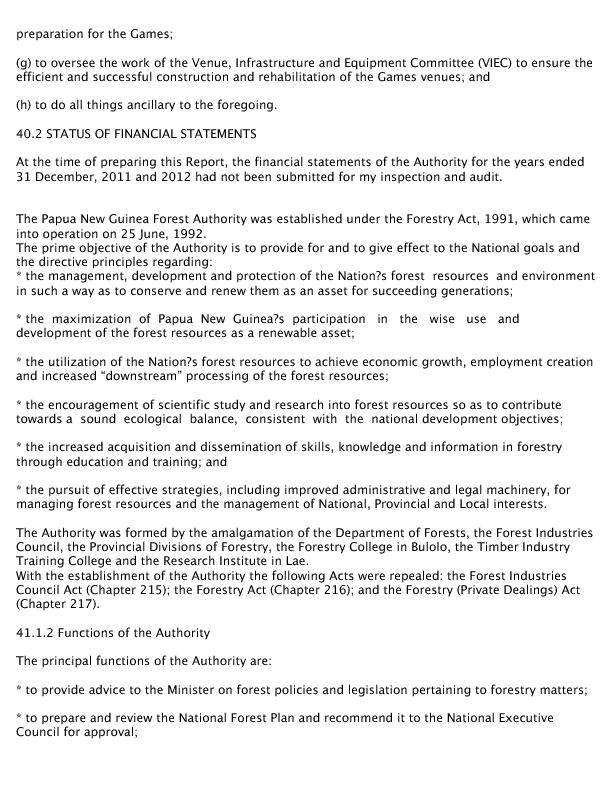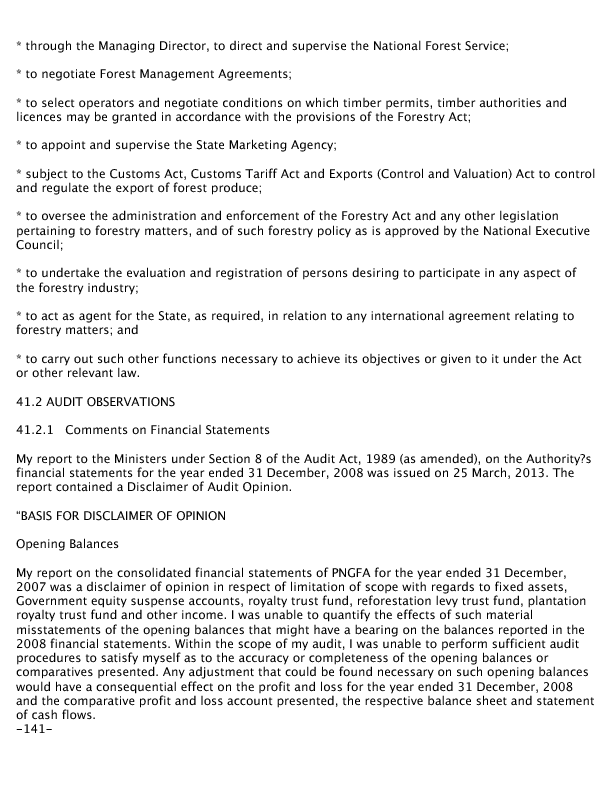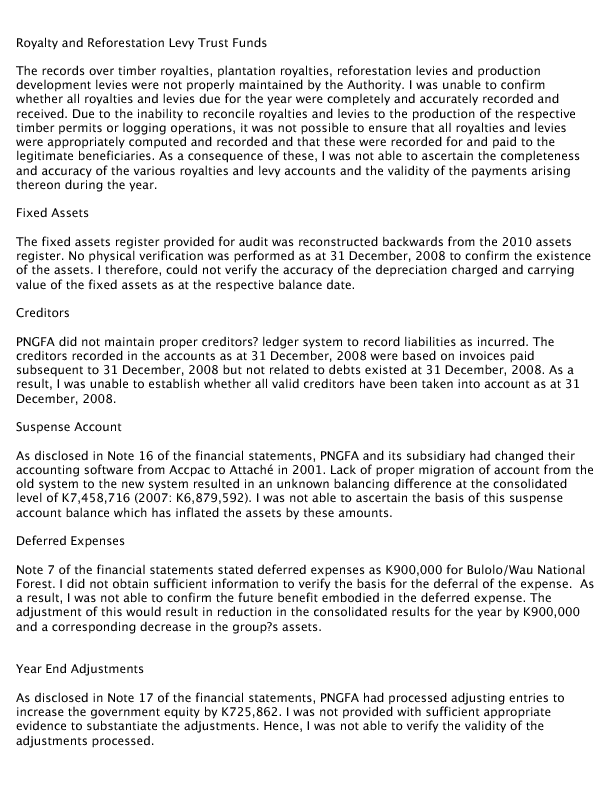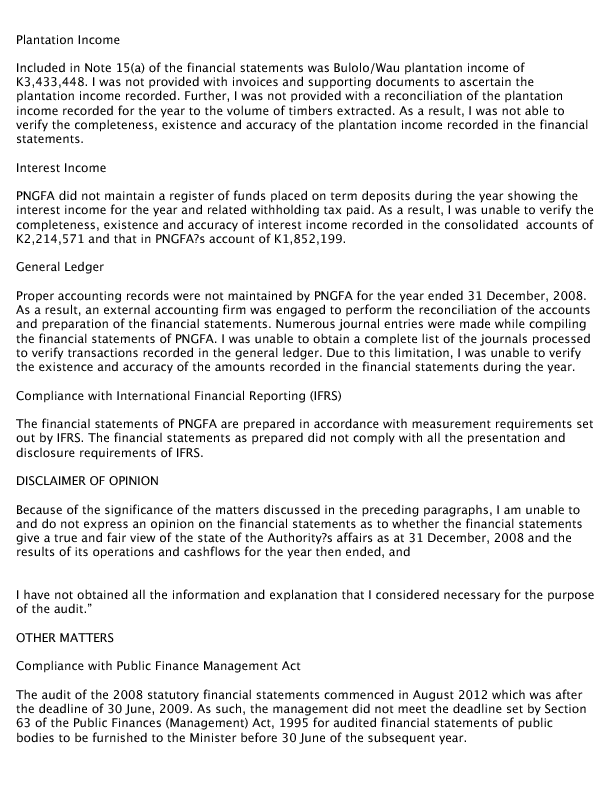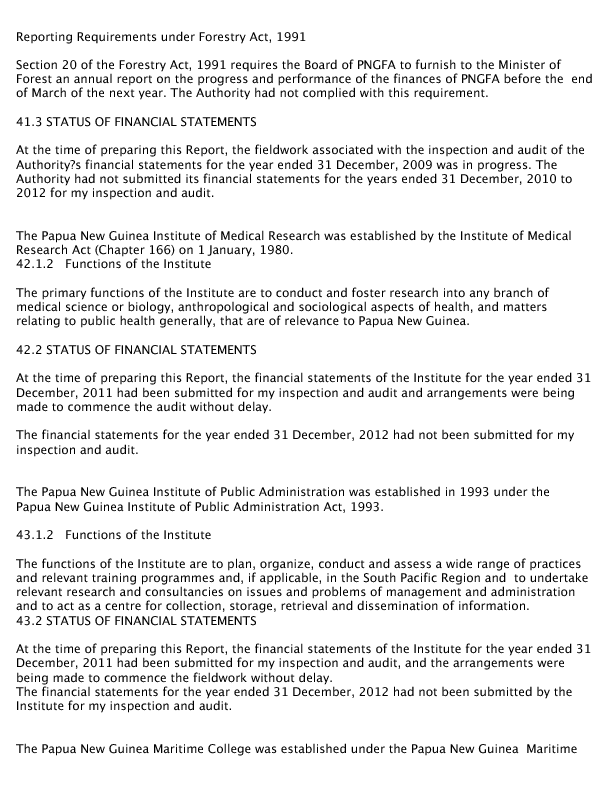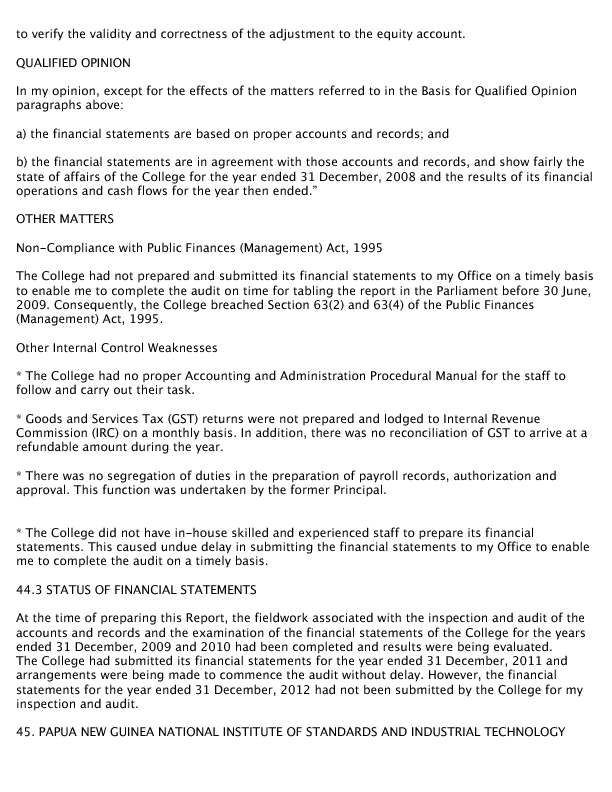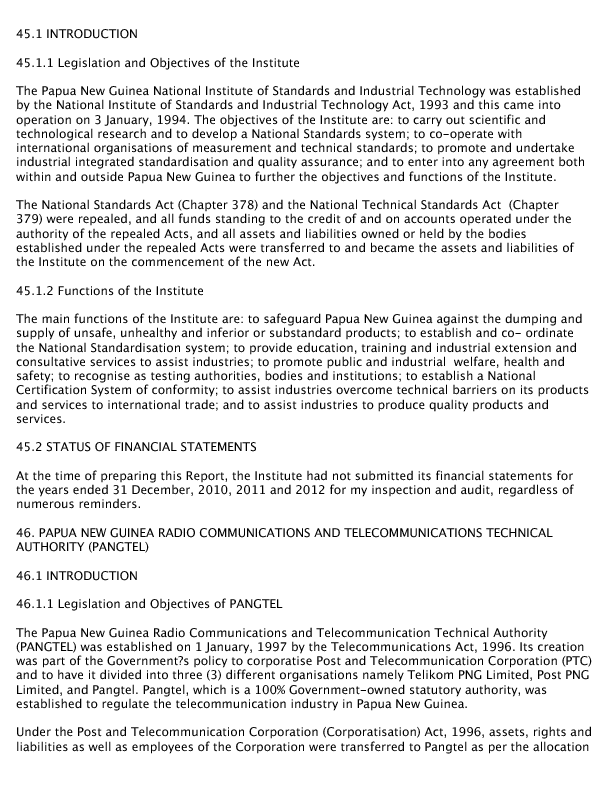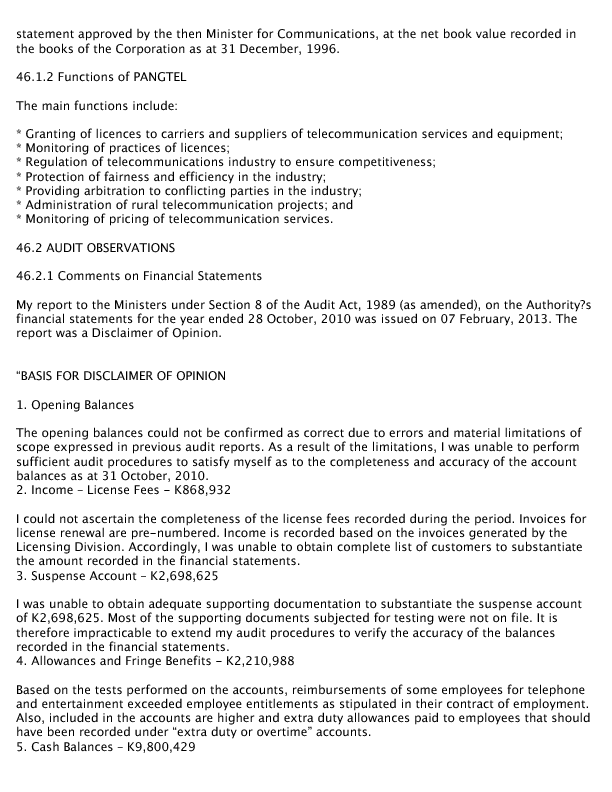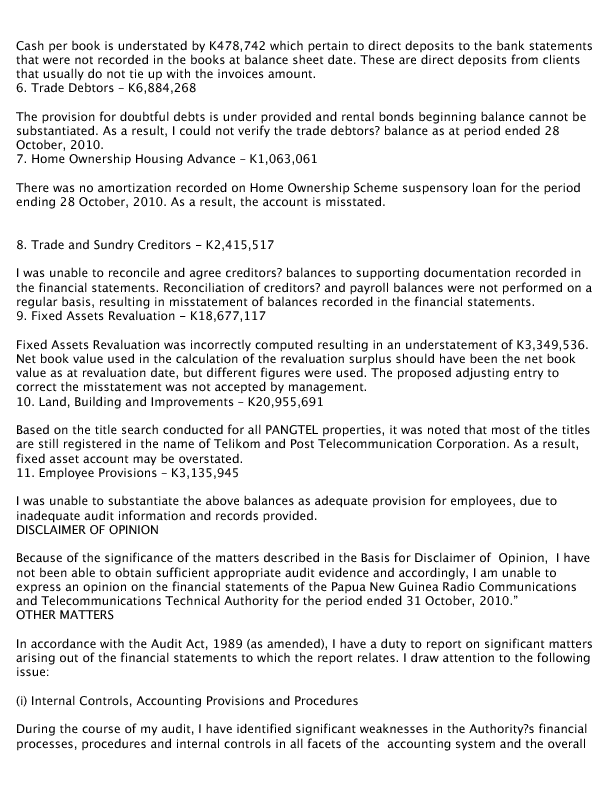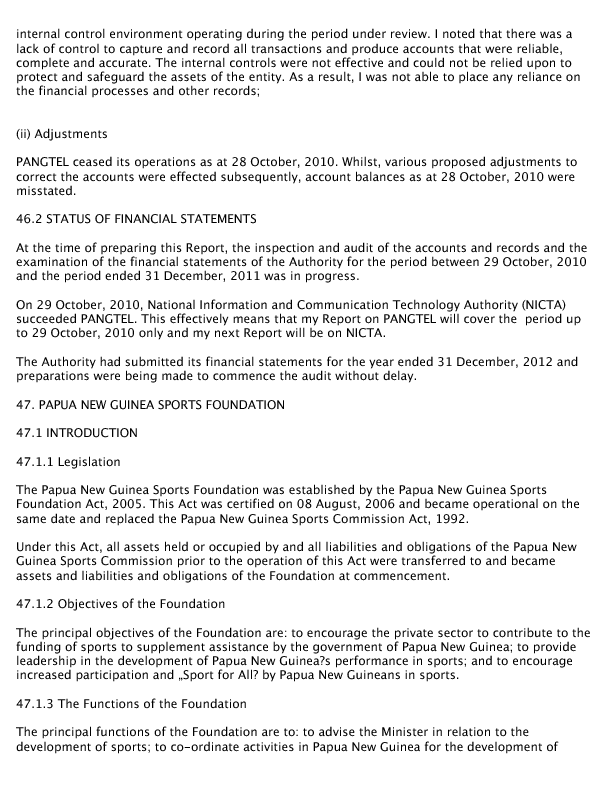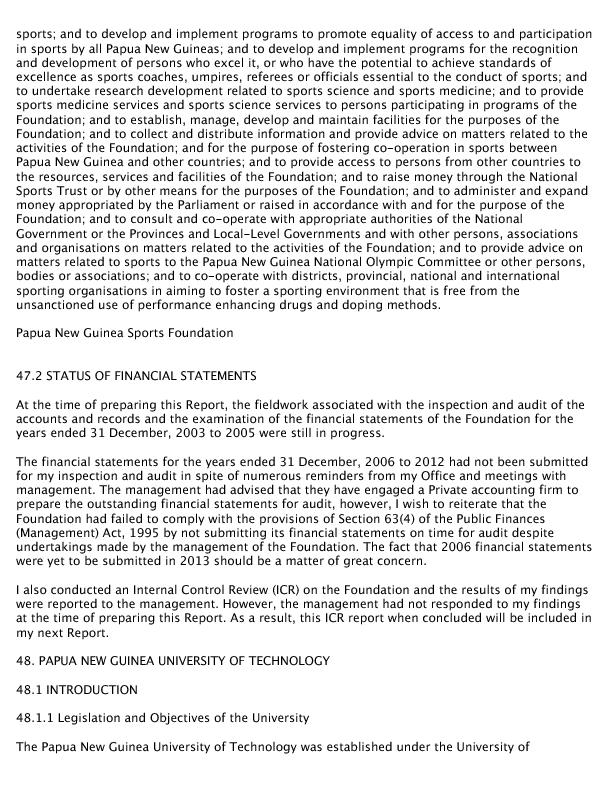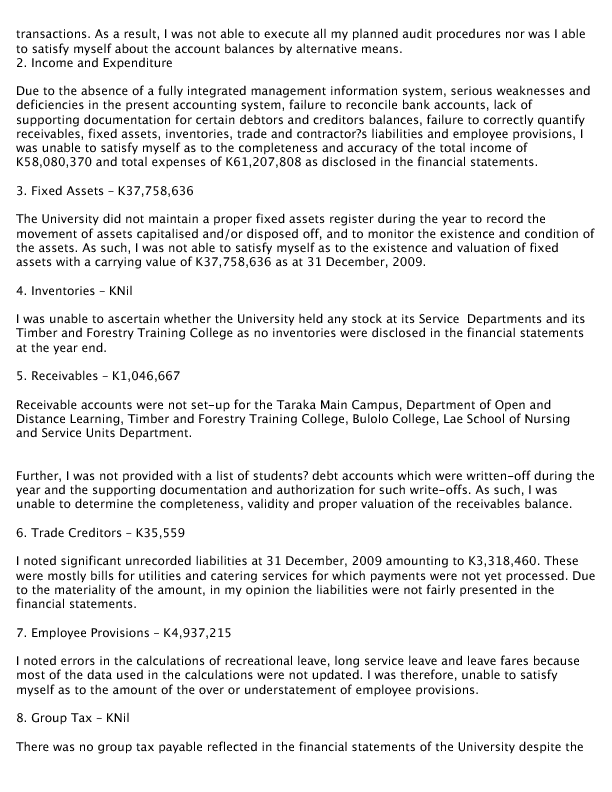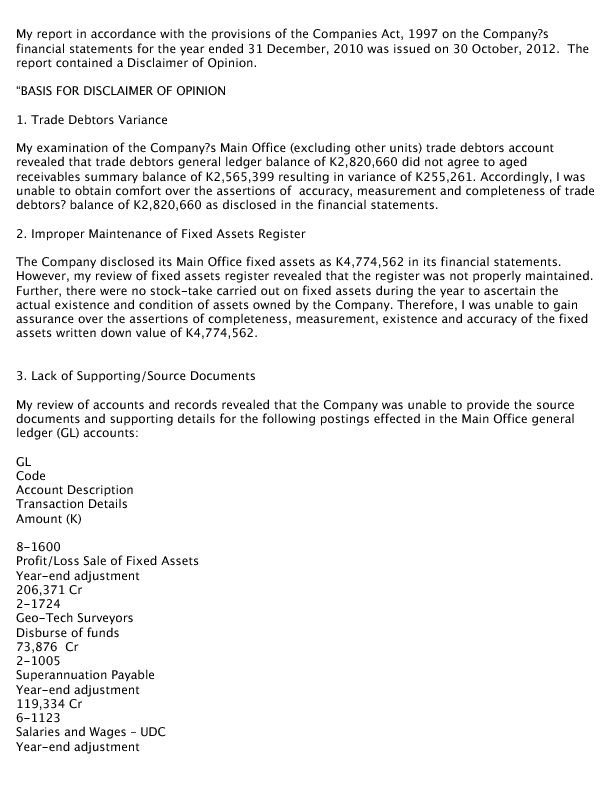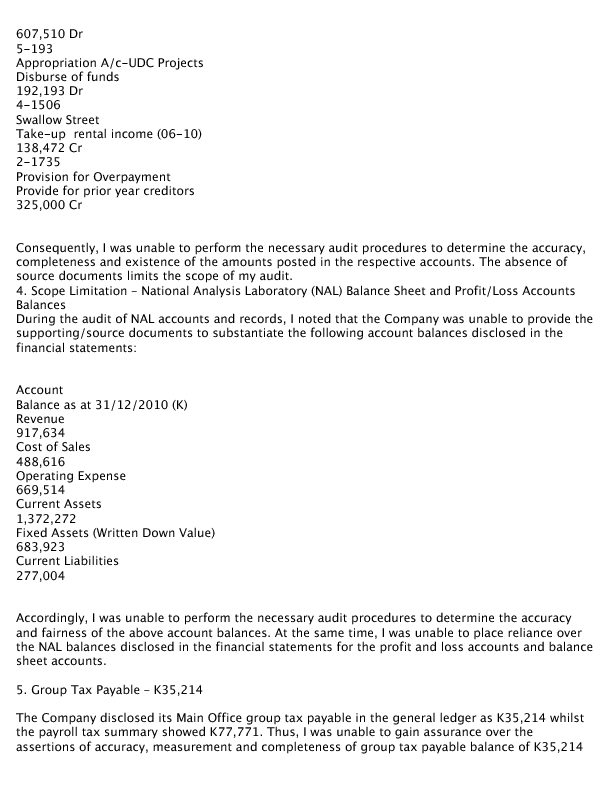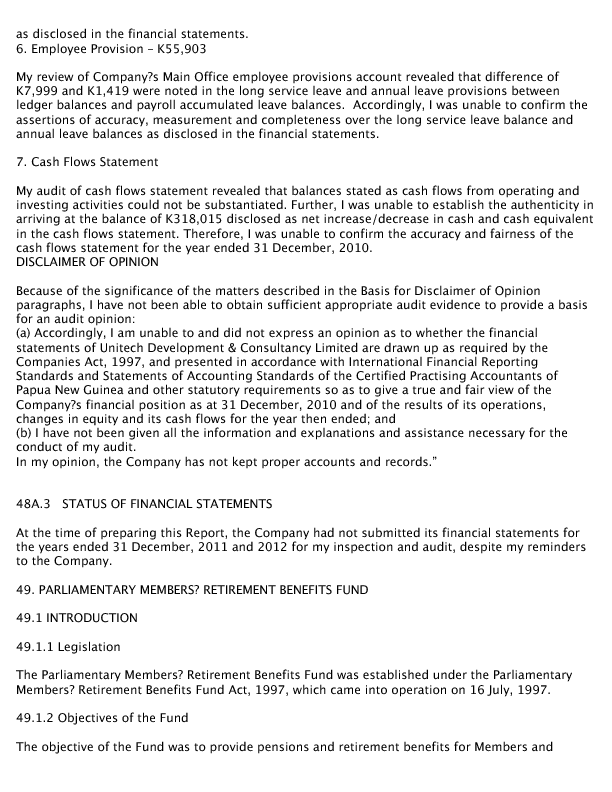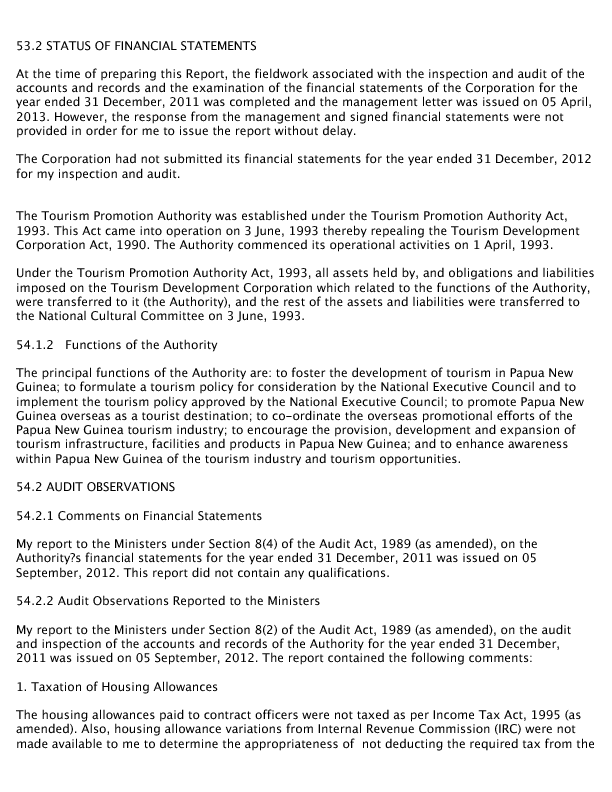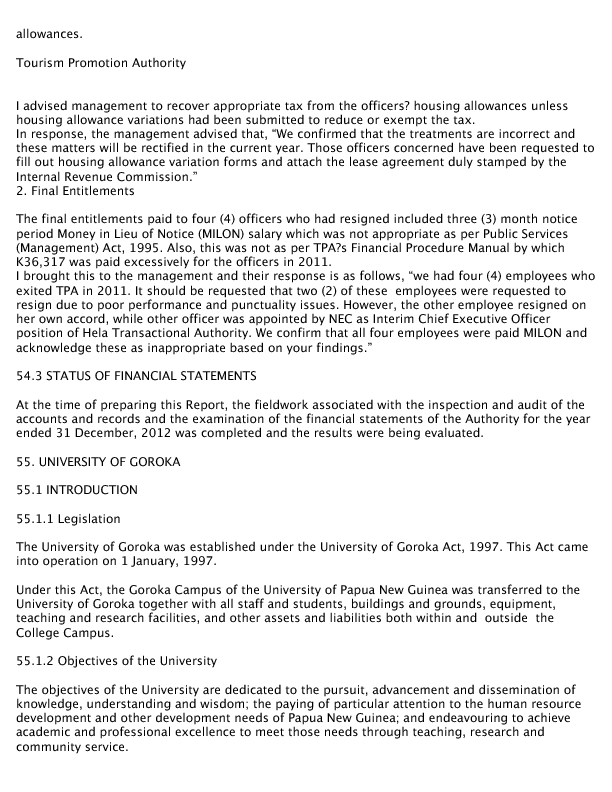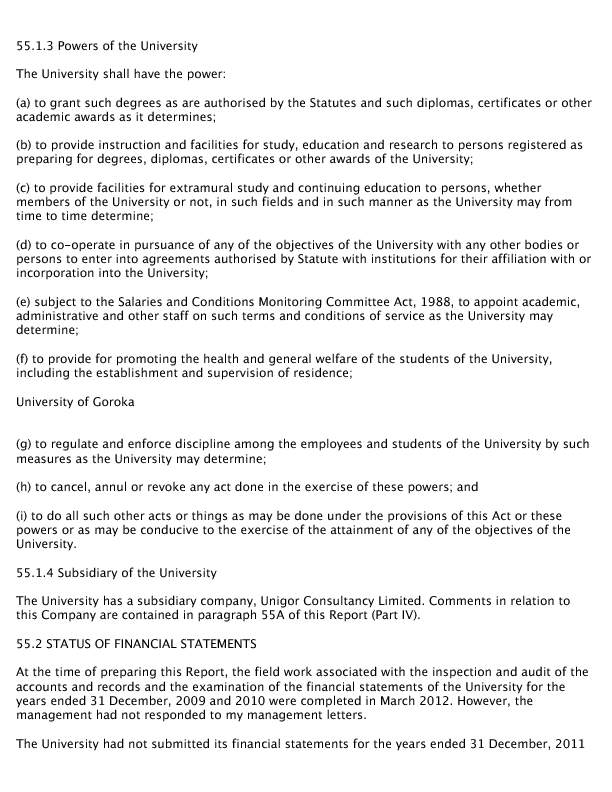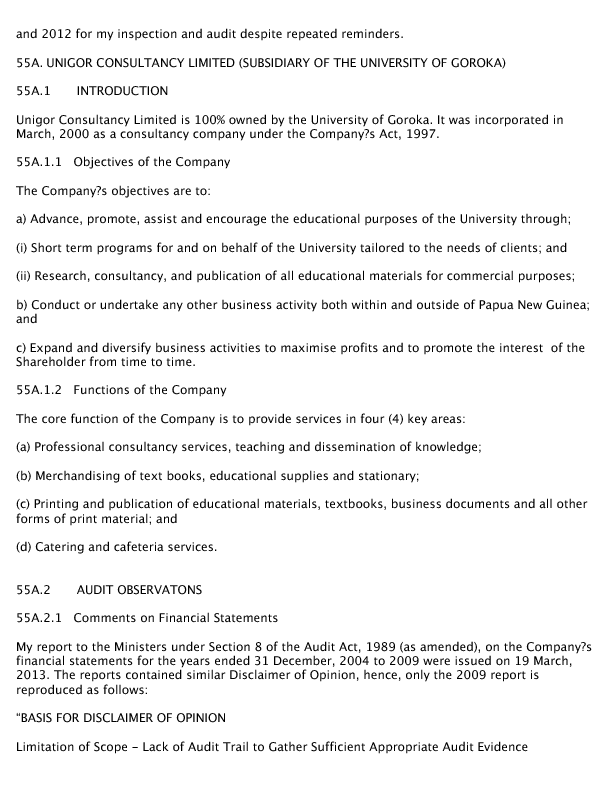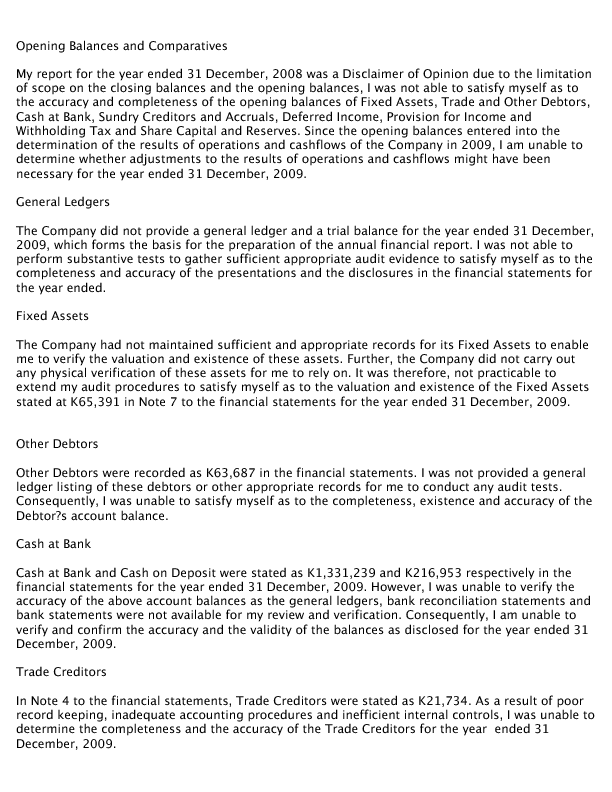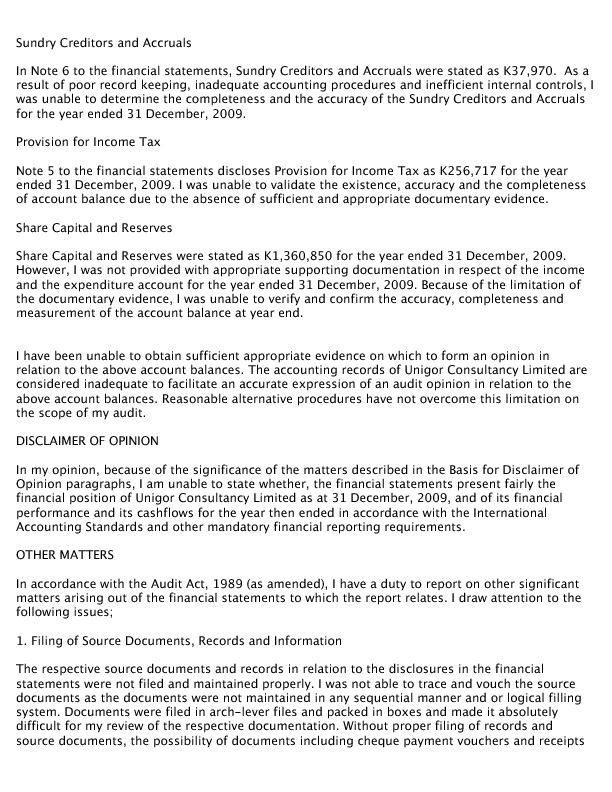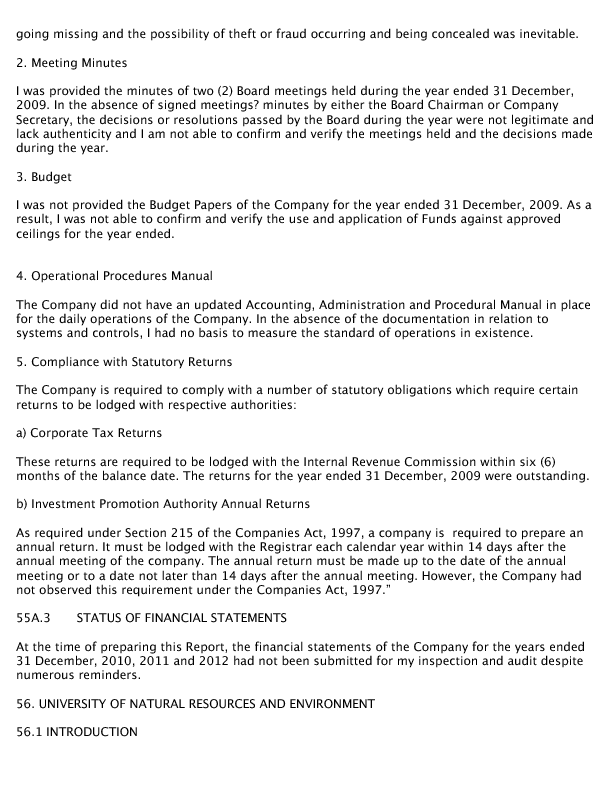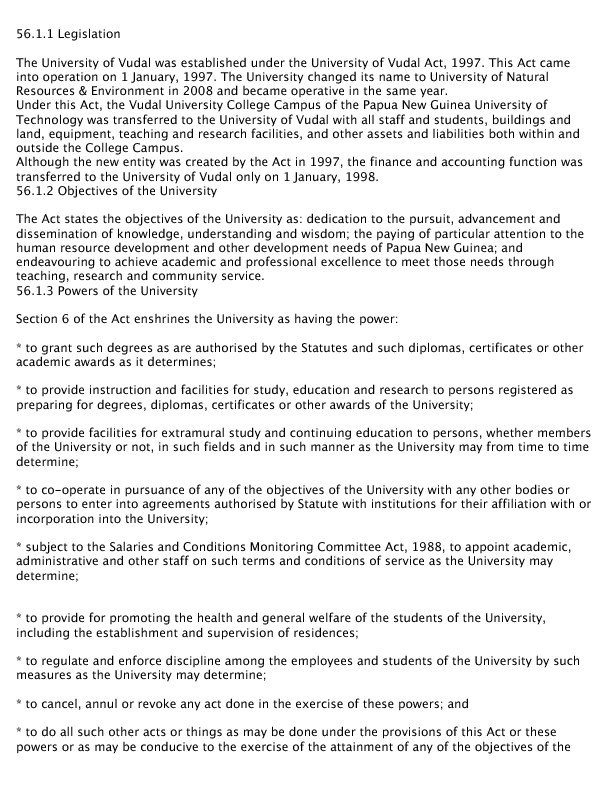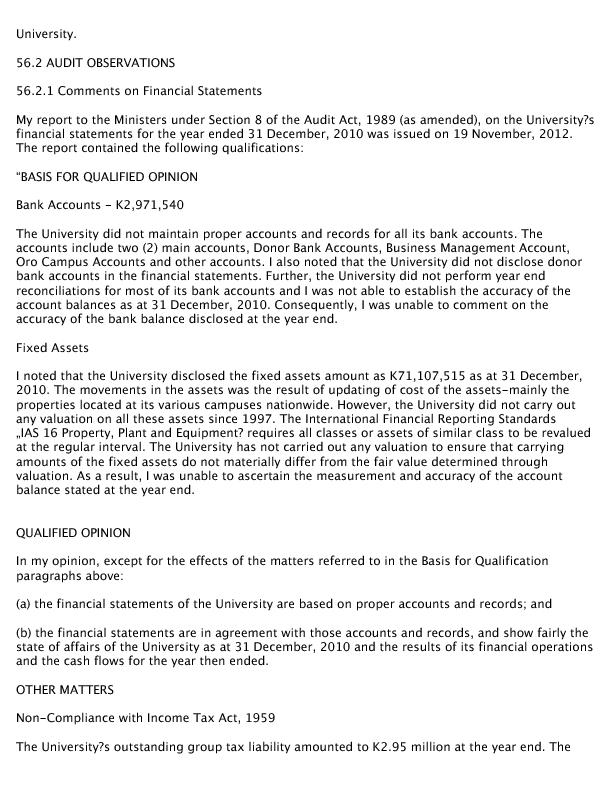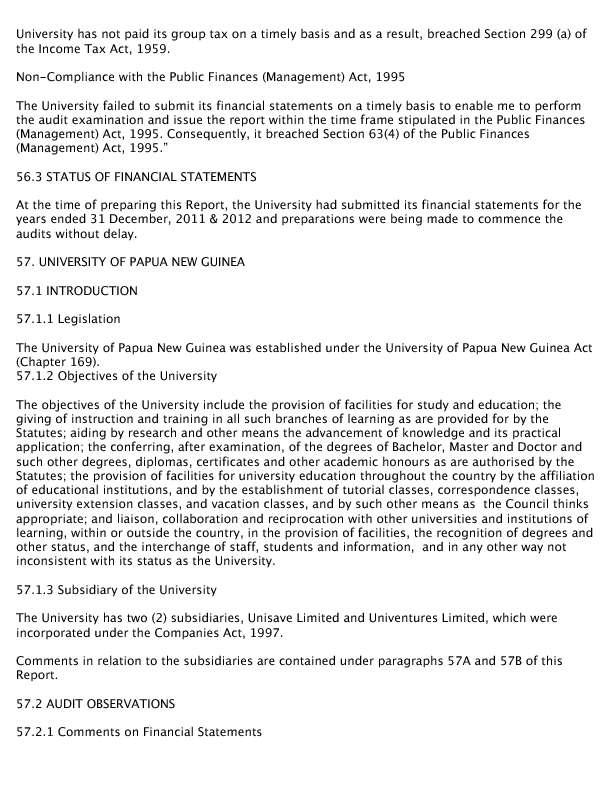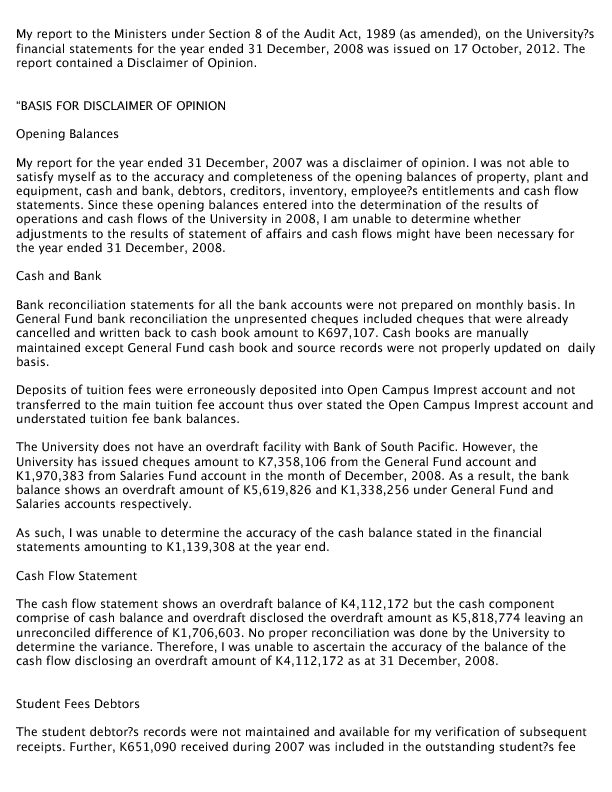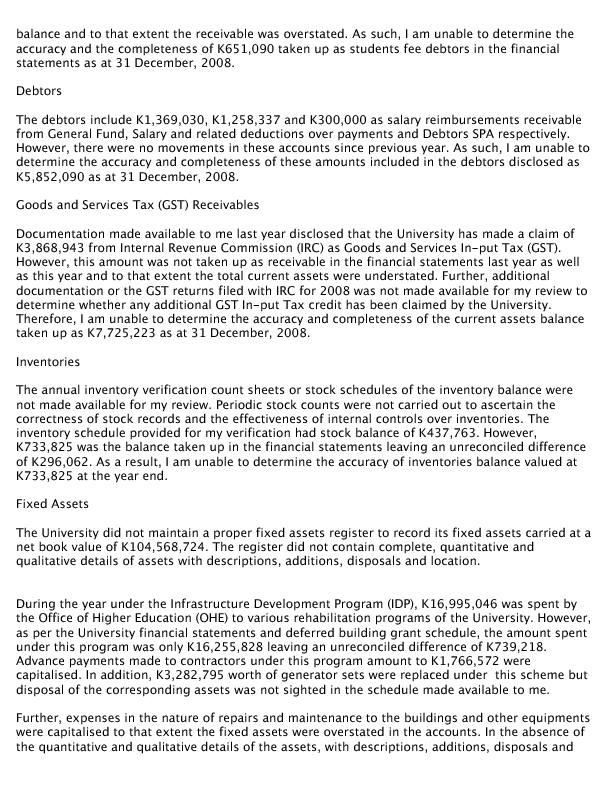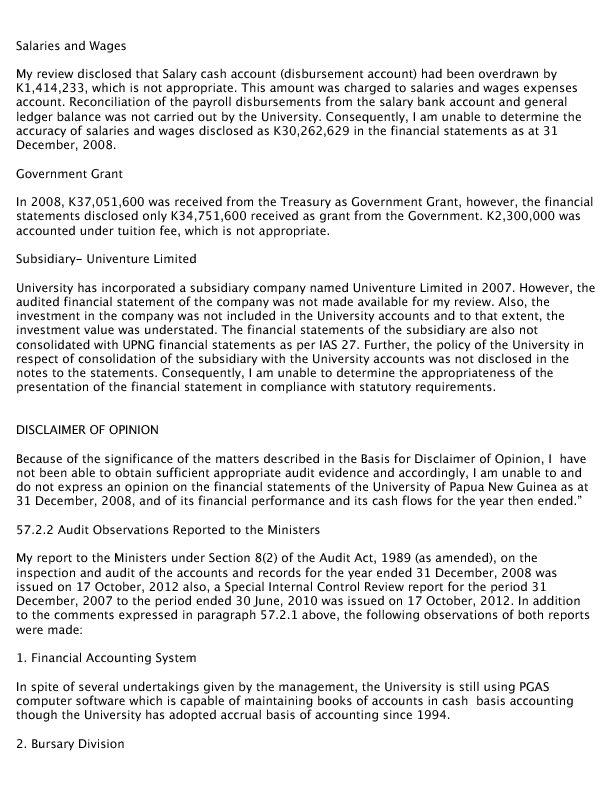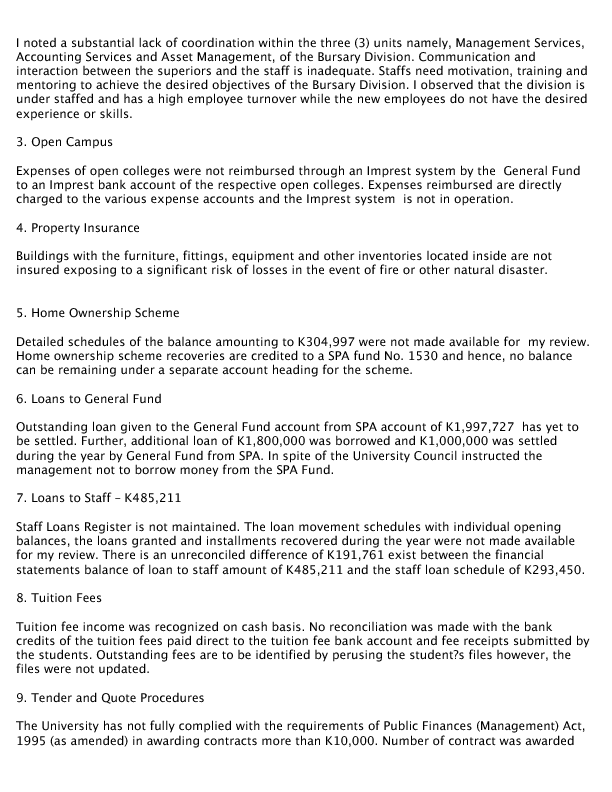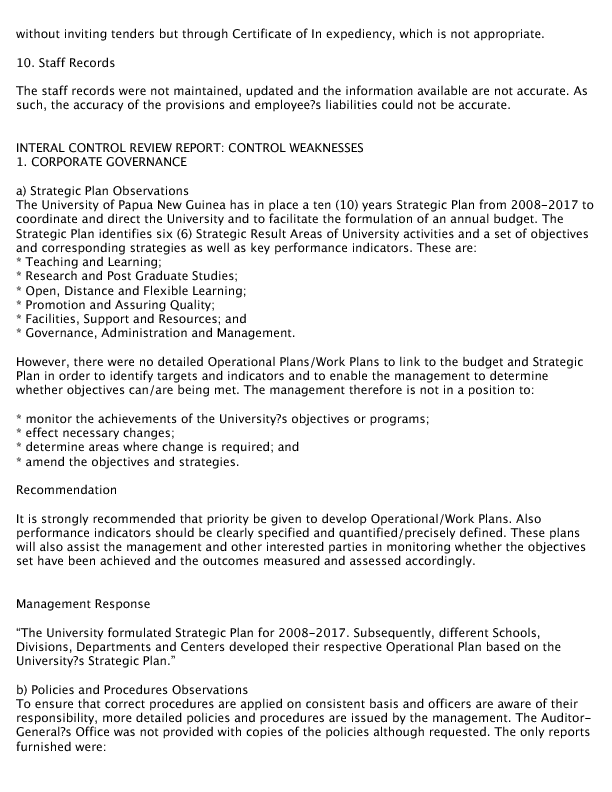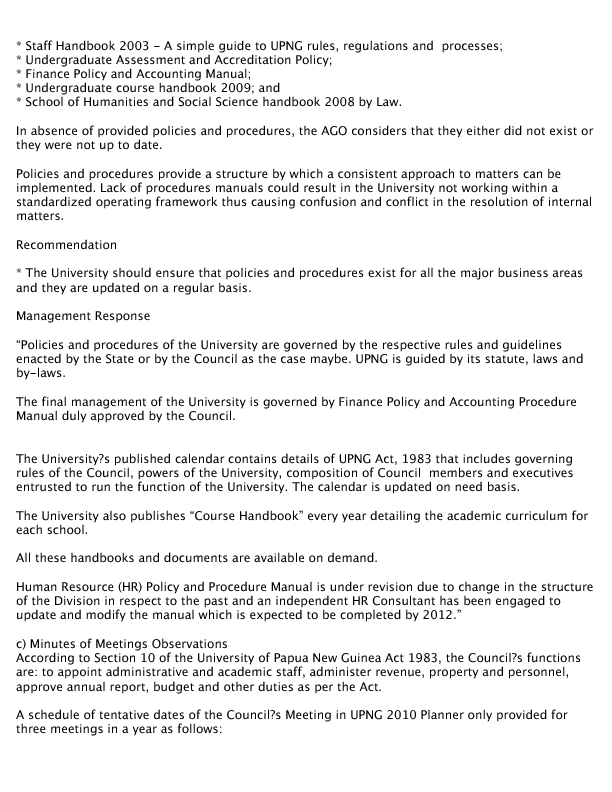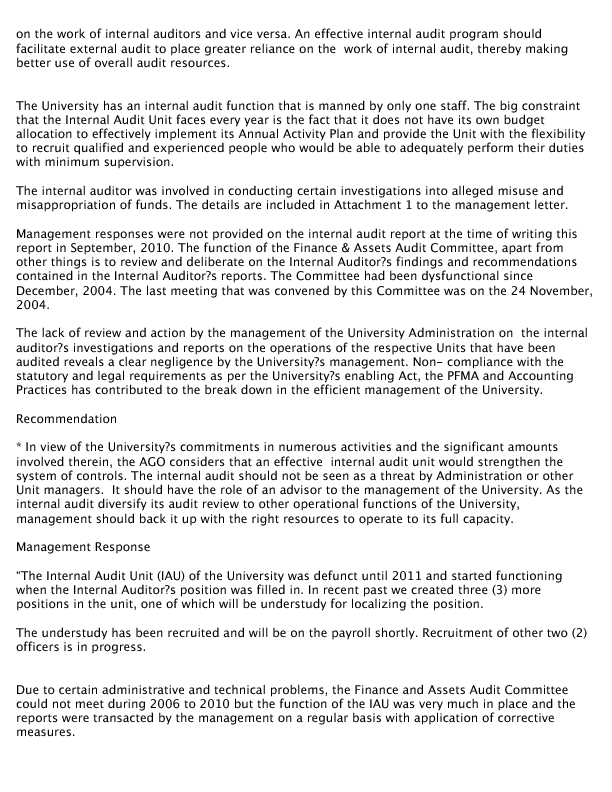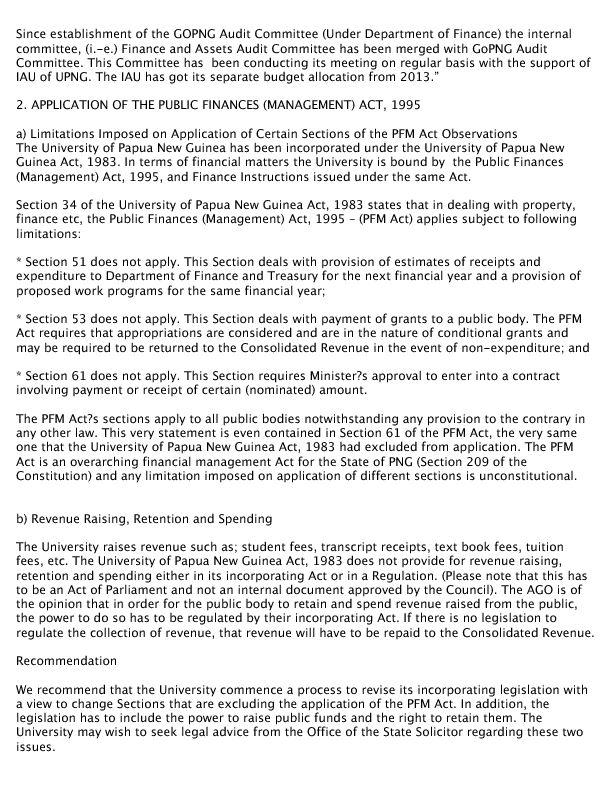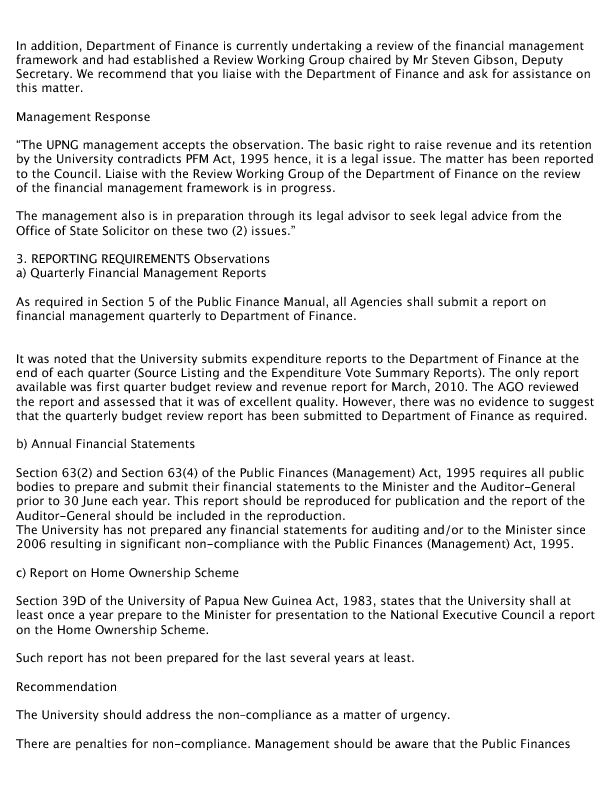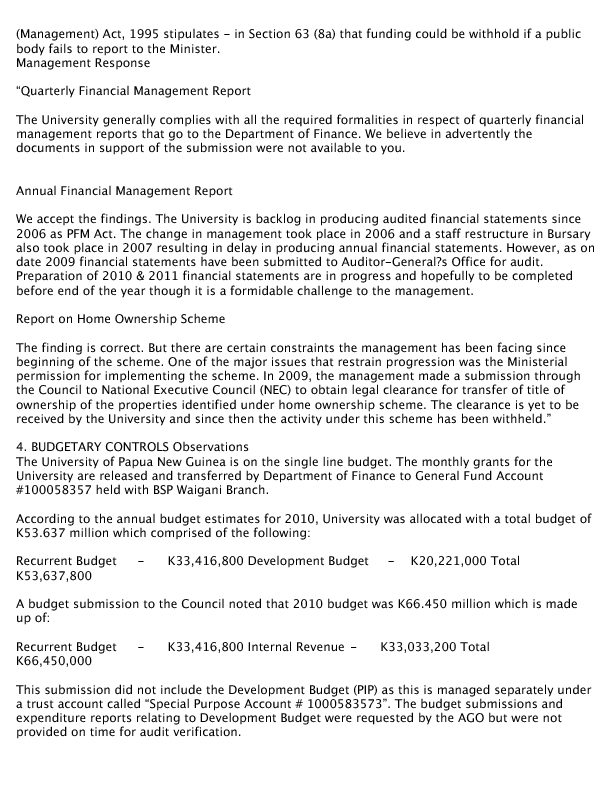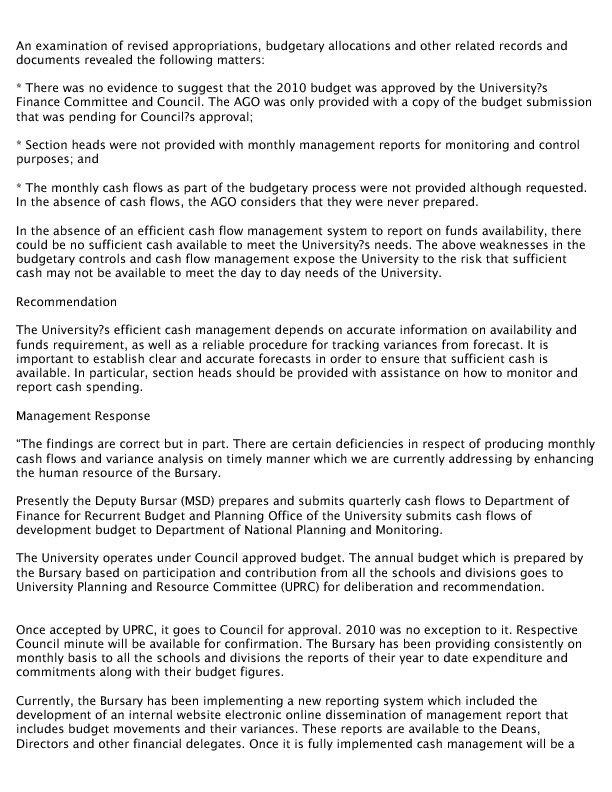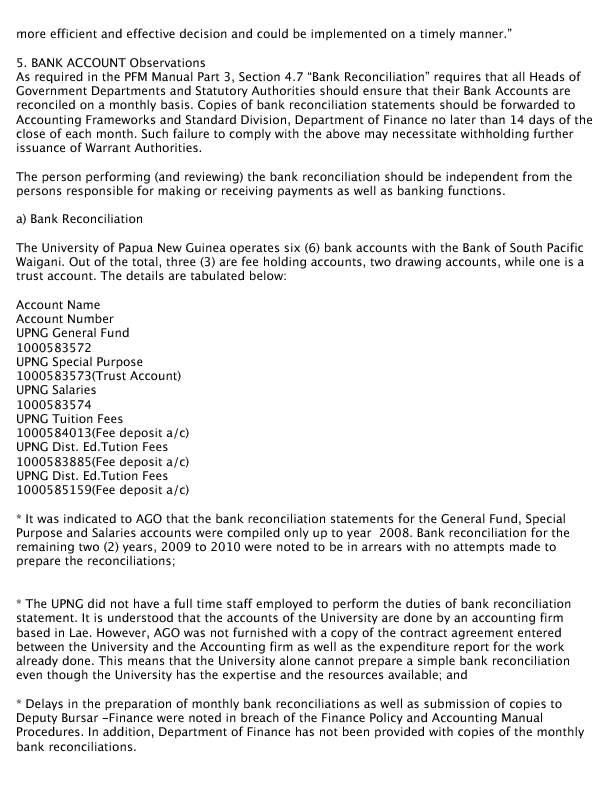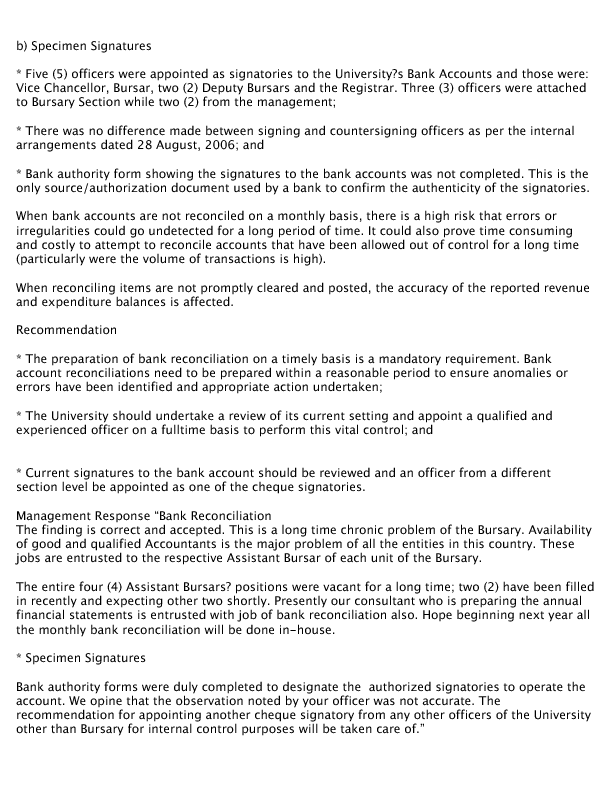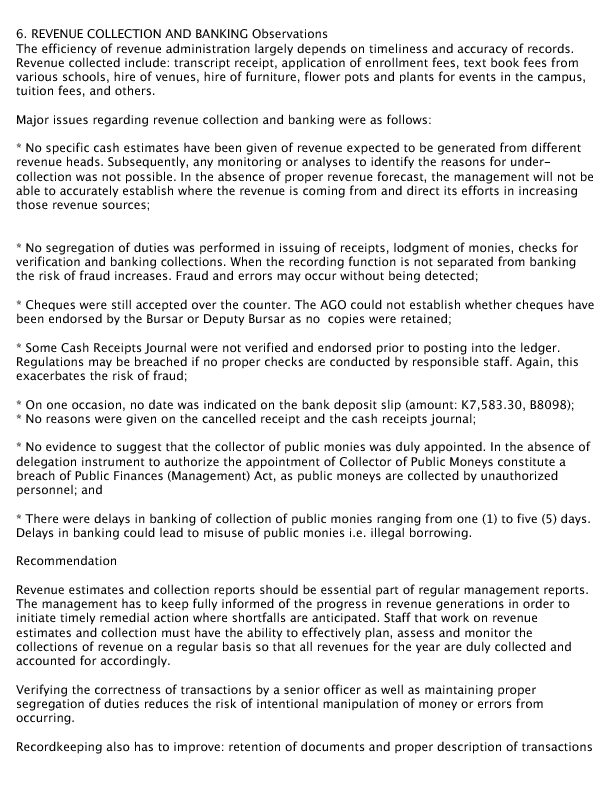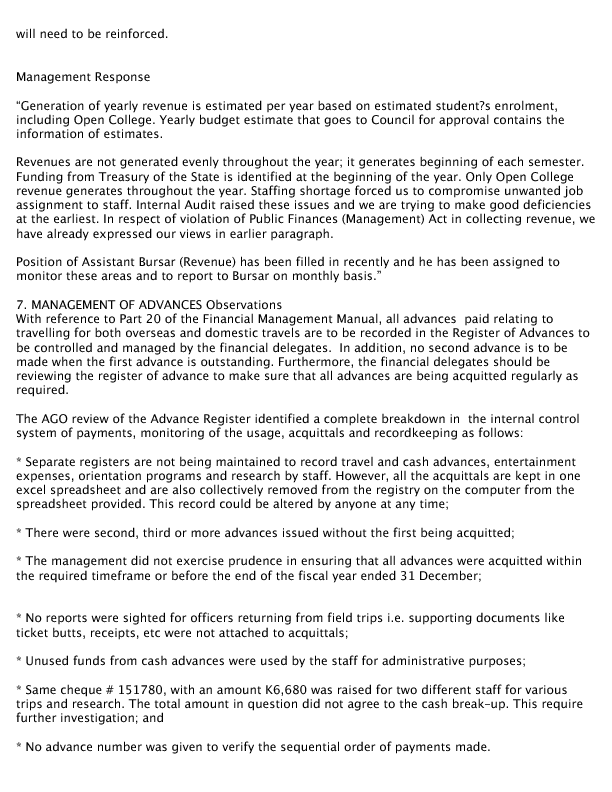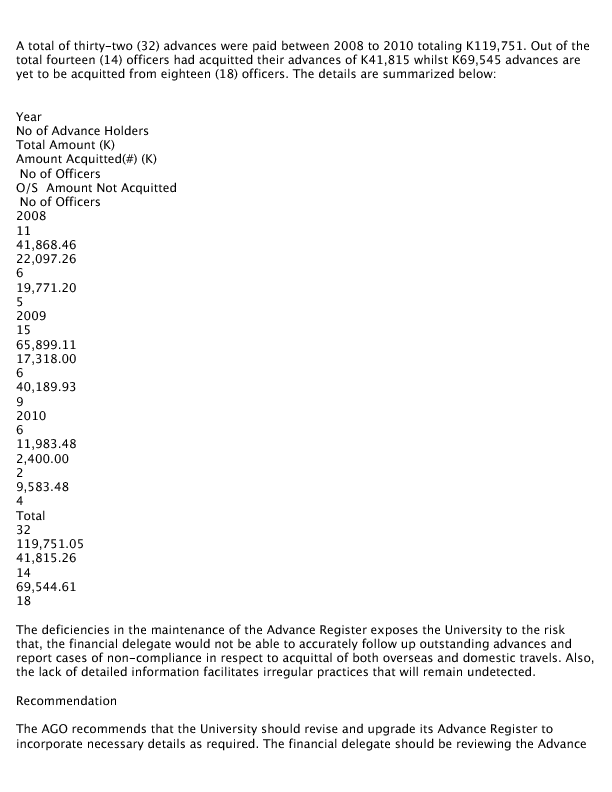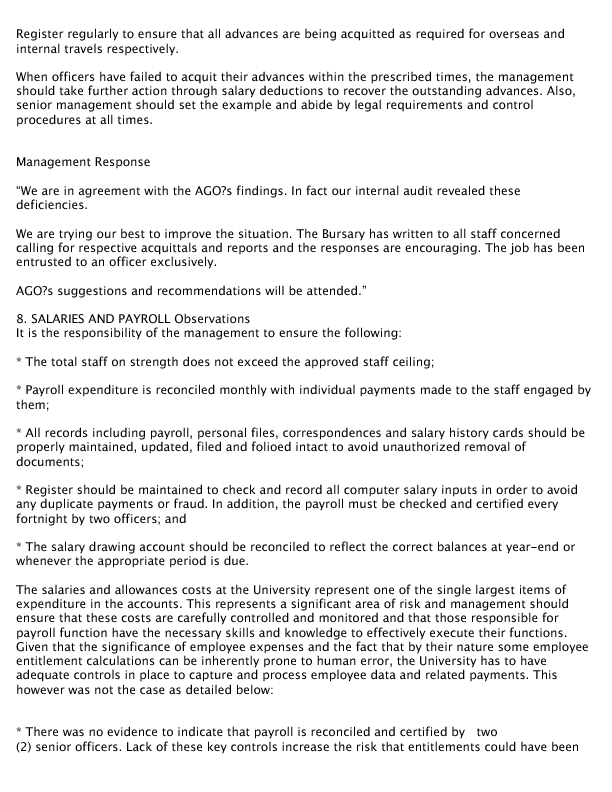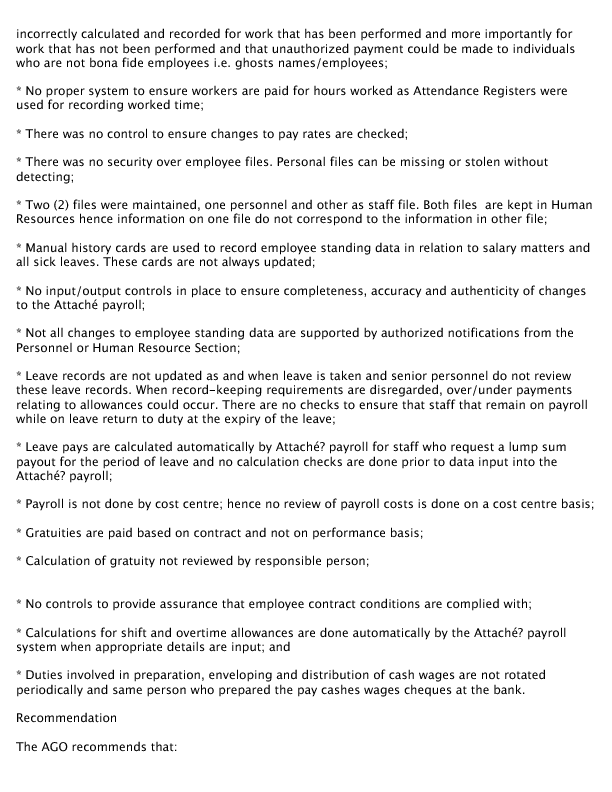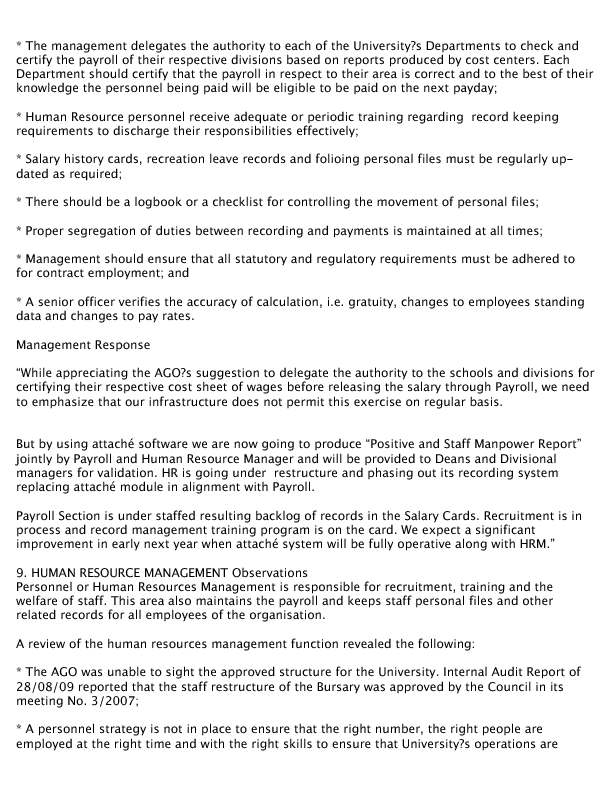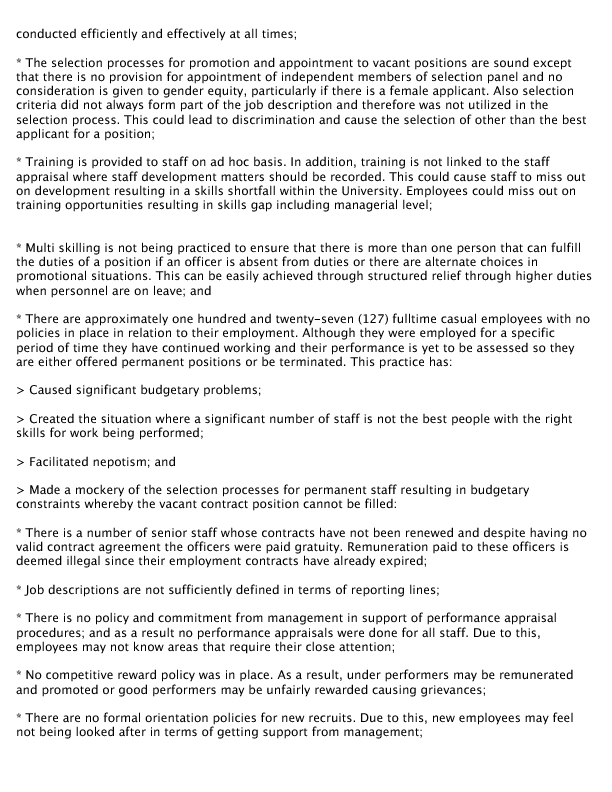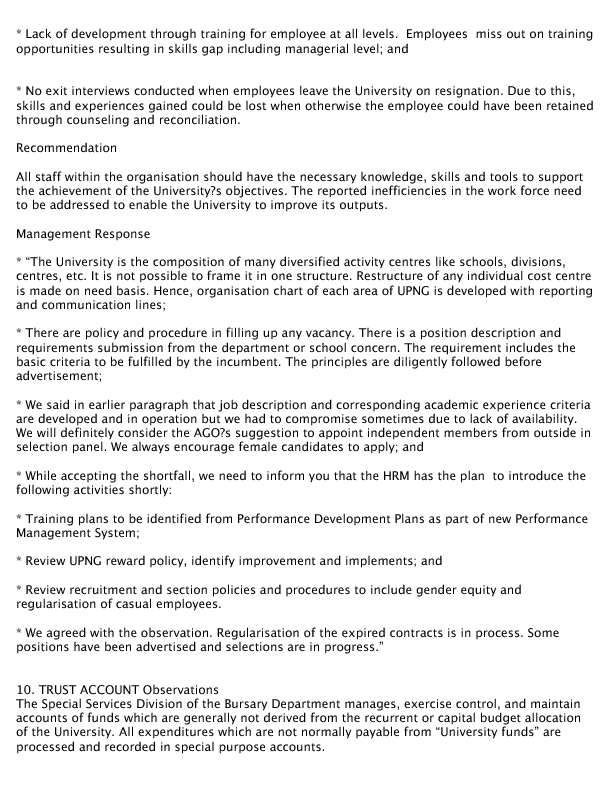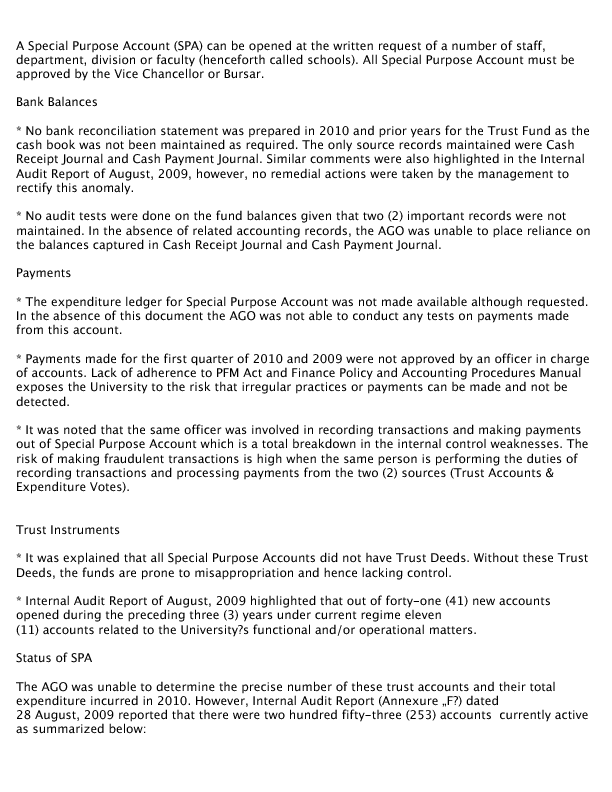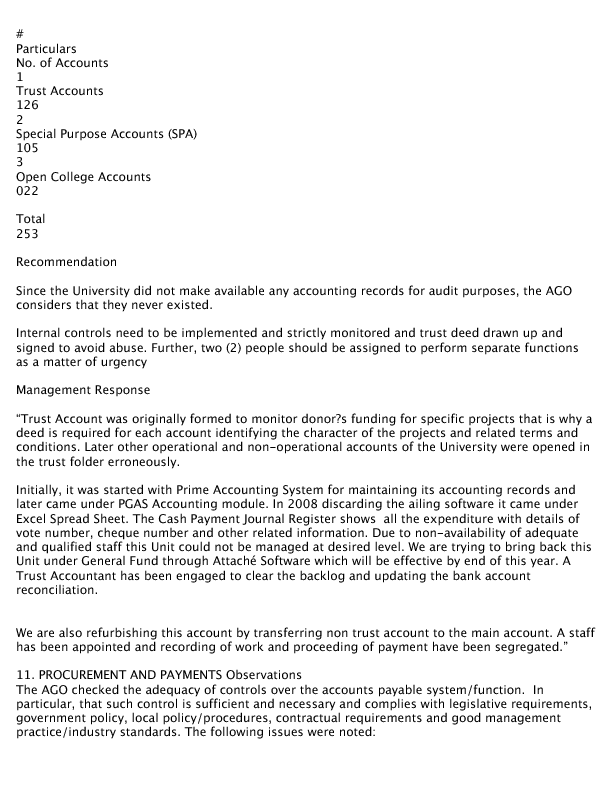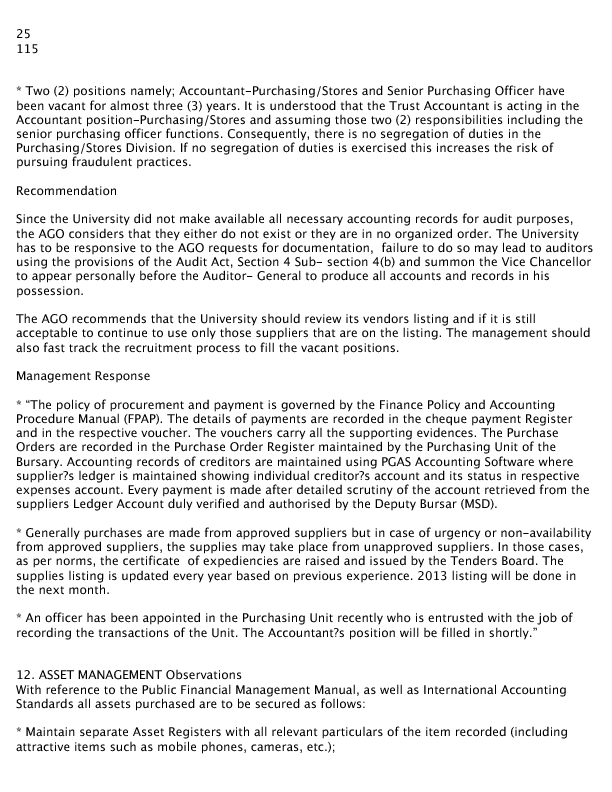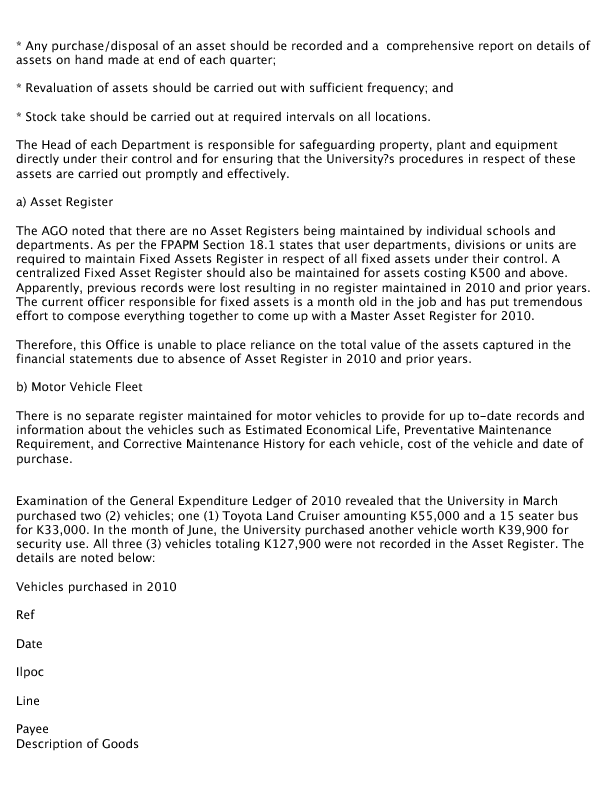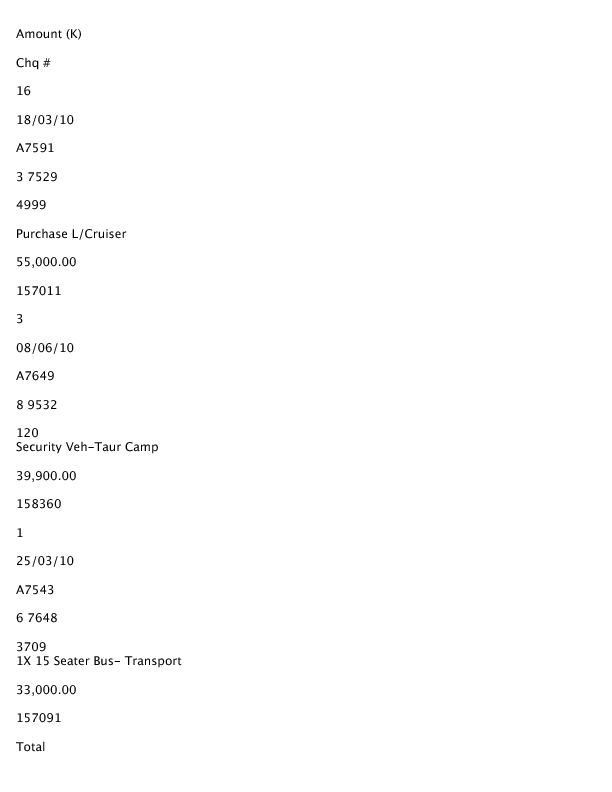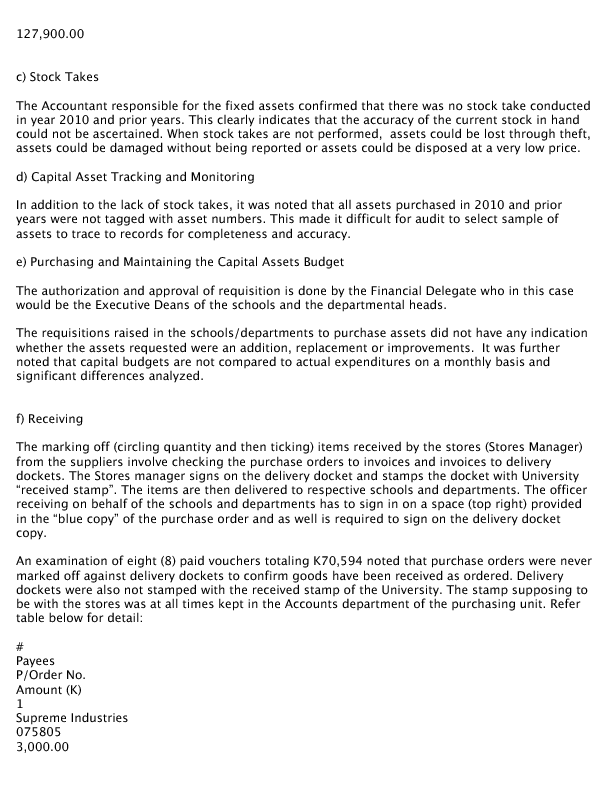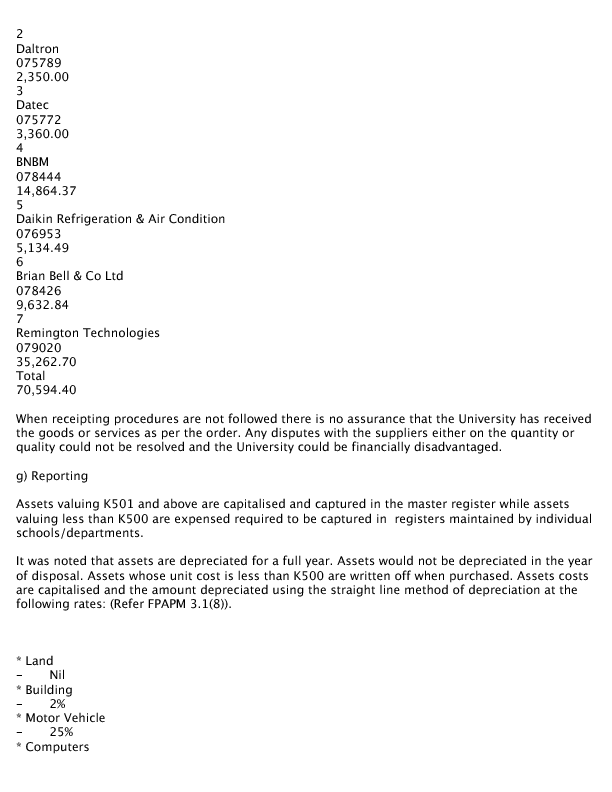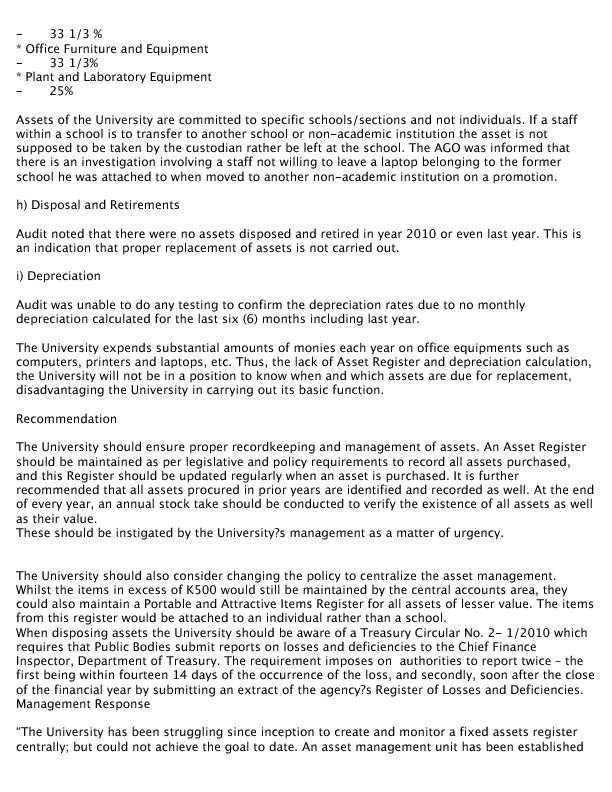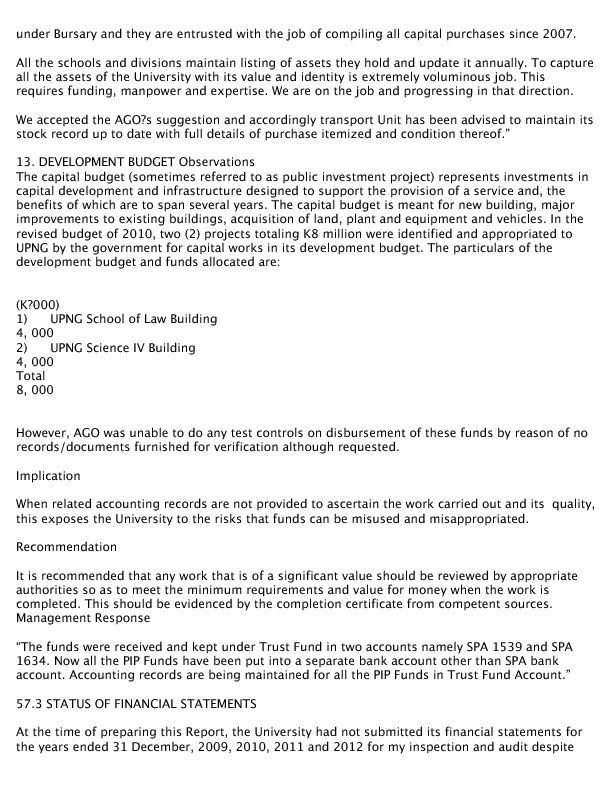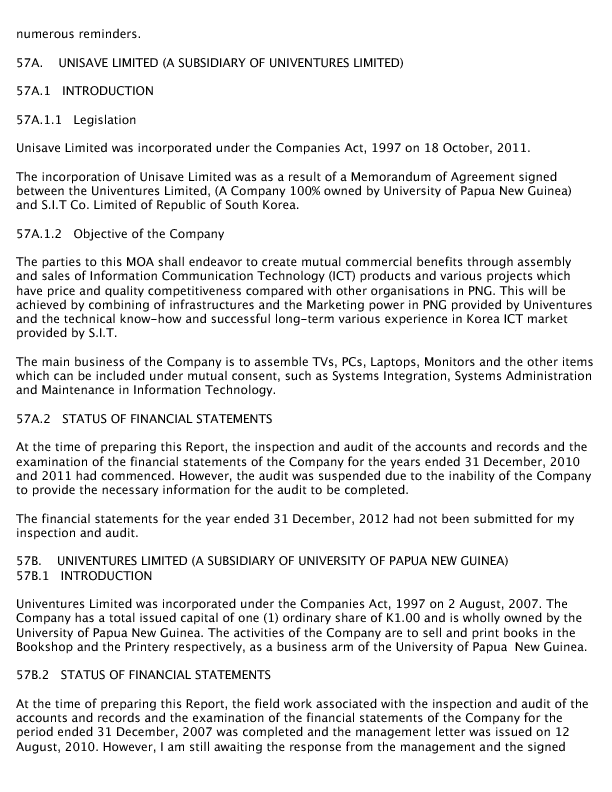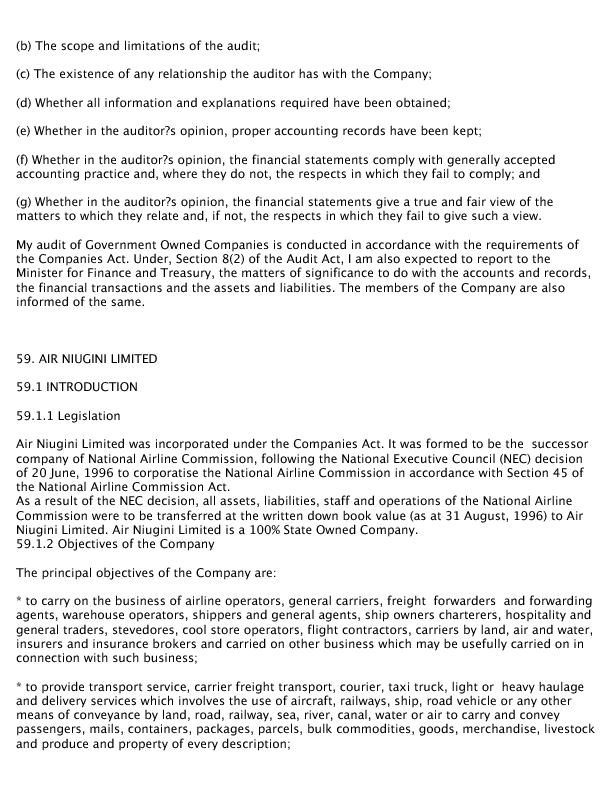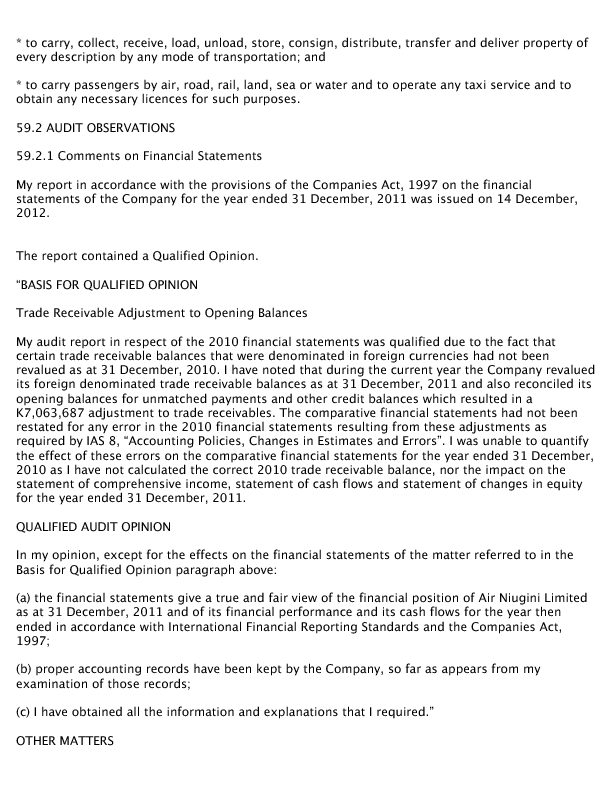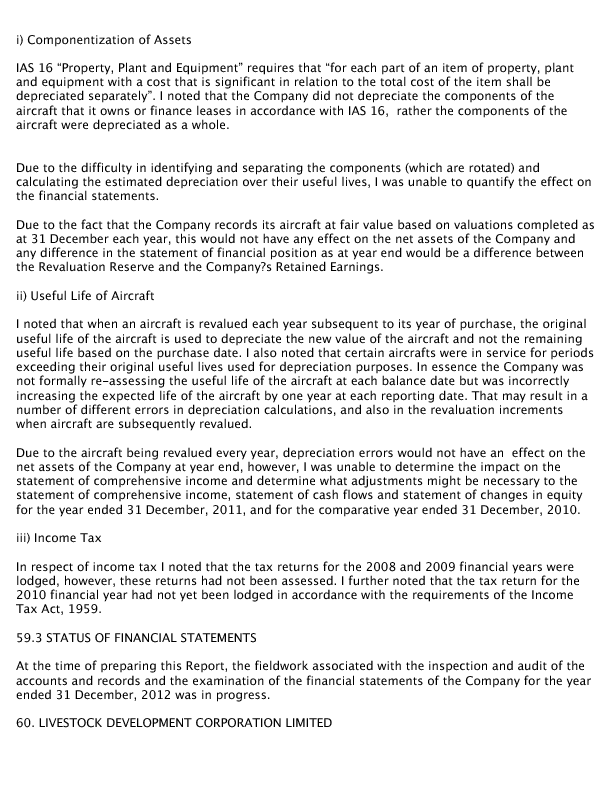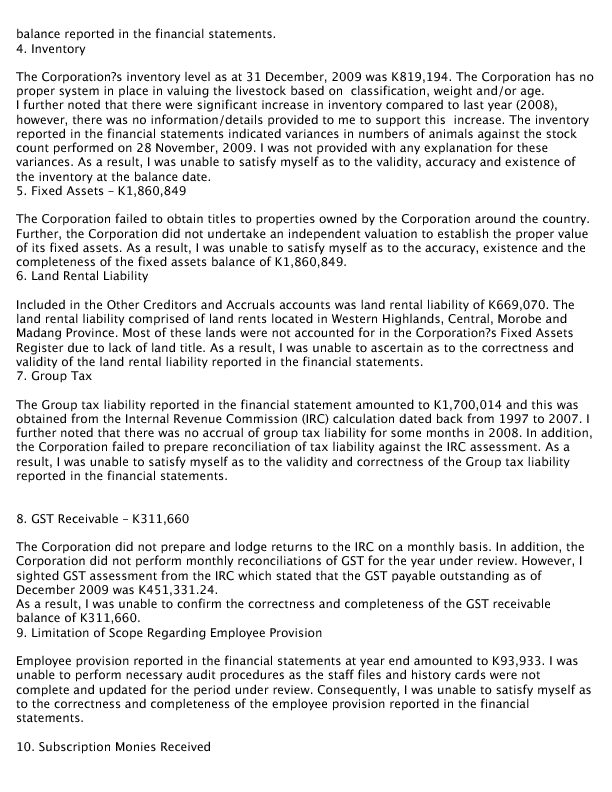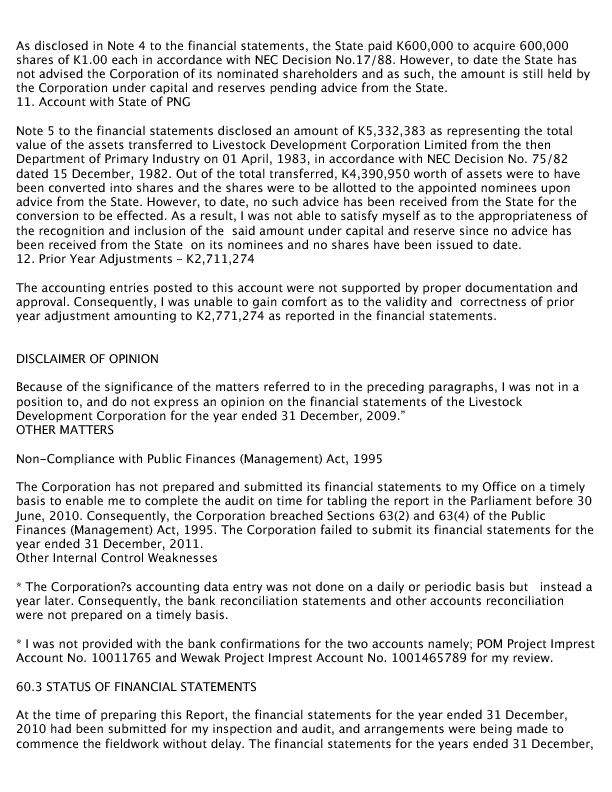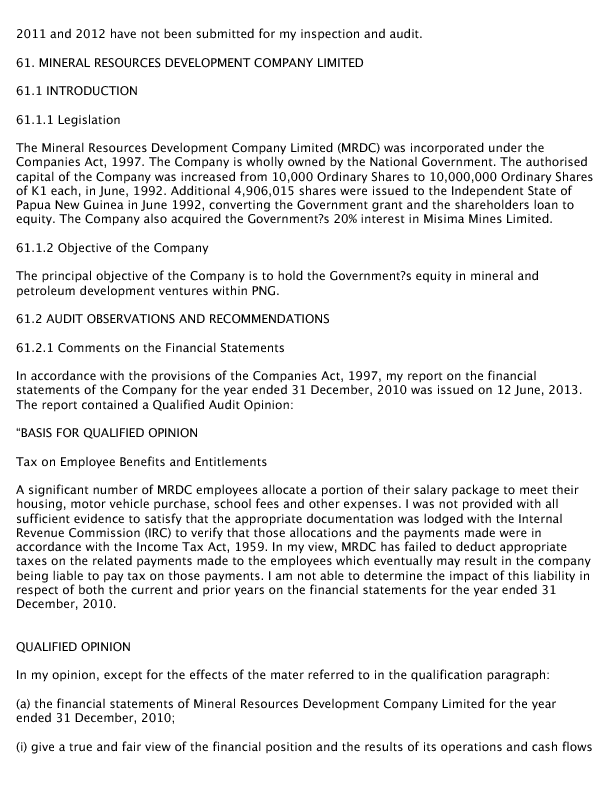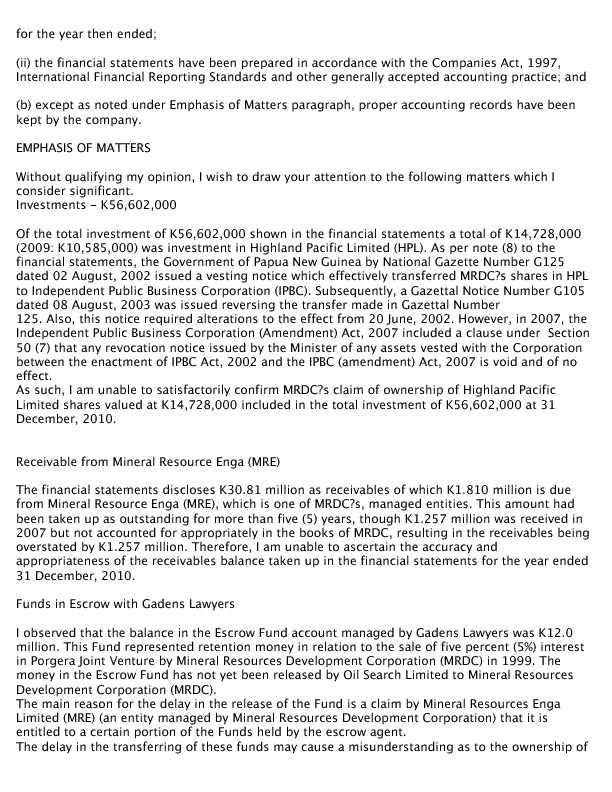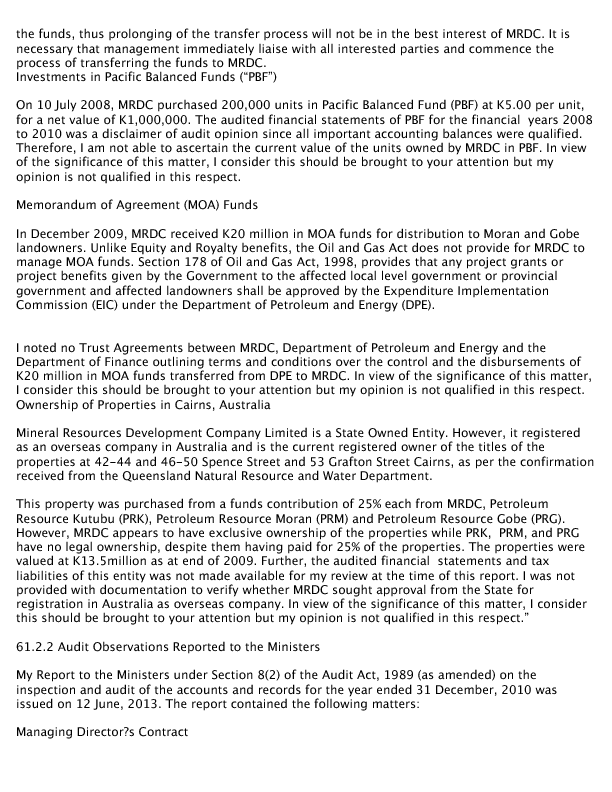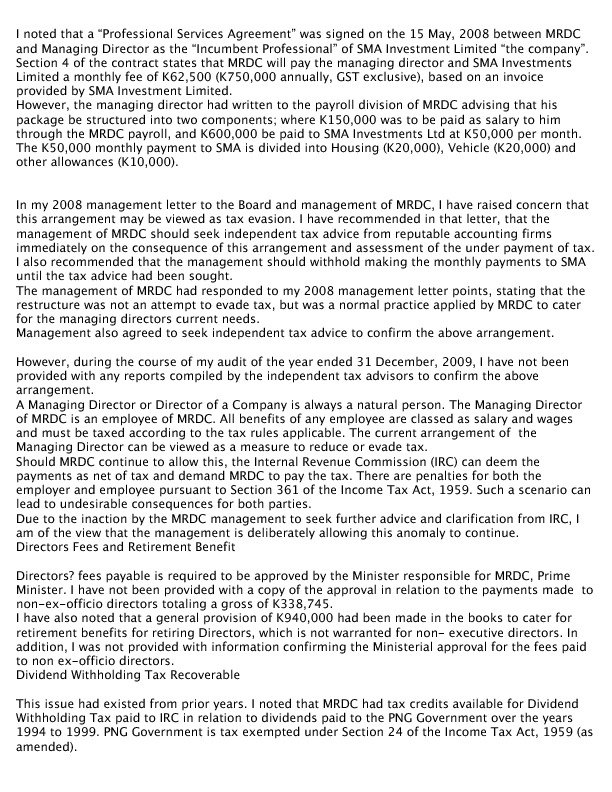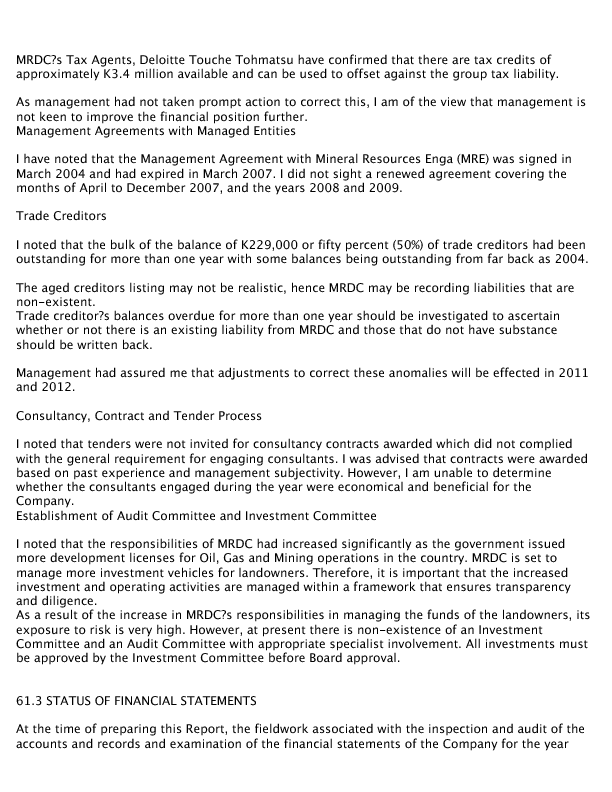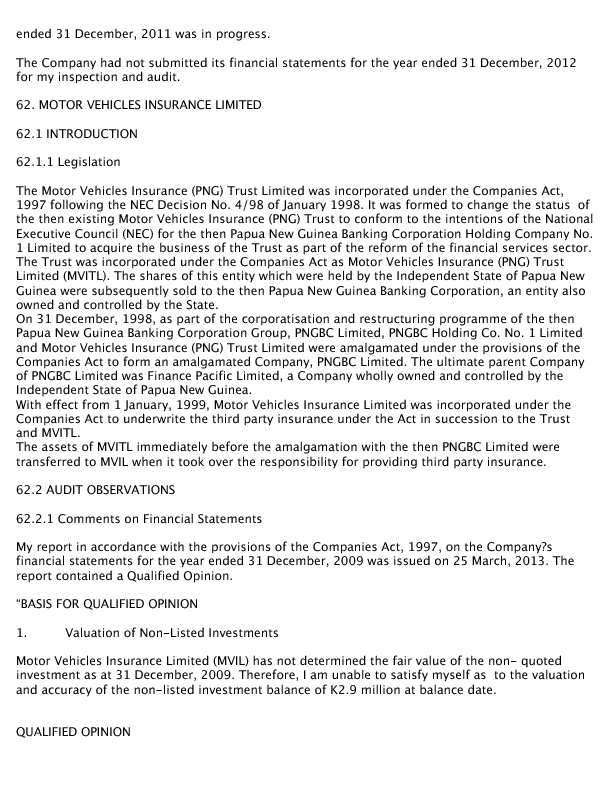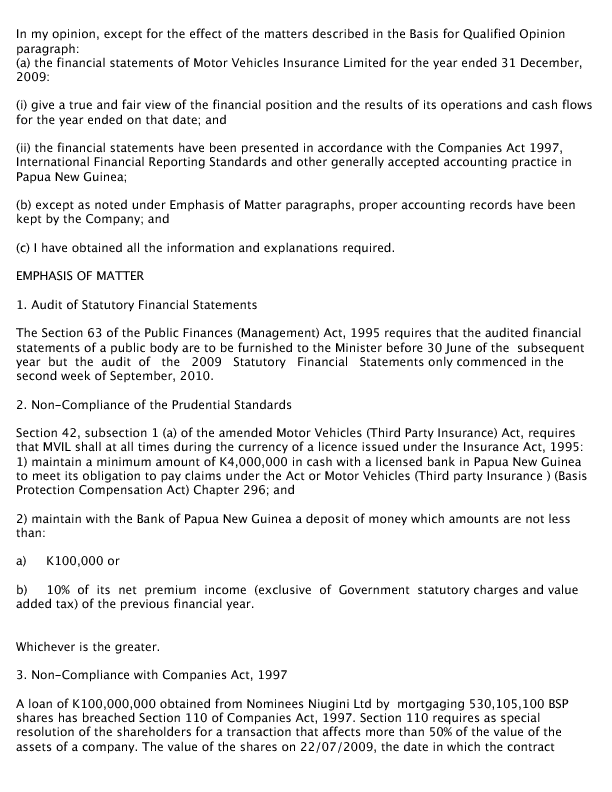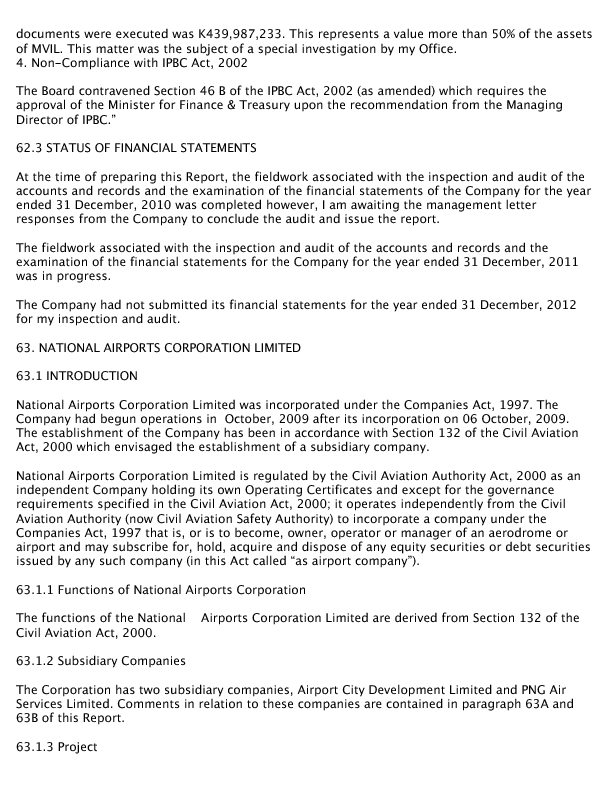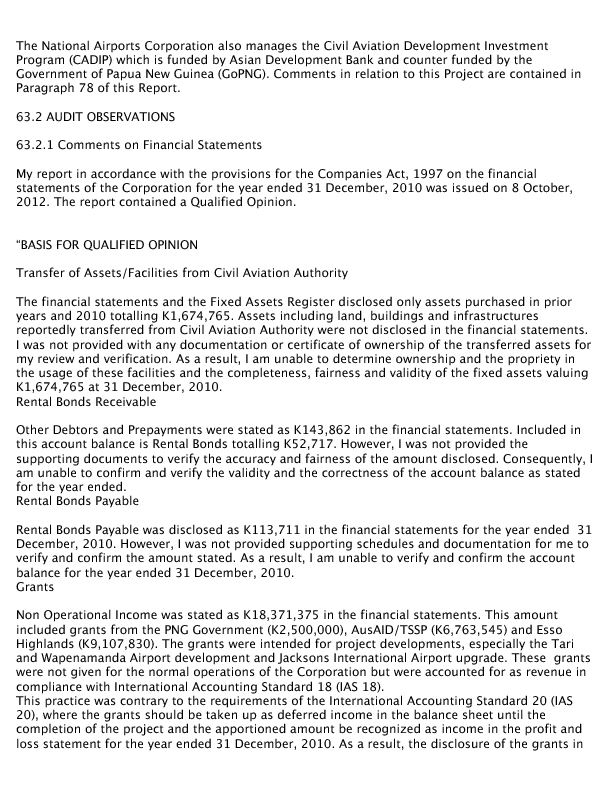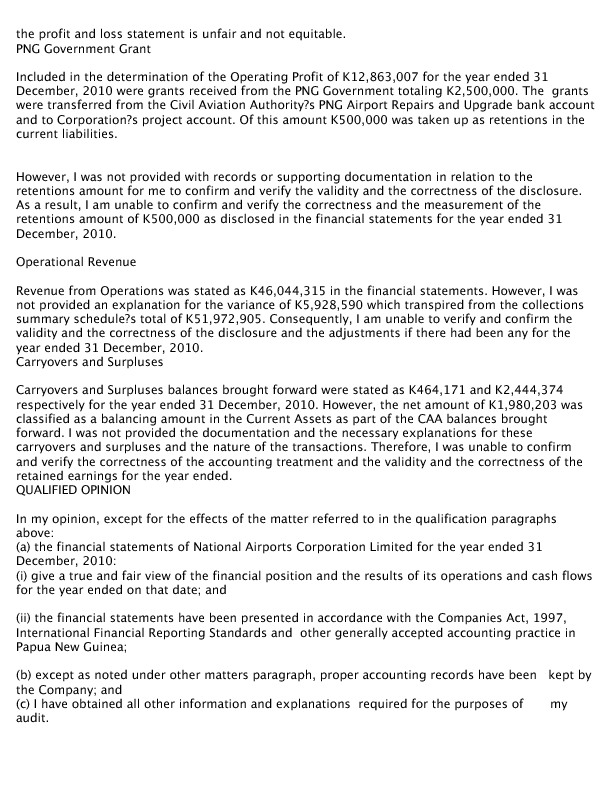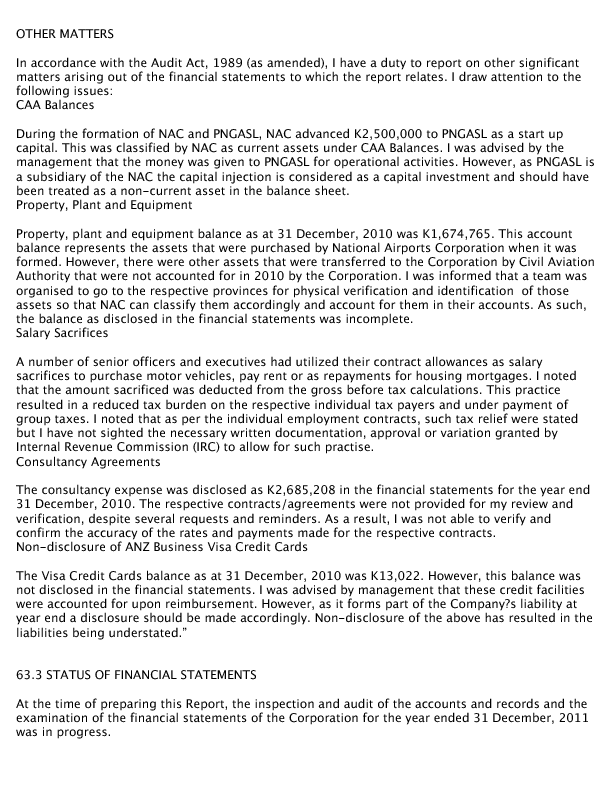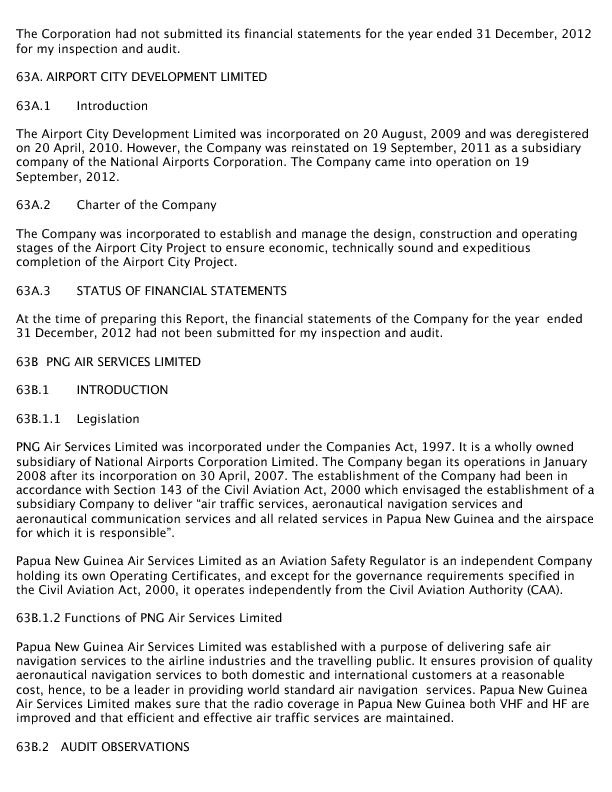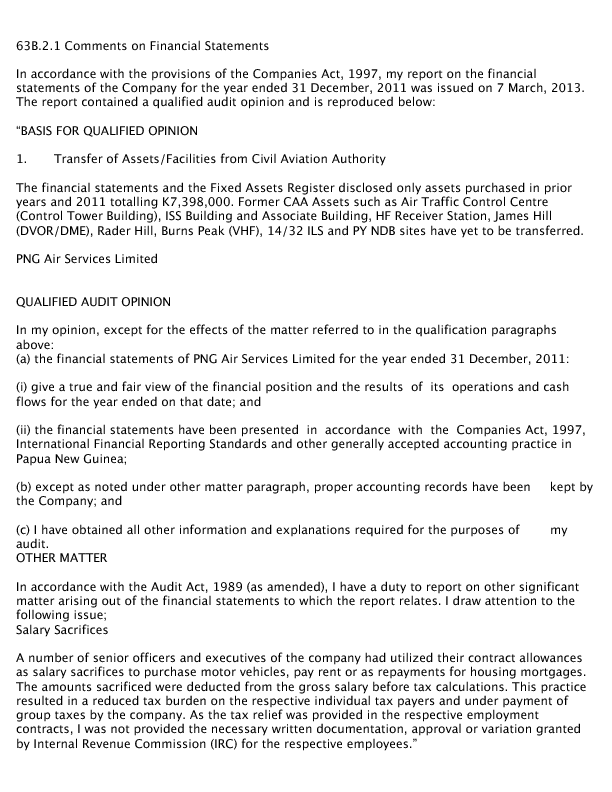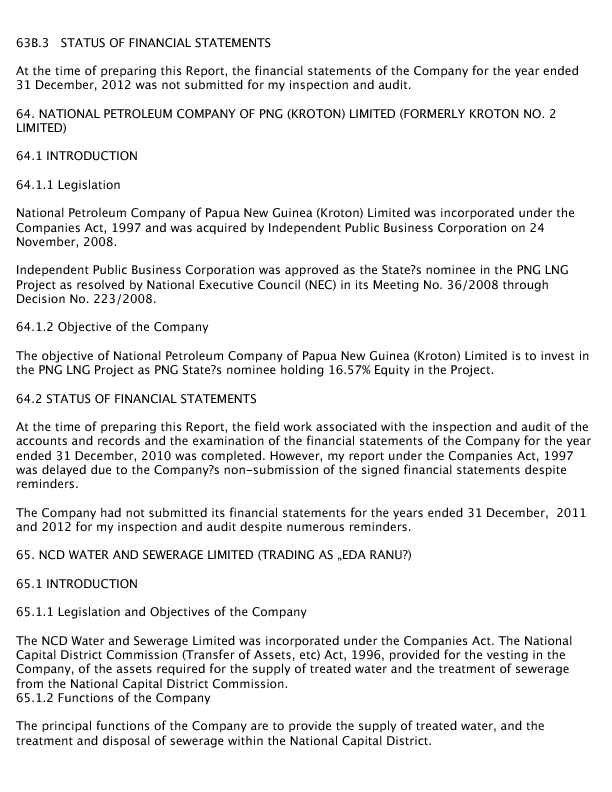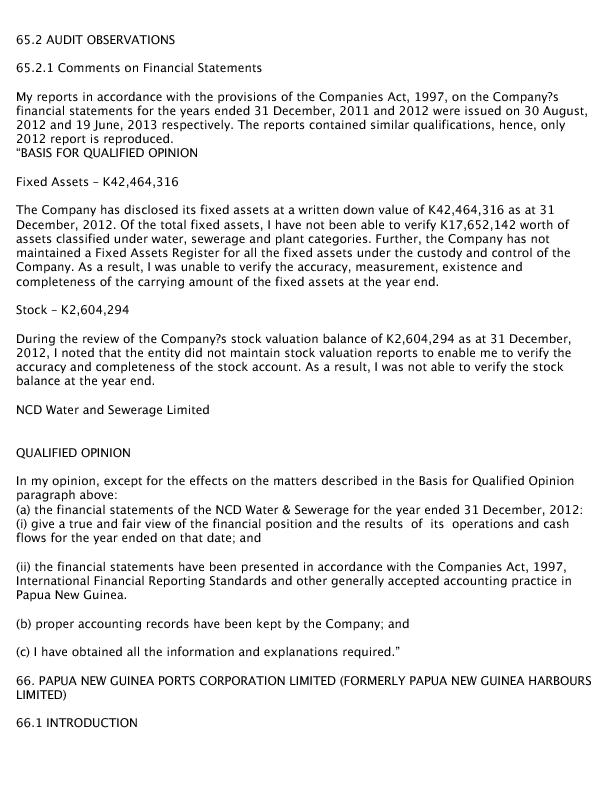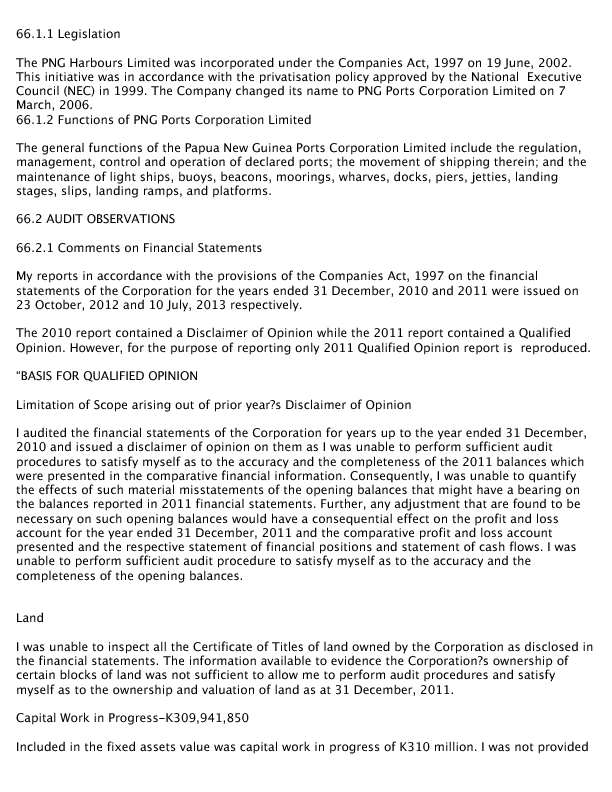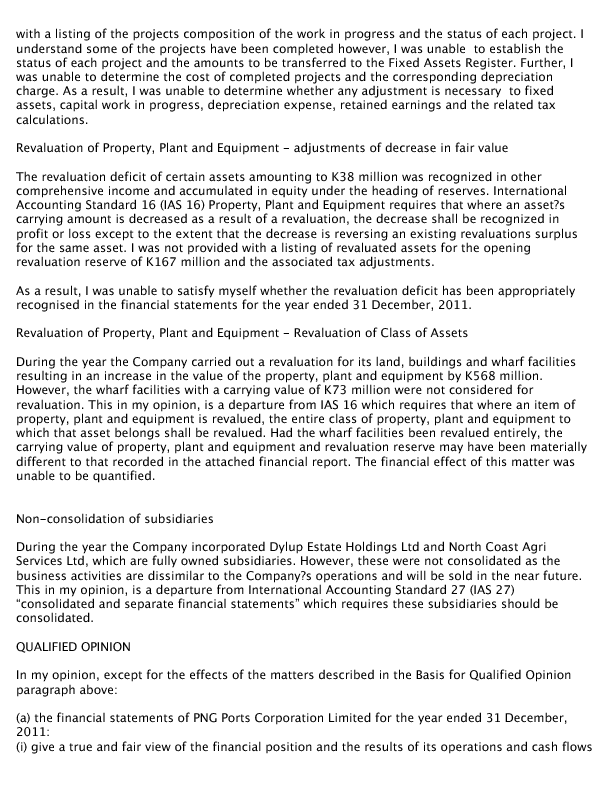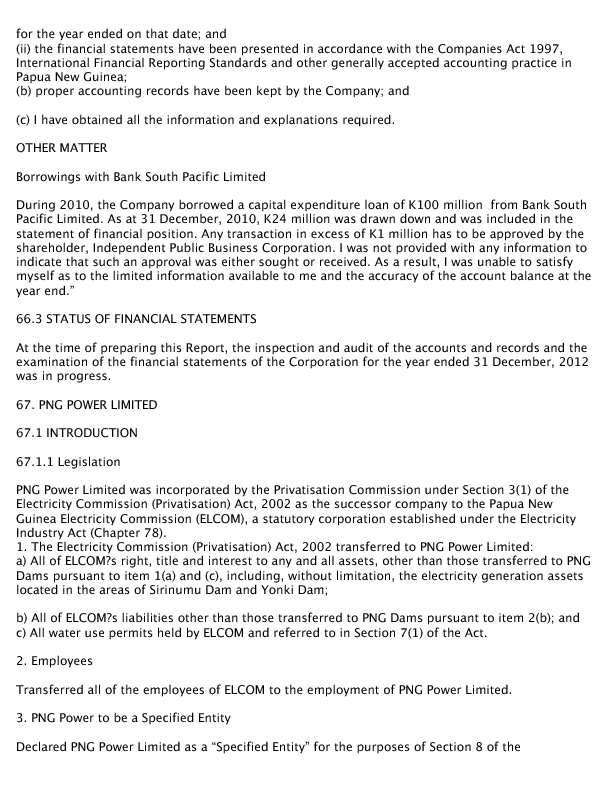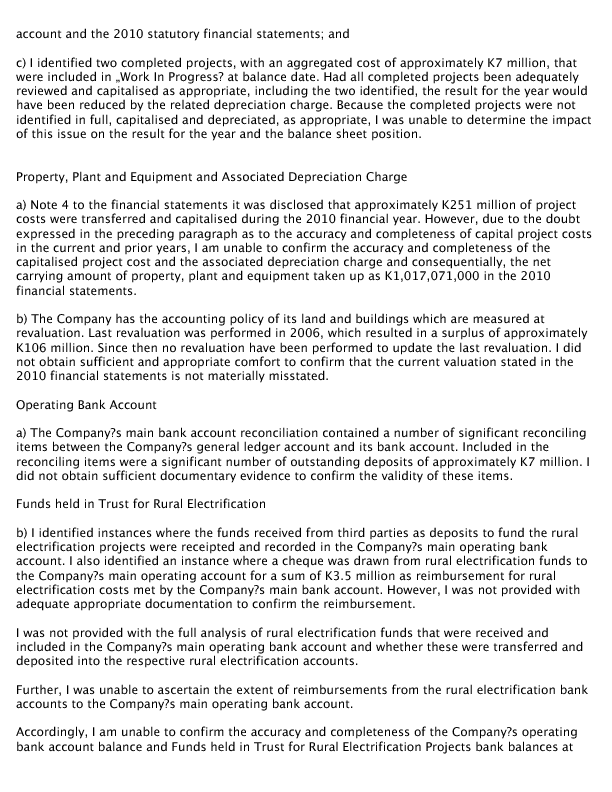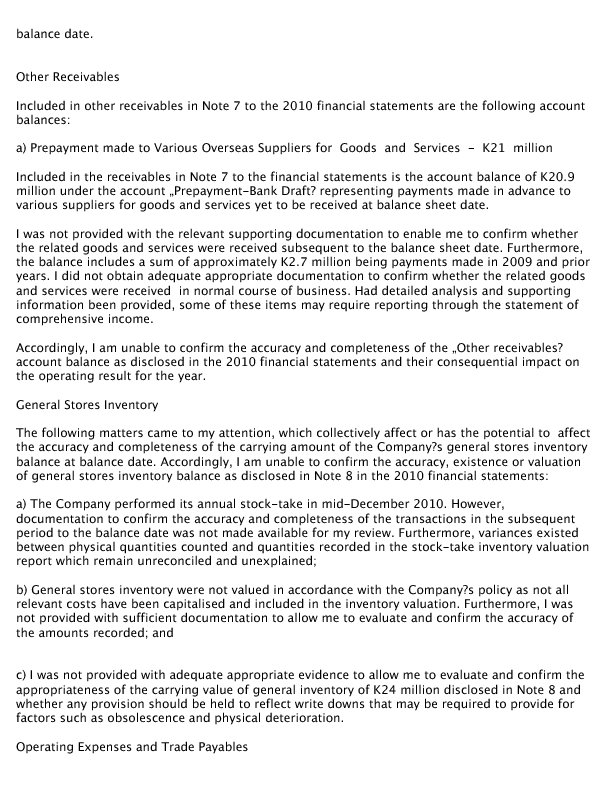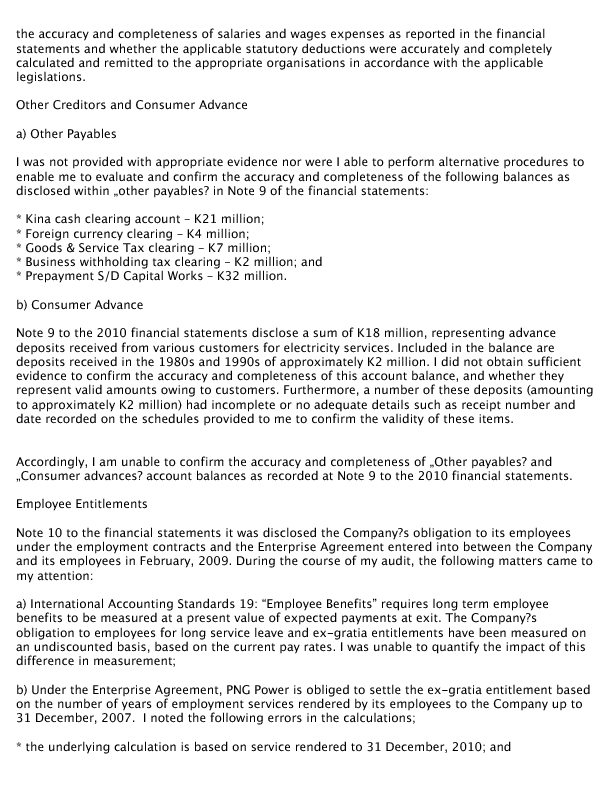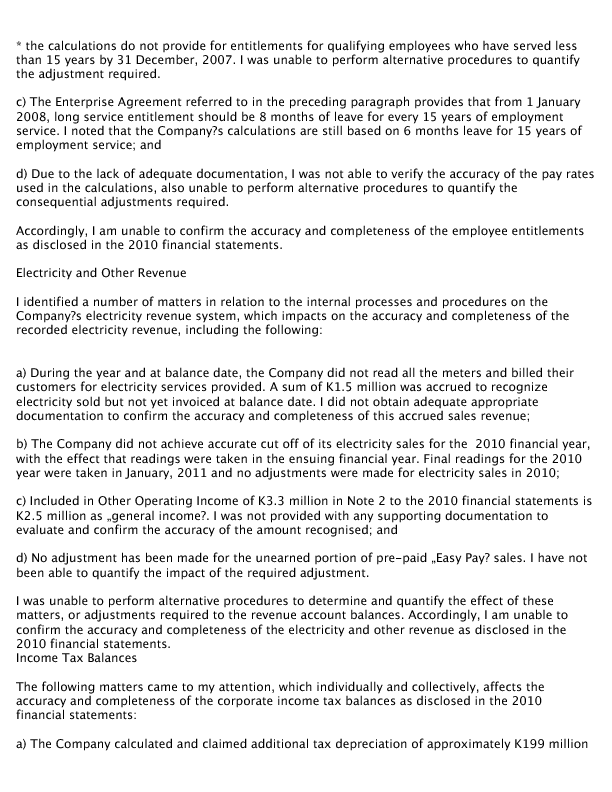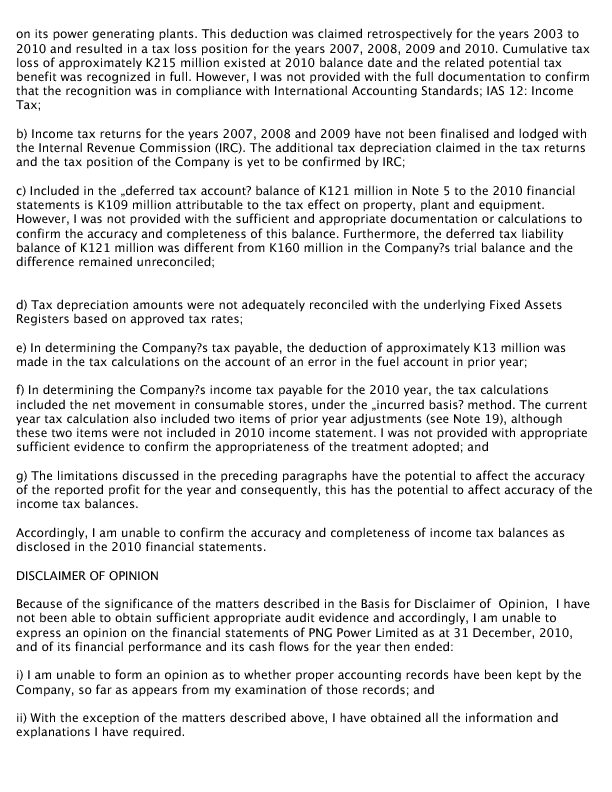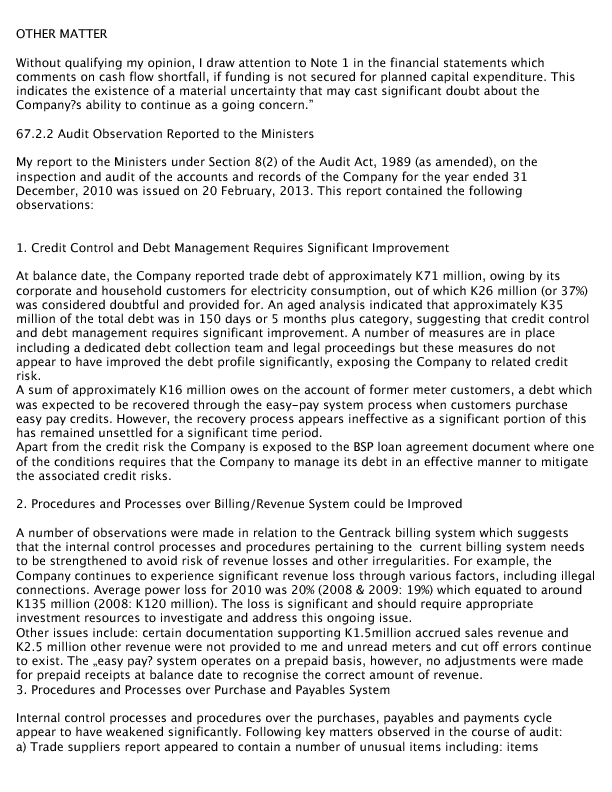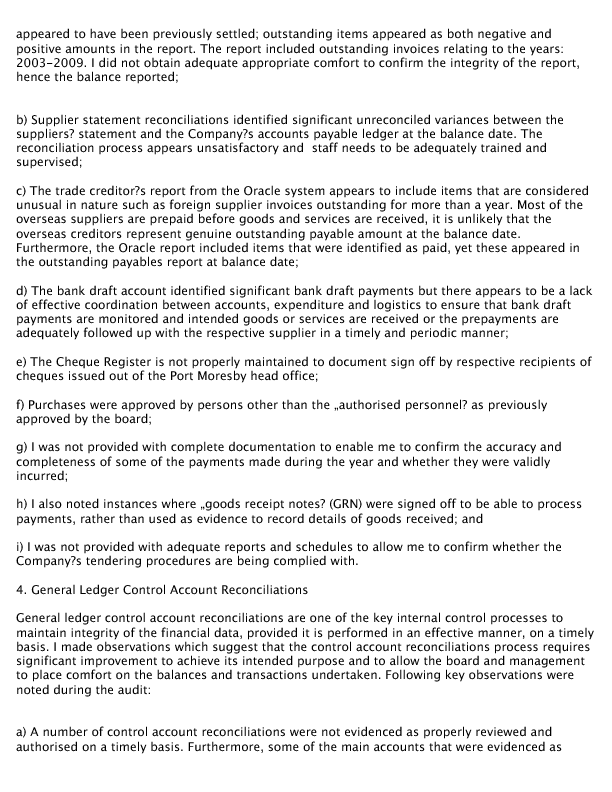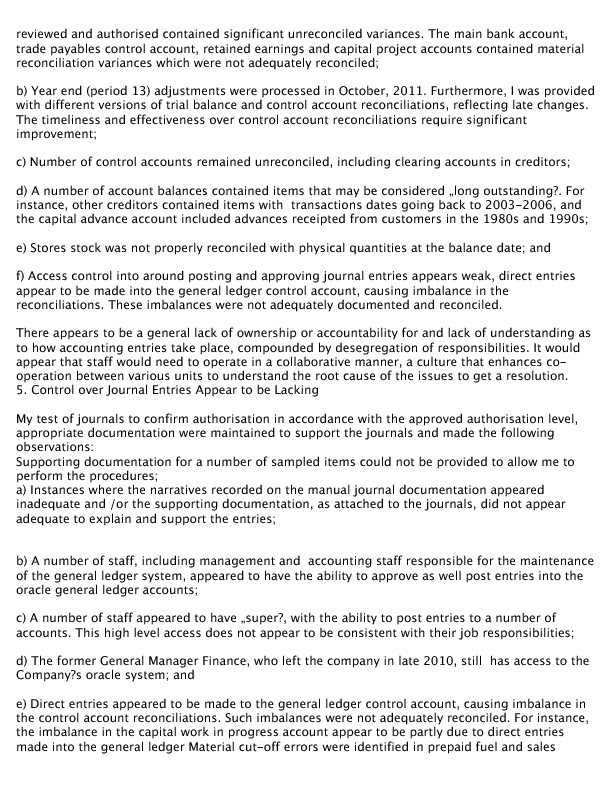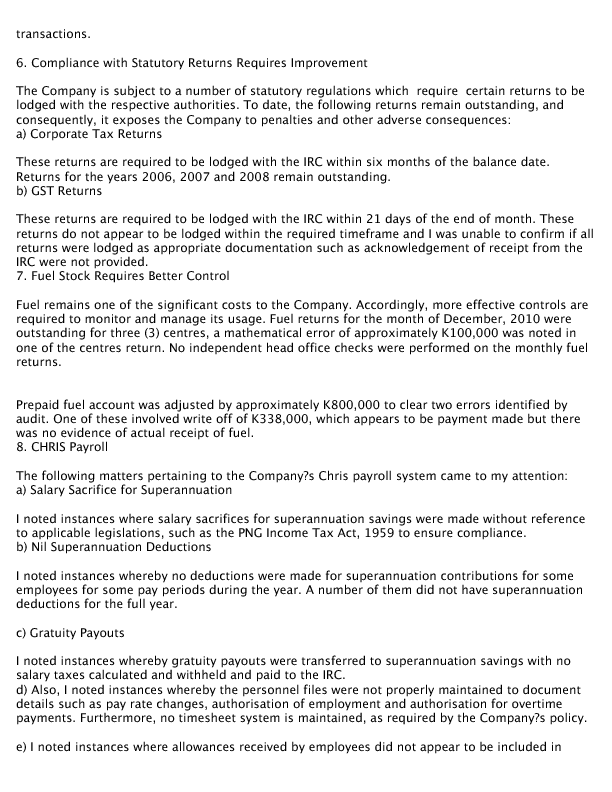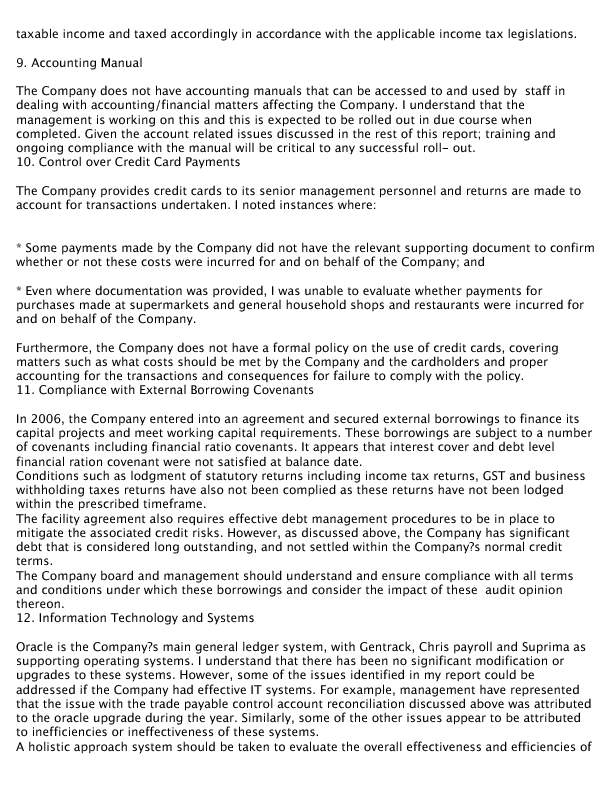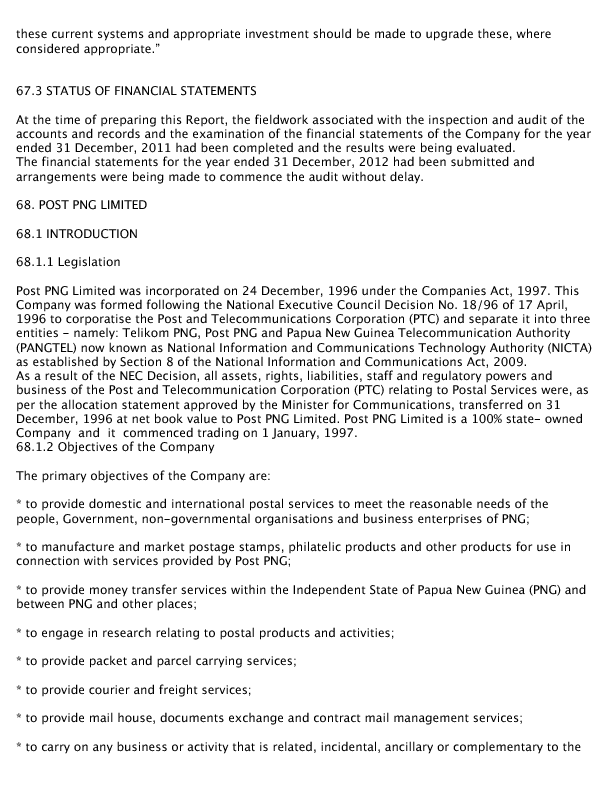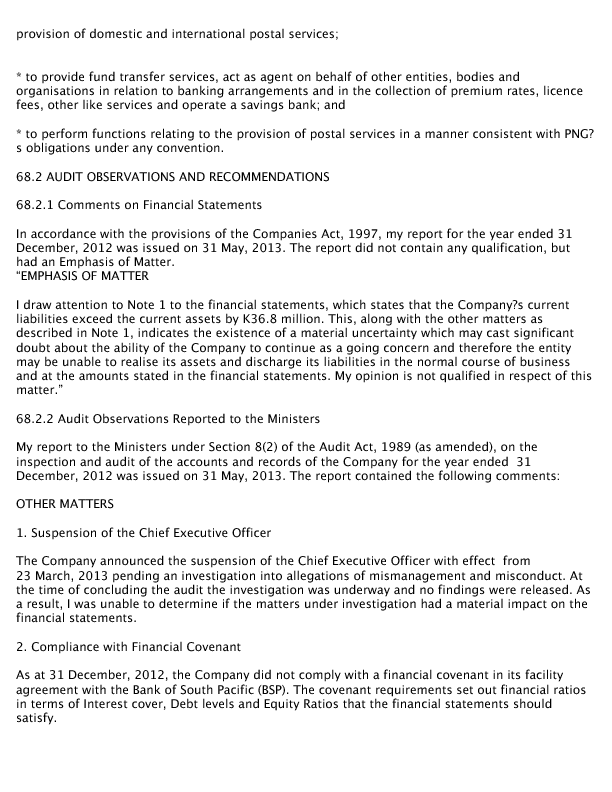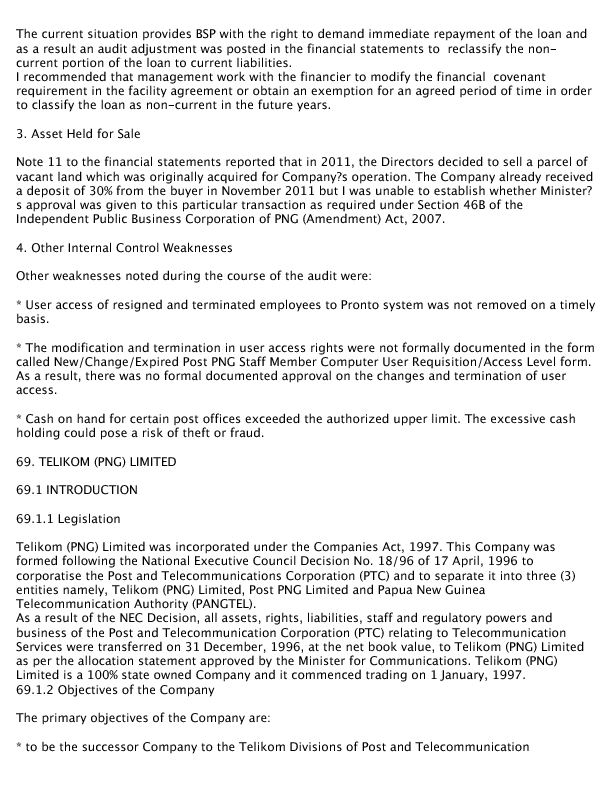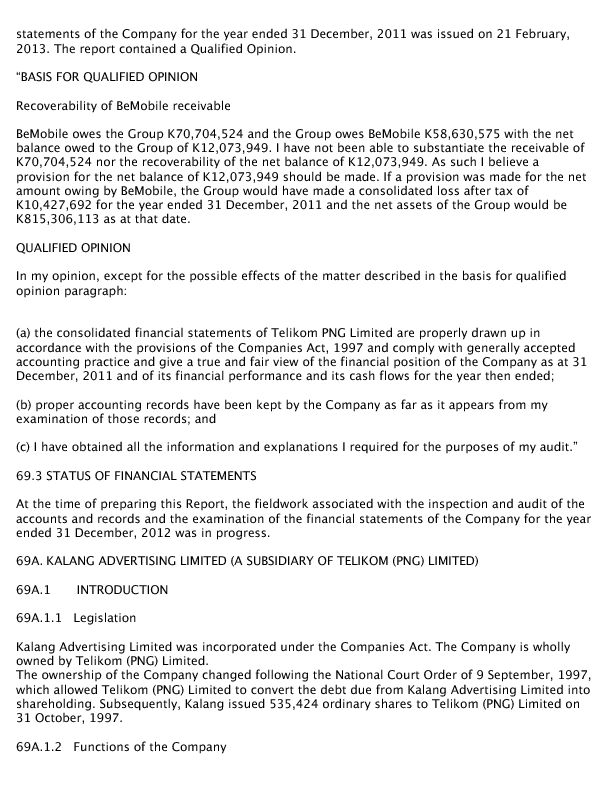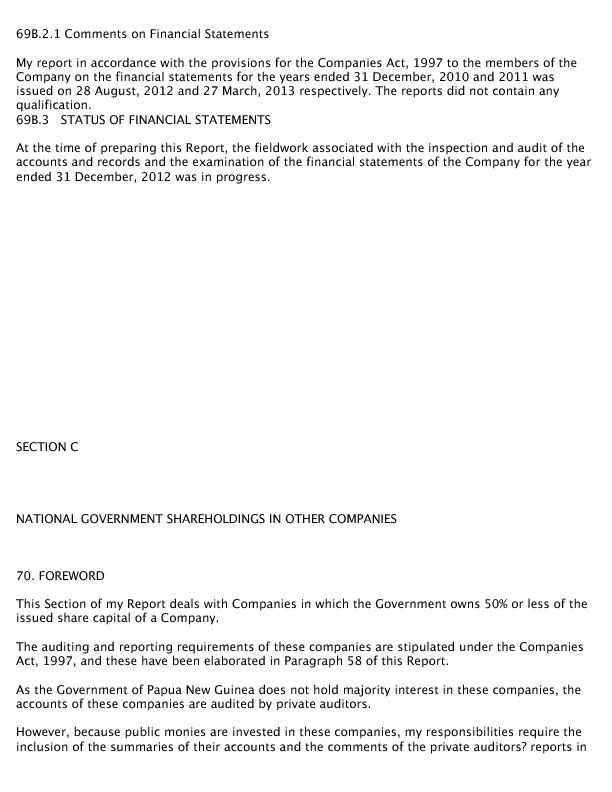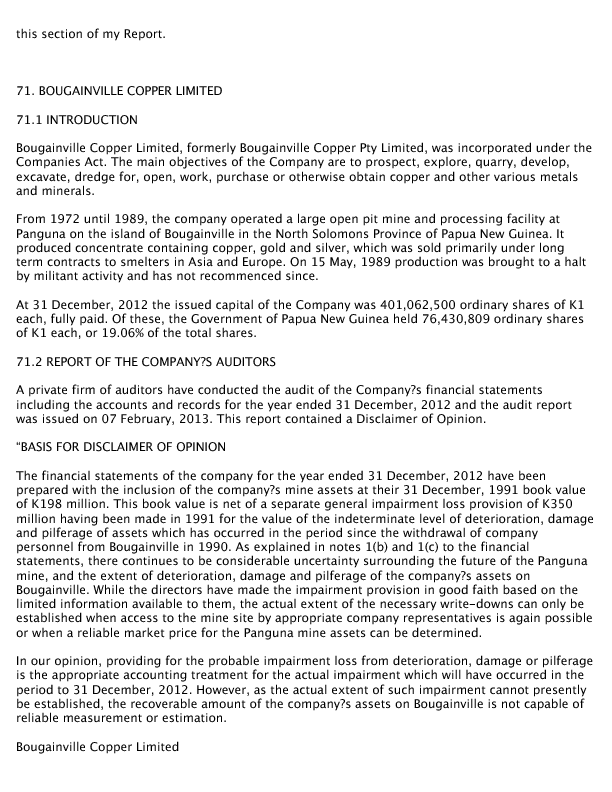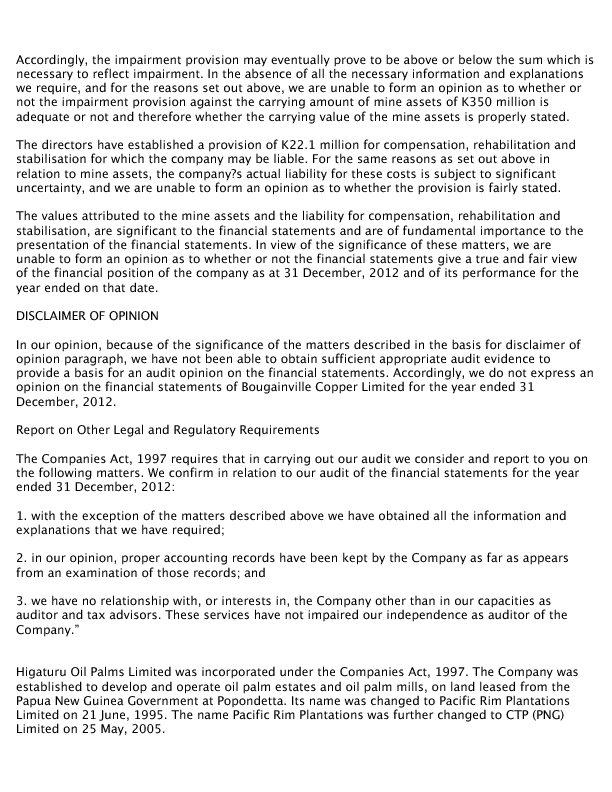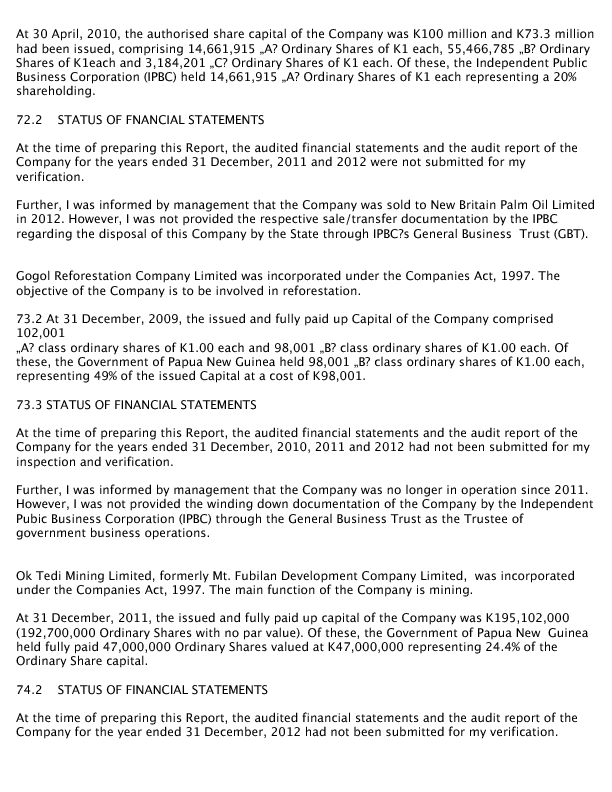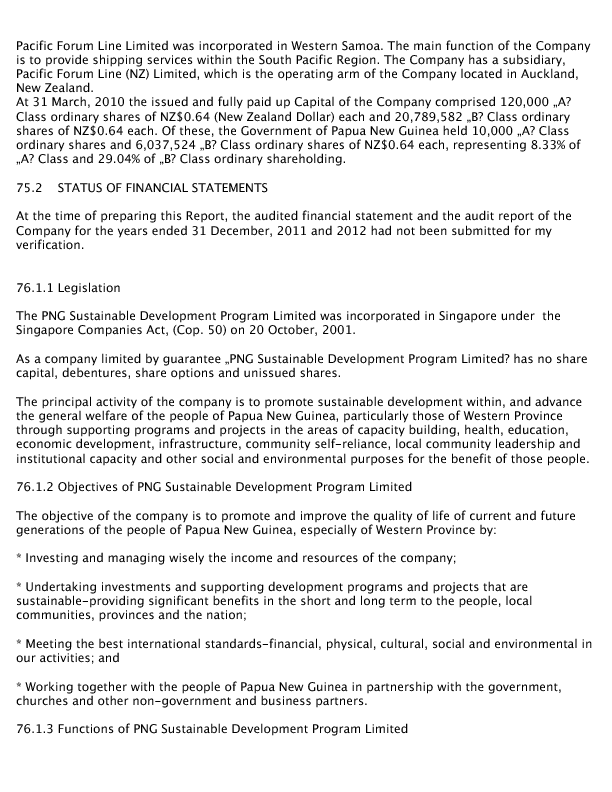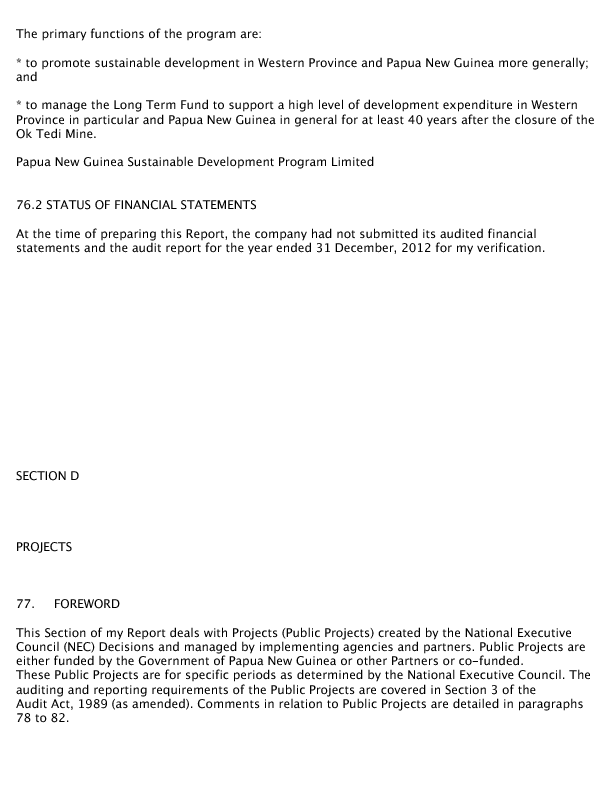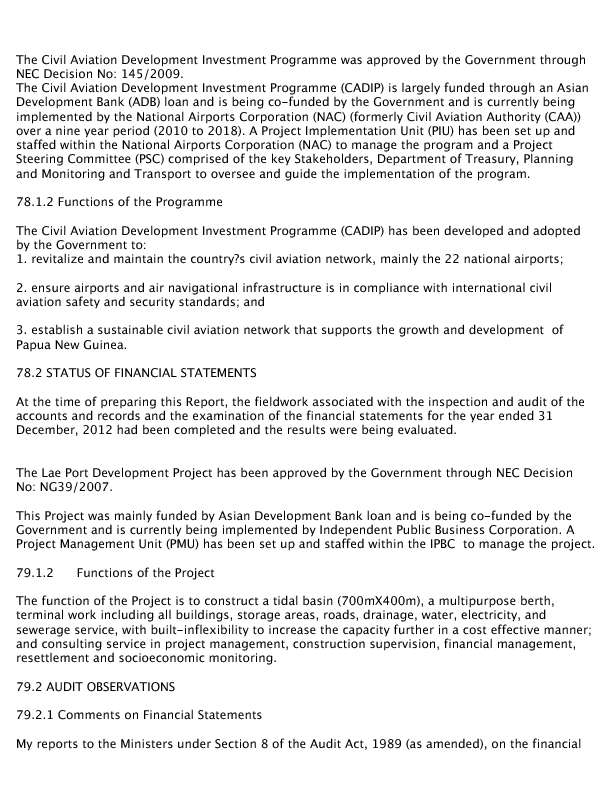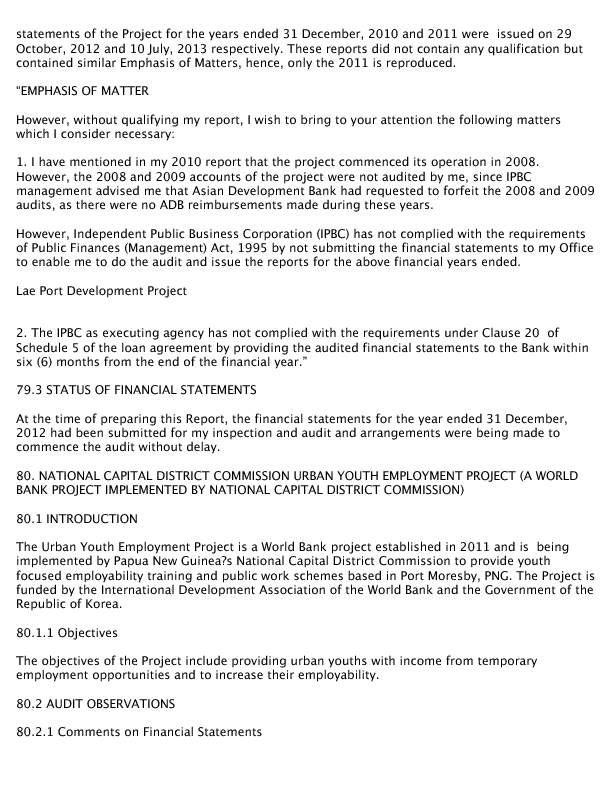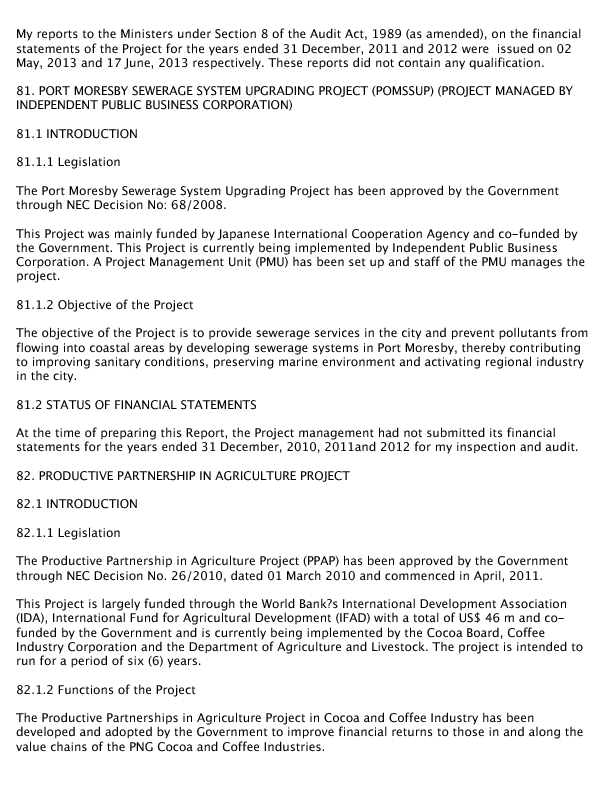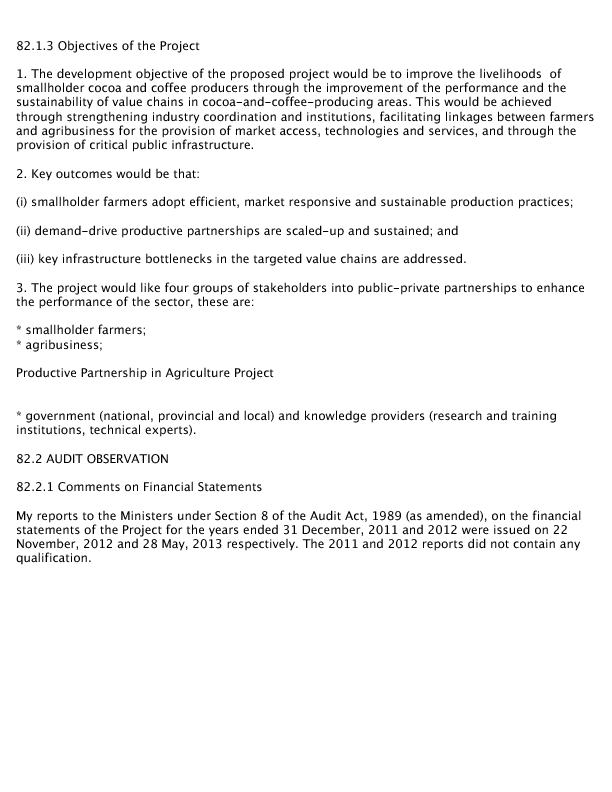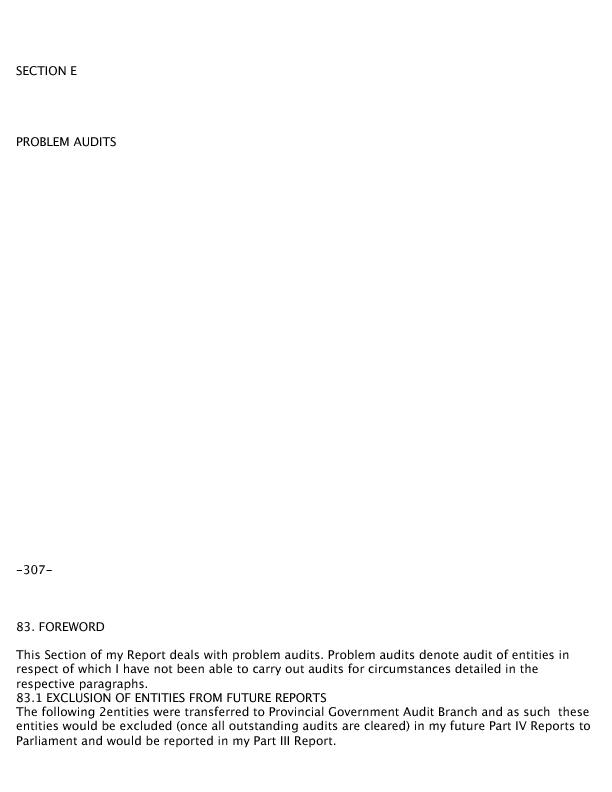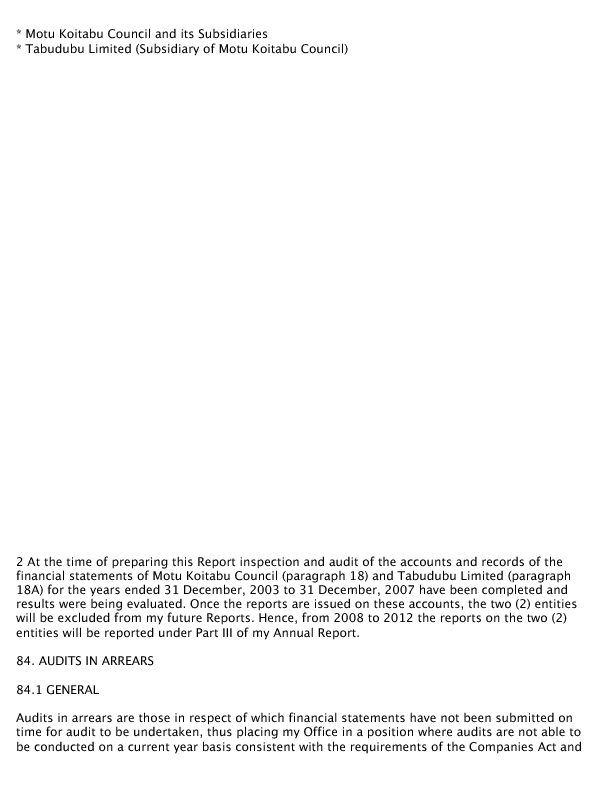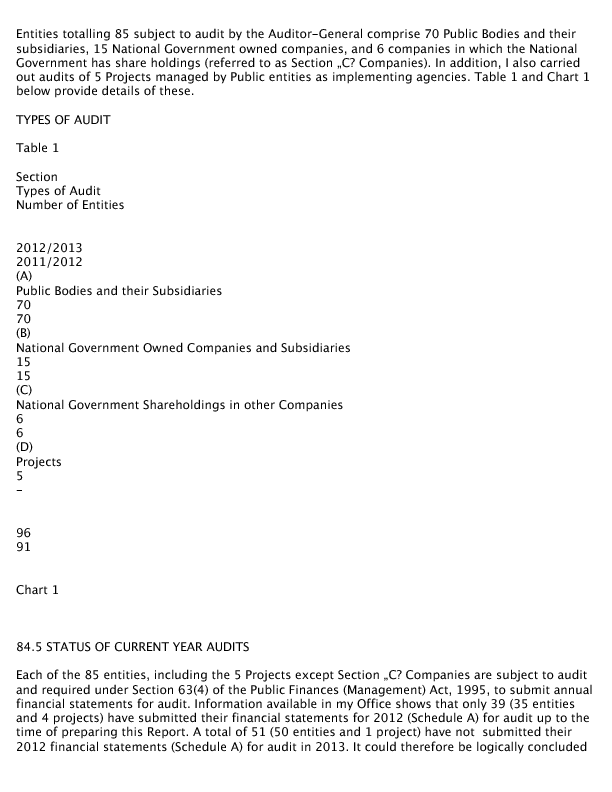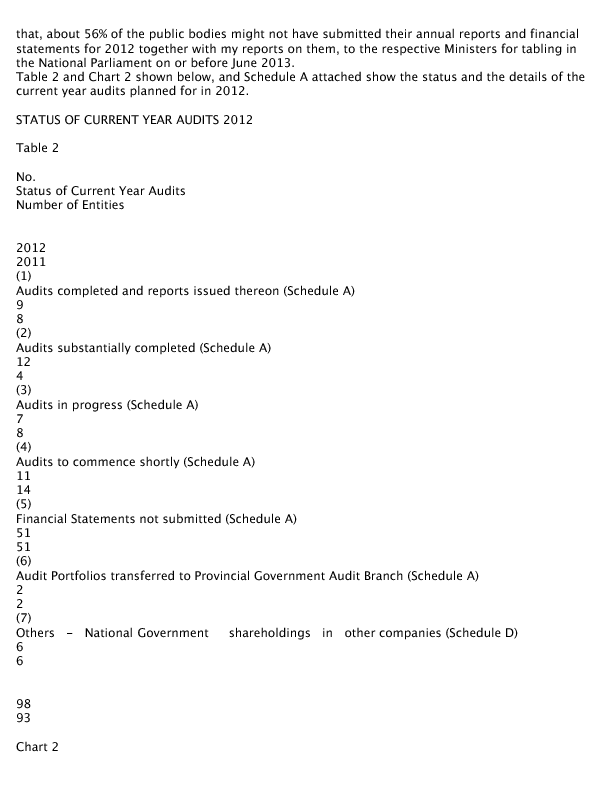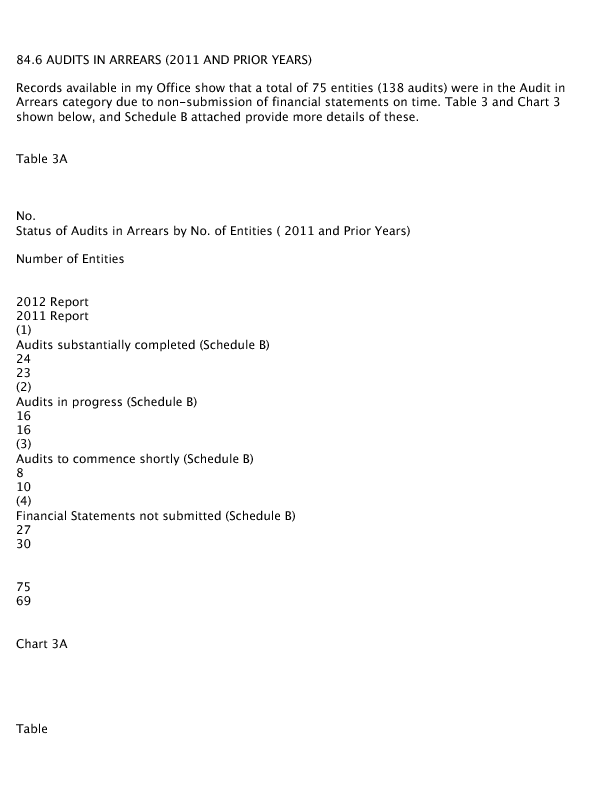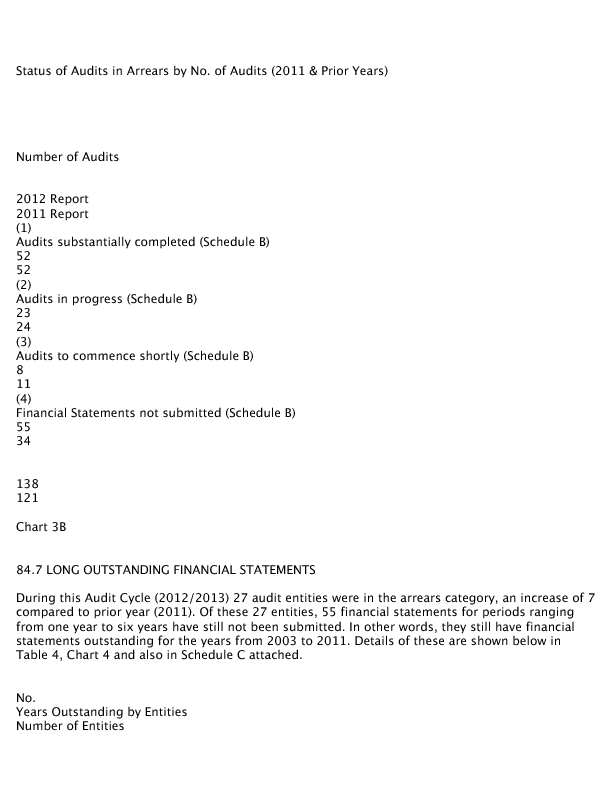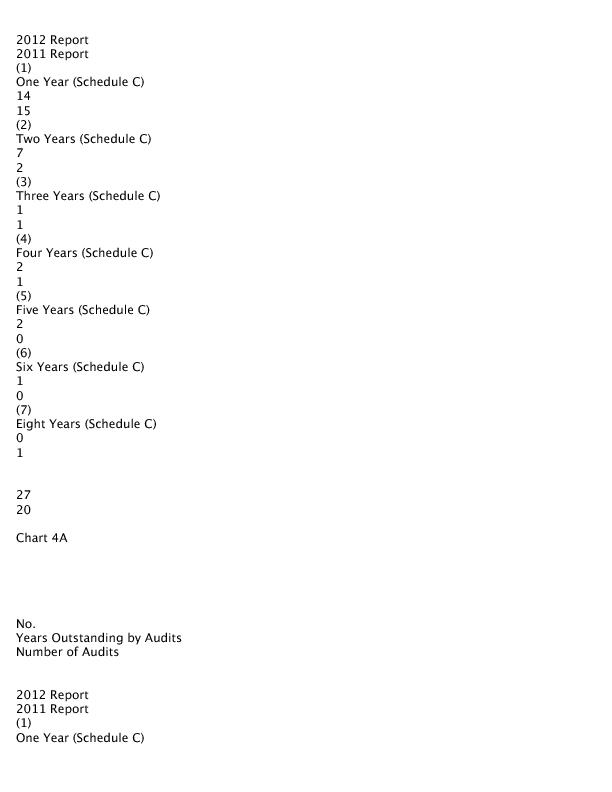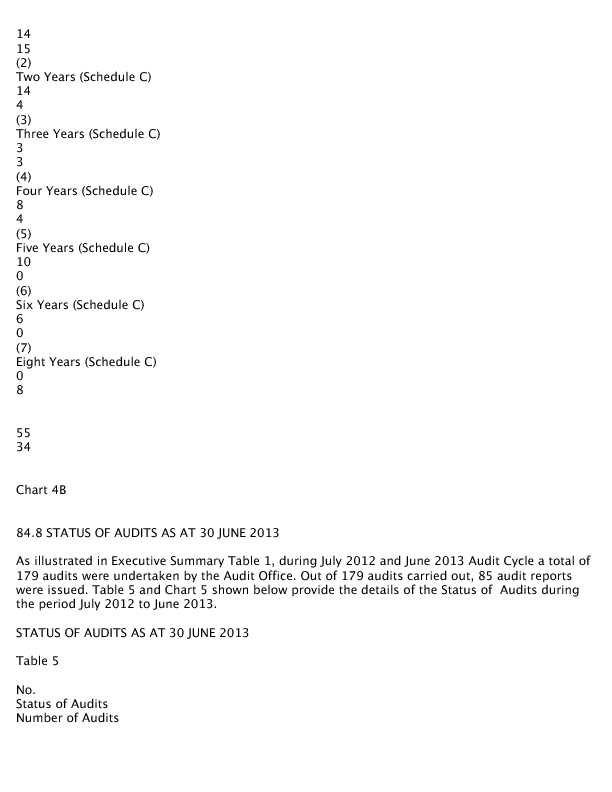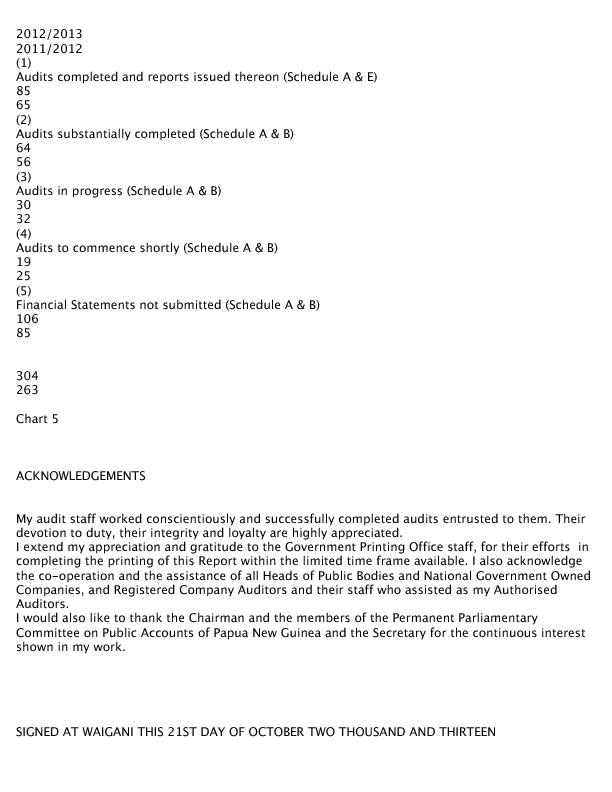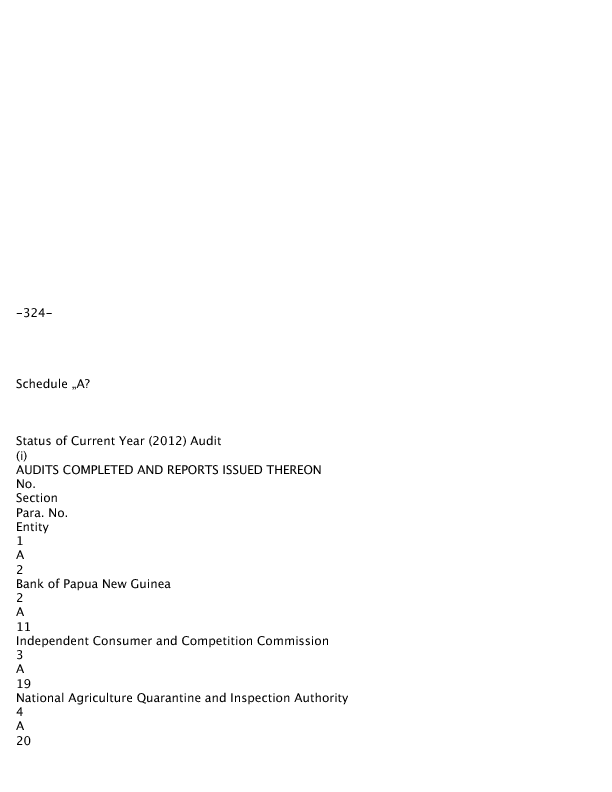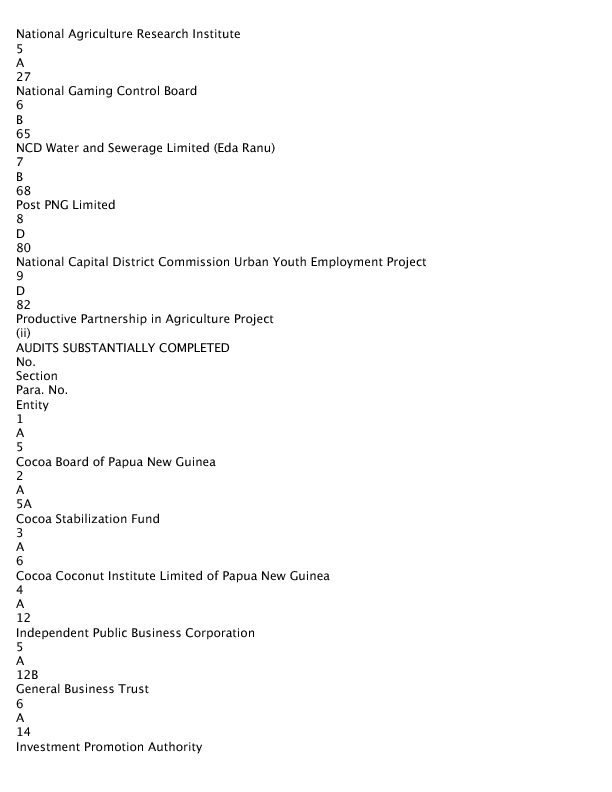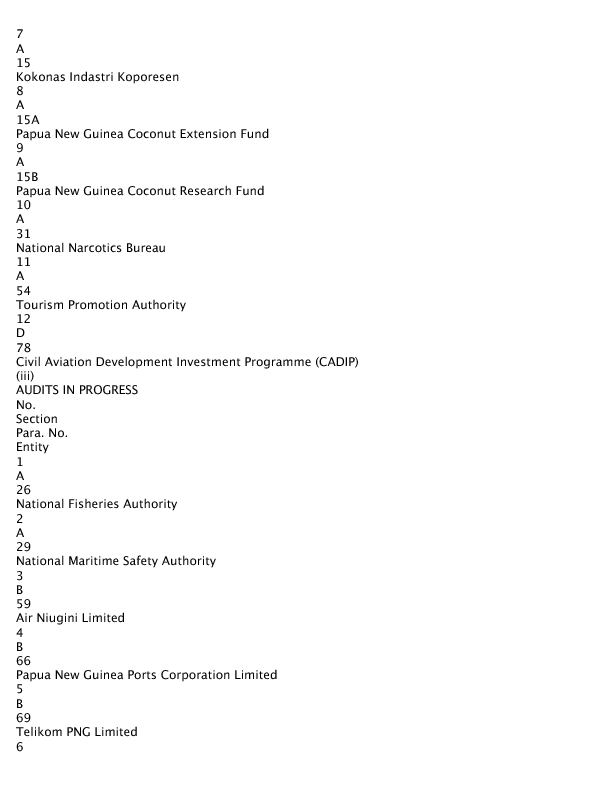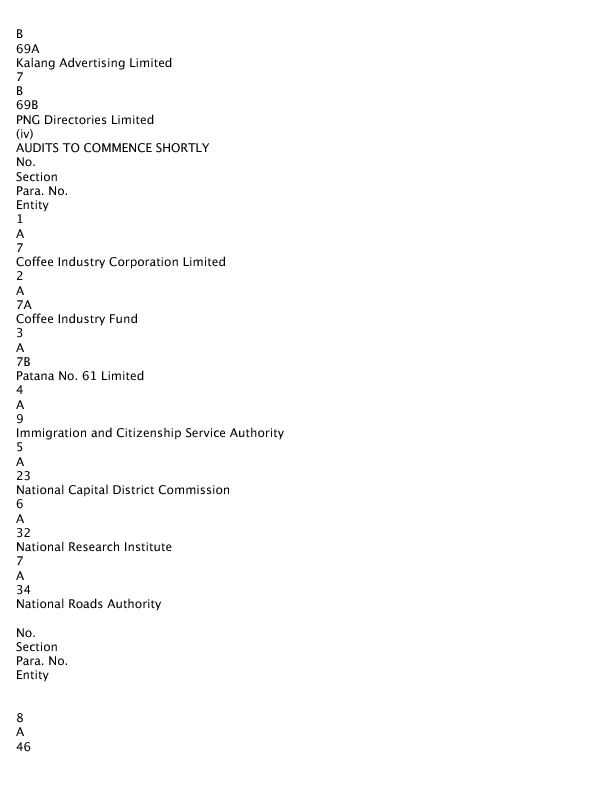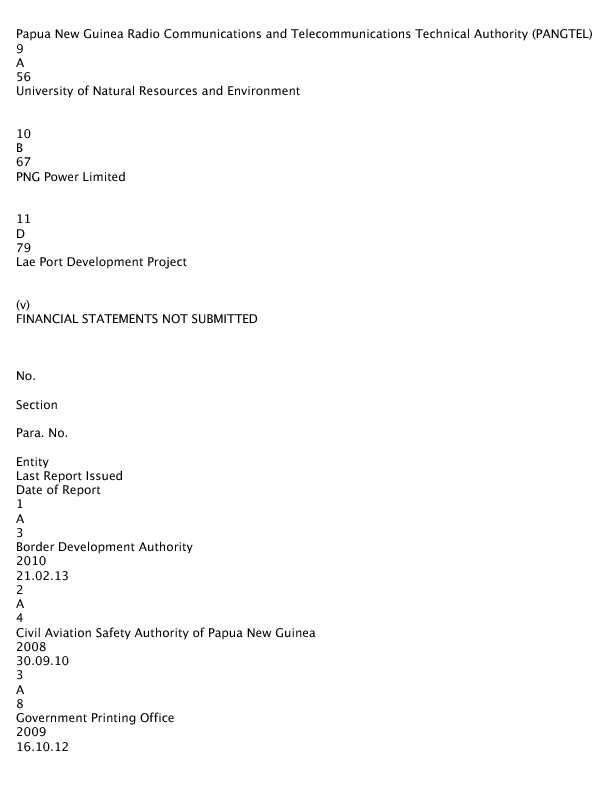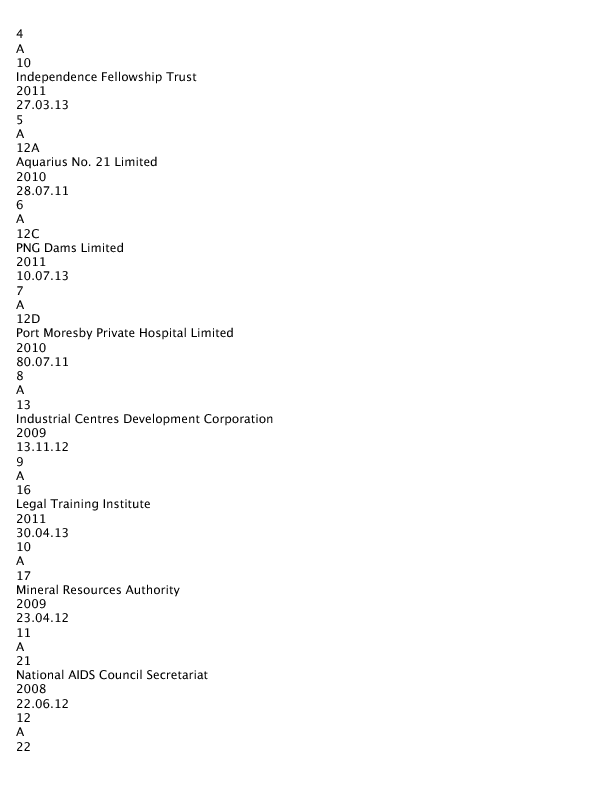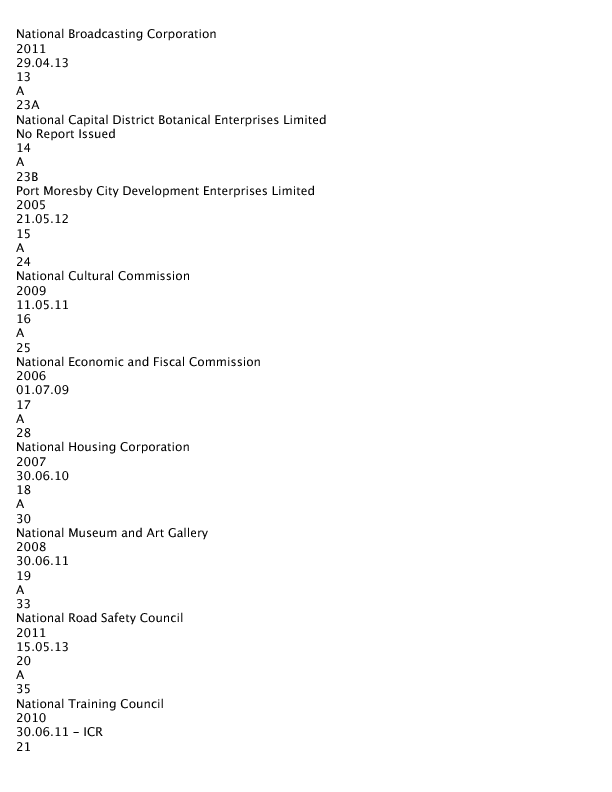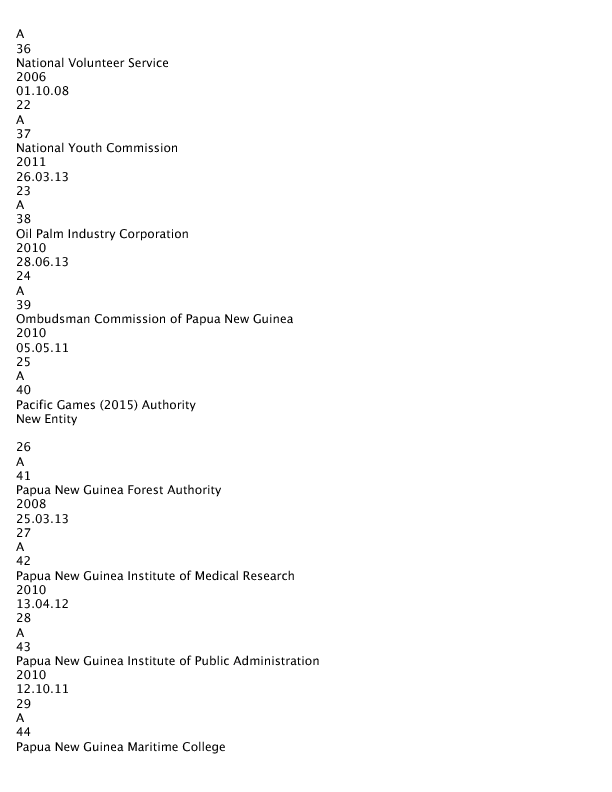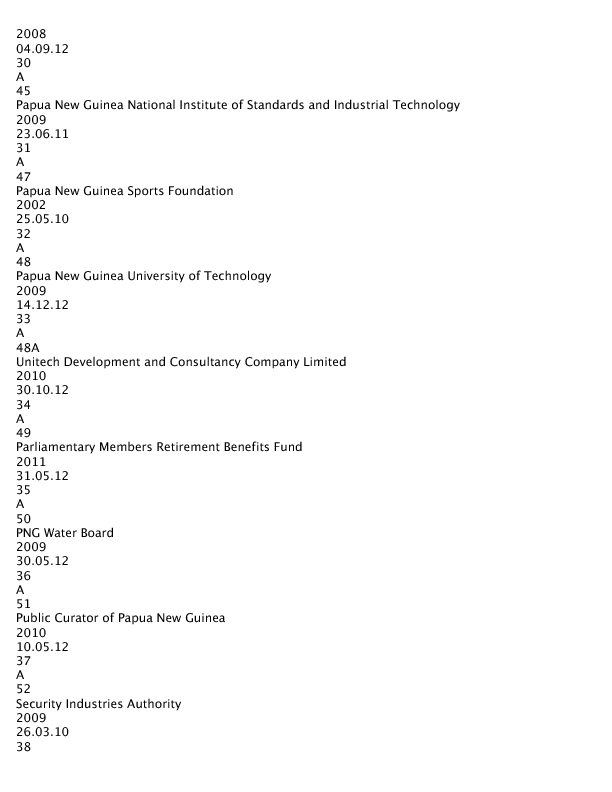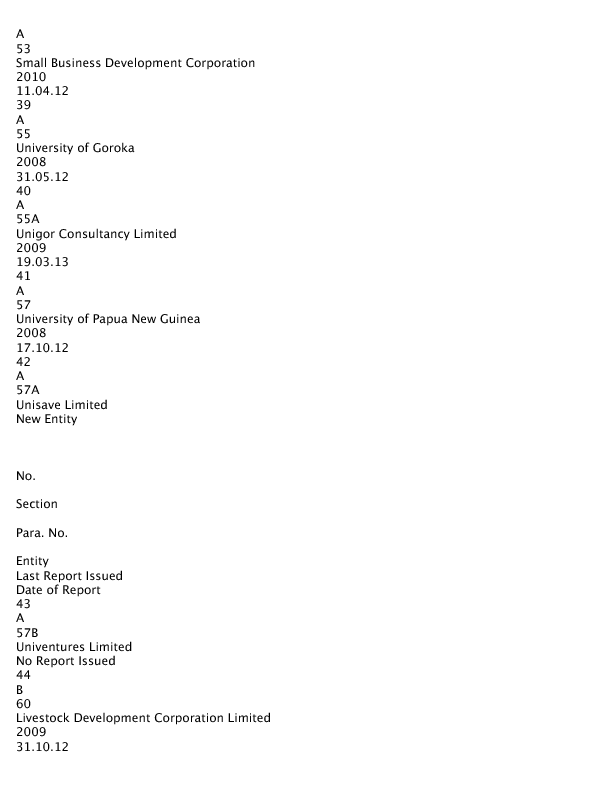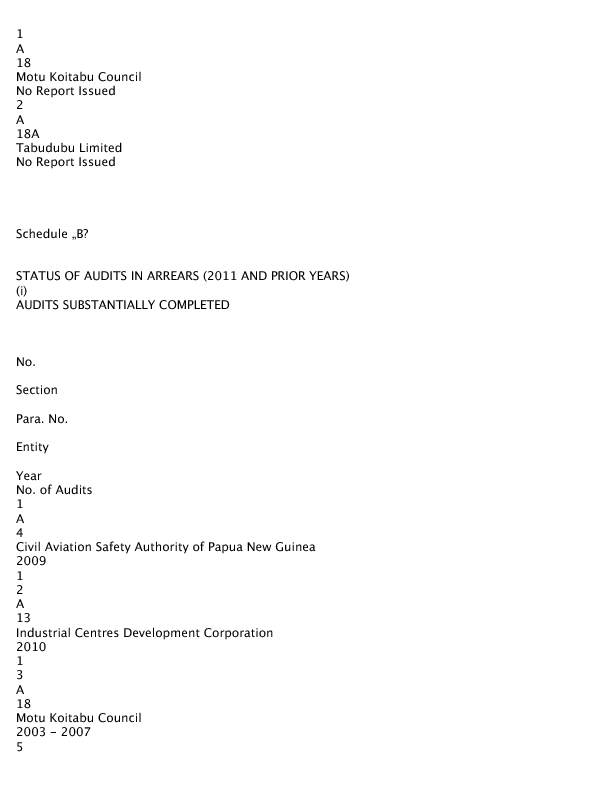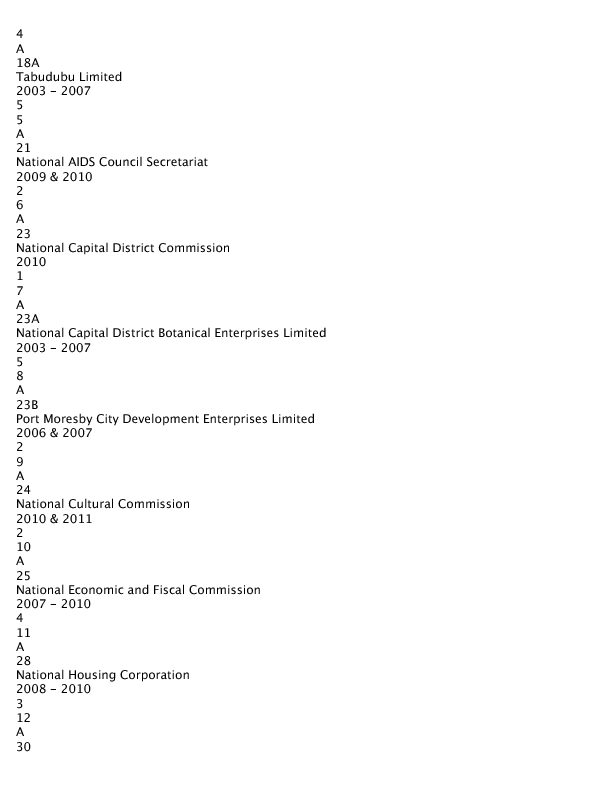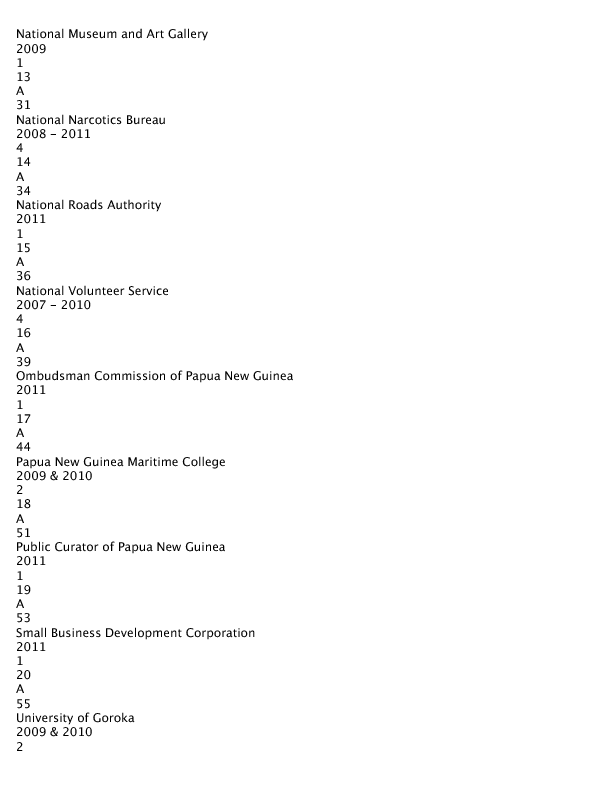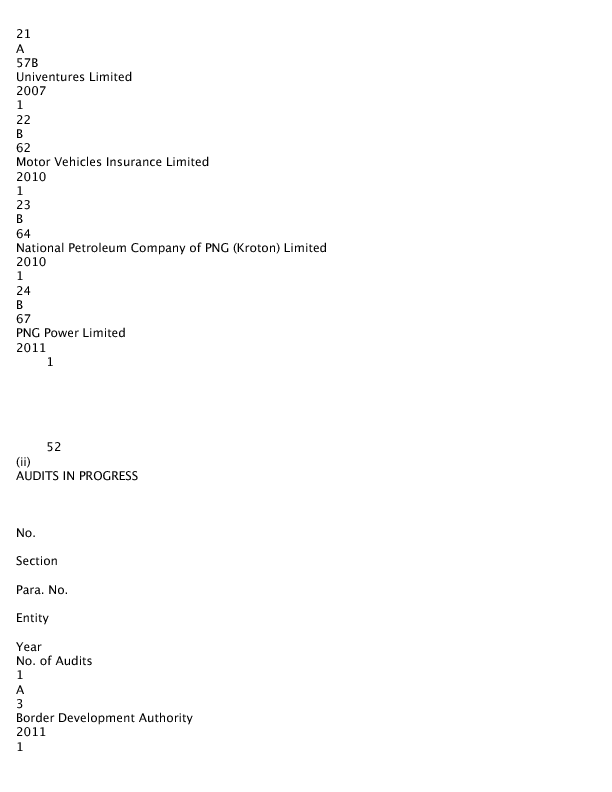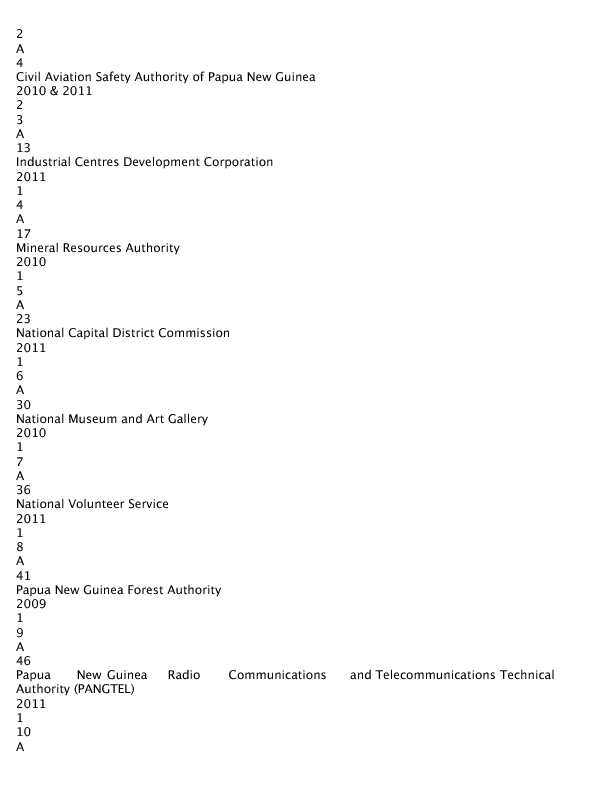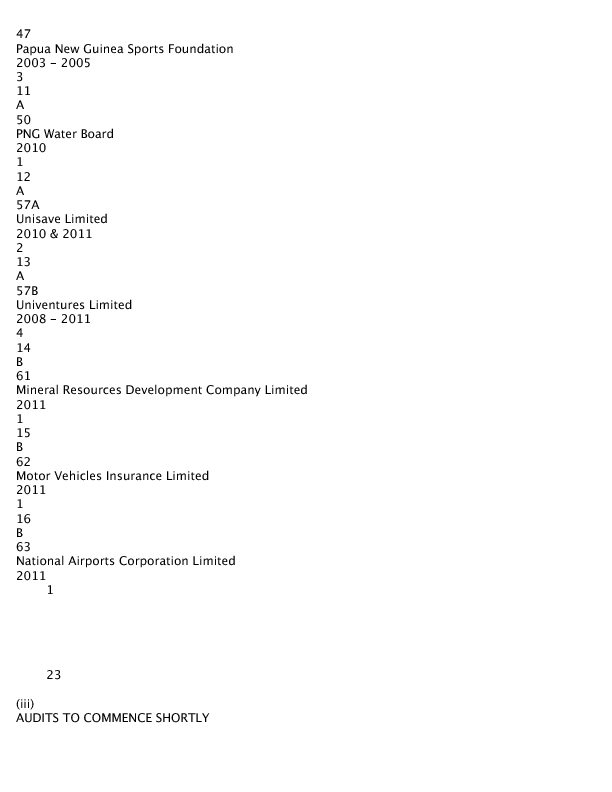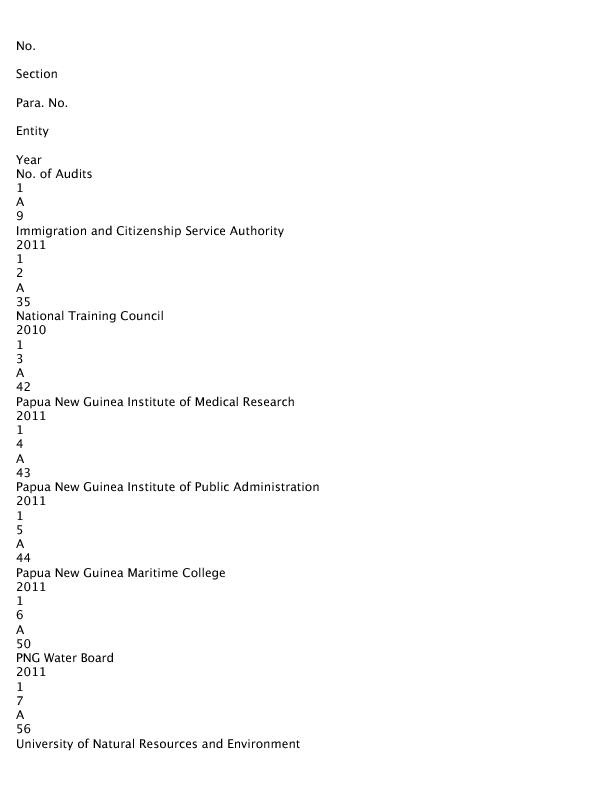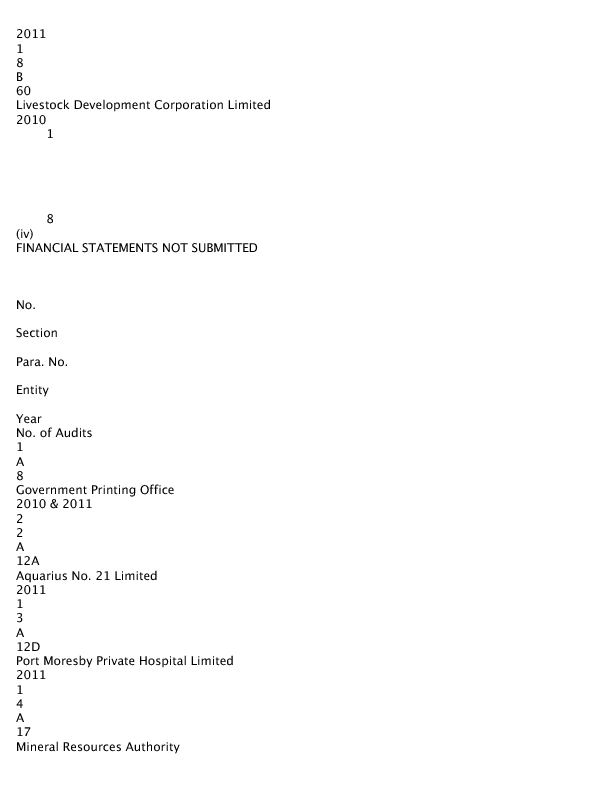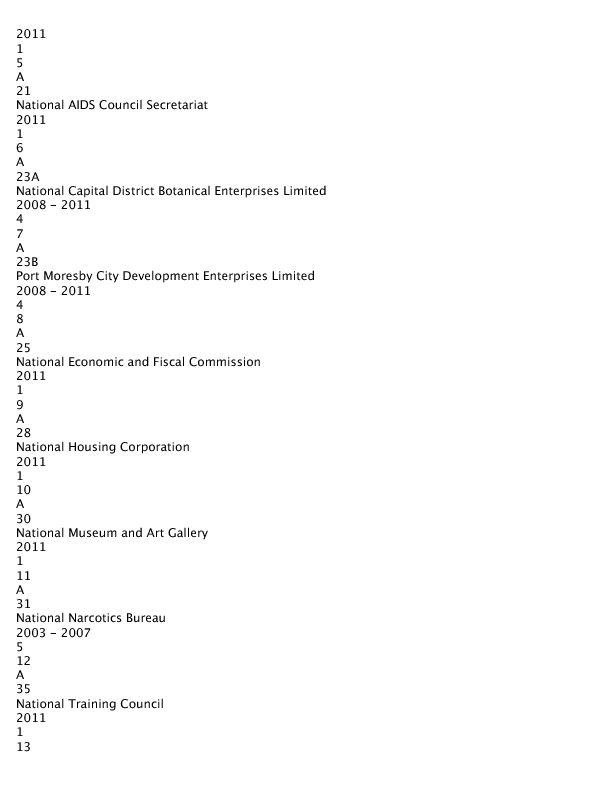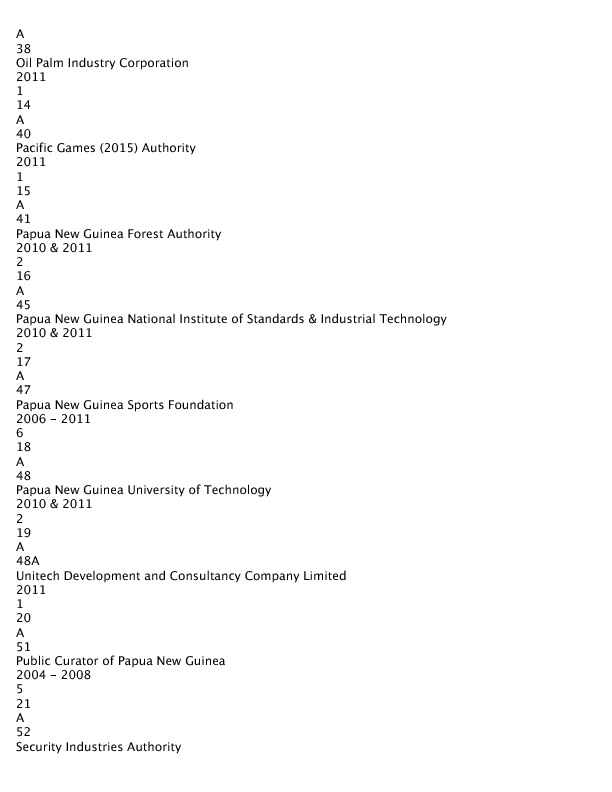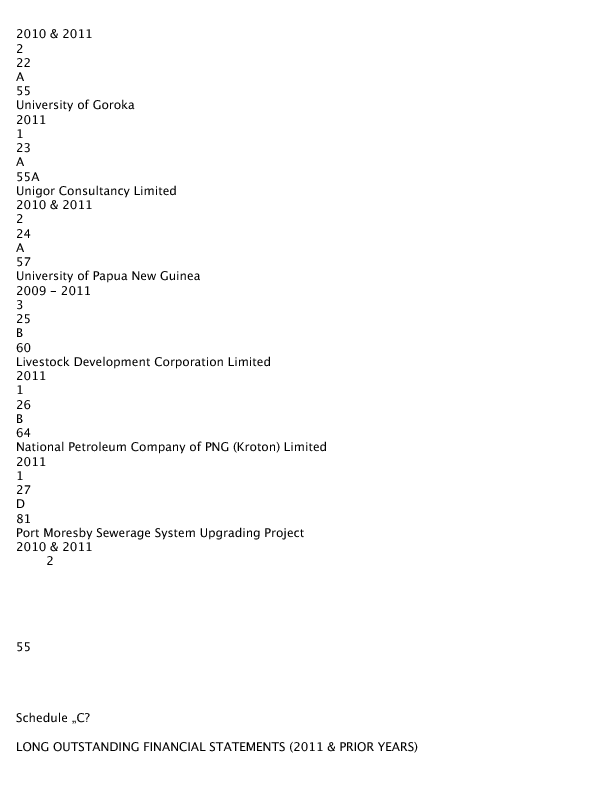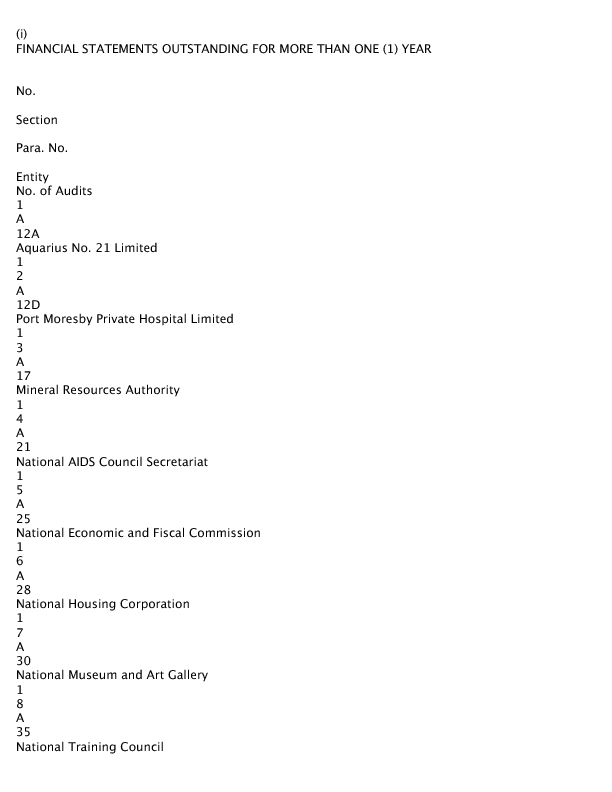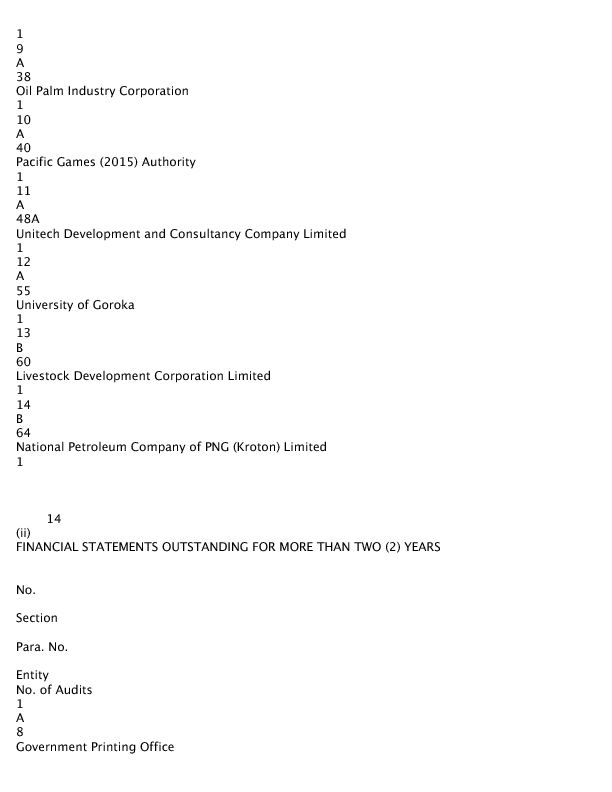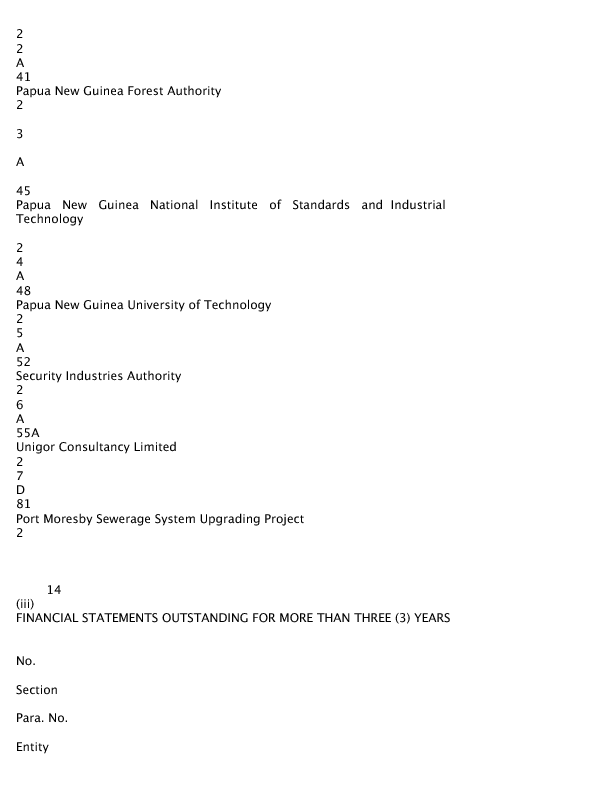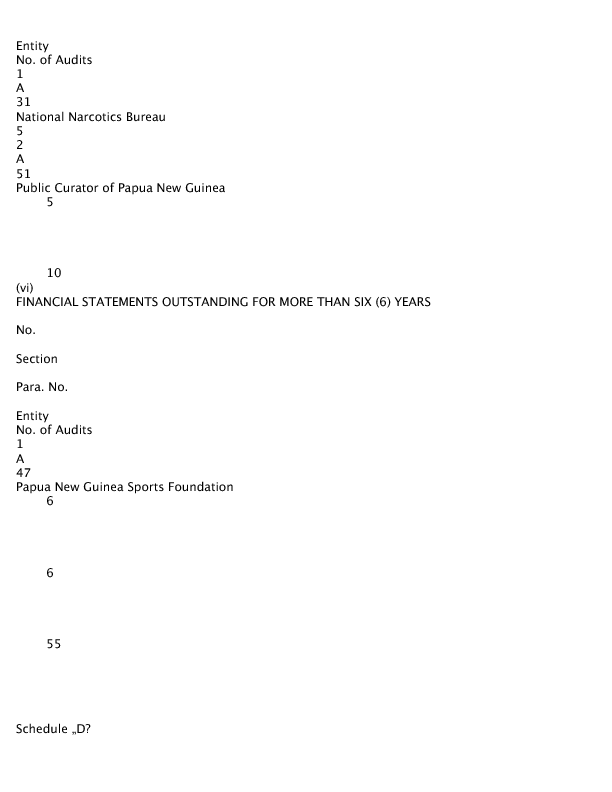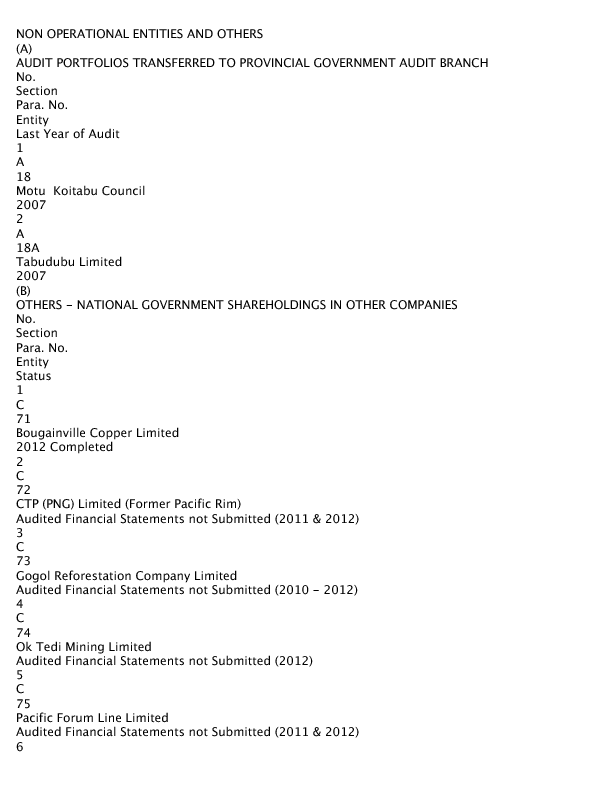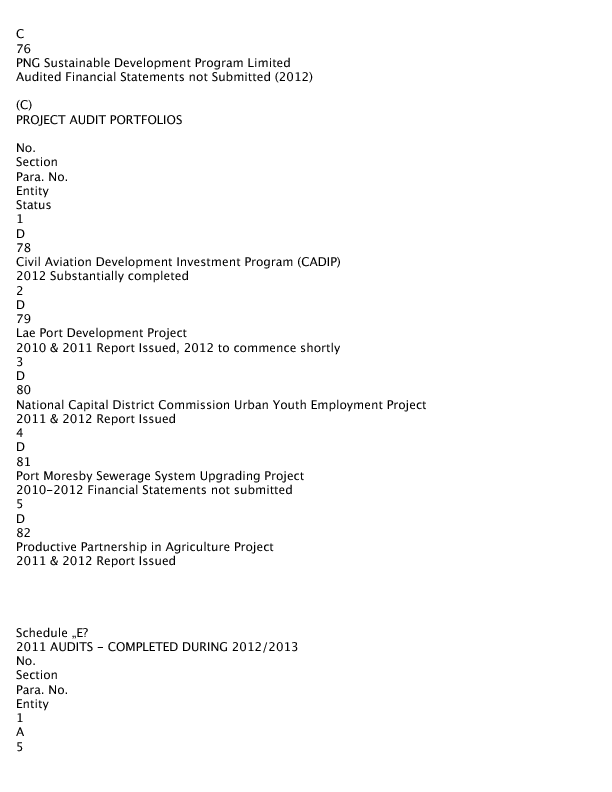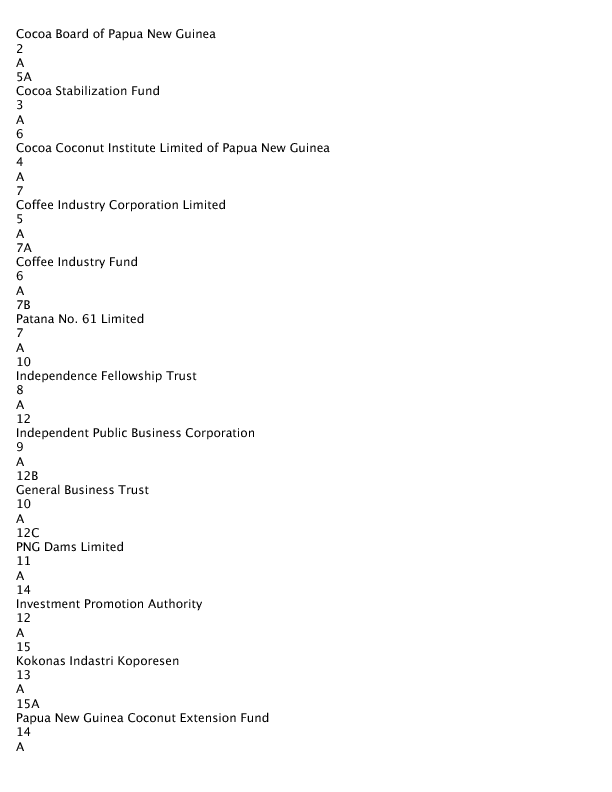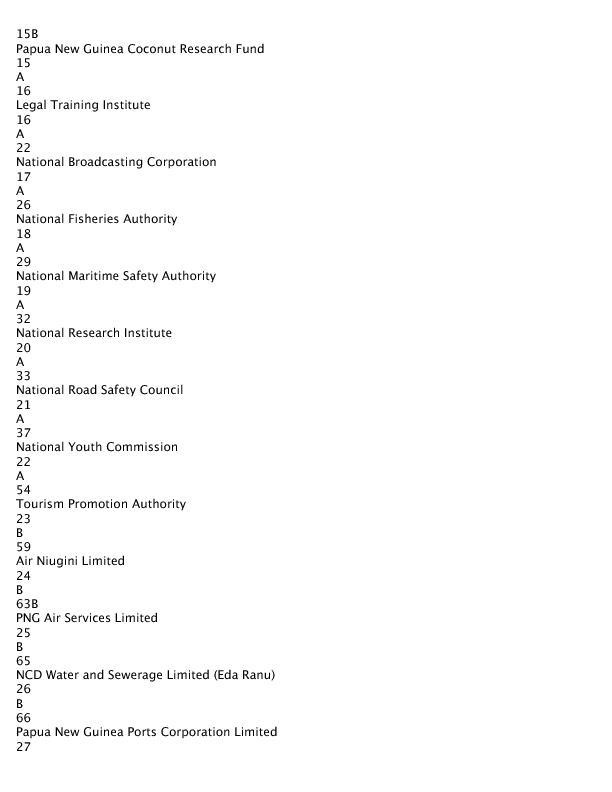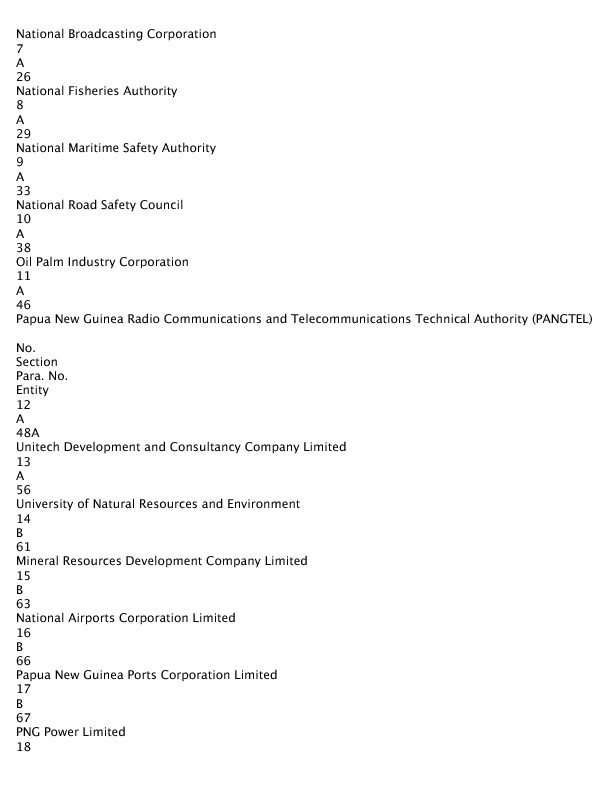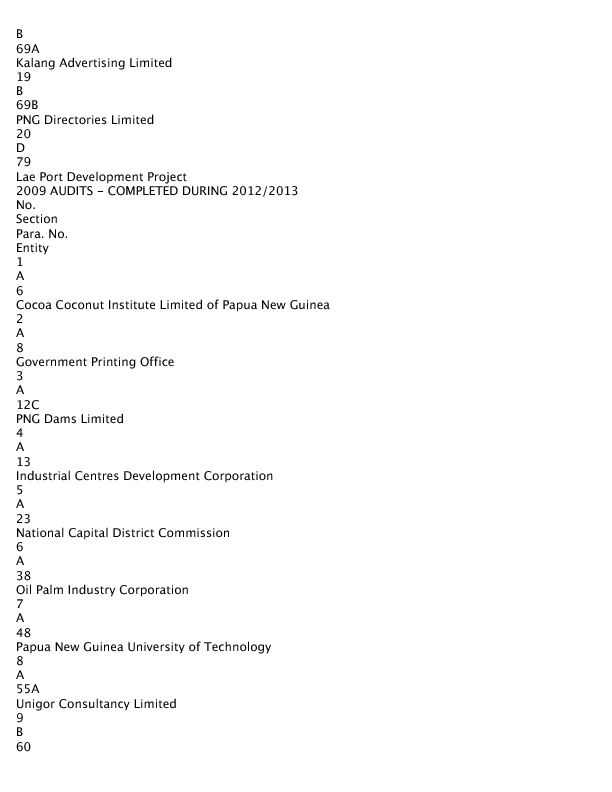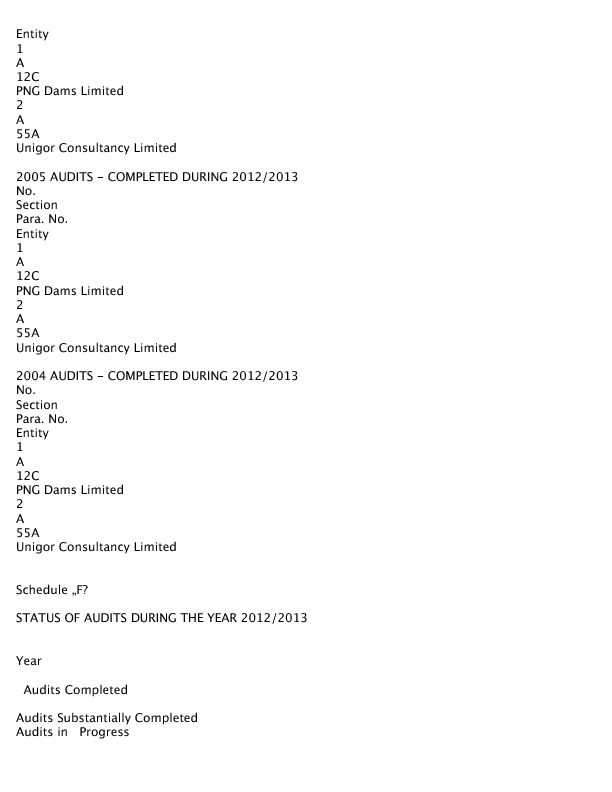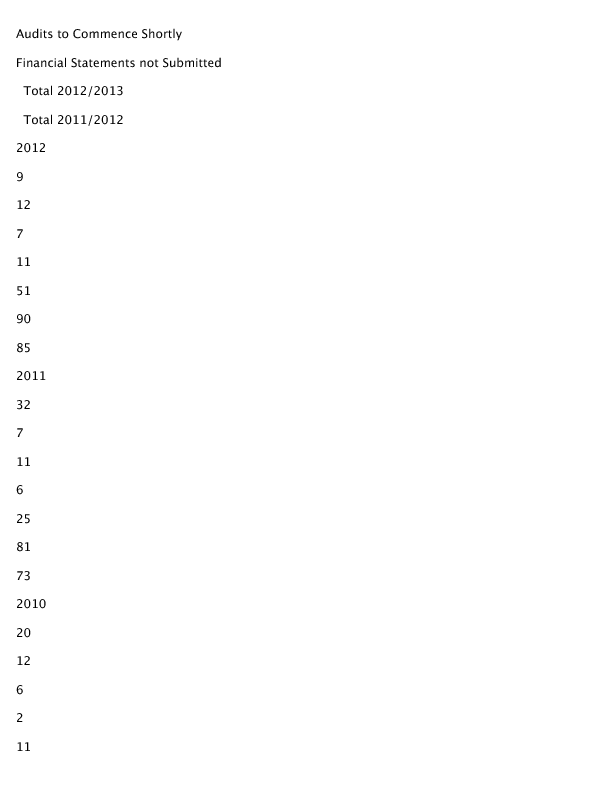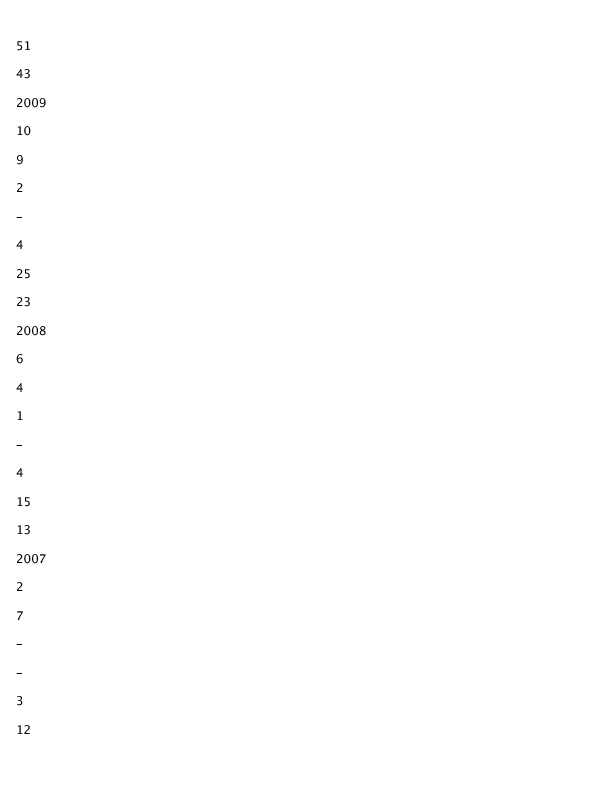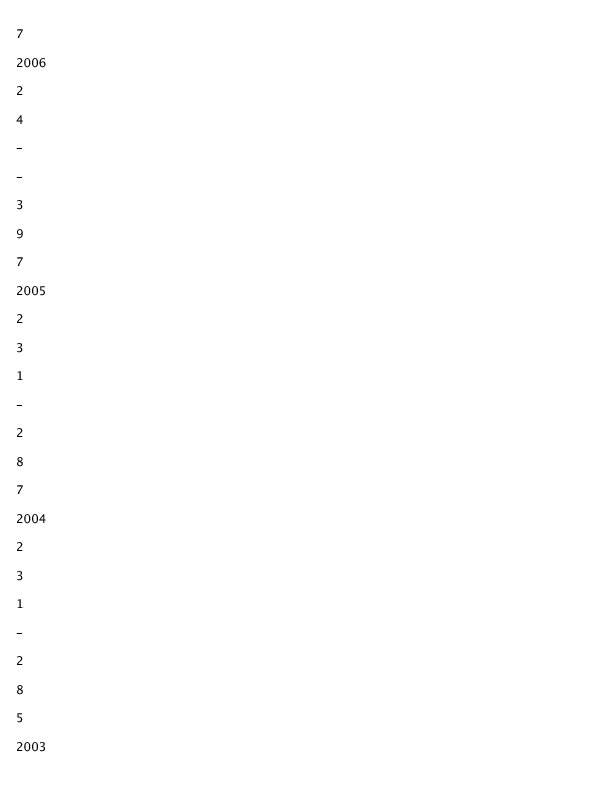Report of the Auditor General Part IV – 2012 – on Accounts of Public Authorities and Statutory Bodies and Government Owned Companies
Mentions of people and company names in this document
It is not suggested or implied that simply because a person, company or other entity is mentioned in the documents in the database that they have broken the law or otherwise acted improperly. Read our full disclaimer
Document content
-
Report of the Auditor-General – 2012 on the Accounts of Public Authorities and Statutory Bodies established under the Act of Parliament and Government Owned Companies established under the Companies Act
Part IV
? Public Bodies and their Subsidiaries ? National Government Owned Companies ? National Government Shareholdings in Other Companies ? Projects
Phone: (+675) 3012200 Fax: (+675) 325 2872 Email: agopng@ago.gov.pg Website: www.ago.gov.pg
21 October, 2013
The Honourable Theodore Zurenuoc, MP The Speaker of National Parliament Parliament House WAIGANI National Capital District
Dear Sir,
In accordance with the provisions of Section 214 of the Constitution of the Independent State of Papua New Guinea, I forward herewith a copy of my report signed on 21 October, 2013 upon the inspection and audit of the financial statements of the Public Bodies and their subsidiaries and National Government owned companies for tabling in the National Parliament. This Report (Part IV) also contains information on companies in which the Government does not hold majority interest. Section E of this Part of the Report contains information on the status of certain entities which have ceased operations and those entities audits of which have been in arrears.
Yours sincerely,
-
Page 2 of 307
-
PHILIP NAUGA Auditor-General
Level 6 PO Box 423 TISA Investment Haus WAIGANI, NCD Kumul Avenue, NCD Papua New Guinea
REPORT OF THE AUDITOR-GENERAL – 2012 PART IV TABLE OF CONTENTS
PARA SUBJECT PAGE NO. NO.
General V A. Foreword V B. Authority to Audit V C. Audit of Public Bodies VII D. Appointment and use of Authorised Auditors VII E. Executive Summary VIII Attachments A – E XVI SECTION A PUBLIC BODIES AND THEIR SUBSIDIARIES PARA SUBJECT PAGE NO. NO. 1. Foreword 1 2. Bank of Papua New Guinea 3 3. Border Development Authority 5 4. Civil Aviation Safety Authority of Papua New Guinea 10 5. Cocoa Board of Papua New Guinea and its Subsidiaries 11 5A. Cocoa Stabilization Fund 14 6. Cocoa Coconut Institute Limited of Papua New Guinea 16 7. Coffee Industry Corporation Limited and its Subsidiaries 22 7A. Coffee Industry Fund 29 7B. Patana No. 61 Limited 31 8. Government Printing Office 34 9. Immigration and Citizenship Service Authority 37 10 Independence Fellowship Trust 40 11. Independent Consumer and Competition Commission 41 12 Independent Public Business Corporation and its Subsidiaries 43 12A. Aquarius No. 21 Limited 55 12B. General Business Trust 56 12C. PNG Dams Limited 62 12D. Port Moresby Private Hospital Limited 66 13. Industrial Centres Development Corporation 67 14. Investment Promotion Authority 70 -i-
-
Page 3 of 307
-
15. Kokonas Indastri Koporesen and its Subsidiaries 72 15A. Papua New Guinea Coconut Extension Fund 73 15B. Papua New Guinea Coconut Research Fund 74 16. Legal Training Institute 75 17. Mineral Resources Authority 83 18. Motu Koitabu Council and its Subsidiary 85 18A. Tabudubu Limited 86 19. National Agriculture Quarantine and Inspection Authority 87 20. National Agriculture Research Institute 90 21. National AIDS Council Secretariat 92 22. National Broadcasting Corporation 94 23. National Capital District Commission and its Subsidiaries 98 23A. National Capital District Botanical Enterprises Limited 104 23B. Port Moresby City Development Enterprises Limited 105 24. National Cultural Commission 106 25. National Economic and Fiscal Commission 107 26. National Fisheries Authority 109 27. National Gaming Control Board 112 28. National Housing Corporation 117 29. National Maritime Safety Authority 118 30. National Museum and Art Gallery 121 31. National Narcotics Bureau 122 32. National Research Institute 123 33. National Road Safety Council 125 34. National Roads Authority 127 35. National Training Council 130 36. National Volunteer Service 131 37. National Youth Commission 132 38. Oil Palm Industry Corporation 134 39. Ombudsman Commission of Papua New Guinea 138 40. Pacific Games (2015) Authority 139 41. Papua New Guinea Forest Authority 140 42. Papua New Guinea Institute of Medical Research 145 43. Papua New Guinea Institute of Public Administration 146 44. Papua New Guinea Maritime College 147 45. Papua New Guinea National Institute of Standards and Industrial Technology 150 46. Papua New Guinea Radio Communications & Telecommunications Technical Authority (PANGTEL) 151 47. Papua New Guinea Sports Foundation 155 48. Papua New Guinea University of Technology and its Subsidiary 157 48A. Unitech Development and Consultancy Company Limited 161 49. Parliamentary Members’ Retirement Benefits Fund 165 50. PNG Waterboard 166 51. Public Curator of Papua New Guinea 167 52. Security Industries Authority 168 53. Small Business Development Corporation 169 54. Tourism Promotion Authority 170 55. University of Goroka and its Subsidiary 172 55A. Unigor Consultancy Limited 174 56. University of Natural Resources and Environment 179 57. University of Papua New Guinea and its Subsidiary 182
-
Page 4 of 307
-
57A. Unisave Limited 221 57B. Univentures Limited 222 SECTION B – NATIONAL GOVERNMENT OWNED COMPANIES PARA SUBJECT PAGE NO. NO. 58. Foreword 225 59. Air Niugini Limited 227 60 Livestock Development Corporation Limited 230 61. Mineral Resources Development Company Limited 234 62. Motor Vehicles Insurance Limited 241 63. National Airports Corporation Limited and its Subsidiaries 244 63A. Airport City Development Limited 249 63B. PNG Air Services Limited 250 64. National Petroleum Company of PNG (Kroton) Limited 252 65. NCD Water and Sewerage Limited (Eda Ranu) 253 66. Papua New Guinea Ports Corporation Limited 255 67. PNG Power Limited 258 68. Post PNG Limited 274 69. Telikom PNG Limited and its Subsidiaries 277 69A. Kalang Advertising Limited 280 69B. PNG Directories Limited 282 SECTION C – NATIONAL GOVERNMENT SHAREHOLDINGS IN OTHER COMPANIES PARA SUBJECT PAGE NO. NO. 70. Foreword 285 71. Bougainville Copper Limited 287 72. CTP (PNG) Limited 289 73. Gogol Reforestation Company Limited 290 74. Ok Tedi Mining Limited 291 75. Pacific Forum Line Limited 292 76. PNG Sustainable Development Program Limited 293 SECTION D – PROJECTS PARA SUBJECT PAGE NO. NO. 77. Foreword 297 78. Civil Aviation Development Investment Program (CADIP) 299 79. Lae Port Development Project 300 80. National Capital District Commission Urban Youth Employment Project 302 81. Port Moresby Sewerage System Upgrading Project (POMSSUP) 303 82. Productive Partnership in Agriculture Project 304 SECTION E – PROBLEM AUDITS PARA SUBJECT PAGE NO. NO. 83. Foreword 309 83.1 Exclusion of Entities from Future Reports 309 84. Audits in Arrears 310 84.1 General 310 84.2 Responsibility for preparation of Financial Statements 310 84.3 Legislative Requirements 311 84.4 Current Year Audits (2012 Audits) 311 84.5 Status of Current Year Audits 313 84.6 Audits in Arrears (2011 and prior years) 315 84.7 Long Outstanding Financial Statements 318 84.8 Status of Audits as at 30 June 2013 321 Acknowledgements 323
-
Page 5 of 307
-
Schedule A – Current Year Audits 325 Schedule B – Status of Audits in Arrears 328 Schedule C – Long Outstanding Financial Statements 330 Schedule D – Non-Operational Entities and Others 332 Schedule E – Prior year Audits completed during 2012/2013 333 Schedule F – Status of Audits during the year 2012/2013 336
GENERAL
A. FOREWORD
My Annual Report to the National Parliament for the 2012 financial year is presented in four Parts. Part I deals with the Public Accounts of Papua New Guinea. Part II deals with National Government Departments and the Provincial Treasury Offices, whilst Part III deals with the audit of the Provincial Governments and Local-Level Governments.
Part IV (this Part) of my Report deals with Public Bodies and their Subsidiaries, Government Owned Companies and National Government?s shareholdings in Other Companies. This Report is divided into five sections. Section A deals with Public Bodies and their subsidiaries, Section B deals with National Government owned companies, Section C deals with Companies in which the National Government has shareholdings and Section D deals with Projects implemented by the Entities. Section E is an additional section which provides details of entities that have ceased operating and those other entities the audits of which have been in arrears due to non-submission of financial statements.
The audit findings contained in Sections A, B and D of this Report have been reported to the management of the respective entities and to the responsible Ministers.
B. AUTHORITY TO AUDIT
B.1 Constitution
Under Section 214(2) of the Constitution of the Independent State of Papua New Guinea, I am required to inspect and audit all bodies set up by Acts of the Parliament, or by Executive or Administrative Act of the National Executive for governmental or official purposes unless other provisions are made by law in respect of their inspection and audit.
I am also empowered under Section 214(3), if I consider it proper to do so, to inspect and audit and report to the Parliament on any accounts, finances or property of a body, insofar as they relate to, or consist of, or are derived from public moneys or property of Papua New Guinea.
B.2 Audit Act
By virtue of Section 214(4) of the Constitution, the Audit Act, 1989, which became effective from 1 May, 1989, provides more details of my functions under sub-sections (1), (2) and (3) of the Constitution. The Audit Act that was derived from the Constitution elaborates the functions and the duties of the Auditor-General. This Act was amended in 1995, and the relevant provisions of the amended Act are explained below.
-
Page 6 of 307
-
B.3 Auditing and Reporting Requirements
In Section 8, sub-sections 2 and 4 of the Act were amended to include provisions governing the auditing and the reporting requirements of public bodies including government owned companies incorporated under the Companies Act, 1997.
B.4 Matters of Significant Importance
Under Section 8(2) of the Act, I am required to inspect and audit the accounts and records of financial transactions and the records relating to the assets and liabilities of these public bodies and their subsidiaries, and to report to the Minister vested with the responsibility for the public body and the Minister in charge of Finance any irregularities found during the inspection and audit.
B.5 Audit Opinion on Financial Statements
Section 8(4) of the Act requires me to audit the financial statements of the public bodies and to report an opinion to the aforementioned Ministers on:
(i) whether the financial statements are based on proper accounts and records; (ii) whether the financial statements are in agreement with those accounts and records; and (iii) whether they show fairly the financial operations for the period which they cover and the state of affairs at the end of that period.
B.6 Public Finances (Management) Act, 1995
The submission of the financial statements of the public bodies for audit is required under Section 63(4) of the Public Finances (Management) Act, 1995.
The section requires each public body to prepare and furnish to its Minister before 30 June each year, a report on its operations for the year ended on 31 December preceding, together with financial statements in respect of that year duly audited by me.
The Minister is then required to table the report on the operations and the financial statements, together with my report on the financial statements, at the first meeting of the Parliament after receiving them.
B.7 Companies Act, 1997
I am required to audit National Government owned companies and subsidiary companies under the provisions of the Companies Act, 1997.
Though these companies are registered under the Companies Act, my responsibility to audit them is by virtue of Sections 48 and 63 of the Public Finances (Management) Act and Section 3 of the Audit Act.
C. AUDIT OF PUBLIC BODIES
C.1 Scope of Audit
-
Page 7 of 307
-
The full scope of my audit responsibility in respect of Public Bodies covers the Statutory Bodies and their subsidiaries, National Government owned companies and their subsidiaries, and the companies in which the government has minority interest.
C.2 Audit Objectives
Under the Companies Act, I am required to ascertain whether proper accounting records have been kept; whether the financial statements comply with generally accepted accounting practice; and whether those financial statements give a true and fair view of the matters to which they relate. The Act also requires the auditor to report the instances of non-compliance with these requirements. More details on the audit responsibilities under the Companies Act are provided in paragraph 58 of this Report which covers the National Government owned companies.
C.3 Reporting Framework
My audits are conducted in accordance with relevant Auditing Standards to provide reasonable assurance that the financial statements are free of material misstatements. The audit procedures include examination, on a test basis, of evidence supporting the amounts and other disclosures in the financial statements, evaluation of accounting policies and significant accounting estimates, and ensuring that the financial statements are presented fairly and in accordance with International Accounting Standards and the Statutory requirements.
D. APPOINTMENT AND USE OF AUTHORISED AUDITORS
Section 8(5) of the Audit Act, 1989 (as amended), empowers me to employ registered company auditors to assist me in undertaking my constitutional duties, where such assistance is required.
During the period covered in the Report, I engaged a number of registered company auditors to perform audits of numerous Statutory Bodies and National Government owned companies.
2012 AUDITOR-GENERAL?S REPORT – PART IV
E. EXECUTIVE SUMMARY
E.1 Report Coverage
This Report covers the audit reports issued by my Office on the audits of Public Bodies and their Subsidiaries, Government Owned Companies, Project audits and National Government?s shareholdings in Other Companies during the period July 2012 to June 2013 (2012/2013 Audit Cycle). The Report covers the audits of these entities? financial statements for a number of years, not just 2012.
In 2012 there were 85 public entities subject to audit by my Office, consisting of 70 Public Bodies and their Subsidiaries and 15 National Government Owned Companies. In addition, I have also carried out audits on 5 Projects managed by Public entities as implementing agencies.
I am also responsible for reporting on the audits of 6 Companies, in which the National Government has a minority shareholding, that are audited by the private sector. These are reported under Section C of this Report.
-
Page 8 of 307
-
E.2 Consistency in audit findings over a number of years
The Report?s findings are consistent with those in my previous years? reports that have highlighted my concerns over the number of entities that do not submit current year financial statements for audit, and the poor state of the financial management structure in most public entities whose statements are subject to my audit and inspection.
E.3 Submission of current year Financial Statements
Section 63(4) of the Public Finances (Management) Act, 1995 requires a „… public body to prepare and furnish to its Minister before 30 June each year, a performance and management report of its operations for the year ended 31 December preceding, together with financial statements to enable the Minister to present such report and statements to the Parliament …? Before submitting the financial statements to the Minister, Section 63(4) requires a public body to submit the financial statements to the Auditor-General and for the Auditor-General to report to the Minister in accordance with Part II of the Audit Act, 1989 (as amended).
Despite these legislative requirements, 51 entities had not submitted their 2012 financial statements to be audited and overall some 55 financial statements for 2011 and prior years had not been submitted for audit (Refer Table 1).
The details of the audits in arrears and those entities whose financial statements have been outstanding for a number of years are shown in Attachment „B?.
Table 1
STATUS OF AUDITS DURING THE YEAR 2012 (END OF 2012/2013 CYCLE)
Year
Audits Completed
Audits Substantially Completed
Audits in Progress
Audits to Commence Shortly Financial Statements not Submitted
Total 2012/2013
Total 2011/2012 2012 9 12 7 11
-
Page 9 of 307
-
51 90 85 2011 32 7 11 6 25 81 73 2010 20 12 6 2 11 51 43 2009 10 9 2 – 4 25 23 2008 6 4 1 – 4 15 13 2007 2 7 – – 3 12 7 2006 2 4 – – 3 9 7
-
Page 10 of 307
-
2005 2 3 1 – 2 8 7 2004 2 3 1 – 2 8 5 2003 – 3 1 – 1 5 – Total 85 64 30 19 106 304 263
Table 1 also shows that 179 audits were completed, substantially completed or still in progress as at 30 June, 2013. The details are graphically depicted in Attachment „C?, which also included the arrears of prior years. Table 1 also shows that of the 85 audits completed, only 9 were for the current year (2012), with 19 current year audits substantially completed or were in progress. A further 11 audits were to commence shortly. Graphical description of status of current year (2012) audits (excluding arrears) is given in Attachment „A?. The list of entities is at Schedule „A? (i), (ii), (iii) and (iv).
E.4 Type of Audit Opinions Issued1
In the period covered by the audit, 85 audit opinions were issued. Of the 85 audit opinions issued, 20 were unqualified, 34 were qualified, 30 were Disclaimer Opinions and 1 Adverse Opinion.
-
Page 11 of 307
-
1 The types of audit opinions are: Unqualified Opinion – A Company’s financial statements are presented fairly, in all material respects in conformity with generally accepted accounting principles. Qualified Opinion – The financial statements “except for” certain issues fairly present the financial position and operating results of the firm. The except for opinion relates to inability of the auditor to obtain sufficient objective and verifiable evidence in support of business transactions of the Company being audited. Disclaimer Opinion – When insufficient competent evidential matter exists to form an audit opinion due to scope limitation or uncertainties. Adverse Opinion – The Company’s financial statements do not present fairly the financial position, results of operations, or changes in financial position or are not in conformity with generally accepted accounting principles.
Of the 20 unqualified opinions issued, 15 related to prior years and only 5 were for 2012 as follows:
(i) Bank of Papua New Guinea; (ii) Post (PNG) Limited; (iii) Productive Partnership in Agriculture Project; (iv) National Agriculture Research Institute; and (v) NCDC Urban Youth Employment Project.
Four of the qualified opinions related to 2012 and others were for prior years. The high numbers of Disclaimer Audit Opinions issued are reflection of the poor state of accounting record keeping in a number of public bodies.
The list of entities and the type of audit opinions issued during the period July 2012 to June 2013 are provided in Attachment „D?.
E.5 Key Findings
The key findings from the audits centered on the non-submission of the financial statements, non-compliance with the Salaries and Conditions Monitoring Committee (SCMC) regulatory mechanisms for salaries and wages, lack of basic accounting records and ineffective internal control systems. These issues are highlighted in the paragraphs below.
E.6 Non-Submission of Financial Statements
As stated earlier, Section 63(4) of the Public Finances (Management) Act, 1995, requires each public body to prepare and furnish to its Minister before 30 June each year, a report on its operations for the year ended 31 December preceding together with financial statements in respect of that year duly audited by me for tabling in Parliament.
This legislative requirement has not been strictly adhered to by all respective public entities? management. To comply with this requirement, the financial statements are required to be submitted to my Office well before 30 June each year for my audit and inspection. Consequently, out of 85 public entities and 5 Projects only 39 (35 entities and 4 projects) have submitted their financial statements for 2012 (Refer Schedule A (i), (ii), (iii) and (iv) for my audit and inspection up to the time of preparing this Report. A total of 51 (50 entities and 1 project) failed to comply with these provisions (Refer Schedule A(v)).
-
Page 12 of 307
-
The non-compliance of the public entities mentioned above has resulted in:
(i) My Office not being able to report adequately on the accountability of the use of public resources in a timely manner;
(ii) A build up of audits in arrears; and
(iii) The non-tabling of Annual Reports on performance and management by public entities in the Parliament.
Responsibility for Submission of Financial Statements
An entity?s management is responsible for preparing and presenting financial statements for my audit and inspection. It is also the responsibility of management to ensure that an adequate and effective internal control system is maintained to ensure that complete and accurate financial statements are produced on a timely basis.
My Office recommends
(iv) A vigorous enforcement of the provisions of Section 63 of the Public Finances (Management) Act; and
(v) A legislative requirement to make the renewal of contracts of Chief Executive Officers subject to submission of financial statements and prudent financial management.
These recommendations are to help achieve financial management accountability and good governance in the public sector.
Details of audits that have gone into arrears due to non-submission of financial statements from 2011 or earlier are given below in Table 2 and Schedule „C?.
Table 2
Financial Statements not Submitted
No. Section Para. No. Entity Year No. of Audits 1 A 8 Government Printing Office 2010 & 2011 2
-
Page 13 of 307
-
2 A 12A Aquarius No. 21 Limited 2011 1 3 A 12D Port Moresby Private Hospital Limited 2011 1 4 A 17 Mineral Resources Authority 2011 1 5 A 21 National AIDS Council Secretariat 2011 1 6 A 23A National Capital District Botanical Enterprises Limited 2008 – 2011 4
No. Section Para. No. Entity Year No. of Audits 7 A 23B Port Moresby City Development Enterprises Limited 2008 – 2011 4 8 A 25 National Economic and Fiscal Commission 2011 1 9
-
Page 14 of 307
-
A 28 National Housing Corporation 2011 1 10 A 30 National Museum and Art Gallery 2011 1 11 A 31 National Narcotics Bureau 2003 – 2007 5 12 A 35 National Training Council 2011 1 13 A 38 Oil Palm Industry Corporation 2011 1 14 A 40 Pacific Games (2015) Authority 2011 1 15 A 41 Papua New Guinea Forest Authority 2010 & 2011 2 16 A 45 Papua New Guinea National Institute of Standards & Industrial Technology 2010 & 2011 2 17 A 47 Papua New Guinea Sports Foundation
-
Page 15 of 307
-
2006 – 2011 6 18 A 48 Papua New Guinea University of Technology 2010 & 2011 2 19 A 48A Unitech Development and Consultancy Company Limited 2011 1 20 A 51 Public Curator of Papua New Guinea 2004 – 2008 5 21 A 52 Security Industries Authority 2010 & 2011 2 22 A 55 University of Goroka 2011 1 23 A 55A Unigor Consultancy Limited 2010 & 2011 2 24 A 57 University of Papua New Guinea 2009 – 2011 3 25 B 60 Livestock Development Corporation Limited 2011 1 26
-
Page 16 of 307
-
B 64 National Petroleum Company of PNG (Kroton) Limited 2011 1 27 D 81 Port Moresby Sewerage System Upgrading Project 2010 & 2011 2
Arrears Reduction Strategies
During the last Audit Cycle, I have taken steps as in the past to remind various entities of their responsibilities to submit the financial statements on a timely basis. These steps include but are not limited to the following:
(i) Forwarding reminder letters to entities on a regular basis until the submission of the financial statements.
(ii) Copies of these reminder letters were forwarded to the Public Accounts Committee and to the Secretary for Finance for their necessary action.
(iii) My officers have visited various entities and had meeting with the Chief Executive Officers regarding non-submission of the financial statements and drew their attention to the responsibility under the Public Finances (Management) Act and resultant breach of the Public Finances (Management) Act.
E.7 Non-Compliance of the Salaries and Conditions Monitoring Committee Act, 1988
The SCMC was established as the regulatory mechanism for salaries and wages in the public sector. Sadly, some public bodies do not comply with the provisions of this Act because of legislative changes in their constituent Acts. As a result, these bodies pay salaries and allowances without any monitoring from this Committee. Consequently, they have contravened Section (3) of the Salaries and Conditions Monitoring Committee Act, (SCMC) 1988 which stipulates:
“(1) The provisions of this Act apply notwithstanding anything in any other law relating to the determination of salaries and conditions or employment of employees of a public authority; and (2) Where by or under any law, power is given to a public authority, to determine or vary the salaries and conditions of employment of employees of the public authority, that power shall be exercised subject to this Act.”
E.8 Non-compliance with the Audit Act, 1989
Some entities owned by the State have amended their enabling Acts to exclude my Office from performing the audit of those entities and appointed their own auditors in contrary to the Audit Act. The following state owned entities have appointed their own Auditors.
(i) Petromin Limited
-
Page 17 of 307
-
(ii) National Development Bank Limited
E.9 Lack of Basic Accounting Records and Inadequate Control Systems
As reported in previous years, I noted serious deficiencies in accounting and record keeping and maintenance of internal controls during the course of audits. These deficiencies, which contributed to the limitation on the scope of my audit procedures, included:
(i) bank reconciliation statements not being prepared in a timely way or not being prepared at all; (ii) transactions not having supporting documentation; (iii) fixed asset registers not being properly kept or maintained; (iv) no consistent and proper valuation of assets; (v) physical asset stock-takes not being carried out; (vi) property being acquired or disposed of without proper procedures being followed; (vii) failure to comply with International Financial Reporting Standards in the preparation of the financial statements; (viii) travel and other allowances not being fully acquitted;
(ix) Internal Revenue Commission (IRC) regulations on payment of taxes not being followed; (x) entities paying housing allowances and Boards members allowances without tax but allowing officers to pay the tax; (xi) accounting, administrative and procedural manuals not being available; (xii) public servants serving on Statutory Boards receiving Board allowances contrary to regulations; (xiii) ineffective internal audit functions; and (xiv) ineffective budget controls.
The above factors contributed to the limitations on the scope of my audits which resulted in issuance of Disclaimer Audit Opinions in respect of many of the reports issued during the year, as shown in Attachment „D?.
E.10 Poor Financial Management
Over a number of years, I have expressed my concern about public bodies? poor accounting records, weaknesses in internal controls and management information systems, and non- compliance with legislative requirements and International Financial Reporting Standards.
I also consider that a large number of Chief Executive Officers do not pay sufficient attention to financial management in their entities. In my view, the concept of effective, prudent and efficient financial management is yet to be absorbed by many Chief Executive Officers.
E.11 Recommendations for Improvement
Consistent with comments in previous years? Reports, I will report to the Parliament in future that proper accounting records and adequate internal control systems must exist in all public entities subject to my audit. For that to be achieved, I believe that Chief Executive Officers are required to exercises proper leadership that provides an environment where there is:
(i) Timely submission of financial statements; (ii) Improved record keeping and documentation;
-
Page 18 of 307
-
(iii) Maintenance and provision of quality information; (iv) Effective implementation of internal control systems; and (v) Entity financial management that is carried out by qualified and experienced accountants.
E.12 Improvement Strategies
In my view, for improvement to occur:
(i) Chief Executive Officers must employ well trained accounting staff to manage the financial affairs of the organisation;
(ii) Chief Executive Officers must understand the value of and how to implement a strong governance framework and their performance assessed against implementation of the framework;
(iii) Parliament must increase its reviews of the management of public entities and provide Chief Executive Officers with the incentives to improve their management structures; and
(iv) Department of Finance must exercise its discretion to invoke Section 63(8) of the Public Finances (Management) Act, 1995 (as amended) by withholding funds for those entities that have not submitted their financial statements until the financial statements are submitted and/or completion of the audit.
E.13 Structure of the Report
This Report is structured as follows:
Section A – Public Bodies and Their Subsidiaries; Section B – National Government Owned Companies; Section C – National Government Shareholdings in Other Companies; Section D – Projects; and Section E – Problem Audits.
ATTACHMENT „A?
STATUS OF CURRENT YEAR AUDITS 2012
No. Status of Current Year Audits Number of Entities
2012 2011 (1) Audits completed and reports issued thereon (Schedule A) 9 8 (2) Audits substantially completed (Schedule A) 12
-
Page 19 of 307
-
4 (3) Audits in progress (Schedule A) 7 8 (4) Audits to commence shortly (Schedule A) 11 14 (5) Financial Statements not submitted (Schedule A) 51 51 (6) Audit Portfolios transferred to Provincial Government Audit Branch (Schedule A)
2
2 (7) Others – National Government shareholdings in other companies (Schedule D) 6 6
98 93
Please refer to Pages 325 to 336 for Schedules A to F.
ATTACHMENT „B? STATUS OF AUDITS IN ARREARS BY NUMBER OF AUDITS (2011 AND PRIOR YEARS)
No. Status of Audits in Arrears by No. of Audits (2011 & Prior Years)
Number of Audits
2012 Report 2011 Report (1) Audits substantially completed (Schedule B) 52 52 (2) Audits in progress (Schedule B)
-
Page 20 of 307
-
23 24 (3) Audits to commence shortly (Schedule B) 8 11 (4) Financial Statements not submitted (Schedule B) 55 34
138 121
ATTACHMENT „C? STATUS OF AUDITS AS AT 30 JUNE 2013
No. Status of Audits Number of Audits
2012/2013 2011/2012 (1) Audits completed and reports issued thereon (Schedule A & E) 85 65 (2) Audits substantially completed (Schedule A & B) 64 56 (3) Audits in progress (Schedule A & B) 30 32 (4) Audits to commence shortly (Schedule A & B) 19 25 (5) Financial Statements not submitted (Schedule A & B) 106 85
-
Page 21 of 307
-
304 263
ATTACHMENT „D?
TYPES OF AUDIT OPINIONS ISSUED
(i) UNQUALIFIED OPINION
No. Section Para. No. Entity Year No. of Audits 1 A 2 Bank of Papua New Guinea 2012 1 2 A 9 Immigration and Citizenship Service Authority 2010 1 3 A 10 Independence Fellowship Trust 2011 1 4 A 15 Kokonas Indastri Koporesen 2011
-
Page 22 of 307
-
1 5 A 15A Papua New Guinea Coconut Extension Fund 2011 1 6 A 15B Papua New Guinea Coconut Research Fund 2011 1 7 A 16 Legal Training Institute 2011 1 8 A 20 National Agriculture Research Institute 2012 1 9 A 32 National Research Institute 2011 1 10 A 54 Tourism Promotion Authority 2011 1 11 B 68 Post PNG Limited 2012 1 12 B 69A Kalang Advertising Limited 2011 1 13 B
-
Page 23 of 307
-
69B PNG Directories Limited 2010 & 2011 2 14 D 79 Lae Port Development Project 2010 & 2011 2 15 D 80 National Capital District Commission Urban Youth Employment Project 2011 & 2012 2 16 D 82 Productive Partnership in Agriculture Project 2011 & 2012 2
20 (ii) QUALIFIED OPINION
No. Section Para. No. Entity Year No. of Audits 1 A 3 Border Development Authority 2010 1 2 A 5 Cocoa Board of Papua New Guinea 2011 1 3 A
-
Page 24 of 307
-
5A Cocoa Stabilization Fund 2011 1 4 A 7 Coffee Industry Corporation Limited 2011 1 5 A 7A Coffee Industry Fund 2011 1 6 A 7B Patana No. 61 Limited 2011 1 7 A 11 Independent Consumer and Competition Commission 2012 1 8 A 12 Independent Public Business Corporation 2010 1 9 A 12B General Business Trust 2011 1 10 A 13 Industrial Centres Development Corporation 2009 1 11 A 14 Investment Promotion Authority 2011
-
Page 25 of 307
-
1 12 A 19 National Agriculture Quarantine and Inspection Authority 2012 1 13 A 26 National Fisheries Authority 2010 & 2011 2 14 A 27 National Gaming Control Board 2012 1 15 A 29 National Maritime Safety Authority 2010 & 2011 2 16 A 33 National Road Safety Council 2010 & 2011 2 17 A 37 National Youth Commission 2011 1 18 A 38 Oil Palm Industry Corporation 2009 & 2010 2 19 A 44 Papua New Guinea Maritime College 2008 1 20 A
-
Page 26 of 307
-
56 University of Natural Resources and Environment 2010 1 21 B 59 Air Niugini Limited 2011 1 22 B 61 Mineral Resources Development Company Limited 2010 1 23 B 62 Motor Vehicles Insurance Limited 2009 1
No.
Section
Para. No.
Entity
Year
No. of Audits 24 B 63 National Airports Corporation Limited 2010 1 25 B 63B PNG Air Services Limited 2011 1 26 B 65 NCD Water and Sewerage Limited (Eda Ranu)
-
Page 27 of 307
-
2011 & 2012 2 27 B 66 Papua New Guinea Ports Corporation Limited 2011 1 28 B 69 Telikom PNG Limited 2011 1 29 B 69A Kalang Advertising Limited 2010 1
34 (iii) DISCLAIMED OPINION
No. Section Para. No. Entity Year No. of Audits 1 A 6 Cocoa Coconut Institute Limited of Papua New Guinea 2008 – 2011 4 2 A 8 Government Printing Office 2009 1 3 A 12 Independent Public Business Corporation
-
Page 28 of 307
-
2011 1 4 A 12C PNG Dams Limited 2004 – 2011 8 5 A 22 National Broadcasting Corporation 2010 & 2011 2 6 A 23 National Capital District Commission 2009 1 7 A 41 Papua New Guinea Forest Authority 2008 1 8 A 46 Papua New Guinea Radio Communications and Telecommunications Technical Authority (PANGTEL) 2010 1 9 A 48A Unitech Development and Consultancy Company Limited 2010 1 10 A 55A Unigor Consultancy Limited 2004 – 2009 6 11 A 57 University of Papua New Guinea 2008 1 12
-
Page 29 of 307
-
B 60 Livestock Development Corporation Limited 2009 1 13 B 66 Papua New Guinea Ports Corporation Limited 2010 1 14 B 67 PNG Power Limited 2010 1
30 (iv) ADVERSE OPINION
No. Section Para. No. Entity Year No. of Audits 1 A 48 Papua New Guinea University of Technology 2009 1
1
85 (v) INTERNAL CONTROLS REVIEW REPORTS
-
Page 30 of 307
-
No. Section Para. No. Entity Year No. of Audits 1 A 57 University of Papua New Guinea 2007 – June 2010 1
1
86
ATTACHMENT „E?
COMPARATIVE AUDIT OPINIONS ISSUED (2009 – 2012)
No. Section Para. No. Entity Comparative Years
2012 2011 2010 2009 1 A 2 Bank of Papua New Guinea Unqualified
-
Page 31 of 307
-
Unqualified Unqualified Unqualified 2 A 3 Border Development Authority
Qualified Unqualified 3 A 5 Cocoa Board of Papua New Guinea
Qualified Qualified Qualified 4 A 5A Cocoa Stabilization Fund
Qualified Qualified Qualified 5 A 6 Cocoa Coconut Institute Limited of Papua New Guinea
Disclaimer Disclaimer Disclaimer 6 A 7 Coffee Industry Corporation Limited
Qualified Qualified Qualified 7 A 7A Coffee Industry Fund
Qualified Qualified Qualified
-
Page 32 of 307
-
8 A 7B Patana No. 61 Limited
Qualified Qualified Qualified 9 A 8 Government Printing Office
Disclaimer 10 A 9 Immigration and Citizenship Service Authority
Unqualified New 11 A 10 Independence Fellowship Trust
Unqualified Unqualified Disclaimer 12 A 11 Independent Consumer and Competition Commission Qualified Unqualified Unqualified Unqualified 13 A 12 Independent Public Business Corporation
Disclaimer Qualified Qualified 14 A 12B
-
Page 33 of 307
-
General Business Trust
Qualified Unqualified Unqualified 15 A 12C PNG Dams Limited
Disclaimer Disclaimer Disclaimer 16 A 13 Industrial Centres Development Corporation
Qualified 17 A 14 Investment Promotion Authority
Qualified Qualified Unqualified 18 A 15 Kokonas Indastri Koporesen
Unqualified Unqualified Unqualified 19 A 15A Papua New Guinea Coconut Extension Fund
Unqualified Unqualified Qualified 20 A 15B Papua New Guinea Coconut Research Fund
Unqualified
-
Page 34 of 307
-
Unqualified Qualified 21 A 16 Legal Training Institute
Unqualified Unqualified Unqualified 22 A 19 National Agriculture Quarantine and Inspection Authority Qualified Qualified Qualified Qualified 23 A 20 National Agriculture Research Institute Unqualified Unqualified Unqualified Unqualified 24 A 22 National Broadcasting Corporation
Disclaimer Disclaimer Disclaimer 25 A 23 National Capital District Commission
Disclaimer 26 A 26 National Fisheries Authority
Qualified Qualified Qualified 27
-
Page 35 of 307
-
A 27 National Gaming Control Board Qualified Qualified Qualified Qualified 28 A 29 National Maritime Safety Authority
Qualified Qualified Qualified 29 A 32 National Research Institute
Unqualified Unqualified Unqualified 30 A 33 National Road Safety Council
Qualified Qualified Qualified 31 A 37 National Youth Commission
Qualified Qualified Qualified 32 A 38 Oil Palm Industry Corporation
Qualified Qualified 33 A 39 Ombudsman Commission of Papua New Guinea
-
Page 36 of 307
-
Unqualified Unqualified 34 A 41 Papua New Guinea Forest Authority No reports issued for the years 2009 to 2012 35 A 44 Papua New Guinea Maritime College No reports issued for the years 2009 to 2012
No.
Section Para. No.
Entity Comparative Years
2012 2011 2010 2009 36 A 46 Papua New Guinea Radio Communications and Telecommunications Technical Authority (PANGTEL)
Disclaimer Disclaimer 37 A 48 Papua New Guinea University of Technology
Adverse 38 A 48A Unitech Development and Consultancy Company Limited
-
Page 37 of 307
-
Disclaimer Disclaimer 39 A 54 Tourism Promotion Authority
Unqualified Unqualified Unqualified 40 A 55A Unigor Consultancy Limited
Disclaimer 41 A 56 University of Natural Resources and Environment
Qualified Qualified 42 A 57 University of Papua New Guinea No reports issued for the years 2009 to 2012 43 B 59 Air Niugini Limited
Qualified Qualified Qualified 44 B 60 Livestock Development Corporation Limited
Disclaimer 45 B
-
Page 38 of 307
-
61 Mineral Resources Development Company Limited
Qualified Unqualified 46 B 62 Motor Vehicles Insurance Limited
Qualified 47 B 63 National Airports Corporation Limited
Qualified New 48 B 63B PNG Air Services Limited
Qualified Qualified Qualified 49 B 65 NCD Water and Sewerage Limited (Eda Ranu) Qualified Qualified Qualified Qualified 50 B 66 Papua New Guinea Ports Corporation Limited
Qualified Disclaimer Disclaimer 51 B 67 PNG Power Limited
-
Page 39 of 307
-
Disclaimer Disclaimer 52 B 68 Post PNG Limited Unqualified Unqualified Unqualified Unqualified 53 B 69 Telikom PNG Limited
Qualified Unqualified Qualified 54 B 69A Kalang Advertising Limited
Unqualified Qualified Qualified 55 B 69B PNG Directories Limited
Unqualified Unqualified Unqualified 56 D 79 Lae Port Development Project
Unqualified Unqualified New 57 D 80 National Capital District Commission Urban Youth Employment Project Unqualified Unqualified Newly Created 58
-
Page 40 of 307
-
D 82 Productive Partnership in Agriculture Project Unqualified Unqualified Newly Created
xxii
SECTION A
PUBLIC BODIES AND THEIR SUBSIDIARIES
1. FOREWORD
-
Page 41 of 307
-
This Section of my Report deals with the audit of public bodies and their subsidiaries.
The auditing and reporting requirements of the public bodies and their subsidiaries are stipulated under Section 8 of the Audit Act, 1989 (as amended). My findings in that regard are detailed in paragraphs 2 to 57B of this part of my Report.
2. BANK OF PAPUA NEW GUINEA
2.1 INTRODUCTION
2.1.1 Legislation and Objectives of the Bank
The Bank of Papua New Guinea was established under the Central Banking Act (Chapter 138). This Act was in operation until 16 June, 2000 when it was repealed and replaced by the Central Banking Act, 2000. The main objectives of the Bank of Papua New Guinea as stipulated in the new Act are:
(a) to formulate and implement the monetary policy with a view to achieving and maintaining price stability; (b) to formulate financial regulation and prudential standards to ensure stability of the financial system in Papua New Guinea; (c) to promote an efficient national and international payments system; and
(d) subject to the above, to promote macro-economic stability and economic growth in Papua New Guinea. 2.1.2 Functions of the Bank
The primary functions of the Bank are to:
(a) issue currency;
(b) act as banker and agent of the Government;
(c) regulate banking, credit and other financial services as empowered by the Act or by any other law of the Independent State of Papua New Guinea;
(d) manage the gold, foreign exchange and other international reserves of Papua New Guinea;
(e) perform any function conferred on it by or under international agreement to which Papua New Guinea is a party;
(f) perform any other functions conferred on it by or under any other law of Papua New Guinea; and
(g) advise the Minister as soon as practicable where the Bank considers that a body regulated by the Central Bank is in financial difficulty.
Bank of Papua New Guinea
-
Page 42 of 307
-
2.1.3 Structural Reforms at the Bank
In addition to the Central Banking Act which was enacted in June 2000, three (3) other Acts were legislated in 2000 which gave enormous responsibilities to the Bank. These other Acts are: (a) The Banks and Financial Institutions Act, 2000; (b) The new Superannuation Act, 2000; and (c) The new Life Insurance Act, 2000.
Each of these Acts provides additional responsibilities to the Bank.
2.2 AUDIT OBSERVATIONS
2.2.1 Comments on Financial Statements
My report to the Ministers under Section 8(4) of the Audit Act, 1989 (as amended), on the financial statements of the Bank for the year ended 31 December, 2012 was issued on 24 June, 2013. The report did not contain any qualification. 2.2.2 Audit Observations Reported to the Ministers
My report to the Ministers under Section 8(2) of the Audit Act, 1989 (as amended), on the inspection and audit of the accounts and records of the Bank for the year ended 31 December, 2012 was issued on 24 June, 2013. The report contained the following matter:
Net Asset Deficiency – Going Concern
The Bank has a net capital deficiency as at 31 December, 2012 where the Bank?s total liabilities exceeded its total assets by K1.2 billion. The capital deficiency along with other matters set forth in Note 1(a) indicated the existence of a material uncertainty that may cast doubt about the Bank?s ability to continue as a going concern and therefore the Bank may be unable to realise its assets and discharge its liabilities in the normal cause of business.
The Bank has brought this matter to the attention of the Minister for Treasury and has submitted a letter dated 9 May, 2012 to the Minister requesting a promissory note for the net asset deficiency. At the time of issuing this report the promissory note was not provided to the Bank.
3. BORDER DEVELOPMENT AUTHORITY
3.1 INTRODUCTION
3.1.1 Legislation
The Border Development Authority was established under the Border Development Authority Act, 2008. This Act came into operation on 7 October, 2008. 3.1.2 The Objectives of the Authority
The objectives of the Authority are to manage and fund development activities in the Border Provinces of Papua New Guinea and to make provision for the functions and powers of the Authority and for related purposes.
-
Page 43 of 307
-
3.1.3 Functions of the Authority
The functions of the Authority generally are to consult with relevant agencies and to supervise and co-ordinate all development activities in each of the border provinces and, without prejudice to the generality of the foregoing, are:- (a) the co-ordination of the planning, and implementation of capital works, infrastructure and socio-economic programs in respect to:- (i) education, health care, road network, communication, transport system, electricity, water, sewerage and all activities relevant to the improvement of basic living standards in the border provinces; (ii) liaison with public bodies, non-government organisations and private enterprise in identifying and negotiating sources of funding for short to medium term activities; (iii) the co-ordination of the development of specifications for contracts for all capital and infrastructure works and the advertising, evaluation and awarding of such contracts; (iv) the supervision and monitoring of the implementation of all contracts relating to such capital and infrastructure works; (v) the transformation of border provinces into agro financial sector by developing their respective natural resources; and (vi) the promotion of investors both foreign and local into the border provinces and to encourage and facilitate international cross border and inter border trade. (b) the establishment of programs and regulatory framework for immigration including the monitoring of immigrants and immigrant activity along the border with respect to:-
(i) establishment of proper state of the art offices, and facilities for relevant government agencies including customs, immigration, quarantine, police, defence force such as security monitoring systems, communication, transport, electricity, water, sewerage, staff accommodation, computers and all other facilities that would be relevant to the administration of border activities; (ii) establishment of dialogue and co-operation with the respective cross border authority or government for the prevention of diseases, drug trafficking, human smuggling, money laundering and other illicit activities; and (iii) the development of long term activities for the establishment of infrastructure and other facilities. (c) such other functions as are likely to assist in the border administration activities.
3.2 AUDIT OBSERVATIONS AND RECOMMENDATIONS
3.2.1 Comments on Financial Statements
My report to the Ministers under Section 8 of the Audit Act, 1989 (as amended), on the financial statements of the Authority for the year ended 31 December, 2010 was issued on 21 February, 2013. The report contained a Qualified Opinion.
“BASIS FOR QUALIFIED OPINION
Other Income (PNG Maritime Transport Limited) – K1,482,562
I noted that PNG Maritime Transport Limited shipping income from passengers and freight collections were banked into BDA bank account without proper checking and verification. I also observed that most of the shipping income general ledger entries were passed based on bank
-
Page 44 of 307
-
statements and not from the receipt books. This indicates a serious control deficiency in relation to collection of revenue and banking of collected funds. Hence, I was unable to place reliance on controls surrounding the collection of receipts from passengers and freights and banking of collected receipts.
Missing Payment Vouchers – K120,714
My examination of payments revealed that on seventeen (17) instances payment vouchers and supporting documents of payments totaling K120,714 were missing. Hence, I was unable to confirm that controls surrounding the custody and filing of source documents are effective. In the absence of payment vouchers and supporting documents I was unable to validate the above payments.
Consultancy Payments – K122,513
My review of consultancy payments revealed that payments totaling K122,513 were made to two (2) consulting firms without properly signed consultancy agreements in place. In the absence of the proper consultancy agreements, I was unable to verify the consultancy payments as valid and correct payments.
QUALIFIED OPINION
In my opinion, except for the effects of the matters described in the Basis for Qualified Opinion paragraphs:
(a) the financial statements are based on proper accounts and records; and
(b) the financial statements are in agreement with those accounts and records and show fairly the state of affairs of the Authority as at 31 December, 2010 and the results of its financial operations for the year then ended.”
3.2.2 Audit Observations Reported to the Ministers
My report to the Ministers under Section 8(2) of the Audit Act, 1989 (as amended), on the inspection and audit of the accounts and records of the Authority for the year ended 31 December, 2010 was issued on 26 September, 2012. The report contained the following comments:
Bank Reconciliation and Payment vouchers
My review of the Authority?s bank reconciliations for Project Account # 1001559482 and Interest Income Account # 1001559487 revealed that reconciliations were not independently reviewed and approved by a responsible officer. As a result, there were unexplained reconciling items noted in their bank reconciliation statements. Further, I noted that payment vouchers were not properly and securely filed for retrieval for timely management reports and audit examination. Consequently, nineteen (19) payment vouchers and their supporting documents were not provided for audit verification.
I recommended management to install proper control measures by reviewing the bank
-
Page 45 of 307
-
reconciliation by a senior officer and to securely file all documentation for future reference.
Granting of Approval Limits
In my last report, I stated that the Minister for Finance and Treasury in 2008 had delegated to Border Development Authority Board the financial approval powers for transactions for acquisition of property and service over K500,000 to an upper limit of K10,000,000 superseding normal procurement procedures stipulated under the Public Finances (Management) Act. I emphasised that these higher approval limits up to K10 million was not consistent with the approval limits set by the Public Finances (Management) Act, 1995 (as amended). Further, I noted that still the excessive delegated financial powers had not been revoked to date. As such, in my view, these excessive financial powers should be reviewed by the Minister responsible.
Non-compliance of Procurement Procedures
Part VII, Section 39 of the Public Finances (Management) Act and Part 13 of the Financial Management Manual explains explicitly the procurement process for procuring goods and services at each threshold. Public tendering attracts attention from wide range of suppliers within Papua New Guinea and overseas. It eliminates goods and services that are of low standard and ensures those procured are of good quality and at a better price. I brought this non-compliance of the Public Finances (Management) Act to management in my last report when the Authority management did not call for public tendering by using international media when procuring seven (7) ships from Indonesia. The Authority also did not observe the procurement process while employing two (2) consultants for feasibility study in relation to the Corporate Plan and Border Development study.
Purchase of Ships
The Authority had entered into a Sales and Purchase Agreement (SPA) with a ship building company in Indonesia to acquire seven (7) ships. I noted that all seven (7) ships arrived in Papua New Guinea. Out of the seven (7) ships, I visited three (3) ships and had discussions with the crew of the ship and according to their view, two (2) of the three (3) ships I visited had to be filled with water to balance the centre of gravity of the ship. They further stated that the metals used to build the ships were of substandard material. Consequently, rust was forming quickly thus the Authority had to maintain the ships on a continuous basis.
PNG Maritime Limited
I noted that PNG Maritime Limited was registered under the Companies Act, 1997 to take charge of the operations of the seven (7) ships. It commenced operations in mid-2010 on an adhoc basis. The financial statements of the company for the period ended 31 December, 2010 was not provided for my review and audit.
Berthing Fees
My examination of the port charges revealed that huge sums of money were paid to PNG Ports Limited for berthing of ships at various ports around the country. The ships were operated on an
-
Page 46 of 307
-
adhoc basis without proper schedule and docked at a port until it was used for operations. As a result of this uncertainty, ships were docked for prolonged periods resulting in additional charges being imposed by PNG Ports Limited.
Breach of Functions
My examination of the Authority?s Act revealed that its functions and powers do not provide for the Authority to make donations to groups and individuals. I noted that since its establishment, the Authority had donated funds to individuals and groups for various reasons for which valid explanations were not provided by the Authority.
3.3 STATUS OF FINANCIAL STATEMENTS
At the time of preparing this Report, the inspection and audit of the accounts and records and examination of the financial statements of the Authority for the year ended 31 December, 2011was in progress. The financial statements for the year ended 31 December, 2012 had not been submitted for my inspection and audit.
4. CIVIL AVIATION SAFETY AUTHORITY OF PAPUA NEW GUINEA
4.1 INTRODUCTION
4.1.1 Legislation
The Civil Aviation Safety Authority of Papua New Guinea was established on 1 January, 2010 after the enactment of the Civil Aviation Act, 2000. 4.1.2 Functions of the Authority
The principal functions of the Authority are to: undertake activities that promote safety in civil aviation at a reasonable cost; ensure the provision of air traffic services, aeronautical communications services and aeronautical navigation services; ensure the provision of meteorological services and science; and to own, operate, manage and maintain airports.
4.2 STATUS OF FINANCIAL STATEMENTS
At the time of preparing this Report, field work associated with the inspection and audit of the accounts and records and the examination of the financial statements for the year ended 31 December, 2009 had been completed and the results were being evaluated.
The field work associated with the inspection and audit of the accounts and records and the examination of the financial statements of the Authority for the years ended 31 December, 2010 and 2011 were in progress.
The financial statements for the year ended 31 December, 2012 had not been submitted for my inspection and audit.
5. COCOA BOARD OF PAPUA NEW GUINEA
5.1 INTRODUCTION
5.1.1 Legislation
-
Page 47 of 307
-
The Cocoa Board of Papua New Guinea was established under the provisions of the Cocoa Act, 1981.
5.1.2 Functions of the Board
The principal functions of the Board are: to control and regulate the growing, processing, marketing and export of cocoa and cocoa beans and the equalisation and stock holding arrangements within the cocoa industry; to promote research and development programmes for the benefit of the cocoa industry; and to promote the consumption of Papua New Guinea cocoa beans and cocoa products.
5.1.3 Subsidiary
Cocoa Coconut Institute Limited of PNG (formerly PNG Cocoa and Coconut Research Institute) was amalgamated with PNG Cocoa and Coconut Extension Agency Limited in 2003. The Institute is owned equally by the Cocoa Board and the Kokonas Indastri Koporesen of Papua New Guinea. Comments in relation to the PNG Cocoa Coconut Institute Limited are contained in paragraph 6 of this Report (Part IV).
5.1.4 Projects and Stabilization Funds
The Board as a Trustee, administers the Cocoa Stabilization Fund as required under Part IV of the Cocoa Act, 1981. Comments in relation to this Fund are contained in paragraph 5A of this Report.
Further, the Board also administers the operation of a World Bank counter GoPNG funded project, the Productive Partnership in Agriculture Project in Cocoa. Comments in relation to this project are contained in paragraph 5B of this Report.
5.2 AUDIT OBSERVATIONS
5.2.1 Comments on Financial Statements
My reports to the Ministers under Section 8 of the Audit Act, 1989 (as amended), on the financial statements of the Board for the year ended 30 September, 2011 was issued on 14 March, 2013. The report contained a Qualified Opinion:
“BASIS FOR QUALIFIED OPINION
1. Cash at Bank
Cash at Bank was disclosed as K1,220,482 in the financial statements. Included in this account balance was the Board Main Operating Accounts balance of K585,447. However, the bank reconciliation statements from which the general ledger and the financial statements were derived from disclosed K868,980 as the closing reconciled account balance which resulted in a difference of K283,533 between the financial statements and the general ledger of the Board?s Main Operating Account. I was not provided a detailed reconciliation of the variance or supporting documents relating to the reconciliation of the difference in the account balance. Consequently, I am unable to confirm and verify the validity and the correctness of the Cash at Bank balance for the year ended 30 September, 2011.
-
Page 48 of 307
-
2. Going Concern
The Board has prepared its financial statements on a going concern basis. However, the National Court in its ruling of 19 March, 2010 awarded Agmark Pacific Limited K4,885,260 plus 8% interest and costs. This was subsequent to an earlier decision on 27 July, 2007 whereby an award of K6,292,441 was made against Cocoa Board. These rulings resulted from legal proceedings against Cocoa Board of Papua New Guinea allegedly for collections of Stabilisation Bounty illegally without the Minister?s approval. Further, should the appeal made in 2010 fail, the Board will not be able to pay the K4,885,260 within its current financial position unless an agreement is reached with Agmark Pacific Limited to pay the award over a period of time, or the State agrees to bail out the Board by paying the award, otherwise the Board may be considered as insolvent and may be placed under receivership.
QUALIFIED OPINION
In my opinion, except for the effects of the matters described in the Basis for Qualified Opinion paragraphs, the financial statements of Cocoa Board of Papua New Guinea for the year ended 30 September, 2011: (a) Give a true and fair view of the financial position and the results of its operations; and
(b) The financial statements have been prepared in accordance with generally accepted accounting practice.”
OTHER MATTERS
In accordance with the Audit Act, 1989 (as amended), I have a duty to report on other significant matters arising out of the financial statements to which the report relates. I draw attention to the following issues:
1. Employment Contracts
The Contract Officers? employment contracts expired in October, 2007. Due to the absence of a duly constituted Board, these contracts were not renewed. The contract officers were still performing the same duties and responsibilities at the same positions and were being paid the respective salaries, gratuities and entitlements including housing and gas allowances. However, as the former contracts had expired/lapsed, I was not able to confirm the correctness and the validity of those payments made during the year.
2. Stabilisation Loan/Advance
A deposit of K90,000 was made by a Sambam Agro Estate for the advances made to staff from the Stabilisation Fund for the purpose of land block purchase for cocoa development. I was informed by management that as the respective staff blocks are managed by the entity, Sambam Agro Estate, it had erroneously made repayments to the Board?s main operating bank account instead of the Stabilisation Fund?s bank account. During the year ended 30 September, 2011, the Board had not made repayments to the Fund.
3. Report under Public Finances (Management) Act, 1995
The Board is required to submit an annual report on performance and management and a quarterly
-
Page 49 of 307
-
report on all investment decisions, a detailed report on investments, performance and returns for each year and a five year investment plan (up-dated each year) setting out investment policies, strategies and administrative systems to be pursued and providing forecasts of investment flows and returns. However, I noted that the management did not submit its relevant reports as required under Section 63 (2) of the Public Finances (Management) Act, 1995 to the Minister for the year ended 30 September, 2011.”
5.3 STATUS OF FINANCIAL STATEMENTS
At the time of preparing this Report, the fieldwork associated with the inspection and audit of the accounts and records of the Board for the year ended 30 September, 2012 was substantially completed and the results were being evaluated.
5A. COCOA STABILISATION FUND
5A.1 INTRODUCTION
5A.1.1 Legislation
The Cocoa Stabilisation Fund was established under Section 18 of the Cocoa Act, 1981. The Fund is administered by the Cocoa Board of Papua New Guinea with the objective of establishing price stabilisation, price equalisation and stockholding arrangements within the cocoa industry.
5A.2 AUDIT OBSERVATIONS
5A.2.1 Comments on Financial Statements
My report to the Ministers under Section 8 of the Audit Act, 1989 (as amended), on the financial statements of the Fund for the year ended 30 September, 2011 was issued on 14 March, 2013. The report contained a Qualified Opinion.
“BASIS FOR QUALIFIED OPINION
1. I audited the Statement of Receipts and Payments of Cocoa Stabilisation Fund for the year ended 30 September, 2010 and issued a disclaimer of opinion on them. Consequently, I was unable to quantify the effects of any material misstatement on the opening balances that might have a bearing on the balances reported for the year ended 30 September, 2011. Therefore, I was unable to perform sufficient audit procedures to satisfy myself as to the accuracy or completeness of the opening balances that would have consequential effect on the Statement of Receipts and Payments for the year ended 30 September, 2011, and the comparative amounts presented.
2. In Note 2 to the financial statements Loans and Advances made to the Cocoa Board of Papua New Guinea were stated as K671,517. However, the audited financial statements of the Cocoa Board for the year ended 30 September, 2011 disclose the amount as K536,585 payable to the Stabilisation Fund. I was not provided the necessary explanations and the supporting documentation regarding the variance of K134,932 that was evident in the disclosure and as a result, I am unable to satisfy myself as to the accuracy or correctness of the account balance.
QUALIFIED OPINION
In my opinion, except for the effects of the matters described in the Basis for Qualified Opinion
-
Page 50 of 307
-
paragraphs, the financial statements of Cocoa Stabilisation Fund of Papua New Guinea for the year ended 30 September, 2011:
Cocoa Stabilisation Fund
(a) Give a true and fair view of the financial position and the results of its operations; and (b) The financial statements have been prepared in accordance with generally accepted accounting practice. OTHER MATTERS
In accordance with the Audit Act, 1989 (as amended), I have a duty to report on significant matters arising out of the financial statements to which the report relates. I draw attention to the following issues: Cocoa Board of PNG as Debtor
In Note 2 to the financial statements additional loans during the year were stated as K49,277. This was consequence of payments out of the Fund in relation to the Staff Savings and Loans Scheme. The monies were used to purchase blocks of land from land owners on behalf of the staff of the Board. I was informed by the management that these blocks of land were managed by Sambam Agro Estates and the repayments by the respective staff were erroneously paid into the Cocoa Board main operating bank account. These advances were outstanding since 2007 and remain as outstanding debtors as at 30 September, 2011. Further, the disbursement of these funds was without stipulated guidelines and policy for the application of these monies as the Fund?s activities were to be measured against its outputs in the industry. Contrary to this, I was earlier informed by the Board that, “the payments made from the Cocoa Stabilisation Fund were done after the National Executive Decision (NEC Decision No. 319/2006) to write off the outstanding Cocoa Industry Price Support Loan (K26.2 million) and abolish the Cocoa Stabilisation Fund and convert the K2.5 million as Grants Assistance to the Industry”.
5A.3 STATUS OF FINANCIAL STATEMENTS
At the time of preparing this Report, the field work associated with the inspection and audit of the accounts and records and the examination of the financial statements of the Fund for the year ended 30 September, 2012 had been completed and the results were being evaluated.
6. COCOA COCONUT INSTITUTE LIMITED OF PAPUA NEW GUINEA (FORMERLY PNG COCOA AND COCONUT RESEARCH COMPANY LIMITED)
6.1 INTRODUCTION
6.1.1 Legislation
Cocoa Coconut Institute Limited of PNG (formerly PNG Cocoa and Coconut Research Company Limited) was amalgamated with PNG Cocoa and Coconut Extension Agency Limited in 2003. The Company is owned equally between the PNG Cocoa Board and the Kokonas Indastri Koporesen of Papua New Guinea.
6.1.2 Functions of the Company
-
Page 51 of 307
-
The principal functions of the Company are: to conduct research into all aspects of Cocoa and Coconut growing and production and all aspects of the Cocoa and Coconut industries; to promote research and beneficial programs for these industries; to provide assistance to all persons and bodies engaged in any aspect of the Cocoa and Coconut industries; to produce planting materials for the Cocoa and Coconut industries; and to provide consultancy services.
6.2 AUDIT OBSERVATIONS AND RECOMMENDATIONS
6.2.1 Comments on Financial Statements
In accordance with the provisions of the Companies Act, 1997, my reports on the financial statements of the Company for the years ended 31 December, 2008, 2009, 2010 and 2011 were issued on two separate dates. The 2008 and 2009 reports were issued on 14 March, 2013 while the 2010 and 2011 reports were issued on 30 June, 2013. These reports contained similar qualifications, hence, only the 2011 audit report is reproduced as follows:
“BASIS FOR DISCLAIMER OPINION
Departure from Accounting Standards
In Note 1(c) to the financial statements, replanting and redevelopment costs for crops are capitalised and amortised over fifteen (15) years based on a prime cost method. However, the Institute had not specified its accounting treatment of the respective relevant costs or whether in compliance with the PNG Accounting Standards 03/04 which specifically cater for Plantations Accounting in PNG. As a result, I am unable to confirm and verify the referred accounting treatment or its application as stated in the notes to the financial statements for the year ended 31 December, 2011.
Fixed Assets – K7,267,486
The Institute did not maintain a proper, complete and accurate Fixed Assets Register to record the details and movements of assets under its custody and control. Further, the Institute did not conduct a valuation/board of survey for the assets under its custody since its inception after its amalgamation from PNG CCEA and PNG CCRI. Consequently, I was not able to physically inspect assets against the records and confirm the existence and occurrence of these assets. As a result, I am unable to conclude on the correctness of the measurement, existence, completeness and the ownership of the fixed assets disclosed as K7,267,486 for the year ended 31 December, 2011.
Debtors – K1,268,015
Debtors were stated as K1,268,015 in the financial statements. However, I was not provided the detailed listings and the schedules of the accounts for the year then ended. Consequently, I was unable to do subsequent testing for these accounts and as a result, I was unable to satisfy myself as to whether these transactions have occurred and the Institute is able to receive the money or resources from its debtors.
Inter Company Accounts – K719,808
-
Page 52 of 307
-
Inter Company Accounts was disclosed as K719,808 in the financial statements. I was not provided the schedules and supporting documents pertaining to the account balance. As a result, I am unable to confirm the completeness and accuracy of the Inter Company Accounts balance for the year ended 31 December, 2011.
Trade Creditors and Accruals – K4,909,421
Trade Creditors and Accruals were stated as K4,909,421 in the financial statements for the year ended 31 December, 2011. However, I was not provided the creditor?s aged listing for my review and verification for subsequent settlement of the accounts. In the absence of the Trade Creditors aged listing, I am unable to state whether the creditors actually existed and the subsequent settlement of those accounts.
Provisions – K949,089
Provisions were stated as K949,089 in the financial statements. Included in this account balance were provisions for Annual Leave, Leave Fares and Provisions for Long Service Leave amounting to K32,687, K50,306 and K866,095 respectively. However, the leave reports and schedules that were provided for my review disclosed; Annual Leave as K284,109, Leave Fares as K186,994 and Long Service Leave as K842,370. Consequently, an unreconciled difference of K411,835 was noted. As a result, I am unable to ascertain the accuracy and the completeness of the amount disclosed as Provisions in the financial statements for the year ended 31 December, 2011.
Grants – K11,244,198
Grants were disclosed as K11,244,198 in the financial statements. However, a un-reconciled difference of K771,827 was noted as the bank statement balance was K10,472,372. Further, I was not provided other documentary evidence to verify and confirm the validity and the correctness of this account balance. As a result, I am unable to verify and confirm the accuracy and completeness of the Grants balance for the year ended 31 December, 2011.
DISCLAIMER OF OPINION
Because of the significance of the matters described in the Basis for Disclaimer of Opinion, I have not been able to obtain sufficient appropriate audit evidence and accordingly, I am unable to express an opinion on the financial statements of the PNG Cocoa Coconut Institute Limited for the year ended 31 December, 2011.”
6.2.2 Audit Observations Reported to the Ministers
My reports to the Ministers under Section 8(2) of the Audit Act, 1989 (as amended), on the inspection and audit of the accounts and records of the Institute for the years ended 31 December, 2008, 2009, 2010 and 2011 were issued on two separate dates. The 2008 and 2009 reports were issued on 14 March, 2013 while the 2010 and 2011 were issued on 30 June, 2013. These reports contained similar observations, hence, only the 2011 observations are reproduced as follows:
OTHER MATTERS
In accordance with the Audit Act, 1989 (as amended), I have a duty to report on other significant
-
Page 53 of 307
-
matters arising out of the financial statements to which the report relates. I draw attention to the following issues:
1. Report under Public Finances (Management) Act, 1995
The Institute is required to submit an annual report on its performance and management and a quarterly report on all investment decisions, a detailed report on investments, performance and returns for each year and a five (5) year investment plan (updated each year) setting out investment policies, strategies and administrative systems to be pursued and providing forecasts of investment flows and returns. However, I noted that the management did not submit its relevant reports as required under Section 63 (2) of the Public Finances (Management) Act, 1995 to the Minister for the year ended 31 December, 2011.
2. IT Infrastructure
The Institute had a big investment in computers and its peripherals. However, I noted that the IT Section was not functioning as no IT professional was in charge. I recommended the Institute to employ a competent IT professional to compliment the needs of this important support function of the Institute?s activities.
3. Control over Fixed Assets
A proper fixed assets register was not maintained to record and monitor the location, custody, usage and condition of all assets controlled by the Institute and further, management had not undertaken any physical inspection of the assets. I noted that the Institute had not conducted a valuation of its fixed assets since its inception after its amalgamation from PNG CCEA and PNG CCRI. I also observed that some of the Institute?s houses and the administration buildings in Tavilo and Stewart Research Stations, lacked periodic and scheduled maintenance and as a result, the assets of the Institute have deteriorated to an extent where huge reinvestment of capital will be required to maintain and upgrade the respective buildings. As a result, I was not able to satisfy myself as to the existence, obsolescence, deterioration and control over the assets.
However, I was advised by management that under the current management, it is embarking on a program to roll out scheduled maintenances to rundown Institute properties, including houses.
4. Accounting Administration and Procedural Manual
The Institute did not have an up dated Accounting, Administration and Procedural Manual in place for the daily operations of the Institute. In the absence of the documentation in relation to systems and controls, I had no basis to measure the standard of operations in existence. Further, I was informed by management that the Accounting, Administration and Procedural Manual was expected to be completed in 2012, however, in 2012 the manual was not made available for my review.
5. Travel Advance Register
I observed that duty travels were not acquitted as the Institute did not maintain a travel advance register. The Institute did not comply with the Public Finances (Management) Act, 1995 and its Regulations where domestic travels should be acquitted within seven (7) days after return and
-
Page 54 of 307
-
fourteen (14) days for overseas travels. Consequently, I was not able to verify and confirm the correctness of the domestic and overseas travels amounting to K1,021,652 and K75,309 respectively for the year ended 31 December, 2011.
6. Accounting System (Attaché? Software)
I observed that staff responsible for data entry and administration had some knowledge of the system but were not conversant and competent with the operation and full integration and implementation of the accounting software. As a result, posting errors were common in the General Ledgers of the Attaché Accounting System.
7. Intellectual Property Rights
The Institute does not register and patent its knowledge and innovations with the Investments Promotion Authority. I informed management that, as a research institution, the protection of its knowledge and innovations are of paramount importance as they constitute the Institute?s intrinsic values and recommended for appropriate actions by the Institute.
8. Segregation of Duties – Cash at Bank
I noted that the Institute did not reconcile the bank account balances on a periodic basis and instill proper checks and balances for the bank accounts. Of the seventy seven (77) bank accounts and nine (9) petty cash floats maintained during the year ended 31 December, 2011, there were two (2) staff assigned to reconcile the bank accounts amongst other pressing Institute accounts duties. In most cases, the Institute did not appoint senior accountable officers to check the work of the two (2) accounts clerks as they were also writing and processing cheque payments.
I recommended management to perform the bank reconciliation process periodically, as this is an important internal control mechanism to keep track of cash positions. It should track cheques paid out, monies received and the balance remaining at any point in time for effective management planning and decision-making regarding Institute finances.
9. Insurance Coverage
The financial statements disclosed fixed assets as K7,267,486 at the year end. I noted that the Institute did not insure its property, plant and equipment and other related items to guard against any unforeseen events of loss through perils such as fire and earthquake. Further, the Institute?s Research and Extension Staff and others were not covered under any Workers Compensation or Public Liability Insurance.
10. Bank Audit Confirmation Certificates
In my review of the bank reconciliation statements, I was not able to verify and confirm the bank statement balances for forty nine (49) out of seventy-seven (77) bank accounts owned by the Institute as their bank audit confirmation certificates were not provided for my review and confirmation.
-
Page 55 of 307
-
11. Employees (Labourers) Records
I was informed that there were no employee records except for the application forms filled by the employees initially upon employment. Due to a very large number of labourers and an understaffed Human Resources Department, the Institute is not able to accurately maintain all employees? files. As a result of this weakness, there is possibility that the payroll system may be manipulated and ghost names included in the payroll. I raised this issue with management and they informed that the current system will be reviewed and improved to keep track of labourers? records.
6.3 STATUS OF FINANCIAL STATEMENTS
At the time of preparing this Report, the fieldwork associated with the inspection and audit of the accounts and records and the examination of the financial statements for the year ended 31 December, 2012 was completed and the results were being evaluated.
7. COFFEE INDUSTRY CORPORATION
7.1 INTRODUCTION
7.1.1 Legislation
The Coffee Industry Corporation Limited was incorporated under the Companies Act as a company limited by guarantee, and was conferred with statutory powers relating to the control and regulation of the production, processing, marketing and export of coffee by the Coffee Industry Corporation (Statutory Functions and Powers) Act, 1991. Under this Act, the undertakings of the Coffee Industry Board, the Coffee Development Agency and the Coffee Research Institute were, on 1 October, 1991, transferred to and vested in the Coffee Industry Corporation Limited. The members of the Corporation, according to the Articles of Association are from the Growers Associations, the Coffee Exporters Association, the Plantation Processors Association, the Block Development Association, the Secretary – Department of Agriculture and Livestock, the Secretary – Department of Finance and the Secretary – Department of Trade and Industry. The liability of each member is limited to an amount not exceeding one hundred kina. 7.1.2 Functions of the Corporation
The principal functions of the Corporation are: to engage in research, extension, promotion, marketing, administration, management and control of the coffee industry in Papua New Guinea; to act in the best interests of coffee producers; and to promote development of the coffee industry in Papua New Guinea. 7.1.3 Subsidiary of the Corporation
The Corporation has a Fund and a subsidiary company, Coffee Industry Fund and Patana No. 61 Limited. Comments in relation to the Fund and the subsidiary are contained in paragraphs 7A and 7B respectively, of this Report.
7.2 AUDIT OBSERVATIONS
7.2.1 Comments on the Financial Statements
In accordance with the provisions of the Companies Act, 1997, my report on the financial statements of the Corporation for the year ended 31 December, 2011 was issued on 27 June,
-
Page 56 of 307
-
2013. The report contained a Qualified Audit Opinion:
“BASIS FOR A QUALIFIED OPINION
1. CASH AND BANK – K6,584,394
The financial statements disclosed K6,584,394 as cash and bank balance of the company. However, the trial balance/general ledger shows cash and bank balances as K6,964,265 leaving an unreconciled difference of K379,870. Therefore, I am unable to ascertain the accuracy of the cash and bank balances taken up as K6,584,394 in the financial statements as at 31 December, 2011.
2. TRADE AND OTHER DEBTORS – K2,542,995
2.1 Goods and Service Tax (GST) Receivables – K7,023 Cr
The financial statements disclosed K2,542,995 as Trade and Other Debtors, of which K7,023 (Cr) was GST receivables. This amount was the final adjusted amount of GST receivables and GST payables of Coffee Industry Corporation (CIC) and Coffee Industry Fund (CIF) which were accumulated from 1999 to 2011. The Corporation provides a number of documentation of its own adjustment journals and Internal Revenue Commission (IRC) statements for review. However, no proper reconciliation has been done between the records from these two (2) organisations and therefore a difference of K2,361,912 existed between the documentation provided.
Further, the documentation provided by the IRC didn?t include the GST returns filed by CIC for the period October, 2006 to December, 2010 and therefore were not included in the above GST balance.
Therefore, I was unable to ascertain the accuracy of the GST receivables taken up as K7,023 (Cr) in the financial statements as at 31 December, 2011.
2.2 Rent Receivables – K212,512
The financial statements disclosed K212,512 as rent receivables. However, the trial balance and general ledger disclosed K125,510 leaving an unreconciled difference of K87,002. Also, I was not provided with all the lease agreements signed between the Coffee Industry Corporation (CIC) and the tenants and the complete schedule of the rent receivables. Further, some of the tenants vacated the property without settling their outstanding rents which have been outstanding for a number of years.
Also, some of the lease agreements made available for my review had expired and some tenants paid rent more than that is specified in the lease agreement. As such, I am unable to verify the accuracy of the rent receivable balance taken up as K212,512 in the financial statements.
2.3 Other Debtors – K1,231,911
A sum of K1,231,911 was taken up under other debtors. However, the trial balance and general ledger balance shows K1,116,194 as receivables leaving an unreconciled difference of K115,717.
-
Page 57 of 307
-
Also, I was not provided with the detailed schedule and adequate source documentation of these receivables and their current status to verify the accuracy of the balance. Consequently, I am unable to ascertain the accuracy and completeness of the balance of K2,542,995 taken up as trade and other receivables as at 31 December, 2011.
3. INVENTORIES – K869,168
My audit on the inventories in 2010 revealed that records on the stocks were not adequately maintained and some inventories did not have stock cards to determine the accuracy of the stocks. Further, I was not provided with the inventory listing for the year 2011 to determine the accuracy of the stock value.
Therefore, I am unable to ascertain the accuracy of the inventory value taken up in the financial statements as K869,168 for the year ended 31 December, 2011.
4. FIXED ASSETS – K10,076,746
4.1 The assets depreciation schedule provided was not updated with details of serial numbers and the identity of the custodian for control purpose. Further, the general ledger balances of the cost values of the assets, accumulated depreciations and depreciation charges for the year were not in agreement with the financial statements balances.
4.2 An amount of K769,487 which was shown as Work In Progress (WIP) since 2005 included under land and buildings in 2011. However, I was unable to determine the valuation of this WIP which is now included under land & buildings due to non- availability of necessary documentation.
4.3 The Corporation has no policy in place in respect of valuation of its land and buildings and was not revalued for more than 7 to 10 years. As per IAS-16 Property, Plant and Equipment, either the assets shall be carried at cost or at revaluation as per the policy of the organisation. Since the Corporation does not have a policy in this regard, I was unable to determine the total value of the land taken up in the financial statements.
In the above circumstances, I am unable to determine whether the net assets of K10,076,746 have been appropriately depreciated, measured and accounted for at the year end.
5. CREDITORS AND ACCRUALS – K4,654,750
5.1 Group Tax – K1,621,631
Group tax payable to IRC amounting to K1,621,631 was outstanding and accumulated over years. I was informed that this liability has now formed part of debt servicing plan with IRC. However, no documentation was made available for my review to verify the arrangements entered into with IRC.
The payroll did not include all the contract allowances of motor vehicle, telephone, entertainment and housing for the contract officers in determining the respective employee?s taxable income. Therefore, the salary and wages tax deducted and paid to IRC was considerably less and these allowances were instead paid monthly through cheque payment without tax being deducted. This practice is in violation of Income-Tax Act, 1959 (as amended).
-
Page 58 of 307
-
As such, I am unable to determine the appropriateness and completeness of the balance of K1,621,631 as group tax payable disclosed in the financial statements as at 31 December, 2011.
5.2 Rental Bonds Payable – K65,452
The lease documents and schedules were not made available for my review to verify the accuracy of the amount of K65,452 taken up as rental bonds payable in the financial statements.
5.3 Business Withholding Tax (BWHT) – K203,242
An amount of K203,242 was disclosed as business withholding tax (BWHT) outstanding as at 31 December, 2011. I was not provided with adequate documentation to determine when this tax was deducted from the contractors and when it became due to IRC. Also, I was unable to verify whether business withholding tax had been deducted from all the contractors and also consultants who were providing service to the Corporation due to lack of documentation.
Consequently, I am unable to determine the appropriateness of the balance of K4,654,750 taken up as creditors and accruals in the financial statements as at 31 December, 2011.
6. EMPLOYEE PROVISIONS (current) – K106,810; (non-current) – K593,595
I was not provided with the detailed break-up listing or proper schedules of the accrued long service leave and annual leave as at 31 December, 2011 to enable me to verify the accuracy and appropriateness of the balances disclosed in the financial statements. Further, these leave provisions were the same for 2010 financial year and no movement was noted in the respective accounts. Therefore, the employee?s provision was understated in the financial statements for the financial year ended.
7. INCOME AND EXPENDITURE STATEMENT – K6,253,417 (profit)
7.1 Rental Income – K888,409
The Corporation did not provide me a complete schedule for all its rentals received during the year to determine the completeness of the income received. Also, all the lease agreements were not made available for verification to determine the accuracy of the rental income taken up in their books.
In the above circumstances, I am unable to ascertain the accuracy of the balance of K888,409 taken up as rental income as at 31 December, 2011.
QUALIFED OPINION
In my opinion, except for the effects on the financial statements of the matters referred to in the qualification paragraphs:
(a) the financial statements of Coffee Industry Corporation Limited:
(i) give a true and fair view of the state of affairs of the Corporation as at 31 December, 2011, the results of its operations and the cash flows for the year then ended; and
-
Page 59 of 307
-
(ii) comply with the Companies Act, 1997, International Financial Reporting Standards and other generally accepted accounting practice in Papua New Guinea.
(b) proper accounting records have been kept by Coffee Industry Corporation Limited as far as appears from my examination of those records; and
(c) I have obtained all the information and explanations required except for the matters referred to in other matters.”
7.2.2 Audit Observations Reported to the Ministers
My report to the Ministers under Section 8(2) of the Audit Act, 1989 (as amended), on the inspection and audit of the accounts and records of the Corporation for the year ended 31 December, 2011 was issued on 27 June, 2013. The report contained the following issues:
(i) Salaries and Allowances
The Corporation?s senior officers were paid accommodation and motor vehicle allowances in accordance with their contracts of employment in full without deducting appropriate taxes as per the Income Tax Act, 1959 (as amended).
I was informed that an accounting firm advised the Corporation to pay the allowances in full and the respective officers to lodge their annual returns with the IRC. My review of the advice revealed that unless a variation has been obtained from the IRC by the respective officers both housing and motor vehicle allowances must be fully taxed. I brought this to the attention of management and it responded that “All contract officers receiving these allowances are directed by management to lodge their personal income taxes annually. The accountant wrote to IRC requesting for tax variation forms and was given a tax file number to file personal income instead.” My view continues to be that without evidence of tax variations approved by the IRC, officers receiving such allowances must be fully taxed.
(ii) Inventories
The operation of internal control over inventories was inadequate. My stock-take attendance in 2010 revealed that records of movements of inventories were not properly maintained. Officers responsible for recording the movements of the stock did not update the stock cards and some did not maintain these cards. No monthly stock-take was conducted.
The value of the stock-take was not recorded at cost or net realizable value, whichever is less in accordance with CIC Financial Procedures Manual and to that extent the value may be overstated in the financial statements. (iii) Coffee Export Levy – K6,880,076
The Corporation collects levy from the coffee exports as empowered by the Coffee Industry Corporation Act, 1991. However, the act of determining the levy amount receivable by the Coffee Industry Corporation Board was not gazetted as required by Section 7(2) of the Act. I brought this to the attention of management and it responded that, “we note your comments and
-
Page 60 of 307
-
recommendations in respect of levy rates imposed by the CIC and will take this matter to the Board for endorsement for gazettal of levy and registration fees for the purpose of legal validity.” As such, the appropriateness of charging the levy could not be verified.
(iv) Goods and Services Tax
The GST applied on the coffee export levy was below the approved 10% as per GST Act, 2003. The Corporation has to ensure that it complies with the relevant legislation.
(v) Status of the Coffee Industry Corporation Limited
Audit was provided with the copy of the Coffee Industry Corporation (Statutory Functions and Powers) Act, 1991 and according to this Act this Coffee Industry Corporation was a Corporation and not a “Limited Company”. Unless, the appropriate Authority amends the existing Act to corporatize the Coffee Industry Corporation the word “Limited” used by the Corporation is not appropriate.
7.3 STATUS OF FINANCIAL STATEMENTS
At the time of preparing this Report, the Corporation had submitted its financial statements for the year ended 31 December, 2012 for my inspection and audit and arrangements were being made to commence the audit shortly.
7A. COFFEE INDUSTRY FUND
7A.1 INTRODUCTION
The Coffee Industry Corporation (Statutory Functions and Powers) Act, 1991 provided for the establishment of the Coffee Industry Fund (CIF). The main purpose of the Coffee Industry Fund is to stabilize the coffee industry by giving the Coffee Industry Corporation the financial ability to implement schemes relating to stabilization and equalization of coffee prices and stock holding of coffee.
7A.2 AUDIT OBSERVATIONS AND RECOMMENDATIONS
7A.2.1 Comments on Financial Statements
My report to the Ministers under Section 8 of the Audit Act, 1989 (as amended), on the financial statements of the Fund for the year ended 31 December, 2011 was issued on 27 June, 2013. The report contained a Qualified Opinion.
“BASIS FOR A QUALIFIED OPINION
1. OTHER DEBTORS AND PREPAYMENTS – K173,124
1.1 Interest Withholding Tax – K52,321
Coffee Industry Fund (CIF) is exempted from income tax under Section 27(c) of the Income Tax Act, 1959 and therefore not subject to Income Withholding Tax (IWT) under Section 186 (4) (a) of
-
Page 61 of 307
-
the Income Tax Act, 1959.
However, the interest withholding tax was deducted from the interest received on the interest bearing deposit (IBD) since the Coffee Industry Corporation (CIC) was incorporated as a company. IWT deducted amounted to K52,321 was transferred to CIC in 2011 without any explanation. Also, the Income Withholding Tax (IWT) amounting to K52,548 deducted up to 2008 and K14,293 deducted in 2011 were not taken up in the CIF or CIC books.
Consequently, I am unable to ascertain whether it is appropriate that nil balance be taken up as interest withholding tax receivable as at 31 December, 2011.
1.2 Short-Term Loan – K173,124
The loan documents were not made available for my review. As a result, I was unable to determine the terms and conditions of this loan and its repayment schedule. Further, a current asset should be receivable within one (1) year. However, this amount was outstanding for more than one (1) year now and still treated as current asset which is not appropriate.
Coffee Industry Fund
Therefore, I am unable to confirm the status of the loan balance.
QUALIFIED OPINION
In my opinion, except for the effects on the financial statements of the matters referred to in the Basis for Qualified Opinion paragraphs, the financial statements of Coffee Industry Fund for the year ended 31 December, 2011: (i) give a true and fair view of the financial position and the results of its operations for the year then ended; and
(ii) the financial statements have been presented in accordance with the Public Finances (Management) Act, 1995, International Financial Reporting Standards and other generally accepted accounting practice in Papua New Guinea.”
7A2.2 Audit Observations Reported to the Ministers
My report to the Ministers under Section 8(2) of the Audit Act, 1989 (as amended), on the audit and inspection of the accounts and records of the Fund for the year ended 31 December, 2011 was issued on 27 June, 2013. The report contained the following observation:
1.0 REVENUE-INTEREST INCOME – K95,286
Interest Bearing Deposit (IBD) Certificates were not made available for my review. I was therefore unable to verify the accuracy, correctness and completeness of the interest received monthly as I was relying only on the bank statements and the interest income schedule provided.
I highlighted that unless adequate and appropriate source documents are maintained for all investments, the exact amount of investment and the interest earned on the IBDs could not be accurately determined and accounted for in the books. I also pointed out that the Fund may lose
-
Page 62 of 307
-
the interest income earned if the management is not making sound investment decisions as to ensure more return on capital. I brought this to the attention of management and they responded that “We note your observation and comments in relation to the IBD monthly certificates confirmation and will request the ANZ Bank to provide us monthly certificates in future. We advise also that we will update our Investment Register after we obtain Board approval on Investment options.”
7A.3 STATUS OF FINANCIAL STATEMENTS
At the time of preparing this Report, the financial statements of the Fund for the year ended 31 December, 2012 had been submitted and the audit will commence shortly.
7B. PATANA NO. 61 LIMITED (A SUBSIDIARY OF COFFEE INDUSTRY CORPORATION LIMITED)
7B.1 INTRODUCTION
Patana No. 61 Limited was incorporated under the Companies Act, 1997. The Company was acquired by the Coffee Industry Corporation Limited on 10 February, 1994 and has a total issued capital of two (2) ordinary shares of K1.00 each. The Company is wholly owned by the Coffee Industry Corporation Limited. The principal activity of the Company is to invest in property.
7B.2 AUDIT OBSERVATIONS AND RECOMMENDATIONS
7B.2.1 Comments on the Financial Statements
My report to the members of Patana No. 61 Limited in accordance with the provisions of the Companies Act, 1997, on the financial statements for the year ended 31 December, 2011 was issued on 27 June, 2013. The report contained a Qualified Audit Opinion:
“BASIS FOR A QUALIFIED OPINION
Fixed Assets-K599,346
The Company has not maintained a fixed assets register to enable me to verify the measurement and completeness of the assets, its present status and the accuracy of the depreciation claimed on these assets for the year ended 31 December, 2011. Further, the assets purchased over the years and used by the company were accounted for in the parent company?s (Coffee Industry Corporation) (CIC) fixed assets register, which is not appropriate. In the above circumstances, I am unable to determine the measurement of the assets and the accuracy of the depreciation claimed on these assets and the net value of the fixed assets stated as K599,346 in the financial statements for the year ended 31 December, 2011.
Inter-Company Loan-K806,393
I was not provided with the loan agreement entered into between the Company and the parent organisation – CIC to verify the terms and conditions of the loan and the repayment schedule. There was no movement in the loan amount since the loan was obtained from the parent entity. I am therefore, unable to ascertain the validity and accuracy of the loan amount disclosed as K806,393 in the financial statements at 31 December, 2011.
Going Concern
-
Page 63 of 307
-
The financial statements are prepared on a going concern basis. However, the Company has not generated any income since being incorporated except claiming depreciation on the fixed assets and disclosed a negative balance of K207,050 as reserves.
I was also not provided with any documentary evidence that the parent Corporation will provide all the necessary financial support for its continued operation.
In the above circumstance, I was unable to determine the appropriateness of preparing the financial statements on a going concern basis.
Non-Compliance of International Financial Reporting Standards (IFRS)
The financial statements did not include the Cash Flow and the Changes in Equity Statements which are mandatory. As a consequence, the Company did not comply with the International Financial Reporting Standards, Presentation of Financial Statements (IAS-1) and Statement of Cash Flows (IAS-7).
Operating Loss – K8,450
No rental income was received from the tenants occupying the Company?s facilities (units and houses) for the year. I was informed that CIC officers are occupying these properties, but no rents had been collected from the occupants. Alternatively, no lease rentals were paid by the parent organisation.
This practice of rent free accommodation provided to another entity is not a sound business practice. Once a company is incorporated it becomes a legal entity doing commercial business and as such, it should be operating on its own to generate income and meet its expenses and determine whether any profit or loss is made for the year.
Consequently, I was unable to ascertain the appropriateness of the business practice followed by the Company and disclosing a business loss of K8,450 on account of providing depreciation on its fixed assets for the year ended 31 December, 2011.
QUALIFIED OPINION
In my opinion, except for the effects on the financial statements of the matters referred to in the qualification paragraphs: (a) The financial statements of Patana No. 61 Limited for the year ended 31 December, 2011;
(i) give a true and fair view of the financial position and the results of its operations for the year ended on that date; and
(iii) the financial statements have been presented in accordance with the Companies Act, 1997, International Financial Reporting Standards and other generally accepted accounting practice in Papua New Guinea.
(b) Proper accounting records have been kept by Patana No. 61 Limited as far as appears from my examination of those records; and
-
Page 64 of 307
-
(c) I have obtained all the information and explanations required except for the matters referred to in the qualification paragraphs.”
7B.2.2 Audit Observations Reported to the Ministers
My report to the Ministers under Section 8(2) of the Audit Act, 1989 (as amended), on the audit and inspection of the accounts and records of the Company for the year ended 31 December, 2011 was issued on 27 June, 2013, the report contained the following observation:
1.0 Investment Promotion Authority Documents
I was not provided with the annual returns filed with the IPA for the financial years 2010 and 2011 as well as various forms needed to be filed in respect of appointment/change of the new directors. I brought this to the attention of management and it responded that “Management notes your comments and will provide the copies of relevant Forms and Annual Returns filed with the Registrar of Companies during 2012 audit.”
7B.3 STATUS OF FINANCIAL STATEMENTS
At the time of preparing this Report, the Company had submitted its financial statements for the year ended 31 December, 2012 and the audit will commence shortly.
8. GOVERNMENT PRINTING OFFICE
8.1 INTRODUCTION
The Government Printing Office was established by the British Colonial Administration in 1888.
The functions of the Printing Office is empowered by Section 252 of the Constitution, Interpretation Act (Chapter 2) and Printing of the Laws.
8.1.2 Objective of the Government Printing Office
The main objective of the Printing Office is to provide efficient and quality printing services to the executive arm of the government, judicial arm of the government, government departments and various statutory bodies at affordable cost.
8.2 AUDIT OBSERVATIONS AND RECOMMENDATIONS
8.2.1 Comments on Financial Statements
My report to the Ministers under Section 8 of the Audit Act, 1989 (as amended), on the financial statements of the Printing Office for the year ended 31 December, 2009 was issued on 16 October, 2012. The report contained a Disclaimer of Opinion.
“BASIS FOR DISCLAIMER OF OPINION
Limitation on the Scope of my Audit
Due to the disclaimer of opinion issued in respect of the year ended 31 December, 2008, I was
-
Page 65 of 307
-
unable to satisfy myself as to the opening balances. I was also unable to quantify the effects of misstatements, if any, which might have a bearing on the results of the operations of the Office. As such, I was unable to form an opinion regarding the accuracy of the financial records maintained by the Office and the closing balances stated in the financial statements.
Trade Debtors
My review of the Trade Debtors balance of K5,580,509 revealed that much of the 2008 balance still remained outstanding. Also, I noted that properly reconciled and monitored records of individual debtors were not maintained. Further, I noted that cash sales were included in this balance and no valid explanation was given for its inclusion. As such, I was unable to satisfy myself as to the accuracy and completeness of the trade debtors balance at the year end.
GST Payable
My review of the Goods and Service Tax (GST) account revealed that again the Printing Office had failed to prepare monthly GST reconciliations and submit them on a timely basis to Internal Revenue Commission (IRC). I drew management?s attention to Sections 63 and 85 of GST Act, 2003, which stipulates the due dates for remittance and penalties for defaults.
As such, I was unable to independently verify the GST of K1,066,940 due to lack of proper reconciliations and supporting documentation.
Trade Creditors
Trade Creditors balance of K2,211,225 was stated at the year end. I noted that the Printing Office did not maintain records of its creditors and their individual reconciliations. Further, I noted that the transactions in relation to the balance of K2,211,225 were only recognised and posted in 2011 from 2010 paid vouchers for 2009 outstanding invoices. There was a perceived risk of understating the accounts payable, expenses and possible overpayment due to lack of timely record keeping. As such, I was unable to conclude on the accuracy, valuation and completeness of the creditors balance stated at year end.
Property, Plant and Equipment
My review of the Fixed Assets Register showed that the register was not properly maintained and updated showing addition and disposal of assets done during the year with supporting documentations. Further, there was no stock-take done at year end to confirm the existence and valuation of the assets held at year end. As such, I was unable to conclude on the accuracy, valuation and existence of the fixed assets balance of K3,837,856 at year end.
Revenue
The revenue balance has been stated as K5,150,868 at the year end. However, my review of the account showed that there was no audit trail. Accordingly, I was unable to execute all my planned audit procedures. I have in my past audit reports emphasised to management the importance of this account but still no improvements have been made.
There was no correlation between job orders, printed materials, invoice, receipts and banking details. As such, I was unable to conclude on the accuracy and valuation of the revenue balance of
-
Page 66 of 307
-
K5,150,868 as stated in the financial statements.
Cost of Goods Sold
I noted that the Printing Office made a total payment of K2,152,643 for cost of goods sold to various suppliers during the year. However, I was unable to confirm whether the goods/supplies were actually received as there were no delivery dockets and receipt reports. Further, no proper contract agreements were put in place between the Printing Office and service providers. Accordingly, I was unable to satisfy myself as to the authenticity, validity and reliability of this balance.
The permanent staff salary cost and other entitlements had not been incorporated into the financial statements to reflect the true cost of the Office. Further, the Government Printer?s report on page 4 of the financial statements disclosed that permanent staff salaries and benefits of approximately K500,000 were paid directly by the State. I was unable to verify the correctness of this balance in the absence of any supporting documentation.
Related Party Transaction
I stated in my last report that a prepayment of K150,000 was made to a Jack?s Investment Limited for some supplies to be provided at a later date. I was unable to sight the delivery dockets or receipt reports in relation to that prepayment. As such, I was unable to verify whether supplies had been received during the year. Further, it was noted that the Government Printer was one of the six (6) shareholders and one of the two (2) directors of this company. This information has not been disclosed as related party transaction in the financial statements.
DISCLAIMER OF OPINION
Because of the significance of the matters referred to in the preceding paragraphs, I have not been able to obtain sufficient appropriate audit evidence to provide a basis for an audit opinion. Accordingly, I do not express an opinion on the financial statements of Government Printing Office for the year ended 31 December, 2009.”
8.3 STATUS OF FINANCIAL STATEMENTS
The Government Printing Office had not submitted its financial statements for the years ended 31 December, 2010, 2011 and 2012 for my inspection and audit.
9. PAPUA NEW GUINEA IMMIGRATION AND CITIZENSHIP SERVICE AUTHORITY
9.1 INTRODUCTION
9.1.1 Legislation
The Papua New Guinea Immigration and Citizenship Services Authority was established under the Immigration and Citizenship Service Act, 2010. This Act came into operation on 9 July, 2010.
Under this Act, all assets used for the Authority services (other than land held by the State) which immediately before the coming into operation of this Act, were held by the Department of Foreign
-
Page 67 of 307
-
Affairs and Trade and which, by agreement between the Department Head of that Department and the Authority, are necessary to be transferred to the Authority for the purposes of the Authority, are, on that coming into operation, transferred to and become assets of the Authority.
9.1.2 The Objectives of the Authority
The objectives of the Authority are the following:
(a) the management, development and protection of the nation?s interest in so far as the security of the nation is protected; (b) elimination of corruption and increase in accountability; (c) provision of a more flexible operational working environment; (d) increased operational and management efficiency in financial management, accountability and performance management; (e) provision of a mechanism for the achievement of best practice; (f) provision of financial and administrative autonomy; (g) increased levels of client service delivery; (h) encouragement of study and research in areas which will contribute to the protection and security of the nation; (i) increased acquisition and dissemination of skill, knowledge and information in immigration and citizenship through education and training; (j) pursuit of effective strategies including improved administrative and legal machinery for managing immigration, citizenship and passport matters; (k) ensure the Authority retains its primacy and leadership role with regard to the provision of effective border control and security through the effective management of entry and stay of people in Papua New Guinea.
9.1.3 FUNCTIONS OF THE AUTHORITY
(1) The functions of the Authority are:- (a) to perform the functions and exercise the powers conferred on an authorised person or an officer under the Migration Act (Chapter 16) or the Passports Act (Chapter 17);
(b) to assist the Ministers responsible for the administration of the Migration Act (Chapter 16) and Passport Act (Chapter 17) in the performance of their functions under those Acts respectively; (c) to assist the Minister responsible for citizenship in the performance of his functions under Part IV of the Constitution and the Citizenship Act (Chapter 12); (d) to collect fees, penalties and other revenue authorised under the Migration Act (Chapter 16), Passport Act ( Chapter 17) and Citizenship Act (Chapter 12); (e) to administer the APEC Business Travel Card Scheme under the Migration Act (Chapter 16); (f) to collect, monitor, secure and maintain information and technological systems to enable fully integrated and supported immigration, citizenship and passport operations; (g) undertake development of legislation and policy to support the operations of the Authority and the effective administration of the Migration Act (Chapter 16), Passport Act (Chapter 17) and the Citizenship Act (Chapter 12); (h) advise the Minister on policy issues which relate to this Act and the effective administration of the Migration Act (Chapter 16), Passport Act (Chapter 17) and the Citizenship Act (Chapter 12); (i) exercise and carry out such functions and powers and perform all duties which under any other written law are or may be or become vested in the Authority or delegated to the Authority by this
-
Page 68 of 307
-
Act or any other law; and (j) carry out such other duties as are necessary, supplementary, incidental to or consequential to achieve the objectives or the discharge of its functions under this Act.
9.2 AUDIT OBSERVATIONS AND RECOMMENDATIONS
9.2.1 Comments on Financial Statements
My report to the Ministers under Section 8 of the Audit Act, 1989 (as amended), on the financial statements of the Authority for the year ended 31 December, 2010 was issued on 13 February, 2013. The report did not contain any qualification, but had the following comments.
OTHER MATTERS
1. Fixed Assets Register
I was provided with a Fixed Assets Register but it was not properly maintained by the Authority. Physical identification of assets was very difficult due to no proper serial number and/or tagging. In addition, the register provided did not indicate the costs of the assets and date acquired. Fixed assets in overseas missions were also not included in the register. I recommended the Authority to comprehensively maintain and update the Fixed Assets Register on a timely basis.
2. Non-Acquittals of Travel Expenses
Travel expenses incurred during the year totalled K570,011. My review revealed that the travel expenses were not acquitted by the concerned officers. Most of the cheque requisitions were only supported with request approval without proper copy of tickets, boarding passes and other necessary documents. This practice violated the Public Finances (Management) Act, 1995, requiring all the travels to be acquitted within seven (7) and fourteen (14) days for domestic and overseas travels respectively. I recommended the Authority to have all travel advances with supporting documents acquitted within the prescribed timeframe. 3. Overseas Recurrent Expenditure Acquittals
I noted that monies sent to overseas missions for recurrent expenditure were not acquitted to the Head Office. During my examination, I was not provided with any reports in relation to the above. I recommended the Authority to properly coordinate and monitor the funds transferred to overseas missions by maintaining proper records and making timely acquittals.
9.3 STATUS OF FINANCIAL STATEMENTS
At the time of preparing this Report, the financial statements for the years ended 31 December, 2011 and 2012 had been submitted and arrangements were being made to commence the audit shortly.
The Independence Fellowship Trust was established under the Independence Fellowship Trust Act (Chapter 1040). The object of the Trust is to benefit village development by making annual awards to selected
-
Page 69 of 307
-
citizens for the purposes of broadening their knowledge and experience, as well as implementing and encouraging that development. 10.1.2 Functions of the Trust
The functions of the Trust are:
* to make selections of candidates to receive the awards of fellowships; * to determine the number and value of awards; and * to invest the funds of the Trust.
10.2 AUDIT OBSERVATIONS
10.2.1 Comments on the Financial Statements
My report to the Ministers under Section 8 of the Audit Act, 1989 (as amended), on the financial statements for the year ended 31 December, 2011 was issued on 27 March, 2013. The report did not contain any qualification.
10.3 STATUS OF FINANCIAL STATEMENTS
At the time of preparing this Report, the financial statements for the year ended 31 December, 2012 had not been submitted by the Trust for my inspection and audit.
The Independent Consumer and Competition Commission was established by the Independent Consumer and Competition Commission Act, 2002. The Act came into operation in January 2003.
11.1.2 Functions of the Commission
The main functions of the Commission are: to formulate and submit to the Minister, policies in the interest of consumers; consider and examine and, where necessary, advise the Minister on the consolidation or updating of legislation providing protection to the consumer; liaise with Departments and other agencies of Government on matters relating to consumer protection legislation; receive and consider complaints from consumers on matters relating to the supply of goods and services; investigate any complaint received; make available to consumers general information affecting the interests of consumers; liaise with business, commercial and professional bodies and associations in order to establish codes of practice to regulate the activities of their members in their dealings with consumers; advise consumers of their rights and responsibilities under laws relating to consumers protection; promote and participate in consumer education activities; establish appropriate systems whereby consumer claims can be considered and redressed; liaise with consumer organisations, consumer affairs authorities and consumer protection groups overseas and to exchange information on consumer issues with those bodies; arrange for the representation of consumers in court proceedings relating to consumer matters; and to do all other things relating to consumer affairs.
11.2 AUDIT OBSERVATIONS
11.2.1 Comments on the Financial Statements
My report to the Ministers under Section 8 of the Audit Act, 1989 (as amended), on the financial statements for the year ended 31 December, 2012 was issued on 28 May, 2013. The report
-
Page 70 of 307
-
contained a Qualified Opinion:
“BASIS FOR QUALIFIED OPINION
Fixed Assets – K1,763,226
The Commission disclosed its Fixed Assets as K1.76 million at 31 December, 2012. My examination revealed that the Peachtree accounting system used by the Commission crashed during 2012 and the Commission lost all its accounting and transaction details of the Fixed Asset Register. However, the Commission with the exception of its Fixed Asset Register was able to recover most of its accounting records with the help of an IT Consultant. Further, the audit was not able to obtain all the necessary information in relation to addition of K690,355 and the basis of K374,608 charged as depreciation in the accounts. As a result, I was unable to comment whether the fixed assets have been fairly stated in the financial statements at the year end.
Independent Consumer and Competition Commission
AUDIT OPINION
In my opinion, except for the effects of the matter referred to in the basis for qualified opinion paragraph above:
(a) the financial statements of the Commission are based on proper accounts and records; and
(b) the financial statements are in agreement with those accounts and records, and show fairly the state of affairs of the Commission as at 31 December, 2012, and the results of its financial operations and cash flows for the year then ended.”
12. INDEPENDENT PUBLIC BUSINESS CORPORATION
12.1 INTRODUCTION
The Independent Public Business Corporation was established under the Independent Public Business Corporation of Papua New Guinea Act, 2002 (as amended) which came into operation on 27 March, 2002. The above Act was amended through the Independent Public Business Corporation of Papua New Guinea (Amendment) Act, 2007 and the objectives and functions of the Corporation were changed. A major impact of the amendments made in the amended Act was that the Corporation, the Trusts, the State Owned Enterprises or any other enterprises in which the Corporation, the Trusts or a State Owned Enterprise holds any interest shall not be subject to the Public Finances (Management) Act, 1995. The amended Act also excludes the Corporation from the application of the Public Services (Management) Act, 1995 and the Salaries and Conditions Monitoring Committee Act, 1988. These amendments came into operation on 08 June, 2007.
12.1.1 The objectives of the Corporation shall be:-
(a) to act as trustee of the Trust and hold assets and liabilities that have been vested in or acquired by it, on behalf of the State;
-
Page 71 of 307
-
(b) to act as a financial institution for the benefit of and the provision of financial resources and services to State Owned Enterprises and the State, where this is approved by the National Executive Council;
(c) to enhance the financial position of the State or State Owned Enterprises; and
(d) to enter into and perform financial and other arrangements that in the opinion of the Corporation have as their objective either:-
(i) the advancement of the financial interests of the State or State Owned Enterprises; or
(ii) the development of the State or any part thereof.
12.1.2 Functions of the Corporation
(1) The Corporation shall administer the Trusts and monitor the performance of the assets of the Trusts in such manner as provided under this Act and shall perform such other functions as are required under this Act.
(2) Without limiting the generality of Subsections (1) but subject to the provisions of this Act, the Corporation:
(a) may undertake the function of holding and monitoring corporation for State owned assets and Majority State Owned Enterprises;
(b) may undertake the function of planning, coordinating and managing State assets, infrastructure and projects; and
(c) may determine policies regarding:
(i) the conduct of its affairs and the affairs of any of the Trusts;
(ii) the administration, management and control of the Corporation and any of the Trusts; and
(d) may borrow, raise or otherwise obtain financial accommodation in Papua New Guinea;
(e) may advance money or otherwise make financial accommodation available to the State or State Owned Enterprises;
(f) may act as a central borrowing and capital raising authority for State Owned Enterprises;
(g) may act as agent for State Owned Enterprises in negotiating, entering into and performing financial arrangements;
(h) may provide a medium for the investment of funds of State Owned Enterprises;
(i) may manage or cause to be managed the Corporation?s financial rights and obligations; and
(j) has such other functions and duties as are prescribed by the Act or any other Act.
-
Page 72 of 307
-
12.2 AUDIT OBSERVATIONS AND RECOMMENDATIONS
12.2.1 Comments on Financial Statements
My reports to the Ministers under Section 8(4) of the Audit Act, 1989 (as amended), on the Corporation?s financial statements for the years ended 31 December, 2010 and 2011 were issued on 05 September, 2012 and 27 June, 2013 respectively. The 2010 report contained Qualified Opinion whilst the 2011 report was a Disclaimer of Opinion. These reports contained varying Audit Opinions, however, only the 2011 report is reproduced.
“BASIS FOR A DISCLAIMER OF OPINION
1. Cash and Bank-K643,727
The financial statements disclosed K643,727 as cash and bank balance, of which K2,093 was the Visa Debit Card Clearing account (VDCC) balance. This amount was business expenses spent using the Visa Debit Cards but yet to be acquitted by the cardholders. However, documentation made available to me disclosed that K112,447 spent through these VDCs in 2009 and 2010 are yet to be acquitted but were expensed out in 2010 and not taken up under Visa Debit Card Clearing accounts. It was not properly accounted for in the books as per the policy of IPBC. Consequently, I am unable to determine the accuracy of the cash and bank balance taken up as K643,727 in the financial statements as at 31 December, 2011. 2. Other Receivables-K739,557
2.1 Business Travel Advances-K257,651
Other receivables of K739,557 included K257,651 attributed to business travel advances. However, during the year the operation of the internal controls over the business travel advances was inadequate. Of the total travel advances of K257,651, a total of K87,360 was not acquitted by IPBC officers, while K170,291 was yet to be acquitted by the officers of the Ministry and Department of Public Enterprises.
In 2009, from January to October, all the business travel advances paid were directly expensed which was not the correct accounting practice. I was not provided with all the relevant documentation in respect of these advances to determine whether they were acquitted in 2010 or 2011 and the amounts were refunded to the Corporation.
Though the Corporation has a policy of acquitting the travel advances within seven (7) days on completion of the travel, travel advances amounting to K83,331 and K164,694 representing the Independent Public Business Corporation and office of the Ministry were outstanding for more than two (2) years as at 31 December, 2011. At the time of my audit, some of the officers and Directors of IPBC had left the organisation back in 2009, 2010 and 2011, however, their travel advances totaling K33,575 and K26,498 respectively were still included under travel advances.
As a result, of the above inadequacies, I am unable to ascertain the accuracy and completeness of the balance of K257,650 taken up as business travel advances at 31 December, 2011.
2.2 Rental Bonds – K253,160
-
Page 73 of 307
-
Rental bonds amounting to K253,160 were included in other receivables totaling K739,557. During 2010, rental bonds amounting to K16,998 were transferred to salary account and expensed, however, the Corporation claimed that the rental bonds were adjusted against the respective employees? final entitlements that had left the organisation in 2009. My review disproved the assurance from the Corporation that the rental bonds from the four (4) employees were recovered from their final entitlements or part of their entitlement.
Also, Tevon Pty Ltd (the land lord) for the properties in respect of accommodation for the four (4) Lae Tidal Basin Project officers stationed at Lae has forfeited the rental bond of K26,750. However, the rental bonds for the above properties were still being included in the balance of K253,160, which is not appropriate. Further, the documents made available to me disclosed that Tevon Pty Ltd had claimed K165,213 from IPBC for the period October, 2010 to May, 2011 as a result of loss of rental for failing to give proper vacation notice by the Corporation. I was not provided with the current status of this claim to determine whether there is a liability existing at the time of this report.
Consequently, I am unable to validate the accuracy and completeness of the balance of K253,160 taken up as rental bonds at 31 December, 2011.
2.3 Lae Port Project Recoverable Costs – K149,951
IPBC spent K2,713,440 in 2008, K3,066,245 in 2009 and K1,836,160 in 2010 towards Lae Tidal Basin Project. Until 2009, the amount spent towards this project was taken up as receivables in the financial statements. However, in 2010 all the expenses spent toward this project were expensed out excluding K674,395 which was reimbursed by Asian Development Bank (ADB) while the funding agency disallowed K149,951. However, the disallowed amount was shown as receivables in the 2011 accounts of the Corporation, which is not appropriate. The Corporation does not have a policy in respect of various projects it is presently mandated to determine the components of expenses which are going to be borne by the Corporation and the ones to be reimbursed by the funding agency.
Consequently, I am unable to determine the accuracy of the balance of K149,951 taken up as receivables towards this project at 31 December, 2011.
3. Related Party Balances – K19,400,627
The financial statements disclosed K19,400,627 as receivables due from related parties under non-current assets. I was not able to verify this balance due to the following issues:
3.1 Receivables from Investment Corporation of Papua New Guinea (ICPNG) were disclosed as K1,134,584. However, the accounts of ICPNG were not audited since 2002. Though audit of ICPNG? s accounts was one of the requirements in the vesting notice G33 dated 06 April, 2004, to date, this requirement has not been met. Therefore, the exact status of ICPNG?s financial position could not be determined to confirm whether the above receivables are payable to IPBC.
3.2 Receivable from Aquarius No. 21 Limited was disclosed as K95,700. The financial statements of the company disclosed that a vacant land at Portion 1570 Granville, National Capital District is its only asset. However, the lease of the land expired in 2000 which indicates that the land is not legally owned by the Company. As such, there was no asset owned by the Company to extinguish
-
Page 74 of 307
-
its liability owed to the parent entity. Further, the audited financial statements of Aquarius No. 21 for 2011 was not made available for my review to verify whether the amount was shown as payable to IPBC.
3.3 Receivable from Port Moresby Private Hospital Limited (POMPH) was disclosed as K22,000. In 2010 all the receivables from POMPH amounting to K5,852,280 were transferred to GBT books since the income from the hospital was accounted for in GBT books. However, in 2011, the expenses incurred on behalf of the hospital were accounted for in IPBC books which were not appropriate. Further, the audited financial statements of POMPH for 2011 was not made available for my review to verify the amount shown as payable to IPBC.
3.4 Receivables from Department of Public Enterprises were disclosed as K4,614,900. This amount was spent from the General Business Trust operational funds. The fund was allocated by the Trust to Independent Public Business Corporation (IPBC) for its own normal operations as Trustee. Having paid this departmental expense, the Corporation then disclosed the amount as related party receivables. However, the National Executive Council (NEC) in its decision No.119/2011 abolished the Department of Public Enterprises. As such the amount of K4,614,900 expended by the Corporation on behalf of the then Department is unlikely to be recovered however, it is still taken up as receivable in the accounts.
3.5 Receivables from Department of Communication and Information were disclosed as K1,148,614. This amount was spent from the General Business Trust operational funds. The operational fund was allocated by the Trust to Independent Public Business Corporation for its own normal operations as Trustee. Having paid this departmental expense, the Corporation then disclosed the amount as related party receivables. There was no evidence confirming any obligation on the department to reimburse the GBT operational funds.
3.6 A total of K12,234,879 was disclosed as receivable from National Petroleum Company of PNG (Kroton) Limited (Formerly Kroton No.2 Limited) (NPCP). However, the audited financial statements of NPCP was were not made available for my review to verify the amount shown as liability to IPBC as at 31 December, 2011. My request to confirm the balance was also not responded to by NPCP at the time of this report.
Consequently, I was unable to ascertain the correctness and validity of showing K19,250,676 as related party balances under Non-Current Assets in the financial statements for the year ended 31 December, 2011. In addition, the Corporation does not have a policy setting out the conditions in respect of expenses incurred on behalf of other government departments, companies vested with General Business Trust and accounting for them in its books. 4. Fixed Assets-K1,342,241
The Corporation?s policy on accounting for fixed assets and depreciation for their economic useful period was not consistent as follows;
4.1 All the fixed assets bought for the Lae Tidal Basin Project in 2008 and 2009 were taken up as receivables in the books of IPBC during the respective years. However, in 2010 all the assets bought for the project during the above years were reversed and taken up under fixed assets in IPBC books. All the depreciation for 2008 and 2009 were accounted in IPBC books under prior year adjustments.
The policy in respect of capitalizing the assets bought for other projects/organisations and
-
Page 75 of 307
-
accounting for them in IPBC books was not made available for my review. Therefore, I was unable to determine the appropriateness of including K796,199 (gross value) under fixed assets bought for Lae Tidal Basin Project in the books of IPBC.
4.2 A motor vehicle paid by Asian Development Bank (ADB) was taken up in IPBC books for K30,820 and depreciated since 2008, which was not appropriate.
4.3 Further, assets purchased for the Port Moresby Sewerage Supply Upgrade Project (POMSSUP) amounting to K116,165 were taken up in the books of General Business Trust. Accounting for one of the project assets in the Corporation books and other project assets in the Trust books is not consistent with the Corporation?s policy in accounting for the assets purchased for the projects it is managing.
Accounting for the cost of the above two projects assets in IPBC and GBT books did not comply with the measurement, recognition and depreciation of asset criteria as required by International Financial Reporting Standards (IAS-36) Property, Plant and Equipment.
As such, I am unable to determine the accuracy of the measurement of the additions and the depreciation provided and the balance disclosed as K1,342,241 as at 31 December, 2011.
5. Assets Held for Sale – K1,209,612
The carrying value of certain fixed assets held for sale (office furniture and fittings) as at 31 December, 2011 was K1,209,612. These assets were bought in 2000 for the Deloitte Tower office, but the decision was later abandoned. The initial cost of these assets were K1,210,612 but were depreciated from 2003 to 2006. The Corporation stopped providing for depreciation in 2007 and showing the net value of these assets as held for sale.
In 2009, the depreciation that was provided earlier amounting to K501,889 was reversed and the assets were taken up at their original value of K1,209,612.
However, in 2010, K907,209 was provided as impairment on these assets. I was not provided with any documentation to substantiate for the impairment provision on these assets.
According to Para 8 and 9 of (IFRS-5) Assets Held for Sale and Discontinued Operation the management must be committed to have a plan to sell the assets within one year from the date of classification to be qualified for recognition as assets held for sale. Though, management has disclosed these assets as held for sale for the last four (4) years, I was not provided with any such a plan since it was disclosed as assets held for sale.
In the above circumstances, I am unable to determine the appropriateness of claiming K302,403 as assets held for sale after impairment of K907,209 in the financial statements as at 31 December, 2011.
6. Employment Cost-K7,499,150
In 2011, K7,499,150 was expensed as employment cost. However, I was unable to ascertain the appropriateness of this total remuneration on the following reasons: In 2007 through Independent Public Business Corporation (amendment) Act, 2007 amendments were made to the Independent Public Business Corporation Act, 2002 (as amended) which
-
Page 76 of 307
-
specifically excluded the applicability of the Public Finances (Management) Act, 1995, Public Services (Management) Act, 1995 and Salaries and Conditions Monitoring Committee Act, 1988. These amendments affected the Independent Public Business Corporation (IPBC), its Trusts and the State Owned Enterprises (SOEs). This amendment became applicable to the Corporation and its Trusts and the SOEs in 2007, but at the time of this report, the policy provided by one of the consultant was not adequate with the nature and complexity presently IPBC encountered in its human resources management. Further, some of the senior management staff remuneration has been determined based on a report provided by a private consultant which was based on private sector marketability of the respective positions, which was then approved by the IPBC Board.
All other officers? salary of the Corporation was determined by the management and not from appropriate authorities. I did not have a base to determine the appropriateness of the salary paid to the top management as well as other officers based on the private consultant?s advice and its applicability to the Corporation owned by the State. Also, an over payment of gratuity to former CFO to the extent of K94,269 revealed that the Corporation failed to manage the public money adequately. Further, the former Managing Director was in the office in acting position for four (4) years since 2005 without National Executive Council (NEC) approval. During the period as Managing Director, all his allowances were not taxed appropriately as per Income Tax Act, 1959 and as advised by the Internal Revenue Commission (IRC). I have reported this matter in the prior year audits, however, the IPBC management had not taken appropriate action to rectify the issues. Consequently, I am unable to determine the validity of K7,499,150 paid as remuneration and other benefits to the employees of the Corporation in 2011. DISCLAIMER OF OPINION
Because of the significance of the matters referred in the Basis of Disclaimer of Opinion, I have not been able to obtain sufficient appropriate audit evidence and accordingly, I am unable to express an opinion on the financial statements of the Independent Public Business Corporation for the year ended 31 December, 2011. OTHER MATTERS
I wish to draw your attention to the following matters which I consider significant.
Non-Applicability of Public Finances (Management) Act, 1995, Public Service (Management) Act, 1995 and Salaries and Conditions Monitoring Committee (SCMC) Act, 1988 In 2007, through the Independent Public Business Corporation (amendment) Act, 2007, amendments were made to the Independent Public Business Corporation Act, 2002 (as amended) which specifically excluded the applicability of the Public Finances (Management) Act, 1995, Public Services (Management) Act, 1995 and Salaries and Conditions Monitoring Committee Act, 1988 to IPBC, its Trusts and State Owned Enterprises (SOEs). However, these Acts were enacted by the Parliament as standard policies and procedures to be adopted for the public bodies and organisations owned by the State of Papua New Guinea. The Acts are the basis to ensure public funds are managed properly by the organisations and further to ensure that corporate governance is initiated for all the organisations owned by the State. I am concerned that removing the applicability of these Acts may not be in the spirit of the legislative framework.
Further, I have noted that some Board members of the previous board have raised their concerns against the amendments. I have enquired whether appropriate corporate governance policies were
-
Page 77 of 307
-
in place before this legislation was enacted. Management responded that corporate governance policies and procedures will be developed in due course. At the time of preparing this report, it has been six (6) years since the enactment of the new legislation and only a few policy and procedures have been developed and provided for my review, while others are yet to be developed. Non-Compliance of Kumul Agreement in Securing the Loan of AUD$ 1.681 Billion
The Corporation has an obligation under the Kumul Agreement to submit the audited financial statements of the National Petroleum Company of PNG (Kroton) Limited (a wholly owned company of IPBC, formerly Kroton No. 2 Limited) for the previous year ended before 31 May of the following year to International Petroleum Investment Corporation (IPIC). However, the 2010 audited financial statements of the NPCP Limited is yet to be issued to IPIC therefore, IPBC is not complying with the terms of issuing the redeemable bonds to securing the loan of AUD$1.67 billion for funding the PNG Government stake of 19.6% interest in the PNGLNG Project. Though the audit of NPCP for 2010 financial year was completed in early May, 2011 at the time of this report, the management was unable to submit the signed financial statements of NPCP limited to enable me to issue the report. Also, management of NPCP has failed to submit its 2011 and 2012 financial statements for my audit at the time of issuing this report. Also, the General Business Trust (GBT) audited financial statements should be submitted to the loan provider, the IPIC before 30 June of the following year. However, the 2011 audited financial statement of GBT was issued at the same time of issuing this report, which indicates that the Corporation has not complied with the requirements of the agreement.”
12.2.2 Audit Observations Reported to the Ministers
My reports to the Ministers under Section 8(2) of the Audit Act, 1989 (as amended), on the inspection and audit of the accounts and records of the Corporation for the years ended 31 December, 2010 and 2011 were issued on 05 September, 2012 and 27 June, 2013 respectively. These reports contained similar observations, hence, only the 2011 comments are reproduced.
1. Visa Debit Card
Internal control over use and acquittal of visa debit cards was inadequate. Issues mentioned in earlier report were still prevailing in 2011. The visa cards in 2011 were used mostly in Port Moresby restaurants and supermarkets and advised that these were for meetings with consultants. However, these consultants were engaged by IPBC on full time basis and were paid consultancy fees. I brought this to the attention of management and advised that, “these entertainments are a part and parcel of running a business effectively and efficiently especially benchmarking with consultants and other peers to share ideas. I believe that this is norm in the corporate world”.
2. Business Travel Advance
Internal controls over business travel advances were not adequate as required by the Corporation?s Policy of 2004 as noted below:
All the business travel advances paid up to October, 2009 were directly expensed. Expensing of travel advances in full is not in accordance with the practice of accounting for advances. The portion of advances actually spent on travels, less the unspent, is the correct amount for expensing.
The Corporation?s policy requiring acquittal of travel advances within seven (7) days on completion
-
Page 78 of 307
-
of the travel was not fully complied with as advances totaling K248,025 remained unacquitted for more than two (2) years at 31 December, 2011. Outstanding travel advances of the officers who left the Corporation without acquitting were also included in the above travel advances.
I brought this to the attention of management and it responded that “yes that is correct the previous management did not adhere to audit findings. In late 2011, some control measures were instituted”.
3. Non-Compliance of former Managing Director?s Acting Position
The former Managing Director of Independent Public Business Corporation (IPBC) was appointed to that position on acting basis by the National Executive Council (NEC) from 01 July, 2005 to 30 September, 2005 without approved terms and conditions of employment. Subsequently, the Minister for State Enterprises and Information approved proposed terms and conditions of Employment for the Acting Managing Director pending the confirmation of the position by the National Executive Council and the terms and conditions by IPBC Board and SCMC.
The Acting Managing Director?s appointment expired on 30 September, 2005 but he has since occupied the position of Acting Managing Director without Gazette Notification of the re- appointment or confirmation until 07 July, 2008 when finally NEC had confirmed the position for a period of four (4) years. I noted that, the acting position from 01 October, 2005 to 06 July, 2008 was not ratified by the NEC. As such the position occupied and the remuneration paid for the period which was not ratified by NEC, was not as per the IPBC Act, 2002 (as amended).
I brought this to the attention of management and it responded that “we will seek NEC ratification in consultation with legal division and provide the same”.
4. Former Managing Director?s Contract and Remuneration
The former Managing Director?s position was confirmed by National Executive Council (NEC) on 07 July, 2008 for a period of four (4) years. The Board on 13 March, 2009 has approved the Contract of Employment of the Managing Director and recommended to the Salaries and Conditions Monitoring Committee (SCMC) for its final approval of the remuneration package. However, I was not provided with the final signed contract copy of the former Managing Director to determine the remuneration package at the time of this report.
I brought this to the attention of management, however, no signed contract copy of the former MD was made available for my review.
5. Exemption of Allowances from income tax without Internal Revenue Commission (IRC) approval
The former Managing Director (MD) claimed various allowances as non-taxable under Section 29(1) of Income Tax Act, 1959 amounting to K34,150 per annum for the period 01 July, 2005 to 07 July, 2008 and AUD$ 50,000 per annum from 08 July, 2008 till the date of his termination. However, these allowances were excluded from tax without seeking prior approval from the IRC by the Corporation which was not appropriate.
I requested the Corporation since it was established in July, 2002 to seek the approval from IRC in respect of non-taxability of these allowances of its Managing Director. However, they have not responded to my request. Eventually, when the Corporation seeks the approval of IRC in 2010, in
-
Page 79 of 307
-
its letter dated 18 February, 2011 IRC advised that MD?s allowances are not exempted from income tax under Section 29(1) of Income Tax Act, 1959 and fully taxable. Therefore, the allowances which were not taxed earlier should be taxed and deducted from the former MD?s final entitlement.
I brought this to the attention of management and it responded that “all allowances are taxed to the current Managing Director. The final entitlement for the former Managing Director has not been paid out yet”.
6. Gratuity paid to Former Chief Financial Officer
The former Chief Financial Officer?s (CFO), remuneration was revised and paid in Australian Dollars (AUD$) with effect from 01 July, 2010 as per former MD?s letter dated 13 January, 2011. However, no board resolution was sighted for this revision.
A back pay of K289,367 (Gross) was paid on account of the revision (the difference between the Kina salary and AUD$ salary) for the period 01 July, 2010 to 19 January, 2011. However, it was noted that gratuity was also paid to the CFO for the full year (20- 01-2010 to 19-01-2011) amount to K169,499, which was not appropriate. The gratuity component should have not been paid for the period 01 July, 2010 to 19 January, 2011, since the gratuity component was part of the original contract (Kina base salary and not AUD$ base). I brought this to the attention of management and they advised that, “ the computation regarding the above gratuity was verified by Human Resource Manager and HR Consultant and appeared to be in order to be paid and hence was paid out”.
7. Establishment of Audit Committee and Internal Audit Division
I noted that the responsibilities of Independent Public Business Corporation (IPBC) had increased significantly in managing more projects, funds and diversified role in managing the SOEs.
Therefore, it is important that the increased investments and operating activities are managed within a framework that ensures transparency and diligence.
Since IPBC?s responsibility increased in managing the funds of the State its exposure to risk is very high. However, at present there is non-existence of an Internal Audit Division and an Audit Committee with appropriate specialist involvement.
Therefore, I would recommend IPBC for the establishment of audit committee and internal audit division for operating in a transparent manner and diligently.
12.3 STATUS OF FINANCIAL STATEMENTS
At the time of preparing this Report, the inspection and audit of the accounts and records and the examination of the financial statements of the Corporation for the year ended 31 December, 2012 was completed and the results were being evaluated.
12A. AQUARIUS NO. 21 LIMITED (A SUBSIDIARY OF INDEPENDENT PUBLIC BUSINESS CORPORATION)
12A.1 INTRODUCTION
-
Page 80 of 307
-
12A.1.2 Legislation
Aquarius No. 21 Limited was incorporated under the Companies Act, 1997. It was acquired by the Motor Vehicles Insurance (PNG) Trust, now Motor Vehicles Insurance Limited, in 1998.
The objective of Aquarius No. 21 Limited is to purchase property to improve, develop, sell and let any part thereof where necessary.
The Company was transferred to the General Business Trust on 2 August, 2002 as per the Settlement Deed between the Independent Public Business Corporation (IPBC) and the Motor Vehicles Insurance Limited dated 3 April, 2002.
12A.2 STATUS OF FINANCIAL STATEMENTS
At the time of preparing this Report, the Company had not submitted its financial statements for the years ended 31 December, 2011 and 2012 for my inspection and audit despite several reminders.
12B. GENERAL BUSINESS TRUST (TRUST UNDER INDEPENDENT PUBLIC BUSINESS CORPORATION)
12B.1 INTRODUCTION
The General Business Trust was established under Section 31 of the Independent Public Business Corporation of Papua New Guinea Act, 2002 (as amended) which came into operation on 20 June, 2002.
12B.1.1 Objectives of the Trust
* The Independent Public Business Corporation of Papua New Guinea (IPBC) was appointed as Trustee of the Trust and all moneys belonging to the Trust shall be invested or dealt with by IPBC in accordance with the Act.
* At any time before or after the commencement date of the Act, the Minister responsible for privatization matters may vest certain assets and liabilities in the IPBC as Trustee of the Trust.
* All the State Owned Enterprises and other investments owned by the State of Papua New Guinea are vested in the Trust by the Minister responsible for privatisation as approved by the National Executive Council from time to time.
12B.2 AUDIT OBSERVATIONS AND RECOMMENDATIONS
12B.2.1 Comments on Financial Statements
My report to the Ministers under Section 8(4) of the Audit Act, 1989 (as amended), on the financial statements of the Trust for the year ended 31 December, 2011 was issued on 29 May, 2013. The report contained a Qualification.
“QUALIFICATIONS
1. Unquoted Equity Investments
-
Page 81 of 307
-
The financial statements disclosed K2,157,549,676 as unquoted equity investments under Non- Current Assets of which K408,813,009 was stated as investments in other entities. However, I was not provided with the audited financial statements of a number of investments taken up under other entities. Also, some of these investments did not exist, but were still included in the financial statements. Some of the investment values remain unchanged year after year. My request to provide the audited financial statements of those entities was not addressed by the Trustee at the time of this report.
Therefore, I am unable to ascertain the accuracy of the balance taken up as investments amounting to K408,813,009 under others included along with the unlisted equity investments in the financial statements as at 31 December, 2011.
2. Property, Plant and Equipment
The financial statements disclosed K116,165 under property, plant and equipment. However, these assets did not belong to the Trust. These assets were purchased for the Port Moresby Sewerage Supply Upgrade Project (POMSSUP) funded by donor agencies. The Corporation does not have a proper policy on accounting for the assets which were bought for the various projects they manage. Though the value of the assets included in the financial statements was immaterial, the presentation of the financial statements was not appropriate. As such, I am unable to ascertain the appropriateness of K116,165 included under property, plant and equipment in the financial statements as at 31 December, 2011.
QUALIFIED AUDIT OPINION
In my opinion, except for the effects on the financial statements of the matters referred to in the qualification paragraphs: (a) The financial statements of General Business Trust for the year ended 31 December, 2011; (i) give a true and fair view of the state of affairs and the results of its financial operations, the change in equity and its cash flows for the year then ended; and
(ii) the financial statements have been prepared in accordance with the International Financial Reporting Standards and other generally accepted accounting practice in Papua New Guinea.
(b) Proper accounting records have been kept by General Business Trust as far as appears from my examination of those records; and (c) I have obtained all the information and explanations required except for the matter referred to in Emphasis of Matter.
EMPHASIS OF MATTER
Without qualifying my opinion, I wish to draw your attention to the following matters which I consider significant.
Investments in PNG Series II and PNG Series III Notes
I wish to draw your attention to the following additional information on these investments. The
-
Page 82 of 307
-
management of the Trustee, Independent Public Business Corporation (IPBC), invested K15.0 million (AUD$ 5,920,500) in PNG Series II on 01 June, 2007 in Lehman Brothers through BSP Capital Limited. Again, on 21 September, 2007 the management invested K16.0 million (AUD$ 6,250,000) in PNG Series III Notes in Lehman Brothers through BSP Capital Limited, without proper evaluation on the overseas money market and without IPBC Boards consent. In September, 2008 Lehman Brothers filed for Bankruptcy in United States as a result of the global financial crunch which in turn reduced the investment value by AUD$ 9 for each AUD$100 Note on PNG Series II Notes. Likewise, on 27 April, 2009 the investment value of PNG Series III Notes had also reduced to AUD$ 70 for each AUD$ 100 Note. In 2010, BSP Capital Limited advised that the values of these investments have nil value. But in June 2011 BSP Capital offered in total K6,156,023 but without adequate documents for my review. In 2012, the IPBC Board authorized the IPBC management to negotiate with BSP Capital Limited for a settlement of 75% of the investment. After the balance sheet date on 30 November, 2012, a deed of settlement was entered into between Bank of South Pacific Limited (BSP), BSP Capital Limited and IPBC for a final settlement of K23,090,111 and it was paid by BSP towards PNG Notes 2 and PNG Notes 3. However, this was not adequately disclosed in the notes to the financial statements. I am concerned that the Trustee had not done proper evaluations on the investments and failed to obtain the Board?s approval before the investments were made, which lead to a loss of K7.9 million to the Trust and the State. In my view, investments in overseas financial/ money markets are not the core purpose of the establishment of the Trust. Further, I still believe that the funds vested with the Trust and managed by the Trustee (IPBC) are owned by the State although the amendments made to the Independent Public Business Corporation Act, 2002 (as amended) specifically excluded the compliance of Public Finances (Management) Act, 1995. The management still needed to seek the approval from the Board before making investment decisions in overseas money markets and the sale of assets vested with the Trust. Therefore, the Board needs to bring in an adequate and appropriate corporate governance regime in the management and affairs of the Trust fund which I believe is lacking at present. Exchangeable Bonds – K3,632,238,548
I draw your attention to the exchangeable bonds liability disclosed under non-current liabilities amounting to K3,632,238,548. This liability is payable to International Petroleum Investment Company, (IPIC), based in Abu Dhabi, which resulted from the raising of AUD$ 1.681billion (K3.183 billion) in 2009 in exchangeable bonds to fund the State?s 19.6% stake in the PNG- LNG project. Oil Search Shares were pledged against the exchangeable bonds which will mature in 2014.
However, the value of the Oil Search shares as at 31 December, 2011 was AUD$ 1.229 billion leaving an additional amount of AUD$ 452,223,894 (K955,166,420) which would have been payable by IPBC if the Bonds had been redeemed or had been exchanged as per the Bond Deed Poll of the Exchange Bonds agreement at the balance sheet date. Based on the position as at 31 December, 2011, I am of the view that IPBC should be prepared to meet any shortfall in the value of Oil Search shares in the event IPBC decides to exchange the bonds at any given date prior to the maturity date. Related Party Receivables: Loan to National Petroleum Company of PNG (Kroton) Limited (NPCP) (formerly Kroton No. 2 Limited) K1,959,803,971 I draw your attention to the related party receivables of K1,965,664,501 which comprises amongst others, a loan of K1,959,803,971 to National Petroleum Company of PNG (Kroton) Limited (NPCP) as disclosed in the financial statements. This loan is made up of K1,924,712,372 which was paid
-
Page 83 of 307
-
to Exxon Mobile on behalf of NPCP in 2009, 2010 and 2011, and another amount K35,091,599 paid towards operational expenses of NPCP in 2010 and 2011 by IPBC. NPCP holds the PNG Government?s 16.57% stake in the PNG LNG project. The IPBC Board resolved that this amount be considered as a loan and shall be paid back once the revenue starts flowing when the project commences operations. However, a copy of the signed loan agreement was not made available for my review to determine the status of the loan agreement. Further, my request to the management of NPCP to confirm this loan balance was not responded to positively at the time of this report. Further, the NPCP 2010 and 2011 audited financial statements were not made available for my review to determine the appropriateness of this receivable. Non-Compliance of Kumul Agreement
As per the Kumul Agreement entered into between IPBC and IPIC, for borrowing the AUD$1.681 billion for financing the PNG State share of 19.6% towards the PNG LNG Project, the audited financial statements of the General Business Trust should be submitted to IPIC by 30 June of the following year for the previous year ended. However, the Corporation has not complied with this agreement by not submitting the financial statements of General Business Trust on time to enable me to issue the report as stipulated in the agreement.” 12B.2.2 Audit Observations Reported to the Ministers
My report to the Ministers under Section 8(2) of the Audit Act, 1989 (as amended), on the inspection and audit of the accounts and records of the Trust for the year ended 31 December, 2011 was issued on 29 May, 2013. The report contained the following observations:
1. Sale of State Owned Assets without National Executive Council?s (NEC) Approval
Several assets were sold between 2004 and 2011 totaling K5,591,741 without obtaining written NEC approval as required under Section 9(b)(1A) of the Independent Public Business Corporation Act, 2002 (as amended).
When the matter was brought to the attention of the management, they advised that, “unfortunately records are difficult to find hence cannot locate the board submissions to NEC and the subsequent NEC decisions.”
2. Loan to Post PNG Limited – K12.5 million
The IPBC Board in its meeting No.2/2009 dated 20 August, 2009 approved the loan repayment of K12.5 million to the Bank of South Pacific (BSP) on behalf of Post PNG (the borrower of the loan). This loan refund was part of Post (PNG)?s total loan of K36.0 million borrowed from BSP for its new investments in properties in Lae. However, the loan refunded by IPBC on behalf of Post (PNG) Limited as at 31 December, 2011 amounted to K9,466,667 and it was capitalised. No documentation was made available to verify the appropriateness of the capitalisation of K9,466,667 paid by IPBC in 2010 & 2011 towards this loan repayment.
Further, audit was informed that Post (PNG) Limited could not repay the balance of the loan and now IPBC is repaying the outstanding loan balance. It appears that Post (PNG) Limited entered into new capital expenditure without proper evaluation of its financial capacities and is now depending on IPBC for the bailout. It would be appropriate that IPBC should bring a total ban on all new
-
Page 84 of 307
-
projects by all the SOE?s unless approved by National Executive Council (NEC).
I brought this to the management and they advised that “the former Chief Financial Officer of IPBC has mentioned in his letter to Post (PNG) Limited that it would be treated as capital.”
3. Investment Corporation of Papua New Guinea
This Corporation was vested with IPBC in pursuant to Gazettal Notice No33 dated 06 April, 2004. The value of this property was taken up in the financial statements as K8,660,957 for the last eight (8) years. The conditions attached with the vesting notice was not to use the GBT assets (money) for the disposal of remaining assets and settle the liabilities and submit all the outstanding financial statements to my Office to enable me to complete the audit and issue the reports. However, my repeated request to provide the financial statements for the outstanding years was not responded to positively by the respective managements that were in the office. I brought this matter to the management and they advised that “records are very difficult to find.”
4. Investments in Niugini Insurance Corporation Limited (NIC)
The Niugini Insurance Corporation (NIC) was corporatised and the business was transferred to Pacific MMI Insurance limited in 1998. However, NIC retained the insurance liability and assets attached with the liabilities at the time of corporatision. In 2010, IPBC informed my Office that they have filed an application for deregistration of the company however, no documentation was made available for my review to determine the appropriateness of the claim. I brought this matter to the management and they advised that “Management will address this in the wholesale changes IPBC is instituting.”
5. Investment in Kulu Palm Oil Limited
The State of PNG has 20% share holding in Kulu Palm Oil Limited (formerly CTP (PNG) Limited/ Pacific Rim Plantation Limited). However, in 2012 the 20% shareholding in the above Company was transferred to New Britain Palm Oil Limited (NBPOL) which brought the 80% shareholding from CTP (PNG) Limited in 2010.
However, my request to provide the additional share certificates from NBPOL, National Executive Council (NEC) approval, IPBC Board approval and due diligence report in determining the share price were not made available by IPBC. Since the event took place in 2012 after balance sheet date but before issuing my audit report for 2011, I wish to draw the attention of shareholders of the Company (the State).
I brought this to the attention of the management and they advised that, “As per Board secretary and the Chief legal officer?s advice, Kulu Oil Palm Ltd was bought by NBPOL. However, IPBC shareholdings remained the same but increased its shares in NBPOL. Hence there is no need for a new share certificate as per advice provided.”
12B.3 STATUS OF THE FINANCIAL STATEMENTS
At the time of preparing this Report, the fieldwork associated with the inspection and audit of the accounts and records and the examination of the financial statements of the Trust for the year ended 31 December, 2012 had been completed and the results were being evaluated.
-
Page 85 of 307
-
12C. PNG DAMS LIMITED (A SUBSIDIARY OF INDEPENDENT PUBLIC BUSINESS CORPORATION)
12C.1 INTRODUCTION
12C.1.1 Legislation
PNG Dams Limited was incorporated under the Companies Act, 1997 on 05 June, 2002. This Company was established under Section 3(1) of the Electricity Commission (Privatisation) Act, 2002 (the „Act?) by transferring to it the Sirinumu Dam and Yonki Dam from Papua New Guinea Electricity Commission (“ELCOM”). This was gazetted through Gazettal Notification No. G114 dated 16 July, 2002. The Company was vested with Independent Public Business Corporation (IPBC) through the Gazettal Notification No. G125 dated 02 August, 2002.
12C.1.2 The Objective of the Company
The objective of the Company is to store water in the two dams for the controlled release of water from the storage for the generation of electricity.
12C.2 AUDIT OBSERVATIONS AND RECOMMENDATIONS
12C.2.1 Comments on Financial Statements
In accordance with the provisions of the Companies Act, 1997, my reports on the financial statements of the Company for the years ended 31 December, 2004 to 2010 and 2011 were issued on 16 May, 2013 and 10 July, 2013 respectively. The reports contained similar Disclaimer Audit Opinions, hence, only the 2011 audit report is reproduced as follows:
“BASIS FOR DISCLAIMER OF OPINION
Opening Balances
My report for the year ended 31 December, 2010 was a disclaimer of opinion. I was not able to satisfy myself as to the accuracy and completeness of the opening balances of share capital, fixed assets written-down value, accumulated depreciation and receivables. Since these opening balances entered into the determination of the results of operations and cash flows of the Company in 2011, I am unable to determine whether adjustments to the results of operations and cash flows might have been necessary for the year ended 31 December, 2011.
Valuation of the Dams
The financial statements disclosed that the total value of the two (2) Dams namely Sirinumu and Yonki was taken up in the financial statements as K97,648,890 (as per Note 5). This valuation was based on the book value of these Dams as per the 2002 financial statements of PNG Power Limited. However, I was unable to determine the accuracy of the value taken up in the books due to unavailability of valuation reports.
As such, I am unable to verify the accuracy of the net value of the Dams taken up as K84,924,282 as at 31 December, 2011.
-
Page 86 of 307
-
Liabilities of the Dams
According to the National Gazette No.G114 dated 16 July, 2002 the Papua New Guinea Electricity Commission (ELCOM) shall transfer to PNG Dams Limited all the liabilities relating to the two (2) Dams at the date of transfer. However, the financial statements did not disclose any liabilities for the year under review.
Therefore, I am unable to determine whether any liability was payable but not included in the financial statements as at 31 December, 2011.
Receivable
An amount of K10,000 was disclosed as a receivable balance for the year ended 31st December, 2011. However, no documentation was provided for my inspection and verification to determine the accuracy of the balance. Consequently, I am unable to ensure the appropriateness of K10,000 taken up as receivable in the financial statements as at 31 December, 2011.
Disclaimer of Audit Opinion
In my opinion, because of the existence of the limitation on the scope of my work, as described in the preceding paragraphs and the effects of such adjustments, if any, as might have been determined to be necessary had the limitation not existed, I am unable to and do not express an opinion as to whether the accompanying financial statements gives a true and fair view of the financial position of the Company?s financial performance and its cash flows for the year ended 31 December, 2011.
i) I am unable to form an opinion as to whether proper accounting records have been kept by the company, so far as appears from my examination of those records; and
ii) with the exception of the matters described above, I have obtained all the information and explanations I have required.”
12C.2.2 Audit Observations Reported to the Ministers
My reports to the Ministers under Section 8(2) of the Audit Act, 1989 (as amended) on the inspection and audit of the accounts and records of the Company for the years ended 31 December, 2004 to 2010 and 2011 were issued on 16 May, 2013 and 10 July, 2013 respectively. These reports contained similar comments; hence, only 2011 report is reproduced as follows:
1. Non-submission of Financial Statements for Audit
The company was vested with IPBC through Gazettal Notification No. G125 dated 02 August 2002. As a company owned by the State of Papua New Guinea, the audit of this entity was mandated to my Office. However, in spite of my repeated requests through IPBC/GBT management letters, these financial statements were not made available for audit until late 2009. The management has failed to comply with the requirements of Companies Act, 1997 and the vesting notice requirements by not submitting the financial statements for my audit inspection earlier. I also noted that unaudited financial statements were filed with Investment Promotion Authority to
-
Page 87 of 307
-
comply with the return requirements which was not proper. Further, only the financial statements for the years ended 31 December, 2004 to 2010 were submitted for audit. However, the financial statements for the period ended 31December, 2002 and 2003 are yet to be submitted. The values of the Dams were taken up in the accounts of PNG Power Limited for the above mentioned years, which is not appropriate. I brought this to the attention of management and they responded that “the previous management failed to comply with requests from AG?s Office to submit financial statements. We also note 2002 and 2003 financial statements were not submitted, we will now compile the 2002 and 2003 financial statements and submit them to your office”. 2. Transfer of Water Permits
As a result of the Gazettal notification which vested the Dams with IPBC the permits held by PNG Power Limited for use of water from the Dams were also transferred to PNG Dams Limited. However, copies of the water permits transferred to the company by PNG Power Limited in 2002 were not provided for my inspection. As such, I was unable to verify if the conditions attached with the water permits were complied with. I brought this to the attention of management and they responded that “we will also rely on PNG Power to provide copies of the water permits transferred from PPL to PNG Dams Limited”. 3. Provision of Water to Water Authorities
According to clause 5 of the lease agreement, the property (the Dams) shall be used as water storage for the controlled use of water from the storage for the generation of electricity and the provision of water to an approved water authority. I have sought an explanation as to whether the company had entered into an agreement with other water authorities like EDA RANU or Water PNG for the supply of water for any fees other than PNG Power Limited. To the date of this report, I have not received any response on the matter from the Company. I brought this to the attention of management and they responded that “at this stage, lack of records in file makes it difficult to respond to clause 5 of the lease agreement. We will investigate and consult with PPL”.
4. Board Minutes
I have not been provided with any Board minutes for the year under review to determine whether the financial statements were approved by the Board for filing with IPA along with the annual returns. I brought this to the attention of management and they responded that “this is also due to lack of good records keeping we are unable to provide the board minutes but will pursue with the legal services unit and PPL to obtain copies of the board minutes”. 5. Appointment of Director and Company Secretary
The unaudited financial statements were signed by Mr. Sumasy Singin and Mr. Robert Nilkare as Directors for the year ended 31 December, 2004 for filing with IPA (Investment Promotion Authority) along with the annual returns. However, no annual returns were filed with IPA for the financial years 2005 to 2011. A company search report dated 18th February, 2010 disclosed that Mr. Masket Iangalio was the Director since 01 June, 2003 and not Mr. Sumasy Singin and Mr. Robert Nilkare at any time during the years 2003 to 2010. I brought this to the attention of management and they responded that “we will provide once the records are located”.
12C.3 STATUS OF FINANCIAL STATEMENTS
-
Page 88 of 307
-
At the time of preparing this Report, the Company had not submitted its financial statements for the year ended 31 December, 2012 for my inspection and audit.
12D. PORT MORESBY PRIVATE HOSPITAL LIMITED (A SUBSIDIARY OF INDEPENDENT PUBLIC BUSINESS CORPORATION) 12D.1 INTRODUCTION 12D.1.1 Legislation
Port Moresby Private Hospital Limited (formerly Negliw No. 81 Limited) was incorporated under the Companies Act, 1997 and was acquired by the Motor Vehicles Insurance (PNG) Trust, now Motor Vehicles Insurance Limited, on 30 September, 1994 as a subsidiary. Port Moresby Private Hospital Limited changed its name from Negliw No. 81 Limited in 1996.
The Company was later transferred to the General Business Trust on 2 August, 2002.
12D.1.2 Objective of the Company
The objective of Port Moresby Private Hospital Limited was to construct, furnish and equip a building to operate as a hospital.
12D.2 STATUS OF FINANCIAL STATEMENTS
At the time of preparing this Report, the Company had not submitted its financial statements for the years ended 31 December, 2011 and 2012 for my inspection and audit.
13. INDUSTRIAL CENTRES DEVELOPMENT CORPORATION
13.1 INTRODUCTION
13.1.1 Legislation
The Industrial Centres Development Corporation was established under the Industrial Centres Development Corporation Act, 1990, which came into operation on 23 August, 1990. The Corporation commenced trading on 5 January, 1994. 13.1.2 Functions of the Corporation
The main functions of the Corporation are overall planning and implementation of the Government?s industrial centre development programme; preparation of feasibility studies in order to identify appropriate forms of industrial development, to identify therewith or otherwise, regions and sites in the country for industrial centres, and to do such supplementary, incidental or consequential acts, as are necessary for the development and promotion of industrial centres in Papua New Guinea.
13.2 AUDIT OBSERVATIONS
13.2.1 Comments on Financial Statements
My report to the Ministers under Section 8(4) of the Audit Act, 1989 (as amended) on the Corporation?s financial statements for the year ended 31 December, 2009 was issued on 13 November, 2012. The report contained a Qualified Audit Opinion.
“BASIS FOR QUALIFIED OPINION
-
Page 89 of 307
-
Employee Provisions
Employee provisions disclosed in the financial statements was K312,757. My examination revealed that the Corporation did not maintain history/ledger cards to calculate provision for annual leave, long service leave and other entitlements. Numerous variances were noted in calculating long service leave provisions. In addition, there were no provisions for staff gratuity for the year ended 31 December, 2009. As a result, I was unable to satisfy myself as to the accuracy and correctness of the employee provisions of K312,757 at year end.
Sundry Debtors – K1,027,777
Included in the above account were land sales debtors of K63,459.98 with credit balances. My examination revealed that these debtors were not issued with any invoices but continued to make payments which resulted in credit balance. As a result, the sundry debtors account was understated by the said amount.
QUALIFIED OPINION
In my opinion, except for the effects of the matters referred to in the Basis for Qualified Opinion paragraphs above:
a) the financial statements are based on proper accounts and records; and
b) the financial statements are in agreement with those accounts and records, and show fairly the state of affairs of the Corporation for the year ended 31 December, 2009 and the results of its financial operations and cash flows for the year then ended.”
13.2.2 Audit Observations Reported to the Ministers
My report to the Ministers under Section 8(2) of the Audit Act, 1989 (as amended), on the inspection and audit of the accounts and records of the Corporation for the year ended 31 December, 2009 was issued on 13 November, 2012. The report contained the following observations:
1. Non-Compliance with Public Finances (Management) Act, 1995
The Corporation had not prepared and submitted its financial statements to my Office before 31 March, 2010 to enable me to complete the audit on time for tabling the report in the Parliament before 30 June, 2010. Consequently, the Corporation breached Section 63(2) and 63(4) of the Public Finances (Management) Act 1995. 2. Other Internal Control Weaknesses
Other weaknesses noted during my review were: * three (3) Board meeting minutes were not signed by the Chairman in order to confirm the minutes were true and correct record of the meeting; * lack of control on staff advances; * lack of adequate control procedures in place over payments made directly to suppliers by open cheque;
-
Page 90 of 307
-
* travel advance acquittal register was not maintained; * the Corporation has no Internal Audit Unit to support its operations and review regularly review the internal control environment; and
* down payment of K60,000, K50,000 and K15,000 were made on three (3) different occasions to three different companies for the production/printing of Corporation?s annual report was never eventuated.
I drew management?s attention to these weaknesses and I was advised that these matters were investigated and addressed.
13.3 STATUS OF FINANCIAL STATEMENTS
At the time of preparing this Report, the inspection and audit of the accounts and records and examination of the financial statements of the Corporation for the year ended 31 December, 2010 had been completed and the results were being evaluated.
The fieldwork associated with the inspection and audit of the accounts and records and the examination of the financial statements of the Corporation for the year ended 31 December, 2011 was in progress. The financial statements for the year ended 31 December, 2012 had not been submitted for my inspection and audit.
14. INVESTMENT PROMOTION AUTHORITY
14.1 INTRODUCTION
14.1.1 Legislation and Objective of the Authority
The Investment Promotion Authority was established under the Investment Promotion Act, 1992. The objective of the Act was to provide for the promotion of investment in the interests of national, social and economic development. This Act repealed the National Investment and Development Act (Chapter 120) and the Investment Promotion Act, 1991. 14.1.2 Functions of the Authority
The principal functions of the Authority are: to provide information to investors in the country and overseas; to facilitate the introduction of citizens and foreign investors to each other and to activities and investments of mutual benefits; to provide a system of certification of foreign enterprises; to advise the Minister on policy issues which relate to the Act; and to maintain a register of foreign investment opportunities.
14.2 AUDIT OBSERVATIONS
14.2.1 Comments on Financial Statements
My report to the Ministers under Section 8 of the Audit Act, 1989 (as amended), on the Authority?s financial statements for the year ended 31 December, 2011 was issued on 15 August, 2012. The 2011 report contained a Qualified Opinion.
-
Page 91 of 307
-
“BASIS FOR QUALIFIED OPINION
1. Prepayments – K209,425
The Authority disclosed prepayments in its financial statements as K209,425 at the year end. My review of this account revealed that proper supporting documents were not maintained to substantiate this balance. As such, I was unable to verify the accuracy and completeness of prepayments disclosed at the year end. 2. Payroll Tax – K440,293
My review of the above account revealed that there were no supporting documents provided to substantiate the closing payroll tax liability balance of K440,293 included in the creditors and accruals balance of K1,631,020. In the absence of proper reconciliations and supporting documents, I was unable to conclude on the existence and accuracy of the payroll tax liability account.
Investment Promotion Authority
QUALIFIED OPINION
In my opinion, except for the effects of the matters described in the Basis for Qualified Opinion paragraphs, the financial statements of Investment Promotion Authority for the year ended 31 December, 2011: (a) are based on proper accounts and records; and
(b) are in agreement with those accounts and records and show fairly the state of affairs of the Authority as at 31 December, 2011 and the results of its financial operations for the year then ended.”
14.3 STATUS OF FINANCIAL STATEMENTS
At the time of preparing this Report, the fieldwork associated with the inspection and audit of the accounts and records and the examination of the financial statements of the Authority for the year ended 31 December, 2012 was completed and the results were being evaluated.
15. KOKONAS INDASTRI KOPORESEN (FORMERLY COPRA MARKETING BOARD OF PAPUA NEW GUINEA) 15.1 INTRODUCTION
15.1.1 Legislation
The National Executive Council (NEC) through its Gazettal Notice No. G19 abolished the Copra Marketing Board Act, 1992 on 4 June, 2002 and replaced it with Kokonas Indastri Koporesen Act, 2002 which established the Kokonas Indastri Koporesen (KIK). The new Act decentralised copra buying and selling in Papua New Guinea and required KIK to only regulate the copra price in Papua New Guinea. The Kokonas Indastri Koporesen Act, 2002 subsequently established Papua New Guinea Coconut Extension Fund and Papua New Guinea Coconut Research Fund. Comments in relation to these
-
Page 92 of 307
-
Funds are contained in paragraphs 15A and 15B respectively, of this Report. 15.1.2 Functions of the Koporesen
The principal functions of the Koporesen are to regulate and assist in the export and marketing of copra in the best interest of the copra producers of Papua New Guinea, and to administer the Papua New Guinea Coconut Extension Fund and the Papua New Guinea Coconut Research Fund. 15.2 AUDIT OBSERVATIONS
15.2.1 Comments on Financial Statements
My report to the Ministers under Section 8 of the Audit Act, 1989 (as amended), on the financial statements of the Koporesen for the year ended 31 December, 2011 was issued on 22 November, 2012. The 2011 report did not contain any qualification. 15.3 STATUS OF FINANCIAL STATEMENTS
At the time of preparing this Report, the fieldwork associated with the inspection and audit of the accounts and records and the examination of the financial statements of the Koporesen for the year ended 31 December, 2012 was completed and results were being evaluated.
15A. PAPUA NEW GUINEA COCONUT EXTENSION FUND
15A.1 INTRODUCTION
The Copra Marketing Board (Amendment) Act, 1997, provides for the establishment of the Papua New Guinea Coconut Extension Fund for the purpose of receiving levies and engaging in extension services and related programmes in accordance with the terms of the Act. 15A.1.1 Objective of the Fund
The objective of the Fund is to engage in extension services and related programmes by itself or in co-operation with other persons or bodies for the benefit of the Copra Industry. The Fund was administered by the Copra Marketing Board, up to 3 June, 2002 and has since been administered by Kokonas Indastri Koporesen. 15A.2 AUDIT OBSERVATIONS
15A.2.1 Comments on Financial Statements
My report to the Ministers under Section 8 of the Audit Act, 1989 (as amended), on the financial statements of the Fund for the year ended 31 December, 2011 was issued on 22 November, 2012. The report did not contain any qualification.
15A.3 STATUS OF FINANCIAL STATEMENTS
At the time of preparing this Report, the fieldwork associated with the inspection and audit of the accounts and records and the examination of the financial statements of the Fund for the year ended 31 December, 2012 was completed and results were being evaluated.
15B. PAPUA NEW GUINEA COCONUT RESEARCH FUND
15B.1 INTRODUCTION
15B.1.1 Legislation and Objective of the Fund
-
Page 93 of 307
-
The Papua New Guinea Coconut Research Fund was established by the Kokonas Indastri Koporesen Act, 2002 following the repeal of the Copra Marketing Board (Amendment) Act, 1986, and the cessation of the Papua New Guinea Copra Research Fund. The Kokonas Indastri Koporesen deducts a copra research CESS of K4 per tonne of copra purchased from producers and pays it to the Research Fund. The Research Fund in turn, pays this CESS to the Cocoa Coconut Institute of Papua New Guinea. 15B.2 AUDIT OBSERVATIONS
15B.2.1 Comments on Financial Statements
My report to the Ministers under Section 8 of the Audit Act, 1989 (as amended), on the financial statements of the Fund for the year ended 31 December, 2011 was issued on 22 November, 2012. The report did not contain any qualification.
15B.3 STATUS OF FINANCIAL STATEMENTS
At the time of preparing this Report, the fieldwork associated with the inspection and audit of the accounts and records and the examination of the financial statements of the Fund for the year ended 31 December, 2012 was completed and the results were being evaluated.
16. LEGAL TRAINING INSTITUTE
16.1 INTRODUCTION
16.1.1 Legislation
The Legal Training Institute was established in 1972 under the Post Graduate Legal Training Act (Chapter 168).
16.1.2 Functions of the Institute
The functions of the Institute are to provide practical training in law, the conduct and management of legal offices, trust accounts and related subjects for candidates for admission, to a standard sufficient to qualify them for admission to practice as lawyers under the Admission Rules as contained in the Lawyers Act of 1986.
16.2 AUDIT OBSERVATIONS AND RECOMMENDATIONS
16.2.1 Comments on Financial Statements
My report to the Ministers under Section 8 of the Audit Act, 1989 (as amended), on the financial statements of the Institute for the year ended 31 December, 2011 was issued on 30 April, 2013. The report did not contain any qualification.
OTHER MATTER
I wish to draw your attention to the following matter which I consider significant.
Fixed Assets
-
Page 94 of 307
-
The Institute does not have a Fixed Assets Register to date. The Notes to the financial statements as at 31 December, 2011 disclosed that the Institute owned fixed assets with a total value of K1,614,990. However, the schedule provided for my review gave the total value of the fixed assets as K1,585,722, leaving an un-reconciled difference of K29,268. Further, there were no records to confirm or verify assets worth of K779,241 which were bought prior to 2009. Therefore, I am unable to attest to the completeness, accuracy and measurement of the fixed assets value stated in the financial statements as at 31 December, 2011.
16.2.2 Audit Observations Reported to the Ministers
My report to the Ministers under Section 8(2) of the Audit Act, 1989 (as amended), on the inspection and audit of the accounts and records of the Institute for the year ended 31 December, 2011 was issued on 30 April, 2013. The report contained the following observations:
1. Internal Controls
The internal controls on; receipting and depositing of cash and cash equivalents, checking and verifying the accuracy of bank reconciliations, payroll processes, and raising of payments had been generally ineffective. There was no proper supervision and monitoring in respect of the above functions and responsibilities. Therefore, I brought these issues to the attention of the management of the Institute that in the absence of supervision and proper segregation of duties, risks of fraudulent acts, embezzlement or mishandling of cash and cash equivalents may exist. Also, errors in computation of taxes and other deductions may not be detected in a timely manner if payroll is not supervised and reviewed by a senior officer for accuracy. The management?s response was as follows:
“Legal Training Institute has a small number of staff and our accounts system is managed by our Acting Manager Finance and Administration, the Accountant and the Accounts Clerk. We also had a Purchasing Officer. Our payroll system is manually prepared by our Acting Manager Finance and Administration but calculations are done by our Human Resources Payroll Clerk. These positions in my view are held by very senior officers of LTI one of whom was formerly employed by the DPM and holding on to the same type of position. All staff have their duty statements that are described as job descriptions so I do not see any problems there. However, I do agree that we need to work on some financial policies on procurement of goods and services etc and on our payroll”. 2. Proper Accounting System
Up to the time of audit, the Institute did not have an appropriate accounting package to prepare regular management accounts on a timely manner. The accounts were summarized manually in a spreadsheet without any general ledger accounts. I have highlighted to management that without having a proper accounting package in place all accounting transactions and information might not be captured and recorded accurately and in a timely manner and would result in the financial statements being not accurate. In response the management stated as follows:
“Our accounts have put into the MYOB accounting package and it is in operation now. My staff started using the MYOB with the 2012 accounts and now in operation for our 2013 accounts”.
-
Page 95 of 307
-
3. Cash at Bank – Project Account
This bank account was previously a Trust Account. However, neither the Trust Instruments governing the operation of the account nor approval from the Department of Treasury was with the Institute; therefore, in 2010 the Institute changed its name to Project Account. However, I was not provided with the Council?s approval/resolution regarding change of the Trust Account to Project Account. This matter was brought to the attention of the management and the management responded as follows: “The Director remembers that a decision was made by the LTI Council but we were unable to find the records of the decision”. 4. Petty Cash
I noted that some cash received during the year had neither been banked nor recorded in the cash book. This implies that the monies were either misused or used for other daily operational needs without being recorded in the cash book. In response to the 2010 management letter, the management of the Institute assured me that a petty cash float would be established in 2011. However, the float was not established to date and yet other cash receipts were being used for the daily operational needs without registering in the cash book. Hence, I highlighted to management that a petty cash float must be established to avoid using other cash receipts for daily operational needs without keeping proper records in the cash book. In response the management stated as follows:
“We do not have petty cash kept by the Institute, if there were, I was never aware of it”.
5. FIXED ASSETS
5.1 Fixed Assets Register
At the time of audit, the Institute did not maintain its fixed assets register. I have highlighted to the management that a fixed assets register serves as the main control of all properties owned by the Institute. If a loss or theft occurs it may be difficult to identify the loss item to the Institute. Also, the Institute should undertake a periodic stock take of all fixed assets currently in place to establish their existence, custody and value. The damaged and rundown items and any other obsolete items should be written off with Council?s approval.
The management?s response was as follows:
“I agree with your recommendation this year, once we recruit the purchasing officer he/she will start by updating our assets register”.
5.2 Disposal of Obsolete Assets
In the financial year 2010, a survey of damaged capital assets was conducted by the Institute. In 2011, the Council decided to engage a valuer and auctioneer for disposal of the obsolete assets identified. These obsolete assets were mostly furniture and fixtures and office equipment. Further, to engage a valuer and auctioneer would be a costly exercise for the Institute. Therefore,
-
Page 96 of 307
-
the options are that the Institute should go for a public tender and call for quotes or can call for a quote from within the Institute staff and dispose the same as per its policy in a more acceptable manner. In response the Director stated that:
“Yes, I agree. In 2012, I disciplined our Acting Manager Finance and Administration and our Senior Projects Officer on this very matter where no proper records were kept and no proper report was done too by the senior staff concerned. In future we will engage an independent Auctioneer. This year 2013, we are doing another stock take on our properties so we can update our inventory. If there are any obsolete items in the future we will engage a valuer and auctioneer to dispose of the properties”. 6. PAYROLL/STAFF PERSONNEL RECORDS
6.1 Payroll
I observed that the employees? remuneration pays were processed manually on excel spreadsheet. Also, some of the allowances were paid separately and not together with the fortnightly pays. I highlighted that control over the payroll may not be adequate and chances for additional allowances paid by oversight may exist. In addition, I informed that accuracy and reliability of using the excel spreadsheet cannot be ensured especially in determining the calculations of tax and other statutory deductions including superannuation contributions. I recommended that an accounting package must be introduced and all the remuneration components of the officers should be processed utilising the system?s own payroll module. The management responded as follows:
“We have commenced using the MYOB Accounting Package System. The 2012 accounts have already been entered into the MYOB accounting system in 2013”.
6.2 Casual Employees
In 2011, the Institute employed twenty-two (22) casual staff. However, I was not provided with the approval granted by the DPM and the employment numbers awarded for the positions they held. Also, the wages for these casuals were not paid through the payroll to their respective bank accounts as required by a circular that was issued by DPM (Circular Instruction No. 21 of 2008) dated 22 September, 2008. I highlighted that all casual and part time employees should be held against position numbers obtained from the Secretary, Department of Personnel Management by application, prior to engagement and should be issued with staff payroll numbers. Also, payments of wages should be made through payroll against appropriate votes. Further, I recommended the management to carry out a review on the total manpower requirement and seek necessary approval for a new restructure. In response the management stated as follows:
“LTI already made a re-organisation restructure submission to SCMC in April, 2011. SCMC?s response came in December, 2012 stating that our re-organisation structure was rejected. We will submit another re-organisation structure to the SCMC this year (2013)”. 6.3 Non-Compliance of Payments made towards Various Allowances for Utilities, Telephone, Entertainment, Higher Duty and Overtime My review and tests performed on selective payrolls indicated that except for the base salaries and
-
Page 97 of 307
-
DMAs, all other allowances paid to the Director, the Deputy Director, Senior Project and Liaison Officer, Senior Lecturer, and Senior Legal Officer were not taxed. Also, the Higher Duty Allowances and overtime allowances paid to other officers were not taxed appropriately. I indicated that non-compliance of Income Tax Act, 1959 (as amended), would attract penalties and interests on the accessed tax. Hence, I informed the management to ensure compliance with the relevant tax laws and deduct taxes appropriately from the officers. In response the management stated that:
“LTI consults the Internal Revenue Commission (IRC) rules and regulations. Utilities, telephone and entertainment allowances are non-taxable items. LTI did not place tax on higher duty allowance (HDA) paid to the Deputy Director, Legal Officer and former Senior Lecturer as their appointments were on a one-off basis (and not continuous). The Director and Senior Project & Liaison Officer?s HDA are currently being taxed as they are on continuous appointment. In relation to taxing overtime, LTI follows the guidelines laid out in the IRC Tax Table. LTI taxes overtime when the total amount of overtime payment goes beyond the non-taxable benchmark indicated by IRC”.
6.4 Director?s Employment Contract Observation I observed that the Council had approved to retain the incumbent acting Director of the Institute for a term of another four (4) years effective from 10 November, 2010. However, I was not provided with the signed contract instruments issued by the Department of Personnel Management (DPM) validating the appointment. In PPE# 17 the Director?s base salary was overpaid by K1,000. I noted that K270 is usually paid to the Director every fortnight as fuel allowance though the Director was provided with a motor vehicle on a twenty-four hour basis with fuel. The accuracy and correctness of the salaries paid to the Director could not be verified due to unavailability of signed employment contract. The management responded as follows:
“That?s true. There has not been a contract drawn for the Director by Department of Personnel Management. We are now working on a draft contract. The reason for this was because we were still negotiating the Director?s term of contract. The Finance & Administration Manager will comment on the overpayment of K1,000. With the vehicle allowance, it is based on the contract that DPM issued in 2011 where she was receiving vehicle allowance of K7,020 per annum (K7,020 into 26 = K270). That was the basis of the payment only for diesel. A policy on the motor vehicle eligibility and allowance will be obtained from Department of Personnel Management and Department of Finance”. 6.5 Staff Ledgers Observation Maintenance of staff ledgers/employees history cards was not up to date. I was therefore unable to determine the accuracy of the accrued annual leave and availability of the balances of annual leaves, sick leaves and compassionate leaves for each officer. Leave without pays were not updated as well. Further, the details of staff dependents and their eligibility could not be verified for want of relevant documents. I indicated that inadequate record keeping of the staff expose the Institute to the risk of paying incorrect employee benefits. Thus, I recommended that staff ledgers/employee history cards be maintained for each employee capturing all details of leave credited and leave availed after each completed year of service. I also advised the management to update and include the appraisals awarded and the gratuity payments made to the contract officers to be kept in their respective personal files.
-
Page 98 of 307
-
The management?s response was as follows:
“Noted and we will ensure our staff records are updated. The staff appraisals since 2011 have been done consistently as well as gratuity for contract officers”. 7. Repair/Adding Capital Goods to Director?s House Observation The repair and maintenance work carried out on the Director?s house and temporary accommodation for the Director cost the Institute K81,012 in 2009. Again in 2010 capital goods costing K3,290 had been purchased to be kept at the same place and in 2011, a fridge was added at a cost of K3,269. The house rented for the Director was owned by the National Housing Corporation (NHC) and they have been obliged to do the major renovations and equip the house with household furniture and white goods. Since the house was not owned by the Institute which gave incorrect information in the financial statements of 2011. Further, any capital goods purchased by the monies of Legal Training Institute which deemed to be used outside its normal operational requirements were not an acceptable practice. Consequently, I recommended that the Institute should initiate all possible steps to recover the above renovation and replacement costs from the NHC by deducting an agreed amount from the monthly rent. Also, it would be appropriate to disclose this renovation and replacement costs separately as Note to and forming part of the financial statements since the issue of recouping the money is still pending. The management in its response stated that:
“We agree with everything that has been said but the National Housing Corporation has been defunct or not progressing well over the years, and the LTI Council have approved improvements to the Director?s house and to the purchases of furniture, fridge, washing machine etc to the NHC not providing services or maintenance for its houses. The lawn mower although has been bought for the Director?s house has been used at the office since the one at the office has been at the workshop for repair since it was newly bought. These properties still belongs to the Legal Training Institute. This is just the practical situation that has prompted the Council to approve the budget for the Director?s house over the years even before the current Director?s time”. 8. Council Approved Shut Down Period Extension of Two Weeks & CPI Increases
I noted that an extra two (2) weeks extension of shutdown period was sought from the Council as per meeting minute number 1/2011 dated 18 February, 2011 under Director?s report in 2010/2011 after the official DPM issued closure of work at the year end. Again in 2011 at the Council Meeting #4 dated 16 November, 2011 the council approved for additional two (2) weeks shutdown period for the Institution.
In emphasizing that DPM is the sole authority for approving the public holidays or to grant leave from performing normal operational duties, that salaries paid to the officers while on the Council approved extra two (2) holidays was not budgeted for. Therefore, I requested the management to provide documents relating to approval sought from and granted by the DPM for the extra two (2) weeks extension of the shut down period. In response the management stated as follows:
“There was no approval obtained from the Department of Personnel Management. It was obtained
-
Page 99 of 307
-
only at the LTI Council level”.
16.3 STATUS OF FINANCIAL STATEMENTS
At the time of preparing this Report, the Institute had not submitted its financial statements for the year ended 31 December, 2012 for my inspection and audit.
17. MINERAL RESOURCES AUTHORITY
17.1 INTRODUCTION
17.1.1 Legislation
The Mineral Resources Authority was established by the National Parliament under the Mineral Resources Act, 2005 on 9 November, 2005. This Act came into force on January 2006 but commenced operations in June 2007. 17.1.2 Objectives of the Authority
The objective of the Authority is to be able to achieve stability, industry growth and a degree of assurance of future revenues from the mineral industry. More effective management of issues concerning landowners and their participation in the development process and allow for the development of a more settled investment climate and industry development. 17.1.3 Functions of the Authority
The functions of the Authority are described as follows:
(a) to advise the Minister on matters relating to mining and the management, exploitation and development of Papua New Guinea?s mineral resources;
(b) to promote the orderly exploration for the development of the country?s mineral resources; (c) to oversee the administration and enforcement of the Mining Act, 1992, the Mining (Safety) Act (Chapter 195A), the Mining Development Act (Chapter 197), the Ok Tedi Acts and the Ok Tedi Agreement, the Mining (Bougainville Copper Agreement) Act (Chapter 196) and the agreements that are scheduled to that Act, and any other legislation relating to mining or to the management, exploitation or development of Papua New Guinea?s mineral resources; (d) to negotiate mining development contracts under the Mining Act, 1992 as agent for the State; (e) to act as agent for the State, as required, in relation to any international agreement relating to mining or to the management, exploitation or development of Papua New Guinea?s mineral resources; (f) to receive and collect, on its own account and on behalf of the State, any fee, levy, rent, security, deposit, compensation, royalty, costs, penalty, or other money, or other account payable under the Mining Act, 1992, the Mining (Safety) Act (Chapter 195A), the Mining Development Act (Chapter 197), the Ok Tedi Acts and the Ok Tedi Agreement, the Mining (Bougainville Copper Agreement) Act (Chapter 196) and the agreements that are scheduled to that Act, or any other Act the administration of which is the responsibility of the Authority from time to time;
Mineral Resources Authority
(g) on behalf of the State, to receive and collect from persons to whom a tenement has been granted under the Mining Act, 1992 the security for compliance with the person?s obligations
-
Page 100 of 307
-
under the Mining Act, 1992 required to be lodged with the Registrar, and to hold and such security received or collected; (h) on behalf of the State, to administer and be responsible for the administration of any public investment programme relating to mining; (i) to conduct systematic geoscientific investigations into the distribution and characteristics of Papua New Guinea?s mineral and geological resources, located on, within or beneath the country?s land mass, soil, subsoil and the sea-bed; (j) to provide small scale mining and hydrogeological survey data services, and occupational health and safety community awareness programs; (k) to collect, analyse, store, archive, disseminate and publish (in appropriate maps and publications) on behalf of the State geoscientific information about Papua New Guinea?s mineral and geological resources; (l) to carry out such other functions as are given to the Authority by this Act or by any other law; and (m) generally to do such supplementary, incidental, or consequential acts and things as are necessary or convenient for the Authority to carry out its functions.
17.2 STATUS OF FINANCIAL STATEMENTS
At the time of preparing this Report, the fieldwork associated with the inspection and audit of the accounts and records and the examination of the financial statements of the Authority for the year ended 31 December, 2010 was in progress.
The Authority had not submitted its financial statements for the years ended 31 December, 2011 and 2012 for my inspection and audit.
18. MOTU KOITABU COUNCIL
18.1 INTRODUCTION
18.1.1 Legislation
The Motu Koitabu Interim Assembly was established under Section 12 of the National Capital District Government (Preparatory Arrangements) Act (Chapter 392).
18.1.2 Functions of the Interim Assembly
The Principal functions of the Interim Assembly were: to control, manage and administer the Motu Koitabu areas, and to ensure the welfare of the Motu Koitabu areas and of the persons therein; to assist in the preparations for the establishment of the proposed Assembly; and to make preparations for the establishment of a Motu Koitabu business arm.
This Act was repealed by the National Capital District Commission Act, 1990, which came into operation on 5 November, 1990. The assets and liabilities of the Interim Assembly were transferred to the Commission by virtue of the requirements of the new Act. Subsequent to this, the National Capital District Commission (Amendment) Act, 1992, came into effect on 30 November, 1992 and hence the establishment of the Motu Koitabu Council.
This Act was further amended by the National Capital District Commission (Amendment) Act, 1995, which became effective on 19 July, 1995 and this facilitated the establishment of a system of Local Level Government for National Capital District. The government of the National Capital
-
Page 101 of 307
-
District comprises the National Capital District Commission, the Motu Koitabu Council and the Local Level Governments in the National Capital District.
The Interim Assembly had a subsidiary Company, Tabudubu Limited, which operated as the business arm of the Interim Assembly. The shares in the Company were transferred to the Commission as required by the National Capital District Commission Act, 1990, and are held in trust for the Motu Koitabu people. Comments in relation to this subsidiary are contained in paragraph 18A of this Report.
With the introduction of the Motu Koita Assembly Act, 2007, a system of Local Government was established for the Motu Koita people of the National Capital District.
18.2 STATUS OF FINANCIAL STATEMENTS
At the time of preparing this Report, the fieldwork associated with the inspection and audit of the accounts and records and the examination of the financial statements of the Council for the years ended 31 December, 2003 to 31 December, 2007 had been completed and awaiting the signed financial statements from the Council to issue the reports. The new Board and management declined to sign the financial statements.
My reports on the entities for the years ended 31 December, 2008 to 31 December, 2012 will be reported under Part III of my Annual Report.
18A. TABUDUBU LIMITED (A SUBSIDIARY OF MOTU KOITABU COUNCIL)
18A.1 INTRODUCTION
18A.1.1 Legislation
Tabudubu Limited was incorporated under the Companies Act, 1997. It is a subsidiary of Motu Koitabu Council.
Motu Koitabu Interim Assembly, which held 99 percent of the shares in Tabudubu Limited, was established under the National Capital District Government (Preparatory Arrangement) Act (Chapter 392). This Act was repealed by the National Capital District Commission Act, 1990, which became effective on 5 November, 1990.
With the introduction of the National Capital District Commission Act, 1990, Motu Koitabu Interim Assembly was amalgamated with the Commission and the “Interim Assembly” became the Council. The assets, liabilities and the obligations of the Interim Assembly were absorbed by the Commission on the commencement date.
The shares in Tabudubu Limited were transferred to the Commission to be held in Trust for the Motu Koitabu people of the National Capital District by virtue of Section 47(2) of the National Capital District Commission Act, 1990.
18A.1.2 Functions
The main functions of the Company as per the Memorandum of Association are:
(a) to promote the development of the Motu Koitabu people living within the National Capital
-
Page 102 of 307
-
District by the promotion of trade, commerce, communication and co-operation; and
(b) to implement the directives of the Motu Koitabu Council and the National Capital District Commission.
18A.2 STATUS OF FINANCIAL STATEMENTS
At the time of preparing this Report, the fieldwork associated with the inspection and audit of the accounts and records and the examination of the financial statements of the Company for the years ended 31 December, 2003 to 31 December, 2007 had been completed and awaiting the signed financial statements from the Company to issue the reports. The new Board and management of the Company declined to sign the financial statements.
My reports on the entities for the years ended 31 December, 2008 to 31 December, 2012 will be reported under Part III of my Annual Report.
19. NATIONAL AGRICULTURE QUARANTINE AND INSPECTION AUTHORITY
19.1 INTRODUCTION
19.1.1 Legislation
The National Agriculture Quarantine and Inspection Authority (NAQIA) was established by the National Agriculture Quarantine and Inspection Authority Act, 1997. This Act came into operation on 29 May, 1997. Under this Act, all assets used for Quarantine and Inspection Services (other than land held by the State) and previously held by the Department of Agriculture and Livestock which were necessary to be transferred to the Authority for the purposes of the Authority, were transferred to and became the assets of the Authority at commencement.
19.1.2 Objective of the Authority
The main objectives of the Authority, as mentioned in the Act, are the conduct of quarantine and inspection of: any animal and species; any fish species; any plant species; any products derived from animals, fish and plants; and to prevent pests or diseases from entering in or going out of Papua New Guinea. 19.1.3 Functions of the Authority
The functions of the Authority, as mentioned in the Act, are:
* to advise the Ministry and the National Government on policy formulations and legislative changes pertaining to agriculture quarantine and inspection matters;
* to monitor and inspect all imports of animals, fish and plants and their parts and products, including fresh, frozen and processed food to ensure that the imports are free from pests, diseases, weeds and any other symptoms;
* to regulate and control all imports of animals, fish and plants and their parts and products, including fresh, frozen and processed food to ensure the imports are free from pests, diseases, weeds and any other symptoms;
-
Page 103 of 307
-
* to undertake all necessary actions to prevent arrival and spread of pests, diseases, contamination, weeds, and any undesirable changes pertaining to animals, fish and plants and their parts and products, including fresh, frozen and processed foods;
* to monitor, inspect and control the export of animals, fish and plants and their parts and products to ensure that they are free from pests, diseases, weeds and any other symptoms;
* to undertake all necessary actions to ensure that the export of animals, plants, fish and their parts and products are free from pests, diseases, weeds and any other symptoms so as to provide quality assurance to meet the import requirements of importing countries;
* to issue permits, certificates and endorsements pertaining to imports and exports of animals, fish and plants and their parts and products to provide quality assurance and to ensure that they are free from pests, diseases, weeds and any other symptoms;
* to inspect and treat vessels, aircraft, vehicles, equipment and machinery, that are used in importing and exporting animals, fish and plants to ensure that they are free from pests, diseases, weeds and any other symptoms;
* to regulate the movement of animals and plants from one part of the country to another, to control and prevent the spread of pests, diseases, weeds and any other symptoms;
* to undertake and maintain inspection and quarantine surveillance pertaining to pests, diseases, weeds and any other symptoms on animals, fish and plants within and on the borders of the country;
* to monitor, assess and carry out tests on animals, fish and plants and their parts and products that are introduced into the country, to ensure that they are free of pests, diseases, weeds and any other symptoms;
* to liaise with other countries, international agencies and other organisations in developing policies, strategies and agreements relating to quarantine, quality and inspection matters in respect of animals and plants;
* to provide quarantine and inspection information and services to individuals, agencies and other organisations within the country and overseas in respect of animals and plants;
* to levy fees and charges for any of the purposes of this Act and any regulations made thereunder;
* to exercise all functions and powers and perform all duties which, under any other written law, are or may be or become vested in the Authority or are delegated to the Authority; and
* to do such matters and things as may be incidental to or consequential upon the exercise of its power or the discharge of its functions under this Act.
19.2 AUDIT OBSERVATION
19.2.1 Comments on Financial Statements
-
Page 104 of 307
-
My report to the Ministers under Section 8 of the Audit Act, 1989 (as amended), on the Authority?s financial statements for the year ended 31 December, 2012 was issued on 07 March, 2013. The report contained the following Qualified Opinion:
“BASIS FOR QUALIFIED OPINION
Cash Sales Receipts – Lae and Port Moresby Sea Ports
The Authority disclosed its cash sales receipts as K19,872,743 at the year end. Of this amount, my examination of the cash sales receipts, on a sample basis, revealed that Lae Port fifteen (15) receipts and Port Moresby Sea Port twenty (20) receipts were missing from files. I was unable to quantify the actual cash sales receipts unaccounted for from the total cash receipts. I also noted that customers were allowed to pay at a later date for cash sales by the Authority. This highlights the internal control weakness in the revenue cycle. Consequently, I am unable to confirm the accuracy and completeness of the fees and charges stated in the financial statements.
QUALIFIED OPINION
In my opinion, except for the effects of the matter referred to in the basis for qualified opinion paragraph above:
(a) the financial statements of the Authority are based on proper accounts and records; and
(b) the financial statements are in agreement with those accounts and records, and show fairly the state of affairs of the Authority as at 31 December, 2012, and the results of its financial operations and cash flows for the year then ended.”
20. NATIONAL AGRICULTURAL RESEARCH INSTITUTE
20.1 INTRODUCTION
20.1.1 Legislation
The National Agricultural Research Institute (NARI) was established by the National Agricultural Research Institute Act, 1996. This Act came into operation on 10 October, 1996. Under this Act, all monies allocated to or standing to the credit of the research division of the Department of Agriculture and Livestock, and all assets used for research and research related functions (other than Land held by the State) and previously held by the Department of Agriculture and Livestock prior to the operationalisation of the Act, were transferred to the Institute to become the assets of the Institute at commencement. 20.1.2 Objectives of the Institute
The main objectives of the Institute stated in the Act are to conduct and foster research into:
* any branch of biological, physical and natural sciences related to agriculture;
* cultural and socioeconomic aspects of the agricultural sector, especially of the smallholder agriculturalists; and
* matters relating to rural development, relevant to Papua New Guinea.
-
Page 105 of 307
-
20.1.3 Functions of the Institute
The primary functions of the Institute spelt out by the Act are:
* to generate and adapt agricultural technologies and resource management practices appropriate to the needs, circumstances and goals of smallholder agriculturalists;
* to promote and facilitate applied and adaptive research in food crops, livestock, alternative cash crops, and resource management;
* to promote the use of appropriate agricultural technologies and provide essential technical services to improve the productivity, income, nutritional status and food security, resource base and quality of life of rural households and communities;
* to develop and promote ways of improving the output, quality, harvesting, post-harvesting, handling and processing, and marketing of food crops, livestock produce and alternative crops;
* to maintain and conserve the diversity of genetic resources for food and agriculture, act as custodian for these resources and promote the effective utilization of these resources in the country;
National Agricultural Research Institute
* to update and maintain the national inventory on soil resources; and to develop, promote and maintain sustainable practices in agriculture;
* to provide agricultural information services, extension service support and other such assistance packages to the agricultural sector; and to provide liaison and access to international agencies that promote agricultural development;
* to perform such other functions as are given to it under this Act or any other law;
* to formulate national agricultural research policies, define sectoral research priorities and allocate funds and advise the Minister and the National Executive Council on these matters; and
* generally, to do all such things as may be incidental or consequential upon the exercise of its powers and the performance of its functions.
20.2 AUDIT OBSERVATIONS
20.2.1 Comments on Financial Statements
My report to the Ministers under Section 8 of the Audit Act, 1989 (as amended), on the financial statements for the year ended 31 December, 2012 was issued on 18 June, 2013. The report did not contain any qualification.
21. NATIONAL AIDS COUNCIL SECRETARIAT
21.1 INTRODUCTION
-
Page 106 of 307
-
21.1.1 Legislation
The National AIDS Council Secretariat was established under the National AIDS Council Act, 1997. This Act was certified and became operational on 19 January, 1998.
21.1.2 The Objectives of the Council
The objectives of the Council are to take multi sectoral approaches with a view to prevent, control and to eliminate HIV/AIDS transmission in PNG; to organise measures to minimise the personal, social and economic impact of HIV/AIDS; and safeguard personal privacy, dignity and integrity in the face of the HIV/AIDS epidemic in PNG.
21.1.3 Functions of the Council
The functions of the Council include formulation, implementation, review and revision of national policy in accordance with its objects for the prevention, control and management of HIV/AIDS:
(a) to make recommendations and provide guidelines on the related issues to the NEC, PGs and LLGs;
(b) to foster, co-ordinate and monitor HIV/AIDS prevention, control and management strategies and programme;
(c) to accept, administer and account for the funds and other resources allocated to it;
(d) to consult and co-ordinate with the appropriate state agencies and other persons and organisations on matters related to its activities;
(e) to initiate, encourage, facilitate and monitor preparation and dissemination of information, counselling, care and legal services, research on or in relation to HIV/AIDS; and
(f) to perform such other functions given to it under Section 5 of this Act or any other law.
National AIDS Council Secretariat
21.2 STATUS OF FINANCIAL STATEMENTS
At the time of preparing this Report, the inspection and audit of the accounts and records and the examination of the financial statements of the Council for the years ended 31 December, 2009 and 2010 were completed. The management however, had not responded to the matters raised in my management letter, for me to finalise and issue my report under the Audit Act, 1989 (as amended).
The financial statements for the years ended 31 December, 2011 and 2012 had not been submitted by the Council for my inspection and audit. I have sent reminder and follow up correspondences, however, the management responded that the respective financial statements were under preparation.
22. NATIONAL BROADCASTING CORPORATION
-
Page 107 of 307
-
22.1 INTRODUCTION
22.1.1 Legislation
The National Broadcasting Commission was established under the Broadcasting Commission Act (Chapter 149). This Act was amended in 1995 by the National Broadcasting Commission (Change of Name and Corporate Structure) Act, 1995.
In terms of Section 4 of the Broadcasting Commission (Change of Name and Corporate Structure) Act No.49 of 1995, the name of the Commission was changed to Corporation.
The Amendment Act No.49 of 1995 came into operation on 23 April, 1996 as per Gazettal Notification No.G.32. 22.1.2 Functions of the Corporation
The principal functions of the Corporation are to provide balanced, objective and impartial broadcasting services and in so doing, to take in the interests of the community, all such measures as in its opinion are conducive to the full development of suitable broadcasting programmes.
The Corporation?s other functions are: to ensure that the services that it provides, when considered as a whole, reflect the drive for national unity and at the same time give adequate expression to the culture, characteristics, affairs, opinions and needs of the people of the various parts of the country and in particular of rural areas; to do all in its power to preserve and stimulate pride in the indigenous and traditional cultural heritage of Papua New Guinea; to take extreme care in broadcasting material that could inflame racial or sectional feelings; and to co-operate with the Government in broadcasting social, political, economic and educational programmes.
22.2 AUDIT OBSERVATIONS
22.2.1 Comments on Financial Statements
My reports to the Ministers under Section 8 of the Audit Act, 1989 (as amended), on the financial statements of the Corporation for the years ended 31 December, 2010 and 2011 were issued on 14 December, 2012 and 29 April, 2013 respectively. The reports contained similar Disclaimer of Opinions, hence only the 2011 report is reproduced.
“BASIS FOR DISCLAIMER OF OPINION
Internal Control Environment
During my review, I identified significant weakness in the Corporation?s overall internal control environment operated during the period under audit. The accounting system (Attaché) and internal control environment at the National Broadcasting Corporation continued to be severely deficient.
The combination of an inefficient management information system, inexperienced and/or incompetent staff and inadequate financial reporting structure had contributed to the undue delay in the preparation of the financial statements and delay in providing vital information for management decision making. The reports that were produced by the system were inaccurate and
-
Page 108 of 307
-
management was unable to substantiate most of the balances included in the general ledger. This effectively meant that the management could not place reasonable reliance on the accounting system for ensuring completeness and accuracy of the books of the accounts maintained.
Limitation of Scope due to Disclaimer of Audit Opinion on the previous year?s Financial Statements
I issued a Disclaimer of Opinion in my audit report for the year ended 31 December, 2010. The reason for such a disclaimer was the limitation of scope arising from my inability to obtain accounting records and proper explanations for the differences that arose between the general ledger balances and the financial statements. Consequently, I was unable to quantify the effects of any material misstatements in the opening balances that might have a consequential effect on the financial statements of the Corporation for the year ended 31 December, 2011. As a result, I was unable to perform sufficient audit procedures to satisfy myself as to the completeness and accuracy of the opening balances or the comparatives presented in the financial statements. Limitation of Scope on the General Ledgers
As noted in prior year audit, the Corporation did not provide a General Ledger and Trial Balance for the year ended 31 December, 2011 which forms the basis for the preparation of the annual financial reports. However, general ledger and trial balance could only be agreed through extensive adjusting and supported journal entries. The majority of these journal entries were, neither authorized properly, narrated or supported by adequate summary documentation. I was unable to obtain reasonable assurance as to whether all the transactions recorded in the general ledgers were accurate. The Corporation?s general ledger system was completely unreliable as it contained posting errors, omissions and unsupported transactions. The cashbooks did not contain vital information such as transaction details, general ledger codes and payment particulars. Due to the above, I was unable to place reliance on the accounts and records submitted for my audit verification to establish whether the National Broadcasting Corporation had fully complied with the statutory requirements for maintaining proper accounts and records. Limitation of Scope Arising from Lack of Information/Records on Fixed Assets
The carrying value of the Corporation’s fixed assets was K35,593,946 as at 31 December, 2011. This represents 96% of the total assets of the Corporation. During my review, I was neither able to establish nor confirm the ownership of the revalued land and buildings totaling K30,272,926.
Further, the evidence of ownership of various fixed assets and details of their effective lives were not made available for my examination and verification. Also, no proper fixed assets register was maintained and the Corporation did not undertake a physical stock-take of its fixed assets during the year under review. In addition, I could not confirm the depreciation amount for the year totaling K3,803,969 as correct because of poor maintenance of the fixed assets register and depreciation schedule. As a result, I was unable to verify the physical existence, ownership, usefulness and valuation including the adequacy or otherwise of the provision for depreciation of fixed assets.
Scope Limitation – Trade Debtors and Prepayments – K1,163,521
The financial statements disclosed Trade Debtors as K1,107,604 and prepayments as K55,917 at the year end. In the absence of sufficient documentary evidence of the trade debtors and prepayment balances, I was unable to verify the accuracy, completeness and validity of the account balance at the year end.
-
Page 109 of 307
-
Scope Limitation – Cash and Cash Equivalents – K216,517
The cash and cash equivalents disclosed as K216,517 at 31 December, 2011. The Bank reconciliations were not available or were incorrectly prepared for most of the bank accounts operated by the National Broadcasting Corporation. Further, the Corporation disclosed an overdraft bank balance of K9,284,319 as a current liability in the financial statements. However, I noted that the Corporation did not have overdraft facility with any banking institutions. In the absence of proper reconciliations of the bank accounts and overdraft facilities, I was unable to confirm on the completeness, accuracy and existence of the bank and petty cash balances and the bank overdraft balances disclosed in the financial statements at the year end.
Scope Limitation – Trade Creditors and Accruals – K7,064,147
The Corporation disclosed Trade Creditors balance as K3,829,496 and accruals balance of K3,234,651 respectively in the financial statements at the year end. The Corporation did not provide any reconciliations and appropriate documentary evidence to support the amounts. As a result, I was not able to confirm the accuracy, completeness and existence of Trade Creditors and Accruals at the balance date. Furthermore, I was unable to perform the cut-off procedures test of sundry creditors to ascertain whether all credit transactions were recorded in the correct accounting period and that the accruals were fairly recorded and that the method of accounting for accruals was consistently applied. As a result, I was unable to confirm whether the account balances were fairly stated at the year end.
Scope Limitation – Deferred Income – Donations – K3,241,986
The Corporation disclosed K6,970,655 as deferred income for donations at the year end, however, the amount lacked appropriate supporting documentation. The annual amortization amount as K3,728,669 was transferred to Grant Income which I could not verify due to the lack of supporting documentations. As a result, I was unable to confirm the validity, completeness and accuracy of the deferred income and the amortized amounts as stated in the financial statements.
Scope Limitation – Provisions
Note 10 to the financial statements, disclosed staff entitlements totaled K3,744,611 at the year end. This amount comprised of K1,351,954 for recreation leave and K2,392,657 for furlough leave. I was unable to validate the existence, accuracy and completeness of the account balance due to the absence of sufficient and appropriate documentary evidence.
Scope Limitation Profit and Loss Account
The Corporation reported its income as K7,564,491 (excluding grants), expenditure as K29,182,860 and recorded a net profit of K3,043,031 for the year ended 31 December, 2011. I was not provided with appropriate supporting documentary evidence in respect of the sources of revenue and expenditure accounts for the period under review to substantiate the subsidiary account balances. Because of the limitation in documentary evidence, I was unable to verify the accuracy, completeness and validity of the account balances at the year end.
Non-Compliance with the Public Finances (Management) Act, 1995
The Corporation has failed to comply with the Public Finances (Management) Act, 1995, Section
-
Page 110 of 307
-
64(2) by not submitting the financial statements on a timely basis to enable me to conduct the audit and report the results before the statutory deadline 30 June, 2012.
DISCLAIMER OF OPINION
In my opinion, because of the limitation of the scope of my work and other matters referred to in the Basis for Disclaimer Opinion paragraphs, and the effects of such adjustments, if any, as might have been determined to be necessary had the limitations and other matters not existed, I am unable to and do not express an opinion on the financial statements of the National Broadcasting Corporation for the year ended 31 December, 2011.”
22.3 STATUS OF FINANCIAL STATEMENTS
At the time of preparing this Report, the financial statements of the Corporation for the year ended 31 December, 2012 had not been submitted for my inspection and audit.
23. NATIONAL CAPITAL DISTRICT COMMISSION
23.1 INTRODUCTION
23.1.1 Legislation
The National Capital District Government (Preparatory Arrangements) Act, 1982, established the National Capital District Interim Commission. The purpose of this Act was to establish an interim government for the National Capital District, and make preparatory arrangements for the establishment of a government for the National Capital District as required by Section 4(4) of the National Constitution. The National Capital District Government (Preparatory Arrangements) (Amendment) Act, 1987, came into operation in 1987.
The National Capital District Commission Act, 1990, which became operational on 5 November, 1990, established the National Capital District Commission.
The introduction of this Act resulted in the amalgamation of Motu Koitabu Interim Assembly with National Capital District Commission. Consequently, the assets, liabilities and the obligations of the Interim Assembly were absorbed by the Commission on the commencement date.
Amendments through the National Capital District Commission (Amendment) Act, 1992, which came into effect on 30 November, 1992 resulted in the establishment of the Motu Koitabu Council.
That was followed by the establishment of the system of government for the National Capital District through the National Capital District Commission (Amendment) Act, 1995, which came into operation on 19 July, 1995. The National Capital District comprises the National Capital District Commission, the Motu Koitabu Council and Local-Level Governments in the National Capital District.
23.1.2 Functions of the National Capital District Commission
The functions of the National Capital District Commission are:
(a) to control, manage and administer the National Capital District, to ensure its welfare and that of the persons in its jurisdiction; and
-
Page 111 of 307
-
(b) to ensure that an adequate level of assistance is given towards the successful operation of Tabudubu Limited – the Company established by the Motu Koitabu Interim Assembly for the Motu Koitabu people of the National Capital District.
23.2 AUDIT OBSERVATIONS
23.2.1 Comments on Financial Statements
My report to the Ministers under Section 8 of the Audit Act, 1989 (as amended), on the Commission?s financial statements for the year ended 31 December, 2009 was issued on 26 November, 2012. This report contained a Disclaimer of Opinion.
“BASIS FOR DISCLAIMER OF OPINION
1. Limitation of Scope Regarding Opening Balances
Because of the disclaimer of opinion in respect of the prior year ended 31 December, 2008, I was not able to satisfy myself as to the resolution of the issues which formed the basis for the disclaimer on the opening balances. Since these opening balances enter into the determination of the result of operations, financial position and cash flows of the Commission in the current year, I am unable to determine whether adjustments to the results of operations, financial position and cash flows might be necessary as at and for the year ended 31 December, 2009. 2. Deposits on Call
As set out in Note 7 of the Financial Statements, deposits on call totaled K10.5 million. The financial institutions with whom these deposits were held at balance date did not respond to my request for confirmation of balances and furthermore, due to the absence of appropriate third party documentation in the Commission?s possession, I am unable to adequately and comfortably conclude on the existence and confirmation of the Commission?s rights over this balance as at year end. 3. Bookmakers? Tax Receivable
At 31 December 2009, Bookmakers? tax receivable amounted to K7.4 million and represented amounts purported to be owed by the Government of PNG through Internal Revenue Commission (IRC). I did not receive any confirmation acknowledging this debt from the Department of Finance or IRC and due to the absence of appropriate evidence, I was unable to ascertain if this asset is recoverable. 4. Staff and Other Debtors
Staff and other debtors, net provision for doubtful debts, totaled K0.29 million at balance date. Due to the absence of general ledger reconciliations and supporting documentation, I was unable to obtain comfort over the completeness, accuracy, existence and rights over the amount recorded as receivable.
5. Land and Garbage Rate Debtors
Land and garbage rate debtors, net of provision at balance date totaled K19.9 million. General Ledger reconciliations and appropriate evidences were not provided to support the debtors and the
-
Page 112 of 307
-
corresponding provisions for doubtful debts. Furthermore, the database from which generation reports are produced and based on which these debts are extracted and journalized into the general ledger debtors accounts, is inaccurate and physically unverifiable to physical buildings and properties. Consequently, it appears rates debtors are incomplete and inaccurate. Due to this limitation of scope and exceptions, I was unable to obtain comfort over the completeness and accuracy of the debtors as well as the adequacy of the doubtful debts provision. 6. Capital Road Works
The Commission capitalised all road improvement costs in 2005 totaling K136.6 million that were previously expensed. I was unable to satisfy myself with the existence, completeness and accuracy of the road improvement cost capitalised in 2005 due to unavailability of appropriate physical verification exercise documentation. The carrying value of these assets at 31 December, 2009 was K140.1 million which primarily includes the amount capitalised in 2005. I was unable to test check the accuracy of the depreciation charges for reasonableness as I was not provided with appropriate documents for the depreciation charges of K34.8 million on the road assets for the year. I am therefore, unable to substantiate the carrying value of these assets as at year end. 7. Property, Plant and Equipment
Property, Plant and Equipment amounted to a net book value of K7.15 million at year end. The details of these assets are maintained on an excel spreadsheet file and updated at year end after clearing capital purchase expense accounts. The spreadsheet appears to have errors as final working papers were not checked for accuracy and completeness. The Commission does not conduct physical stock takes to verify the existence of asset items on a regular basis. Consequently, I am unable to conclude on the completeness and accuracy of the assets register and the corresponding balances in the general ledger and accounts. 8. Investments
As set out in Note 15 of the financial statements the Commission has investments in various unquoted securities with a total carrying value, net of impairment provision of K0.15 million. Management has not performed an exercise to determine the fair value of these investments at year end. Accordingly, I was unable to confirm whether these investments are reflected at appropriate carrying values.
9. Payables
As set out in Note 11 of the financial statements, payables totaled K22.9 million. Included in the payables is an amount owing to IRC for group tax of K13.5 million which could not be confirmed from IRC. Due to the unavailability of appropriate supporting documentation and adequate performance of cut-off procedures, this balance could not be verified. 10. Employee Benefits Provision
Employee benefits provision comprising of long service leave and annual leave amounted to approximately K5.9 million. I was unable to substantiate this balance as the Commission?s Human Resources staff could not locate and provide me the appropriate supporting documentation. Consequently, I was unable to satisfy myself with the completeness and accuracy of this balance. 11. Contingent Liabilities
Note 21 of the financial statements outlined a significant number of pending legal cases amounting to over K25.8 million. As I did not receive adequate information from the Commission
-
Page 113 of 307
-
or its legal advisors regarding the nature and likely outcome of these cases, I was unable to obtain comfort regarding whether or not the treatment of these claims as contingent liabilities was appropriate. 12. Land, Garbage and Sanitation Rates Income
The land, garbage and sanitation rates income is calculated based on the information recorded within the TARMIS system. The initial calculation of the rates includes certain properties of institutions which are exempt from paying these rates. This error is adjusted as part of the provision for doubtful debts. As a result, revenue of the Commission is overstated by the amount of rates calculated on the exempt properties and institutions. Further, provision and adjustments for defaulters of 40% for land rates and 60% for garbage rates are made against the TARS generation report figures. These figures are on estimate basis and have no valid support for the adjustments amounting to K2.2 million which was incorporated in relation to exempt properties and institutions. As a result, I am unable to determine if the land, garbage and sanitation rates income are fairly stated in the income statement. 13. Operating Cost
Appropriate supporting documents were not provided to me in relation to payments totaling K59.5 million. In addition, I also noted that, in relation to payments totaling K10.9 million relating to parks and gardens costs, there is no appropriate evidence of goods and services delivered to the commission. As a result, I was unable to determine if these payments were made for genuine expenses incurred by the Commission and therefore appropriately recorded and classified as expenses of the Commission.
14. Salaries and Wages
I noted a number of issues in relation to salaries and wages payment procedures, primary among which were; errors noted in the calculation of tax applicable to benefits such as housing and motor vehicle provided by the employer, errors noted in the calculation of taxable income, errors noted in the calculation of salaries and wages tax and unsubstantiated deductions from payments to employees. Consequently, I was unable to obtain comfort over the completeness, accuracy and occurrence of the transactions underpinning these amounts. 15. Related Party Disclosures
As set out in Note 13 of the financial statements, not all disclosures required by IAS 24- Related Party Disclosures were included in the financial statements. The amounts involved were not disclosed in the following related party transactions – grants to Motu Koitabu Council, Tabudubu Limited and National Capital Botanical Enterprises Limited, stipends or sitting allowances to commissioners and salaries and other employment benefits to key management personnel. This represents a departure from IAS 24 – Related Party Disclosures. DISCLAIMER OF OPINION
Because of the significance of the matters described in the Basis for Disclaimer of Opinion, I have not been able to obtain sufficient appropriate audit evidence and accordingly, I am unable to express an opinion on the financial statements of National Capital District Commission for the year ended 31 December, 2009.
OTHER MATTERS
In accordance with the Audit Act, 1989 (as amended), I have a duty to report on significant matters
-
Page 114 of 307
-
arising out of the financial statements, to which the report relates. I draw attention to the following issues:
(i) Internal Controls
In addition to the specific issues, I have identified in the course of my audit, my general observation is that the issues identified are symptomatic of a number of broader matters. In particular, given the number of issues identified in my audit, it appears that insufficient priority is being given to implement change in the internal control culture within the organisation and improve the state of the finance function. It also appears, based on my findings that the current people resources are inappropriately skilled to make the necessary changes required to address the matters identified. Accordingly, I recommend that the issues around internal controls, governance and appropriate resource requirements be reviewed as a matter of priority.
Further, my audit coverage level suggests that the inadequate internal control environment provides an ideal opportunity for fraud or other improper activities to occur. A number of staff of the Finance Division have been involved in misappropriation of the assets of the Commission and have been terminated in 2010 in relation to fraud. This indicates that a thorough investigation into all the matters identified in our report is required as a matter of priority to ensure that fraudulent activities are uncovered and promptly corrected. Accordingly, I recommend that a regular surprise forensic audit be conducted as a matter of priority, together with a review to strengthen the processes and procedures. (ii) Internal Audit
As stated in my 2008 audit report, the Internal Audit Department is not operating as intended although the scope and charter had been documented by the Department of Finance in its Finance Instruction numbered 01/2005 dated February, 2005. With the establishment of the NCDC Audit Committee, I recommend that the Commission should ensure that the scope and responsibilities of the Internal Audit Department is adequately determined and sufficiently resourced.” 23.3 STATUS OF FINANCIAL STATEMENTS
At the time of preparing this Report, the inspection and audit of the accounts and records and the examination of the financial statements of the Commission for the year ended 31 December, 2010 had been completed and the results were being evaluated.
The fieldwork associated with the inspection and audit of the accounts and records and the examination of the financial statements of the Commission for the year ended 31 December, 2011 was in progress.
The financial statement for the year ended 31 December, 2012 had been submitted for my inspection and audit, and arrangements were being made to commence the fieldwork at the earliest possible.
23A.1 INTRODUCTION
The National Capital District Botanical Enterprises Limited was incorporated under the Companies Act, 1997 on 17 January, 2000.
The main objective of the Company was to take control over the operations of the Botanical
-
Page 115 of 307
-
Gardens.
Port Moresby City Development Enterprises Limited, a 100% owned subsidiary of the National Capital District Commission, holds 94% of the shares and the National Capital District Commission holds the remaining 6% shares directly or indirectly through trust.
23A.1.1 Activities
The Company?s activities include the sale of flowers and conducting research relating to orchids and horticulture.
23A.2 STATUS OF FINANCIAL STATEMENTS
At the time of preparing this Report, the fieldwork associated with inspection and audit of the accounts and records and the examination of the financial statements of the Company for the years ended 31 December, 2003 to 31 December, 2007 had been completed and awaiting the signed financial statements to issue the reports. The new Board and management declined to sign the financial statements. The financial statements of the Company for the years ended 31 December, 2008, 2009, 2010, 2011 and 2012 had not been submitted for my inspection and audit.
23B.1 INTRODUCTION
The National Capital District Commission acquired 100% shares of Vatar No.16 Pty Limited in 1994 with the intention to utilise the land called „Duran Farm? for the construction of houses for its staff on the Home Ownership Scheme. The Company changed its name in November, 1996 to Port Moresby City Development Enterprises Limited. This Company is a fully owned subsidiary of National Capital District Commission.
23B.1.1 Activities
The Company?s activities include business promotions in NCD and the management of Taurama Leisure Centre?s Gymnasium.
23B.2 STATUS OF FINANCIAL STATEMENTS
At the time of preparing this Report, the fieldwork associated with the inspection and audit of the accounts and records and the examination of the financial statements of the Company for the years ended 31 December, 2006 and 2007 had been completed and awaiting the signed financial statements from the Company to issue the reports. The signed financial statements were not submitted despite numerous attempts or requests to the Company.
The Company had not submitted its financial statements for the years ended 31 December, 2008 to 2012 for my inspection and audit in spite of numerous reminders.
The National Cultural Commission was established under the National Cultural Commission Act, 1994. This Act came into operation on 15 November, 1994 thereby repealing the National Cultural Committee (Interim Arrangements) Act, 1993.
-
Page 116 of 307
-
Under the Act, all assets held by, and obligations and liabilities imposed on the former National Cultural Committee immediately before the operationalisation of the Act, were, on that date, transferred to the Commission.
24.1.2 Functions of the Commission
The main functions of the Commission are to perform the cultural functions of the former National Cultural Committee and in this connection: to assist and facilitate, preserve, protect, develop and promote the traditional cultures of the indigenous people of Papua New Guinea; to encourage the development, promotion and protection of the contemporary cultures of Papua New Guinea; to facilitate the marketing of selected and approved aspects of the cultures of Papua New Guinea; to co-ordinate with related Government and Non-Government Agencies on cultural matters; to co- ordinate cultural activities with Provincial Cultural Bodies; to liaise with Non- Government Organisations on cultural matters; and to liaise with International Cultural Organisations.
24.2 STATUS OF FINANCIAL STATEMENTS
At the time of preparing this Report, the fieldwork associated with the inspection and audit of the accounts and records, and the examination of the financial statements of the Commission for the years ended 31 December, 2010 and 2011 had been completed. The management letters for the respective years were sent to the Commission on 25 February, 2013 for them to give their feedback on my audit observations. The Commission did not furnish the signed financial statements and the responses to the management letters to my Office for the above years to enable me to issue audit reports.
The financial statements for the year ended 31 December, 2012 had not been submitted for my inspection and audit.
The National Economic and Fiscal Commission was established in April 1996 under the National Economic and Fiscal Commission Act, 1996 and Section 117 of the Organic Law on Provincial and Local Level Governments.
25.1.2 Functions of the Commission
The main functions of the Commission are to:
(a) provide assessment and views on national macro and micro economic issues and their relevance on the overall development of rural and urban communities;
(b) consider and co-ordinate requests by Provincial Governments and Local-Level Governments for foreign grants, loans and other financial assistance for development purposes;
(c) ensure that Provincial Governments and Local-Level Governments obtain a fair share of national wealth and make recommendations to the National Executive Council on the allocation of grants to Provincial Governments and Local-Level Governments;
(d) recommend suitable economic development strategies and sound fiscal management policies to the Minister responsible for financial matters;
(e) carry out cost and benefit analysis on the development of all natural resources and the impact
-
Page 117 of 307
-
of such development on national development and make such analysis available to the National Executive Council;
(f) review public accounting and related practices;
(g) make yearly reports and recommendations to the National Executive Council through the Minister responsible for financial matters;
(h) assist the Provincial and Local-Level Service Monitoring Authority with assessments and views on the planning and implementation systems of the Provincial Governments and Local-Level Governments;
(i) establish and maintain a gradation system for the purpose of classifying provinces and districts according to the stages of development of each;
(j) assist the Provincial and Local-Level Service Monitoring Authority in carrying out its other functions; and
National Economic and Fiscal Commission
(k) provide advice to the Minister responsible for Provincial Government and Local-Level Government (now Inter Government Relations) matters as and when required.
25.2 STATUS OF FINANCIAL STATEMENTS
At the time of preparing this Report, the inspection and audit of the accounts and records and the examination of the financial statements of the Commission for the years ended 31 December, 2007, 2008, 2009 and 2010 were substantially completed and the results were being evaluated.
The financial statements of the Commission for the years ended 31 December, 2011 and 2012 had not been submitted for my inspection and audit.
26. NATIONAL FISHERIES AUTHORITY
26.1 INTRODUCTION
26.1.1 Legislation
The National Fisheries Authority was established under the Fisheries Management Act, 1998. This Act came into operation on 11 February, 1999 and replaced the Fisheries Act, 1994. Under this Act, all assets including monies held in trust accounts which were held or occupied by the National Fisheries Authority established under the Fisheries Act, 1994, were transferred to and became assets of the Authority. 26.1.2 Functions and Powers of the Authority
The primary functions and powers of the Authority are described as follows:
(1) The Authority shall:-
(a) manage the fisheries within the fisheries waters in accordance with this Act, taking into account
-
Page 118 of 307
-
the international obligations of Papua New Guinea in relation to tuna and other highly migratory fish stocks;
(b) make recommendations to the Board on the granting of licences and implement any licensing scheme in accordance with this Act;
(c) liaise with other agencies and persons, including regional and international organisations and consultants, whether local or foreign, on matters concerning fisheries;
(d) operate research facilities aimed at the assessment of fish stocks and their commercial potential for marketing;
(e) subject to the Pure Foods Act, the Commerce (Trade Descriptions) Act, the Customs Act, the Customs Tariff Act, and the Exports (Control and Valuation) Act, control and regulate the storing, processing and export of fish and fish products;
(f) appraise, develop, implement and manage projects, including trial fishing projects;
(g) prepare and implement appropriate public investment programmes;
(h) collect data relevant to aquatic resources;
(i) act on behalf of the government in relation to any domestic or international agreement relating to fishing or related activities or other related matters to which the Independent State of Papua New Guinea is or may become a party; (j) make recommendations on policy regarding fishing and related activities;
(k) establish any procedures necessary for the implementation of this Act, including tender procedures; and (l) implement any monitoring, control, and surveillance scheme, including co- operation, agreements or arrangements with other States or relevant international, regional or sub-regional organisations, in accordance with this Act. (2) The Authority has, in addition to the powers otherwise conferred on it by this Act and any other law, full powers to do all things that are necessary or convenient to be done for or in connection with the performance of its functions and the achievement of its objectives.
26.2 AUDIT OBSERVATIONS
26.2.1 Comments on Financial Statements
My report to the Ministers under Section 8 of the Audit Act, 1989 (as amended), on the Authority?s financial statements for the years ended 31 December, 2010 and 2011 were issued on 17 October, 2012 and 26 March, 2013 respectively. The reports contained similar qualifications, hence, only the 2011 report is reproduced.
“BASIS FOR QUALIFIED OPINION
Non-Compliance with IAS 16
As stated in the Accounting Policy, land is measured at fair value. The last revaluation of land was
-
Page 119 of 307
-
undertaken in 2001. This is, in my opinion, a departure from International Accounting Standard 16 (IAS16) Property, Plant and Equipment which requires that revaluations be performed with sufficient regularity to ensure that the carrying amount does not differ materially from that which would be determined using the fair value at the end of the reporting period. Had the properties been revalued at 31 December, 2011, the carrying value may have been materially different to that recorded in the financial statements. Further, I was unable to sight and verify the Authority?s Certificate of Titles of land held throughout Papua New Guinea. The available documentation was not sufficient to allow me to perform audit procedures and satisfy myself that the Authority holds appropriate titles to its recorded land. As a result of non-compliance with IAS 16, I was unable to satisfy myself as to the current value of property, plant and equipment at balance date.
Prior Period Adjustment
The income statement includes an adjustment of K2,072,398 relating to prior periods. The adjustment relates to Nago Building project, which had been expensed since 2008, and has been capitalised during the year ended 31 December, 2011 through income statement. This is, in my opinion, a departure from International Accounting Standard 8 (IAS 8) Accounting Policies, Changes in Accounting Estimates and Errors, which requires an entity to correct material prior period errors retrospectively. Had the error been adjusted retrospectively, the profit for the year
ended 31 December, 2011 would have been reduced and the retained earnings at 1 January, 2011 would have been increased by K2,072,398. Long Term Loan Transferred to Equity
The statement of changes in equity reflects that a long term loan of K19,139,858 was transferred to equity during the year ended 31 December, 2006. I understand that the Independent State of PNG (the “State”) negotiated the relevant loan with the Asian Development Bank (“ADB”) and then signed a subsidiary loan agreement with the Authority. I was advised that the loan was completely drawn down in 2003 and was forgiven by the State. On this basis the loan was written back to equity. I was not provided with the subsidiary loan agreement or documentation to support the Authority?s position that the loan was forgiven and is no longer payable. In the absence of such documentation, I am unable to satisfy myself as to the validity, completeness and classification of the loan and equity balances.
QUALIFIED OPINION
In my opinion, except for the effects on the financial statements of the matters referred to in the Basis for Qualified Opinion paragraphs above: a) the financial statements are based on proper accounts and records;
b) the financial statements are in agreement with those accounts and records, and show fairly the state of affairs of the National Fisheries Authority as at 31 December, 2011 and the results of its financial operations, its cash flows and the changes in equity for the year then ended.”
26.3 STATUS OF FINANCIAL STATEMENTS
At the time of preparing this Report, the inspection and audit of the accounts and records and the examination of the financial statements of the Authority for the year ended 31 December, 2012 was in progress.
-
Page 120 of 307
-
27. NATIONAL GAMING CONTROL BOARD
27.1 INTRODUCTION
27.1.1 Legislation
The National Gaming Control Board was established in September, 1993 by the enactment of the Gaming Machine Act, 1993.
27.1.2 Functions of the Board
The principal functions of the Board are to consider applications for, and where appropriate, grant permits and licences under this Act and to control the operations of gaming machines as specified in this Act, and any other law.
27.2 AUDIT OBSERVATIONS AND RECOMMENDATIONS
27.2.1 Comments on Financial Statements
My report to the Ministers under Section 8(4) of the Audit Act, 1989 (as amended), on the Board?s financial statements for the year ended 31 December, 2012 was issued on 29 July, 2013. The report contained a Qualified Opinion.
“BASIS FOR QUALIFIED OPINION
Opening Balances
I am unable to confirm the correctness of the opening balances as at 1 January, 2012 due to errors and material limitations of scope expressed in previous audit reports. As a result of these limitations, I was unable to perform tests to verify the completeness and accuracy of these balances as at 31 December, 2012.
Fixed Assets
Included in the fixed assets balance in the balance sheet and elaborated in Note 10 of the financial statement, is an amount of K28,432,031 and related depreciation charge of K10,288,071 in relation to poker machines. The Board did not maintain a proper assets register for the poker machines. In the absence of a proper register, I am unable to comment on the completeness, accuracy and existence of the poker machines.
QUALIFIED OPINION
In my opinion, except for the effect of the matters described in the Basis for Qualified Opinion paragraphs, the financial statements of the National Gaming Control Board (NGCB) for the year ended 31 December, 2012:
(a) give a true and fair view of the financial position and the results of its operations for the year then ended; and
(b) with exception of instances of non-compliance described under Other Matters, the financial
-
Page 121 of 307
-
statements have been prepared in accordance with generally accepted accounting practices.”
27.2.2 Audit Observations Reported to the Ministers
My report to the Ministers under Section 8(2) of the Audit Act, 1989 (as amended) on the inspection and audit of the accounts and records for the year ended 31 December, 2012 was issued on 29 July, 2013. The report contained the following observations:
* Strategic Business Plan
I noted that the management did not have a strategic business plan or at least a business plan for the period under review. As a result, the operations were on an ad hoc basis. I recommended management to ensure a strategic plan is in place.
* Central Control Monitoring System (CCSM) Source Code
Management has not yet obtained the source code from the CCMS developer Daniels Place Limited. Source code is the basis upon which the software was built. Any modifications to the system will be via the source code, which without it is impossible. I recommended management to make attempts to secure the source codes.
* Register of Poker Machines
I noted from my review that NGCB does not maintain a comprehensive register of poker machines purchased by Daniels Place Limited. I have requested Daniels Place to forward me a complete list of poker machines purchased by them. To date, a list is yet to be furnished. I recommended management to ensure a comprehensive register of poker machines is in place.
* Purchase of Poker Machines by Consolidated Gaming Systems Limited – K11,550,000
Payments totaling K11,550,000 were paid to Consolidated Gaming Systems Limited during the period under review for purchase of gaming machines. Whilst proper tendering procedures were not followed in the engagement of the company, the company is carrying on business only restricted to licensed operators. Only NGCB is required to import gaming machines under Section 130(3) of the constituent Act. I recommended management to ensure processes are in place to ensure NGCB is compliant with the requirements of its own Act. I also recommended that the matter be referred to fraud squad for further investigation. On the process, management noted my recommendations for actioning. On the fraud squad referral, management stated that an internal investigation was carried out and the issues raised are before the fraud squad for further investigation.
* Book Making System Upgrade by Daniels Place Limited – K1,705,000
An amount of K1,705,000 was paid to Daniels Place Limited to supply software and equipment to monitor Horse race gaming activity which will replace the current manual system. The contract was given to Daniels Place Limited via certificate of Inexpediency (COI) and Central Supplies and Tenders Board (CSTB) approved the contract at K1,705,000. I noted the following issues in respect of the payments.
– The board is responsible for licensing bookmakers. The system developed does not fit into the
-
Page 122 of 307
-
functions of the board. It is considered more a function of the Internal Revenue Commission to ensure tax revenue is protected.
– My enquiry into the physical existence of the system proved futile. Management is not aware of whether the system has been completed and delivered.
I recommended management to ensure appropriate measures are taken to ensure the system is delivered. I also recommended that the matter be referred to fraud squad for further investigation. On the system delivery, management stated that they would take measures to ensure the system is delivered. On the fraud squad referral, management stated that an internal investigation was carried out and the issues raised are before the fraud squad for further investigation.
* Trust Deed – Community Benefit Fund
The Trust Deed was never gazetted as required. I recommended that the Trust Deed is gazetted with retrospective effect to 4 December, 2007.
* Adequacy of Trust Deed Guidelines
I have reviewed the Trust Deed signed between the NGCB and the Trustees and noted that the deed is inadequate in the following areas:
i) Application of Public Finances (Management) Act, 1995 – Public Finances (Management) Act, 1995 requirements are still applicable to the operations of the trusts and a mention of that is not made in the deed. The trustees must have a process of ensuring that funds are spent in accordance with the Public Finances Management Act, 1995;
ii) Who should apply for the fund – The trust deed is general in terms of who should apply. It should make it very specific to avoid ambiguity;
iii) Acquittal of funds – The acquittal process is not explicitly defined;
iv) Investment of excess funds – The deed is silent on investment of excess funds; and
v) Accountability – Certain clause of the trust deed appear to waive scrutiny and accountability for the actions of the Trustees.
I recommended management to review the Trust Deed with a view to incorporating the deficiencies.
* Engagement of Consultants and Contractors
I noted that the Consultants and Contractors were engaged during the period under review for various services. Proper bidding process was not followed in their engagements. I recommended to the management to ensure the requirements of the Public Finances (Management) Act, 1995 are adhered to in the awarding of contracts.
* Community Benefit Fund (CBF) – Check and Balance System
I noted that a dedicated unit within the NGCB is established to facilitate the activities of the
-
Page 123 of 307
-
Trustee. The unit at present is performing a secretarial function in that they put together the incoming applications for trustee approval and facilitating payments after approval by the Trustees. They are not involved in active screening of the applications and making sure that the applications are within the terms of the trust deed and comply with other funding criteria. I also noted that the Director is remunerated equivalent to the Director, Corporate Affairs or Director, Operations with NGCB. I recommended the management to ensure the CBF Unit within NGCB make proper assessment of the funding applications prior to deliberating them and approving.
* Trustee Remuneration
I noted that Trustee remuneration is far in excess of normal public service standards. Refer details below:
Annual Stipend Per Trust Deed Per Ministers Directive Chairman 70,000 15,000 Deputy Chairman 60,000 10,500 Members 50,000 8,500 Sitting Allowances
Chairman 2,500 300 Deputy Chairman 2,000 200 Members 1,500 100
I recommended that management bring the remuneration levels down to public service standards.
* Unacquitted Payments – K57,032,260
I noted during my review that payments made by the trustees amounting to K57,032,260 for the period 1 January to 31 December, 2012 remain unacquitted. The trustees have written off the payments against the CBF. Further, approval to write off the payments has not being sighted within the requirements of Section 51 to 61 of the Public Finances (Management) Act, 1995. I recommended management to ensure recipients sign grant agreement with certain conditions and acquit in line with the grant agreement.
-
Page 124 of 307
-
* Incorrect Tax Calculation
I noted from my review that the calculation of taxes for Consultants, Employees and Directors were done using incorrect rates. I recommended management to take appropriate measures to ensure tax is reviewed and correct tax rates are applied in the calculation of tax.
* Financial Policies and Procedures
At present, NGCB has no financial policies and procedures to ensure safeguarding of assets, compliance with laws and regulations and efficiency and effectiveness of operations. I recommended to the management to ensure measures are taken to have one in place. Management noted my recommendations for actioning.
* Double Dipping on Remuneration
I noted during my review that the Chairman was paid allowances and remuneration as Chairman of the Board and also as Chairman of the Board of Trustees. I also noted from my review that Flex Diapong, an employee of NGCB was paid remuneration as employee of NGCB and also paid different remuneration whilst acting as secretary to the Board of Trustees. I recommended management to seek legal advice on the remuneration paid which management agreed.
* Disposal of Motor Vehicles – K1,031,954
I noted from my review that management disposed motor vehicles at the cost of K1,031,954. In most cases, the vehicles were disposed off to persons using the vehicles and at depreciated values. This practice has resulted in a loss of K268,377 to the Board. I recommended that management ensure public tendering procedures are followed in the disposal of vehicles.
The National Housing Commission Act (Chapter 79) was repealed by the National Housing Corporation Act, 1990. The assets and liabilities of the former National Housing Commission were transferred to the National Housing Corporation in March 1990.
28.1.2 Functions of the Corporation
The principal functions of the Corporation are: to improve housing conditions; to provide adequate and suitable housing or letting to eligible persons; to sell houses to eligible persons; to make advances to eligible persons and approved applicants to enable them to become the owners of houses occupied by them; to develop residential land by way of providing adequate services for human settlements; to carry out and promote research or investigations into matters connected with urban development and human settlements; and to maintain dwellings and associated buildings vested in the Corporation.
28.2 STATUS OF FINANCIAL STATEMENTS
At the time of preparing this Report, the inspection and audit of the accounts and records and the examination of the financial statements of the Corporation for the years ended 31 December, 2008, 2009 and 2010 were substantially completed and the results were being evaluated. The financial statements of the Corporation for the years ended 31 December, 2011 and 2012 had not been submitted for my inspection and audit.
-
Page 125 of 307
-
The National Maritime Safety Authority was established by the National Maritime Safety Authority Act, 2003.
29.1.2 Functions of the Authority
The functions of the Authority are:
(a) to perform the functions and exercise the powers as are conferred upon it by this Act or under any other law; and
(b) to co-ordinate search and rescue operations for vessels in distress or lost at sea pursuant to the terms and conditions of a search and rescue plan prepared by the Minister, from time to time, and approved by the Authority; and
(c) to co-ordinate with other agencies and persons, including regional and international organisations and consultants, whether local or foreign, on matters concerning maritime safety, marine pollution prevention or search and rescue operations at sea; and
(d) to collect data relevant to maritime safety, marine pollution prevention and search and rescue operations at sea; and
(e) to act on behalf of the State in relation to any domestic or international agreement relating to maritime safety, marine pollution prevention or search and rescue operations at sea to which the State is or may become a party; and
(f) to make recommendations on policy to the Minister regarding maritime safety, marine pollution prevention and search and rescue operations at sea; and
(g) to provide consulting services, training and management services relating to any of its functions whether in Papua New Guinea or overseas; and
(h) where appropriate to consult with:
(i) other agencies of National Government; or (ii) Provincial Governments; or (iv) Local Level Governments; or (v) commercial, industrial and other relevant bodies and organisations, in relation to matters affecting them in the performance of its functions; and
(i) generally to do such supplementary, incidental or consequential acts and things as are necessary or convenient for carrying out its functions.
29.2 AUDIT OBSERVATIONS
29.2.1 Comments on Financial Statements
My report to the Ministers under Section 8 of the Audit Act, 1989 (as amended), on the Authority?s financial statements for the years ended 31 December, 2010 and 2011 were issued on 7 January, 2013 and 22 May, 2013 respectively. These reports contained similar Qualified Audit Opinions,
-
Page 126 of 307
-
hence, only the 2011 report is reproduced.
“BASIS FOR QUALIFIED OPINION
Fees and Levies
Operating revenue was stated as K25,391,027 in the 2011 financial statements. Included in this account balance was revenue earned from fees and levies of K23,111,309. In my review of the billing and collection of the various fees and levies collected, I noted that there was no proper and accurate system or database to capture all the foreign vessels that trade in PNG waters. Further, the Authority did not keep a proper, accurate and a complete database for those ships operating in the waters of PNG including important information such as name of the vessels, owner, length of vessels, and the place of registration. I noted that billing and collection of these fees and levies were based on information provided by the shipping agents which was considered unreliable.
In the absence of a proper database and a comprehensive revenue collection system, I am unable to state whether the revenue billing and collection by the Authority is accurate and complete.
QUALIFIED OPINION
In my opinion, except for the effects of the matters referred to in the qualification paragraph;
(a) the financial statements of National Maritime Safety Authority comply with generally accepted accounting practice and give a true and fair view of the financial position of the Authority as at 31 December, 2011 and the results of its operations and its cash flows for the year ended on that date; and
(b) proper accounting records have been kept by the Authority as far as appears from my examination of those records.
OTHER MATTERS
In accordance with the Audit Act, 1989 (as amended), I have a duty to report on significant matters arising out of the financial statements, to which the report relates. I draw attention to the following issue:
Asset Retirement Policy
I was informed that the Information Technology (IT) Division has an Asset Retirement Policy which requires that assets obsolete or used over three (3) years are retired and handed over to the officer using the asset. I noted that while the policy was being implemented, there was no proper coordination between the IT Division and Finance and Administration Division to have the fixed assets register updated accordingly. I also requested for the copy of the Asset Retirement Policy but was not provided to me for my verification.
29.3 STATUS OF FINANCIAL STATEMENTS
At the time of preparing this Report, the inspection and audit of the accounts and records and the examination of the financial statements of the Authority for the year ended 31 December, 2012 was in progress.
-
Page 127 of 307
-
The National Museum and Art Gallery was established under the provisions of the National Museum and Art Gallery Act, 1992. This Act came into operation on 15 April, 1992. 30.1.2 Functions of the Museum
The main functions of the Museum are: to protect and conserve the cultural and natural heritage of Papua New Guinea; to research and document the prehistory of Papua New Guinea and manage the national archaeological collections, and monitor archaeological research in Papua New Guinea; maintain the national register of traditional and archaeological sites; identify, maintain a register of national cultural property and monitor the collection and export of artefacts; and issue permits and perform other duties as required by the National Cultural Property (Preservation) Act (Chapter 156). 30.2 STATUS OF FINANCIAL STATEMENTS
At the time of preparing this Report, the inspection and audit of the accounts and records and the examination of the financial statements of the Museum for the year ended 31 December, 2009 was completed and awaiting the management letter responses from the Museum management to conclude the audit and issue the report.
The fieldwork associated with the inspection and audit of the accounts and records and the examination of the financial statements of the Museum for the year ended 31 December, 2010 was in progress.
The Museum?s financial statements for the years ended 31 December, 2011 and 2012 had not been submitted for my inspection and audit.
The National Narcotics Bureau was established in April, 1992 by the enactment of the National Narcotics Control Board Act, 1992. 31.1.2 Functions of the Bureau
The principal functions of the Bureau are to make recommendations to the Board on policies, plans, matters or projects relating to abuse of drugs; coordinate and monitor the Government and Non-Government drug education, awareness and rehabilitation program, and conduct surveys and gather and evaluate information, on the consumption, cultivation, trafficking and manufacture of drugs. 31.2 STATUS OF FINANCIAL STATEMENTS
At the time of preparing this Report, the fieldwork associated with the inspection and audit of the accounts and records and the examination of the financial statements for the years ended 31 December, 2008, 2009, 2010, 2011 and 2012 were completed and the findings were reported to the management. However, the management had not responded to my findings to enable me to issue the reports. The Bureau was also requested to resubmit the financial statements for the years ended 31 December, 2003 to 2007 on 20 October, 2008, 6 July, 2009, 16 February, 2010 and in 2013 as these financial statements were incomplete. My requests and reminders were not responded and adhered to respectively. I also conducted an Internal Control Review (ICR) on the Bureau and the results of my findings were reported to the management. However, the management had not responded to my findings at the time of preparing this Report. As a result, this ICR report when concluded will be included in my
-
Page 128 of 307
-
next Report.
The National Research Institute (NRI) was established under the Institute of Applied Social and Economic Research Act (Chapter 165). The name of the Institute was changed from „Papua New Guinea Institute of Applied Social & Economic Research? to „National Research Institute? following the approval of the National Executive Council through its Decision No. 42/90 of 7 March, 1990. The Institute of Applied Social and Economic Research (Amendment) Act, 1987, came into operation on 1 January, 1988, and on this date, the promotion and cultural functions of the former Institute of Papua New Guinea Studies; and functions to do with Educational Research for National and Provincial Departments of Education carried out by the former Educational Research Unit (UPNG), formed part of the National Research Institute. 32.1.2 Functions of the Institute
The functions of the Institute include the promotion of research into Papua New Guinea society and economy; the undertaking of research into social, political and economic problems of Papua New Guinea in order to formulate practical solutions to such problems; where practicable, the provision, by agreement with the body concerned, of consultancy services to the Government and to Government institutions; the promotion of the functions and objects of the Institute of Papua New Guinea Studies; and research into all aspects of education for National and Provincial Departments of Education. 32.2 AUDIT OBSERVATIONS AND RECOMMENDATIONS
32.2.1 Comments on Financial Statements
My report to the Ministers under Section 8 of the Audit Act, 1989 (as amended) on the financial statements for the year ended 31 December, 2011 was issued on 22 May, 2013. The report did not contain any qualification, but had the following comments in relation to other matters.
OTHER MATTERS
1. Title Deeds to Leasehold Land
The Institute did not obtain title deeds for three (3) properties located at section 482 allotment 61, section 482 allotment 62 and section 484 allotment 35. These three (3) properties were registered under Mimino and Associates and not under the Institute?s name. I drew the Institute?s attention to this and I was advised that the transfer process was still in progress.
2. Appointment of Council Members
National Research Institute
There was no notice of appointment for the Chairman and the Community representative of the National Research Institute Council that was expired on 17 January, 2010. The management advised that attempts to have their terms renewed did not progress due to frequent changes to Ministry of Higher Education, Research, Science and Technology and they are currently working on this issue. 3. Travel Acquittal
-
Page 129 of 307
-
The Institute did not maintain proper register for duty travel and advances. I noted that some of the duty travel and advances were not properly acquitted. I recommended management to maintain a travel advance register and strictly follow the NRI Financial Operations Manual by acquitting within 14 days after completion of duty travel.
4. Security Expenses
Three (3) security firms (G4S Secure Solution, Kuima Security and Corps Security) were engaged for providing security for the Institute?s main campus and other properties, but the management was unable to provide me the contract between the Institute and the security firms.
5. Accounts Receivable – K267,445
Included in the above account was GST receivable of K138,354 as at 31 December, 2011. During my audit, I noted that the Institute failed to prepare and lodge returns to IRC on a monthly basis. This observation was also noted during my 2010 audit as well.
32.3 STATUS OF FINANCIAL STATEMENTS
At the time of preparing this Report, the financial statements for the year ended 31 December, 2012 had been submitted and arrangements were being made to commence the audit at the earliest possible.
33. NATIONAL ROAD SAFETY COUNCIL
33.1 INTRODUCTION
33.1.1 Legislation
The National Road Safety Council was established under the National Road Safety Council Act, 1997. This Act came into operation on 1 May, 1998. The Council commenced its operational activities from May 1998. 33.1.2 Functions of the Council
The principal functions of the Council are:
(a) to determine the goals and objectives in the promotion of road safety in Papua New Guinea; (b) to advise the National Government on all matters relating to road safety which the Council may from time to time consider desirable or which the National Government may refer to the Council; (c) to recommend to appropriate authorities the adoption of precautionary measures of all kinds calculated to prevent accidents involving the use of motor vehicles; (d) to foster, promote and conduct educational campaigns designed to stimulate compliance with acceptable and proven principles of road safety; (e) to enlist the aid of all agencies and individuals who in the opinion of the Council are able to promote any acceptable and proven principles of road safety; (f) to procure sufficient personnel and finance for purposes of the Council and to co-ordinate and control their use; (g) to foster and promote road safety research;
(h) to determine measures which will lead to the improvement of road safety and implementation of such measures;
-
Page 130 of 307
-
(i) to monitor and evaluate the effectiveness of programs and strategies of organisations involved in the promotion of road safety; (j) to formulate, monitor and update an appropriate long term national programme for the improvement of road safety in Papua New Guinea and to supervise its implementation; (k) to consider and implement any other aspects of road safety as may be referred to it from time to time; (l) to perform such other functions as are given to it under this Act or any other law;
(m) to advise the Minister and the National Executive Council on all or any of its functions specified in this section; and
National Road Safety Council
(n) generally to do all such things as may be incidental or consequential upon the exercise of its powers and the performance of its functions.
33.2 AUDIT OBSERVATIONS
33.2.1 Comments on Financial Statements
My reports to the Ministers under Section 8 of the Audit Act, 1989 (as amended), on the financial statements of the Council for the years ended 31 December, 2010 and 2011 were issued on 14 December, 2012 and 15 May, 2013 respectively. The reports contained similar Audit Opinions, hence, only the 2011 report is reproduced as follows:
“BASIS FOR QUALIFIED OPINION
1. Traffic Infringement Fees – K202,440
The Council has collected fee of K202,440 during the year for various traffic infringements committed by motorists. The break-up and the supporting documents in relation to this balance were not provided for my verification and examination. As such, I was unable to verify the accuracy and completeness of this balance as at 31 December, 2011. 2. Fixed Assets
I noted that the Council?s accounts are prepared on a cash basis. As such, the fixed assets register is a vital record of all assets purchased by the Council, their current condition and their movements. I noted that the Council did not maintain a proper fixed assets register. The fixed assets register maintained by the Council did not include all the assets disclosed in the Statement of Assets. As such, I was unable to verify the accuracy and completeness of the fixed assets balance of K1,111,170 as disclosed in the financial statements.
QUALIFIED OPINION
In my opinion, except for the effects of the matters described in the Basis for Qualified Opinion paragraphs: (a) the financial statements are based on proper accounts and records; and
(b) the financial statements are in agreement with those accounts and records and show fairly the
-
Page 131 of 307
-
state of affairs of the Council as at 31 December, 2011 and the results of its financial operations for the year then ended.”
33.3 STATUS OF FINANCIAL STATEMENTS
At the time of preparing this Report, the Council had not submitted its financial statements for the year ended 31 December, 2012 for my inspection and audit.
34. NATIONAL ROADS AUTHORITY
34.1 INTRODUCTION
34.1.1 Legislation
The National Roads Authority was established by the National Roads Authority Act, 2003, and came into operation in 2004.
34.1.2 Objectives of the Authority
The objectives of the Authority are:
(a) to raise funds for the maintenance of public roads;
(b) to ensure the efficient preparation of effective annual road maintenance programmes; and
(c) to ensure that all routine, specific and emergency maintenance of roads and road rehabilitation and reconstruction funded by the Authority are executed in a transparent, effective and efficient manner, in order to optimise the contribution of road assets to the economic and social development of Papua New Guinea.
34.1.3 Functions of the Authority
The functions of the Authority are:
(a) to establish and operate a Road Fund from road user charges, budget and other sources;
(b) to establish resources and an organisation to enable the Authority to perform its functions;
(c) to maintain and manage updated data on asset conditions using the Road Asset Management System, Bridge Inventory and Bridge Maintenance and other approved systems;
(d) to formulate and determine prioritised annual road maintenance plans and programmes using the Road Asset Maintenance System, Bridge Inventory and Bridge Maintenance and other approved systems to be supported by the road sector cost recovery revenues;
(e) to establish annual road maintenance funding requirements in accordance with the future annual road maintenance plans;
(f) to determine and implement road user charges in accordance with the financial resource requirements of the annual road maintenance plans;
-
Page 132 of 307
-
(g) to deliver the required routine, specific and emergency road maintenance in accordance with the maintenance service levels established for each class or type or road, through the contracting of independent contractors, and to monitor and supervise the contracts as they are executed;
(h) to deliver road improvement, and road restoration when required, by undertaking the design studies necessary for the programmed road improvement or rehabilitation projects:
(i) by preparing corresponding construction plans, specifications, cost estimates, and the other documents required for the proper tendering of the programmed works;
(ii) by monitoring and supervising the works as are executed, by such qualified consultants and/or contractors as are engaged; and
(iii) by ensuring safety audits on design, construction, maintenance and safety aspects of road; and
(i) to establish and sustain contract management capacity to ensure the validity of contracts and the effective management of contracts awarded for the execution of agreed road maintenance works and rehabilitation and reconstruction projects;
(j) to ensure that all contracts are tendered through a transparent and competitive procedure to ascertain economic efficiency and sustainability in delivery of road maintenance and rehabilitation works;
(k) to keep adequate records and to maintain a management information system which provides the Board and staff with accurate and timely information on commitments, expenditures and revenue for the purchase of consultancy and contracting services and other purchases and outlays;
(l) to report publicly and transparently on collection of user charges, revenues, and in detail on the use of the revenues on the road maintenance programmes in accordance with internationally accepted accounting principles;
(m) to establish environmental management capacity;
(n) to provide a continuing programme of professional staff development and required skills training for non-professional staff; and
(o) to construct, erect or affix signs or marks on road transport infrastructure in accordance with the Motor Traffic Act (Chapter 243).
34.2 STATUS OF FINANCIAL STATEMENTS
At the time of preparing this Report, the field work associated with the inspection of the accounts and records and the examination of the financial statements for the year ended 31 December, 2011 was completed in April 2013. However, the management had not responded to my management letter.
The financial statements of the Authority for the year ended 31 December, 2012 had been
-
Page 133 of 307
-
submitted and preparations were being made to commence the audit without any delay.
The National Training Council was established under the National Training Council Act, 1991. Although the Act came into operation on 5 December, 1991, the Council formally began operating in April 1992 following its inauguration. 35.1.2 The Objectives of the Council
The objectives of the Council are to foster the comprehensive development of training with regard to the needs and the resources of the country; to foster the co-ordination of training institutions so that the most effective use can be made of resources available for training which ensures increased productivity and capacity building in the workforce; to make the benefits of training as widely as possible; to plan and encourage the development of a system of training fitted to the requirements of the country and its people; to establish, preserve and improve standards of training throughout the country; to make the most effective use of the resources available for training related purposes in so far as this can be done by legislative and administrative measures; and to generally augment and support the role and functions of the Commission for Higher Education as specified in the Higher Education Act (Chapter 397). 35.1.3 Functions of the Council
The principal functions of the Council are to be responsible for supervising and managing the implementation of the National Training Policy and for monitoring, reviewing and revising the National Training Policy when necessary; to provide guidelines to the National Executive Council, Provincial Government, and the In-service Training Institution?s Governing Councils on any issues related to training; and to formulate and publish guidelines on human resource requirements, localisation and indigenisation issues and related matters.
35.2 STATUS OF FINANCIAL STATEMENTS
At the time of preparing this Report, the financial statements for the year ended 31 December, 2010 had been submitted for my inspection and audit, but my numerous attempts to get the fieldwork done was unsuccessful as the only finance director was not available to commence the audit.
The financial statements for the years ended 31 December, 2011 and 2012 had not been submitted for my inspection and audit.
The National Volunteer Service was established on 12 April, 1990 under the National Volunteer Service Act, 1990. 36.1.2 Functions of the Service
The principal functions of the National Volunteer Service are to promote a spirit of sacrifice and service to the people of Papua New Guinea; to provide labour, skills, education and training to the community for development projects; to cooperate and assist National and Provincial Government agencies as well as other organisations whose goals include the development of the people of Papua New Guinea, in achieving their plans and purposes; and to encourage and participate generally in the advancement of the development of Papua New Guinea.
36.2 STATUS OF FINANCIAL STATEMENTS
-
Page 134 of 307
-
At the time of preparing this Report, the inspection and audit of the accounts and records and the examination of the financial statements of the Service for the years ended 31 December, 2007 to 2010 were substantially completed and the results were being evaluated.
The inspection and audit of the accounts and records and the examination of the financial statements of the Service for the year ended 31 December, 2011 was in progress.
The Service had not submitted its financial statements for the year ended 31 December, 2012 for my inspection and audit.
The National Youth Commission was established under the National Youth Service Act, 1991. This Act came into operation on 3 July, 1991.
37.1.2 Functions of the Commission
The functions of the National Youth Commission are: to train youths in vocational and related livelihood skills and in self discipline; to provide opportunities to enable youths to participate meaningfully in community activities; to promote self-reliance among youths and to discourage dependability on outside assistance; to provide the means to enable youths to contribute actively towards the maintenance of law and order, and establish better relationship between law enforcing agencies and the community; to assist and encourage youths to improve their education, and attain competency in numerical and communication skills; to provide the means for tertiary students to enter into the Service; to promote and maintain amongst youths acceptable social norms and values; and generally to do such supplementary, incidental or consequential acts and things as are necessary or convenient for carrying out its functions.
37.2 AUDIT OBSERVATIONS
37.2.1 Comments on the Financial Statements
My report to the Ministers under Section 8 of the Audit Act, 1989 (as amended), on the financial statements of the Commission for the year ended 31 December, 2011 was issued on 26 March, 2013. The report contained a Qualified Opinion.
“BASIS FOR QUALIFIED OPINION
Internal Control
During my examination of accounts and records and the internal control system of the Commission for the year ended 31 December, 2011, I noted that the Commission?s overall internal control environment was weak. I noted lack of segregation of duties and the Commission does not have any accounting procedural manual or recruitment policy guidelines for employees to act as a guide to follow standardized procedures. The staff employed by the Commission both permanent and casual lacked necessary skills and qualifications to undertake the accounting, finance and other tasks allocated to them.
National Youth Commission
Bank Account
-
Page 135 of 307
-
The review of the bank account and the reconciliations revealed that the Commission did not perform the bank reconciliation on a regular basis. Further, I noted a difference of K56,066 between the bank reconciliation balance of K886,567 and the bank statement balance of K830,501. In addition, no senior officer has independently reviewed the bank reconciliation statement prepared at the year end to ascertain the accuracy of the reconciliation and to authenticate the validity. As a result, I am unable to comment on the accuracy and validity of the bank account balance at the year end.
QUALIFIED OPINION
In my opinion, except for the issues discussed in the Basis for Qualified Opinion paragraphs:
(a) The financial statements of the Commission are based on proper accounts and records; and
(b) The financial statements are in agreement with those accounts and records, and show fairly the state of affairs of the Commission as at 31 December, 2011 and the results of its financial operations for the year then ended.”
OTHER MATTERS
Travel and Subsistence
The Commission did not properly maintain and update the Travel Advances Register in a timely manner. I noted that a total of K135,852 advanced to staff for travel expenses were never acquitted. Contract Gratuity
The Commission did not follow proper procedures while making gratuity payments to its three contract officers.
37.3 STATUS OF FINANCIAL STATEMENTS
At the time of preparing this Report, the financial statements of the Commission for the year ended 31 December, 2012 had not been submitted for my inspection and audit.
38. OIL PALM INDUSTRY CORPORATION
38.1 INTRODUCTION
38.1.1 Legislation
The Oil Palm Industry Corporation was established by the Oil Palm Industry Corporation Act, 1992, which came into operation on 1 June, 1992. Under the Act, all assets (other than land held by the State) and liabilities previously held or occupied by the Division of the Department of Agriculture and Livestock responsible for the provision of extension services to oil palm industry, were transferred to the Corporation at commencement date. 38.1.2 Functions of the Corporation
The main functions of the Corporation are: to promote the development of the oil palm industry; to encourage the increase in productivity by efficient provision of extension services to
-
Page 136 of 307
-
smallholders; to provide advice and disseminate information and educate smallholders regarding oil palm production methods; and to consult, liaise and collaborate with the State and other agencies involved in the oil palm industry.
38.2 AUDIT OBSERVATIONS AND RECOMMENDATIONS
38.2.1 Comments on the Financial Statements
My reports to the Ministers under Section 8(4) of the Audit Act, 1989 (as amended), on the financial statements of the Corporation for the years ended 31 December, 2009 and 2010 were issued on 17 and 28 June, 2013 respectively. These reports contained similar Qualified Audit Opinions, hence, only the 2010 report is reproduced.
“BASIS FOR QUALIFIED OPINION
Cash at Bank – K3,204,918
The Cash at Bank balance included the Popondetta project of K20,052 and Milne Bay project overdrawn amount of K175,666 at the year end. The Popondetta project bank reconciliation includes 2009 unadjusted outstanding cheques totalled K13,863.77. The Milne Bay bank reconciliation reported un-presented cheques and un-realised deposits amounting to K299,119.93 and K123,363.11 respectively, of which most of these un-presented items were already been cleared. As a result, I am unable to satisfy myself as to the correctness and validity of the cash at bank balance as at 31 December, 2010. Debtors and Prepayments – K2,065,052
Included in the above account were inter-project receivables (levy sharing) that were not reconciled against the projects account balances. This account included other assets totalled K226,939 shown as negative balance, which should have been eliminated in the process of consolidation. As a result, I am unable to ascertain the accuracy and correctness of the debtors and prepayment balance reported in the financial statements as at 31 December, 2010.
Group Tax Overpayment – K100,000
Included in the sundry debtors account was the group tax overpayment of K100,000. This overpayment has been reported in the financial statements for many years with no sign of possible recovery. As a result, I am unable to ascertain that this amount will be refunded or set- off against future liabilities to the Internal Revenue Commission (IRC). Stocks (Hoskins Project Spare Parts – K197,376)
I was not provided with actual physical stock take count sheet carried out in the project to support the listing provided by the store clerk, as a result, I was unable to perform the necessary audit procedures. Consequently, I am unable to satisfy myself as to the existence and correctness of stocks reported at the year end. Creditors and Accruals – K2,129,330
Included in the above account was staff provisions and accruals totalled K909,913. I was not provided the basis on how the provisions for staff entitlements were calculated. As a result, I am unable to satisfy myself as to the correctness and completeness of this account as reported at year end.
-
Page 137 of 307
-
Statement of Cash Flows
I noted that the cash flow statement as at 31 December, 2010 does not agree to the cash at bank and in hand as reflected in the balance sheet. Consequently, I am unable to satisfy myself to the correctness and accuracy of the cash flow statement as reported in the financial statements. QUALIFIED OPINION
In my opinion, except for the effects of the matters referred to in the Basis for Qualified Audit Opinion paragraphs above: a) the financial statements are based on proper accounts and records; and
b) the financial statements are in agreement with those accounts and records, and show fairly the state of affairs of the Corporation for the year ended 31 December, 2010 and the results of its financial operations and cash flows for the year then ended. Submission of Financial Statements
The Corporation has not prepared and submitted its financial statements to my office before 31 March, 2011 to enable me to complete the audit within the timeframe stipulated by the Act. Consequently, the Corporation has breached Section 63(2) and 63(4) of the Public Finances (Management) Act 1995.”
38.2.2 Audit Observations Report to the Ministers
My reports to the Ministers under Section 8(2) of the Audit Act, 1989 (as amended), on the inspection and audit of the accounts and records of the Corporation for the years ended 31 December, 2009 and 2010 were issued on 17 and 28 June, 2013 respectively. These reports contained similar observations, hence, only the 2010 observations are reproduced below:
Internal Control Environment
My examination revealed that segregation of duties was not implemented in the financial operation in Head Office and various Project offices of the Corporation. The officers who performed the collection, receipting and banking functions also have the control over the data entry into MYOB. In some instances they also prepare payroll and cheque requisition. This issue was brought to the attention of management and it responded that this issue was now being addressed by recruitment of Head Office accountant and by issuing instructions to Projects. Fixed Assets
The Corporation did not up-date its fixed assets register despite my previous recommendations. Complete stock take of all project fixed assets is a must since most of them were purchased long time ago and their existence may be in doubt. I brought this issue to the management and it responded that the fixed assets of Head Office were currently updated and executive management advised all project managers to identify and seek the Local Planning Committee (LPC) approval to immediately write-off obsolete or non-existent fixed assets. The effect of this exercise would be reflected in the 2011 accounts. Budget Overspending
I noted that the Projects expenditure exceeded the budgeted amounts without the proper approvals from their respective Local Planning Committees. I recommended management that spending should be regularly reviewed and monthly reports should be prepared for LPC review and
-
Page 138 of 307
-
approval. Other Internal Control Weaknesses
Other weaknesses noted were:
* OPIC Board meeting minutes and some Projects meeting minutes were not signed by the Chairman in order to confirm the minutes were true and correct. In addition, for some Projects, I was not provided with the meeting minutes.
* Bank reconciliations were not prepared on a monthly basis and not signed by the preparer and the reviewer.
* GST preparation and lodgment to IRC were not done.
* No evidence of signatures for casual employees attached to the cheque requisitions/vouchers to support that monies were received.
* Head Office and projects did not maintain an advance/acquittal register during the year under review.
* Periodic reconciliation of accounts between Head Office and Projects were not observed.
I drew management?s attention to these weaknesses and I was advised by the management that these issues would be addressed.
38.3 STATUS OF FINANCIAL STATEMENTS
At the time of preparing this Report, the financial statements for the years ended 31 December, 2011 and 2012 had not been submitted by the Corporation for my inspection and audit, despite numerous reminders from my Office.
39. OMBUDSMAN COMMISSION OF PAPUA NEW GUINEA
39.1 INTRODUCTION
39.1.1 Legislation
The Ombudsman Commission was established under the provisions of the Constitution of the Independent State of Papua New Guinea. The principal objectives of the Commission are: to ensure that all governmental bodies are responsive to the needs and aspirations of the people; to help in the improvement of the work of governmental bodies and the elimination of unfairness and discrimination by them; to help in the elimination of unfair or otherwise defective legislation and practices affecting or administered by governmental bodies; and to supervise the enforcement of the Leadership Code.
39.1.2 Functions of the Commission
The functions of the Commission are:
* to investigate on its own initiative or on complaint by a person affected, any conduct on the part
-
Page 139 of 307
-
of any State or provincial or local governmental, or other governmental body or a member or officer or employee of any such body, any member of the personal staff of the Governor-General, Minister or the Leader or Deputy Leader of the Opposition, or any other body or person as may be declared by an Organic Law or an Act of Parliament, to which the Leadership Code applies;
* to investigate any defects in any law or administrative practice appearing from any such investigation;
* to investigate any case of an alleged or suspected discriminatory practice within the meaning of a law prohibiting such practices; and
* any functions conferred upon it by Part III Division 2 (Leadership Code) of the National Constitution.
39.2 STATUS OF FINANCIAL STATEMENTS
At the time of preparing this Report, the field work associated with the inspection and audit of the accounts and records and the examination of the financial statements for the year ended 31 December, 2011 had been completed. However, the management had not responded to my management letter.
The financial statements for the year ended 31 December, 2012 had not been submitted for my inspection and audit.
The Pacific Games (2015) Authority was established by the National Parliament under the Pacific Games (2015) Authority (as amended) Act, 2011. This Act came into operation on 24 October, 2011.
40.1.2 Functions of the Authority
The principal functions of the Authority are:
(a) to consult with the Pacific Games Association (PGA) and the Games Organising Committee (GOC) to ensure the effective implementation of the Host Contract;
(b) to authorise and direct collection and disbursement of funds to the Venue, Infrastructure and Equipment Committee (VIEC) and the Games Organising Committee (GOC) or other appropriate bodies or organisations for the holding of the Games and the construction or rehabilitation of the Games venues;
(c) to enter into and perform contracts for the construction and rehabilitation of the Games venues and ancillary works and services;
(d) to exercise critical oversight over, and to ensure that transparent, efficient and economical expenditure of moneys so authorised or disbursed, or otherwise under its control;
(e) to liaise and consult with the Games Organising Committee (GOC) to ensure the efficient and successful running of the Games;
(f) to co-operate with and assist sporting and other bodies in stimulating interest in the
-
Page 140 of 307
-
preparation for the Games;
(g) to oversee the work of the Venue, Infrastructure and Equipment Committee (VIEC) to ensure the efficient and successful construction and rehabilitation of the Games venues; and
(h) to do all things ancillary to the foregoing.
40.2 STATUS OF FINANCIAL STATEMENTS
At the time of preparing this Report, the financial statements of the Authority for the years ended 31 December, 2011 and 2012 had not been submitted for my inspection and audit.
The Papua New Guinea Forest Authority was established under the Forestry Act, 1991, which came into operation on 25 June, 1992. The prime objective of the Authority is to provide for and to give effect to the National goals and the directive principles regarding: * the management, development and protection of the Nation?s forest resources and environment in such a way as to conserve and renew them as an asset for succeeding generations;
* the maximization of Papua New Guinea?s participation in the wise use and development of the forest resources as a renewable asset;
* the utilization of the Nation?s forest resources to achieve economic growth, employment creation and increased “downstream” processing of the forest resources;
* the encouragement of scientific study and research into forest resources so as to contribute towards a sound ecological balance, consistent with the national development objectives;
* the increased acquisition and dissemination of skills, knowledge and information in forestry through education and training; and
* the pursuit of effective strategies, including improved administrative and legal machinery, for managing forest resources and the management of National, Provincial and Local interests.
The Authority was formed by the amalgamation of the Department of Forests, the Forest Industries Council, the Provincial Divisions of Forestry, the Forestry College in Bulolo, the Timber Industry Training College and the Research Institute in Lae. With the establishment of the Authority the following Acts were repealed: the Forest Industries Council Act (Chapter 215); the Forestry Act (Chapter 216); and the Forestry (Private Dealings) Act (Chapter 217).
41.1.2 Functions of the Authority
The principal functions of the Authority are:
* to provide advice to the Minister on forest policies and legislation pertaining to forestry matters;
* to prepare and review the National Forest Plan and recommend it to the National Executive Council for approval;
-
Page 141 of 307
-
* through the Managing Director, to direct and supervise the National Forest Service;
* to negotiate Forest Management Agreements;
* to select operators and negotiate conditions on which timber permits, timber authorities and licences may be granted in accordance with the provisions of the Forestry Act;
* to appoint and supervise the State Marketing Agency;
* subject to the Customs Act, Customs Tariff Act and Exports (Control and Valuation) Act to control and regulate the export of forest produce;
* to oversee the administration and enforcement of the Forestry Act and any other legislation pertaining to forestry matters, and of such forestry policy as is approved by the National Executive Council;
* to undertake the evaluation and registration of persons desiring to participate in any aspect of the forestry industry;
* to act as agent for the State, as required, in relation to any international agreement relating to forestry matters; and
* to carry out such other functions necessary to achieve its objectives or given to it under the Act or other relevant law.
41.2 AUDIT OBSERVATIONS
41.2.1 Comments on Financial Statements
My report to the Ministers under Section 8 of the Audit Act, 1989 (as amended), on the Authority?s financial statements for the year ended 31 December, 2008 was issued on 25 March, 2013. The report contained a Disclaimer of Audit Opinion.
“BASIS FOR DISCLAIMER OF OPINION
Opening Balances
My report on the consolidated financial statements of PNGFA for the year ended 31 December, 2007 was a disclaimer of opinion in respect of limitation of scope with regards to fixed assets, Government equity suspense accounts, royalty trust fund, reforestation levy trust fund, plantation royalty trust fund and other income. I was unable to quantify the effects of such material misstatements of the opening balances that might have a bearing on the balances reported in the 2008 financial statements. Within the scope of my audit, I was unable to perform sufficient audit procedures to satisfy myself as to the accuracy or completeness of the opening balances or comparatives presented. Any adjustment that could be found necessary on such opening balances would have a consequential effect on the profit and loss for the year ended 31 December, 2008 and the comparative profit and loss account presented, the respective balance sheet and statement of cash flows. -141-
-
Page 142 of 307
-
Royalty and Reforestation Levy Trust Funds
The records over timber royalties, plantation royalties, reforestation levies and production development levies were not properly maintained by the Authority. I was unable to confirm whether all royalties and levies due for the year were completely and accurately recorded and received. Due to the inability to reconcile royalties and levies to the production of the respective timber permits or logging operations, it was not possible to ensure that all royalties and levies were appropriately computed and recorded and that these were recorded for and paid to the legitimate beneficiaries. As a consequence of these, I was not able to ascertain the completeness and accuracy of the various royalties and levy accounts and the validity of the payments arising thereon during the year.
Fixed Assets
The fixed assets register provided for audit was reconstructed backwards from the 2010 assets register. No physical verification was performed as at 31 December, 2008 to confirm the existence of the assets. I therefore, could not verify the accuracy of the depreciation charged and carrying value of the fixed assets as at the respective balance date.
Creditors
PNGFA did not maintain proper creditors? ledger system to record liabilities as incurred. The creditors recorded in the accounts as at 31 December, 2008 were based on invoices paid subsequent to 31 December, 2008 but not related to debts existed at 31 December, 2008. As a result, I was unable to establish whether all valid creditors have been taken into account as at 31 December, 2008.
Suspense Account
As disclosed in Note 16 of the financial statements, PNGFA and its subsidiary had changed their accounting software from Accpac to Attaché in 2001. Lack of proper migration of account from the old system to the new system resulted in an unknown balancing difference at the consolidated level of K7,458,716 (2007: K6,879,592). I was not able to ascertain the basis of this suspense account balance which has inflated the assets by these amounts.
Deferred Expenses
Note 7 of the financial statements stated deferred expenses as K900,000 for Bulolo/Wau National Forest. I did not obtain sufficient information to verify the basis for the deferral of the expense. As a result, I was not able to confirm the future benefit embodied in the deferred expense. The adjustment of this would result in reduction in the consolidated results for the year by K900,000 and a corresponding decrease in the group?s assets.
Year End Adjustments
As disclosed in Note 17 of the financial statements, PNGFA had processed adjusting entries to increase the government equity by K725,862. I was not provided with sufficient appropriate evidence to substantiate the adjustments. Hence, I was not able to verify the validity of the adjustments processed.
-
Page 143 of 307
-
Plantation Income
Included in Note 15(a) of the financial statements was Bulolo/Wau plantation income of K3,433,448. I was not provided with invoices and supporting documents to ascertain the plantation income recorded. Further, I was not provided with a reconciliation of the plantation income recorded for the year to the volume of timbers extracted. As a result, I was not able to verify the completeness, existence and accuracy of the plantation income recorded in the financial statements.
Interest Income
PNGFA did not maintain a register of funds placed on term deposits during the year showing the interest income for the year and related withholding tax paid. As a result, I was unable to verify the completeness, existence and accuracy of interest income recorded in the consolidated accounts of K2,214,571 and that in PNGFA?s account of K1,852,199.
General Ledger
Proper accounting records were not maintained by PNGFA for the year ended 31 December, 2008. As a result, an external accounting firm was engaged to perform the reconciliation of the accounts and preparation of the financial statements. Numerous journal entries were made while compiling the financial statements of PNGFA. I was unable to obtain a complete list of the journals processed to verify transactions recorded in the general ledger. Due to this limitation, I was unable to verify the existence and accuracy of the amounts recorded in the financial statements during the year.
Compliance with International Financial Reporting (IFRS)
The financial statements of PNGFA are prepared in accordance with measurement requirements set out by IFRS. The financial statements as prepared did not comply with all the presentation and disclosure requirements of IFRS.
DISCLAIMER OF OPINION
Because of the significance of the matters discussed in the preceding paragraphs, I am unable to and do not express an opinion on the financial statements as to whether the financial statements give a true and fair view of the state of the Authority?s affairs as at 31 December, 2008 and the results of its operations and cashflows for the year then ended, and
I have not obtained all the information and explanation that I considered necessary for the purpose of the audit.”
OTHER MATTERS
Compliance with Public Finance Management Act
The audit of the 2008 statutory financial statements commenced in August 2012 which was after the deadline of 30 June, 2009. As such, the management did not meet the deadline set by Section 63 of the Public Finances (Management) Act, 1995 for audited financial statements of public bodies to be furnished to the Minister before 30 June of the subsequent year.
-
Page 144 of 307
-
Reporting Requirements under Forestry Act, 1991
Section 20 of the Forestry Act, 1991 requires the Board of PNGFA to furnish to the Minister of Forest an annual report on the progress and performance of the finances of PNGFA before the end of March of the next year. The Authority had not complied with this requirement.
41.3 STATUS OF FINANCIAL STATEMENTS
At the time of preparing this Report, the fieldwork associated with the inspection and audit of the Authority?s financial statements for the year ended 31 December, 2009 was in progress. The Authority had not submitted its financial statements for the years ended 31 December, 2010 to 2012 for my inspection and audit.
The Papua New Guinea Institute of Medical Research was established by the Institute of Medical Research Act (Chapter 166) on 1 January, 1980. 42.1.2 Functions of the Institute
The primary functions of the Institute are to conduct and foster research into any branch of medical science or biology, anthropological and sociological aspects of health, and matters relating to public health generally, that are of relevance to Papua New Guinea.
42.2 STATUS OF FINANCIAL STATEMENTS
At the time of preparing this Report, the financial statements of the Institute for the year ended 31 December, 2011 had been submitted for my inspection and audit and arrangements were being made to commence the audit without delay.
The financial statements for the year ended 31 December, 2012 had not been submitted for my inspection and audit.
The Papua New Guinea Institute of Public Administration was established in 1993 under the Papua New Guinea Institute of Public Administration Act, 1993.
43.1.2 Functions of the Institute
The functions of the Institute are to plan, organize, conduct and assess a wide range of practices and relevant training programmes and, if applicable, in the South Pacific Region and to undertake relevant research and consultancies on issues and problems of management and administration and to act as a centre for collection, storage, retrieval and dissemination of information. 43.2 STATUS OF FINANCIAL STATEMENTS
At the time of preparing this Report, the financial statements of the Institute for the year ended 31 December, 2011 had been submitted for my inspection and audit, and the arrangements were being made to commence the fieldwork without delay. The financial statements for the year ended 31 December, 2012 had not been submitted by the Institute for my inspection and audit.
The Papua New Guinea Maritime College was established under the Papua New Guinea Maritime
-
Page 145 of 307
-
College Act (Chapter 355). It was previously known as the Nautical Training Institute. However, by virtue of the Nautical Training Institute (Change of Name) Act, 1985, which became effective on 25 July, 1985, the names of Nautical Training Institute and Nautical Training Institute Act were changed to Papua New Guinea Maritime College and Papua New Guinea Maritime College Act, respectively. 44.1.2 Functions of the College
The principal functions of the College are to provide training and other instructional facilities for the theoretical and practical training of persons in maritime skills and any other objects incidental or ancillary thereto. 44.2 AUDIT OBSERVATIONS
44.2.1 Comments on the Financial Statements
My report to the Ministers under Section 8 of the Audit Act, 1989 (as amended), on the financial statements of the College for the year ended 31 December, 2008 was issued on 04 September, 2012. The report contained a Qualified Opinion.
“BASIS FOR QUALIFIED OPINION
Cash at Bank and on Hand – K466,701
Cash at Bank included an amount of K381,008 held with Bank of South Pacific. I was not provided with the updated bank reconciliation of this account for my examination. As a result, I was unable to satisfy myself as to the correctness and completeness of Cash at bank at year end.
Title to Off-Campus Properties
The College has not provided Certificate of Title for nine (9) of its properties recorded in the Fixed Asset register. My examination revealed that these properties were not registered with the Department of Lands & Physical Planning. As a result, I was unable to ascertain the ownership, validity and accuracy of the fixed assets balance as disclosed in the financial statements.
Limitation of Scope in Levy Collection
In Note 2 to the financial statements, Revenue from Levies that were collected from shipping companies under the PNG Maritime College Act and the Merchant Shipping Act were stated at K176,017 (2007 – K57,664) an increase of 205% compared to last year.
The College did not maintain a complete register for levies collected from all registered shipping companies operating in the territorial water of Papua New Guinea. In the absence of a complete and comprehensive register of levies collected and accurate information from the National Maritime Safety Authority and the Department of Transport?s Maritime Division, I was unable to satisfy myself as to the occurrence, accuracy and completeness of the Revenue stated in the financial statements for the year ended 31 December, 2008.
Reduction in Prior years Surpluses
The Statement of Changes in Equity reported an adjustment of K416,410 to prior year surplus. I was not provided with the details and documents to support this amount, as a result, I was unable
-
Page 146 of 307
-
to verify the validity and correctness of the adjustment to the equity account.
QUALIFIED OPINION
In my opinion, except for the effects of the matters referred to in the Basis for Qualified Opinion paragraphs above:
a) the financial statements are based on proper accounts and records; and
b) the financial statements are in agreement with those accounts and records, and show fairly the state of affairs of the College for the year ended 31 December, 2008 and the results of its financial operations and cash flows for the year then ended.”
OTHER MATTERS
Non-Compliance with Public Finances (Management) Act, 1995
The College had not prepared and submitted its financial statements to my Office on a timely basis to enable me to complete the audit on time for tabling the report in the Parliament before 30 June, 2009. Consequently, the College breached Section 63(2) and 63(4) of the Public Finances (Management) Act, 1995.
Other Internal Control Weaknesses
* The College had no proper Accounting and Administration Procedural Manual for the staff to follow and carry out their task.
* Goods and Services Tax (GST) returns were not prepared and lodged to Internal Revenue Commission (IRC) on a monthly basis. In addition, there was no reconciliation of GST to arrive at a refundable amount during the year.
* There was no segregation of duties in the preparation of payroll records, authorization and approval. This function was undertaken by the former Principal.
* The College did not have in-house skilled and experienced staff to prepare its financial statements. This caused undue delay in submitting the financial statements to my Office to enable me to complete the audit on a timely basis.
44.3 STATUS OF FINANCIAL STATEMENTS
At the time of preparing this Report, the fieldwork associated with the inspection and audit of the accounts and records and the examination of the financial statements of the College for the years ended 31 December, 2009 and 2010 had been completed and results were being evaluated. The College had submitted its financial statements for the year ended 31 December, 2011 and arrangements were being made to commence the audit without delay. However, the financial statements for the year ended 31 December, 2012 had not been submitted by the College for my inspection and audit.
45. PAPUA NEW GUINEA NATIONAL INSTITUTE OF STANDARDS AND INDUSTRIAL TECHNOLOGY
-
Page 147 of 307
-
45.1 INTRODUCTION
45.1.1 Legislation and Objectives of the Institute
The Papua New Guinea National Institute of Standards and Industrial Technology was established by the National Institute of Standards and Industrial Technology Act, 1993 and this came into operation on 3 January, 1994. The objectives of the Institute are: to carry out scientific and technological research and to develop a National Standards system; to co-operate with international organisations of measurement and technical standards; to promote and undertake industrial integrated standardisation and quality assurance; and to enter into any agreement both within and outside Papua New Guinea to further the objectives and functions of the Institute.
The National Standards Act (Chapter 378) and the National Technical Standards Act (Chapter 379) were repealed, and all funds standing to the credit of and on accounts operated under the authority of the repealed Acts, and all assets and liabilities owned or held by the bodies established under the repealed Acts were transferred to and became the assets and liabilities of the Institute on the commencement of the new Act.
45.1.2 Functions of the Institute
The main functions of the Institute are: to safeguard Papua New Guinea against the dumping and supply of unsafe, unhealthy and inferior or substandard products; to establish and co- ordinate the National Standardisation system; to provide education, training and industrial extension and consultative services to assist industries; to promote public and industrial welfare, health and safety; to recognise as testing authorities, bodies and institutions; to establish a National Certification System of conformity; to assist industries overcome technical barriers on its products and services to international trade; and to assist industries to produce quality products and services.
45.2 STATUS OF FINANCIAL STATEMENTS
At the time of preparing this Report, the Institute had not submitted its financial statements for the years ended 31 December, 2010, 2011 and 2012 for my inspection and audit, regardless of numerous reminders.
46. PAPUA NEW GUINEA RADIO COMMUNICATIONS AND TELECOMMUNICATIONS TECHNICAL AUTHORITY (PANGTEL)
46.1 INTRODUCTION
46.1.1 Legislation and Objectives of PANGTEL
The Papua New Guinea Radio Communications and Telecommunication Technical Authority (PANGTEL) was established on 1 January, 1997 by the Telecommunications Act, 1996. Its creation was part of the Government?s policy to corporatise Post and Telecommunication Corporation (PTC) and to have it divided into three (3) different organisations namely Telikom PNG Limited, Post PNG Limited, and Pangtel. Pangtel, which is a 100% Government-owned statutory authority, was established to regulate the telecommunication industry in Papua New Guinea.
Under the Post and Telecommunication Corporation (Corporatisation) Act, 1996, assets, rights and liabilities as well as employees of the Corporation were transferred to Pangtel as per the allocation
-
Page 148 of 307
-
statement approved by the then Minister for Communications, at the net book value recorded in the books of the Corporation as at 31 December, 1996.
46.1.2 Functions of PANGTEL
The main functions include:
* Granting of licences to carriers and suppliers of telecommunication services and equipment; * Monitoring of practices of licences; * Regulation of telecommunications industry to ensure competitiveness; * Protection of fairness and efficiency in the industry; * Providing arbitration to conflicting parties in the industry; * Administration of rural telecommunication projects; and * Monitoring of pricing of telecommunication services.
46.2 AUDIT OBSERVATIONS
46.2.1 Comments on Financial Statements
My report to the Ministers under Section 8 of the Audit Act, 1989 (as amended), on the Authority?s financial statements for the year ended 28 October, 2010 was issued on 07 February, 2013. The report was a Disclaimer of Opinion.
“BASIS FOR DISCLAIMER OF OPINION
1. Opening Balances
The opening balances could not be confirmed as correct due to errors and material limitations of scope expressed in previous audit reports. As a result of the limitations, I was unable to perform sufficient audit procedures to satisfy myself as to the completeness and accuracy of the account balances as at 31 October, 2010. 2. Income – License Fees – K868,932
I could not ascertain the completeness of the license fees recorded during the period. Invoices for license renewal are pre-numbered. Income is recorded based on the invoices generated by the Licensing Division. Accordingly, I was unable to obtain complete list of customers to substantiate the amount recorded in the financial statements. 3. Suspense Account – K2,698,625
I was unable to obtain adequate supporting documentation to substantiate the suspense account of K2,698,625. Most of the supporting documents subjected for testing were not on file. It is therefore impracticable to extend my audit procedures to verify the accuracy of the balances recorded in the financial statements. 4. Allowances and Fringe Benefits – K2,210,988
Based on the tests performed on the accounts, reimbursements of some employees for telephone and entertainment exceeded employee entitlements as stipulated in their contract of employment. Also, included in the accounts are higher and extra duty allowances paid to employees that should have been recorded under “extra duty or overtime” accounts. 5. Cash Balances – K9,800,429
-
Page 149 of 307
-
Cash per book is understated by K478,742 which pertain to direct deposits to the bank statements that were not recorded in the books at balance sheet date. These are direct deposits from clients that usually do not tie up with the invoices amount. 6. Trade Debtors – K6,884,268
The provision for doubtful debts is under provided and rental bonds beginning balance cannot be substantiated. As a result, I could not verify the trade debtors? balance as at period ended 28 October, 2010. 7. Home Ownership Housing Advance – K1,063,061
There was no amortization recorded on Home Ownership Scheme suspensory loan for the period ending 28 October, 2010. As a result, the account is misstated.
8. Trade and Sundry Creditors – K2,415,517
I was unable to reconcile and agree creditors? balances to supporting documentation recorded in the financial statements. Reconciliation of creditors? and payroll balances were not performed on a regular basis, resulting in misstatement of balances recorded in the financial statements. 9. Fixed Assets Revaluation – K18,677,117
Fixed Assets Revaluation was incorrectly computed resulting in an understatement of K3,349,536. Net book value used in the calculation of the revaluation surplus should have been the net book value as at revaluation date, but different figures were used. The proposed adjusting entry to correct the misstatement was not accepted by management. 10. Land, Building and Improvements – K20,955,691
Based on the title search conducted for all PANGTEL properties, it was noted that most of the titles are still registered in the name of Telikom and Post Telecommunication Corporation. As a result, fixed asset account may be overstated. 11. Employee Provisions – K3,135,945
I was unable to substantiate the above balances as adequate provision for employees, due to inadequate audit information and records provided. DISCLAIMER OF OPINION
Because of the significance of the matters described in the Basis for Disclaimer of Opinion, I have not been able to obtain sufficient appropriate audit evidence and accordingly, I am unable to express an opinion on the financial statements of the Papua New Guinea Radio Communications and Telecommunications Technical Authority for the period ended 31 October, 2010.” OTHER MATTERS
In accordance with the Audit Act, 1989 (as amended), I have a duty to report on significant matters arising out of the financial statements to which the report relates. I draw attention to the following issue:
(i) Internal Controls, Accounting Provisions and Procedures
During the course of my audit, I have identified significant weaknesses in the Authority?s financial processes, procedures and internal controls in all facets of the accounting system and the overall
-
Page 150 of 307
-
internal control environment operating during the period under review. I noted that there was a lack of control to capture and record all transactions and produce accounts that were reliable, complete and accurate. The internal controls were not effective and could not be relied upon to protect and safeguard the assets of the entity. As a result, I was not able to place any reliance on the financial processes and other records;
(ii) Adjustments
PANGTEL ceased its operations as at 28 October, 2010. Whilst, various proposed adjustments to correct the accounts were effected subsequently, account balances as at 28 October, 2010 were misstated.
46.2 STATUS OF FINANCIAL STATEMENTS
At the time of preparing this Report, the inspection and audit of the accounts and records and the examination of the financial statements of the Authority for the period between 29 October, 2010 and the period ended 31 December, 2011 was in progress.
On 29 October, 2010, National Information and Communication Technology Authority (NICTA) succeeded PANGTEL. This effectively means that my Report on PANGTEL will cover the period up to 29 October, 2010 only and my next Report will be on NICTA.
The Authority had submitted its financial statements for the year ended 31 December, 2012 and preparations were being made to commence the audit without delay.
47. PAPUA NEW GUINEA SPORTS FOUNDATION
47.1 INTRODUCTION
47.1.1 Legislation
The Papua New Guinea Sports Foundation was established by the Papua New Guinea Sports Foundation Act, 2005. This Act was certified on 08 August, 2006 and became operational on the same date and replaced the Papua New Guinea Sports Commission Act, 1992.
Under this Act, all assets held or occupied by and all liabilities and obligations of the Papua New Guinea Sports Commission prior to the operation of this Act were transferred to and became assets and liabilities and obligations of the Foundation at commencement.
47.1.2 Objectives of the Foundation
The principal objectives of the Foundation are: to encourage the private sector to contribute to the funding of sports to supplement assistance by the government of Papua New Guinea; to provide leadership in the development of Papua New Guinea?s performance in sports; and to encourage increased participation and „Sport for All? by Papua New Guineans in sports.
47.1.3 The Functions of the Foundation
The principal functions of the Foundation are to: to advise the Minister in relation to the development of sports; to co-ordinate activities in Papua New Guinea for the development of
-
Page 151 of 307
-
sports; and to develop and implement programs to promote equality of access to and participation in sports by all Papua New Guineas; and to develop and implement programs for the recognition and development of persons who excel it, or who have the potential to achieve standards of excellence as sports coaches, umpires, referees or officials essential to the conduct of sports; and to undertake research development related to sports science and sports medicine; and to provide sports medicine services and sports science services to persons participating in programs of the Foundation; and to establish, manage, develop and maintain facilities for the purposes of the Foundation; and to collect and distribute information and provide advice on matters related to the activities of the Foundation; and for the purpose of fostering co-operation in sports between Papua New Guinea and other countries; and to provide access to persons from other countries to the resources, services and facilities of the Foundation; and to raise money through the National Sports Trust or by other means for the purposes of the Foundation; and to administer and expand money appropriated by the Parliament or raised in accordance with and for the purpose of the Foundation; and to consult and co-operate with appropriate authorities of the National Government or the Provinces and Local-Level Governments and with other persons, associations and organisations on matters related to the activities of the Foundation; and to provide advice on matters related to sports to the Papua New Guinea National Olympic Committee or other persons, bodies or associations; and to co-operate with districts, provincial, national and international sporting organisations in aiming to foster a sporting environment that is free from the unsanctioned use of performance enhancing drugs and doping methods.
Papua New Guinea Sports Foundation
47.2 STATUS OF FINANCIAL STATEMENTS
At the time of preparing this Report, the fieldwork associated with the inspection and audit of the accounts and records and the examination of the financial statements of the Foundation for the years ended 31 December, 2003 to 2005 were still in progress.
The financial statements for the years ended 31 December, 2006 to 2012 had not been submitted for my inspection and audit in spite of numerous reminders from my Office and meetings with management. The management had advised that they have engaged a Private accounting firm to prepare the outstanding financial statements for audit, however, I wish to reiterate that the Foundation had failed to comply with the provisions of Section 63(4) of the Public Finances (Management) Act, 1995 by not submitting its financial statements on time for audit despite undertakings made by the management of the Foundation. The fact that 2006 financial statements were yet to be submitted in 2013 should be a matter of great concern.
I also conducted an Internal Control Review (ICR) on the Foundation and the results of my findings were reported to the management. However, the management had not responded to my findings at the time of preparing this Report. As a result, this ICR report when concluded will be included in my next Report.
48. PAPUA NEW GUINEA UNIVERSITY OF TECHNOLOGY
48.1 INTRODUCTION
48.1.1 Legislation and Objectives of the University
The Papua New Guinea University of Technology was established under the University of
-
Page 152 of 307
-
Technology Act (Chapter 170). The University?s aims are to provide tertiary educational facilities and to produce qualified men and women to play an important part in the development of Papua New Guinea. 48.1.2 Functions of the University
The University?s principal functions are to encourage and provide facilities for study, education and training of technological subjects and branches of learning at tertiary level, and to assist in research and the practical application of technological branches of learning. 48.1.3 Subsidiary
The University has a wholly owned subsidiary Company, Unitech Development and Consultancy Company Limited, which was incorporated under the Companies Act. Comments in relation to the subsidiary are contained in paragraph 48A of this Report.
48.2 AUDIT OBSERVATIONS
48.2.1 Comments on the Financial Statements
My report to the Ministers under Section 8 of the Audit Act, 1989 (as amended), on the financial statements of the Papua New Guinea University of Technology for the year ended 31 December, 2009 was issued on 14 December, 2012. The report contained an Adverse Opinion.
“BASIS FOR ADVERSE OPINION
1. Limitation on the Scope of my Audit
As reported previously the University has serious deficiencies in accounting and record keeping, as evidenced by the following:
* Nine (9) University bank accounts were not properly reconciled to the bank statements as at 31 December, 2009;
* no records were maintained for funds held in interest-bearing deposits (IBDs);
* no accounts receivable accounts were maintained for the Main Campus, Timber and Forestry Training College, Bulolo College, Lae School of Nursing and Service Units Department;
* no supporting schedules were provided for debtors and prepayment accounts with a total balance of K1,046,667 at 31 December, 2009;
* no stock take was undertaken at 31 December, 2009;
* the supporting documents for major fixed asset additions cannot be found; and
* supporting schedules were not available for the following account balances at 31 December, 2009; Trade Creditors (K35,559), Contractors (K108,698), Accrued Accounting & Audit Fees (K70,000), Customers? Deposits (K206,086), Staff Departure Deposits (K176,313) and Other Accruals (K300,036).
The University did not maintain proper, complete and accurate ledger accounts and records of its
-
Page 153 of 307
-
transactions. As a result, I was not able to execute all my planned audit procedures nor was I able to satisfy myself about the account balances by alternative means. 2. Income and Expenditure
Due to the absence of a fully integrated management information system, serious weaknesses and deficiencies in the present accounting system, failure to reconcile bank accounts, lack of supporting documentation for certain debtors and creditors balances, failure to correctly quantify receivables, fixed assets, inventories, trade and contractor?s liabilities and employee provisions, I was unable to satisfy myself as to the completeness and accuracy of the total income of K58,080,370 and total expenses of K61,207,808 as disclosed in the financial statements.
3. Fixed Assets – K37,758,636
The University did not maintain a proper fixed assets register during the year to record the movement of assets capitalised and/or disposed off, and to monitor the existence and condition of the assets. As such, I was not able to satisfy myself as to the existence and valuation of fixed assets with a carrying value of K37,758,636 as at 31 December, 2009.
4. Inventories – KNil
I was unable to ascertain whether the University held any stock at its Service Departments and its Timber and Forestry Training College as no inventories were disclosed in the financial statements at the year end.
5. Receivables – K1,046,667
Receivable accounts were not set-up for the Taraka Main Campus, Department of Open and Distance Learning, Timber and Forestry Training College, Bulolo College, Lae School of Nursing and Service Units Department.
Further, I was not provided with a list of students? debt accounts which were written-off during the year and the supporting documentation and authorization for such write-offs. As such, I was unable to determine the completeness, validity and proper valuation of the receivables balance.
6. Trade Creditors – K35,559
I noted significant unrecorded liabilities at 31 December, 2009 amounting to K3,318,460. These were mostly bills for utilities and catering services for which payments were not yet processed. Due to the materiality of the amount, in my opinion the liabilities were not fairly presented in the financial statements.
7. Employee Provisions – K4,937,215
I noted errors in the calculations of recreational leave, long service leave and leave fares because most of the data used in the calculations were not updated. I was therefore, unable to satisfy myself as to the amount of the over or understatement of employee provisions.
8. Group Tax – KNil
There was no group tax payable reflected in the financial statements of the University despite the
-
Page 154 of 307
-
knowledge of significant unremitted group tax payables. Statements from the IRC disclose a liability for 2007 of K2,895,248.12. The Group tax payable for 2009 per the University records was K4,475,167.67. In my opinion, by not reflecting the Group tax liabilities, the financial statements were grossly misstated at 31 December, 2009.
9. Prior Period Adjustment – K237,558
During the year, prior period adjustments amounting to K237,558 were credited into the Surplus account. I was unable to obtain justification and supporting documentation for these adjustments. I was therefore, unable to satisfy myself as to the reasonableness of the Prior Period Adjustments.
ADVERSE AUDIT OPINION
In my opinion, because of the material impact on the financial statements of the matters referred to in the Basis for Adverse Opinion paragraphs, the financial statements do not give a true and fair view of the financial position of the University as at 31 December, 2009 and the results of its operations for the year then ended. The University had failed to maintain proper accounts and records in accordance with Section 62(1) and 62 (2) of the Public Finances (Management) Act, 1995.”
48.3 STATUS OF FINANCIAL STATEMENTS
At the time of preparing this Report, the University had not submitted its financial statements for the years ended 31 December, 2010, 2011 and 2012 for my inspection and audit. The University was reminded on numerous occasions to submit its financial statements to commence the audit and I was advised that due to staff shortage the University was unable to comply with this request. At the last meeting held with the University on 10 May, 2013, the acting Vice Chancellor advised me that an accounting firm was engaged to prepare the financial statements and on completion of this exercise, the financial statements would be submitted to my Office to commence the fieldwork of the University?s accounts.
48A. UNITECH DEVELOPMENT AND CONSULTANCY COMPANY LIMITED – (A SUBSIDIARY OF PNG UNIVERSITY OF TECHNOLOGY)
48A.1 INTRODUCTION
Unitech Development and Consultancy Company Limited is a Company incorporated under the Companies Act, 1997.
48A.1.1 Functions of the Company
The primary function of the Company is to carry on the business and activities of consultants, and to render management, industrial, commercial, financial, secretarial, public relations, industrial relations and other related services to any person, firm or corporation engaged in any business, trade or activity. The Company also carries on a business of insect farming.
48A.2 AUDIT OBSERVATIONS
48A.2.1 Comments on Financial Statements
-
Page 155 of 307
-
My report in accordance with the provisions of the Companies Act, 1997 on the Company?s financial statements for the year ended 31 December, 2010 was issued on 30 October, 2012. The report contained a Disclaimer of Opinion.
“BASIS FOR DISCLAIMER OF OPINION
1. Trade Debtors Variance
My examination of the Company?s Main Office (excluding other units) trade debtors account revealed that trade debtors general ledger balance of K2,820,660 did not agree to aged receivables summary balance of K2,565,399 resulting in variance of K255,261. Accordingly, I was unable to obtain comfort over the assertions of accuracy, measurement and completeness of trade debtors? balance of K2,820,660 as disclosed in the financial statements.
2. Improper Maintenance of Fixed Assets Register
The Company disclosed its Main Office fixed assets as K4,774,562 in its financial statements. However, my review of fixed assets register revealed that the register was not properly maintained. Further, there were no stock-take carried out on fixed assets during the year to ascertain the actual existence and condition of assets owned by the Company. Therefore, I was unable to gain assurance over the assertions of completeness, measurement, existence and accuracy of the fixed assets written down value of K4,774,562.
3. Lack of Supporting/Source Documents
My review of accounts and records revealed that the Company was unable to provide the source documents and supporting details for the following postings effected in the Main Office general ledger (GL) accounts:
GL Code Account Description Transaction Details Amount (K)
8-1600 Profit/Loss Sale of Fixed Assets Year-end adjustment 206,371 Cr 2-1724 Geo-Tech Surveyors Disburse of funds 73,876 Cr 2-1005 Superannuation Payable Year-end adjustment 119,334 Cr 6-1123 Salaries and Wages – UDC Year-end adjustment
-
Page 156 of 307
-
607,510 Dr 5-193 Appropriation A/c-UDC Projects Disburse of funds 192,193 Dr 4-1506 Swallow Street Take-up rental income (06-10) 138,472 Cr 2-1735 Provision for Overpayment Provide for prior year creditors 325,000 Cr
Consequently, I was unable to perform the necessary audit procedures to determine the accuracy, completeness and existence of the amounts posted in the respective accounts. The absence of source documents limits the scope of my audit. 4. Scope Limitation – National Analysis Laboratory (NAL) Balance Sheet and Profit/Loss Accounts Balances During the audit of NAL accounts and records, I noted that the Company was unable to provide the supporting/source documents to substantiate the following account balances disclosed in the financial statements:
Account Balance as at 31/12/2010 (K) Revenue 917,634 Cost of Sales 488,616 Operating Expense 669,514 Current Assets 1,372,272 Fixed Assets (Written Down Value) 683,923 Current Liabilities 277,004
Accordingly, I was unable to perform the necessary audit procedures to determine the accuracy and fairness of the above account balances. At the same time, I was unable to place reliance over the NAL balances disclosed in the financial statements for the profit and loss accounts and balance sheet accounts.
5. Group Tax Payable – K35,214
The Company disclosed its Main Office group tax payable in the general ledger as K35,214 whilst the payroll tax summary showed K77,771. Thus, I was unable to gain assurance over the assertions of accuracy, measurement and completeness of group tax payable balance of K35,214
-
Page 157 of 307
-
as disclosed in the financial statements. 6. Employee Provision – K55,903
My review of Company?s Main Office employee provisions account revealed that difference of K7,999 and K1,419 were noted in the long service leave and annual leave provisions between ledger balances and payroll accumulated leave balances. Accordingly, I was unable to confirm the assertions of accuracy, measurement and completeness over the long service leave balance and annual leave balances as disclosed in the financial statements.
7. Cash Flows Statement
My audit of cash flows statement revealed that balances stated as cash flows from operating and investing activities could not be substantiated. Further, I was unable to establish the authenticity in arriving at the balance of K318,015 disclosed as net increase/decrease in cash and cash equivalent in the cash flows statement. Therefore, I was unable to confirm the accuracy and fairness of the cash flows statement for the year ended 31 December, 2010. DISCLAIMER OF OPINION
Because of the significance of the matters described in the Basis for Disclaimer of Opinion paragraphs, I have not been able to obtain sufficient appropriate audit evidence to provide a basis for an audit opinion: (a) Accordingly, I am unable to and did not express an opinion as to whether the financial statements of Unitech Development & Consultancy Limited are drawn up as required by the Companies Act, 1997, and presented in accordance with International Financial Reporting Standards and Statements of Accounting Standards of the Certified Practising Accountants of Papua New Guinea and other statutory requirements so as to give a true and fair view of the Company?s financial position as at 31 December, 2010 and of the results of its operations, changes in equity and its cash flows for the year then ended; and (b) I have not been given all the information and explanations and assistance necessary for the conduct of my audit. In my opinion, the Company has not kept proper accounts and records.”
48A.3 STATUS OF FINANCIAL STATEMENTS
At the time of preparing this Report, the Company had not submitted its financial statements for the years ended 31 December, 2011 and 2012 for my inspection and audit, despite my reminders to the Company.
49. PARLIAMENTARY MEMBERS? RETIREMENT BENEFITS FUND
49.1 INTRODUCTION
49.1.1 Legislation
The Parliamentary Members? Retirement Benefits Fund was established under the Parliamentary Members? Retirement Benefits Fund Act, 1997, which came into operation on 16 July, 1997.
49.1.2 Objectives of the Fund
The objective of the Fund was to provide pensions and retirement benefits for Members and
-
Page 158 of 307
-
former Members of Parliament and the former House of Assembly, and to provide benefits to dependant spouses and juvenile dependants. This Act repealed the Parliamentary Members? Retirement Benefits Act, which came into operation in 1982.
49.2 STATUS OF FINANCIAL STATEMENTS
At the time of preparing this Report, the Fund had not submitted its financial statements for the year ended 31 December, 2012 for my inspection and audit.
PNG Waterboard was established by the National Water Supply and Sewerage Act, 1986, which came into operation on 1 January, 1987. The 1986 Act repealed the National Water Supply and Sewerage Act, (Chapter 393), and thereby abolished the National Water Supply and Sewerage Board.
50.1.2 Functions of the Waterboard
PNG Waterboard is entrusted with co-ordinating, planning, designing, construction, management and charging for water supply and sewerage services throughout the country.
50.2 STATUS OF FINANCIAL STATEMENTS
At the time of preparing this Report, the field work associated with the inspection and audit of the Board for the year ended 31 December, 2010 was in progress. The financial statements for the year ended 31 December, 2011 had been submitted for my inspection and audit and arrangements were being made to commence the fieldwork without delay. The Board had not submitted its financial statements for the year ended 31 December, 2012 for my inspection and audit.
The Office of the Public Curator of Papua New Guinea was established under the Public Curator Act (Chapter 81). 51.1.2 Functions
The main functions of the Public Curator are to act as:
(a) an administrator of estates; (b) an executor appointed under a will by a member of the public; and/or (c) an official trustee.
51.2 STATUS OF FINANCIAL STATEMENTS
At the time of preparing this Report, the fieldwork associated with the inspection and audit of the accounts and records and the examination of the financial statements of the Public Curator for the year ended 31 December, 2011 had been completed and the results were being evaluated.
The Public Curator had not submitted its financial statements for the years ended 31 December, 2004 to 2008 for my inspection and audit in spite of repeated reminders and meetings between my officers and the Public Curator regarding timely submission of these statements in accordance with Section 63(4) of the Public Finances (Management) Act, 1995.
-
Page 159 of 307
-
The Public Curator had not submitted its financial statements for the year ended 31 December, 2012 for my inspection and audit.
The Security Industries Authority was established under the Security (Protection) Industry Act, 2004. This Act came into operation on 1 March, 2005. The Authority commenced its operations in April, 2005. 52.1.2 Functions of the Authority
The principal functions of the Authority are to:
(a) grant licenses and permits under the Act;
(b) fix minimum standards of training applicable to holders of licenses and permits respectively;
(c) establish, provide or approve training institutions and facilities or permit such training institutions or facilities as it may approve, to conduct training or to be used for training for the purpose of training of persons who intend to perform security officers duties or security guard duties;
(d) approve any equipment other than firearms used by a holder of a license or permit or required by a customer to be installed on his premises or property;
(e) ensure that the holder of a license or permit operates or carries out his duties or performs his functions in accordance with the terms and conditions of the license or permit and subject to the provisions of this Act;
(f) formulate a Code of Conduct governing the disciplinary matters and work ethics within the Industry; and
(g) undertake such other functions and exercise such powers as may be conferred on it by this Act or any other law.
52.2 STATUS OF FINANCIAL STATEMENTS
At the time of preparing this Report, the financial statements of the Authority for the years ended 31 December, 2010, 2011 and 2012 had not been submitted for my inspection and audit despite several reminders.
The Small Business Development Corporation was established under the Small Business Development Corporation Act, 1990, which came into operation on 19 June, 1990.
53.1.2 Functions of the Corporation
The functions of the Corporation are: to formulate and recommend to the Minister the policies on the promotion of small business, incentive schemes and financial support; to provide advisory, management and administrative services; to arrange and co-ordinate training and skills development programmes; to provide advice on financial assistance; to promote and co-ordinate business practice and provide venture capital; and to carry out research and disseminate information to small businesses for their development and expansion needs.
-
Page 160 of 307
-
53.2 STATUS OF FINANCIAL STATEMENTS
At the time of preparing this Report, the fieldwork associated with the inspection and audit of the accounts and records and the examination of the financial statements of the Corporation for the year ended 31 December, 2011 was completed and the management letter was issued on 05 April, 2013. However, the response from the management and signed financial statements were not provided in order for me to issue the report without delay.
The Corporation had not submitted its financial statements for the year ended 31 December, 2012 for my inspection and audit.
The Tourism Promotion Authority was established under the Tourism Promotion Authority Act, 1993. This Act came into operation on 3 June, 1993 thereby repealing the Tourism Development Corporation Act, 1990. The Authority commenced its operational activities on 1 April, 1993.
Under the Tourism Promotion Authority Act, 1993, all assets held by, and obligations and liabilities imposed on the Tourism Development Corporation which related to the functions of the Authority, were transferred to it (the Authority), and the rest of the assets and liabilities were transferred to the National Cultural Committee on 3 June, 1993.
54.1.2 Functions of the Authority
The principal functions of the Authority are: to foster the development of tourism in Papua New Guinea; to formulate a tourism policy for consideration by the National Executive Council and to implement the tourism policy approved by the National Executive Council; to promote Papua New Guinea overseas as a tourist destination; to co-ordinate the overseas promotional efforts of the Papua New Guinea tourism industry; to encourage the provision, development and expansion of tourism infrastructure, facilities and products in Papua New Guinea; and to enhance awareness within Papua New Guinea of the tourism industry and tourism opportunities.
54.2 AUDIT OBSERVATIONS
54.2.1 Comments on Financial Statements
My report to the Ministers under Section 8(4) of the Audit Act, 1989 (as amended), on the Authority?s financial statements for the year ended 31 December, 2011 was issued on 05 September, 2012. This report did not contain any qualifications.
54.2.2 Audit Observations Reported to the Ministers
My report to the Ministers under Section 8(2) of the Audit Act, 1989 (as amended), on the audit and inspection of the accounts and records of the Authority for the year ended 31 December, 2011 was issued on 05 September, 2012. The report contained the following comments:
1. Taxation of Housing Allowances
The housing allowances paid to contract officers were not taxed as per Income Tax Act, 1995 (as amended). Also, housing allowance variations from Internal Revenue Commission (IRC) were not made available to me to determine the appropriateness of not deducting the required tax from the
-
Page 161 of 307
-
allowances.
Tourism Promotion Authority
I advised management to recover appropriate tax from the officers? housing allowances unless housing allowance variations had been submitted to reduce or exempt the tax. In response, the management advised that, “We confirmed that the treatments are incorrect and these matters will be rectified in the current year. Those officers concerned have been requested to fill out housing allowance variation forms and attach the lease agreement duly stamped by the Internal Revenue Commission.” 2. Final Entitlements
The final entitlements paid to four (4) officers who had resigned included three (3) month notice period Money in Lieu of Notice (MILON) salary which was not appropriate as per Public Services (Management) Act, 1995. Also, this was not as per TPA?s Financial Procedure Manual by which K36,317 was paid excessively for the officers in 2011. I brought this to the management and their response is as follows, “we had four (4) employees who exited TPA in 2011. It should be requested that two (2) of these employees were requested to resign due to poor performance and punctuality issues. However, the other employee resigned on her own accord, while other officer was appointed by NEC as Interim Chief Executive Officer position of Hela Transactional Authority. We confirm that all four employees were paid MILON and acknowledge these as inappropriate based on your findings.”
54.3 STATUS OF FINANCIAL STATEMENTS
At the time of preparing this Report, the fieldwork associated with the inspection and audit of the accounts and records and the examination of the financial statements of the Authority for the year ended 31 December, 2012 was completed and the results were being evaluated.
55. UNIVERSITY OF GOROKA
55.1 INTRODUCTION
55.1.1 Legislation
The University of Goroka was established under the University of Goroka Act, 1997. This Act came into operation on 1 January, 1997.
Under this Act, the Goroka Campus of the University of Papua New Guinea was transferred to the University of Goroka together with all staff and students, buildings and grounds, equipment, teaching and research facilities, and other assets and liabilities both within and outside the College Campus.
55.1.2 Objectives of the University
The objectives of the University are dedicated to the pursuit, advancement and dissemination of knowledge, understanding and wisdom; the paying of particular attention to the human resource development and other development needs of Papua New Guinea; and endeavouring to achieve academic and professional excellence to meet those needs through teaching, research and community service.
-
Page 162 of 307
-
55.1.3 Powers of the University
The University shall have the power:
(a) to grant such degrees as are authorised by the Statutes and such diplomas, certificates or other academic awards as it determines;
(b) to provide instruction and facilities for study, education and research to persons registered as preparing for degrees, diplomas, certificates or other awards of the University;
(c) to provide facilities for extramural study and continuing education to persons, whether members of the University or not, in such fields and in such manner as the University may from time to time determine;
(d) to co-operate in pursuance of any of the objectives of the University with any other bodies or persons to enter into agreements authorised by Statute with institutions for their affiliation with or incorporation into the University;
(e) subject to the Salaries and Conditions Monitoring Committee Act, 1988, to appoint academic, administrative and other staff on such terms and conditions of service as the University may determine;
(f) to provide for promoting the health and general welfare of the students of the University, including the establishment and supervision of residence;
University of Goroka
(g) to regulate and enforce discipline among the employees and students of the University by such measures as the University may determine;
(h) to cancel, annul or revoke any act done in the exercise of these powers; and
(i) to do all such other acts or things as may be done under the provisions of this Act or these powers or as may be conducive to the exercise of the attainment of any of the objectives of the University.
55.1.4 Subsidiary of the University
The University has a subsidiary company, Unigor Consultancy Limited. Comments in relation to this Company are contained in paragraph 55A of this Report (Part IV).
55.2 STATUS OF FINANCIAL STATEMENTS
At the time of preparing this Report, the field work associated with the inspection and audit of the accounts and records and the examination of the financial statements of the University for the years ended 31 December, 2009 and 2010 were completed in March 2012. However, the management had not responded to my management letters.
The University had not submitted its financial statements for the years ended 31 December, 2011
-
Page 163 of 307
-
and 2012 for my inspection and audit despite repeated reminders.
55A. UNIGOR CONSULTANCY LIMITED (SUBSIDIARY OF THE UNIVERSITY OF GOROKA)
55A.1 INTRODUCTION
Unigor Consultancy Limited is 100% owned by the University of Goroka. It was incorporated in March, 2000 as a consultancy company under the Company?s Act, 1997.
55A.1.1 Objectives of the Company
The Company?s objectives are to:
a) Advance, promote, assist and encourage the educational purposes of the University through;
(i) Short term programs for and on behalf of the University tailored to the needs of clients; and
(ii) Research, consultancy, and publication of all educational materials for commercial purposes;
b) Conduct or undertake any other business activity both within and outside of Papua New Guinea; and
c) Expand and diversify business activities to maximise profits and to promote the interest of the Shareholder from time to time.
55A.1.2 Functions of the Company
The core function of the Company is to provide services in four (4) key areas:
(a) Professional consultancy services, teaching and dissemination of knowledge;
(b) Merchandising of text books, educational supplies and stationary;
(c) Printing and publication of educational materials, textbooks, business documents and all other forms of print material; and
(d) Catering and cafeteria services.
55A.2 AUDIT OBSERVATONS
55A.2.1 Comments on Financial Statements
My report to the Ministers under Section 8 of the Audit Act, 1989 (as amended), on the Company?s financial statements for the years ended 31 December, 2004 to 2009 were issued on 19 March, 2013. The reports contained similar Disclaimer of Opinion, hence, only the 2009 report is reproduced as follows:
“BASIS FOR DISCLAIMER OF OPINION
Limitation of Scope – Lack of Audit Trail to Gather Sufficient Appropriate Audit Evidence
-
Page 164 of 307
-
Opening Balances and Comparatives
My report for the year ended 31 December, 2008 was a Disclaimer of Opinion due to the limitation of scope on the closing balances and the opening balances, I was not able to satisfy myself as to the accuracy and completeness of the opening balances of Fixed Assets, Trade and Other Debtors, Cash at Bank, Sundry Creditors and Accruals, Deferred Income, Provision for Income and Withholding Tax and Share Capital and Reserves. Since the opening balances entered into the determination of the results of operations and cashflows of the Company in 2009, I am unable to determine whether adjustments to the results of operations and cashflows might have been necessary for the year ended 31 December, 2009.
General Ledgers
The Company did not provide a general ledger and a trial balance for the year ended 31 December, 2009, which forms the basis for the preparation of the annual financial report. I was not able to perform substantive tests to gather sufficient appropriate audit evidence to satisfy myself as to the completeness and accuracy of the presentations and the disclosures in the financial statements for the year ended.
Fixed Assets
The Company had not maintained sufficient and appropriate records for its Fixed Assets to enable me to verify the valuation and existence of these assets. Further, the Company did not carry out any physical verification of these assets for me to rely on. It was therefore, not practicable to extend my audit procedures to satisfy myself as to the valuation and existence of the Fixed Assets stated at K65,391 in Note 7 to the financial statements for the year ended 31 December, 2009.
Other Debtors
Other Debtors were recorded as K63,687 in the financial statements. I was not provided a general ledger listing of these debtors or other appropriate records for me to conduct any audit tests. Consequently, I was unable to satisfy myself as to the completeness, existence and accuracy of the Debtor?s account balance.
Cash at Bank
Cash at Bank and Cash on Deposit were stated as K1,331,239 and K216,953 respectively in the financial statements for the year ended 31 December, 2009. However, I was unable to verify the accuracy of the above account balances as the general ledgers, bank reconciliation statements and bank statements were not available for my review and verification. Consequently, I am unable to verify and confirm the accuracy and the validity of the balances as disclosed for the year ended 31 December, 2009.
Trade Creditors
In Note 4 to the financial statements, Trade Creditors were stated as K21,734. As a result of poor record keeping, inadequate accounting procedures and inefficient internal controls, I was unable to determine the completeness and the accuracy of the Trade Creditors for the year ended 31 December, 2009.
-
Page 165 of 307
-
Sundry Creditors and Accruals
In Note 6 to the financial statements, Sundry Creditors and Accruals were stated as K37,970. As a result of poor record keeping, inadequate accounting procedures and inefficient internal controls, I was unable to determine the completeness and the accuracy of the Sundry Creditors and Accruals for the year ended 31 December, 2009.
Provision for Income Tax
Note 5 to the financial statements discloses Provision for Income Tax as K256,717 for the year ended 31 December, 2009. I was unable to validate the existence, accuracy and the completeness of account balance due to the absence of sufficient and appropriate documentary evidence.
Share Capital and Reserves
Share Capital and Reserves were stated as K1,360,850 for the year ended 31 December, 2009. However, I was not provided with appropriate supporting documentation in respect of the income and the expenditure account for the year ended 31 December, 2009. Because of the limitation of the documentary evidence, I was unable to verify and confirm the accuracy, completeness and measurement of the account balance at year end.
I have been unable to obtain sufficient appropriate evidence on which to form an opinion in relation to the above account balances. The accounting records of Unigor Consultancy Limited are considered inadequate to facilitate an accurate expression of an audit opinion in relation to the above account balances. Reasonable alternative procedures have not overcome this limitation on the scope of my audit.
DISCLAIMER OF OPINION
In my opinion, because of the significance of the matters described in the Basis for Disclaimer of Opinion paragraphs, I am unable to state whether, the financial statements present fairly the financial position of Unigor Consultancy Limited as at 31 December, 2009, and of its financial performance and its cashflows for the year then ended in accordance with the International Accounting Standards and other mandatory financial reporting requirements.
OTHER MATTERS
In accordance with the Audit Act, 1989 (as amended), I have a duty to report on other significant matters arising out of the financial statements to which the report relates. I draw attention to the following issues;
1. Filing of Source Documents, Records and Information
The respective source documents and records in relation to the disclosures in the financial statements were not filed and maintained properly. I was not able to trace and vouch the source documents as the documents were not maintained in any sequential manner and or logical filling system. Documents were filed in arch-lever files and packed in boxes and made it absolutely difficult for my review of the respective documentation. Without proper filing of records and source documents, the possibility of documents including cheque payment vouchers and receipts
-
Page 166 of 307
-
going missing and the possibility of theft or fraud occurring and being concealed was inevitable.
2. Meeting Minutes
I was provided the minutes of two (2) Board meetings held during the year ended 31 December, 2009. In the absence of signed meetings? minutes by either the Board Chairman or Company Secretary, the decisions or resolutions passed by the Board during the year were not legitimate and lack authenticity and I am not able to confirm and verify the meetings held and the decisions made during the year.
3. Budget
I was not provided the Budget Papers of the Company for the year ended 31 December, 2009. As a result, I was not able to confirm and verify the use and application of Funds against approved ceilings for the year ended.
4. Operational Procedures Manual
The Company did not have an updated Accounting, Administration and Procedural Manual in place for the daily operations of the Company. In the absence of the documentation in relation to systems and controls, I had no basis to measure the standard of operations in existence.
5. Compliance with Statutory Returns
The Company is required to comply with a number of statutory obligations which require certain returns to be lodged with respective authorities:
a) Corporate Tax Returns
These returns are required to be lodged with the Internal Revenue Commission within six (6) months of the balance date. The returns for the year ended 31 December, 2009 were outstanding.
b) Investment Promotion Authority Annual Returns
As required under Section 215 of the Companies Act, 1997, a company is required to prepare an annual return. It must be lodged with the Registrar each calendar year within 14 days after the annual meeting of the company. The annual return must be made up to the date of the annual meeting or to a date not later than 14 days after the annual meeting. However, the Company had not observed this requirement under the Companies Act, 1997.”
55A.3 STATUS OF FINANCIAL STATEMENTS
At the time of preparing this Report, the financial statements of the Company for the years ended 31 December, 2010, 2011 and 2012 had not been submitted for my inspection and audit despite numerous reminders.
56. UNIVERSITY OF NATURAL RESOURCES AND ENVIRONMENT
56.1 INTRODUCTION
-
Page 167 of 307
-
56.1.1 Legislation
The University of Vudal was established under the University of Vudal Act, 1997. This Act came into operation on 1 January, 1997. The University changed its name to University of Natural Resources & Environment in 2008 and became operative in the same year. Under this Act, the Vudal University College Campus of the Papua New Guinea University of Technology was transferred to the University of Vudal with all staff and students, buildings and land, equipment, teaching and research facilities, and other assets and liabilities both within and outside the College Campus. Although the new entity was created by the Act in 1997, the finance and accounting function was transferred to the University of Vudal only on 1 January, 1998. 56.1.2 Objectives of the University
The Act states the objectives of the University as: dedication to the pursuit, advancement and dissemination of knowledge, understanding and wisdom; the paying of particular attention to the human resource development and other development needs of Papua New Guinea; and endeavouring to achieve academic and professional excellence to meet those needs through teaching, research and community service. 56.1.3 Powers of the University
Section 6 of the Act enshrines the University as having the power:
* to grant such degrees as are authorised by the Statutes and such diplomas, certificates or other academic awards as it determines;
* to provide instruction and facilities for study, education and research to persons registered as preparing for degrees, diplomas, certificates or other awards of the University;
* to provide facilities for extramural study and continuing education to persons, whether members of the University or not, in such fields and in such manner as the University may from time to time determine;
* to co-operate in pursuance of any of the objectives of the University with any other bodies or persons to enter into agreements authorised by Statute with institutions for their affiliation with or incorporation into the University;
* subject to the Salaries and Conditions Monitoring Committee Act, 1988, to appoint academic, administrative and other staff on such terms and conditions of service as the University may determine;
* to provide for promoting the health and general welfare of the students of the University, including the establishment and supervision of residences;
* to regulate and enforce discipline among the employees and students of the University by such measures as the University may determine;
* to cancel, annul or revoke any act done in the exercise of these powers; and
* to do all such other acts or things as may be done under the provisions of this Act or these powers or as may be conducive to the exercise of the attainment of any of the objectives of the
-
Page 168 of 307
-
University.
56.2 AUDIT OBSERVATIONS
56.2.1 Comments on Financial Statements
My report to the Ministers under Section 8 of the Audit Act, 1989 (as amended), on the University?s financial statements for the year ended 31 December, 2010 was issued on 19 November, 2012. The report contained the following qualifications:
“BASIS FOR QUALIFIED OPINION
Bank Accounts – K2,971,540
The University did not maintain proper accounts and records for all its bank accounts. The accounts include two (2) main accounts, Donor Bank Accounts, Business Management Account, Oro Campus Accounts and other accounts. I also noted that the University did not disclose donor bank accounts in the financial statements. Further, the University did not perform year end reconciliations for most of its bank accounts and I was not able to establish the accuracy of the account balances as at 31 December, 2010. Consequently, I was unable to comment on the accuracy of the bank balance disclosed at the year end.
Fixed Assets
I noted that the University disclosed the fixed assets amount as K71,107,515 as at 31 December, 2010. The movements in the assets was the result of updating of cost of the assets-mainly the properties located at its various campuses nationwide. However, the University did not carry out any valuation on all these assets since 1997. The International Financial Reporting Standards „IAS 16 Property, Plant and Equipment? requires all classes or assets of similar class to be revalued at the regular interval. The University has not carried out any valuation to ensure that carrying amounts of the fixed assets do not materially differ from the fair value determined through valuation. As a result, I was unable to ascertain the measurement and accuracy of the account balance stated at the year end.
QUALIFIED OPINION
In my opinion, except for the effects of the matters referred to in the Basis for Qualification paragraphs above:
(a) the financial statements of the University are based on proper accounts and records; and
(b) the financial statements are in agreement with those accounts and records, and show fairly the state of affairs of the University as at 31 December, 2010 and the results of its financial operations and the cash flows for the year then ended.
OTHER MATTERS
Non-Compliance with Income Tax Act, 1959
The University?s outstanding group tax liability amounted to K2.95 million at the year end. The
-
Page 169 of 307
-
University has not paid its group tax on a timely basis and as a result, breached Section 299 (a) of the Income Tax Act, 1959.
Non-Compliance with the Public Finances (Management) Act, 1995
The University failed to submit its financial statements on a timely basis to enable me to perform the audit examination and issue the report within the time frame stipulated in the Public Finances (Management) Act, 1995. Consequently, it breached Section 63(4) of the Public Finances (Management) Act, 1995.”
56.3 STATUS OF FINANCIAL STATEMENTS
At the time of preparing this Report, the University had submitted its financial statements for the years ended 31 December, 2011 & 2012 and preparations were being made to commence the audits without delay.
57. UNIVERSITY OF PAPUA NEW GUINEA
57.1 INTRODUCTION
57.1.1 Legislation
The University of Papua New Guinea was established under the University of Papua New Guinea Act (Chapter 169). 57.1.2 Objectives of the University
The objectives of the University include the provision of facilities for study and education; the giving of instruction and training in all such branches of learning as are provided for by the Statutes; aiding by research and other means the advancement of knowledge and its practical application; the conferring, after examination, of the degrees of Bachelor, Master and Doctor and such other degrees, diplomas, certificates and other academic honours as are authorised by the Statutes; the provision of facilities for university education throughout the country by the affiliation of educational institutions, and by the establishment of tutorial classes, correspondence classes, university extension classes, and vacation classes, and by such other means as the Council thinks appropriate; and liaison, collaboration and reciprocation with other universities and institutions of learning, within or outside the country, in the provision of facilities, the recognition of degrees and other status, and the interchange of staff, students and information, and in any other way not inconsistent with its status as the University.
57.1.3 Subsidiary of the University
The University has two (2) subsidiaries, Unisave Limited and Univentures Limited, which were incorporated under the Companies Act, 1997.
Comments in relation to the subsidiaries are contained under paragraphs 57A and 57B of this Report.
57.2 AUDIT OBSERVATIONS
57.2.1 Comments on Financial Statements
-
Page 170 of 307
-
My report to the Ministers under Section 8 of the Audit Act, 1989 (as amended), on the University?s financial statements for the year ended 31 December, 2008 was issued on 17 October, 2012. The report contained a Disclaimer of Opinion.
“BASIS FOR DISCLAIMER OF OPINION
Opening Balances
My report for the year ended 31 December, 2007 was a disclaimer of opinion. I was not able to satisfy myself as to the accuracy and completeness of the opening balances of property, plant and equipment, cash and bank, debtors, creditors, inventory, employee?s entitlements and cash flow statements. Since these opening balances entered into the determination of the results of operations and cash flows of the University in 2008, I am unable to determine whether adjustments to the results of statement of affairs and cash flows might have been necessary for the year ended 31 December, 2008.
Cash and Bank
Bank reconciliation statements for all the bank accounts were not prepared on monthly basis. In General Fund bank reconciliation the unpresented cheques included cheques that were already cancelled and written back to cash book amount to K697,107. Cash books are manually maintained except General Fund cash book and source records were not properly updated on daily basis.
Deposits of tuition fees were erroneously deposited into Open Campus Imprest account and not transferred to the main tuition fee account thus over stated the Open Campus Imprest account and understated tuition fee bank balances.
The University does not have an overdraft facility with Bank of South Pacific. However, the University has issued cheques amount to K7,358,106 from the General Fund account and K1,970,383 from Salaries Fund account in the month of December, 2008. As a result, the bank balance shows an overdraft amount of K5,619,826 and K1,338,256 under General Fund and Salaries accounts respectively.
As such, I was unable to determine the accuracy of the cash balance stated in the financial statements amounting to K1,139,308 at the year end.
Cash Flow Statement
The cash flow statement shows an overdraft balance of K4,112,172 but the cash component comprise of cash balance and overdraft disclosed the overdraft amount as K5,818,774 leaving an unreconciled difference of K1,706,603. No proper reconciliation was done by the University to determine the variance. Therefore, I was unable to ascertain the accuracy of the balance of the cash flow disclosing an overdraft amount of K4,112,172 as at 31 December, 2008.
Student Fees Debtors
The student debtor?s records were not maintained and available for my verification of subsequent receipts. Further, K651,090 received during 2007 was included in the outstanding student?s fee
-
Page 171 of 307
-
balance and to that extent the receivable was overstated. As such, I am unable to determine the accuracy and the completeness of K651,090 taken up as students fee debtors in the financial statements as at 31 December, 2008.
Debtors
The debtors include K1,369,030, K1,258,337 and K300,000 as salary reimbursements receivable from General Fund, Salary and related deductions over payments and Debtors SPA respectively. However, there were no movements in these accounts since previous year. As such, I am unable to determine the accuracy and completeness of these amounts included in the debtors disclosed as K5,852,090 as at 31 December, 2008.
Goods and Services Tax (GST) Receivables
Documentation made available to me last year disclosed that the University has made a claim of K3,868,943 from Internal Revenue Commission (IRC) as Goods and Services In-put Tax (GST). However, this amount was not taken up as receivable in the financial statements last year as well as this year and to that extent the total current assets were understated. Further, additional documentation or the GST returns filed with IRC for 2008 was not made available for my review to determine whether any additional GST In-put Tax credit has been claimed by the University. Therefore, I am unable to determine the accuracy and completeness of the current assets balance taken up as K7,725,223 as at 31 December, 2008.
Inventories
The annual inventory verification count sheets or stock schedules of the inventory balance were not made available for my review. Periodic stock counts were not carried out to ascertain the correctness of stock records and the effectiveness of internal controls over inventories. The inventory schedule provided for my verification had stock balance of K437,763. However, K733,825 was the balance taken up in the financial statements leaving an unreconciled difference of K296,062. As a result, I am unable to determine the accuracy of inventories balance valued at K733,825 at the year end.
Fixed Assets
The University did not maintain a proper fixed assets register to record its fixed assets carried at a net book value of K104,568,724. The register did not contain complete, quantitative and qualitative details of assets with descriptions, additions, disposals and location.
During the year under the Infrastructure Development Program (IDP), K16,995,046 was spent by the Office of Higher Education (OHE) to various rehabilitation programs of the University. However, as per the University financial statements and deferred building grant schedule, the amount spent under this program was only K16,255,828 leaving an unreconciled difference of K739,218. Advance payments made to contractors under this program amount to K1,766,572 were capitalised. In addition, K3,282,795 worth of generator sets were replaced under this scheme but disposal of the corresponding assets was not sighted in the schedule made available to me.
Further, expenses in the nature of repairs and maintenance to the buildings and other equipments were capitalised to that extent the fixed assets were overstated in the accounts. In the absence of the quantitative and qualitative details of the assets, with descriptions, additions, disposals and
-
Page 172 of 307
-
location, I am unable to conclude on the cost, valuation, existence, ownership and the conditions of these assets disclosed as K104,568,724 as at 31 December, 2008.
Special Purpose Accounts Trust Fund (SPA)
There was no proper accounting system in operation or proper books of accounts maintained for the SPA Trust Fund. However, my review of the documentation revealed that forty three (43) SPA accounts were overdrawn by K2,605,993. Of which, the Vice Chancellor Special Project Account and UPNG Printery Operation had overdrawn K1,024,982 and K555,158 respectively. The Special funds belonging to specific purposes as per the donor agencies, however, these funds were used by management for some other purposes without authorisation from the relevant funding agencies, which is not appropriate. In the absence of adequate documentation and books of accounts, I am unable to determine the accuracy and the completeness of the Trust Fund Account balance disclosed as K3,059,868 in the financial statements as at 31 December, 2008.
Group Tax Payables
The financial statements disclosed K6,547,556 as Group tax payable which was the same amount as last year. The liability accrued and the payments made during 2008 were not adjusted in the accounts, as a result of non-consideration of the liability and payments for the year 2008, the liability was understated by K2,861,764. Therefore, I am unable to conclude on the accuracy and completeness of group tax liability disclosed as K6,547,556 in the financial statements for the year ended 31 December, 2008.
Employee Entitlements
The gratuity provision was not made as per General Orders, a uniform rate of 25% was applied for both national and expatriate contract officers, which is not appropriate. Further, the gratuity liability at the beginning of the year and payments made during the year were not adjusted to determine the exact liability at the year end.
The employee?s Long Service Leave (LSL) records were not adequately maintained. My review disclosed that the schedule was not complete, since some of the employee?s LSL liability was not included in the schedule provided. Therefore, I am unable to ascertain the accuracy of gratuity liability shown as K706,095 for the year then ended.
Study leave records were not maintained adequately. As such, I am unable to verify the accuracy of the balance of K1,919,871 shown as study leave liability for the year then ended.
Recreation leave records were also not adequately maintained. Number of days accrued were not accurately entered for some contract officers, the leave liability was not taken up in the schedule for some staff who availed excess recreation leave but the card did not indicate the excess leave availed.
Further, the recreation leave and gratuity liability are current in nature but were taken up under non-current liabilities, which is not appropriate.
As a result of all the above inadequacies, I am unable to conclude on the completeness and accuracy of the employee?s entitlements taken up as K8,206,321 under non-current liabilities in the financial statements as at 31 December, 2008.
-
Page 173 of 307
-
Salaries and Wages
My review disclosed that Salary cash account (disbursement account) had been overdrawn by K1,414,233, which is not appropriate. This amount was charged to salaries and wages expenses account. Reconciliation of the payroll disbursements from the salary bank account and general ledger balance was not carried out by the University. Consequently, I am unable to determine the accuracy of salaries and wages disclosed as K30,262,629 in the financial statements as at 31 December, 2008.
Government Grant
In 2008, K37,051,600 was received from the Treasury as Government Grant, however, the financial statements disclosed only K34,751,600 received as grant from the Government. K2,300,000 was accounted under tuition fee, which is not appropriate.
Subsidiary- Univenture Limited
University has incorporated a subsidiary company named Univenture Limited in 2007. However, the audited financial statement of the company was not made available for my review. Also, the investment in the company was not included in the University accounts and to that extent, the investment value was understated. The financial statements of the subsidiary are also not consolidated with UPNG financial statements as per IAS 27. Further, the policy of the University in respect of consolidation of the subsidiary with the University accounts was not disclosed in the notes to the statements. Consequently, I am unable to determine the appropriateness of the presentation of the financial statement in compliance with statutory requirements.
DISCLAIMER OF OPINION
Because of the significance of the matters described in the Basis for Disclaimer of Opinion, I have not been able to obtain sufficient appropriate audit evidence and accordingly, I am unable to and do not express an opinion on the financial statements of the University of Papua New Guinea as at 31 December, 2008, and of its financial performance and its cash flows for the year then ended.”
57.2.2 Audit Observations Reported to the Ministers
My report to the Ministers under Section 8(2) of the Audit Act, 1989 (as amended), on the inspection and audit of the accounts and records for the year ended 31 December, 2008 was issued on 17 October, 2012 also, a Special Internal Control Review report for the period 31 December, 2007 to the period ended 30 June, 2010 was issued on 17 October, 2012. In addition to the comments expressed in paragraph 57.2.1 above, the following observations of both reports were made:
1. Financial Accounting System
In spite of several undertakings given by the management, the University is still using PGAS computer software which is capable of maintaining books of accounts in cash basis accounting though the University has adopted accrual basis of accounting since 1994.
2. Bursary Division
-
Page 174 of 307
-
I noted a substantial lack of coordination within the three (3) units namely, Management Services, Accounting Services and Asset Management, of the Bursary Division. Communication and interaction between the superiors and the staff is inadequate. Staffs need motivation, training and mentoring to achieve the desired objectives of the Bursary Division. I observed that the division is under staffed and has a high employee turnover while the new employees do not have the desired experience or skills.
3. Open Campus
Expenses of open colleges were not reimbursed through an Imprest system by the General Fund to an Imprest bank account of the respective open colleges. Expenses reimbursed are directly charged to the various expense accounts and the Imprest system is not in operation.
4. Property Insurance
Buildings with the furniture, fittings, equipment and other inventories located inside are not insured exposing to a significant risk of losses in the event of fire or other natural disaster.
5. Home Ownership Scheme
Detailed schedules of the balance amounting to K304,997 were not made available for my review. Home ownership scheme recoveries are credited to a SPA fund No. 1530 and hence, no balance can be remaining under a separate account heading for the scheme.
6. Loans to General Fund
Outstanding loan given to the General Fund account from SPA account of K1,997,727 has yet to be settled. Further, additional loan of K1,800,000 was borrowed and K1,000,000 was settled during the year by General Fund from SPA. In spite of the University Council instructed the management not to borrow money from the SPA Fund.
7. Loans to Staff – K485,211
Staff Loans Register is not maintained. The loan movement schedules with individual opening balances, the loans granted and installments recovered during the year were not made available for my review. There is an unreconciled difference of K191,761 exist between the financial statements balance of loan to staff amount of K485,211 and the staff loan schedule of K293,450.
8. Tuition Fees
Tuition fee income was recognized on cash basis. No reconciliation was made with the bank credits of the tuition fees paid direct to the tuition fee bank account and fee receipts submitted by the students. Outstanding fees are to be identified by perusing the student?s files however, the files were not updated.
9. Tender and Quote Procedures
The University has not fully complied with the requirements of Public Finances (Management) Act, 1995 (as amended) in awarding contracts more than K10,000. Number of contract was awarded
-
Page 175 of 307
-
without inviting tenders but through Certificate of In expediency, which is not appropriate.
10. Staff Records
The staff records were not maintained, updated and the information available are not accurate. As such, the accuracy of the provisions and employee?s liabilities could not be accurate.
INTERAL CONTROL REVIEW REPORT: CONTROL WEAKNESSES 1. CORPORATE GOVERNANCE
a) Strategic Plan Observations The University of Papua New Guinea has in place a ten (10) years Strategic Plan from 2008-2017 to coordinate and direct the University and to facilitate the formulation of an annual budget. The Strategic Plan identifies six (6) Strategic Result Areas of University activities and a set of objectives and corresponding strategies as well as key performance indicators. These are: * Teaching and Learning; * Research and Post Graduate Studies; * Open, Distance and Flexible Learning; * Promotion and Assuring Quality; * Facilities, Support and Resources; and * Governance, Administration and Management.
However, there were no detailed Operational Plans/Work Plans to link to the budget and Strategic Plan in order to identify targets and indicators and to enable the management to determine whether objectives can/are being met. The management therefore is not in a position to:
* monitor the achievements of the University?s objectives or programs; * effect necessary changes; * determine areas where change is required; and * amend the objectives and strategies.
Recommendation
It is strongly recommended that priority be given to develop Operational/Work Plans. Also performance indicators should be clearly specified and quantified/precisely defined. These plans will also assist the management and other interested parties in monitoring whether the objectives set have been achieved and the outcomes measured and assessed accordingly.
Management Response
“The University formulated Strategic Plan for 2008-2017. Subsequently, different Schools, Divisions, Departments and Centers developed their respective Operational Plan based on the University?s Strategic Plan.”
b) Policies and Procedures Observations To ensure that correct procedures are applied on consistent basis and officers are aware of their responsibility, more detailed policies and procedures are issued by the management. The Auditor- General?s Office was not provided with copies of the policies although requested. The only reports furnished were:
-
Page 176 of 307
-
* Staff Handbook 2003 – A simple guide to UPNG rules, regulations and processes; * Undergraduate Assessment and Accreditation Policy; * Finance Policy and Accounting Manual; * Undergraduate course handbook 2009; and * School of Humanities and Social Science handbook 2008 by Law.
In absence of provided policies and procedures, the AGO considers that they either did not exist or they were not up to date.
Policies and procedures provide a structure by which a consistent approach to matters can be implemented. Lack of procedures manuals could result in the University not working within a standardized operating framework thus causing confusion and conflict in the resolution of internal matters.
Recommendation
* The University should ensure that policies and procedures exist for all the major business areas and they are updated on a regular basis.
Management Response
“Policies and procedures of the University are governed by the respective rules and guidelines enacted by the State or by the Council as the case maybe. UPNG is guided by its statute, laws and by-laws.
The final management of the University is governed by Finance Policy and Accounting Procedure Manual duly approved by the Council.
The University?s published calendar contains details of UPNG Act, 1983 that includes governing rules of the Council, powers of the University, composition of Council members and executives entrusted to run the function of the University. The calendar is updated on need basis.
The University also publishes “Course Handbook” every year detailing the academic curriculum for each school.
All these handbooks and documents are available on demand.
Human Resource (HR) Policy and Procedure Manual is under revision due to change in the structure of the Division in respect to the past and an independent HR Consultant has been engaged to update and modify the manual which is expected to be completed by 2012.”
c) Minutes of Meetings Observations According to Section 10 of the University of Papua New Guinea Act 1983, the Council?s functions are: to appoint administrative and academic staff, administer revenue, property and personnel, approve annual report, budget and other duties as per the Act.
A schedule of tentative dates of the Council?s Meeting in UPNG 2010 Planner only provided for three meetings in a year as follows:
-
Page 177 of 307
-
* 8 April, 2010; * 29 July, 2010; and * 18 November, 2010.
The AGO was not provided with copies of minutes of meetings although requested. In the absence of minutes of meetings records, this Office considers that the minutes were never taken. Subsequently, we were unable to ascertain details of matters discussed and decisions made at the meetings.
Meetings held on adhoc basis and without records of meetings taken do not assist management to discharge its accountability requirements. Meetings could be dominated by one individual or meetings held and decisions made could have been without a proper quorum resulting in void decisions.
There is also an increased potential for the Council to come under external or internal scrutiny for lack of transparency.
Recommendation
* Council Meetings should be undertaken with sufficient regularity and should be conducted in an open and transparent manner. The management minutes of meetings should be descriptive and informative and include amongst others, the following details:
> Members present for meeting and their position/title; > Apologies; > Declaration of a quorum; > Acceptance of the minutes of the previous meeting; > Agenda items/matters brought before the meeting; > Decisions reached during the deliberation; > Results of voting on resolutions; > Reasons for acceptance; > Reasons for rejection/non-acceptance; and > Papers/ reports presented to the management.
Management Response
“The minutes of the Council are normally compiled, printed, edited and kept ready for inspection to authorized person within two (2) weeks time from the date of the meeting. The minutes are prepared in professional manner and include all the items mentioned in your internal control review report. We believe there was a communication gap between your executives and the University?s concerned officers which were uncalled for. All the minutes for 2010 were available.”
d) Internal Audit Observations Internal audit is a key source of independent and objective assurance advice on an organisation?s internal control and risk framework. It can play important role in assessing the adequacy of processes that underpin the organisation?s financial statements.
From the AGO perspective, the internal audit is an important component of the system of internal controls. Because of similarities in the nature and scope of activities performed by internal and external auditors, there are significant efficiencies to be gained if external auditors are able to rely
-
Page 178 of 307
-
on the work of internal auditors and vice versa. An effective internal audit program should facilitate external audit to place greater reliance on the work of internal audit, thereby making better use of overall audit resources.
The University has an internal audit function that is manned by only one staff. The big constraint that the Internal Audit Unit faces every year is the fact that it does not have its own budget allocation to effectively implement its Annual Activity Plan and provide the Unit with the flexibility to recruit qualified and experienced people who would be able to adequately perform their duties with minimum supervision.
The internal auditor was involved in conducting certain investigations into alleged misuse and misappropriation of funds. The details are included in Attachment 1 to the management letter.
Management responses were not provided on the internal audit report at the time of writing this report in September, 2010. The function of the Finance & Assets Audit Committee, apart from other things is to review and deliberate on the Internal Auditor?s findings and recommendations contained in the Internal Auditor?s reports. The Committee had been dysfunctional since December, 2004. The last meeting that was convened by this Committee was on the 24 November, 2004.
The lack of review and action by the management of the University Administration on the internal auditor?s investigations and reports on the operations of the respective Units that have been audited reveals a clear negligence by the University?s management. Non- compliance with the statutory and legal requirements as per the University?s enabling Act, the PFMA and Accounting Practices has contributed to the break down in the efficient management of the University.
Recommendation
* In view of the University?s commitments in numerous activities and the significant amounts involved therein, the AGO considers that an effective internal audit unit would strengthen the system of controls. The internal audit should not be seen as a threat by Administration or other Unit managers. It should have the role of an advisor to the management of the University. As the internal audit diversify its audit review to other operational functions of the University, management should back it up with the right resources to operate to its full capacity.
Management Response
“The Internal Audit Unit (IAU) of the University was defunct until 2011 and started functioning when the Internal Auditor?s position was filled in. In recent past we created three (3) more positions in the unit, one of which will be understudy for localizing the position.
The understudy has been recruited and will be on the payroll shortly. Recruitment of other two (2) officers is in progress.
Due to certain administrative and technical problems, the Finance and Assets Audit Committee could not meet during 2006 to 2010 but the function of the IAU was very much in place and the reports were transacted by the management on a regular basis with application of corrective measures.
-
Page 179 of 307
-
Since establishment of the GOPNG Audit Committee (Under Department of Finance) the internal committee, (i.-e.) Finance and Assets Audit Committee has been merged with GoPNG Audit Committee. This Committee has been conducting its meeting on regular basis with the support of IAU of UPNG. The IAU has got its separate budget allocation from 2013.”
2. APPLICATION OF THE PUBLIC FINANCES (MANAGEMENT) ACT, 1995
a) Limitations Imposed on Application of Certain Sections of the PFM Act Observations The University of Papua New Guinea has been incorporated under the University of Papua New Guinea Act, 1983. In terms of financial matters the University is bound by the Public Finances (Management) Act, 1995, and Finance Instructions issued under the same Act.
Section 34 of the University of Papua New Guinea Act, 1983 states that in dealing with property, finance etc, the Public Finances (Management) Act, 1995 – (PFM Act) applies subject to following limitations:
* Section 51 does not apply. This Section deals with provision of estimates of receipts and expenditure to Department of Finance and Treasury for the next financial year and a provision of proposed work programs for the same financial year;
* Section 53 does not apply. This Section deals with payment of grants to a public body. The PFM Act requires that appropriations are considered and are in the nature of conditional grants and may be required to be returned to the Consolidated Revenue in the event of non-expenditure; and
* Section 61 does not apply. This Section requires Minister?s approval to enter into a contract involving payment or receipt of certain (nominated) amount.
The PFM Act?s sections apply to all public bodies notwithstanding any provision to the contrary in any other law. This very statement is even contained in Section 61 of the PFM Act, the very same one that the University of Papua New Guinea Act, 1983 had excluded from application. The PFM Act is an overarching financial management Act for the State of PNG (Section 209 of the Constitution) and any limitation imposed on application of different sections is unconstitutional.
b) Revenue Raising, Retention and Spending
The University raises revenue such as; student fees, transcript receipts, text book fees, tuition fees, etc. The University of Papua New Guinea Act, 1983 does not provide for revenue raising, retention and spending either in its incorporating Act or in a Regulation. (Please note that this has to be an Act of Parliament and not an internal document approved by the Council). The AGO is of the opinion that in order for the public body to retain and spend revenue raised from the public, the power to do so has to be regulated by their incorporating Act. If there is no legislation to regulate the collection of revenue, that revenue will have to be repaid to the Consolidated Revenue.
Recommendation
We recommend that the University commence a process to revise its incorporating legislation with a view to change Sections that are excluding the application of the PFM Act. In addition, the legislation has to include the power to raise public funds and the right to retain them. The University may wish to seek legal advice from the Office of the State Solicitor regarding these two issues.
-
Page 180 of 307
-
In addition, Department of Finance is currently undertaking a review of the financial management framework and had established a Review Working Group chaired by Mr Steven Gibson, Deputy Secretary. We recommend that you liaise with the Department of Finance and ask for assistance on this matter.
Management Response
“The UPNG management accepts the observation. The basic right to raise revenue and its retention by the University contradicts PFM Act, 1995 hence, it is a legal issue. The matter has been reported to the Council. Liaise with the Review Working Group of the Department of Finance on the review of the financial management framework is in progress.
The management also is in preparation through its legal advisor to seek legal advice from the Office of State Solicitor on these two (2) issues.”
3. REPORTING REQUIREMENTS Observations a) Quarterly Financial Management Reports
As required in Section 5 of the Public Finance Manual, all Agencies shall submit a report on financial management quarterly to Department of Finance.
It was noted that the University submits expenditure reports to the Department of Finance at the end of each quarter (Source Listing and the Expenditure Vote Summary Reports). The only report available was first quarter budget review and revenue report for March, 2010. The AGO reviewed the report and assessed that it was of excellent quality. However, there was no evidence to suggest that the quarterly budget review report has been submitted to Department of Finance as required.
b) Annual Financial Statements
Section 63(2) and Section 63(4) of the Public Finances (Management) Act, 1995 requires all public bodies to prepare and submit their financial statements to the Minister and the Auditor-General prior to 30 June each year. This report should be reproduced for publication and the report of the Auditor-General should be included in the reproduction. The University has not prepared any financial statements for auditing and/or to the Minister since 2006 resulting in significant non-compliance with the Public Finances (Management) Act, 1995.
c) Report on Home Ownership Scheme
Section 39D of the University of Papua New Guinea Act, 1983, states that the University shall at least once a year prepare to the Minister for presentation to the National Executive Council a report on the Home Ownership Scheme.
Such report has not been prepared for the last several years at least.
Recommendation
The University should address the non–compliance as a matter of urgency.
There are penalties for non-compliance. Management should be aware that the Public Finances
-
Page 181 of 307
-
(Management) Act, 1995 stipulates – in Section 63 (8a) that funding could be withhold if a public body fails to report to the Minister. Management Response
“Quarterly Financial Management Report
The University generally complies with all the required formalities in respect of quarterly financial management reports that go to the Department of Finance. We believe in advertently the documents in support of the submission were not available to you.
Annual Financial Management Report
We accept the findings. The University is backlog in producing audited financial statements since 2006 as PFM Act. The change in management took place in 2006 and a staff restructure in Bursary also took place in 2007 resulting in delay in producing annual financial statements. However, as on date 2009 financial statements have been submitted to Auditor-General?s Office for audit. Preparation of 2010 & 2011 financial statements are in progress and hopefully to be completed before end of the year though it is a formidable challenge to the management.
Report on Home Ownership Scheme
The finding is correct. But there are certain constraints the management has been facing since beginning of the scheme. One of the major issues that restrain progression was the Ministerial permission for implementing the scheme. In 2009, the management made a submission through the Council to National Executive Council (NEC) to obtain legal clearance for transfer of title of ownership of the properties identified under home ownership scheme. The clearance is yet to be received by the University and since then the activity under this scheme has been withheld.”
4. BUDGETARY CONTROLS Observations The University of Papua New Guinea is on the single line budget. The monthly grants for the University are released and transferred by Department of Finance to General Fund Account #100058357 held with BSP Waigani Branch.
According to the annual budget estimates for 2010, University was allocated with a total budget of K53.637 million which comprised of the following:
Recurrent Budget – K33,416,800 Development Budget – K20,221,000 Total K53,637,800
A budget submission to the Council noted that 2010 budget was K66.450 million which is made up of:
Recurrent Budget – K33,416,800 Internal Revenue – K33,033,200 Total K66,450,000
This submission did not include the Development Budget (PIP) as this is managed separately under a trust account called “Special Purpose Account # 1000583573”. The budget submissions and expenditure reports relating to Development Budget were requested by the AGO but were not provided on time for audit verification.
-
Page 182 of 307
-
An examination of revised appropriations, budgetary allocations and other related records and documents revealed the following matters:
* There was no evidence to suggest that the 2010 budget was approved by the University?s Finance Committee and Council. The AGO was only provided with a copy of the budget submission that was pending for Council?s approval;
* Section heads were not provided with monthly management reports for monitoring and control purposes; and
* The monthly cash flows as part of the budgetary process were not provided although requested. In the absence of cash flows, the AGO considers that they were never prepared.
In the absence of an efficient cash flow management system to report on funds availability, there could be no sufficient cash available to meet the University?s needs. The above weaknesses in the budgetary controls and cash flow management expose the University to the risk that sufficient cash may not be available to meet the day to day needs of the University.
Recommendation
The University?s efficient cash management depends on accurate information on availability and funds requirement, as well as a reliable procedure for tracking variances from forecast. It is important to establish clear and accurate forecasts in order to ensure that sufficient cash is available. In particular, section heads should be provided with assistance on how to monitor and report cash spending.
Management Response
“The findings are correct but in part. There are certain deficiencies in respect of producing monthly cash flows and variance analysis on timely manner which we are currently addressing by enhancing the human resource of the Bursary.
Presently the Deputy Bursar (MSD) prepares and submits quarterly cash flows to Department of Finance for Recurrent Budget and Planning Office of the University submits cash flows of development budget to Department of National Planning and Monitoring.
The University operates under Council approved budget. The annual budget which is prepared by the Bursary based on participation and contribution from all the schools and divisions goes to University Planning and Resource Committee (UPRC) for deliberation and recommendation.
Once accepted by UPRC, it goes to Council for approval. 2010 was no exception to it. Respective Council minute will be available for confirmation. The Bursary has been providing consistently on monthly basis to all the schools and divisions the reports of their year to date expenditure and commitments along with their budget figures.
Currently, the Bursary has been implementing a new reporting system which included the development of an internal website electronic online dissemination of management report that includes budget movements and their variances. These reports are available to the Deans, Directors and other financial delegates. Once it is fully implemented cash management will be a
-
Page 183 of 307
-
more efficient and effective decision and could be implemented on a timely manner.”
5. BANK ACCOUNT Observations As required in the PFM Manual Part 3, Section 4.7 “Bank Reconciliation” requires that all Heads of Government Departments and Statutory Authorities should ensure that their Bank Accounts are reconciled on a monthly basis. Copies of bank reconciliation statements should be forwarded to Accounting Frameworks and Standard Division, Department of Finance no later than 14 days of the close of each month. Such failure to comply with the above may necessitate withholding further issuance of Warrant Authorities.
The person performing (and reviewing) the bank reconciliation should be independent from the persons responsible for making or receiving payments as well as banking functions.
a) Bank Reconciliation
The University of Papua New Guinea operates six (6) bank accounts with the Bank of South Pacific Waigani. Out of the total, three (3) are fee holding accounts, two drawing accounts, while one is a trust account. The details are tabulated below:
Account Name Account Number UPNG General Fund 1000583572 UPNG Special Purpose 1000583573(Trust Account) UPNG Salaries 1000583574 UPNG Tuition Fees 1000584013(Fee deposit a/c) UPNG Dist. Ed.Tution Fees 1000583885(Fee deposit a/c) UPNG Dist. Ed.Tution Fees 1000585159(Fee deposit a/c)
* It was indicated to AGO that the bank reconciliation statements for the General Fund, Special Purpose and Salaries accounts were compiled only up to year 2008. Bank reconciliation for the remaining two (2) years, 2009 to 2010 were noted to be in arrears with no attempts made to prepare the reconciliations;
* The UPNG did not have a full time staff employed to perform the duties of bank reconciliation statement. It is understood that the accounts of the University are done by an accounting firm based in Lae. However, AGO was not furnished with a copy of the contract agreement entered between the University and the Accounting firm as well as the expenditure report for the work already done. This means that the University alone cannot prepare a simple bank reconciliation even though the University has the expertise and the resources available; and
* Delays in the preparation of monthly bank reconciliations as well as submission of copies to Deputy Bursar -Finance were noted in breach of the Finance Policy and Accounting Manual Procedures. In addition, Department of Finance has not been provided with copies of the monthly bank reconciliations.
-
Page 184 of 307
-
b) Specimen Signatures
* Five (5) officers were appointed as signatories to the University?s Bank Accounts and those were: Vice Chancellor, Bursar, two (2) Deputy Bursars and the Registrar. Three (3) officers were attached to Bursary Section while two (2) from the management;
* There was no difference made between signing and countersigning officers as per the internal arrangements dated 28 August, 2006; and
* Bank authority form showing the signatures to the bank accounts was not completed. This is the only source/authorization document used by a bank to confirm the authenticity of the signatories.
When bank accounts are not reconciled on a monthly basis, there is a high risk that errors or irregularities could go undetected for a long period of time. It could also prove time consuming and costly to attempt to reconcile accounts that have been allowed out of control for a long time (particularly were the volume of transactions is high).
When reconciling items are not promptly cleared and posted, the accuracy of the reported revenue and expenditure balances is affected.
Recommendation
* The preparation of bank reconciliation on a timely basis is a mandatory requirement. Bank account reconciliations need to be prepared within a reasonable period to ensure anomalies or errors have been identified and appropriate action undertaken;
* The University should undertake a review of its current setting and appoint a qualified and experienced officer on a fulltime basis to perform this vital control; and
* Current signatures to the bank account should be reviewed and an officer from a different section level be appointed as one of the cheque signatories.
Management Response “Bank Reconciliation The finding is correct and accepted. This is a long time chronic problem of the Bursary. Availability of good and qualified Accountants is the major problem of all the entities in this country. These jobs are entrusted to the respective Assistant Bursar of each unit of the Bursary.
The entire four (4) Assistant Bursars? positions were vacant for a long time; two (2) have been filled in recently and expecting other two shortly. Presently our consultant who is preparing the annual financial statements is entrusted with job of bank reconciliation also. Hope beginning next year all the monthly bank reconciliation will be done in-house.
* Specimen Signatures
Bank authority forms were duly completed to designate the authorized signatories to operate the account. We opine that the observation noted by your officer was not accurate. The recommendation for appointing another cheque signatory from any other officers of the University other than Bursary for internal control purposes will be taken care of.”
-
Page 185 of 307
-
6. REVENUE COLLECTION AND BANKING Observations The efficiency of revenue administration largely depends on timeliness and accuracy of records. Revenue collected include: transcript receipt, application of enrollment fees, text book fees from various schools, hire of venues, hire of furniture, flower pots and plants for events in the campus, tuition fees, and others.
Major issues regarding revenue collection and banking were as follows:
* No specific cash estimates have been given of revenue expected to be generated from different revenue heads. Subsequently, any monitoring or analyses to identify the reasons for under- collection was not possible. In the absence of proper revenue forecast, the management will not be able to accurately establish where the revenue is coming from and direct its efforts in increasing those revenue sources;
* No segregation of duties was performed in issuing of receipts, lodgment of monies, checks for verification and banking collections. When the recording function is not separated from banking the risk of fraud increases. Fraud and errors may occur without being detected;
* Cheques were still accepted over the counter. The AGO could not establish whether cheques have been endorsed by the Bursar or Deputy Bursar as no copies were retained;
* Some Cash Receipts Journal were not verified and endorsed prior to posting into the ledger. Regulations may be breached if no proper checks are conducted by responsible staff. Again, this exacerbates the risk of fraud;
* On one occasion, no date was indicated on the bank deposit slip (amount: K7,583.30, B8098); * No reasons were given on the cancelled receipt and the cash receipts journal;
* No evidence to suggest that the collector of public monies was duly appointed. In the absence of delegation instrument to authorize the appointment of Collector of Public Moneys constitute a breach of Public Finances (Management) Act, as public moneys are collected by unauthorized personnel; and
* There were delays in banking of collection of public monies ranging from one (1) to five (5) days. Delays in banking could lead to misuse of public monies i.e. illegal borrowing.
Recommendation
Revenue estimates and collection reports should be essential part of regular management reports. The management has to keep fully informed of the progress in revenue generations in order to initiate timely remedial action where shortfalls are anticipated. Staff that work on revenue estimates and collection must have the ability to effectively plan, assess and monitor the collections of revenue on a regular basis so that all revenues for the year are duly collected and accounted for accordingly.
Verifying the correctness of transactions by a senior officer as well as maintaining proper segregation of duties reduces the risk of intentional manipulation of money or errors from occurring.
Recordkeeping also has to improve: retention of documents and proper description of transactions
-
Page 186 of 307
-
will need to be reinforced.
Management Response
“Generation of yearly revenue is estimated per year based on estimated student?s enrolment, including Open College. Yearly budget estimate that goes to Council for approval contains the information of estimates.
Revenues are not generated evenly throughout the year; it generates beginning of each semester. Funding from Treasury of the State is identified at the beginning of the year. Only Open College revenue generates throughout the year. Staffing shortage forced us to compromise unwanted job assignment to staff. Internal Audit raised these issues and we are trying to make good deficiencies at the earliest. In respect of violation of Public Finances (Management) Act in collecting revenue, we have already expressed our views in earlier paragraph.
Position of Assistant Bursar (Revenue) has been filled in recently and he has been assigned to monitor these areas and to report to Bursar on monthly basis.”
7. MANAGEMENT OF ADVANCES Observations With reference to Part 20 of the Financial Management Manual, all advances paid relating to travelling for both overseas and domestic travels are to be recorded in the Register of Advances to be controlled and managed by the financial delegates. In addition, no second advance is to be made when the first advance is outstanding. Furthermore, the financial delegates should be reviewing the register of advance to make sure that all advances are being acquitted regularly as required.
The AGO review of the Advance Register identified a complete breakdown in the internal control system of payments, monitoring of the usage, acquittals and recordkeeping as follows:
* Separate registers are not being maintained to record travel and cash advances, entertainment expenses, orientation programs and research by staff. However, all the acquittals are kept in one excel spreadsheet and are also collectively removed from the registry on the computer from the spreadsheet provided. This record could be altered by anyone at any time;
* There were second, third or more advances issued without the first being acquitted;
* The management did not exercise prudence in ensuring that all advances were acquitted within the required timeframe or before the end of the fiscal year ended 31 December;
* No reports were sighted for officers returning from field trips i.e. supporting documents like ticket butts, receipts, etc were not attached to acquittals;
* Unused funds from cash advances were used by the staff for administrative purposes;
* Same cheque # 151780, with an amount K6,680 was raised for two different staff for various trips and research. The total amount in question did not agree to the cash break–up. This require further investigation; and
* No advance number was given to verify the sequential order of payments made.
-
Page 187 of 307
-
A total of thirty-two (32) advances were paid between 2008 to 2010 totaling K119,751. Out of the total fourteen (14) officers had acquitted their advances of K41,815 whilst K69,545 advances are yet to be acquitted from eighteen (18) officers. The details are summarized below:
Year No of Advance Holders Total Amount (K) Amount Acquitted(#) (K) No of Officers O/S Amount Not Acquitted No of Officers 2008 11 41,868.46 22,097.26 6 19,771.20 5 2009 15 65,899.11 17,318.00 6 40,189.93 9 2010 6 11,983.48 2,400.00 2 9,583.48 4 Total 32 119,751.05 41,815.26 14 69,544.61 18
The deficiencies in the maintenance of the Advance Register exposes the University to the risk that, the financial delegate would not be able to accurately follow up outstanding advances and report cases of non-compliance in respect to acquittal of both overseas and domestic travels. Also, the lack of detailed information facilitates irregular practices that will remain undetected.
Recommendation
The AGO recommends that the University should revise and upgrade its Advance Register to incorporate necessary details as required. The financial delegate should be reviewing the Advance
-
Page 188 of 307
-
Register regularly to ensure that all advances are being acquitted as required for overseas and internal travels respectively.
When officers have failed to acquit their advances within the prescribed times, the management should take further action through salary deductions to recover the outstanding advances. Also, senior management should set the example and abide by legal requirements and control procedures at all times.
Management Response
“We are in agreement with the AGO?s findings. In fact our internal audit revealed these deficiencies.
We are trying our best to improve the situation. The Bursary has written to all staff concerned calling for respective acquittals and reports and the responses are encouraging. The job has been entrusted to an officer exclusively.
AGO?s suggestions and recommendations will be attended.”
8. SALARIES AND PAYROLL Observations It is the responsibility of the management to ensure the following:
* The total staff on strength does not exceed the approved staff ceiling;
* Payroll expenditure is reconciled monthly with individual payments made to the staff engaged by them;
* All records including payroll, personal files, correspondences and salary history cards should be properly maintained, updated, filed and folioed intact to avoid unauthorized removal of documents;
* Register should be maintained to check and record all computer salary inputs in order to avoid any duplicate payments or fraud. In addition, the payroll must be checked and certified every fortnight by two officers; and
* The salary drawing account should be reconciled to reflect the correct balances at year-end or whenever the appropriate period is due.
The salaries and allowances costs at the University represent one of the single largest items of expenditure in the accounts. This represents a significant area of risk and management should ensure that these costs are carefully controlled and monitored and that those responsible for payroll function have the necessary skills and knowledge to effectively execute their functions. Given that the significance of employee expenses and the fact that by their nature some employee entitlement calculations can be inherently prone to human error, the University has to have adequate controls in place to capture and process employee data and related payments. This however was not the case as detailed below:
* There was no evidence to indicate that payroll is reconciled and certified by two (2) senior officers. Lack of these key controls increase the risk that entitlements could have been
-
Page 189 of 307
-
incorrectly calculated and recorded for work that has been performed and more importantly for work that has not been performed and that unauthorized payment could be made to individuals who are not bona fide employees i.e. ghosts names/employees;
* No proper system to ensure workers are paid for hours worked as Attendance Registers were used for recording worked time;
* There was no control to ensure changes to pay rates are checked;
* There was no security over employee files. Personal files can be missing or stolen without detecting;
* Two (2) files were maintained, one personnel and other as staff file. Both files are kept in Human Resources hence information on one file do not correspond to the information in other file;
* Manual history cards are used to record employee standing data in relation to salary matters and all sick leaves. These cards are not always updated;
* No input/output controls in place to ensure completeness, accuracy and authenticity of changes to the Attaché payroll;
* Not all changes to employee standing data are supported by authorized notifications from the Personnel or Human Resource Section;
* Leave records are not updated as and when leave is taken and senior personnel do not review these leave records. When record-keeping requirements are disregarded, over/under payments relating to allowances could occur. There are no checks to ensure that staff that remain on payroll while on leave return to duty at the expiry of the leave;
* Leave pays are calculated automatically by Attaché? payroll for staff who request a lump sum payout for the period of leave and no calculation checks are done prior to data input into the Attaché? payroll;
* Payroll is not done by cost centre; hence no review of payroll costs is done on a cost centre basis;
* Gratuities are paid based on contract and not on performance basis;
* Calculation of gratuity not reviewed by responsible person;
* No controls to provide assurance that employee contract conditions are complied with;
* Calculations for shift and overtime allowances are done automatically by the Attaché? payroll system when appropriate details are input; and
* Duties involved in preparation, enveloping and distribution of cash wages are not rotated periodically and same person who prepared the pay cashes wages cheques at the bank.
Recommendation
The AGO recommends that:
-
Page 190 of 307
-
* The management delegates the authority to each of the University?s Departments to check and certify the payroll of their respective divisions based on reports produced by cost centers. Each Department should certify that the payroll in respect to their area is correct and to the best of their knowledge the personnel being paid will be eligible to be paid on the next payday;
* Human Resource personnel receive adequate or periodic training regarding record keeping requirements to discharge their responsibilities effectively;
* Salary history cards, recreation leave records and folioing personal files must be regularly up- dated as required;
* There should be a logbook or a checklist for controlling the movement of personal files;
* Proper segregation of duties between recording and payments is maintained at all times;
* Management should ensure that all statutory and regulatory requirements must be adhered to for contract employment; and
* A senior officer verifies the accuracy of calculation, i.e. gratuity, changes to employees standing data and changes to pay rates.
Management Response
“While appreciating the AGO?s suggestion to delegate the authority to the schools and divisions for certifying their respective cost sheet of wages before releasing the salary through Payroll, we need to emphasize that our infrastructure does not permit this exercise on regular basis.
But by using attaché software we are now going to produce “Positive and Staff Manpower Report” jointly by Payroll and Human Resource Manager and will be provided to Deans and Divisional managers for validation. HR is going under restructure and phasing out its recording system replacing attaché module in alignment with Payroll.
Payroll Section is under staffed resulting backlog of records in the Salary Cards. Recruitment is in process and record management training program is on the card. We expect a significant improvement in early next year when attaché system will be fully operative along with HRM.”
9. HUMAN RESOURCE MANAGEMENT Observations Personnel or Human Resources Management is responsible for recruitment, training and the welfare of staff. This area also maintains the payroll and keeps staff personal files and other related records for all employees of the organisation.
A review of the human resources management function revealed the following:
* The AGO was unable to sight the approved structure for the University. Internal Audit Report of 28/08/09 reported that the staff restructure of the Bursary was approved by the Council in its meeting No. 3/2007;
* A personnel strategy is not in place to ensure that the right number, the right people are employed at the right time and with the right skills to ensure that University?s operations are
-
Page 191 of 307
-
conducted efficiently and effectively at all times;
* The selection processes for promotion and appointment to vacant positions are sound except that there is no provision for appointment of independent members of selection panel and no consideration is given to gender equity, particularly if there is a female applicant. Also selection criteria did not always form part of the job description and therefore was not utilized in the selection process. This could lead to discrimination and cause the selection of other than the best applicant for a position;
* Training is provided to staff on ad hoc basis. In addition, training is not linked to the staff appraisal where staff development matters should be recorded. This could cause staff to miss out on development resulting in a skills shortfall within the University. Employees could miss out on training opportunities resulting in skills gap including managerial level;
* Multi skilling is not being practiced to ensure that there is more than one person that can fulfill the duties of a position if an officer is absent from duties or there are alternate choices in promotional situations. This can be easily achieved through structured relief through higher duties when personnel are on leave; and
* There are approximately one hundred and twenty-seven (127) fulltime casual employees with no policies in place in relation to their employment. Although they were employed for a specific period of time they have continued working and their performance is yet to be assessed so they are either offered permanent positions or be terminated. This practice has:
> Caused significant budgetary problems;
> Created the situation where a significant number of staff is not the best people with the right skills for work being performed;
> Facilitated nepotism; and
> Made a mockery of the selection processes for permanent staff resulting in budgetary constraints whereby the vacant contract position cannot be filled:
* There is a number of senior staff whose contracts have not been renewed and despite having no valid contract agreement the officers were paid gratuity. Remuneration paid to these officers is deemed illegal since their employment contracts have already expired;
* Job descriptions are not sufficiently defined in terms of reporting lines;
* There is no policy and commitment from management in support of performance appraisal procedures; and as a result no performance appraisals were done for all staff. Due to this, employees may not know areas that require their close attention;
* No competitive reward policy was in place. As a result, under performers may be remunerated and promoted or good performers may be unfairly rewarded causing grievances;
* There are no formal orientation policies for new recruits. Due to this, new employees may feel not being looked after in terms of getting support from management;
-
Page 192 of 307
-
* Lack of development through training for employee at all levels. Employees miss out on training opportunities resulting in skills gap including managerial level; and
* No exit interviews conducted when employees leave the University on resignation. Due to this, skills and experiences gained could be lost when otherwise the employee could have been retained through counseling and reconciliation.
Recommendation
All staff within the organisation should have the necessary knowledge, skills and tools to support the achievement of the University?s objectives. The reported inefficiencies in the work force need to be addressed to enable the University to improve its outputs.
Management Response
* “The University is the composition of many diversified activity centres like schools, divisions, centres, etc. It is not possible to frame it in one structure. Restructure of any individual cost centre is made on need basis. Hence, organisation chart of each area of UPNG is developed with reporting and communication lines;
* There are policy and procedure in filling up any vacancy. There is a position description and requirements submission from the department or school concern. The requirement includes the basic criteria to be fulfilled by the incumbent. The principles are diligently followed before advertisement;
* We said in earlier paragraph that job description and corresponding academic experience criteria are developed and in operation but we had to compromise sometimes due to lack of availability. We will definitely consider the AGO?s suggestion to appoint independent members from outside in selection panel. We always encourage female candidates to apply; and
* While accepting the shortfall, we need to inform you that the HRM has the plan to introduce the following activities shortly:
* Training plans to be identified from Performance Development Plans as part of new Performance Management System;
* Review UPNG reward policy, identify improvement and implements; and
* Review recruitment and section policies and procedures to include gender equity and regularisation of casual employees.
* We agreed with the observation. Regularisation of the expired contracts is in process. Some positions have been advertised and selections are in progress.”
10. TRUST ACCOUNT Observations The Special Services Division of the Bursary Department manages, exercise control, and maintain accounts of funds which are generally not derived from the recurrent or capital budget allocation of the University. All expenditures which are not normally payable from “University funds” are processed and recorded in special purpose accounts.
-
Page 193 of 307
-
A Special Purpose Account (SPA) can be opened at the written request of a number of staff, department, division or faculty (henceforth called schools). All Special Purpose Account must be approved by the Vice Chancellor or Bursar.
Bank Balances
* No bank reconciliation statement was prepared in 2010 and prior years for the Trust Fund as the cash book was not been maintained as required. The only source records maintained were Cash Receipt Journal and Cash Payment Journal. Similar comments were also highlighted in the Internal Audit Report of August, 2009, however, no remedial actions were taken by the management to rectify this anomaly.
* No audit tests were done on the fund balances given that two (2) important records were not maintained. In the absence of related accounting records, the AGO was unable to place reliance on the balances captured in Cash Receipt Journal and Cash Payment Journal.
Payments
* The expenditure ledger for Special Purpose Account was not made available although requested. In the absence of this document the AGO was not able to conduct any tests on payments made from this account.
* Payments made for the first quarter of 2010 and 2009 were not approved by an officer in charge of accounts. Lack of adherence to PFM Act and Finance Policy and Accounting Procedures Manual exposes the University to the risk that irregular practices or payments can be made and not be detected.
* It was noted that the same officer was involved in recording transactions and making payments out of Special Purpose Account which is a total breakdown in the internal control weaknesses. The risk of making fraudulent transactions is high when the same person is performing the duties of recording transactions and processing payments from the two (2) sources (Trust Accounts & Expenditure Votes).
Trust Instruments
* It was explained that all Special Purpose Accounts did not have Trust Deeds. Without these Trust Deeds, the funds are prone to misappropriation and hence lacking control.
* Internal Audit Report of August, 2009 highlighted that out of forty-one (41) new accounts opened during the preceding three (3) years under current regime eleven (11) accounts related to the University?s functional and/or operational matters.
Status of SPA
The AGO was unable to determine the precise number of these trust accounts and their total expenditure incurred in 2010. However, Internal Audit Report (Annexure „F?) dated 28 August, 2009 reported that there were two hundred fifty-three (253) accounts currently active as summarized below:
-
Page 194 of 307
-
# Particulars No. of Accounts 1 Trust Accounts 126 2 Special Purpose Accounts (SPA) 105 3 Open College Accounts 022
Total 253
Recommendation
Since the University did not make available any accounting records for audit purposes, the AGO considers that they never existed.
Internal controls need to be implemented and strictly monitored and trust deed drawn up and signed to avoid abuse. Further, two (2) people should be assigned to perform separate functions as a matter of urgency
Management Response
“Trust Account was originally formed to monitor donor?s funding for specific projects that is why a deed is required for each account identifying the character of the projects and related terms and conditions. Later other operational and non-operational accounts of the University were opened in the trust folder erroneously.
Initially, it was started with Prime Accounting System for maintaining its accounting records and later came under PGAS Accounting module. In 2008 discarding the ailing software it came under Excel Spread Sheet. The Cash Payment Journal Register shows all the expenditure with details of vote number, cheque number and other related information. Due to non-availability of adequate and qualified staff this Unit could not be managed at desired level. We are trying to bring back this Unit under General Fund through Attaché Software which will be effective by end of this year. A Trust Accountant has been engaged to clear the backlog and updating the bank account reconciliation.
We are also refurbishing this account by transferring non trust account to the main account. A staff has been appointed and recording of work and proceeding of payment have been segregated.”
11. PROCUREMENT AND PAYMENTS Observations The AGO checked the adequacy of controls over the accounts payable system/function. In particular, that such control is sufficient and necessary and complies with legislative requirements, government policy, local policy/procedures, contractual requirements and good management practice/industry standards. The following issues were noted:
-
Page 195 of 307
-
* The accounting records relating to Policy & Control, Payments of Accounts, Purchase Orders and Paying Trade Creditors were not made available although requested. In the absence of accounting records, this Office was unable to ascertain whether the policies and control procedures were working over processing and making payments. A repeated request was also made however, there were no attempts by the University?s management to provide these accounting records on time during the course of audit in July, 2010. If accounting records are not made available, the authorization, legality and whether proper documentation supporting the payments existed cannot be ascertained. The non- submission of the requested records is an indication of poor documentation and recordkeeping exercised by the University. There is also a risk that funds paid may have been fraudulent. In addition, this exposes the University to the risk that proper guidelines/criteria relating to awarding of contracts were avoided to facilitate irregular practices;
* The AGO examination of the General Expenditure Ledger for year 2010 revealed that out of the total of one hundred and fifteen (115) suppliers, twenty-five (25) suppliers were not from the University Tenders Boards Reputable Vendors listing. Upon enquiry, it was confirmed that there were neither additions nor any removal from the vendors listing to date. Refer table below for details. Purchasing goods from unapproved suppliers creates greater risks of obtaining counterfeit goods or substandard service. Value for money could not be attained when such practices are a norm; and *
#
Items Purchased No. of Suppliers Approved No. of Suppliers not Approved
Total 1 Stationary 42 10 52 2 Computer Equipment/Consumables 23 10 33 3 Electrical Materials 10 02 12 4 Plumbing Materials 15 03 18
Total 90
-
Page 196 of 307
-
25 115
* Two (2) positions namely; Accountant-Purchasing/Stores and Senior Purchasing Officer have been vacant for almost three (3) years. It is understood that the Trust Accountant is acting in the Accountant position-Purchasing/Stores and assuming those two (2) responsibilities including the senior purchasing officer functions. Consequently, there is no segregation of duties in the Purchasing/Stores Division. If no segregation of duties is exercised this increases the risk of pursuing fraudulent practices.
Recommendation
Since the University did not make available all necessary accounting records for audit purposes, the AGO considers that they either do not exist or they are in no organized order. The University has to be responsive to the AGO requests for documentation, failure to do so may lead to auditors using the provisions of the Audit Act, Section 4 Sub- section 4(b) and summon the Vice Chancellor to appear personally before the Auditor- General to produce all accounts and records in his possession.
The AGO recommends that the University should review its vendors listing and if it is still acceptable to continue to use only those suppliers that are on the listing. The management should also fast track the recruitment process to fill the vacant positions.
Management Response
* “The policy of procurement and payment is governed by the Finance Policy and Accounting Procedure Manual (FPAP). The details of payments are recorded in the cheque payment Register and in the respective voucher. The vouchers carry all the supporting evidences. The Purchase Orders are recorded in the Purchase Order Register maintained by the Purchasing Unit of the Bursary. Accounting records of creditors are maintained using PGAS Accounting Software where supplier?s ledger is maintained showing individual creditor?s account and its status in respective expenses account. Every payment is made after detailed scrutiny of the account retrieved from the suppliers Ledger Account duly verified and authorised by the Deputy Bursar (MSD).
* Generally purchases are made from approved suppliers but in case of urgency or non-availability from approved suppliers, the supplies may take place from unapproved suppliers. In those cases, as per norms, the certificate of expediencies are raised and issued by the Tenders Board. The supplies listing is updated every year based on previous experience. 2013 listing will be done in the next month.
* An officer has been appointed in the Purchasing Unit recently who is entrusted with the job of recording the transactions of the Unit. The Accountant?s position will be filled in shortly.”
12. ASSET MANAGEMENT Observations With reference to the Public Financial Management Manual, as well as International Accounting Standards all assets purchased are to be secured as follows:
* Maintain separate Asset Registers with all relevant particulars of the item recorded (including attractive items such as mobile phones, cameras, etc.);
-
Page 197 of 307
-
* Any purchase/disposal of an asset should be recorded and a comprehensive report on details of assets on hand made at end of each quarter;
* Revaluation of assets should be carried out with sufficient frequency; and
* Stock take should be carried out at required intervals on all locations.
The Head of each Department is responsible for safeguarding property, plant and equipment directly under their control and for ensuring that the University?s procedures in respect of these assets are carried out promptly and effectively.
a) Asset Register
The AGO noted that there are no Asset Registers being maintained by individual schools and departments. As per the FPAPM Section 18.1 states that user departments, divisions or units are required to maintain Fixed Assets Register in respect of all fixed assets under their control. A centralized Fixed Asset Register should also be maintained for assets costing K500 and above. Apparently, previous records were lost resulting in no register maintained in 2010 and prior years. The current officer responsible for fixed assets is a month old in the job and has put tremendous effort to compose everything together to come up with a Master Asset Register for 2010.
Therefore, this Office is unable to place reliance on the total value of the assets captured in the financial statements due to absence of Asset Register in 2010 and prior years.
b) Motor Vehicle Fleet
There is no separate register maintained for motor vehicles to provide for up to-date records and information about the vehicles such as Estimated Economical Life, Preventative Maintenance Requirement, and Corrective Maintenance History for each vehicle, cost of the vehicle and date of purchase.
Examination of the General Expenditure Ledger of 2010 revealed that the University in March purchased two (2) vehicles; one (1) Toyota Land Cruiser amounting K55,000 and a 15 seater bus for K33,000. In the month of June, the University purchased another vehicle worth K39,900 for security use. All three (3) vehicles totaling K127,900 were not recorded in the Asset Register. The details are noted below:
Vehicles purchased in 2010
Ref
Date
Ilpoc
Line
Payee Description of Goods
-
Page 198 of 307
-
Amount (K)
Chq #
16
18/03/10
A7591
3 7529
4999
Purchase L/Cruiser
55,000.00
157011
3
08/06/10
A7649
8 9532
120 Security Veh-Taur Camp
39,900.00
158360
1
25/03/10
A7543
6 7648
3709 1X 15 Seater Bus- Transport
33,000.00
157091
Total
-
Page 199 of 307
-
127,900.00
c) Stock Takes
The Accountant responsible for the fixed assets confirmed that there was no stock take conducted in year 2010 and prior years. This clearly indicates that the accuracy of the current stock in hand could not be ascertained. When stock takes are not performed, assets could be lost through theft, assets could be damaged without being reported or assets could be disposed at a very low price.
d) Capital Asset Tracking and Monitoring
In addition to the lack of stock takes, it was noted that all assets purchased in 2010 and prior years were not tagged with asset numbers. This made it difficult for audit to select sample of assets to trace to records for completeness and accuracy.
e) Purchasing and Maintaining the Capital Assets Budget
The authorization and approval of requisition is done by the Financial Delegate who in this case would be the Executive Deans of the schools and the departmental heads.
The requisitions raised in the schools/departments to purchase assets did not have any indication whether the assets requested were an addition, replacement or improvements. It was further noted that capital budgets are not compared to actual expenditures on a monthly basis and significant differences analyzed.
f) Receiving
The marking off (circling quantity and then ticking) items received by the stores (Stores Manager) from the suppliers involve checking the purchase orders to invoices and invoices to delivery dockets. The Stores manager signs on the delivery docket and stamps the docket with University “received stamp”. The items are then delivered to respective schools and departments. The officer receiving on behalf of the schools and departments has to sign in on a space (top right) provided in the “blue copy” of the purchase order and as well is required to sign on the delivery docket copy.
An examination of eight (8) paid vouchers totaling K70,594 noted that purchase orders were never marked off against delivery dockets to confirm goods have been received as ordered. Delivery dockets were also not stamped with the received stamp of the University. The stamp supposing to be with the stores was at all times kept in the Accounts department of the purchasing unit. Refer table below for detail:
# Payees P/Order No. Amount (K) 1 Supreme Industries 075805 3,000.00
-
Page 200 of 307
-
2 Daltron 075789 2,350.00 3 Datec 075772 3,360.00 4 BNBM 078444 14,864.37 5 Daikin Refrigeration & Air Condition 076953 5,134.49 6 Brian Bell & Co Ltd 078426 9,632.84 7 Remington Technologies 079020 35,262.70 Total 70,594.40
When receipting procedures are not followed there is no assurance that the University has received the goods or services as per the order. Any disputes with the suppliers either on the quantity or quality could not be resolved and the University could be financially disadvantaged.
g) Reporting
Assets valuing K501 and above are capitalised and captured in the master register while assets valuing less than K500 are expensed required to be captured in registers maintained by individual schools/departments.
It was noted that assets are depreciated for a full year. Assets would not be depreciated in the year of disposal. Assets whose unit cost is less than K500 are written off when purchased. Assets costs are capitalised and the amount depreciated using the straight line method of depreciation at the following rates: (Refer FPAPM 3.1(8)).
* Land – Nil * Building – 2% * Motor Vehicle – 25% * Computers
-
Page 201 of 307
-
– 33 1/3 % * Office Furniture and Equipment – 33 1/3% * Plant and Laboratory Equipment – 25%
Assets of the University are committed to specific schools/sections and not individuals. If a staff within a school is to transfer to another school or non-academic institution the asset is not supposed to be taken by the custodian rather be left at the school. The AGO was informed that there is an investigation involving a staff not willing to leave a laptop belonging to the former school he was attached to when moved to another non-academic institution on a promotion.
h) Disposal and Retirements
Audit noted that there were no assets disposed and retired in year 2010 or even last year. This is an indication that proper replacement of assets is not carried out.
i) Depreciation
Audit was unable to do any testing to confirm the depreciation rates due to no monthly depreciation calculated for the last six (6) months including last year.
The University expends substantial amounts of monies each year on office equipments such as computers, printers and laptops, etc. Thus, the lack of Asset Register and depreciation calculation, the University will not be in a position to know when and which assets are due for replacement, disadvantaging the University in carrying out its basic function.
Recommendation
The University should ensure proper recordkeeping and management of assets. An Asset Register should be maintained as per legislative and policy requirements to record all assets purchased, and this Register should be updated regularly when an asset is purchased. It is further recommended that all assets procured in prior years are identified and recorded as well. At the end of every year, an annual stock take should be conducted to verify the existence of all assets as well as their value. These should be instigated by the University?s management as a matter of urgency.
The University should also consider changing the policy to centralize the asset management. Whilst the items in excess of K500 would still be maintained by the central accounts area, they could also maintain a Portable and Attractive Items Register for all assets of lesser value. The items from this register would be attached to an individual rather than a school. When disposing assets the University should be aware of a Treasury Circular No. 2- 1/2010 which requires that Public Bodies submit reports on losses and deficiencies to the Chief Finance Inspector, Department of Treasury. The requirement imposes on authorities to report twice – the first being within fourteen 14 days of the occurrence of the loss, and secondly, soon after the close of the financial year by submitting an extract of the agency?s Register of Losses and Deficiencies. Management Response
“The University has been struggling since inception to create and monitor a fixed assets register centrally; but could not achieve the goal to date. An asset management unit has been established
-
Page 202 of 307
-
under Bursary and they are entrusted with the job of compiling all capital purchases since 2007.
All the schools and divisions maintain listing of assets they hold and update it annually. To capture all the assets of the University with its value and identity is extremely voluminous job. This requires funding, manpower and expertise. We are on the job and progressing in that direction.
We accepted the AGO?s suggestion and accordingly transport Unit has been advised to maintain its stock record up to date with full details of purchase itemized and condition thereof.”
13. DEVELOPMENT BUDGET Observations The capital budget (sometimes referred to as public investment project) represents investments in capital development and infrastructure designed to support the provision of a service and, the benefits of which are to span several years. The capital budget is meant for new building, major improvements to existing buildings, acquisition of land, plant and equipment and vehicles. In the revised budget of 2010, two (2) projects totaling K8 million were identified and appropriated to UPNG by the government for capital works in its development budget. The particulars of the development budget and funds allocated are:
(K?000) 1) UPNG School of Law Building 4, 000 2) UPNG Science IV Building 4, 000 Total 8, 000
However, AGO was unable to do any test controls on disbursement of these funds by reason of no records/documents furnished for verification although requested.
Implication
When related accounting records are not provided to ascertain the work carried out and its quality, this exposes the University to the risks that funds can be misused and misappropriated.
Recommendation
It is recommended that any work that is of a significant value should be reviewed by appropriate authorities so as to meet the minimum requirements and value for money when the work is completed. This should be evidenced by the completion certificate from competent sources. Management Response
“The funds were received and kept under Trust Fund in two accounts namely SPA 1539 and SPA 1634. Now all the PIP Funds have been put into a separate bank account other than SPA bank account. Accounting records are being maintained for all the PIP Funds in Trust Fund Account.”
57.3 STATUS OF FINANCIAL STATEMENTS
At the time of preparing this Report, the University had not submitted its financial statements for the years ended 31 December, 2009, 2010, 2011 and 2012 for my inspection and audit despite
-
Page 203 of 307
-
numerous reminders.
57A. UNISAVE LIMITED (A SUBSIDIARY OF UNIVENTURES LIMITED)
57A.1 INTRODUCTION
57A.1.1 Legislation
Unisave Limited was incorporated under the Companies Act, 1997 on 18 October, 2011.
The incorporation of Unisave Limited was as a result of a Memorandum of Agreement signed between the Univentures Limited, (A Company 100% owned by University of Papua New Guinea) and S.I.T Co. Limited of Republic of South Korea.
57A.1.2 Objective of the Company
The parties to this MOA shall endeavor to create mutual commercial benefits through assembly and sales of Information Communication Technology (ICT) products and various projects which have price and quality competitiveness compared with other organisations in PNG. This will be achieved by combining of infrastructures and the Marketing power in PNG provided by Univentures and the technical know-how and successful long-term various experience in Korea ICT market provided by S.I.T.
The main business of the Company is to assemble TVs, PCs, Laptops, Monitors and the other items which can be included under mutual consent, such as Systems Integration, Systems Administration and Maintenance in Information Technology.
57A.2 STATUS OF FINANCIAL STATEMENTS
At the time of preparing this Report, the inspection and audit of the accounts and records and the examination of the financial statements of the Company for the years ended 31 December, 2010 and 2011 had commenced. However, the audit was suspended due to the inability of the Company to provide the necessary information for the audit to be completed.
The financial statements for the year ended 31 December, 2012 had not been submitted for my inspection and audit.
57B. UNIVENTURES LIMITED (A SUBSIDIARY OF UNIVERSITY OF PAPUA NEW GUINEA) 57B.1 INTRODUCTION
Univentures Limited was incorporated under the Companies Act, 1997 on 2 August, 2007. The Company has a total issued capital of one (1) ordinary share of K1.00 and is wholly owned by the University of Papua New Guinea. The activities of the Company are to sell and print books in the Bookshop and the Printery respectively, as a business arm of the University of Papua New Guinea.
57B.2 STATUS OF FINANCIAL STATEMENTS
At the time of preparing this Report, the field work associated with the inspection and audit of the accounts and records and the examination of the financial statements of the Company for the period ended 31 December, 2007 was completed and the management letter was issued on 12 August, 2010. However, I am still awaiting the response from the management and the signed
-
Page 204 of 307
-
financial statements to enable me to issue my report, despite numerous reminders and follow-up letters.
The fieldwork associated with the inspection and audit of the accounts and records and the examination of financial statements of the Company for the years ended 31 December, 2008 and 2009 commenced in October 2011, however, was later suspended. In March 2013, the 2008, 2009, 2010 and 2011 audits of the Company recommenced, however, the Company was unable to provide the relevant documents for me to complete the audit, hence, the audits again were suspended.
The financial statements of the Company for the year ended 31 December, 2012 had not been submitted for my inspection and audit, despite several reminders.
SECTION B
NATIONAL GOVERNMENT OWNED COMPANIES
58. FOREWORD
This Section of my Report deals with Companies in which the Government of Papua New Guinea holds more than 50% of the Issued Share Capital. On 26 January, 1983, the National Executive Council?s Decision No. 12/93 expanded my responsibilities to include the audit of National Government Owned Companies and subsidiaries thereof. The audit of Government Owned Companies is also conferred on to me through Section 3 of the Audit Act (Amendment), 1995.
The auditing and reporting requirements of these companies are stipulated in the Companies Act, 1997.
Section 200 of the Act requires the auditor?s report on the financial statements to include:
(a) The work done by the auditor;
-
Page 205 of 307
-
(b) The scope and limitations of the audit;
(c) The existence of any relationship the auditor has with the Company;
(d) Whether all information and explanations required have been obtained;
(e) Whether in the auditor?s opinion, proper accounting records have been kept;
(f) Whether in the auditor?s opinion, the financial statements comply with generally accepted accounting practice and, where they do not, the respects in which they fail to comply; and
(g) Whether in the auditor?s opinion, the financial statements give a true and fair view of the matters to which they relate and, if not, the respects in which they fail to give such a view.
My audit of Government Owned Companies is conducted in accordance with the requirements of the Companies Act. Under, Section 8(2) of the Audit Act, I am also expected to report to the Minister for Finance and Treasury, the matters of significance to do with the accounts and records, the financial transactions and the assets and liabilities. The members of the Company are also informed of the same.
59. AIR NIUGINI LIMITED
59.1 INTRODUCTION
59.1.1 Legislation
Air Niugini Limited was incorporated under the Companies Act. It was formed to be the successor company of National Airline Commission, following the National Executive Council (NEC) decision of 20 June, 1996 to corporatise the National Airline Commission in accordance with Section 45 of the National Airline Commission Act. As a result of the NEC decision, all assets, liabilities, staff and operations of the National Airline Commission were to be transferred at the written down book value (as at 31 August, 1996) to Air Niugini Limited. Air Niugini Limited is a 100% State Owned Company. 59.1.2 Objectives of the Company
The principal objectives of the Company are:
* to carry on the business of airline operators, general carriers, freight forwarders and forwarding agents, warehouse operators, shippers and general agents, ship owners charterers, hospitality and general traders, stevedores, cool store operators, flight contractors, carriers by land, air and water, insurers and insurance brokers and carried on other business which may be usefully carried on in connection with such business;
* to provide transport service, carrier freight transport, courier, taxi truck, light or heavy haulage and delivery services which involves the use of aircraft, railways, ship, road vehicle or any other means of conveyance by land, road, railway, sea, river, canal, water or air to carry and convey passengers, mails, containers, packages, parcels, bulk commodities, goods, merchandise, livestock and produce and property of every description;
-
Page 206 of 307
-
* to carry, collect, receive, load, unload, store, consign, distribute, transfer and deliver property of every description by any mode of transportation; and
* to carry passengers by air, road, rail, land, sea or water and to operate any taxi service and to obtain any necessary licences for such purposes.
59.2 AUDIT OBSERVATIONS
59.2.1 Comments on Financial Statements
My report in accordance with the provisions of the Companies Act, 1997 on the financial statements of the Company for the year ended 31 December, 2011 was issued on 14 December, 2012.
The report contained a Qualified Opinion.
“BASIS FOR QUALIFIED OPINION
Trade Receivable Adjustment to Opening Balances
My audit report in respect of the 2010 financial statements was qualified due to the fact that certain trade receivable balances that were denominated in foreign currencies had not been revalued as at 31 December, 2010. I have noted that during the current year the Company revalued its foreign denominated trade receivable balances as at 31 December, 2011 and also reconciled its opening balances for unmatched payments and other credit balances which resulted in a K7,063,687 adjustment to trade receivables. The comparative financial statements had not been restated for any error in the 2010 financial statements resulting from these adjustments as required by IAS 8, “Accounting Policies, Changes in Estimates and Errors”. I was unable to quantify the effect of these errors on the comparative financial statements for the year ended 31 December, 2010 as I have not calculated the correct 2010 trade receivable balance, nor the impact on the statement of comprehensive income, statement of cash flows and statement of changes in equity for the year ended 31 December, 2011.
QUALIFIED AUDIT OPINION
In my opinion, except for the effects on the financial statements of the matter referred to in the Basis for Qualified Opinion paragraph above:
(a) the financial statements give a true and fair view of the financial position of Air Niugini Limited as at 31 December, 2011 and of its financial performance and its cash flows for the year then ended in accordance with International Financial Reporting Standards and the Companies Act, 1997;
(b) proper accounting records have been kept by the Company, so far as appears from my examination of those records;
(c) I have obtained all the information and explanations that I required.”
OTHER MATTERS
-
Page 207 of 307
-
i) Componentization of Assets
IAS 16 “Property, Plant and Equipment” requires that “for each part of an item of property, plant and equipment with a cost that is significant in relation to the total cost of the item shall be depreciated separately”. I noted that the Company did not depreciate the components of the aircraft that it owns or finance leases in accordance with IAS 16, rather the components of the aircraft were depreciated as a whole.
Due to the difficulty in identifying and separating the components (which are rotated) and calculating the estimated depreciation over their useful lives, I was unable to quantify the effect on the financial statements.
Due to the fact that the Company records its aircraft at fair value based on valuations completed as at 31 December each year, this would not have any effect on the net assets of the Company and any difference in the statement of financial position as at year end would be a difference between the Revaluation Reserve and the Company?s Retained Earnings.
ii) Useful Life of Aircraft
I noted that when an aircraft is revalued each year subsequent to its year of purchase, the original useful life of the aircraft is used to depreciate the new value of the aircraft and not the remaining useful life based on the purchase date. I also noted that certain aircrafts were in service for periods exceeding their original useful lives used for depreciation purposes. In essence the Company was not formally re-assessing the useful life of the aircraft at each balance date but was incorrectly increasing the expected life of the aircraft by one year at each reporting date. That may result in a number of different errors in depreciation calculations, and also in the revaluation increments when aircraft are subsequently revalued.
Due to the aircraft being revalued every year, depreciation errors would not have an effect on the net assets of the Company at year end, however, I was unable to determine the impact on the statement of comprehensive income and determine what adjustments might be necessary to the statement of comprehensive income, statement of cash flows and statement of changes in equity for the year ended 31 December, 2011, and for the comparative year ended 31 December, 2010.
iii) Income Tax
In respect of income tax I noted that the tax returns for the 2008 and 2009 financial years were lodged, however, these returns had not been assessed. I further noted that the tax return for the 2010 financial year had not yet been lodged in accordance with the requirements of the Income Tax Act, 1959.
59.3 STATUS OF FINANCIAL STATEMENTS
At the time of preparing this Report, the fieldwork associated with the inspection and audit of the accounts and records and the examination of the financial statements of the Company for the year ended 31 December, 2012 was in progress.
60. LIVESTOCK DEVELOPMENT CORPORATION LIMITED
-
Page 208 of 307
-
60.1 INTRODUCTION
60.1.1 Legislation
The Livestock Development Corporation Limited was incorporated under the Companies Act, 1997. The share capital is wholly owned by the National Government. 60.1.2 Activities of the Corporation
The main activities of the Corporation are breeding and slaughtering cattle and pigs, purchasing and exporting insects, growing vegetables and fruits, and raising poultry.
60.2 AUDIT OBSERVATIONS
60.2.1 Comments on Financial Statements
In accordance with the provisions of the Companies Act, 1997, my report on the financial statements of the Company for the year ended 31 December, 2009 was issued on 31 October, 2012. The report contained a Disclaimer of Opinion.
“BASIS FOR DISCLAIMER OF OPINION
1. Limitation of Scope on Opening Balances
I audited the financial statements of the Corporation for the year ended 31 December, 2008 and issued a Disclaimer of Opinion on them. Consequently, I was unable to quantify the effect of material misstatements on the opening balances that might have a bearing on the balances reported in 2009 financial statements. I was also unable to perform sufficient audit procedures to satisfy myself as to the accuracy of the opening balances as stated in the financial statements.
2. Cash at bank231-232
I was not provided with the bank reconciliation and bank statements for the following bank accounts namely; Honey Bee Project Account – K74,846, Zuguru Project Imprest – K68,678 and Goroka Operation Account – K5,062. As a result, I was unable to perform any audit procedures to confirm the validity and accuracy of these accounts as reported in the financial statements.
3. Trade Debtors – K178,112
My review of the Corporation?s trade debtors revealed the following weakness:
* a large number of debtors totaled K66,292 which represents 37% of the total accounts receivable remained outstanding for over 90 days;
* some invoices already collected in 2009 totaled K16,033.13 were still reported as outstanding at year end; and
* subsequent receipts totaled K16,588.05 collected in February 2010 were not included as outstanding debtors at year end.
As a result, I was unable to satisfy myself as to the validity and accuracy of trade debtors account
-
Page 209 of 307
-
balance reported in the financial statements. 4. Inventory
The Corporation?s inventory level as at 31 December, 2009 was K819,194. The Corporation has no proper system in place in valuing the livestock based on classification, weight and/or age. I further noted that there were significant increase in inventory compared to last year (2008), however, there was no information/details provided to me to support this increase. The inventory reported in the financial statements indicated variances in numbers of animals against the stock count performed on 28 November, 2009. I was not provided with any explanation for these variances. As a result, I was unable to satisfy myself as to the validity, accuracy and existence of the inventory at the balance date. 5. Fixed Assets – K1,860,849
The Corporation failed to obtain titles to properties owned by the Corporation around the country. Further, the Corporation did not undertake an independent valuation to establish the proper value of its fixed assets. As a result, I was unable to satisfy myself as to the accuracy, existence and the completeness of the fixed assets balance of K1,860,849. 6. Land Rental Liability
Included in the Other Creditors and Accruals accounts was land rental liability of K669,070. The land rental liability comprised of land rents located in Western Highlands, Central, Morobe and Madang Province. Most of these lands were not accounted for in the Corporation?s Fixed Assets Register due to lack of land title. As a result, I was unable to ascertain as to the correctness and validity of the land rental liability reported in the financial statements. 7. Group Tax
The Group tax liability reported in the financial statement amounted to K1,700,014 and this was obtained from the Internal Revenue Commission (IRC) calculation dated back from 1997 to 2007. I further noted that there was no accrual of group tax liability for some months in 2008. In addition, the Corporation failed to prepare reconciliation of tax liability against the IRC assessment. As a result, I was unable to satisfy myself as to the validity and correctness of the Group tax liability reported in the financial statements.
8. GST Receivable – K311,660
The Corporation did not prepare and lodge returns to the IRC on a monthly basis. In addition, the Corporation did not perform monthly reconciliations of GST for the year under review. However, I sighted GST assessment from the IRC which stated that the GST payable outstanding as of December 2009 was K451,331.24. As a result, I was unable to confirm the correctness and completeness of the GST receivable balance of K311,660. 9. Limitation of Scope Regarding Employee Provision
Employee provision reported in the financial statements at year end amounted to K93,933. I was unable to perform necessary audit procedures as the staff files and history cards were not complete and updated for the period under review. Consequently, I was unable to satisfy myself as to the correctness and completeness of the employee provision reported in the financial statements.
10. Subscription Monies Received
-
Page 210 of 307
-
As disclosed in Note 4 to the financial statements, the State paid K600,000 to acquire 600,000 shares of K1.00 each in accordance with NEC Decision No.17/88. However, to date the State has not advised the Corporation of its nominated shareholders and as such, the amount is still held by the Corporation under capital and reserves pending advice from the State. 11. Account with State of PNG
Note 5 to the financial statements disclosed an amount of K5,332,383 as representing the total value of the assets transferred to Livestock Development Corporation Limited from the then Department of Primary Industry on 01 April, 1983, in accordance with NEC Decision No. 75/82 dated 15 December, 1982. Out of the total transferred, K4,390,950 worth of assets were to have been converted into shares and the shares were to be allotted to the appointed nominees upon advice from the State. However, to date, no such advice has been received from the State for the conversion to be effected. As a result, I was not able to satisfy myself as to the appropriateness of the recognition and inclusion of the said amount under capital and reserve since no advice has been received from the State on its nominees and no shares have been issued to date. 12. Prior Year Adjustments – K2,711,274
The accounting entries posted to this account were not supported by proper documentation and approval. Consequently, I was unable to gain comfort as to the validity and correctness of prior year adjustment amounting to K2,771,274 as reported in the financial statements.
DISCLAIMER OF OPINION
Because of the significance of the matters referred to in the preceding paragraphs, I was not in a position to, and do not express an opinion on the financial statements of the Livestock Development Corporation for the year ended 31 December, 2009.” OTHER MATTERS
Non-Compliance with Public Finances (Management) Act, 1995
The Corporation has not prepared and submitted its financial statements to my Office on a timely basis to enable me to complete the audit on time for tabling the report in the Parliament before 30 June, 2010. Consequently, the Corporation breached Sections 63(2) and 63(4) of the Public Finances (Management) Act, 1995. The Corporation failed to submit its financial statements for the year ended 31 December, 2011. Other Internal Control Weaknesses
* The Corporation?s accounting data entry was not done on a daily or periodic basis but instead a year later. Consequently, the bank reconciliation statements and other accounts reconciliation were not prepared on a timely basis.
* I was not provided with the bank confirmations for the two accounts namely; POM Project Imprest Account No. 10011765 and Wewak Project Imprest Account No. 1001465789 for my review.
60.3 STATUS OF FINANCIAL STATEMENTS
At the time of preparing this Report, the financial statements for the year ended 31 December, 2010 had been submitted for my inspection and audit, and arrangements were being made to commence the fieldwork without delay. The financial statements for the years ended 31 December,
-
Page 211 of 307
-
2011 and 2012 have not been submitted for my inspection and audit.
61. MINERAL RESOURCES DEVELOPMENT COMPANY LIMITED
61.1 INTRODUCTION
61.1.1 Legislation
The Mineral Resources Development Company Limited (MRDC) was incorporated under the Companies Act, 1997. The Company is wholly owned by the National Government. The authorised capital of the Company was increased from 10,000 Ordinary Shares to 10,000,000 Ordinary Shares of K1 each, in June, 1992. Additional 4,906,015 shares were issued to the Independent State of Papua New Guinea in June 1992, converting the Government grant and the shareholders loan to equity. The Company also acquired the Government?s 20% interest in Misima Mines Limited.
61.1.2 Objective of the Company
The principal objective of the Company is to hold the Government?s equity in mineral and petroleum development ventures within PNG.
61.2 AUDIT OBSERVATIONS AND RECOMMENDATIONS
61.2.1 Comments on the Financial Statements
In accordance with the provisions of the Companies Act, 1997, my report on the financial statements of the Company for the year ended 31 December, 2010 was issued on 12 June, 2013. The report contained a Qualified Audit Opinion:
“BASIS FOR QUALIFIED OPINION
Tax on Employee Benefits and Entitlements
A significant number of MRDC employees allocate a portion of their salary package to meet their housing, motor vehicle purchase, school fees and other expenses. I was not provided with all sufficient evidence to satisfy that the appropriate documentation was lodged with the Internal Revenue Commission (IRC) to verify that those allocations and the payments made were in accordance with the Income Tax Act, 1959. In my view, MRDC has failed to deduct appropriate taxes on the related payments made to the employees which eventually may result in the company being liable to pay tax on those payments. I am not able to determine the impact of this liability in respect of both the current and prior years on the financial statements for the year ended 31 December, 2010.
QUALIFIED OPINION
In my opinion, except for the effects of the mater referred to in the qualification paragraph:
(a) the financial statements of Mineral Resources Development Company Limited for the year ended 31 December, 2010;
(i) give a true and fair view of the financial position and the results of its operations and cash flows
-
Page 212 of 307
-
for the year then ended;
(ii) the financial statements have been prepared in accordance with the Companies Act, 1997, International Financial Reporting Standards and other generally accepted accounting practice; and
(b) except as noted under Emphasis of Matters paragraph, proper accounting records have been kept by the company.
EMPHASIS OF MATTERS
Without qualifying my opinion, I wish to draw your attention to the following matters which I consider significant. Investments – K56,602,000
Of the total investment of K56,602,000 shown in the financial statements a total of K14,728,000 (2009: K10,585,000) was investment in Highland Pacific Limited (HPL). As per note (8) to the financial statements, the Government of Papua New Guinea by National Gazette Number G125 dated 02 August, 2002 issued a vesting notice which effectively transferred MRDC?s shares in HPL to Independent Public Business Corporation (IPBC). Subsequently, a Gazettal Notice Number G105 dated 08 August, 2003 was issued reversing the transfer made in Gazettal Number 125. Also, this notice required alterations to the effect from 20 June, 2002. However, in 2007, the Independent Public Business Corporation (Amendment) Act, 2007 included a clause under Section 50 (7) that any revocation notice issued by the Minister of any assets vested with the Corporation between the enactment of IPBC Act, 2002 and the IPBC (amendment) Act, 2007 is void and of no effect. As such, I am unable to satisfactorily confirm MRDC?s claim of ownership of Highland Pacific Limited shares valued at K14,728,000 included in the total investment of K56,602,000 at 31 December, 2010.
Receivable from Mineral Resource Enga (MRE)
The financial statements discloses K30.81 million as receivables of which K1.810 million is due from Mineral Resource Enga (MRE), which is one of MRDC?s, managed entities. This amount had been taken up as outstanding for more than five (5) years, though K1.257 million was received in 2007 but not accounted for appropriately in the books of MRDC, resulting in the receivables being overstated by K1.257 million. Therefore, I am unable to ascertain the accuracy and appropriateness of the receivables balance taken up in the financial statements for the year ended 31 December, 2010.
Funds in Escrow with Gadens Lawyers
I observed that the balance in the Escrow Fund account managed by Gadens Lawyers was K12.0 million. This Fund represented retention money in relation to the sale of five percent (5%) interest in Porgera Joint Venture by Mineral Resources Development Corporation (MRDC) in 1999. The money in the Escrow Fund has not yet been released by Oil Search Limited to Mineral Resources Development Corporation (MRDC). The main reason for the delay in the release of the Fund is a claim by Mineral Resources Enga Limited (MRE) (an entity managed by Mineral Resources Development Corporation) that it is entitled to a certain portion of the Funds held by the escrow agent. The delay in the transferring of these funds may cause a misunderstanding as to the ownership of
-
Page 213 of 307
-
the funds, thus prolonging of the transfer process will not be in the best interest of MRDC. It is necessary that management immediately liaise with all interested parties and commence the process of transferring the funds to MRDC. Investments in Pacific Balanced Funds (“PBF”)
On 10 July 2008, MRDC purchased 200,000 units in Pacific Balanced Fund (PBF) at K5.00 per unit, for a net value of K1,000,000. The audited financial statements of PBF for the financial years 2008 to 2010 was a disclaimer of audit opinion since all important accounting balances were qualified. Therefore, I am not able to ascertain the current value of the units owned by MRDC in PBF. In view of the significance of this matter, I consider this should be brought to your attention but my opinion is not qualified in this respect.
Memorandum of Agreement (MOA) Funds
In December 2009, MRDC received K20 million in MOA funds for distribution to Moran and Gobe landowners. Unlike Equity and Royalty benefits, the Oil and Gas Act does not provide for MRDC to manage MOA funds. Section 178 of Oil and Gas Act, 1998, provides that any project grants or project benefits given by the Government to the affected local level government or provincial government and affected landowners shall be approved by the Expenditure Implementation Commission (EIC) under the Department of Petroleum and Energy (DPE).
I noted no Trust Agreements between MRDC, Department of Petroleum and Energy and the Department of Finance outlining terms and conditions over the control and the disbursements of K20 million in MOA funds transferred from DPE to MRDC. In view of the significance of this matter, I consider this should be brought to your attention but my opinion is not qualified in this respect. Ownership of Properties in Cairns, Australia
Mineral Resources Development Company Limited is a State Owned Entity. However, it registered as an overseas company in Australia and is the current registered owner of the titles of the properties at 42-44 and 46-50 Spence Street and 53 Grafton Street Cairns, as per the confirmation received from the Queensland Natural Resource and Water Department.
This property was purchased from a funds contribution of 25% each from MRDC, Petroleum Resource Kutubu (PRK), Petroleum Resource Moran (PRM) and Petroleum Resource Gobe (PRG). However, MRDC appears to have exclusive ownership of the properties while PRK, PRM, and PRG have no legal ownership, despite them having paid for 25% of the properties. The properties were valued at K13.5million as at end of 2009. Further, the audited financial statements and tax liabilities of this entity was not made available for my review at the time of this report. I was not provided with documentation to verify whether MRDC sought approval from the State for registration in Australia as overseas company. In view of the significance of this matter, I consider this should be brought to your attention but my opinion is not qualified in this respect.”
61.2.2 Audit Observations Reported to the Ministers
My Report to the Ministers under Section 8(2) of the Audit Act, 1989 (as amended) on the inspection and audit of the accounts and records for the year ended 31 December, 2010 was issued on 12 June, 2013. The report contained the following matters:
Managing Director?s Contract
-
Page 214 of 307
-
I noted that a “Professional Services Agreement” was signed on the 15 May, 2008 between MRDC and Managing Director as the “Incumbent Professional” of SMA Investment Limited “the company”. Section 4 of the contract states that MRDC will pay the managing director and SMA Investments Limited a monthly fee of K62,500 (K750,000 annually, GST exclusive), based on an invoice provided by SMA Investment Limited. However, the managing director had written to the payroll division of MRDC advising that his package be structured into two components; where K150,000 was to be paid as salary to him through the MRDC payroll, and K600,000 be paid to SMA Investments Ltd at K50,000 per month. The K50,000 monthly payment to SMA is divided into Housing (K20,000), Vehicle (K20,000) and other allowances (K10,000).
In my 2008 management letter to the Board and management of MRDC, I have raised concern that this arrangement may be viewed as tax evasion. I have recommended in that letter, that the management of MRDC should seek independent tax advice from reputable accounting firms immediately on the consequence of this arrangement and assessment of the under payment of tax. I also recommended that the management should withhold making the monthly payments to SMA until the tax advice had been sought. The management of MRDC had responded to my 2008 management letter points, stating that the restructure was not an attempt to evade tax, but was a normal practice applied by MRDC to cater for the managing directors current needs. Management also agreed to seek independent tax advice to confirm the above arrangement.
However, during the course of my audit of the year ended 31 December, 2009, I have not been provided with any reports compiled by the independent tax advisors to confirm the above arrangement. A Managing Director or Director of a Company is always a natural person. The Managing Director of MRDC is an employee of MRDC. All benefits of any employee are classed as salary and wages and must be taxed according to the tax rules applicable. The current arrangement of the Managing Director can be viewed as a measure to reduce or evade tax. Should MRDC continue to allow this, the Internal Revenue Commission (IRC) can deem the payments as net of tax and demand MRDC to pay the tax. There are penalties for both the employer and employee pursuant to Section 361 of the Income Tax Act, 1959. Such a scenario can lead to undesirable consequences for both parties. Due to the inaction by the MRDC management to seek further advice and clarification from IRC, I am of the view that the management is deliberately allowing this anomaly to continue. Directors Fees and Retirement Benefit
Directors? fees payable is required to be approved by the Minister responsible for MRDC, Prime Minister. I have not been provided with a copy of the approval in relation to the payments made to non-ex-officio directors totaling a gross of K338,745. I have also noted that a general provision of K940,000 had been made in the books to cater for retirement benefits for retiring Directors, which is not warranted for non- executive directors. In addition, I was not provided with information confirming the Ministerial approval for the fees paid to non ex-officio directors. Dividend Withholding Tax Recoverable
This issue had existed from prior years. I noted that MRDC had tax credits available for Dividend Withholding Tax paid to IRC in relation to dividends paid to the PNG Government over the years 1994 to 1999. PNG Government is tax exempted under Section 24 of the Income Tax Act, 1959 (as amended).
-
Page 215 of 307
-
MRDC?s Tax Agents, Deloitte Touche Tohmatsu have confirmed that there are tax credits of approximately K3.4 million available and can be used to offset against the group tax liability.
As management had not taken prompt action to correct this, I am of the view that management is not keen to improve the financial position further. Management Agreements with Managed Entities
I have noted that the Management Agreement with Mineral Resources Enga (MRE) was signed in March 2004 and had expired in March 2007. I did not sight a renewed agreement covering the months of April to December 2007, and the years 2008 and 2009.
Trade Creditors
I noted that the bulk of the balance of K229,000 or fifty percent (50%) of trade creditors had been outstanding for more than one year with some balances being outstanding from far back as 2004.
The aged creditors listing may not be realistic, hence MRDC may be recording liabilities that are non-existent. Trade creditor?s balances overdue for more than one year should be investigated to ascertain whether or not there is an existing liability from MRDC and those that do not have substance should be written back.
Management had assured me that adjustments to correct these anomalies will be effected in 2011 and 2012.
Consultancy, Contract and Tender Process
I noted that tenders were not invited for consultancy contracts awarded which did not complied with the general requirement for engaging consultants. I was advised that contracts were awarded based on past experience and management subjectivity. However, I am unable to determine whether the consultants engaged during the year were economical and beneficial for the Company. Establishment of Audit Committee and Investment Committee
I noted that the responsibilities of MRDC had increased significantly as the government issued more development licenses for Oil, Gas and Mining operations in the country. MRDC is set to manage more investment vehicles for landowners. Therefore, it is important that the increased investment and operating activities are managed within a framework that ensures transparency and diligence. As a result of the increase in MRDC?s responsibilities in managing the funds of the landowners, its exposure to risk is very high. However, at present there is non-existence of an Investment Committee and an Audit Committee with appropriate specialist involvement. All investments must be approved by the Investment Committee before Board approval.
61.3 STATUS OF FINANCIAL STATEMENTS
At the time of preparing this Report, the fieldwork associated with the inspection and audit of the accounts and records and examination of the financial statements of the Company for the year
-
Page 216 of 307
-
ended 31 December, 2011 was in progress.
The Company had not submitted its financial statements for the year ended 31 December, 2012 for my inspection and audit.
62. MOTOR VEHICLES INSURANCE LIMITED
62.1 INTRODUCTION
62.1.1 Legislation
The Motor Vehicles Insurance (PNG) Trust Limited was incorporated under the Companies Act, 1997 following the NEC Decision No. 4/98 of January 1998. It was formed to change the status of the then existing Motor Vehicles Insurance (PNG) Trust to conform to the intentions of the National Executive Council (NEC) for the then Papua New Guinea Banking Corporation Holding Company No. 1 Limited to acquire the business of the Trust as part of the reform of the financial services sector. The Trust was incorporated under the Companies Act as Motor Vehicles Insurance (PNG) Trust Limited (MVITL). The shares of this entity which were held by the Independent State of Papua New Guinea were subsequently sold to the then Papua New Guinea Banking Corporation, an entity also owned and controlled by the State. On 31 December, 1998, as part of the corporatisation and restructuring programme of the then Papua New Guinea Banking Corporation Group, PNGBC Limited, PNGBC Holding Co. No. 1 Limited and Motor Vehicles Insurance (PNG) Trust Limited were amalgamated under the provisions of the Companies Act to form an amalgamated Company, PNGBC Limited. The ultimate parent Company of PNGBC Limited was Finance Pacific Limited, a Company wholly owned and controlled by the Independent State of Papua New Guinea. With effect from 1 January, 1999, Motor Vehicles Insurance Limited was incorporated under the Companies Act to underwrite the third party insurance under the Act in succession to the Trust and MVITL. The assets of MVITL immediately before the amalgamation with the then PNGBC Limited were transferred to MVIL when it took over the responsibility for providing third party insurance.
62.2 AUDIT OBSERVATIONS
62.2.1 Comments on Financial Statements
My report in accordance with the provisions of the Companies Act, 1997, on the Company?s financial statements for the year ended 31 December, 2009 was issued on 25 March, 2013. The report contained a Qualified Opinion.
“BASIS FOR QUALIFIED OPINION
1. Valuation of Non-Listed Investments
Motor Vehicles Insurance Limited (MVIL) has not determined the fair value of the non- quoted investment as at 31 December, 2009. Therefore, I am unable to satisfy myself as to the valuation and accuracy of the non-listed investment balance of K2.9 million at balance date.
QUALIFIED OPINION
-
Page 217 of 307
-
In my opinion, except for the effect of the matters described in the Basis for Qualified Opinion paragraph: (a) the financial statements of Motor Vehicles Insurance Limited for the year ended 31 December, 2009:
(i) give a true and fair view of the financial position and the results of its operations and cash flows for the year ended on that date; and
(ii) the financial statements have been presented in accordance with the Companies Act 1997, International Financial Reporting Standards and other generally accepted accounting practice in Papua New Guinea;
(b) except as noted under Emphasis of Matter paragraphs, proper accounting records have been kept by the Company; and
(c) I have obtained all the information and explanations required.
EMPHASIS OF MATTER
1. Audit of Statutory Financial Statements
The Section 63 of the Public Finances (Management) Act, 1995 requires that the audited financial statements of a public body are to be furnished to the Minister before 30 June of the subsequent year but the audit of the 2009 Statutory Financial Statements only commenced in the second week of September, 2010.
2. Non-Compliance of the Prudential Standards
Section 42, subsection 1 (a) of the amended Motor Vehicles (Third Party Insurance) Act, requires that MVIL shall at all times during the currency of a licence issued under the Insurance Act, 1995: 1) maintain a minimum amount of K4,000,000 in cash with a licensed bank in Papua New Guinea to meet its obligation to pay claims under the Act or Motor Vehicles (Third party Insurance ) (Basis Protection Compensation Act) Chapter 296; and
2) maintain with the Bank of Papua New Guinea a deposit of money which amounts are not less than:
a) K100,000 or
b) 10% of its net premium income (exclusive of Government statutory charges and value added tax) of the previous financial year.
Whichever is the greater.
3. Non-Compliance with Companies Act, 1997
A loan of K100,000,000 obtained from Nominees Niugini Ltd by mortgaging 530,105,100 BSP shares has breached Section 110 of Companies Act, 1997. Section 110 requires as special resolution of the shareholders for a transaction that affects more than 50% of the value of the assets of a company. The value of the shares on 22/07/2009, the date in which the contract
-
Page 218 of 307
-
documents were executed was K439,987,233. This represents a value more than 50% of the assets of MVIL. This matter was the subject of a special investigation by my Office. 4. Non-Compliance with IPBC Act, 2002
The Board contravened Section 46 B of the IPBC Act, 2002 (as amended) which requires the approval of the Minister for Finance & Treasury upon the recommendation from the Managing Director of IPBC.”
62.3 STATUS OF FINANCIAL STATEMENTS
At the time of preparing this Report, the fieldwork associated with the inspection and audit of the accounts and records and the examination of the financial statements of the Company for the year ended 31 December, 2010 was completed however, I am awaiting the management letter responses from the Company to conclude the audit and issue the report.
The fieldwork associated with the inspection and audit of the accounts and records and the examination of the financial statements for the Company for the year ended 31 December, 2011 was in progress.
The Company had not submitted its financial statements for the year ended 31 December, 2012 for my inspection and audit.
63. NATIONAL AIRPORTS CORPORATION LIMITED
63.1 INTRODUCTION
National Airports Corporation Limited was incorporated under the Companies Act, 1997. The Company had begun operations in October, 2009 after its incorporation on 06 October, 2009. The establishment of the Company has been in accordance with Section 132 of the Civil Aviation Act, 2000 which envisaged the establishment of a subsidiary company.
National Airports Corporation Limited is regulated by the Civil Aviation Authority Act, 2000 as an independent Company holding its own Operating Certificates and except for the governance requirements specified in the Civil Aviation Act, 2000; it operates independently from the Civil Aviation Authority (now Civil Aviation Safety Authority) to incorporate a company under the Companies Act, 1997 that is, or is to become, owner, operator or manager of an aerodrome or airport and may subscribe for, hold, acquire and dispose of any equity securities or debt securities issued by any such company (in this Act called “as airport company”).
63.1.1 Functions of National Airports Corporation
The functions of the National Airports Corporation Limited are derived from Section 132 of the Civil Aviation Act, 2000.
63.1.2 Subsidiary Companies
The Corporation has two subsidiary companies, Airport City Development Limited and PNG Air Services Limited. Comments in relation to these companies are contained in paragraph 63A and 63B of this Report.
63.1.3 Project
-
Page 219 of 307
-
The National Airports Corporation also manages the Civil Aviation Development Investment Program (CADIP) which is funded by Asian Development Bank and counter funded by the Government of Papua New Guinea (GoPNG). Comments in relation to this Project are contained in Paragraph 78 of this Report.
63.2 AUDIT OBSERVATIONS
63.2.1 Comments on Financial Statements
My report in accordance with the provisions for the Companies Act, 1997 on the financial statements of the Corporation for the year ended 31 December, 2010 was issued on 8 October, 2012. The report contained a Qualified Opinion.
“BASIS FOR QUALIFIED OPINION
Transfer of Assets/Facilities from Civil Aviation Authority
The financial statements and the Fixed Assets Register disclosed only assets purchased in prior years and 2010 totalling K1,674,765. Assets including land, buildings and infrastructures reportedly transferred from Civil Aviation Authority were not disclosed in the financial statements. I was not provided with any documentation or certificate of ownership of the transferred assets for my review and verification. As a result, I am unable to determine ownership and the propriety in the usage of these facilities and the completeness, fairness and validity of the fixed assets valuing K1,674,765 at 31 December, 2010. Rental Bonds Receivable
Other Debtors and Prepayments were stated as K143,862 in the financial statements. Included in this account balance is Rental Bonds totalling K52,717. However, I was not provided the supporting documents to verify the accuracy and fairness of the amount disclosed. Consequently, I am unable to confirm and verify the validity and the correctness of the account balance as stated for the year ended. Rental Bonds Payable
Rental Bonds Payable was disclosed as K113,711 in the financial statements for the year ended 31 December, 2010. However, I was not provided supporting schedules and documentation for me to verify and confirm the amount stated. As a result, I am unable to verify and confirm the account balance for the year ended 31 December, 2010. Grants
Non Operational Income was stated as K18,371,375 in the financial statements. This amount included grants from the PNG Government (K2,500,000), AusAID/TSSP (K6,763,545) and Esso Highlands (K9,107,830). The grants were intended for project developments, especially the Tari and Wapenamanda Airport development and Jacksons International Airport upgrade. These grants were not given for the normal operations of the Corporation but were accounted for as revenue in compliance with International Accounting Standard 18 (IAS 18). This practice was contrary to the requirements of the International Accounting Standard 20 (IAS 20), where the grants should be taken up as deferred income in the balance sheet until the completion of the project and the apportioned amount be recognized as income in the profit and loss statement for the year ended 31 December, 2010. As a result, the disclosure of the grants in
-
Page 220 of 307
-
the profit and loss statement is unfair and not equitable. PNG Government Grant
Included in the determination of the Operating Profit of K12,863,007 for the year ended 31 December, 2010 were grants received from the PNG Government totaling K2,500,000. The grants were transferred from the Civil Aviation Authority?s PNG Airport Repairs and Upgrade bank account and to Corporation?s project account. Of this amount K500,000 was taken up as retentions in the current liabilities.
However, I was not provided with records or supporting documentation in relation to the retentions amount for me to confirm and verify the validity and the correctness of the disclosure. As a result, I am unable to confirm and verify the correctness and the measurement of the retentions amount of K500,000 as disclosed in the financial statements for the year ended 31 December, 2010.
Operational Revenue
Revenue from Operations was stated as K46,044,315 in the financial statements. However, I was not provided an explanation for the variance of K5,928,590 which transpired from the collections summary schedule?s total of K51,972,905. Consequently, I am unable to verify and confirm the validity and the correctness of the disclosure and the adjustments if there had been any for the year ended 31 December, 2010. Carryovers and Surpluses
Carryovers and Surpluses balances brought forward were stated as K464,171 and K2,444,374 respectively for the year ended 31 December, 2010. However, the net amount of K1,980,203 was classified as a balancing amount in the Current Assets as part of the CAA balances brought forward. I was not provided the documentation and the necessary explanations for these carryovers and surpluses and the nature of the transactions. Therefore, I was unable to confirm and verify the correctness of the accounting treatment and the validity and the correctness of the retained earnings for the year ended. QUALIFIED OPINION
In my opinion, except for the effects of the matter referred to in the qualification paragraphs above: (a) the financial statements of National Airports Corporation Limited for the year ended 31 December, 2010: (i) give a true and fair view of the financial position and the results of its operations and cash flows for the year ended on that date; and
(ii) the financial statements have been presented in accordance with the Companies Act, 1997, International Financial Reporting Standards and other generally accepted accounting practice in Papua New Guinea;
(b) except as noted under other matters paragraph, proper accounting records have been kept by the Company; and (c) I have obtained all other information and explanations required for the purposes of my audit.
-
Page 221 of 307
-
OTHER MATTERS
In accordance with the Audit Act, 1989 (as amended), I have a duty to report on other significant matters arising out of the financial statements to which the report relates. I draw attention to the following issues: CAA Balances
During the formation of NAC and PNGASL, NAC advanced K2,500,000 to PNGASL as a start up capital. This was classified by NAC as current assets under CAA Balances. I was advised by the management that the money was given to PNGASL for operational activities. However, as PNGASL is a subsidiary of the NAC the capital injection is considered as a capital investment and should have been treated as a non-current asset in the balance sheet. Property, Plant and Equipment
Property, plant and equipment balance as at 31 December, 2010 was K1,674,765. This account balance represents the assets that were purchased by National Airports Corporation when it was formed. However, there were other assets that were transferred to the Corporation by Civil Aviation Authority that were not accounted for in 2010 by the Corporation. I was informed that a team was organised to go to the respective provinces for physical verification and identification of those assets so that NAC can classify them accordingly and account for them in their accounts. As such, the balance as disclosed in the financial statements was incomplete. Salary Sacrifices
A number of senior officers and executives had utilized their contract allowances as salary sacrifices to purchase motor vehicles, pay rent or as repayments for housing mortgages. I noted that the amount sacrificed was deducted from the gross before tax calculations. This practice resulted in a reduced tax burden on the respective individual tax payers and under payment of group taxes. I noted that as per the individual employment contracts, such tax relief were stated but I have not sighted the necessary written documentation, approval or variation granted by Internal Revenue Commission (IRC) to allow for such practise. Consultancy Agreements
The consultancy expense was disclosed as K2,685,208 in the financial statements for the year end 31 December, 2010. The respective contracts/agreements were not provided for my review and verification, despite several requests and reminders. As a result, I was not able to verify and confirm the accuracy of the rates and payments made for the respective contracts. Non-disclosure of ANZ Business Visa Credit Cards
The Visa Credit Cards balance as at 31 December, 2010 was K13,022. However, this balance was not disclosed in the financial statements. I was advised by management that these credit facilities were accounted for upon reimbursement. However, as it forms part of the Company?s liability at year end a disclosure should be made accordingly. Non-disclosure of the above has resulted in the liabilities being understated.”
63.3 STATUS OF FINANCIAL STATEMENTS
At the time of preparing this Report, the inspection and audit of the accounts and records and the examination of the financial statements of the Corporation for the year ended 31 December, 2011 was in progress.
-
Page 222 of 307
-
The Corporation had not submitted its financial statements for the year ended 31 December, 2012 for my inspection and audit.
63A. AIRPORT CITY DEVELOPMENT LIMITED
63A.1 Introduction
The Airport City Development Limited was incorporated on 20 August, 2009 and was deregistered on 20 April, 2010. However, the Company was reinstated on 19 September, 2011 as a subsidiary company of the National Airports Corporation. The Company came into operation on 19 September, 2012.
63A.2 Charter of the Company
The Company was incorporated to establish and manage the design, construction and operating stages of the Airport City Project to ensure economic, technically sound and expeditious completion of the Airport City Project.
63A.3 STATUS OF FINANCIAL STATEMENTS
At the time of preparing this Report, the financial statements of the Company for the year ended 31 December, 2012 had not been submitted for my inspection and audit.
63B PNG AIR SERVICES LIMITED
63B.1 INTRODUCTION
63B.1.1 Legislation
PNG Air Services Limited was incorporated under the Companies Act, 1997. It is a wholly owned subsidiary of National Airports Corporation Limited. The Company began its operations in January 2008 after its incorporation on 30 April, 2007. The establishment of the Company had been in accordance with Section 143 of the Civil Aviation Act, 2000 which envisaged the establishment of a subsidiary Company to deliver “air traffic services, aeronautical navigation services and aeronautical communication services and all related services in Papua New Guinea and the airspace for which it is responsible”.
Papua New Guinea Air Services Limited as an Aviation Safety Regulator is an independent Company holding its own Operating Certificates, and except for the governance requirements specified in the Civil Aviation Act, 2000, it operates independently from the Civil Aviation Authority (CAA).
63B.1.2 Functions of PNG Air Services Limited
Papua New Guinea Air Services Limited was established with a purpose of delivering safe air navigation services to the airline industries and the travelling public. It ensures provision of quality aeronautical navigation services to both domestic and international customers at a reasonable cost, hence, to be a leader in providing world standard air navigation services. Papua New Guinea Air Services Limited makes sure that the radio coverage in Papua New Guinea both VHF and HF are improved and that efficient and effective air traffic services are maintained.
63B.2 AUDIT OBSERVATIONS
-
Page 223 of 307
-
63B.2.1 Comments on Financial Statements
In accordance with the provisions of the Companies Act, 1997, my report on the financial statements of the Company for the year ended 31 December, 2011 was issued on 7 March, 2013. The report contained a qualified audit opinion and is reproduced below:
“BASIS FOR QUALIFIED OPINION
1. Transfer of Assets/Facilities from Civil Aviation Authority
The financial statements and the Fixed Assets Register disclosed only assets purchased in prior years and 2011 totalling K7,398,000. Former CAA Assets such as Air Traffic Control Centre (Control Tower Building), ISS Building and Associate Building, HF Receiver Station, James Hill (DVOR/DME), Rader Hill, Burns Peak (VHF), 14/32 ILS and PY NDB sites have yet to be transferred.
PNG Air Services Limited
QUALIFIED AUDIT OPINION
In my opinion, except for the effects of the matter referred to in the qualification paragraphs above: (a) the financial statements of PNG Air Services Limited for the year ended 31 December, 2011:
(i) give a true and fair view of the financial position and the results of its operations and cash flows for the year ended on that date; and
(ii) the financial statements have been presented in accordance with the Companies Act, 1997, International Financial Reporting Standards and other generally accepted accounting practice in Papua New Guinea;
(b) except as noted under other matter paragraph, proper accounting records have been kept by the Company; and
(c) I have obtained all other information and explanations required for the purposes of my audit. OTHER MATTER
In accordance with the Audit Act, 1989 (as amended), I have a duty to report on other significant matter arising out of the financial statements to which the report relates. I draw attention to the following issue; Salary Sacrifices
A number of senior officers and executives of the company had utilized their contract allowances as salary sacrifices to purchase motor vehicles, pay rent or as repayments for housing mortgages. The amounts sacrificed were deducted from the gross salary before tax calculations. This practice resulted in a reduced tax burden on the respective individual tax payers and under payment of group taxes by the company. As the tax relief was provided in the respective employment contracts, I was not provided the necessary written documentation, approval or variation granted by Internal Revenue Commission (IRC) for the respective employees.”
-
Page 224 of 307
-
63B.3 STATUS OF FINANCIAL STATEMENTS
At the time of preparing this Report, the financial statements of the Company for the year ended 31 December, 2012 was not submitted for my inspection and audit.
64. NATIONAL PETROLEUM COMPANY OF PNG (KROTON) LIMITED (FORMERLY KROTON NO. 2 LIMITED)
64.1 INTRODUCTION
64.1.1 Legislation
National Petroleum Company of Papua New Guinea (Kroton) Limited was incorporated under the Companies Act, 1997 and was acquired by Independent Public Business Corporation on 24 November, 2008.
Independent Public Business Corporation was approved as the State?s nominee in the PNG LNG Project as resolved by National Executive Council (NEC) in its Meeting No. 36/2008 through Decision No. 223/2008.
64.1.2 Objective of the Company
The objective of National Petroleum Company of Papua New Guinea (Kroton) Limited is to invest in the PNG LNG Project as PNG State?s nominee holding 16.57% Equity in the Project.
64.2 STATUS OF FINANCIAL STATEMENTS
At the time of preparing this Report, the field work associated with the inspection and audit of the accounts and records and the examination of the financial statements of the Company for the year ended 31 December, 2010 was completed. However, my report under the Companies Act, 1997 was delayed due to the Company?s non-submission of the signed financial statements despite reminders.
The Company had not submitted its financial statements for the years ended 31 December, 2011 and 2012 for my inspection and audit despite numerous reminders.
65. NCD WATER AND SEWERAGE LIMITED (TRADING AS „EDA RANU?)
65.1 INTRODUCTION
65.1.1 Legislation and Objectives of the Company
The NCD Water and Sewerage Limited was incorporated under the Companies Act. The National Capital District Commission (Transfer of Assets, etc) Act, 1996, provided for the vesting in the Company, of the assets required for the supply of treated water and the treatment of sewerage from the National Capital District Commission. 65.1.2 Functions of the Company
The principal functions of the Company are to provide the supply of treated water, and the treatment and disposal of sewerage within the National Capital District.
-
Page 225 of 307
-
65.2 AUDIT OBSERVATIONS
65.2.1 Comments on Financial Statements
My reports in accordance with the provisions of the Companies Act, 1997, on the Company?s financial statements for the years ended 31 December, 2011 and 2012 were issued on 30 August, 2012 and 19 June, 2013 respectively. The reports contained similar qualifications, hence, only 2012 report is reproduced. “BASIS FOR QUALIFIED OPINION
Fixed Assets – K42,464,316
The Company has disclosed its fixed assets at a written down value of K42,464,316 as at 31 December, 2012. Of the total fixed assets, I have not been able to verify K17,652,142 worth of assets classified under water, sewerage and plant categories. Further, the Company has not maintained a Fixed Assets Register for all the fixed assets under the custody and control of the Company. As a result, I was unable to verify the accuracy, measurement, existence and completeness of the carrying amount of the fixed assets at the year end.
Stock – K2,604,294
During the review of the Company?s stock valuation balance of K2,604,294 as at 31 December, 2012, I noted that the entity did not maintain stock valuation reports to enable me to verify the accuracy and completeness of the stock account. As a result, I was not able to verify the stock balance at the year end.
NCD Water and Sewerage Limited
QUALIFIED OPINION
In my opinion, except for the effects on the matters described in the Basis for Qualified Opinion paragraph above: (a) the financial statements of the NCD Water & Sewerage for the year ended 31 December, 2012: (i) give a true and fair view of the financial position and the results of its operations and cash flows for the year ended on that date; and
(ii) the financial statements have been presented in accordance with the Companies Act, 1997, International Financial Reporting Standards and other generally accepted accounting practice in Papua New Guinea.
(b) proper accounting records have been kept by the Company; and
(c) I have obtained all the information and explanations required.”
66. PAPUA NEW GUINEA PORTS CORPORATION LIMITED (FORMERLY PAPUA NEW GUINEA HARBOURS LIMITED)
66.1 INTRODUCTION
-
Page 226 of 307
-
66.1.1 Legislation
The PNG Harbours Limited was incorporated under the Companies Act, 1997 on 19 June, 2002. This initiative was in accordance with the privatisation policy approved by the National Executive Council (NEC) in 1999. The Company changed its name to PNG Ports Corporation Limited on 7 March, 2006. 66.1.2 Functions of PNG Ports Corporation Limited
The general functions of the Papua New Guinea Ports Corporation Limited include the regulation, management, control and operation of declared ports; the movement of shipping therein; and the maintenance of light ships, buoys, beacons, moorings, wharves, docks, piers, jetties, landing stages, slips, landing ramps, and platforms.
66.2 AUDIT OBSERVATIONS
66.2.1 Comments on Financial Statements
My reports in accordance with the provisions of the Companies Act, 1997 on the financial statements of the Corporation for the years ended 31 December, 2010 and 2011 were issued on 23 October, 2012 and 10 July, 2013 respectively.
The 2010 report contained a Disclaimer of Opinion while the 2011 report contained a Qualified Opinion. However, for the purpose of reporting only 2011 Qualified Opinion report is reproduced.
“BASIS FOR QUALIFIED OPINION
Limitation of Scope arising out of prior year?s Disclaimer of Opinion
I audited the financial statements of the Corporation for years up to the year ended 31 December, 2010 and issued a disclaimer of opinion on them as I was unable to perform sufficient audit procedures to satisfy myself as to the accuracy and the completeness of the 2011 balances which were presented in the comparative financial information. Consequently, I was unable to quantify the effects of such material misstatements of the opening balances that might have a bearing on the balances reported in 2011 financial statements. Further, any adjustment that are found to be necessary on such opening balances would have a consequential effect on the profit and loss account for the year ended 31 December, 2011 and the comparative profit and loss account presented and the respective statement of financial positions and statement of cash flows. I was unable to perform sufficient audit procedure to satisfy myself as to the accuracy and the completeness of the opening balances.
Land
I was unable to inspect all the Certificate of Titles of land owned by the Corporation as disclosed in the financial statements. The information available to evidence the Corporation?s ownership of certain blocks of land was not sufficient to allow me to perform audit procedures and satisfy myself as to the ownership and valuation of land as at 31 December, 2011.
Capital Work in Progress-K309,941,850
Included in the fixed assets value was capital work in progress of K310 million. I was not provided
-
Page 227 of 307
-
with a listing of the projects composition of the work in progress and the status of each project. I understand some of the projects have been completed however, I was unable to establish the status of each project and the amounts to be transferred to the Fixed Assets Register. Further, I was unable to determine the cost of completed projects and the corresponding depreciation charge. As a result, I was unable to determine whether any adjustment is necessary to fixed assets, capital work in progress, depreciation expense, retained earnings and the related tax calculations.
Revaluation of Property, Plant and Equipment – adjustments of decrease in fair value
The revaluation deficit of certain assets amounting to K38 million was recognized in other comprehensive income and accumulated in equity under the heading of reserves. International Accounting Standard 16 (IAS 16) Property, Plant and Equipment requires that where an asset?s carrying amount is decreased as a result of a revaluation, the decrease shall be recognized in profit or loss except to the extent that the decrease is reversing an existing revaluations surplus for the same asset. I was not provided with a listing of revaluated assets for the opening revaluation reserve of K167 million and the associated tax adjustments.
As a result, I was unable to satisfy myself whether the revaluation deficit has been appropriately recognised in the financial statements for the year ended 31 December, 2011.
Revaluation of Property, Plant and Equipment – Revaluation of Class of Assets
During the year the Company carried out a revaluation for its land, buildings and wharf facilities resulting in an increase in the value of the property, plant and equipment by K568 million. However, the wharf facilities with a carrying value of K73 million were not considered for revaluation. This in my opinion, is a departure from IAS 16 which requires that where an item of property, plant and equipment is revalued, the entire class of property, plant and equipment to which that asset belongs shall be revalued. Had the wharf facilities been revalued entirely, the carrying value of property, plant and equipment and revaluation reserve may have been materially different to that recorded in the attached financial report. The financial effect of this matter was unable to be quantified.
Non-consolidation of subsidiaries
During the year the Company incorporated Dylup Estate Holdings Ltd and North Coast Agri Services Ltd, which are fully owned subsidiaries. However, these were not consolidated as the business activities are dissimilar to the Company?s operations and will be sold in the near future. This in my opinion, is a departure from International Accounting Standard 27 (IAS 27) “consolidated and separate financial statements” which requires these subsidiaries should be consolidated.
QUALIFIED OPINION
In my opinion, except for the effects of the matters described in the Basis for Qualified Opinion paragraph above:
(a) the financial statements of PNG Ports Corporation Limited for the year ended 31 December, 2011: (i) give a true and fair view of the financial position and the results of its operations and cash flows
-
Page 228 of 307
-
for the year ended on that date; and (ii) the financial statements have been presented in accordance with the Companies Act 1997, International Financial Reporting Standards and other generally accepted accounting practice in Papua New Guinea; (b) proper accounting records have been kept by the Company; and
(c) I have obtained all the information and explanations required.
OTHER MATTER
Borrowings with Bank South Pacific Limited
During 2010, the Company borrowed a capital expenditure loan of K100 million from Bank South Pacific Limited. As at 31 December, 2010, K24 million was drawn down and was included in the statement of financial position. Any transaction in excess of K1 million has to be approved by the shareholder, Independent Public Business Corporation. I was not provided with any information to indicate that such an approval was either sought or received. As a result, I was unable to satisfy myself as to the limited information available to me and the accuracy of the account balance at the year end.”
66.3 STATUS OF FINANCIAL STATEMENTS
At the time of preparing this Report, the inspection and audit of the accounts and records and the examination of the financial statements of the Corporation for the year ended 31 December, 2012 was in progress.
67. PNG POWER LIMITED
67.1 INTRODUCTION
67.1.1 Legislation
PNG Power Limited was incorporated by the Privatisation Commission under Section 3(1) of the Electricity Commission (Privatisation) Act, 2002 as the successor company to the Papua New Guinea Electricity Commission (ELCOM), a statutory corporation established under the Electricity Industry Act (Chapter 78). 1. The Electricity Commission (Privatisation) Act, 2002 transferred to PNG Power Limited: a) All of ELCOM?s right, title and interest to any and all assets, other than those transferred to PNG Dams pursuant to item 1(a) and (c), including, without limitation, the electricity generation assets located in the areas of Sirinumu Dam and Yonki Dam;
b) All of ELCOM?s liabilities other than those transferred to PNG Dams pursuant to item 2(b); and c) All water use permits held by ELCOM and referred to in Section 7(1) of the Act.
2. Employees
Transferred all of the employees of ELCOM to the employment of PNG Power Limited.
3. PNG Power to be a Specified Entity
Declared PNG Power Limited as a “Specified Entity” for the purposes of Section 8 of the
-
Page 229 of 307
-
Act.
4. Shares in PNG Power
In accordance with the privatisation policy of the Privatisation Commission, all the issued shares of PNG Power were transferred to the Privatisation Commission (and deemed transferred to the successor to the Privatisation Commission, the Independent Public Business Corporation of Papua New Guinea as the trustee of the General Business Trust under the Independent Public Business Corporation of Papua New Guinea Act, 2002). 5. Consideration
The consideration for the transfers referred to in items 1 and 2 was nil.
67.1.2 Functions of the Company
The functions of the Company are mainly to plan and co-ordinate the supply of electricity throughout the country; to generate, transmit, distribute, reticulate and sell electricity; and to provide to the public bodies and the State, services related to sale, consumption and use of electricity. 67.2 AUDIT OBSERVATIONS
67.2.1 Comments on Financial Statements
My report in accordance with the provisions of the Companies Act, 1997 on the financial statements of the Company for the year ended 31 December, 2010 was issued on 20 February, 2013. The report contained a Disclaimer of Opinion. “BASIS FOR DISCLAIMER OF OPINION
Opening Balances
My report for the year ended 31 December, 2009 was a disclaimer of opinion. I was not able to satisfy myself as to the accuracy and completeness of the opening balances of capital work in progress, property, plant and equipment, trade creditors, inventory, other payables, other receivables and tax balances. Since these opening balances entered into the determination of the results of operations and cash flows of the Company in 2010, I am unable to determine whether adjustments to the results of operations and cash flows might have been necessary for the year ended 31 December, 2010.
Capital Work in Progress and Associated Depreciation Charge
Note 4 to the financial statements disclosed that the Company?s „Capital Work in Progress? as K320.4 million, which includes K152 million cost incurred and capitalised during the year. I am unable to confirm the accuracy and completeness of this carrying value due to:
a) I was not provided with complete documentation in respect of the costs incurred and capitalised during the year 2010;
b) The reconciliation between the general ledger and project sub-ledgers identified a total variance of approximately K40 million. I was not provided with appropriate supporting documentation to allow me to evaluate and confirm the accuracy of this amount as recorded in the general ledger
-
Page 230 of 307
-
account and the 2010 statutory financial statements; and
c) I identified two completed projects, with an aggregated cost of approximately K7 million, that were included in „Work In Progress? at balance date. Had all completed projects been adequately reviewed and capitalised as appropriate, including the two identified, the result for the year would have been reduced by the related depreciation charge. Because the completed projects were not identified in full, capitalised and depreciated, as appropriate, I was unable to determine the impact of this issue on the result for the year and the balance sheet position.
Property, Plant and Equipment and Associated Depreciation Charge
a) Note 4 to the financial statements it was disclosed that approximately K251 million of project costs were transferred and capitalised during the 2010 financial year. However, due to the doubt expressed in the preceding paragraph as to the accuracy and completeness of capital project costs in the current and prior years, I am unable to confirm the accuracy and completeness of the capitalised project cost and the associated depreciation charge and consequentially, the net carrying amount of property, plant and equipment taken up as K1,017,071,000 in the 2010 financial statements.
b) The Company has the accounting policy of its land and buildings which are measured at revaluation. Last revaluation was performed in 2006, which resulted in a surplus of approximately K106 million. Since then no revaluation have been performed to update the last revaluation. I did not obtain sufficient and appropriate comfort to confirm that the current valuation stated in the 2010 financial statements is not materially misstated.
Operating Bank Account
a) The Company?s main bank account reconciliation contained a number of significant reconciling items between the Company?s general ledger account and its bank account. Included in the reconciling items were a significant number of outstanding deposits of approximately K7 million. I did not obtain sufficient documentary evidence to confirm the validity of these items.
Funds held in Trust for Rural Electrification
b) I identified instances where the funds received from third parties as deposits to fund the rural electrification projects were receipted and recorded in the Company?s main operating bank account. I also identified an instance where a cheque was drawn from rural electrification funds to the Company?s main operating account for a sum of K3.5 million as reimbursement for rural electrification costs met by the Company?s main bank account. However, I was not provided with adequate appropriate documentation to confirm the reimbursement.
I was not provided with the full analysis of rural electrification funds that were received and included in the Company?s main operating bank account and whether these were transferred and deposited into the respective rural electrification accounts.
Further, I was unable to ascertain the extent of reimbursements from the rural electrification bank accounts to the Company?s main operating bank account.
Accordingly, I am unable to confirm the accuracy and completeness of the Company?s operating bank account balance and Funds held in Trust for Rural Electrification Projects bank balances at
-
Page 231 of 307
-
balance date.
Other Receivables
Included in other receivables in Note 7 to the 2010 financial statements are the following account balances:
a) Prepayment made to Various Overseas Suppliers for Goods and Services – K21 million
Included in the receivables in Note 7 to the financial statements is the account balance of K20.9 million under the account „Prepayment-Bank Draft? representing payments made in advance to various suppliers for goods and services yet to be received at balance sheet date.
I was not provided with the relevant supporting documentation to enable me to confirm whether the related goods and services were received subsequent to the balance sheet date. Furthermore, the balance includes a sum of approximately K2.7 million being payments made in 2009 and prior years. I did not obtain adequate appropriate documentation to confirm whether the related goods and services were received in normal course of business. Had detailed analysis and supporting information been provided, some of these items may require reporting through the statement of comprehensive income.
Accordingly, I am unable to confirm the accuracy and completeness of the „Other receivables? account balance as disclosed in the 2010 financial statements and their consequential impact on the operating result for the year.
General Stores Inventory
The following matters came to my attention, which collectively affect or has the potential to affect the accuracy and completeness of the carrying amount of the Company?s general stores inventory balance at balance date. Accordingly, I am unable to confirm the accuracy, existence or valuation of general stores inventory balance as disclosed in Note 8 in the 2010 financial statements:
a) The Company performed its annual stock-take in mid-December 2010. However, documentation to confirm the accuracy and completeness of the transactions in the subsequent period to the balance date was not made available for my review. Furthermore, variances existed between physical quantities counted and quantities recorded in the stock-take inventory valuation report which remain unreconciled and unexplained;
b) General stores inventory were not valued in accordance with the Company?s policy as not all relevant costs have been capitalised and included in the inventory valuation. Furthermore, I was not provided with sufficient documentation to allow me to evaluate and confirm the accuracy of the amounts recorded; and
c) I was not provided with adequate appropriate evidence to allow me to evaluate and confirm the appropriateness of the carrying value of general inventory of K24 million disclosed in Note 8 and whether any provision should be held to reflect write downs that may be required to provide for factors such as obsolescence and physical deterioration.
Operating Expenses and Trade Payables
-
Page 232 of 307
-
The following significant matters came to my attention:
a) Included in Note 9 to the 2010 financial statements is a trade payable balance of approximately K16 million, which was reconciled with the underlying suppliers report at balance date. However, this underlying suppliers report appears to include previously settled items. Further, outstanding or unpaid suppliers invoices appeared as both negative and positive amounts and the report also included invoices for the years 2003 to 2009. I was unable to confirm the validity of these and obtain comfort over the overall integrity of this report;
b) I identified significant unreconciled variances on the supplier statement reconciliation that were not resolved;
c) Included in the K52 million on the trade payable account is an accrual for approximately K36 million. I was not provided with supporting documentation to enable me to perform appropriate audit procedures to confirm the accuracy and completeness of this balance;
d) I sought to obtain appropriate audit evidence over operating expenses and noted instances where purchase orders were approved by management beyond their authorization levels. Furthermore, adequate supporting documentation was not provided; and
e) I was not provided with adequate appropriate documentation to allow me to evaluate and confirm the appropriateness of journal entries raised during the year and confirm that those journal entries were appropriately authorised.
Because I was unable to perform sufficient appropriate audit procedures, I am unable to confirm the accuracy and completeness of operating expenses and outstanding trade payables as reported in the financial statements and whether valid payments were made for goods and services received by the Company.
Payroll System, Salaries and Wages Costs
The following matters came to my attention:
a) I was unable to obtain adequate documentation to support the following:
* employee pay rates and deductions;
* allowances not included and taxed in compliance with the applicable legislation; and
b) I noted instances where no superannuation deductions were withheld and remitted to the respective superannuation services providers;
c) I noted instances where salary sacrifice deductions were made in excess of 15% of the employees? salaries. However, the excess was not considered in the calculation of the Company?s corporate tax.
d) I noted that superannuation was deducted before tax and paid to the superannuation provider.
Because I was unable to perform sufficient appropriate audit procedures, I am unable to confirm
-
Page 233 of 307
-
the accuracy and completeness of salaries and wages expenses as reported in the financial statements and whether the applicable statutory deductions were accurately and completely calculated and remitted to the appropriate organisations in accordance with the applicable legislations.
Other Creditors and Consumer Advance
a) Other Payables
I was not provided with appropriate evidence nor were I able to perform alternative procedures to enable me to evaluate and confirm the accuracy and completeness of the following balances as disclosed within „other payables? in Note 9 of the financial statements:
* Kina cash clearing account – K21 million; * Foreign currency clearing – K4 million; * Goods & Service Tax clearing – K7 million; * Business withholding tax clearing – K2 million; and * Prepayment S/D Capital Works – K32 million.
b) Consumer Advance
Note 9 to the 2010 financial statements disclose a sum of K18 million, representing advance deposits received from various customers for electricity services. Included in the balance are deposits received in the 1980s and 1990s of approximately K2 million. I did not obtain sufficient evidence to confirm the accuracy and completeness of this account balance, and whether they represent valid amounts owing to customers. Furthermore, a number of these deposits (amounting to approximately K2 million) had incomplete or no adequate details such as receipt number and date recorded on the schedules provided to me to confirm the validity of these items.
Accordingly, I am unable to confirm the accuracy and completeness of „Other payables? and „Consumer advances? account balances as recorded at Note 9 to the 2010 financial statements.
Employee Entitlements
Note 10 to the financial statements it was disclosed the Company?s obligation to its employees under the employment contracts and the Enterprise Agreement entered into between the Company and its employees in February, 2009. During the course of my audit, the following matters came to my attention:
a) International Accounting Standards 19: “Employee Benefits” requires long term employee benefits to be measured at a present value of expected payments at exit. The Company?s obligation to employees for long service leave and ex-gratia entitlements have been measured on an undiscounted basis, based on the current pay rates. I was unable to quantify the impact of this difference in measurement;
b) Under the Enterprise Agreement, PNG Power is obliged to settle the ex-gratia entitlement based on the number of years of employment services rendered by its employees to the Company up to 31 December, 2007. I noted the following errors in the calculations;
* the underlying calculation is based on service rendered to 31 December, 2010; and
-
Page 234 of 307
-
* the calculations do not provide for entitlements for qualifying employees who have served less than 15 years by 31 December, 2007. I was unable to perform alternative procedures to quantify the adjustment required.
c) The Enterprise Agreement referred to in the preceding paragraph provides that from 1 January 2008, long service entitlement should be 8 months of leave for every 15 years of employment service. I noted that the Company?s calculations are still based on 6 months leave for 15 years of employment service; and
d) Due to the lack of adequate documentation, I was not able to verify the accuracy of the pay rates used in the calculations, also unable to perform alternative procedures to quantify the consequential adjustments required.
Accordingly, I am unable to confirm the accuracy and completeness of the employee entitlements as disclosed in the 2010 financial statements.
Electricity and Other Revenue
I identified a number of matters in relation to the internal processes and procedures on the Company?s electricity revenue system, which impacts on the accuracy and completeness of the recorded electricity revenue, including the following:
a) During the year and at balance date, the Company did not read all the meters and billed their customers for electricity services provided. A sum of K1.5 million was accrued to recognize electricity sold but not yet invoiced at balance date. I did not obtain adequate appropriate documentation to confirm the accuracy and completeness of this accrued sales revenue;
b) The Company did not achieve accurate cut off of its electricity sales for the 2010 financial year, with the effect that readings were taken in the ensuing financial year. Final readings for the 2010 year were taken in January, 2011 and no adjustments were made for electricity sales in 2010;
c) Included in Other Operating Income of K3.3 million in Note 2 to the 2010 financial statements is K2.5 million as „general income?. I was not provided with any supporting documentation to evaluate and confirm the accuracy of the amount recognised; and
d) No adjustment has been made for the unearned portion of pre-paid „Easy Pay? sales. I have not been able to quantify the impact of the required adjustment.
I was unable to perform alternative procedures to determine and quantify the effect of these matters, or adjustments required to the revenue account balances. Accordingly, I am unable to confirm the accuracy and completeness of the electricity and other revenue as disclosed in the 2010 financial statements. Income Tax Balances
The following matters came to my attention, which individually and collectively, affects the accuracy and completeness of the corporate income tax balances as disclosed in the 2010 financial statements:
a) The Company calculated and claimed additional tax depreciation of approximately K199 million
-
Page 235 of 307
-
on its power generating plants. This deduction was claimed retrospectively for the years 2003 to 2010 and resulted in a tax loss position for the years 2007, 2008, 2009 and 2010. Cumulative tax loss of approximately K215 million existed at 2010 balance date and the related potential tax benefit was recognized in full. However, I was not provided with the full documentation to confirm that the recognition was in compliance with International Accounting Standards; IAS 12: Income Tax;
b) Income tax returns for the years 2007, 2008 and 2009 have not been finalised and lodged with the Internal Revenue Commission (IRC). The additional tax depreciation claimed in the tax returns and the tax position of the Company is yet to be confirmed by IRC;
c) Included in the „deferred tax account? balance of K121 million in Note 5 to the 2010 financial statements is K109 million attributable to the tax effect on property, plant and equipment. However, I was not provided with the sufficient and appropriate documentation or calculations to confirm the accuracy and completeness of this balance. Furthermore, the deferred tax liability balance of K121 million was different from K160 million in the Company?s trial balance and the difference remained unreconciled;
d) Tax depreciation amounts were not adequately reconciled with the underlying Fixed Assets Registers based on approved tax rates;
e) In determining the Company?s tax payable, the deduction of approximately K13 million was made in the tax calculations on the account of an error in the fuel account in prior year;
f) In determining the Company?s income tax payable for the 2010 year, the tax calculations included the net movement in consumable stores, under the „incurred basis? method. The current year tax calculation also included two items of prior year adjustments (see Note 19), although these two items were not included in 2010 income statement. I was not provided with appropriate sufficient evidence to confirm the appropriateness of the treatment adopted; and
g) The limitations discussed in the preceding paragraphs have the potential to affect the accuracy of the reported profit for the year and consequently, this has the potential to affect accuracy of the income tax balances.
Accordingly, I am unable to confirm the accuracy and completeness of income tax balances as disclosed in the 2010 financial statements.
DISCLAIMER OF OPINION
Because of the significance of the matters described in the Basis for Disclaimer of Opinion, I have not been able to obtain sufficient appropriate audit evidence and accordingly, I am unable to express an opinion on the financial statements of PNG Power Limited as at 31 December, 2010, and of its financial performance and its cash flows for the year then ended:
i) I am unable to form an opinion as to whether proper accounting records have been kept by the Company, so far as appears from my examination of those records; and
ii) With the exception of the matters described above, I have obtained all the information and explanations I have required.
-
Page 236 of 307
-
OTHER MATTER
Without qualifying my opinion, I draw attention to Note 1 in the financial statements which comments on cash flow shortfall, if funding is not secured for planned capital expenditure. This indicates the existence of a material uncertainty that may cast significant doubt about the Company?s ability to continue as a going concern.”
67.2.2 Audit Observation Reported to the Ministers
My report to the Ministers under Section 8(2) of the Audit Act, 1989 (as amended), on the inspection and audit of the accounts and records of the Company for the year ended 31 December, 2010 was issued on 20 February, 2013. This report contained the following observations:
1. Credit Control and Debt Management Requires Significant Improvement
At balance date, the Company reported trade debt of approximately K71 million, owing by its corporate and household customers for electricity consumption, out of which K26 million (or 37%) was considered doubtful and provided for. An aged analysis indicated that approximately K35 million of the total debt was in 150 days or 5 months plus category, suggesting that credit control and debt management requires significant improvement. A number of measures are in place including a dedicated debt collection team and legal proceedings but these measures do not appear to have improved the debt profile significantly, exposing the Company to related credit risk. A sum of approximately K16 million owes on the account of former meter customers, a debt which was expected to be recovered through the easy-pay system process when customers purchase easy pay credits. However, the recovery process appears ineffective as a significant portion of this has remained unsettled for a significant time period. Apart from the credit risk the Company is exposed to the BSP loan agreement document where one of the conditions requires that the Company to manage its debt in an effective manner to mitigate the associated credit risks.
2. Procedures and Processes over Billing/Revenue System could be Improved
A number of observations were made in relation to the Gentrack billing system which suggests that the internal control processes and procedures pertaining to the current billing system needs to be strengthened to avoid risk of revenue losses and other irregularities. For example, the Company continues to experience significant revenue loss through various factors, including illegal connections. Average power loss for 2010 was 20% (2008 & 2009: 19%) which equated to around K135 million (2008: K120 million). The loss is significant and should require appropriate investment resources to investigate and address this ongoing issue. Other issues include: certain documentation supporting K1.5million accrued sales revenue and K2.5 million other revenue were not provided to me and unread meters and cut off errors continue to exist. The „easy pay? system operates on a prepaid basis, however, no adjustments were made for prepaid receipts at balance date to recognise the correct amount of revenue. 3. Procedures and Processes over Purchase and Payables System
Internal control processes and procedures over the purchases, payables and payments cycle appear to have weakened significantly. Following key matters observed in the course of audit: a) Trade suppliers report appeared to contain a number of unusual items including: items
-
Page 237 of 307
-
appeared to have been previously settled; outstanding items appeared as both negative and positive amounts in the report. The report included outstanding invoices relating to the years: 2003-2009. I did not obtain adequate appropriate comfort to confirm the integrity of the report, hence the balance reported;
b) Supplier statement reconciliations identified significant unreconciled variances between the suppliers? statement and the Company?s accounts payable ledger at the balance date. The reconciliation process appears unsatisfactory and staff needs to be adequately trained and supervised;
c) The trade creditor?s report from the Oracle system appears to include items that are considered unusual in nature such as foreign supplier invoices outstanding for more than a year. Most of the overseas suppliers are prepaid before goods and services are received, it is unlikely that the overseas creditors represent genuine outstanding payable amount at the balance date. Furthermore, the Oracle report included items that were identified as paid, yet these appeared in the outstanding payables report at balance date;
d) The bank draft account identified significant bank draft payments but there appears to be a lack of effective coordination between accounts, expenditure and logistics to ensure that bank draft payments are monitored and intended goods or services are received or the prepayments are adequately followed up with the respective supplier in a timely and periodic manner;
e) The Cheque Register is not properly maintained to document sign off by respective recipients of cheques issued out of the Port Moresby head office;
f) Purchases were approved by persons other than the „authorised personnel? as previously approved by the board;
g) I was not provided with complete documentation to enable me to confirm the accuracy and completeness of some of the payments made during the year and whether they were validly incurred;
h) I also noted instances where „goods receipt notes? (GRN) were signed off to be able to process payments, rather than used as evidence to record details of goods received; and
i) I was not provided with adequate reports and schedules to allow me to confirm whether the Company?s tendering procedures are being complied with.
4. General Ledger Control Account Reconciliations
General ledger control account reconciliations are one of the key internal control processes to maintain integrity of the financial data, provided it is performed in an effective manner, on a timely basis. I made observations which suggest that the control account reconciliations process requires significant improvement to achieve its intended purpose and to allow the board and management to place comfort on the balances and transactions undertaken. Following key observations were noted during the audit:
a) A number of control account reconciliations were not evidenced as properly reviewed and authorised on a timely basis. Furthermore, some of the main accounts that were evidenced as
-
Page 238 of 307
-
reviewed and authorised contained significant unreconciled variances. The main bank account, trade payables control account, retained earnings and capital project accounts contained material reconciliation variances which were not adequately reconciled;
b) Year end (period 13) adjustments were processed in October, 2011. Furthermore, I was provided with different versions of trial balance and control account reconciliations, reflecting late changes. The timeliness and effectiveness over control account reconciliations require significant improvement;
c) Number of control accounts remained unreconciled, including clearing accounts in creditors;
d) A number of account balances contained items that may be considered „long outstanding?. For instance, other creditors contained items with transactions dates going back to 2003-2006, and the capital advance account included advances receipted from customers in the 1980s and 1990s;
e) Stores stock was not properly reconciled with physical quantities at the balance date; and
f) Access control into around posting and approving journal entries appears weak, direct entries appear to be made into the general ledger control account, causing imbalance in the reconciliations. These imbalances were not adequately documented and reconciled.
There appears to be a general lack of ownership or accountability for and lack of understanding as to how accounting entries take place, compounded by desegregation of responsibilities. It would appear that staff would need to operate in a collaborative manner, a culture that enhances co- operation between various units to understand the root cause of the issues to get a resolution. 5. Control over Journal Entries Appear to be Lacking
My test of journals to confirm authorisation in accordance with the approved authorisation level, appropriate documentation were maintained to support the journals and made the following observations: Supporting documentation for a number of sampled items could not be provided to allow me to perform the procedures; a) Instances where the narratives recorded on the manual journal documentation appeared inadequate and /or the supporting documentation, as attached to the journals, did not appear adequate to explain and support the entries;
b) A number of staff, including management and accounting staff responsible for the maintenance of the general ledger system, appeared to have the ability to approve as well post entries into the oracle general ledger accounts;
c) A number of staff appeared to have „super?, with the ability to post entries to a number of accounts. This high level access does not appear to be consistent with their job responsibilities;
d) The former General Manager Finance, who left the company in late 2010, still has access to the Company?s oracle system; and
e) Direct entries appeared to be made to the general ledger control account, causing imbalance in the control account reconciliations. Such imbalances were not adequately reconciled. For instance, the imbalance in the capital work in progress account appear to be partly due to direct entries made into the general ledger Material cut-off errors were identified in prepaid fuel and sales
-
Page 239 of 307
-
transactions.
6. Compliance with Statutory Returns Requires Improvement
The Company is subject to a number of statutory regulations which require certain returns to be lodged with the respective authorities. To date, the following returns remain outstanding, and consequently, it exposes the Company to penalties and other adverse consequences: a) Corporate Tax Returns
These returns are required to be lodged with the IRC within six months of the balance date. Returns for the years 2006, 2007 and 2008 remain outstanding. b) GST Returns
These returns are required to be lodged with the IRC within 21 days of the end of month. These returns do not appear to be lodged within the required timeframe and I was unable to confirm if all returns were lodged as appropriate documentation such as acknowledgement of receipt from the IRC were not provided. 7. Fuel Stock Requires Better Control
Fuel remains one of the significant costs to the Company. Accordingly, more effective controls are required to monitor and manage its usage. Fuel returns for the month of December, 2010 were outstanding for three (3) centres, a mathematical error of approximately K100,000 was noted in one of the centres return. No independent head office checks were performed on the monthly fuel returns.
Prepaid fuel account was adjusted by approximately K800,000 to clear two errors identified by audit. One of these involved write off of K338,000, which appears to be payment made but there was no evidence of actual receipt of fuel. 8. CHRIS Payroll
The following matters pertaining to the Company?s Chris payroll system came to my attention: a) Salary Sacrifice for Superannuation
I noted instances where salary sacrifices for superannuation savings were made without reference to applicable legislations, such as the PNG Income Tax Act, 1959 to ensure compliance. b) Nil Superannuation Deductions
I noted instances whereby no deductions were made for superannuation contributions for some employees for some pay periods during the year. A number of them did not have superannuation deductions for the full year.
c) Gratuity Payouts
I noted instances whereby gratuity payouts were transferred to superannuation savings with no salary taxes calculated and withheld and paid to the IRC. d) Also, I noted instances whereby the personnel files were not properly maintained to document details such as pay rate changes, authorisation of employment and authorisation for overtime payments. Furthermore, no timesheet system is maintained, as required by the Company?s policy.
e) I noted instances where allowances received by employees did not appear to be included in
-
Page 240 of 307
-
taxable income and taxed accordingly in accordance with the applicable income tax legislations.
9. Accounting Manual
The Company does not have accounting manuals that can be accessed to and used by staff in dealing with accounting/financial matters affecting the Company. I understand that the management is working on this and this is expected to be rolled out in due course when completed. Given the account related issues discussed in the rest of this report; training and ongoing compliance with the manual will be critical to any successful roll- out. 10. Control over Credit Card Payments
The Company provides credit cards to its senior management personnel and returns are made to account for transactions undertaken. I noted instances where:
* Some payments made by the Company did not have the relevant supporting document to confirm whether or not these costs were incurred for and on behalf of the Company; and
* Even where documentation was provided, I was unable to evaluate whether payments for purchases made at supermarkets and general household shops and restaurants were incurred for and on behalf of the Company.
Furthermore, the Company does not have a formal policy on the use of credit cards, covering matters such as what costs should be met by the Company and the cardholders and proper accounting for the transactions and consequences for failure to comply with the policy. 11. Compliance with External Borrowing Covenants
In 2006, the Company entered into an agreement and secured external borrowings to finance its capital projects and meet working capital requirements. These borrowings are subject to a number of covenants including financial ratio covenants. It appears that interest cover and debt level financial ration covenant were not satisfied at balance date. Conditions such as lodgment of statutory returns including income tax returns, GST and business withholding taxes returns have also not been complied as these returns have not been lodged within the prescribed timeframe. The facility agreement also requires effective debt management procedures to be in place to mitigate the associated credit risks. However, as discussed above, the Company has significant debt that is considered long outstanding, and not settled within the Company?s normal credit terms. The Company board and management should understand and ensure compliance with all terms and conditions under which these borrowings and consider the impact of these audit opinion thereon. 12. Information Technology and Systems
Oracle is the Company?s main general ledger system, with Gentrack, Chris payroll and Suprima as supporting operating systems. I understand that there has been no significant modification or upgrades to these systems. However, some of the issues identified in my report could be addressed if the Company had effective IT systems. For example, management have represented that the issue with the trade payable control account reconciliation discussed above was attributed to the oracle upgrade during the year. Similarly, some of the other issues appear to be attributed to inefficiencies or ineffectiveness of these systems. A holistic approach system should be taken to evaluate the overall effectiveness and efficiencies of
-
Page 241 of 307
-
these current systems and appropriate investment should be made to upgrade these, where considered appropriate.”
67.3 STATUS OF FINANCIAL STATEMENTS
At the time of preparing this Report, the fieldwork associated with the inspection and audit of the accounts and records and the examination of the financial statements of the Company for the year ended 31 December, 2011 had been completed and the results were being evaluated. The financial statements for the year ended 31 December, 2012 had been submitted and arrangements were being made to commence the audit without delay.
68. POST PNG LIMITED
68.1 INTRODUCTION
68.1.1 Legislation
Post PNG Limited was incorporated on 24 December, 1996 under the Companies Act, 1997. This Company was formed following the National Executive Council Decision No. 18/96 of 17 April, 1996 to corporatise the Post and Telecommunications Corporation (PTC) and separate it into three entities – namely: Telikom PNG, Post PNG and Papua New Guinea Telecommunication Authority (PANGTEL) now known as National Information and Communications Technology Authority (NICTA) as established by Section 8 of the National Information and Communications Act, 2009. As a result of the NEC Decision, all assets, rights, liabilities, staff and regulatory powers and business of the Post and Telecommunication Corporation (PTC) relating to Postal Services were, as per the allocation statement approved by the Minister for Communications, transferred on 31 December, 1996 at net book value to Post PNG Limited. Post PNG Limited is a 100% state- owned Company and it commenced trading on 1 January, 1997. 68.1.2 Objectives of the Company
The primary objectives of the Company are:
* to provide domestic and international postal services to meet the reasonable needs of the people, Government, non-governmental organisations and business enterprises of PNG;
* to manufacture and market postage stamps, philatelic products and other products for use in connection with services provided by Post PNG;
* to provide money transfer services within the Independent State of Papua New Guinea (PNG) and between PNG and other places;
* to engage in research relating to postal products and activities;
* to provide packet and parcel carrying services;
* to provide courier and freight services;
* to provide mail house, documents exchange and contract mail management services;
* to carry on any business or activity that is related, incidental, ancillary or complementary to the
-
Page 242 of 307
-
provision of domestic and international postal services;
* to provide fund transfer services, act as agent on behalf of other entities, bodies and organisations in relation to banking arrangements and in the collection of premium rates, licence fees, other like services and operate a savings bank; and
* to perform functions relating to the provision of postal services in a manner consistent with PNG? s obligations under any convention.
68.2 AUDIT OBSERVATIONS AND RECOMMENDATIONS
68.2.1 Comments on Financial Statements
In accordance with the provisions of the Companies Act, 1997, my report for the year ended 31 December, 2012 was issued on 31 May, 2013. The report did not contain any qualification, but had an Emphasis of Matter. “EMPHASIS OF MATTER
I draw attention to Note 1 to the financial statements, which states that the Company?s current liabilities exceed the current assets by K36.8 million. This, along with the other matters as described in Note 1, indicates the existence of a material uncertainty which may cast significant doubt about the ability of the Company to continue as a going concern and therefore the entity may be unable to realise its assets and discharge its liabilities in the normal course of business and at the amounts stated in the financial statements. My opinion is not qualified in respect of this matter.”
68.2.2 Audit Observations Reported to the Ministers
My report to the Ministers under Section 8(2) of the Audit Act, 1989 (as amended), on the inspection and audit of the accounts and records of the Company for the year ended 31 December, 2012 was issued on 31 May, 2013. The report contained the following comments:
OTHER MATTERS
1. Suspension of the Chief Executive Officer
The Company announced the suspension of the Chief Executive Officer with effect from 23 March, 2013 pending an investigation into allegations of mismanagement and misconduct. At the time of concluding the audit the investigation was underway and no findings were released. As a result, I was unable to determine if the matters under investigation had a material impact on the financial statements.
2. Compliance with Financial Covenant
As at 31 December, 2012, the Company did not comply with a financial covenant in its facility agreement with the Bank of South Pacific (BSP). The covenant requirements set out financial ratios in terms of Interest cover, Debt levels and Equity Ratios that the financial statements should satisfy.
-
Page 243 of 307
-
The current situation provides BSP with the right to demand immediate repayment of the loan and as a result an audit adjustment was posted in the financial statements to reclassify the non- current portion of the loan to current liabilities. I recommended that management work with the financier to modify the financial covenant requirement in the facility agreement or obtain an exemption for an agreed period of time in order to classify the loan as non-current in the future years.
3. Asset Held for Sale
Note 11 to the financial statements reported that in 2011, the Directors decided to sell a parcel of vacant land which was originally acquired for Company?s operation. The Company already received a deposit of 30% from the buyer in November 2011 but I was unable to establish whether Minister? s approval was given to this particular transaction as required under Section 46B of the Independent Public Business Corporation of PNG (Amendment) Act, 2007.
4. Other Internal Control Weaknesses
Other weaknesses noted during the course of the audit were:
* User access of resigned and terminated employees to Pronto system was not removed on a timely basis.
* The modification and termination in user access rights were not formally documented in the form called New/Change/Expired Post PNG Staff Member Computer User Requisition/Access Level form. As a result, there was no formal documented approval on the changes and termination of user access.
* Cash on hand for certain post offices exceeded the authorized upper limit. The excessive cash holding could pose a risk of theft or fraud.
69. TELIKOM (PNG) LIMITED
69.1 INTRODUCTION
69.1.1 Legislation
Telikom (PNG) Limited was incorporated under the Companies Act, 1997. This Company was formed following the National Executive Council Decision No. 18/96 of 17 April, 1996 to corporatise the Post and Telecommunications Corporation (PTC) and to separate it into three (3) entities namely, Telikom (PNG) Limited, Post PNG Limited and Papua New Guinea Telecommunication Authority (PANGTEL). As a result of the NEC Decision, all assets, rights, liabilities, staff and regulatory powers and business of the Post and Telecommunication Corporation (PTC) relating to Telecommunication Services were transferred on 31 December, 1996, at the net book value, to Telikom (PNG) Limited as per the allocation statement approved by the Minister for Communications. Telikom (PNG) Limited is a 100% state owned Company and it commenced trading on 1 January, 1997. 69.1.2 Objectives of the Company
The primary objectives of the Company are:
* to be the successor Company to the Telikom Divisions of Post and Telecommunication
-
Page 244 of 307
-
Corporation within the meaning of and for the purposes of the Telikom (PNG) Limited Act;
* to supply telecommunication services within Papua New Guinea and between Papua New Guinea and other places;
* to carry on any business or activity relating to telecommunications either inside or outside Papua New Guinea;
* to publish telecommunications directories, and to supply directory information service;
* to supply, install and maintain customer equipment and customer lines;
* to develop, manufacture, market and supply facilities and software;
* to supply value added services;
* to utilise its network, installations and facilities for purposes other than telecommunications, to the extent that such network installations and facilities are not fully utilised in the supply of telecommunications;
* to carry on any business incidental to telecommunication;
* unless otherwise advised to the contrary by the Minister acting in accordance with a directive of the National Executive Council;
(i) to act as an adviser to the Government of Papua New Guinea on matters relating to telecommunication activities in Papua New Guinea;
(ii) to represent Papua New Guinea as a member of, and actively participate, in international bodies concerned with the administration of telecommunication services;
(iii) to enter into international agreement relating to telecommunication activities;
(iv) to perform functions relating to the provision of telecommunication services in a way consistent with PNG?s obligations under any convention; and
* to exercise such powers to negotiate, prepare, execute and perform any contracts or management arrangements of the State as may be delegated to it or conferred on it.
69.1.3 Subsidiaries
The subsidiaries of Telikom (PNG) Limited are Kalang Advertising Limited and PNG Directories Limited. Comments in relation to these subsidiaries are contained in paragraphs 69A and 69B of this Report.
69.2 AUDIT OBSERVATIONS AND RECOMMENDATIONS
69.2.1 Comments on Financial Statements
My report in accordance with the provisions of the Companies Act, 1997 on the financial
-
Page 245 of 307
-
statements of the Company for the year ended 31 December, 2011 was issued on 21 February, 2013. The report contained a Qualified Opinion.
“BASIS FOR QUALIFIED OPINION
Recoverability of BeMobile receivable
BeMobile owes the Group K70,704,524 and the Group owes BeMobile K58,630,575 with the net balance owed to the Group of K12,073,949. I have not been able to substantiate the receivable of K70,704,524 nor the recoverability of the net balance of K12,073,949. As such I believe a provision for the net balance of K12,073,949 should be made. If a provision was made for the net amount owing by BeMobile, the Group would have made a consolidated loss after tax of K10,427,692 for the year ended 31 December, 2011 and the net assets of the Group would be K815,306,113 as at that date.
QUALIFIED OPINION
In my opinion, except for the possible effects of the matter described in the basis for qualified opinion paragraph:
(a) the consolidated financial statements of Telikom PNG Limited are properly drawn up in accordance with the provisions of the Companies Act, 1997 and comply with generally accepted accounting practice and give a true and fair view of the financial position of the Company as at 31 December, 2011 and of its financial performance and its cash flows for the year then ended;
(b) proper accounting records have been kept by the Company as far as it appears from my examination of those records; and
(c) I have obtained all the information and explanations I required for the purposes of my audit.”
69.3 STATUS OF FINANCIAL STATEMENTS
At the time of preparing this Report, the fieldwork associated with the inspection and audit of the accounts and records and the examination of the financial statements of the Company for the year ended 31 December, 2012 was in progress.
69A. KALANG ADVERTISING LIMITED (A SUBSIDIARY OF TELIKOM (PNG) LIMITED)
69A.1 INTRODUCTION
69A.1.1 Legislation
Kalang Advertising Limited was incorporated under the Companies Act. The Company is wholly owned by Telikom (PNG) Limited. The ownership of the Company changed following the National Court Order of 9 September, 1997, which allowed Telikom (PNG) Limited to convert the debt due from Kalang Advertising Limited into shareholding. Subsequently, Kalang issued 535,424 ordinary shares to Telikom (PNG) Limited on 31 October, 1997.
69A.1.2 Functions of the Company
-
Page 246 of 307
-
Kalang Advertising Limited was set up primarily to take over the activity of commercial radio broadcasting previously under the National Broadcasting Commission.
The Company carries on the business of producers, consultants and promoters of Broadcast Television, Community Television, Video, Audio, Film, Visual, Cassettes Recordings, Productions and Recordings.
69A.2 AUDIT OBSERVATIONS
69A.2.1 Comments on Financial Statements
In accordance with the provisions of the Companies Act, 1997, my reports on the Company?s financial statements for the years ended 31 December, 2010 and 2011 were issued on 27 September, 2012 and 21 February, 2013 respectively.
The 2011 report did not contain any qualification but contained other matters as reported below.
OTHER MATTERS
Inherent Uncertainty Regarding Continuation as a Going Concern
In addition to the opinion expressed above, I draw attention to Note 2(e) of the financial statements. The Company has a deficiency of assets of K818,349 (2009: K1,782,755) and its current liabilities exceeded its current assets by K1,948,296 (2009: K3,121,002). These conditions indicate the existence of a material uncertainty which may cast significant doubt about the Company?s ability to continue as a going concern. However, these financial statements have been prepared on a going concern basis as the parent company has agreed to provide financial support to the Company to meet its obligations as and when they fall due.
Kalang Advertising Limited
Obligation to Prepare Financial Statements
Kalang Advertising Limited had not prepared their financial statements within five months after balance date and has consequently breached Section 179 (1) of the Companies Act, 1997.
69A.3 STATUS OF FINANCIAL STATEMENTS
At the time of preparing this Report, the inspection and audit of the accounts and records and the examination of the financial statements of the Company for the year ended 31 December, 2012 was in progress.
69B. PNG DIRECTORIES LIMITED (FORMERLY E. H. O?BRIEN LIMITED – A SUBSIDIARY OF TELIKOM (PNG) LIMITED) 69B.1 INTRODUCTION Edward H.O?Brien Limited is a company incorporated under the Companies Act. The Company is jointly owned by Telikom (PNG) Limited (54%) and Edward H.O?Brien Enterprise of Sydney, Australia (46%). During the year 2002, the Company changed its name to PNG Directories Limited. 69B.2 AUDIT OBSERVATION
-
Page 247 of 307
-
69B.2.1 Comments on Financial Statements
My report in accordance with the provisions for the Companies Act, 1997 to the members of the Company on the financial statements for the years ended 31 December, 2010 and 2011 was issued on 28 August, 2012 and 27 March, 2013 respectively. The reports did not contain any qualification. 69B.3 STATUS OF FINANCIAL STATEMENTS
At the time of preparing this Report, the fieldwork associated with the inspection and audit of the accounts and records and the examination of the financial statements of the Company for the year ended 31 December, 2012 was in progress.
SECTION C
NATIONAL GOVERNMENT SHAREHOLDINGS IN OTHER COMPANIES
70. FOREWORD
This Section of my Report deals with Companies in which the Government owns 50% or less of the issued share capital of a Company.
The auditing and reporting requirements of these companies are stipulated under the Companies Act, 1997, and these have been elaborated in Paragraph 58 of this Report.
As the Government of Papua New Guinea does not hold majority interest in these companies, the accounts of these companies are audited by private auditors.
However, because public monies are invested in these companies, my responsibilities require the inclusion of the summaries of their accounts and the comments of the private auditors? reports in
-
Page 248 of 307
-
this section of my Report.
71. BOUGAINVILLE COPPER LIMITED
71.1 INTRODUCTION
Bougainville Copper Limited, formerly Bougainville Copper Pty Limited, was incorporated under the Companies Act. The main objectives of the Company are to prospect, explore, quarry, develop, excavate, dredge for, open, work, purchase or otherwise obtain copper and other various metals and minerals.
From 1972 until 1989, the company operated a large open pit mine and processing facility at Panguna on the island of Bougainville in the North Solomons Province of Papua New Guinea. It produced concentrate containing copper, gold and silver, which was sold primarily under long term contracts to smelters in Asia and Europe. On 15 May, 1989 production was brought to a halt by militant activity and has not recommenced since.
At 31 December, 2012 the issued capital of the Company was 401,062,500 ordinary shares of K1 each, fully paid. Of these, the Government of Papua New Guinea held 76,430,809 ordinary shares of K1 each, or 19.06% of the total shares.
71.2 REPORT OF THE COMPANY?S AUDITORS
A private firm of auditors have conducted the audit of the Company?s financial statements including the accounts and records for the year ended 31 December, 2012 and the audit report was issued on 07 February, 2013. This report contained a Disclaimer of Opinion.
“BASIS FOR DISCLAIMER OF OPINION
The financial statements of the company for the year ended 31 December, 2012 have been prepared with the inclusion of the company?s mine assets at their 31 December, 1991 book value of K198 million. This book value is net of a separate general impairment loss provision of K350 million having been made in 1991 for the value of the indeterminate level of deterioration, damage and pilferage of assets which has occurred in the period since the withdrawal of company personnel from Bougainville in 1990. As explained in notes 1(b) and 1(c) to the financial statements, there continues to be considerable uncertainty surrounding the future of the Panguna mine, and the extent of deterioration, damage and pilferage of the company?s assets on Bougainville. While the directors have made the impairment provision in good faith based on the limited information available to them, the actual extent of the necessary write-downs can only be established when access to the mine site by appropriate company representatives is again possible or when a reliable market price for the Panguna mine assets can be determined.
In our opinion, providing for the probable impairment loss from deterioration, damage or pilferage is the appropriate accounting treatment for the actual impairment which will have occurred in the period to 31 December, 2012. However, as the actual extent of such impairment cannot presently be established, the recoverable amount of the company?s assets on Bougainville is not capable of reliable measurement or estimation.
Bougainville Copper Limited
-
Page 249 of 307
-
Accordingly, the impairment provision may eventually prove to be above or below the sum which is necessary to reflect impairment. In the absence of all the necessary information and explanations we require, and for the reasons set out above, we are unable to form an opinion as to whether or not the impairment provision against the carrying amount of mine assets of K350 million is adequate or not and therefore whether the carrying value of the mine assets is properly stated.
The directors have established a provision of K22.1 million for compensation, rehabilitation and stabilisation for which the company may be liable. For the same reasons as set out above in relation to mine assets, the company?s actual liability for these costs is subject to significant uncertainty, and we are unable to form an opinion as to whether the provision is fairly stated.
The values attributed to the mine assets and the liability for compensation, rehabilitation and stabilisation, are significant to the financial statements and are of fundamental importance to the presentation of the financial statements. In view of the significance of these matters, we are unable to form an opinion as to whether or not the financial statements give a true and fair view of the financial position of the company as at 31 December, 2012 and of its performance for the year ended on that date.
DISCLAIMER OF OPINION
In our opinion, because of the significance of the matters described in the basis for disclaimer of opinion paragraph, we have not been able to obtain sufficient appropriate audit evidence to provide a basis for an audit opinion on the financial statements. Accordingly, we do not express an opinion on the financial statements of Bougainville Copper Limited for the year ended 31 December, 2012.
Report on Other Legal and Regulatory Requirements
The Companies Act, 1997 requires that in carrying out our audit we consider and report to you on the following matters. We confirm in relation to our audit of the financial statements for the year ended 31 December, 2012:
1. with the exception of the matters described above we have obtained all the information and explanations that we have required;
2. in our opinion, proper accounting records have been kept by the Company as far as appears from an examination of those records; and
3. we have no relationship with, or interests in, the Company other than in our capacities as auditor and tax advisors. These services have not impaired our independence as auditor of the Company.”
Higaturu Oil Palms Limited was incorporated under the Companies Act, 1997. The Company was established to develop and operate oil palm estates and oil palm mills, on land leased from the Papua New Guinea Government at Popondetta. Its name was changed to Pacific Rim Plantations Limited on 21 June, 1995. The name Pacific Rim Plantations was further changed to CTP (PNG) Limited on 25 May, 2005.
-
Page 250 of 307
-
At 30 April, 2010, the authorised share capital of the Company was K100 million and K73.3 million had been issued, comprising 14,661,915 „A? Ordinary Shares of K1 each, 55,466,785 „B? Ordinary Shares of K1each and 3,184,201 „C? Ordinary Shares of K1 each. Of these, the Independent Public Business Corporation (IPBC) held 14,661,915 „A? Ordinary Shares of K1 each representing a 20% shareholding.
72.2 STATUS OF FNANCIAL STATEMENTS
At the time of preparing this Report, the audited financial statements and the audit report of the Company for the years ended 31 December, 2011 and 2012 were not submitted for my verification.
Further, I was informed by management that the Company was sold to New Britain Palm Oil Limited in 2012. However, I was not provided the respective sale/transfer documentation by the IPBC regarding the disposal of this Company by the State through IPBC?s General Business Trust (GBT).
Gogol Reforestation Company Limited was incorporated under the Companies Act, 1997. The objective of the Company is to be involved in reforestation.
73.2 At 31 December, 2009, the issued and fully paid up Capital of the Company comprised 102,001 „A? class ordinary shares of K1.00 each and 98,001 „B? class ordinary shares of K1.00 each. Of these, the Government of Papua New Guinea held 98,001 „B? class ordinary shares of K1.00 each, representing 49% of the issued Capital at a cost of K98,001.
73.3 STATUS OF FINANCIAL STATEMENTS
At the time of preparing this Report, the audited financial statements and the audit report of the Company for the years ended 31 December, 2010, 2011 and 2012 had not been submitted for my inspection and verification.
Further, I was informed by management that the Company was no longer in operation since 2011. However, I was not provided the winding down documentation of the Company by the Independent Pubic Business Corporation (IPBC) through the General Business Trust as the Trustee of government business operations.
Ok Tedi Mining Limited, formerly Mt. Fubilan Development Company Limited, was incorporated under the Companies Act, 1997. The main function of the Company is mining.
At 31 December, 2011, the issued and fully paid up capital of the Company was K195,102,000 (192,700,000 Ordinary Shares with no par value). Of these, the Government of Papua New Guinea held fully paid 47,000,000 Ordinary Shares valued at K47,000,000 representing 24.4% of the Ordinary Share capital.
74.2 STATUS OF FINANCIAL STATEMENTS
At the time of preparing this Report, the audited financial statements and the audit report of the Company for the year ended 31 December, 2012 had not been submitted for my verification.
-
Page 251 of 307
-
Pacific Forum Line Limited was incorporated in Western Samoa. The main function of the Company is to provide shipping services within the South Pacific Region. The Company has a subsidiary, Pacific Forum Line (NZ) Limited, which is the operating arm of the Company located in Auckland, New Zealand. At 31 March, 2010 the issued and fully paid up Capital of the Company comprised 120,000 „A? Class ordinary shares of NZ$0.64 (New Zealand Dollar) each and 20,789,582 „B? Class ordinary shares of NZ$0.64 each. Of these, the Government of Papua New Guinea held 10,000 „A? Class ordinary shares and 6,037,524 „B? Class ordinary shares of NZ$0.64 each, representing 8.33% of „A? Class and 29.04% of „B? Class ordinary shareholding.
75.2 STATUS OF FINANCIAL STATEMENTS
At the time of preparing this Report, the audited financial statement and the audit report of the Company for the years ended 31 December, 2011 and 2012 had not been submitted for my verification.
76.1.1 Legislation
The PNG Sustainable Development Program Limited was incorporated in Singapore under the Singapore Companies Act, (Cop. 50) on 20 October, 2001.
As a company limited by guarantee „PNG Sustainable Development Program Limited? has no share capital, debentures, share options and unissued shares.
The principal activity of the company is to promote sustainable development within, and advance the general welfare of the people of Papua New Guinea, particularly those of Western Province through supporting programs and projects in the areas of capacity building, health, education, economic development, infrastructure, community self-reliance, local community leadership and institutional capacity and other social and environmental purposes for the benefit of those people.
76.1.2 Objectives of PNG Sustainable Development Program Limited
The objective of the company is to promote and improve the quality of life of current and future generations of the people of Papua New Guinea, especially of Western Province by:
* Investing and managing wisely the income and resources of the company;
* Undertaking investments and supporting development programs and projects that are sustainable-providing significant benefits in the short and long term to the people, local communities, provinces and the nation;
* Meeting the best international standards-financial, physical, cultural, social and environmental in our activities; and
* Working together with the people of Papua New Guinea in partnership with the government, churches and other non-government and business partners.
76.1.3 Functions of PNG Sustainable Development Program Limited
-
Page 252 of 307
-
The primary functions of the program are:
* to promote sustainable development in Western Province and Papua New Guinea more generally; and
* to manage the Long Term Fund to support a high level of development expenditure in Western Province in particular and Papua New Guinea in general for at least 40 years after the closure of the Ok Tedi Mine.
Papua New Guinea Sustainable Development Program Limited
76.2 STATUS OF FINANCIAL STATEMENTS
At the time of preparing this Report, the company had not submitted its audited financial statements and the audit report for the year ended 31 December, 2012 for my verification.
SECTION D
PROJECTS
77. FOREWORD
This Section of my Report deals with Projects (Public Projects) created by the National Executive Council (NEC) Decisions and managed by implementing agencies and partners. Public Projects are either funded by the Government of Papua New Guinea or other Partners or co-funded. These Public Projects are for specific periods as determined by the National Executive Council. The auditing and reporting requirements of the Public Projects are covered in Section 3 of the Audit Act, 1989 (as amended). Comments in relation to Public Projects are detailed in paragraphs 78 to 82.
-
Page 253 of 307
-
The Civil Aviation Development Investment Programme was approved by the Government through NEC Decision No: 145/2009. The Civil Aviation Development Investment Programme (CADIP) is largely funded through an Asian Development Bank (ADB) loan and is being co-funded by the Government and is currently being implemented by the National Airports Corporation (NAC) (formerly Civil Aviation Authority (CAA)) over a nine year period (2010 to 2018). A Project Implementation Unit (PIU) has been set up and staffed within the National Airports Corporation (NAC) to manage the program and a Project Steering Committee (PSC) comprised of the key Stakeholders, Department of Treasury, Planning and Monitoring and Transport to oversee and guide the implementation of the program.
78.1.2 Functions of the Programme
The Civil Aviation Development Investment Programme (CADIP) has been developed and adopted by the Government to: 1. revitalize and maintain the country?s civil aviation network, mainly the 22 national airports;
2. ensure airports and air navigational infrastructure is in compliance with international civil aviation safety and security standards; and
3. establish a sustainable civil aviation network that supports the growth and development of Papua New Guinea.
78.2 STATUS OF FINANCIAL STATEMENTS
At the time of preparing this Report, the fieldwork associated with the inspection and audit of the accounts and records and the examination of the financial statements for the year ended 31 December, 2012 had been completed and the results were being evaluated.
The Lae Port Development Project has been approved by the Government through NEC Decision No: NG39/2007.
This Project was mainly funded by Asian Development Bank loan and is being co-funded by the Government and is currently being implemented by Independent Public Business Corporation. A Project Management Unit (PMU) has been set up and staffed within the IPBC to manage the project.
79.1.2 Functions of the Project
The function of the Project is to construct a tidal basin (700mX400m), a multipurpose berth, terminal work including all buildings, storage areas, roads, drainage, water, electricity, and sewerage service, with built-inflexibility to increase the capacity further in a cost effective manner; and consulting service in project management, construction supervision, financial management, resettlement and socioeconomic monitoring.
79.2 AUDIT OBSERVATIONS
79.2.1 Comments on Financial Statements
My reports to the Ministers under Section 8 of the Audit Act, 1989 (as amended), on the financial
-
Page 254 of 307
-
statements of the Project for the years ended 31 December, 2010 and 2011 were issued on 29 October, 2012 and 10 July, 2013 respectively. These reports did not contain any qualification but contained similar Emphasis of Matters, hence, only the 2011 is reproduced.
“EMPHASIS OF MATTER
However, without qualifying my report, I wish to bring to your attention the following matters which I consider necessary:
1. I have mentioned in my 2010 report that the project commenced its operation in 2008. However, the 2008 and 2009 accounts of the project were not audited by me, since IPBC management advised me that Asian Development Bank had requested to forfeit the 2008 and 2009 audits, as there were no ADB reimbursements made during these years.
However, Independent Public Business Corporation (IPBC) has not complied with the requirements of Public Finances (Management) Act, 1995 by not submitting the financial statements to my Office to enable me to do the audit and issue the reports for the above financial years ended.
Lae Port Development Project
2. The IPBC as executing agency has not complied with the requirements under Clause 20 of Schedule 5 of the loan agreement by providing the audited financial statements to the Bank within six (6) months from the end of the financial year.”
79.3 STATUS OF FINANCIAL STATEMENTS
At the time of preparing this Report, the financial statements for the year ended 31 December, 2012 had been submitted for my inspection and audit and arrangements were being made to commence the audit without delay.
80. NATIONAL CAPITAL DISTRICT COMMISSION URBAN YOUTH EMPLOYMENT PROJECT (A WORLD BANK PROJECT IMPLEMENTED BY NATIONAL CAPITAL DISTRICT COMMISSION)
80.1 INTRODUCTION
The Urban Youth Employment Project is a World Bank project established in 2011 and is being implemented by Papua New Guinea?s National Capital District Commission to provide youth focused employability training and public work schemes based in Port Moresby, PNG. The Project is funded by the International Development Association of the World Bank and the Government of the Republic of Korea.
80.1.1 Objectives
The objectives of the Project include providing urban youths with income from temporary employment opportunities and to increase their employability.
80.2 AUDIT OBSERVATIONS
80.2.1 Comments on Financial Statements
-
Page 255 of 307
-
My reports to the Ministers under Section 8 of the Audit Act, 1989 (as amended), on the financial statements of the Project for the years ended 31 December, 2011 and 2012 were issued on 02 May, 2013 and 17 June, 2013 respectively. These reports did not contain any qualification.
81. PORT MORESBY SEWERAGE SYSTEM UPGRADING PROJECT (POMSSUP) (PROJECT MANAGED BY INDEPENDENT PUBLIC BUSINESS CORPORATION)
81.1 INTRODUCTION
81.1.1 Legislation
The Port Moresby Sewerage System Upgrading Project has been approved by the Government through NEC Decision No: 68/2008.
This Project was mainly funded by Japanese International Cooperation Agency and co-funded by the Government. This Project is currently being implemented by Independent Public Business Corporation. A Project Management Unit (PMU) has been set up and staff of the PMU manages the project.
81.1.2 Objective of the Project
The objective of the Project is to provide sewerage services in the city and prevent pollutants from flowing into coastal areas by developing sewerage systems in Port Moresby, thereby contributing to improving sanitary conditions, preserving marine environment and activating regional industry in the city.
81.2 STATUS OF FINANCIAL STATEMENTS
At the time of preparing this Report, the Project management had not submitted its financial statements for the years ended 31 December, 2010, 2011and 2012 for my inspection and audit.
82. PRODUCTIVE PARTNERSHIP IN AGRICULTURE PROJECT
82.1 INTRODUCTION
82.1.1 Legislation
The Productive Partnership in Agriculture Project (PPAP) has been approved by the Government through NEC Decision No. 26/2010, dated 01 March 2010 and commenced in April, 2011.
This Project is largely funded through the World Bank?s International Development Association (IDA), International Fund for Agricultural Development (IFAD) with a total of US$ 46 m and co- funded by the Government and is currently being implemented by the Cocoa Board, Coffee Industry Corporation and the Department of Agriculture and Livestock. The project is intended to run for a period of six (6) years.
82.1.2 Functions of the Project
The Productive Partnerships in Agriculture Project in Cocoa and Coffee Industry has been developed and adopted by the Government to improve financial returns to those in and along the value chains of the PNG Cocoa and Coffee Industries.
-
Page 256 of 307
-
82.1.3 Objectives of the Project
1. The development objective of the proposed project would be to improve the livelihoods of smallholder cocoa and coffee producers through the improvement of the performance and the sustainability of value chains in cocoa-and-coffee-producing areas. This would be achieved through strengthening industry coordination and institutions, facilitating linkages between farmers and agribusiness for the provision of market access, technologies and services, and through the provision of critical public infrastructure.
2. Key outcomes would be that:
(i) smallholder farmers adopt efficient, market responsive and sustainable production practices;
(ii) demand-drive productive partnerships are scaled-up and sustained; and
(iii) key infrastructure bottlenecks in the targeted value chains are addressed.
3. The project would like four groups of stakeholders into public-private partnerships to enhance the performance of the sector, these are:
* smallholder farmers; * agribusiness;
Productive Partnership in Agriculture Project
* government (national, provincial and local) and knowledge providers (research and training institutions, technical experts).
82.2 AUDIT OBSERVATION
82.2.1 Comments on Financial Statements
My reports to the Ministers under Section 8 of the Audit Act, 1989 (as amended), on the financial statements of the Project for the years ended 31 December, 2011 and 2012 were issued on 22 November, 2012 and 28 May, 2013 respectively. The 2011 and 2012 reports did not contain any qualification.
-
Page 257 of 307
-
SECTION E
PROBLEM AUDITS
-307-
83. FOREWORD
This Section of my Report deals with problem audits. Problem audits denote audit of entities in respect of which I have not been able to carry out audits for circumstances detailed in the respective paragraphs. 83.1 EXCLUSION OF ENTITIES FROM FUTURE REPORTS The following 2entities were transferred to Provincial Government Audit Branch and as such these entities would be excluded (once all outstanding audits are cleared) in my future Part IV Reports to Parliament and would be reported in my Part III Report.
-
Page 258 of 307
-
* Motu Koitabu Council and its Subsidiaries * Tabudubu Limited (Subsidiary of Motu Koitabu Council)
2 At the time of preparing this Report inspection and audit of the accounts and records of the financial statements of Motu Koitabu Council (paragraph 18) and Tabudubu Limited (paragraph 18A) for the years ended 31 December, 2003 to 31 December, 2007 have been completed and results were being evaluated. Once the reports are issued on these accounts, the two (2) entities will be excluded from my future Reports. Hence, from 2008 to 2012 the reports on the two (2) entities will be reported under Part III of my Annual Report.
84. AUDITS IN ARREARS
84.1 GENERAL
Audits in arrears are those in respect of which financial statements have not been submitted on time for audit to be undertaken, thus placing my Office in a position where audits are not able to be conducted on a current year basis consistent with the requirements of the Companies Act and
-
Page 259 of 307
-
the Public Finances (Management) Act, 1995. Two serious consequences develop from this. Firstly, it results in a build up of audits in arrears, and these are all audits other than the current year (2012) audits. The other serious consequence is that audit certificates issued more than a year or two in arrears serve only to meet the administrative or legislative requirements, but their validity from a decision making stand-point may be lost due to the time lag. 84.2 RESPONSIBILITY FOR PREPARATION OF FINANCIAL STATEMENTS
The responsibility for the preparation and presentation of financial statements is that of the management of the auditee organisation. That being the case, the audit of the financial statements by the Auditor-General does not in any way relieves management of its responsibility to have financial statements prepared on time. This responsibility also requires management to ensure that an adequate and effective internal control system is maintained so as to ensure, inter-alia, that complete and accurate financial statements are produced on a timely basis. To assist management in producing financial statements that meet the qualitative characteristics, the management?s responsibility also extends to ensuring that professionally qualified and experienced accounting personnel are engaged. It is generally true that irrespective of their completeness, accuracy or reliability, financial statements that are unduly delayed, lose their relevance. Although there is no consensus regarding the length of time that ought to be allowed to elapse between the predetermined reporting date and the date when the financial statements lose their relevance, there is a need to weigh the relative merits of preparing them on a timely basis, let alone the legislative requirements. Relevant and reliable information therefore is useful for decision making when these are timely prepared and made available to concerned parties. Relevance here is relative to the value and usefulness of the audited financial information to management and the parties concerned for decision making. Current information is of more relevance in the fight against corrupt practices than information that is out of date.
84.3 LEGISLATIVE REQUIREMENTS
To ensure the timely preparation of financial statements, Section 63 (1) of the Public Finances (Management) Act, 1995, makes it mandatory for Public Bodies to prepare and furnish audited financial statements, to the Minister responsible, before 30 June each year (Section 63 (2)). The fact that audit of 27 entities as depicted in Schedule B had been in arrears due to non-submission of financial statements is a direct contravention of the requirements of Section 63 (1) referred to above. Strict adherence of this requirement, despite its mandatory nature, has not been enforced by the respective entities? managements and the authorities concerned. My strong contention is that, enforcement of the above requirements by the authorities concerned and the Minister responsible may have been lacking in the past. There may therefore be a need, whilst ensuring timely accountability of public resources, to take certain Public Bodies to task for non-compliance with mandatory statutory requirements. It is in this connection, that my Office welcomes the introduction of Section 63(6) of the Public Finances (Management) Act, 1995. This Section imposes penalties on Public Bodies for non-submission of annual reports to the Minister responsible for financial management. By virtue of Section 63(5) of the Public Finances (Management) Act, 1995, the Ministers responsible are required to table the reports of the respective Public Bodies in Parliament after they are received. The following arrears situation implies that a lot of Public Bodies reports may not have been tabled in Parliament as required, and thus, the accountability to Parliament in these respects has been far short of the desired. 84.4 CURRENT YEAR AUDITS (2012 AUDITS)
-
Page 260 of 307
-
Entities totalling 85 subject to audit by the Auditor-General comprise 70 Public Bodies and their subsidiaries, 15 National Government owned companies, and 6 companies in which the National Government has share holdings (referred to as Section „C? Companies). In addition, I also carried out audits of 5 Projects managed by Public entities as implementing agencies. Table 1 and Chart 1 below provide details of these.
TYPES OF AUDIT
Table 1
Section Types of Audit Number of Entities
2012/2013 2011/2012 (A) Public Bodies and their Subsidiaries 70 70 (B) National Government Owned Companies and Subsidiaries 15 15 (C) National Government Shareholdings in other Companies 6 6 (D) Projects 5 –
96 91
Chart 1
84.5 STATUS OF CURRENT YEAR AUDITS
Each of the 85 entities, including the 5 Projects except Section „C? Companies are subject to audit and required under Section 63(4) of the Public Finances (Management) Act, 1995, to submit annual financial statements for audit. Information available in my Office shows that only 39 (35 entities and 4 projects) have submitted their financial statements for 2012 (Schedule A) for audit up to the time of preparing this Report. A total of 51 (50 entities and 1 project) have not submitted their 2012 financial statements (Schedule A) for audit in 2013. It could therefore be logically concluded
-
Page 261 of 307
-
that, about 56% of the public bodies might not have submitted their annual reports and financial statements for 2012 together with my reports on them, to the respective Ministers for tabling in the National Parliament on or before June 2013. Table 2 and Chart 2 shown below, and Schedule A attached show the status and the details of the current year audits planned for in 2012.
STATUS OF CURRENT YEAR AUDITS 2012
Table 2
No. Status of Current Year Audits Number of Entities
2012 2011 (1) Audits completed and reports issued thereon (Schedule A) 9 8 (2) Audits substantially completed (Schedule A) 12 4 (3) Audits in progress (Schedule A) 7 8 (4) Audits to commence shortly (Schedule A) 11 14 (5) Financial Statements not submitted (Schedule A) 51 51 (6) Audit Portfolios transferred to Provincial Government Audit Branch (Schedule A) 2 2 (7) Others – National Government shareholdings in other companies (Schedule D) 6 6
98 93
Chart 2
-
Page 262 of 307
-
84.6 AUDITS IN ARREARS (2011 AND PRIOR YEARS)
Records available in my Office show that a total of 75 entities (138 audits) were in the Audit in Arrears category due to non-submission of financial statements on time. Table 3 and Chart 3 shown below, and Schedule B attached provide more details of these.
Table 3A
No. Status of Audits in Arrears by No. of Entities ( 2011 and Prior Years)
Number of Entities
2012 Report 2011 Report (1) Audits substantially completed (Schedule B) 24 23 (2) Audits in progress (Schedule B) 16 16 (3) Audits to commence shortly (Schedule B) 8 10 (4) Financial Statements not submitted (Schedule B) 27 30
75 69
Chart 3A
Table
-
Page 263 of 307
-
Status of Audits in Arrears by No. of Audits (2011 & Prior Years)
Number of Audits
2012 Report 2011 Report (1) Audits substantially completed (Schedule B) 52 52 (2) Audits in progress (Schedule B) 23 24 (3) Audits to commence shortly (Schedule B) 8 11 (4) Financial Statements not submitted (Schedule B) 55 34
138 121
Chart 3B
84.7 LONG OUTSTANDING FINANCIAL STATEMENTS
During this Audit Cycle (2012/2013) 27 audit entities were in the arrears category, an increase of 7 compared to prior year (2011). Of these 27 entities, 55 financial statements for periods ranging from one year to six years have still not been submitted. In other words, they still have financial statements outstanding for the years from 2003 to 2011. Details of these are shown below in Table 4, Chart 4 and also in Schedule C attached.
No. Years Outstanding by Entities Number of Entities
-
Page 264 of 307
-
2012 Report 2011 Report (1) One Year (Schedule C) 14 15 (2) Two Years (Schedule C) 7 2 (3) Three Years (Schedule C) 1 1 (4) Four Years (Schedule C) 2 1 (5) Five Years (Schedule C) 2 0 (6) Six Years (Schedule C) 1 0 (7) Eight Years (Schedule C) 0 1
27 20
Chart 4A
No. Years Outstanding by Audits Number of Audits
2012 Report 2011 Report (1) One Year (Schedule C)
-
Page 265 of 307
-
14 15 (2) Two Years (Schedule C) 14 4 (3) Three Years (Schedule C) 3 3 (4) Four Years (Schedule C) 8 4 (5) Five Years (Schedule C) 10 0 (6) Six Years (Schedule C) 6 0 (7) Eight Years (Schedule C) 0 8
55 34
Chart 4B
84.8 STATUS OF AUDITS AS AT 30 JUNE 2013
As illustrated in Executive Summary Table 1, during July 2012 and June 2013 Audit Cycle a total of 179 audits were undertaken by the Audit Office. Out of 179 audits carried out, 85 audit reports were issued. Table 5 and Chart 5 shown below provide the details of the Status of Audits during the period July 2012 to June 2013.
STATUS OF AUDITS AS AT 30 JUNE 2013
Table 5
No. Status of Audits Number of Audits
-
Page 266 of 307
-
2012/2013 2011/2012 (1) Audits completed and reports issued thereon (Schedule A & E) 85 65 (2) Audits substantially completed (Schedule A & B) 64 56 (3) Audits in progress (Schedule A & B) 30 32 (4) Audits to commence shortly (Schedule A & B) 19 25 (5) Financial Statements not submitted (Schedule A & B) 106 85
304 263
Chart 5
ACKNOWLEDGEMENTS
My audit staff worked conscientiously and successfully completed audits entrusted to them. Their devotion to duty, their integrity and loyalty are highly appreciated. I extend my appreciation and gratitude to the Government Printing Office staff, for their efforts in completing the printing of this Report within the limited time frame available. I also acknowledge the co-operation and the assistance of all Heads of Public Bodies and National Government Owned Companies, and Registered Company Auditors and their staff who assisted as my Authorised Auditors. I would also like to thank the Chairman and the members of the Permanent Parliamentary Committee on Public Accounts of Papua New Guinea and the Secretary for the continuous interest shown in my work.
SIGNED AT WAIGANI THIS 21ST DAY OF OCTOBER TWO THOUSAND AND THIRTEEN
-
Page 267 of 307
-
PHILIP NAUGA Auditor-General of Papua New Guinea
-
Page 268 of 307
-
-324-
Schedule „A?
Status of Current Year (2012) Audit (i) AUDITS COMPLETED AND REPORTS ISSUED THEREON No. Section Para. No. Entity 1 A 2 Bank of Papua New Guinea 2 A 11 Independent Consumer and Competition Commission 3 A 19 National Agriculture Quarantine and Inspection Authority 4 A 20
-
Page 269 of 307
-
National Agriculture Research Institute 5 A 27 National Gaming Control Board 6 B 65 NCD Water and Sewerage Limited (Eda Ranu) 7 B 68 Post PNG Limited 8 D 80 National Capital District Commission Urban Youth Employment Project 9 D 82 Productive Partnership in Agriculture Project (ii) AUDITS SUBSTANTIALLY COMPLETED No. Section Para. No. Entity 1 A 5 Cocoa Board of Papua New Guinea 2 A 5A Cocoa Stabilization Fund 3 A 6 Cocoa Coconut Institute Limited of Papua New Guinea 4 A 12 Independent Public Business Corporation 5 A 12B General Business Trust 6 A 14 Investment Promotion Authority
-
Page 270 of 307
-
7 A 15 Kokonas Indastri Koporesen 8 A 15A Papua New Guinea Coconut Extension Fund 9 A 15B Papua New Guinea Coconut Research Fund 10 A 31 National Narcotics Bureau 11 A 54 Tourism Promotion Authority 12 D 78 Civil Aviation Development Investment Programme (CADIP) (iii) AUDITS IN PROGRESS No. Section Para. No. Entity 1 A 26 National Fisheries Authority 2 A 29 National Maritime Safety Authority 3 B 59 Air Niugini Limited 4 B 66 Papua New Guinea Ports Corporation Limited 5 B 69 Telikom PNG Limited 6
-
Page 271 of 307
-
B 69A Kalang Advertising Limited 7 B 69B PNG Directories Limited (iv) AUDITS TO COMMENCE SHORTLY No. Section Para. No. Entity 1 A 7 Coffee Industry Corporation Limited 2 A 7A Coffee Industry Fund 3 A 7B Patana No. 61 Limited 4 A 9 Immigration and Citizenship Service Authority 5 A 23 National Capital District Commission 6 A 32 National Research Institute 7 A 34 National Roads Authority
No. Section Para. No. Entity
8 A 46
-
Page 272 of 307
-
Papua New Guinea Radio Communications and Telecommunications Technical Authority (PANGTEL) 9 A 56 University of Natural Resources and Environment
10 B 67 PNG Power Limited
11 D 79 Lae Port Development Project
(v) FINANCIAL STATEMENTS NOT SUBMITTED
No.
Section
Para. No.
Entity Last Report Issued Date of Report 1 A 3 Border Development Authority 2010 21.02.13 2 A 4 Civil Aviation Safety Authority of Papua New Guinea 2008 30.09.10 3 A 8 Government Printing Office 2009 16.10.12
-
Page 273 of 307
-
4 A 10 Independence Fellowship Trust 2011 27.03.13 5 A 12A Aquarius No. 21 Limited 2010 28.07.11 6 A 12C PNG Dams Limited 2011 10.07.13 7 A 12D Port Moresby Private Hospital Limited 2010 80.07.11 8 A 13 Industrial Centres Development Corporation 2009 13.11.12 9 A 16 Legal Training Institute 2011 30.04.13 10 A 17 Mineral Resources Authority 2009 23.04.12 11 A 21 National AIDS Council Secretariat 2008 22.06.12 12 A 22
-
Page 274 of 307
-
National Broadcasting Corporation 2011 29.04.13 13 A 23A National Capital District Botanical Enterprises Limited No Report Issued 14 A 23B Port Moresby City Development Enterprises Limited 2005 21.05.12 15 A 24 National Cultural Commission 2009 11.05.11 16 A 25 National Economic and Fiscal Commission 2006 01.07.09 17 A 28 National Housing Corporation 2007 30.06.10 18 A 30 National Museum and Art Gallery 2008 30.06.11 19 A 33 National Road Safety Council 2011 15.05.13 20 A 35 National Training Council 2010 30.06.11 – ICR 21
-
Page 275 of 307
-
A 36 National Volunteer Service 2006 01.10.08 22 A 37 National Youth Commission 2011 26.03.13 23 A 38 Oil Palm Industry Corporation 2010 28.06.13 24 A 39 Ombudsman Commission of Papua New Guinea 2010 05.05.11 25 A 40 Pacific Games (2015) Authority New Entity
26 A 41 Papua New Guinea Forest Authority 2008 25.03.13 27 A 42 Papua New Guinea Institute of Medical Research 2010 13.04.12 28 A 43 Papua New Guinea Institute of Public Administration 2010 12.10.11 29 A 44 Papua New Guinea Maritime College
-
Page 276 of 307
-
2008 04.09.12 30 A 45 Papua New Guinea National Institute of Standards and Industrial Technology 2009 23.06.11 31 A 47 Papua New Guinea Sports Foundation 2002 25.05.10 32 A 48 Papua New Guinea University of Technology 2009 14.12.12 33 A 48A Unitech Development and Consultancy Company Limited 2010 30.10.12 34 A 49 Parliamentary Members Retirement Benefits Fund 2011 31.05.12 35 A 50 PNG Water Board 2009 30.05.12 36 A 51 Public Curator of Papua New Guinea 2010 10.05.12 37 A 52 Security Industries Authority 2009 26.03.10 38
-
Page 277 of 307
-
A 53 Small Business Development Corporation 2010 11.04.12 39 A 55 University of Goroka 2008 31.05.12 40 A 55A Unigor Consultancy Limited 2009 19.03.13 41 A 57 University of Papua New Guinea 2008 17.10.12 42 A 57A Unisave Limited New Entity
No.
Section
Para. No.
Entity Last Report Issued Date of Report 43 A 57B Univentures Limited No Report Issued 44 B 60 Livestock Development Corporation Limited 2009 31.10.12
-
Page 278 of 307
-
45 B 61 Mineral Resources Development Company Limited 2010 12.06.13 46 B 62 Motor Vehicles Insurance Limited 2009 25.03.13 47 B 63 National Airports Corporation Limited 2010 08.10.12 48 B 63A Airport City Development Limited New Entity
49 B 63B PNG Air Services Limited 2011 07.03.13 50 B 64 National Petroleum Company of PNG (Kroton) Limited No Report Issued 51 D 81 Port Moresby Sewerage System Upgrading Project New Entity
(vi)
AUDIT PORTFOLIOS TRANSFERRED TO PROVINCIAL GOVERNMENT AUDIT BRANCH No. Section Para. No. Entity
-
Page 279 of 307
-
1 A 18 Motu Koitabu Council No Report Issued 2 A 18A Tabudubu Limited No Report Issued
Schedule „B?
STATUS OF AUDITS IN ARREARS (2011 AND PRIOR YEARS) (i) AUDITS SUBSTANTIALLY COMPLETED
No.
Section
Para. No.
Entity
Year No. of Audits 1 A 4 Civil Aviation Safety Authority of Papua New Guinea 2009 1 2 A 13 Industrial Centres Development Corporation 2010 1 3 A 18 Motu Koitabu Council 2003 – 2007 5
-
Page 280 of 307
-
4 A 18A Tabudubu Limited 2003 – 2007 5 5 A 21 National AIDS Council Secretariat 2009 & 2010 2 6 A 23 National Capital District Commission 2010 1 7 A 23A National Capital District Botanical Enterprises Limited 2003 – 2007 5 8 A 23B Port Moresby City Development Enterprises Limited 2006 & 2007 2 9 A 24 National Cultural Commission 2010 & 2011 2 10 A 25 National Economic and Fiscal Commission 2007 – 2010 4 11 A 28 National Housing Corporation 2008 – 2010 3 12 A 30
-
Page 281 of 307
-
National Museum and Art Gallery 2009 1 13 A 31 National Narcotics Bureau 2008 – 2011 4 14 A 34 National Roads Authority 2011 1 15 A 36 National Volunteer Service 2007 – 2010 4 16 A 39 Ombudsman Commission of Papua New Guinea 2011 1 17 A 44 Papua New Guinea Maritime College 2009 & 2010 2 18 A 51 Public Curator of Papua New Guinea 2011 1 19 A 53 Small Business Development Corporation 2011 1 20 A 55 University of Goroka 2009 & 2010 2
-
Page 282 of 307
-
21 A 57B Univentures Limited 2007 1 22 B 62 Motor Vehicles Insurance Limited 2010 1 23 B 64 National Petroleum Company of PNG (Kroton) Limited 2010 1 24 B 67 PNG Power Limited 2011 1
52 (ii) AUDITS IN PROGRESS
No.
Section
Para. No.
Entity
Year No. of Audits 1 A 3 Border Development Authority 2011 1
-
Page 283 of 307
-
2 A 4 Civil Aviation Safety Authority of Papua New Guinea 2010 & 2011 2 3 A 13 Industrial Centres Development Corporation 2011 1 4 A 17 Mineral Resources Authority 2010 1 5 A 23 National Capital District Commission 2011 1 6 A 30 National Museum and Art Gallery 2010 1 7 A 36 National Volunteer Service 2011 1 8 A 41 Papua New Guinea Forest Authority 2009 1 9 A 46 Papua New Guinea Radio Communications and Telecommunications Technical Authority (PANGTEL) 2011 1 10 A
-
Page 284 of 307
-
47 Papua New Guinea Sports Foundation 2003 – 2005 3 11 A 50 PNG Water Board 2010 1 12 A 57A Unisave Limited 2010 & 2011 2 13 A 57B Univentures Limited 2008 – 2011 4 14 B 61 Mineral Resources Development Company Limited 2011 1 15 B 62 Motor Vehicles Insurance Limited 2011 1 16 B 63 National Airports Corporation Limited 2011 1
23
(iii) AUDITS TO COMMENCE SHORTLY
-
Page 285 of 307
-
No.
Section
Para. No.
Entity
Year No. of Audits 1 A 9 Immigration and Citizenship Service Authority 2011 1 2 A 35 National Training Council 2010 1 3 A 42 Papua New Guinea Institute of Medical Research 2011 1 4 A 43 Papua New Guinea Institute of Public Administration 2011 1 5 A 44 Papua New Guinea Maritime College 2011 1 6 A 50 PNG Water Board 2011 1 7 A 56 University of Natural Resources and Environment
-
Page 286 of 307
-
2011 1 8 B 60 Livestock Development Corporation Limited 2010 1
8 (iv) FINANCIAL STATEMENTS NOT SUBMITTED
No.
Section
Para. No.
Entity
Year No. of Audits 1 A 8 Government Printing Office 2010 & 2011 2 2 A 12A Aquarius No. 21 Limited 2011 1 3 A 12D Port Moresby Private Hospital Limited 2011 1 4 A 17 Mineral Resources Authority
-
Page 287 of 307
-
2011 1 5 A 21 National AIDS Council Secretariat 2011 1 6 A 23A National Capital District Botanical Enterprises Limited 2008 – 2011 4 7 A 23B Port Moresby City Development Enterprises Limited 2008 – 2011 4 8 A 25 National Economic and Fiscal Commission 2011 1 9 A 28 National Housing Corporation 2011 1 10 A 30 National Museum and Art Gallery 2011 1 11 A 31 National Narcotics Bureau 2003 – 2007 5 12 A 35 National Training Council 2011 1 13
-
Page 288 of 307
-
A 38 Oil Palm Industry Corporation 2011 1 14 A 40 Pacific Games (2015) Authority 2011 1 15 A 41 Papua New Guinea Forest Authority 2010 & 2011 2 16 A 45 Papua New Guinea National Institute of Standards & Industrial Technology 2010 & 2011 2 17 A 47 Papua New Guinea Sports Foundation 2006 – 2011 6 18 A 48 Papua New Guinea University of Technology 2010 & 2011 2 19 A 48A Unitech Development and Consultancy Company Limited 2011 1 20 A 51 Public Curator of Papua New Guinea 2004 – 2008 5 21 A 52 Security Industries Authority
-
Page 289 of 307
-
2010 & 2011 2 22 A 55 University of Goroka 2011 1 23 A 55A Unigor Consultancy Limited 2010 & 2011 2 24 A 57 University of Papua New Guinea 2009 – 2011 3 25 B 60 Livestock Development Corporation Limited 2011 1 26 B 64 National Petroleum Company of PNG (Kroton) Limited 2011 1 27 D 81 Port Moresby Sewerage System Upgrading Project 2010 & 2011 2
55
Schedule „C?
LONG OUTSTANDING FINANCIAL STATEMENTS (2011 & PRIOR YEARS)
-
Page 290 of 307
-
(i) FINANCIAL STATEMENTS OUTSTANDING FOR MORE THAN ONE (1) YEAR
No.
Section
Para. No.
Entity No. of Audits 1 A 12A Aquarius No. 21 Limited 1 2 A 12D Port Moresby Private Hospital Limited 1 3 A 17 Mineral Resources Authority 1 4 A 21 National AIDS Council Secretariat 1 5 A 25 National Economic and Fiscal Commission 1 6 A 28 National Housing Corporation 1 7 A 30 National Museum and Art Gallery 1 8 A 35 National Training Council
-
Page 291 of 307
-
1 9 A 38 Oil Palm Industry Corporation 1 10 A 40 Pacific Games (2015) Authority 1 11 A 48A Unitech Development and Consultancy Company Limited 1 12 A 55 University of Goroka 1 13 B 60 Livestock Development Corporation Limited 1 14 B 64 National Petroleum Company of PNG (Kroton) Limited 1
14 (ii) FINANCIAL STATEMENTS OUTSTANDING FOR MORE THAN TWO (2) YEARS
No.
Section
Para. No.
Entity No. of Audits 1 A 8 Government Printing Office
-
Page 292 of 307
-
2 2 A 41 Papua New Guinea Forest Authority 2
3
A
45 Papua New Guinea National Institute of Standards and Industrial Technology
2 4 A 48 Papua New Guinea University of Technology 2 5 A 52 Security Industries Authority 2 6 A 55A Unigor Consultancy Limited 2 7 D 81 Port Moresby Sewerage System Upgrading Project 2
14 (iii) FINANCIAL STATEMENTS OUTSTANDING FOR MORE THAN THREE (3) YEARS
No.
Section
Para. No.
Entity
-
Page 293 of 307
-
No. of Audits 1 A 57 University of Papua New Guinea 3
3 (iv) FINANCIAL STATEMENTS OUTSTANDING FOR MORE THAN FOUR (4) YEARS
No.
Section
Para. No.
Entity No. of Audits 1 A 23A National Capital District Botanical Enterprises Limited 4 2 A 23B Port Moresby City Development Enterprises Limited 4
8
-330-
(v) FINANCIAL STATEMENTS OUTSTANDING FOR MORE THAN FIVE (5) YEARS
No.
Section
Para. No.
-
Page 294 of 307
-
Entity No. of Audits 1 A 31 National Narcotics Bureau 5 2 A 51 Public Curator of Papua New Guinea 5
10 (vi) FINANCIAL STATEMENTS OUTSTANDING FOR MORE THAN SIX (6) YEARS
No.
Section
Para. No.
Entity No. of Audits 1 A 47 Papua New Guinea Sports Foundation 6
6
55
Schedule „D?
-
Page 295 of 307
-
NON OPERATIONAL ENTITIES AND OTHERS (A) AUDIT PORTFOLIOS TRANSFERRED TO PROVINCIAL GOVERNMENT AUDIT BRANCH No. Section Para. No. Entity Last Year of Audit 1 A 18 Motu Koitabu Council 2007 2 A 18A Tabudubu Limited 2007 (B) OTHERS – NATIONAL GOVERNMENT SHAREHOLDINGS IN OTHER COMPANIES No. Section Para. No. Entity Status 1 C 71 Bougainville Copper Limited 2012 Completed 2 C 72 CTP (PNG) Limited (Former Pacific Rim) Audited Financial Statements not Submitted (2011 & 2012) 3 C 73 Gogol Reforestation Company Limited Audited Financial Statements not Submitted (2010 – 2012) 4 C 74 Ok Tedi Mining Limited Audited Financial Statements not Submitted (2012) 5 C 75 Pacific Forum Line Limited Audited Financial Statements not Submitted (2011 & 2012) 6
-
Page 296 of 307
-
C 76 PNG Sustainable Development Program Limited Audited Financial Statements not Submitted (2012)
(C) PROJECT AUDIT PORTFOLIOS
No. Section Para. No. Entity Status 1 D 78 Civil Aviation Development Investment Program (CADIP) 2012 Substantially completed 2 D 79 Lae Port Development Project 2010 & 2011 Report Issued, 2012 to commence shortly 3 D 80 National Capital District Commission Urban Youth Employment Project 2011 & 2012 Report Issued 4 D 81 Port Moresby Sewerage System Upgrading Project 2010-2012 Financial Statements not submitted 5 D 82 Productive Partnership in Agriculture Project 2011 & 2012 Report Issued
Schedule „E? 2011 AUDITS – COMPLETED DURING 2012/2013 No. Section Para. No. Entity 1 A 5
-
Page 297 of 307
-
Cocoa Board of Papua New Guinea 2 A 5A Cocoa Stabilization Fund 3 A 6 Cocoa Coconut Institute Limited of Papua New Guinea 4 A 7 Coffee Industry Corporation Limited 5 A 7A Coffee Industry Fund 6 A 7B Patana No. 61 Limited 7 A 10 Independence Fellowship Trust 8 A 12 Independent Public Business Corporation 9 A 12B General Business Trust 10 A 12C PNG Dams Limited 11 A 14 Investment Promotion Authority 12 A 15 Kokonas Indastri Koporesen 13 A 15A Papua New Guinea Coconut Extension Fund 14 A
-
Page 298 of 307
-
15B Papua New Guinea Coconut Research Fund 15 A 16 Legal Training Institute 16 A 22 National Broadcasting Corporation 17 A 26 National Fisheries Authority 18 A 29 National Maritime Safety Authority 19 A 32 National Research Institute 20 A 33 National Road Safety Council 21 A 37 National Youth Commission 22 A 54 Tourism Promotion Authority 23 B 59 Air Niugini Limited 24 B 63B PNG Air Services Limited 25 B 65 NCD Water and Sewerage Limited (Eda Ranu) 26 B 66 Papua New Guinea Ports Corporation Limited 27
-
Page 299 of 307
-
B 69 Telikom PNG Limited 28 B 69A Kalang Advertising Limited 29 B 69B PNG Directories Limited 30 D 79 Lae Port Development Project 31 D 80 National Capital District Commission Urban Youth Employment Project 32 D 82 Productive Partnership in Agriculture Project 2010 AUDITS – COMPLETED DURING 2012/2013 No. Section Para. No. Entity 1 A 3 Border Development Authority 2 A 6 Cocoa Coconut Institute Limited of Papua New Guinea 3 A 9 Immigration and Citizenship Service Authority 4 A 12 Independent Public Business Corporation 5 A 12C PNG Dams Limited 6 A 22
-
Page 300 of 307
-
National Broadcasting Corporation 7 A 26 National Fisheries Authority 8 A 29 National Maritime Safety Authority 9 A 33 National Road Safety Council 10 A 38 Oil Palm Industry Corporation 11 A 46 Papua New Guinea Radio Communications and Telecommunications Technical Authority (PANGTEL)
No. Section Para. No. Entity 12 A 48A Unitech Development and Consultancy Company Limited 13 A 56 University of Natural Resources and Environment 14 B 61 Mineral Resources Development Company Limited 15 B 63 National Airports Corporation Limited 16 B 66 Papua New Guinea Ports Corporation Limited 17 B 67 PNG Power Limited 18
-
Page 301 of 307
-
B 69A Kalang Advertising Limited 19 B 69B PNG Directories Limited 20 D 79 Lae Port Development Project 2009 AUDITS – COMPLETED DURING 2012/2013 No. Section Para. No. Entity 1 A 6 Cocoa Coconut Institute Limited of Papua New Guinea 2 A 8 Government Printing Office 3 A 12C PNG Dams Limited 4 A 13 Industrial Centres Development Corporation 5 A 23 National Capital District Commission 6 A 38 Oil Palm Industry Corporation 7 A 48 Papua New Guinea University of Technology 8 A 55A Unigor Consultancy Limited 9 B 60
-
Page 302 of 307
-
Livestock Development Corporation Limited 10 B 62 Motor Vehicles Insurance Limited 2008 AUDITS – COMPLETED DURING 2012/2013 No. Section Para. No. Entity 1 A 6 Cocoa Coconut Institute Limited of Papua New Guinea 2 A 12C PNG Dams Limited 3 A 41 Papua New Guinea Forest Authority 4 A 44 Papua New Guinea Maritime College 5 A 55A Unigor Consultancy Limited 6 A 57 University of Papua New Guinea 2007 AUDITS – COMPLETED DURING 2012/2013 No. Section Para. No. Entity 1 A 12C PNG Dams Limited 2 A 55A Unigor Consultancy Limited 2006 AUDITS – COMPLETED DURING 2012/2013 No. Section Para. No.
-
Page 303 of 307
-
Entity 1 A 12C PNG Dams Limited 2 A 55A Unigor Consultancy Limited
2005 AUDITS – COMPLETED DURING 2012/2013 No. Section Para. No. Entity 1 A 12C PNG Dams Limited 2 A 55A Unigor Consultancy Limited
2004 AUDITS – COMPLETED DURING 2012/2013 No. Section Para. No. Entity 1 A 12C PNG Dams Limited 2 A 55A Unigor Consultancy Limited
Schedule „F?
STATUS OF AUDITS DURING THE YEAR 2012/2013
Year
Audits Completed
Audits Substantially Completed Audits in Progress
-
Page 304 of 307
-
Audits to Commence Shortly
Financial Statements not Submitted
Total 2012/2013
Total 2011/2012
2012
9
12
7
11
51
90
85
2011
32
7
11
6
25
81
73
2010
20
12
6
2
11
-
Page 305 of 307
-
51
43
2009
10
9
2
–
4
25
23
2008
6
4
1
–
4
15
13
2007
2
7
–
–
3
12
-
Page 306 of 307
-
7
2006
2
4
–
–
3
9
7
2005
2
3
1
–
2
8
7
2004
2
3
1
–
2
8
5
2003
-
Page 307 of 307
-
–
3
1
–
1
5
–
Total
85
64
30
19
106
304
263
-336-
